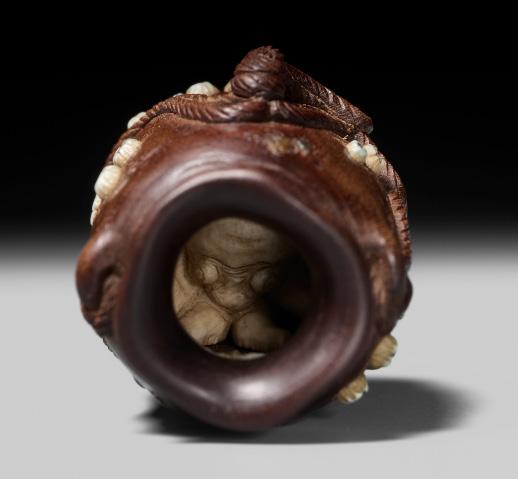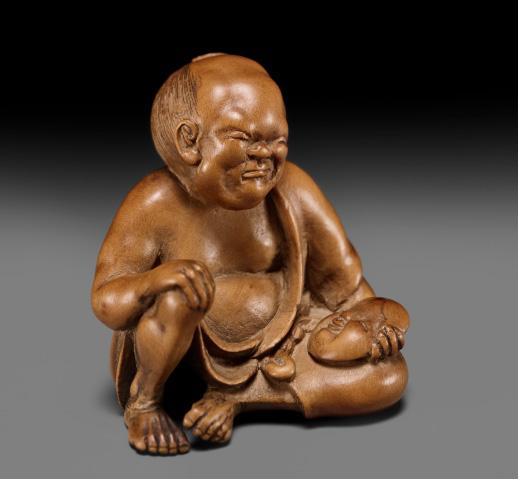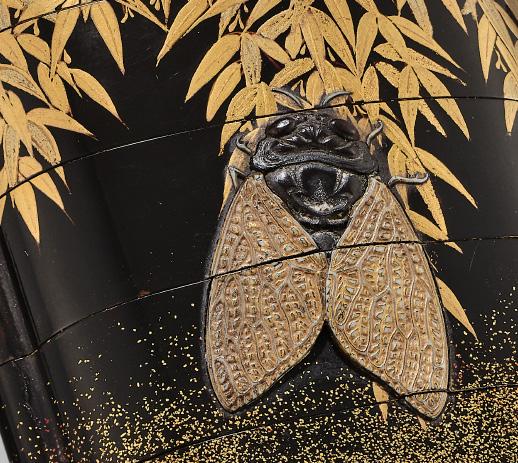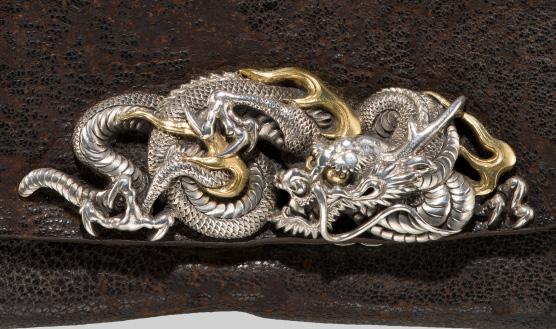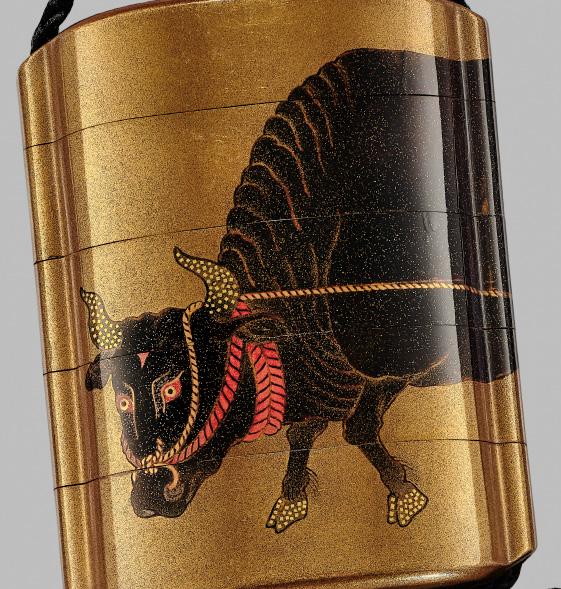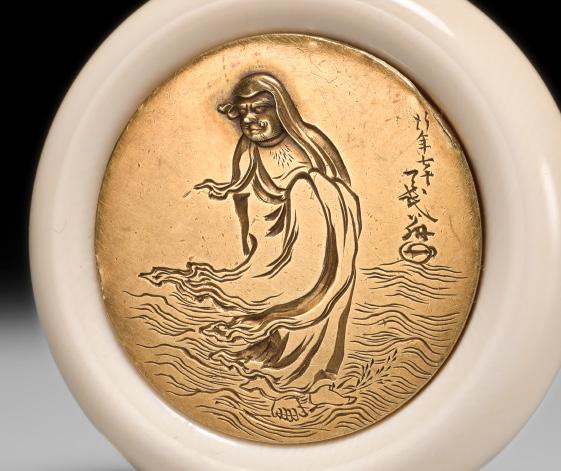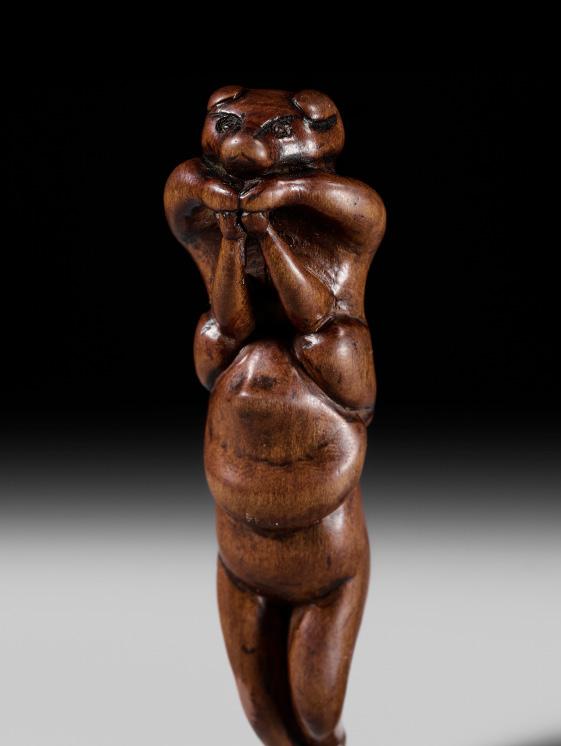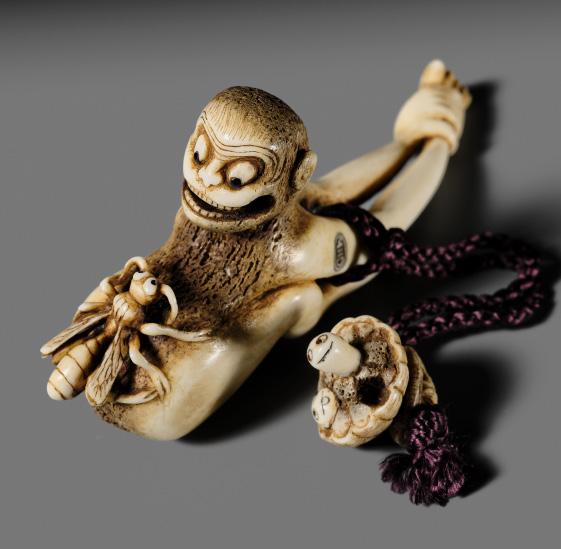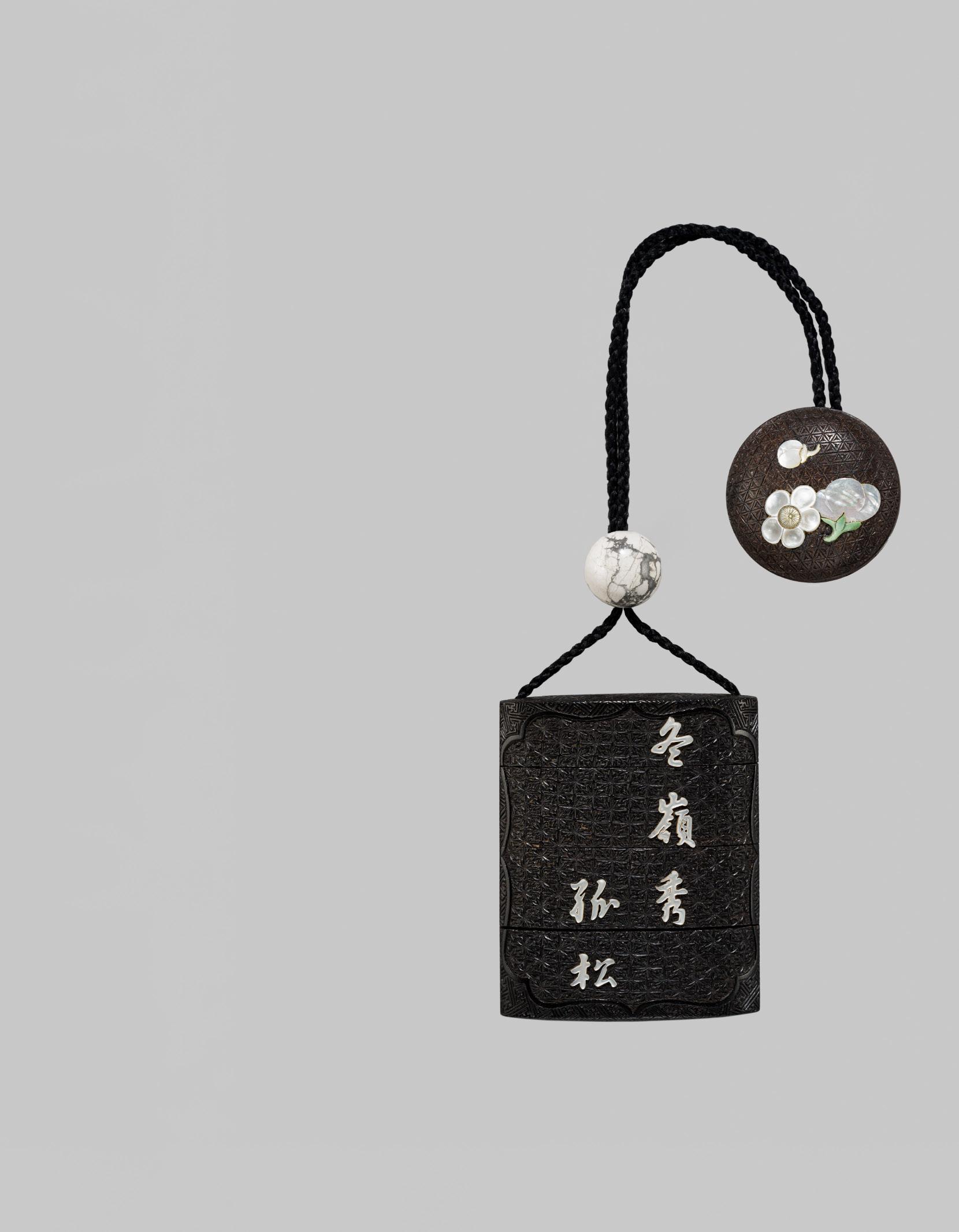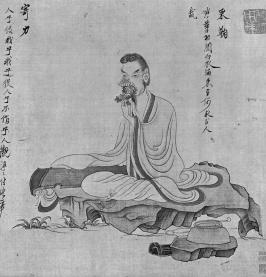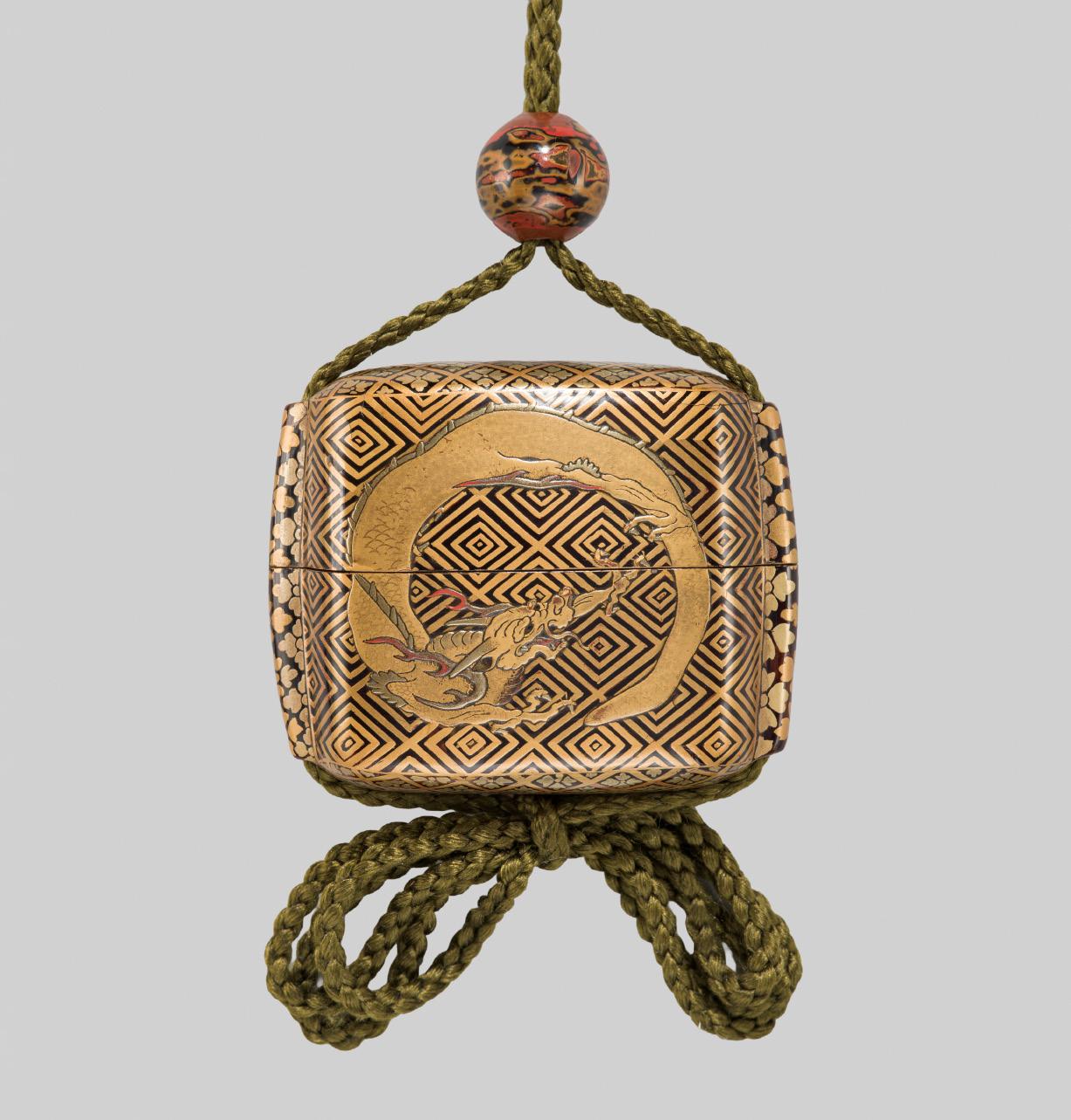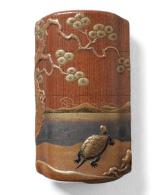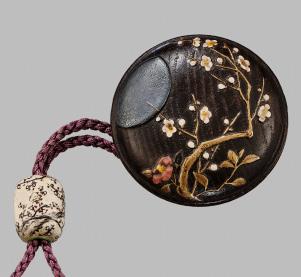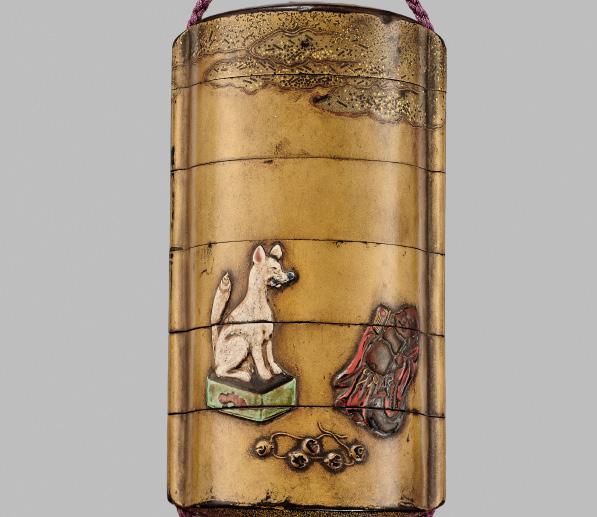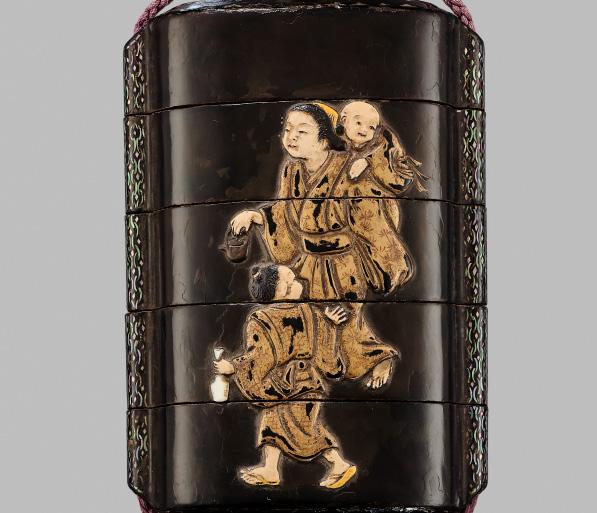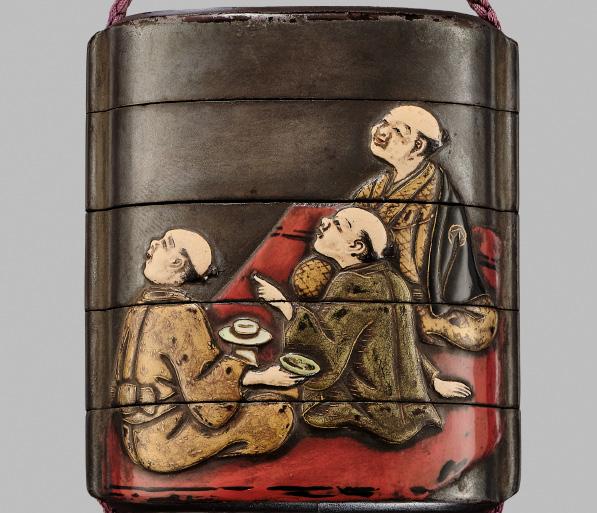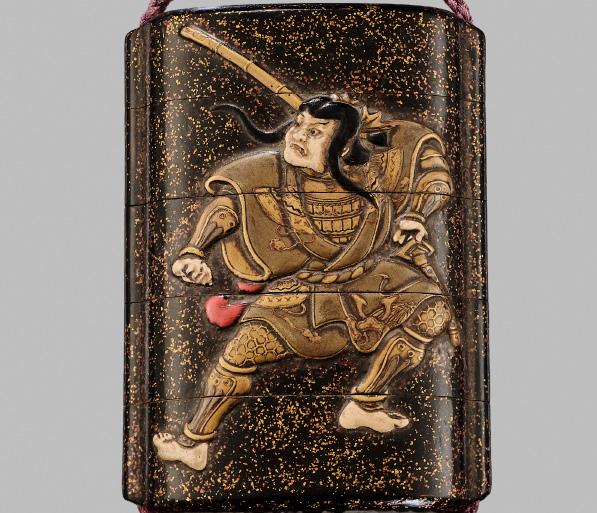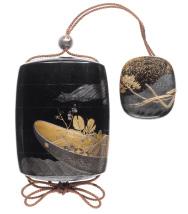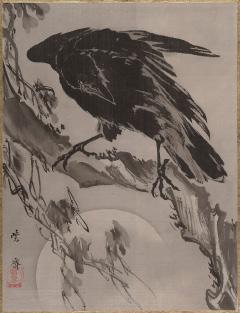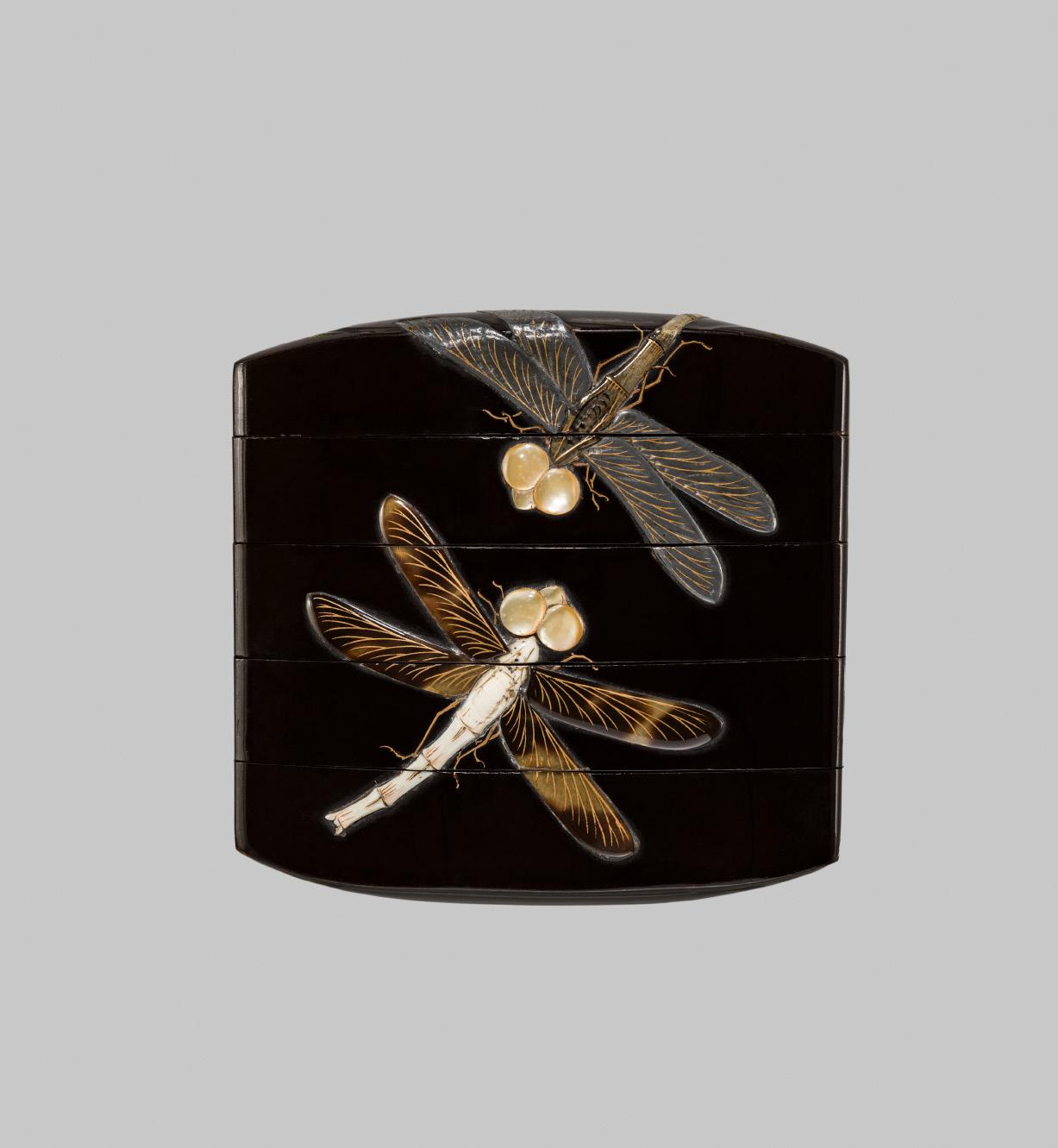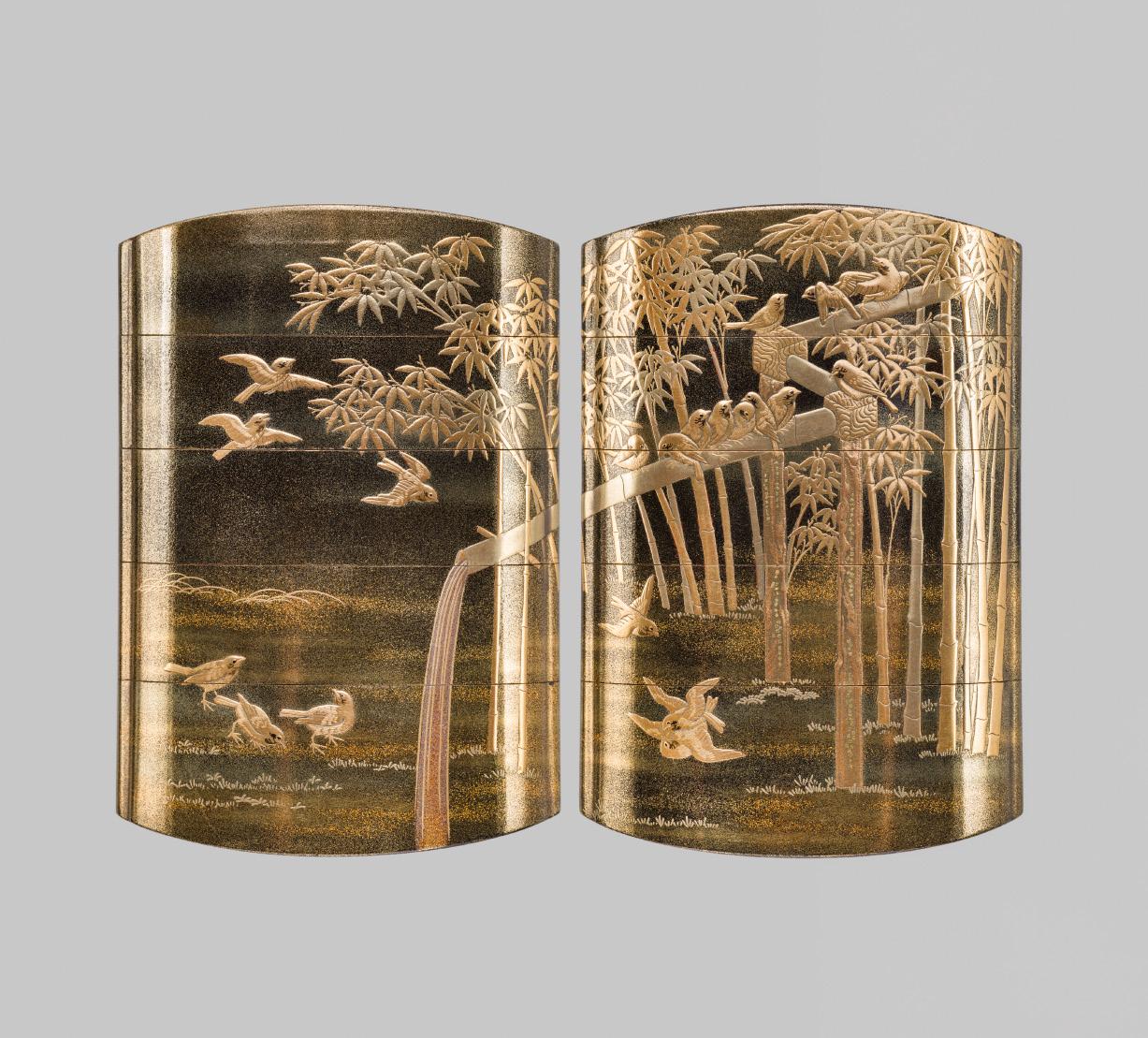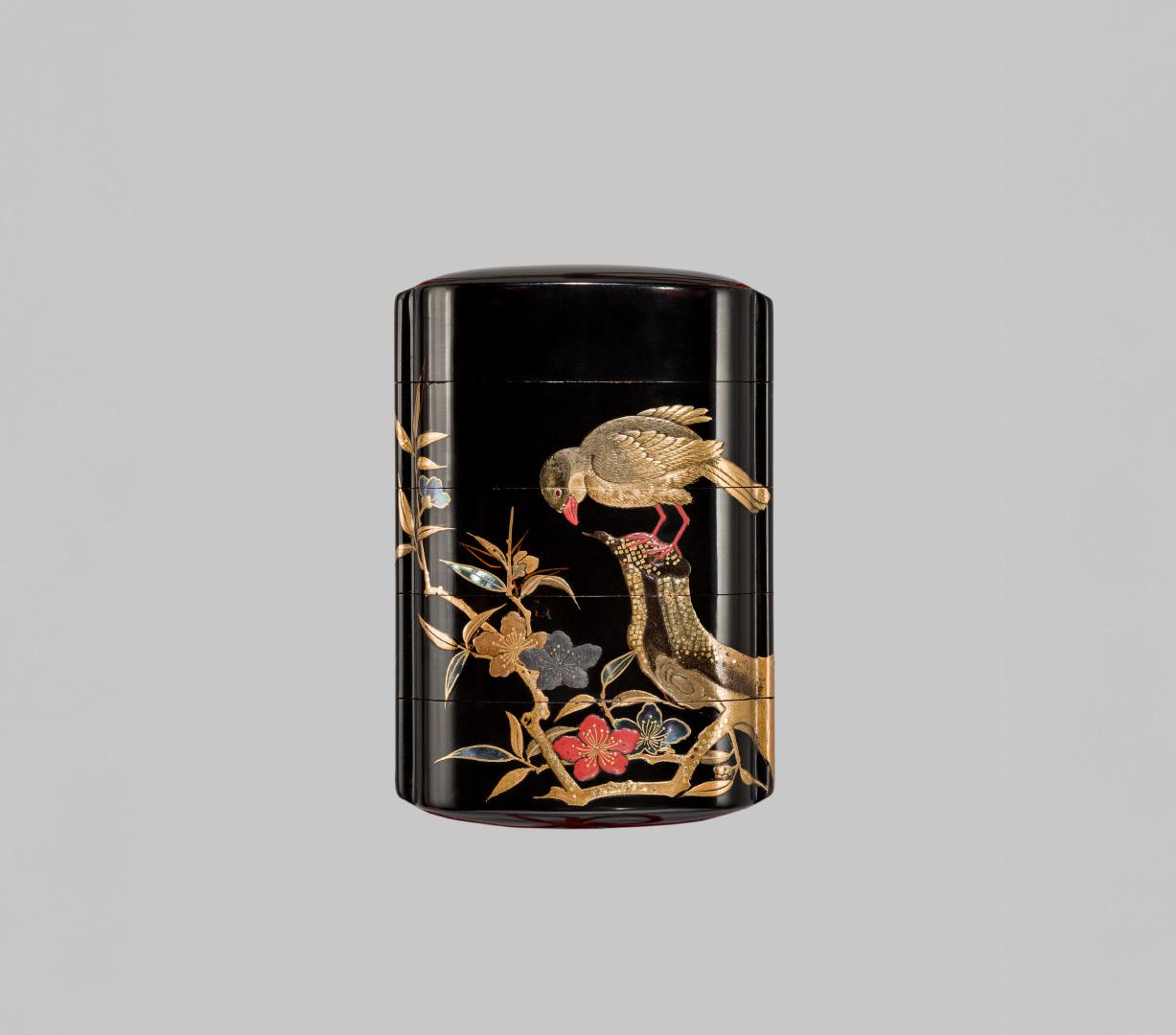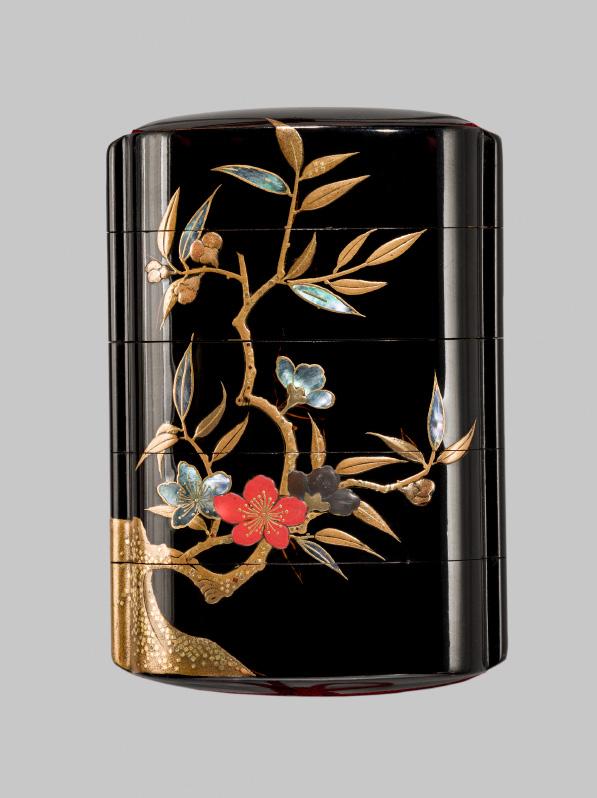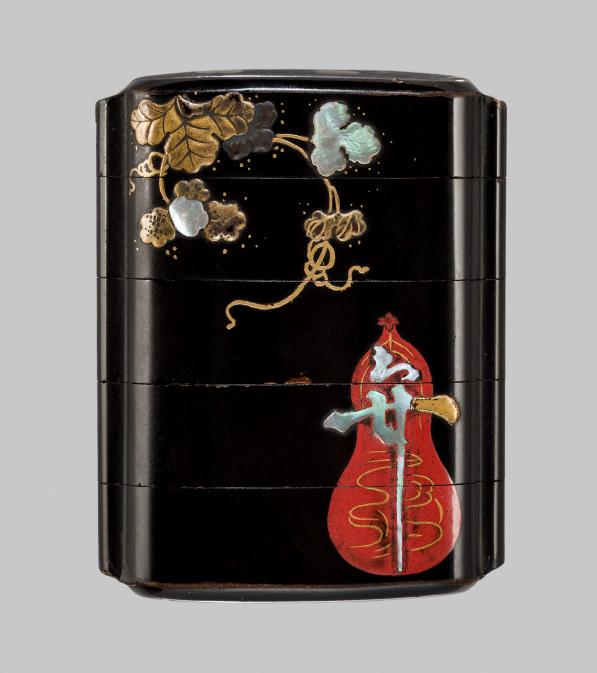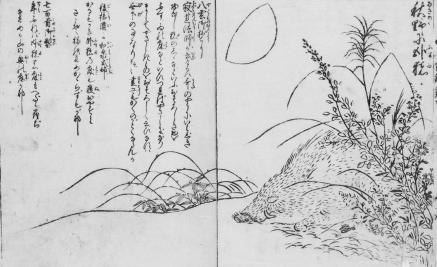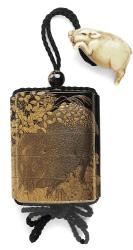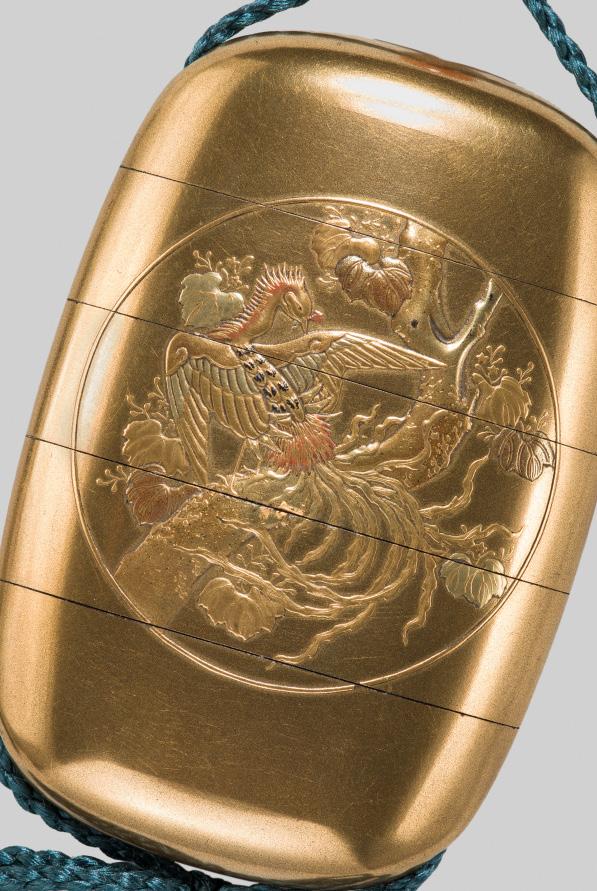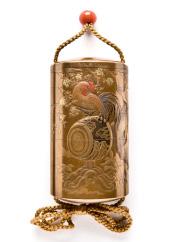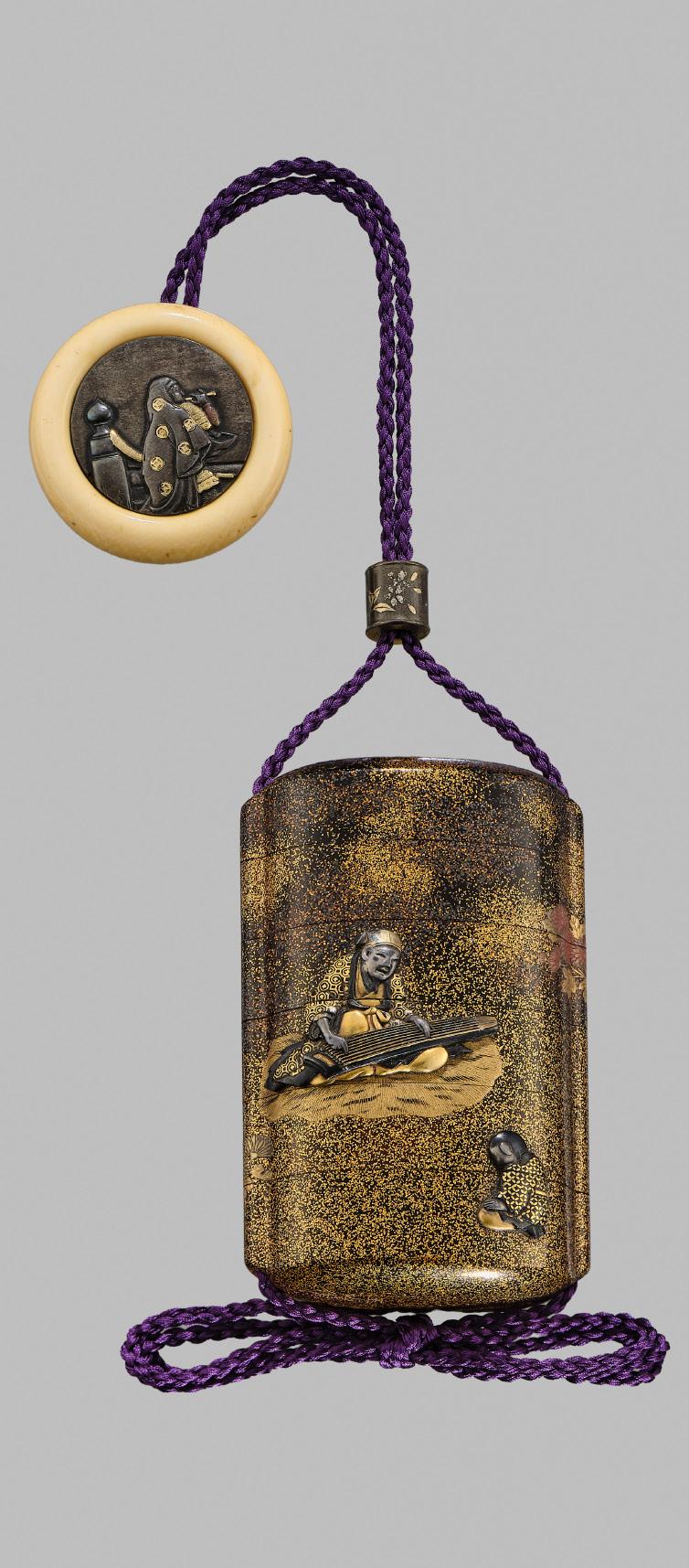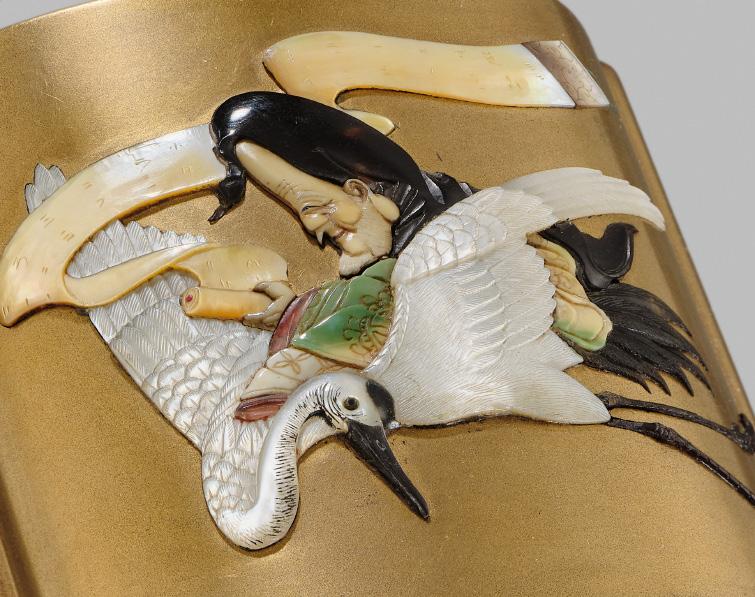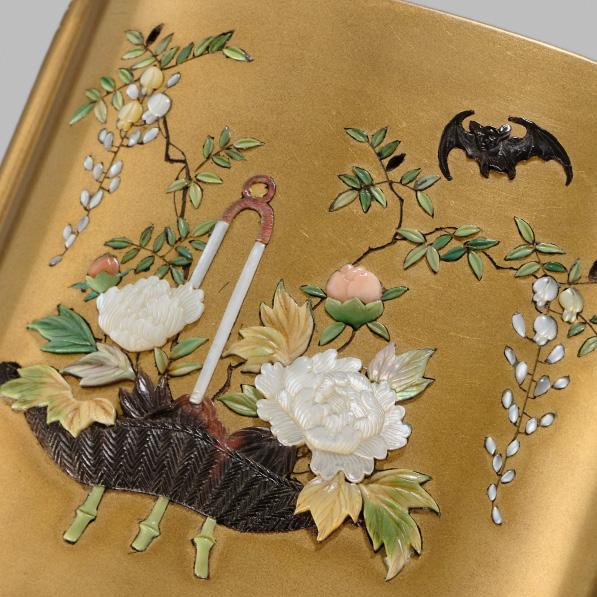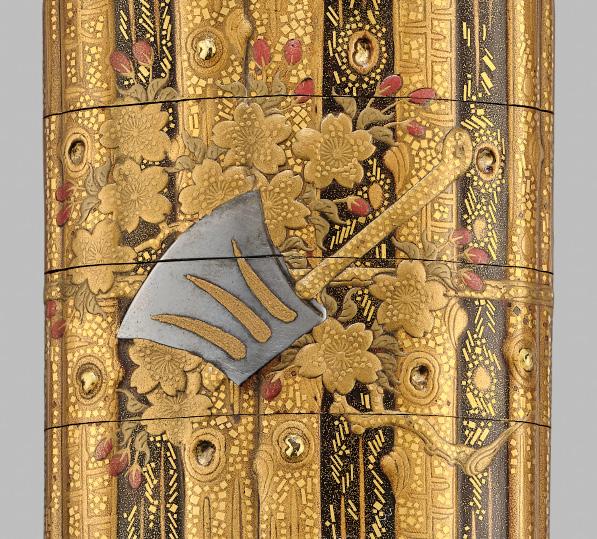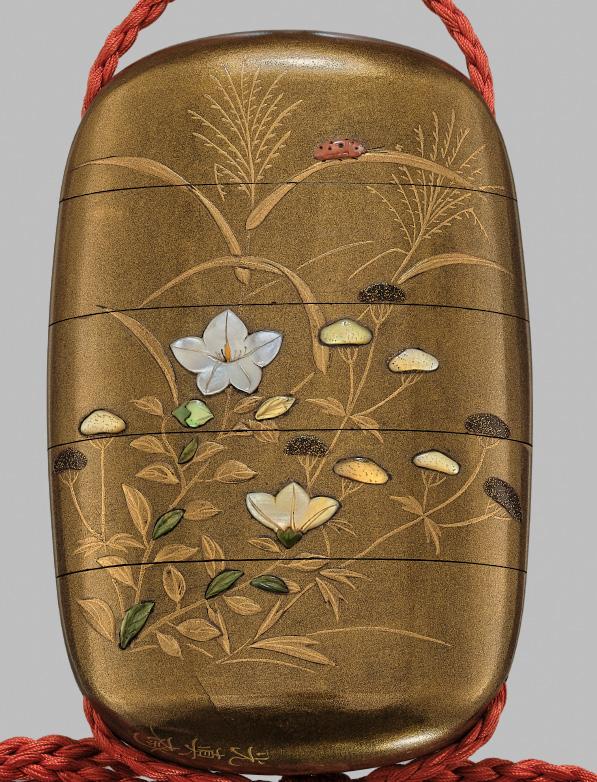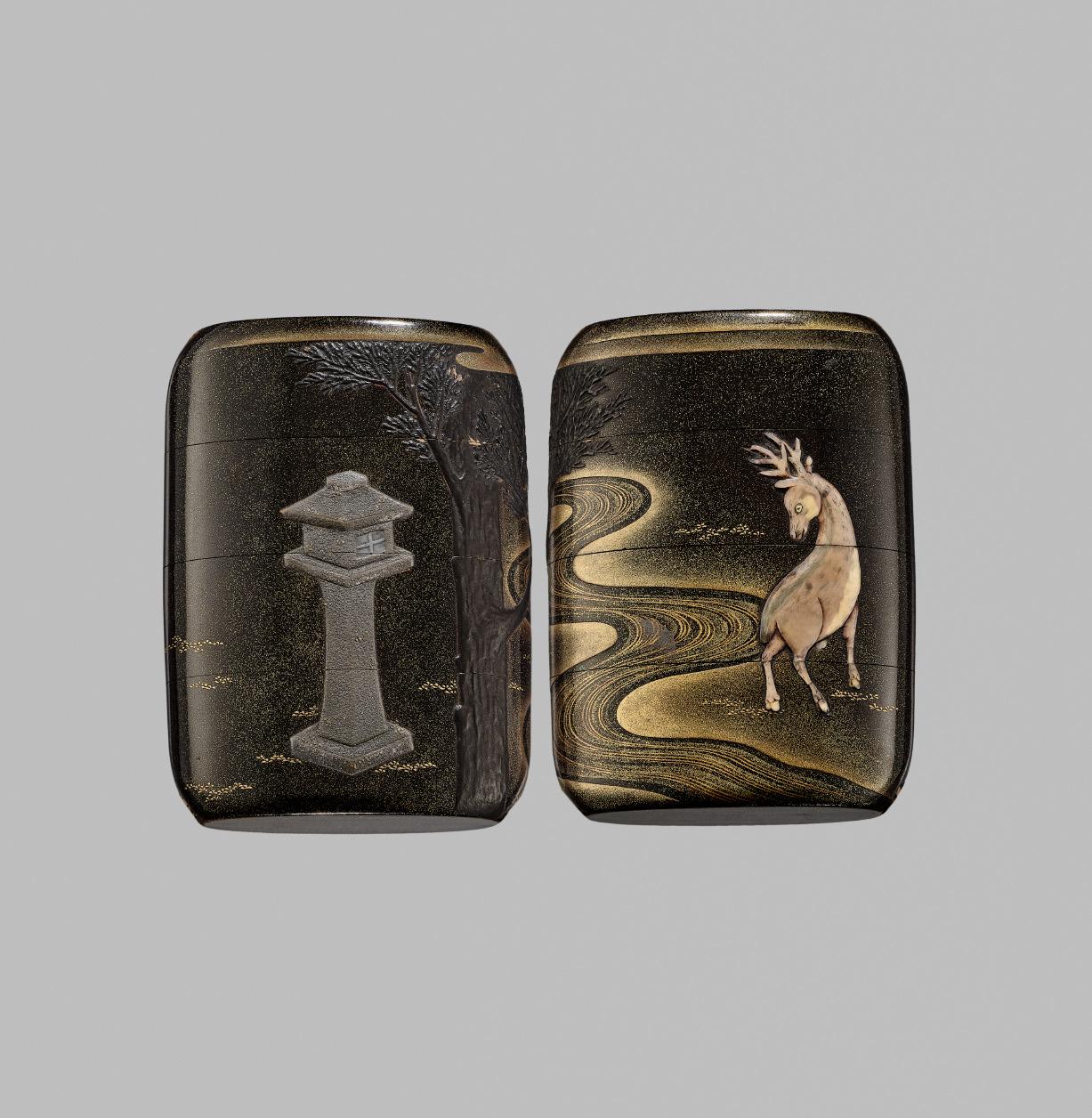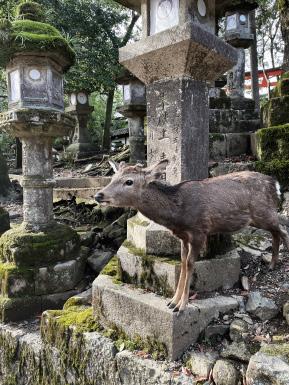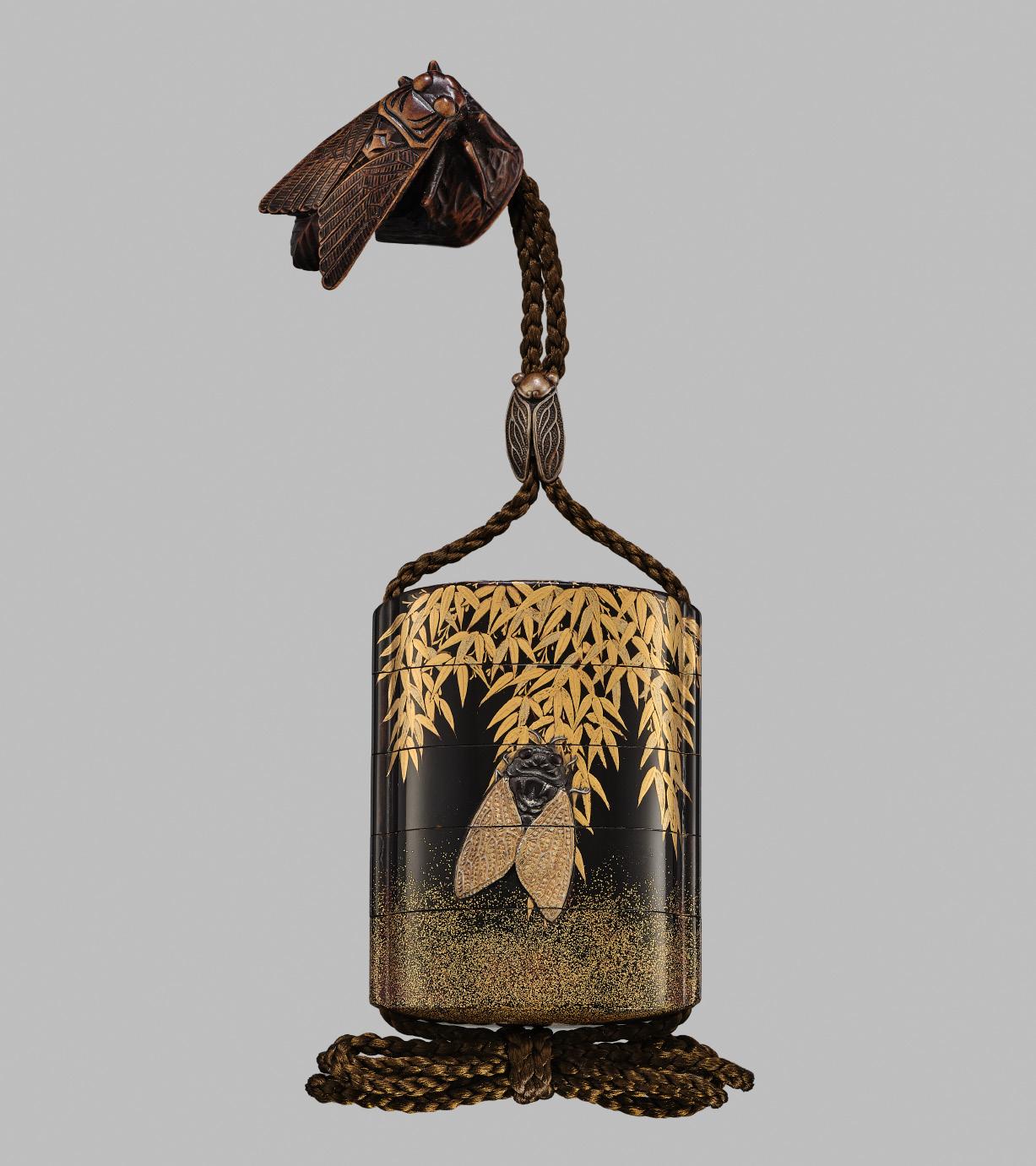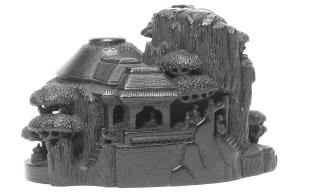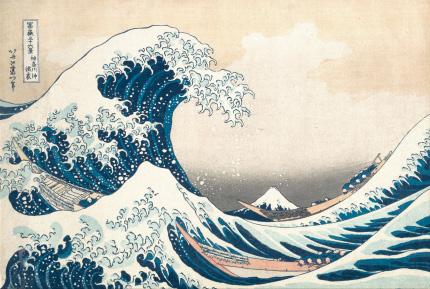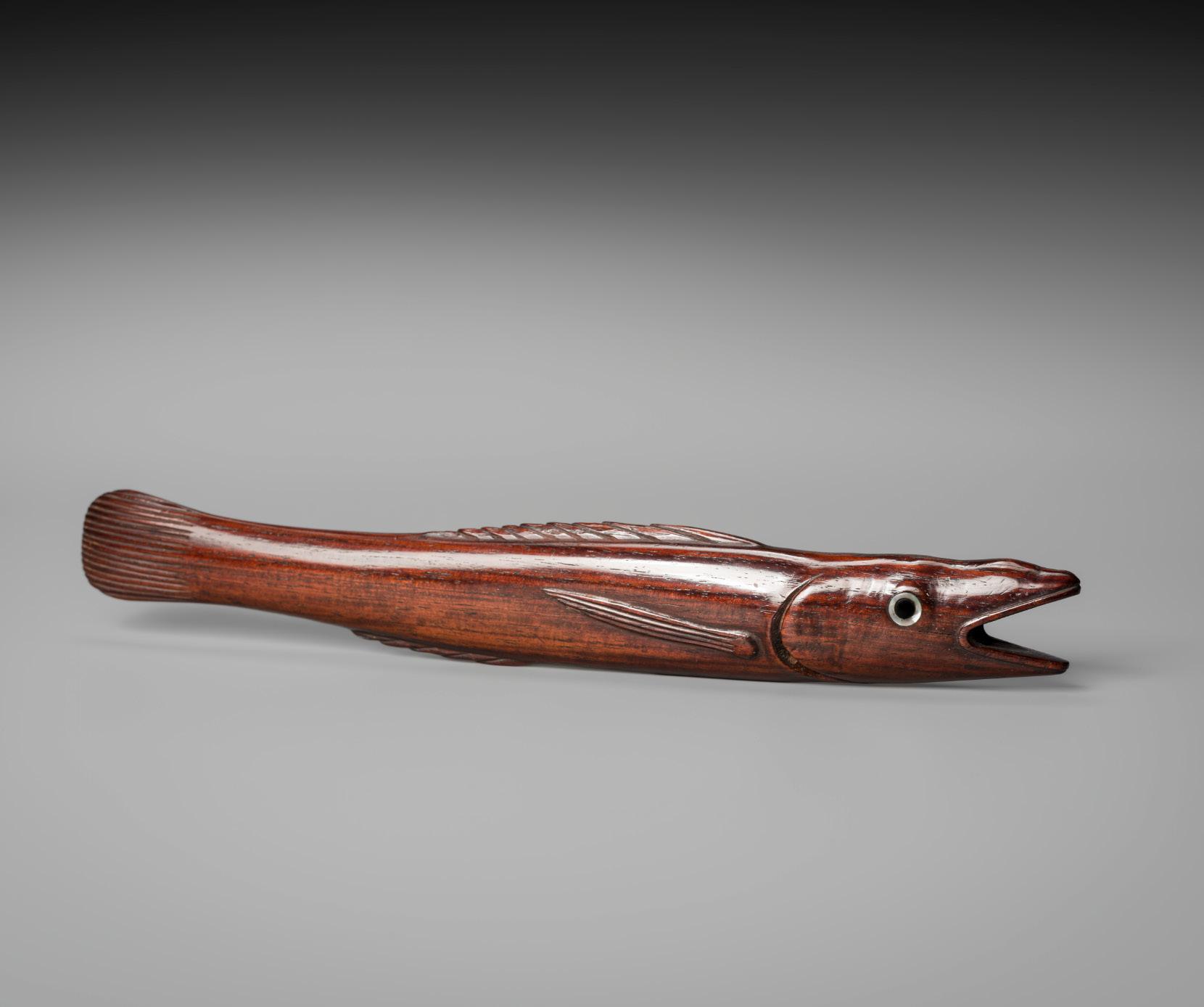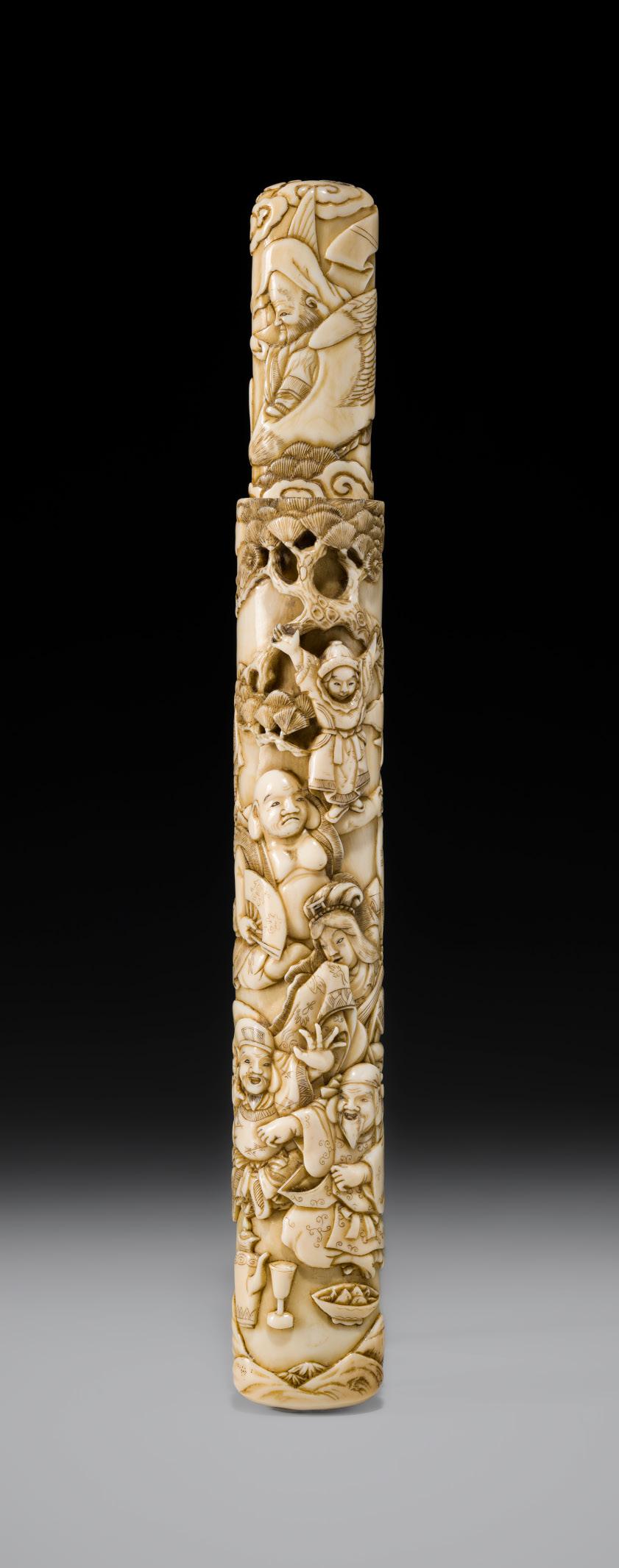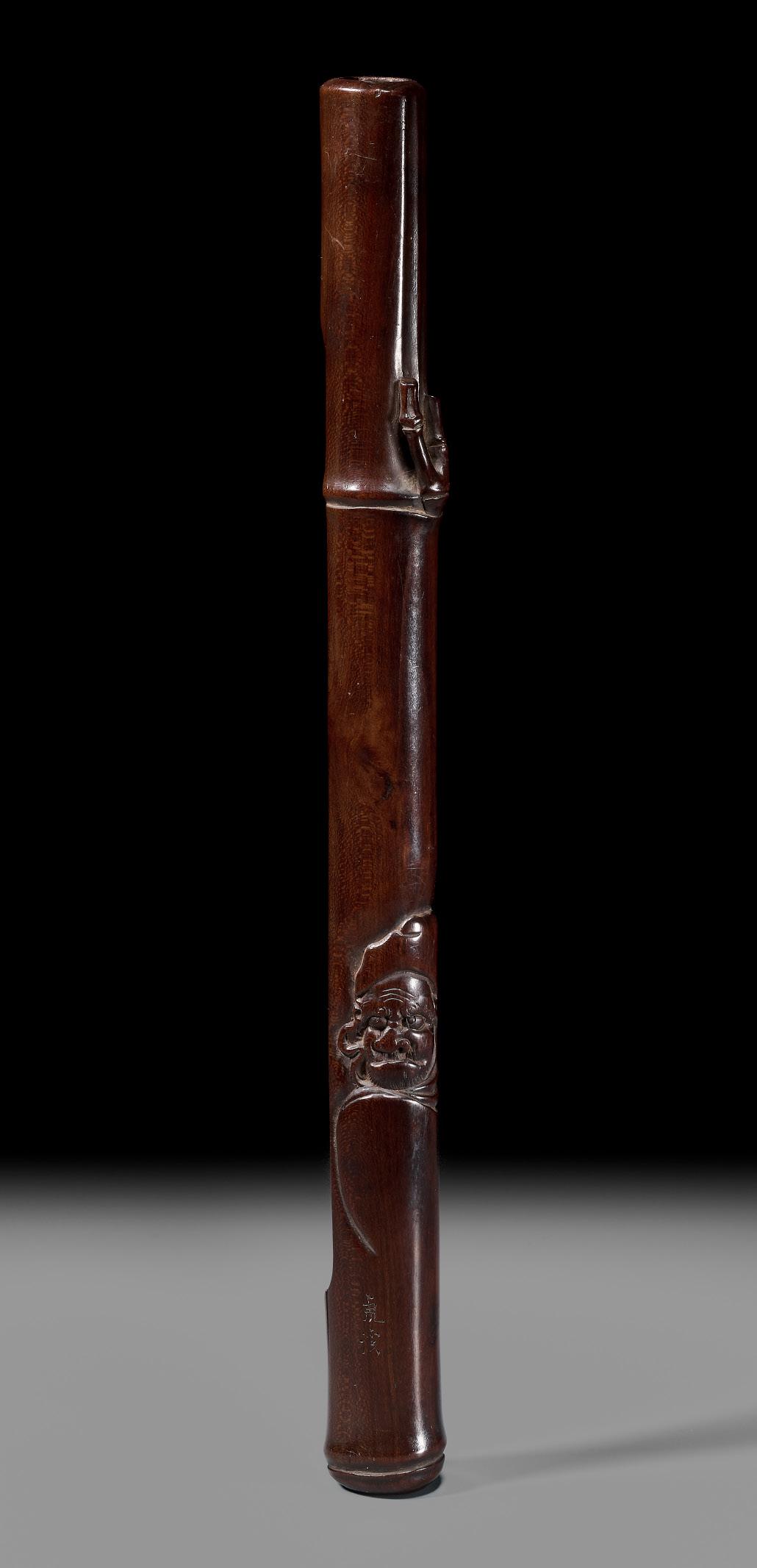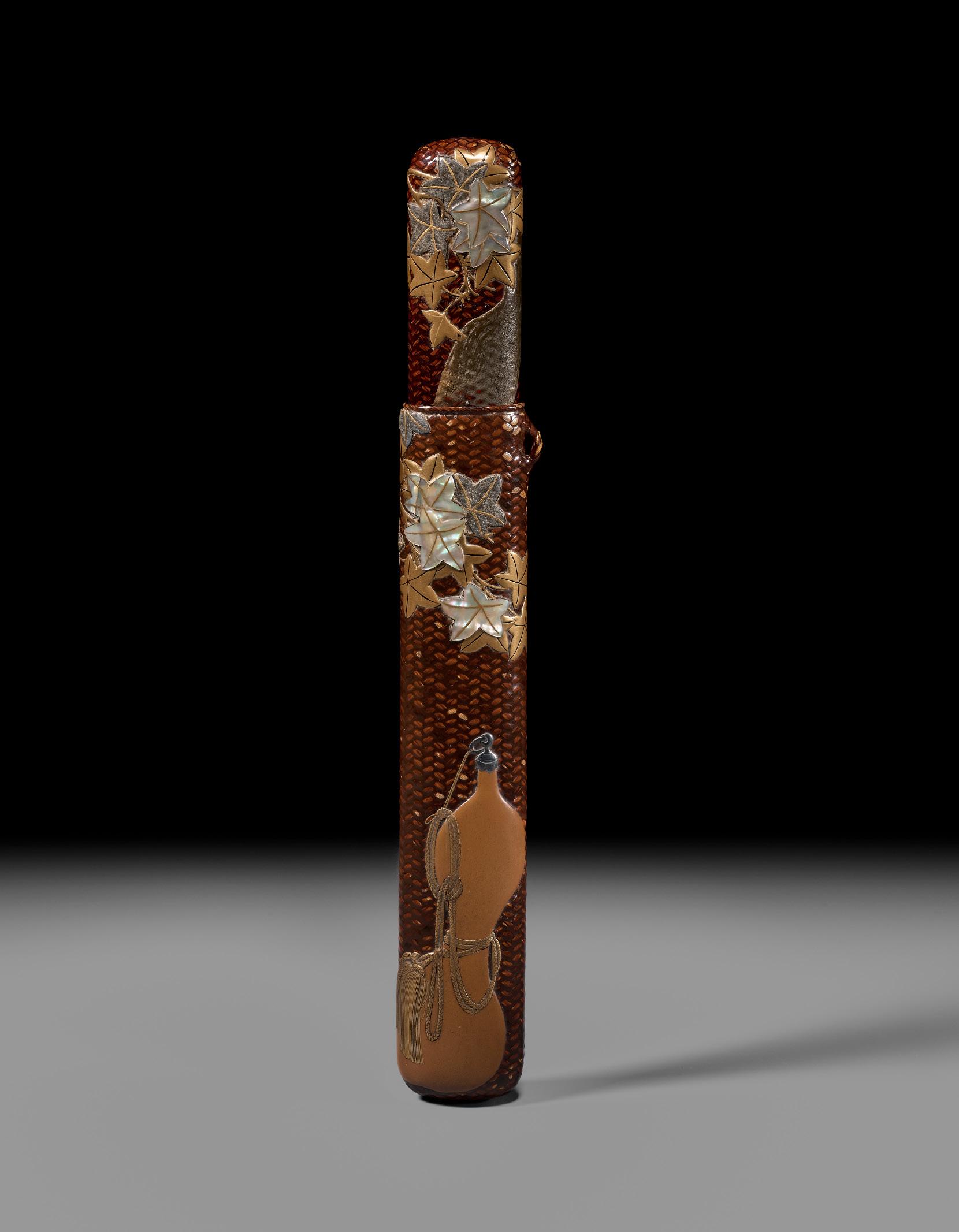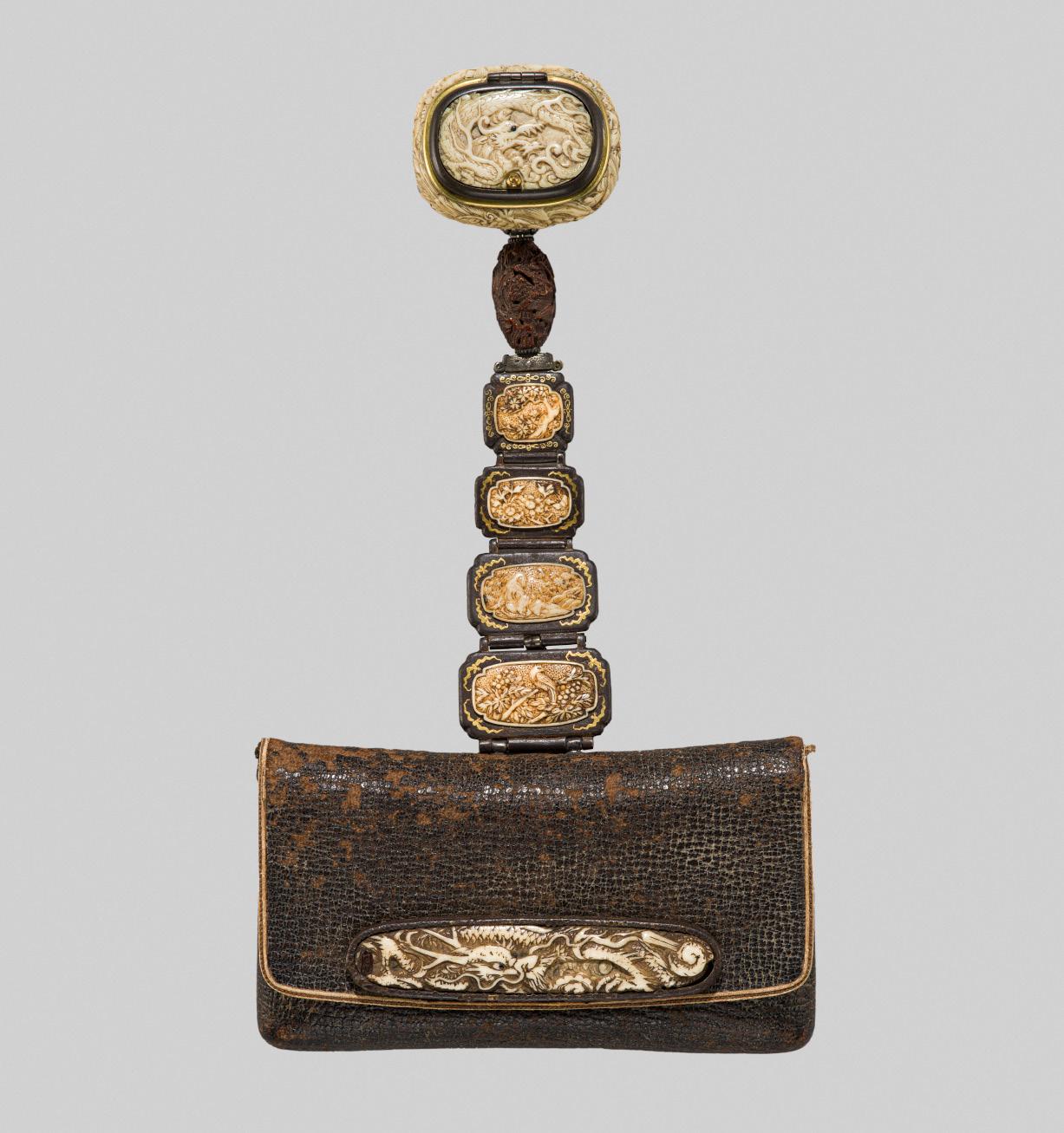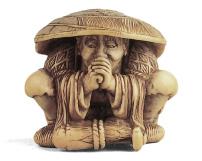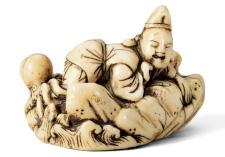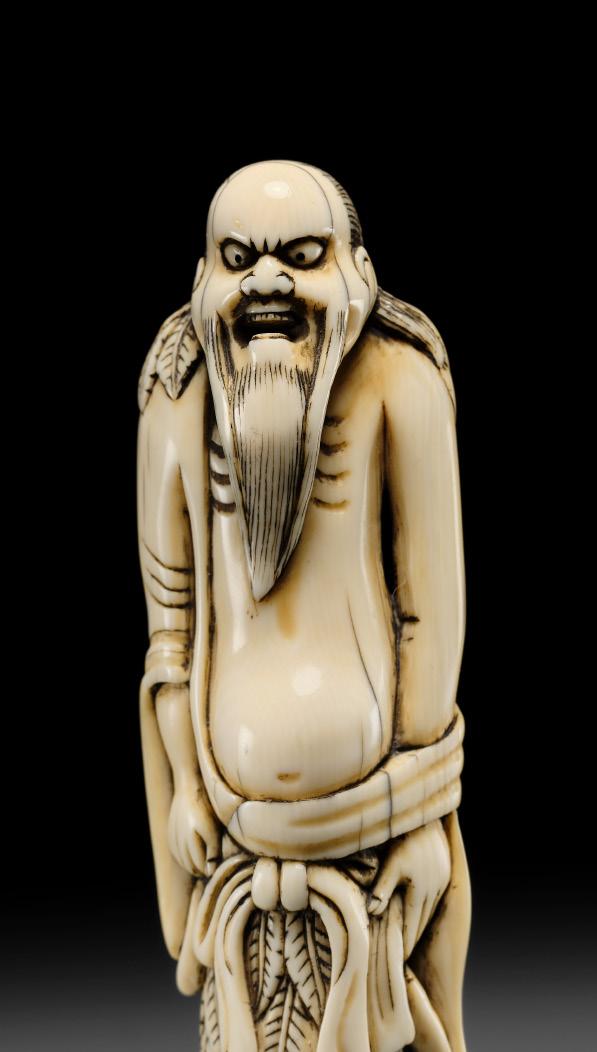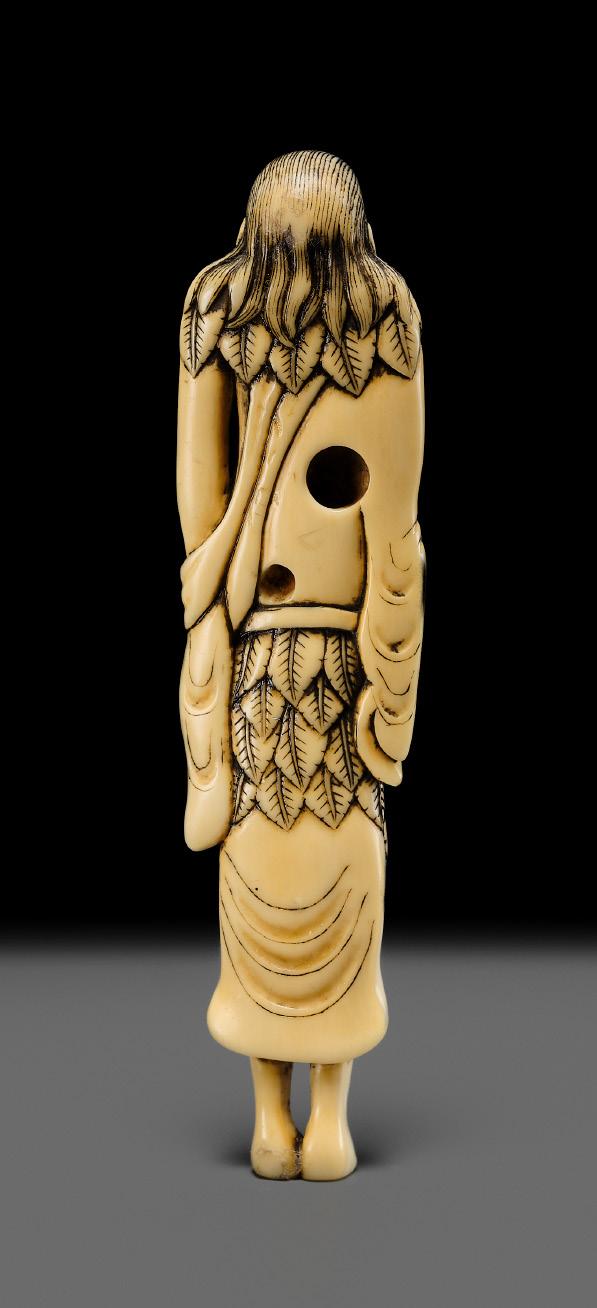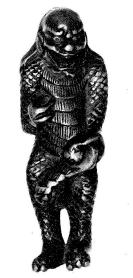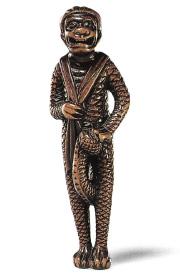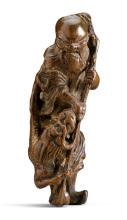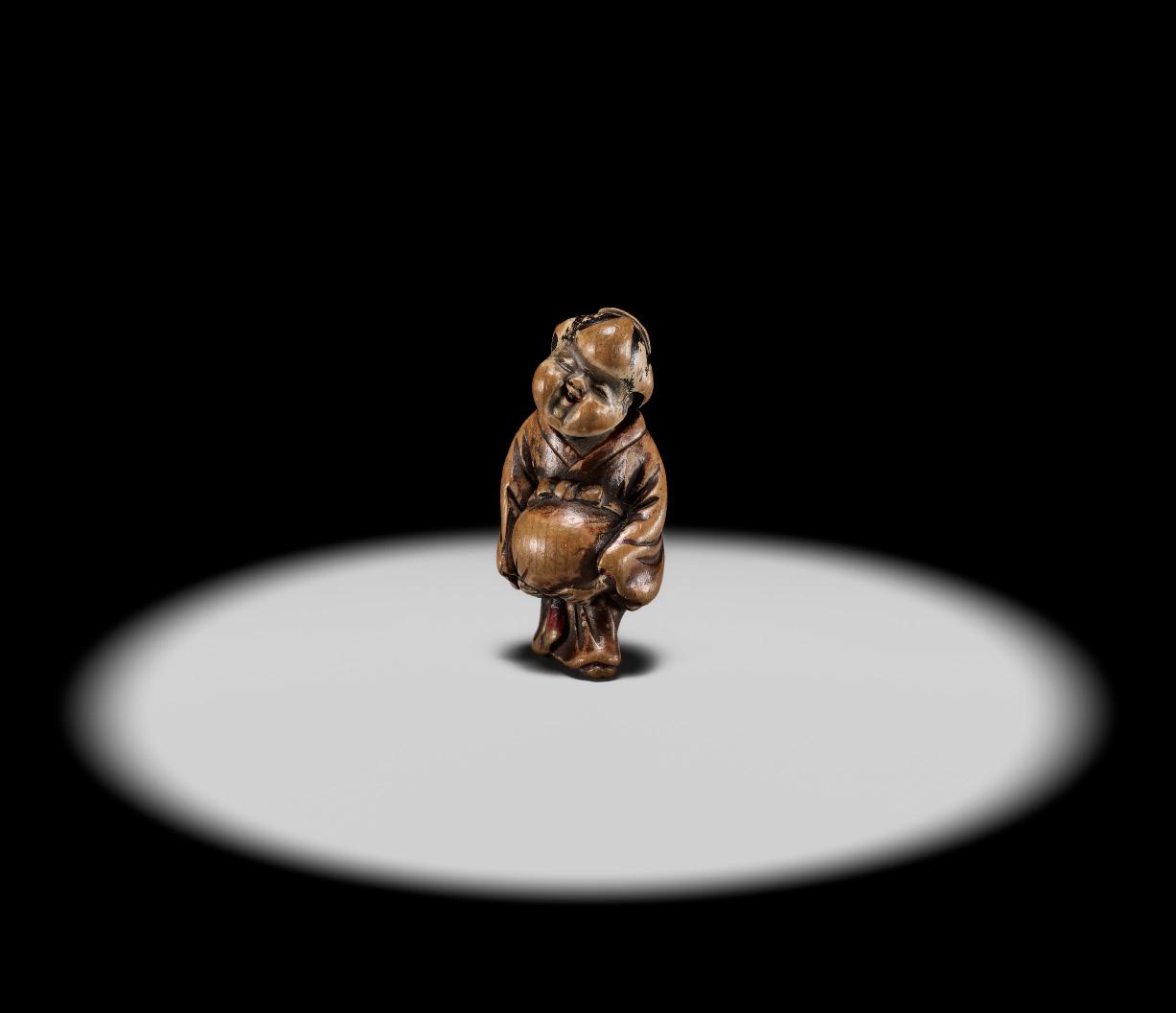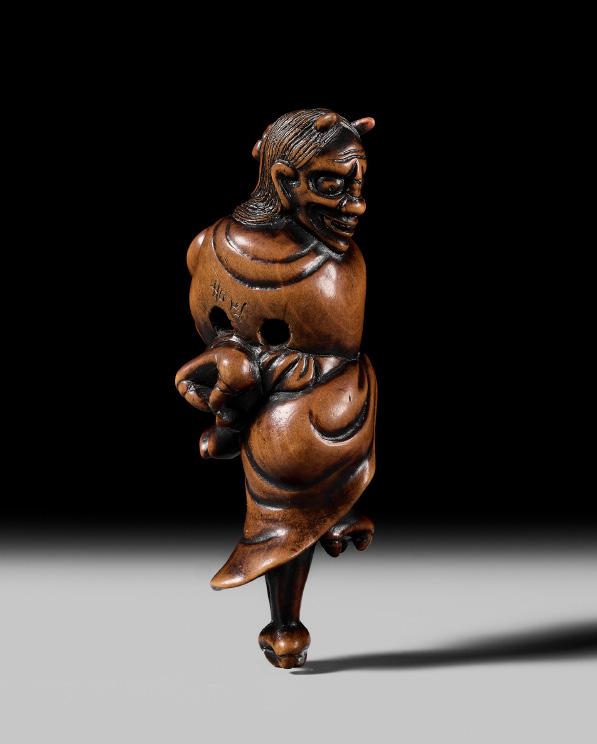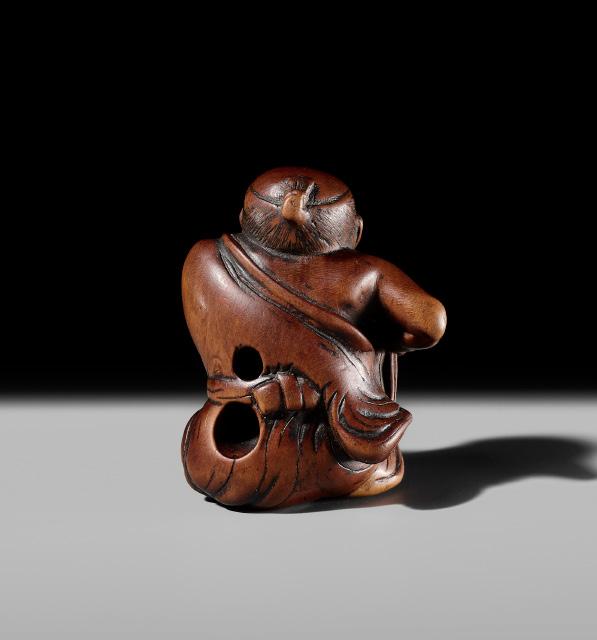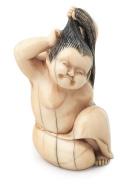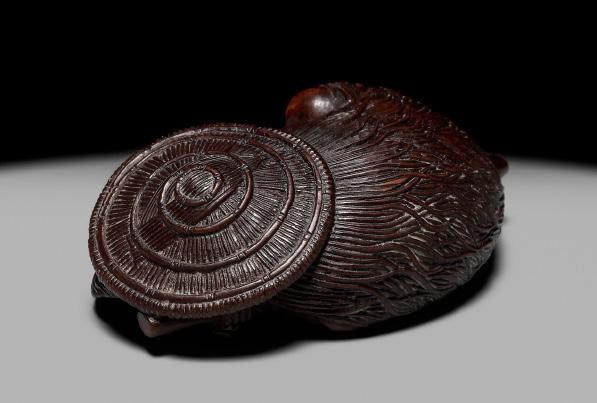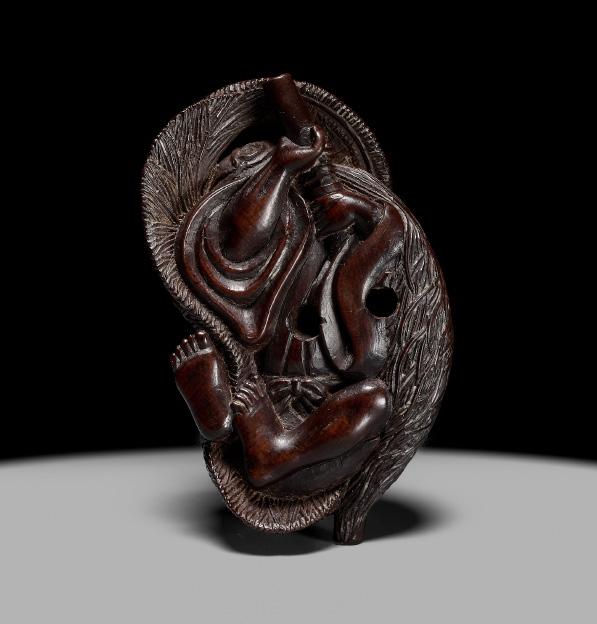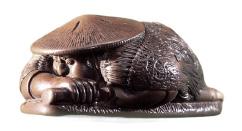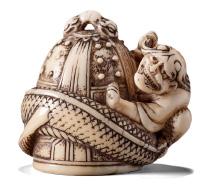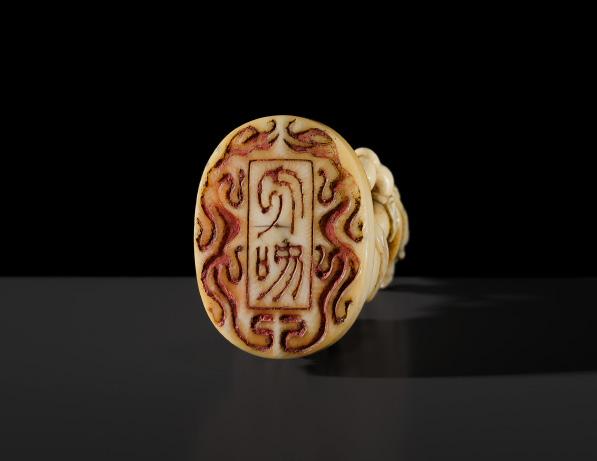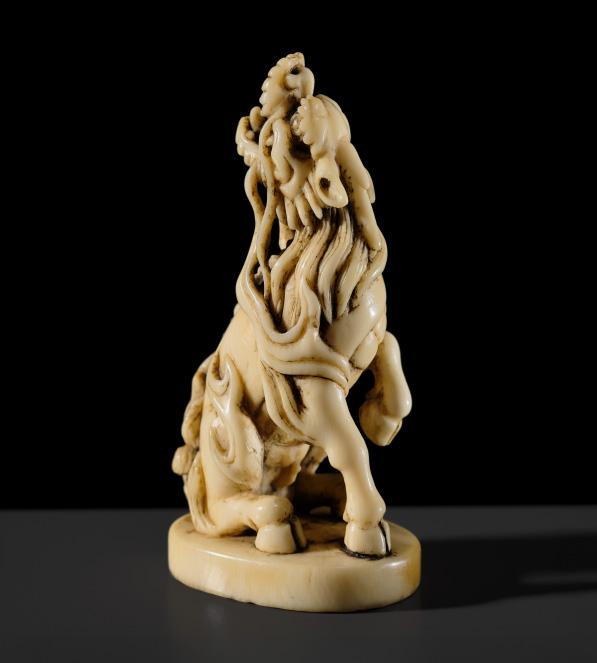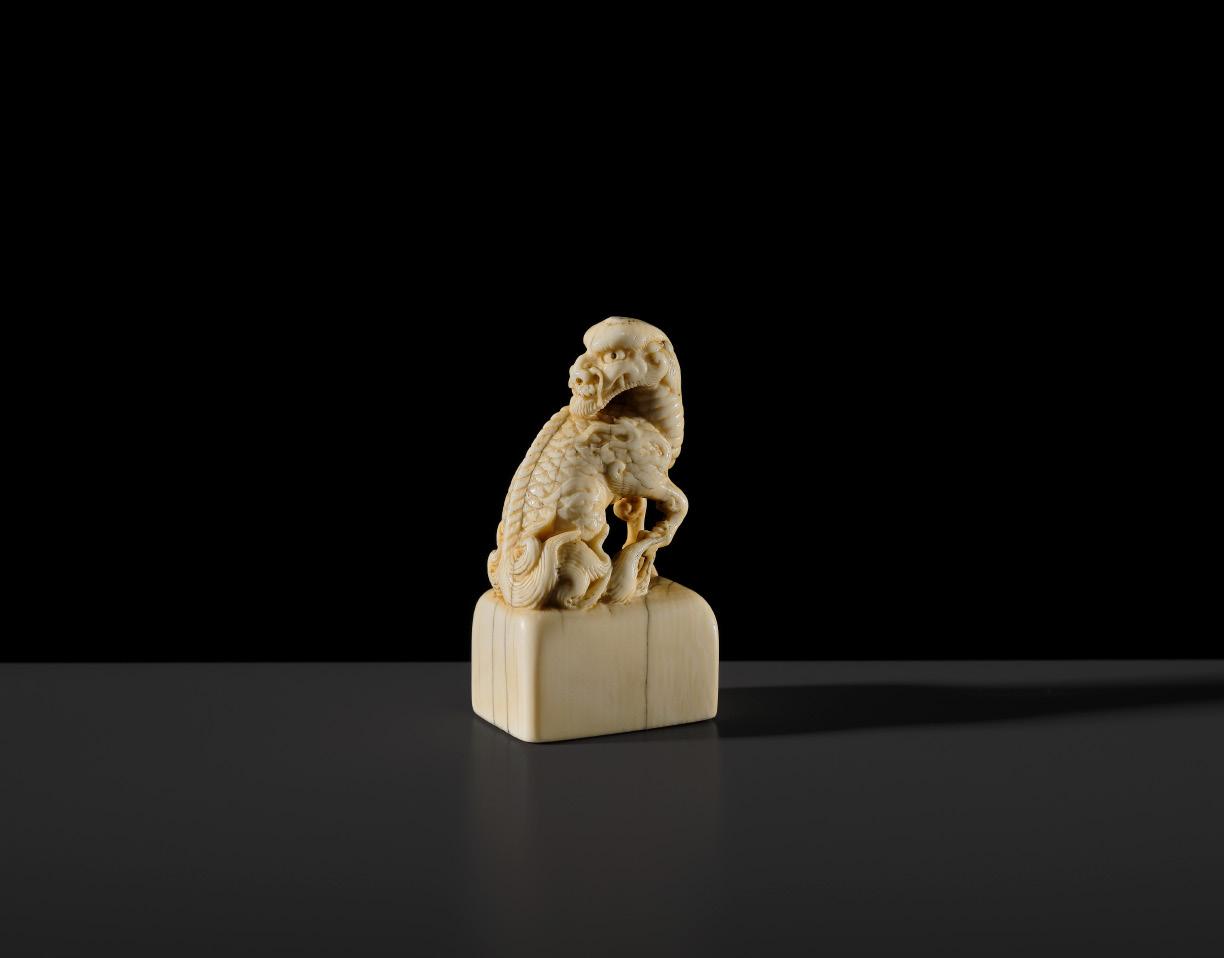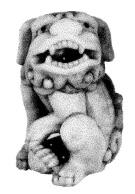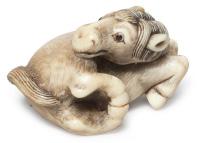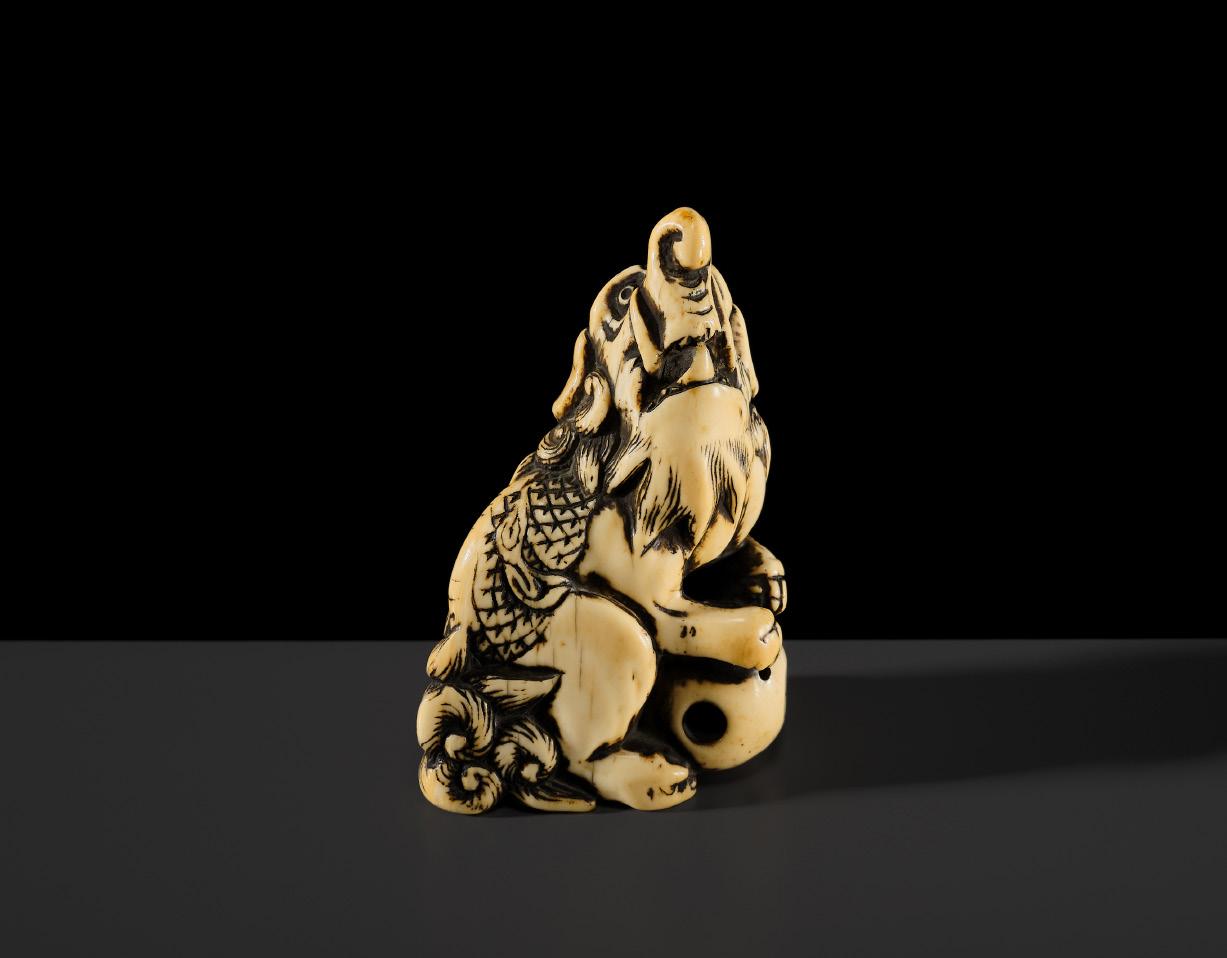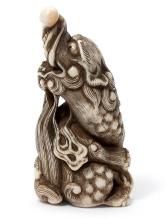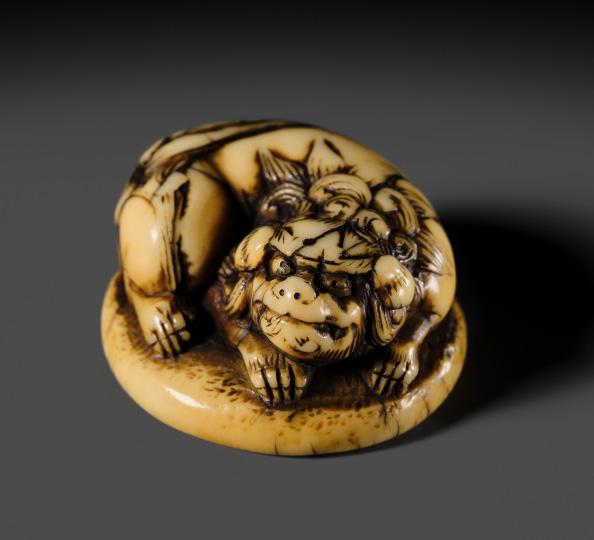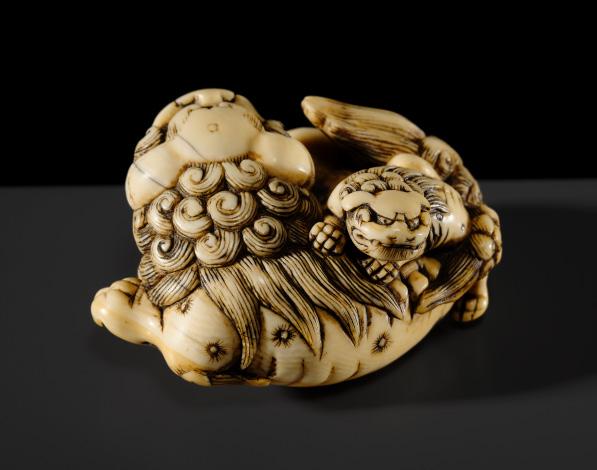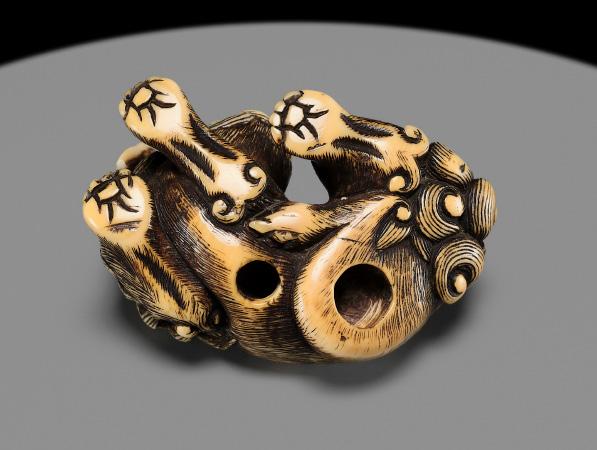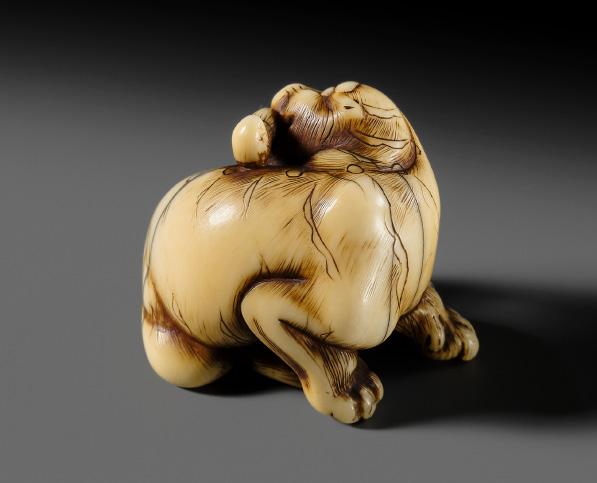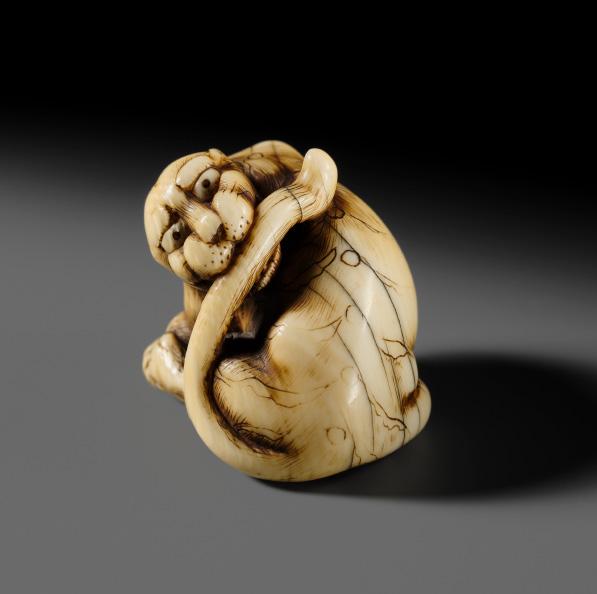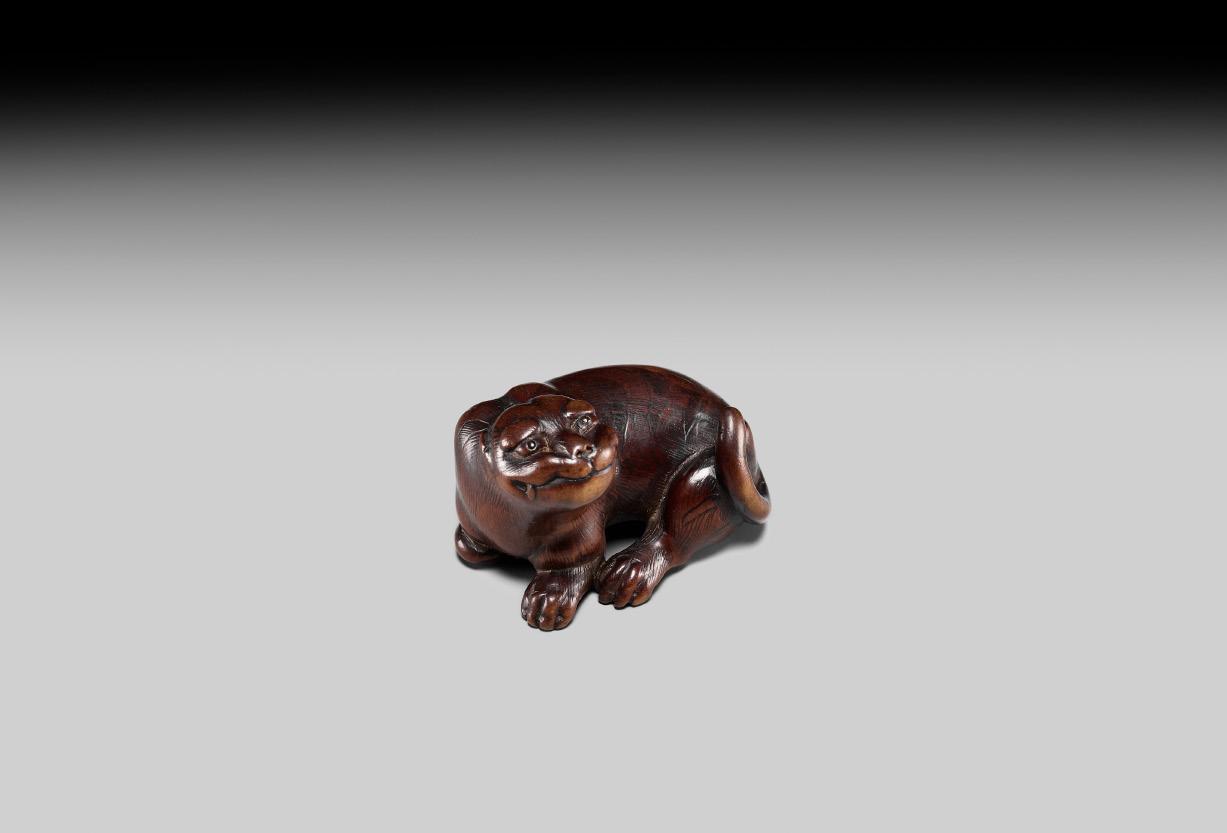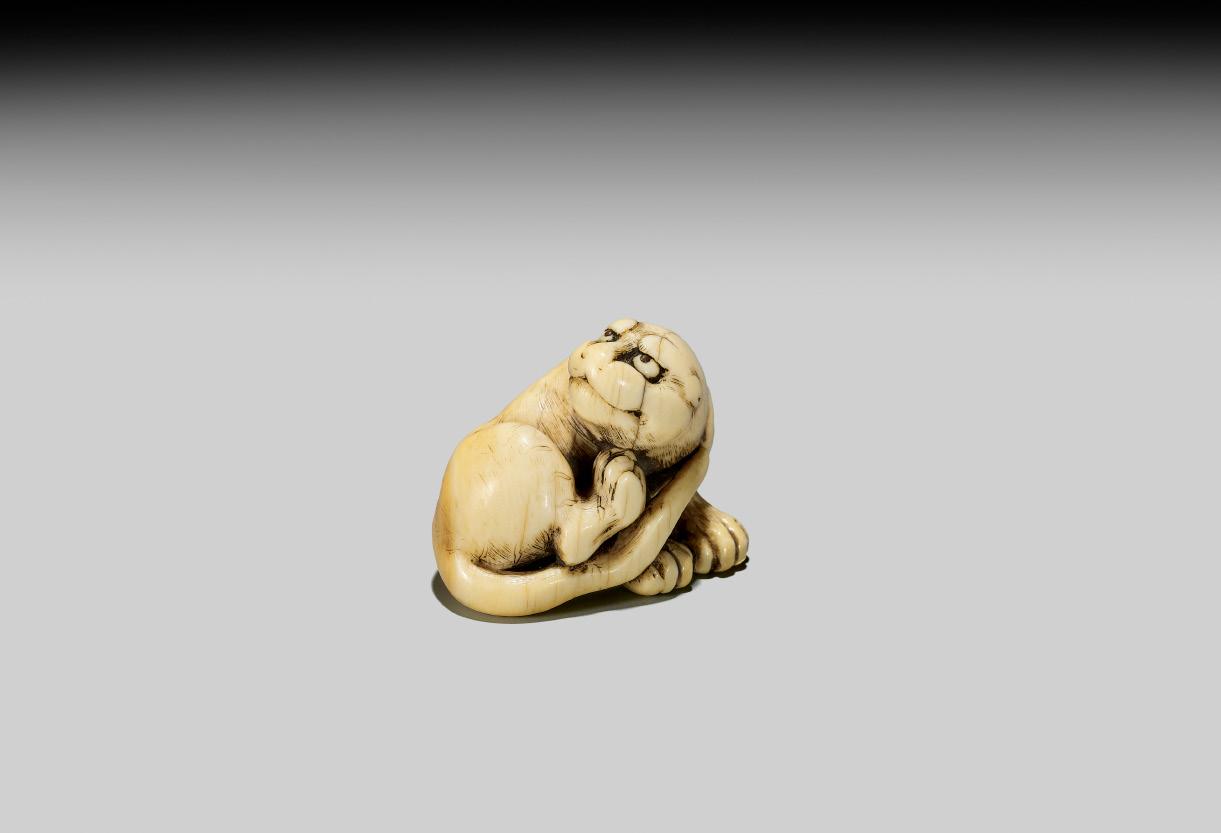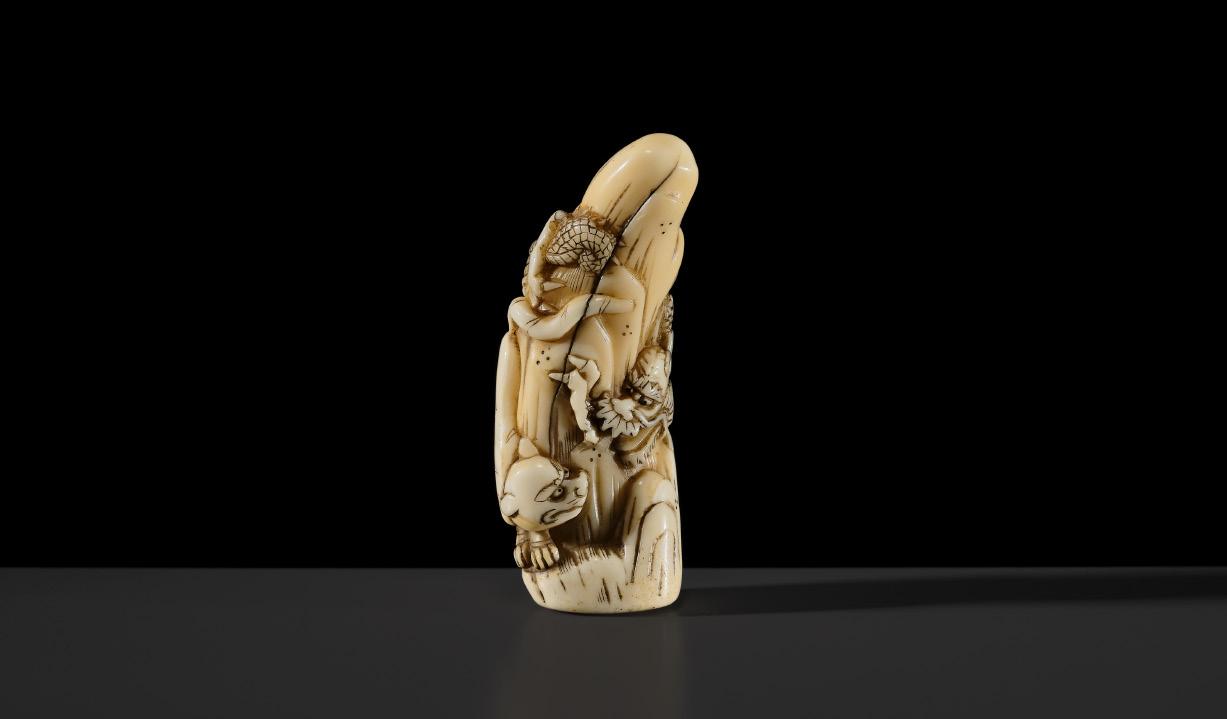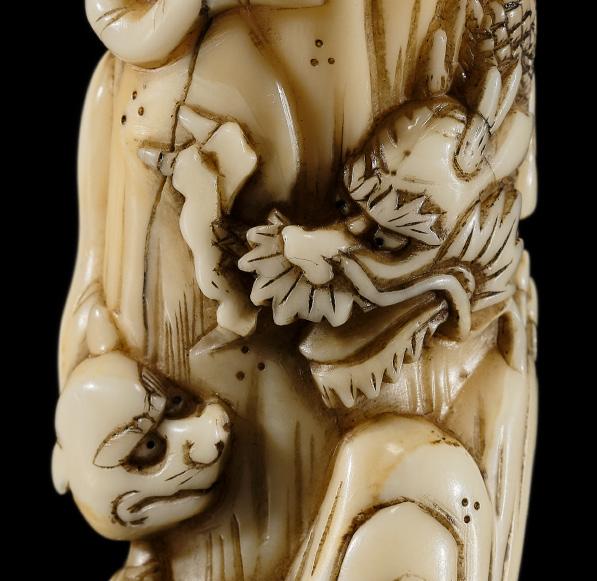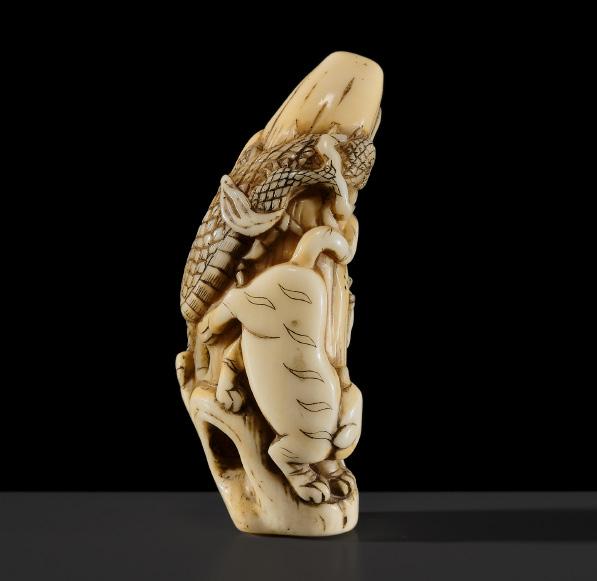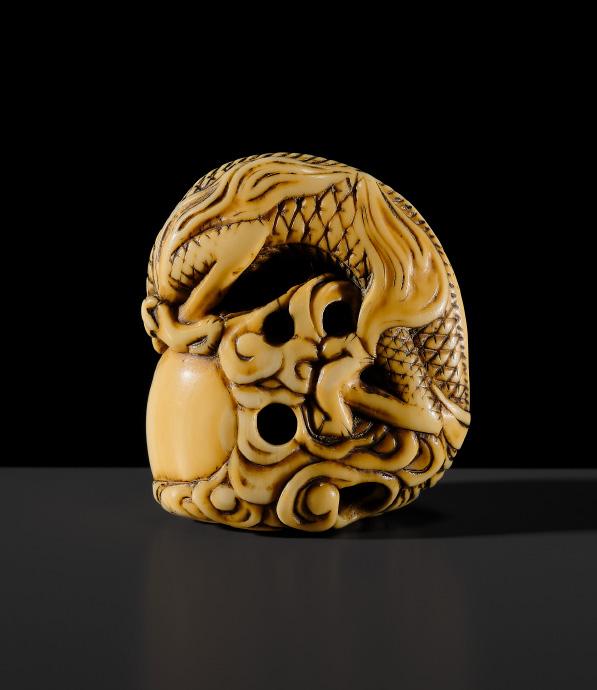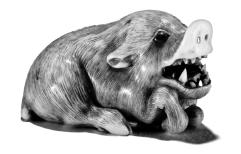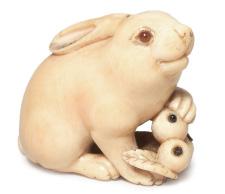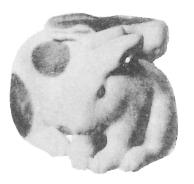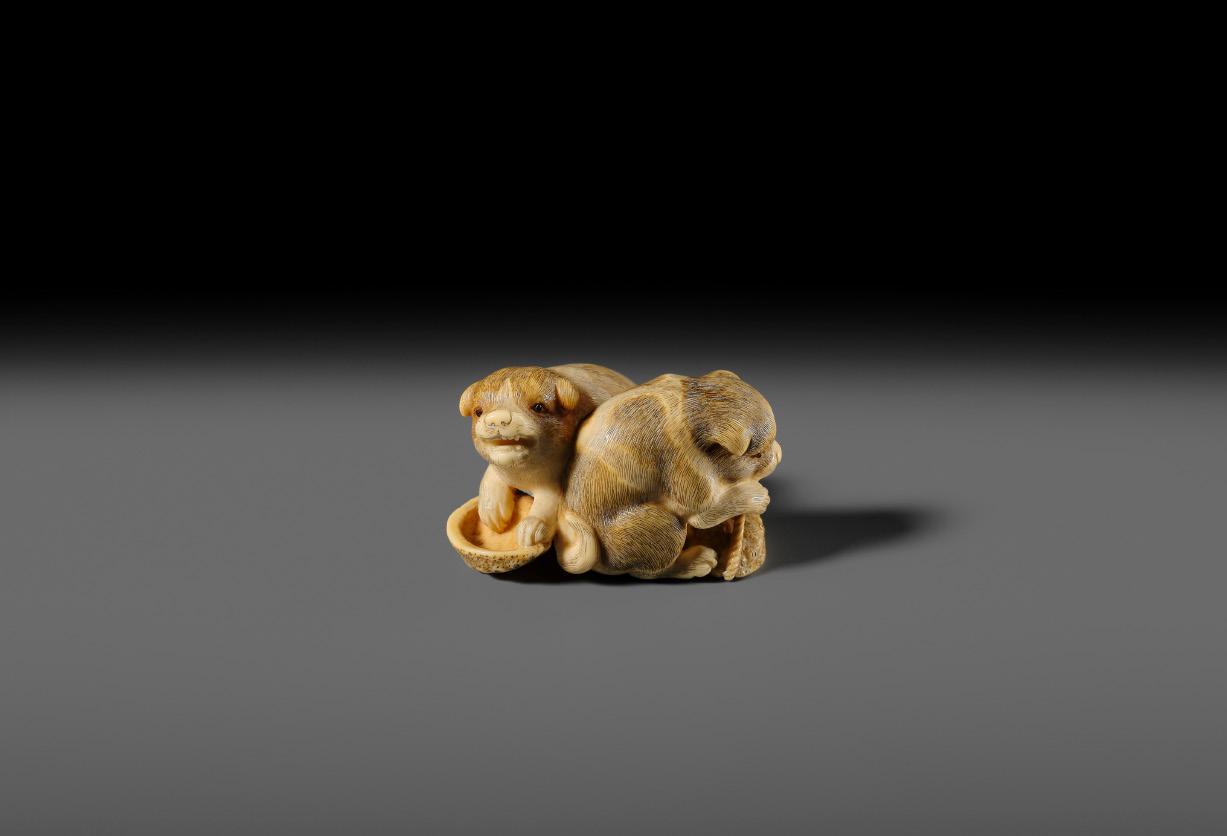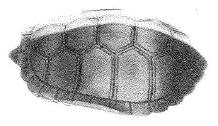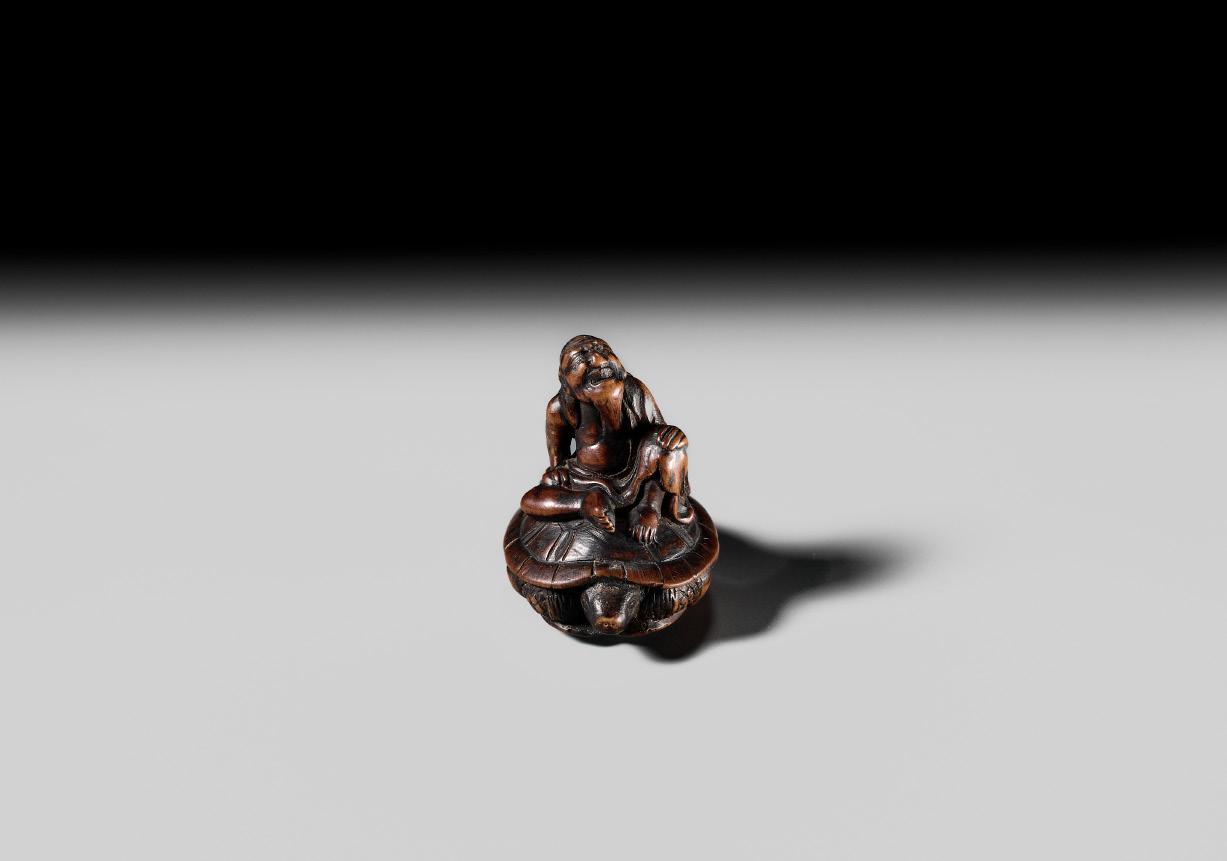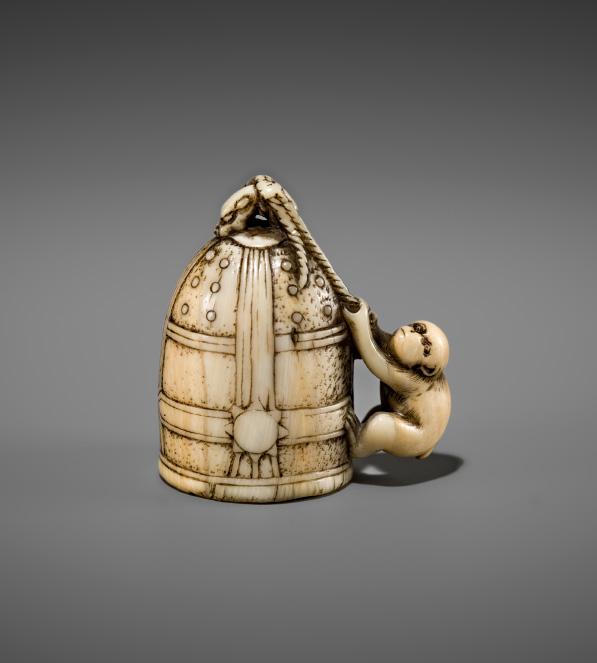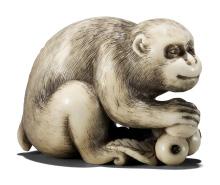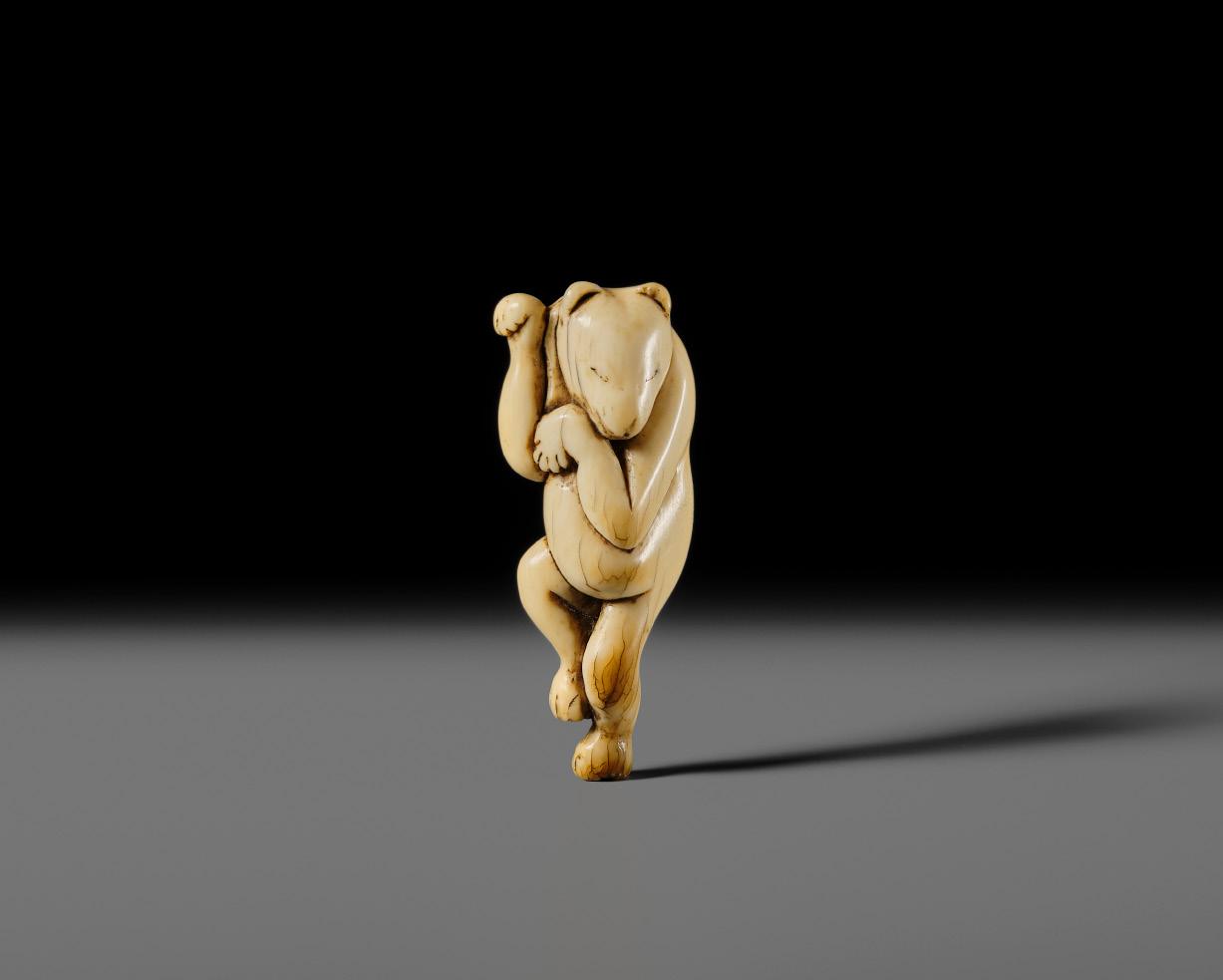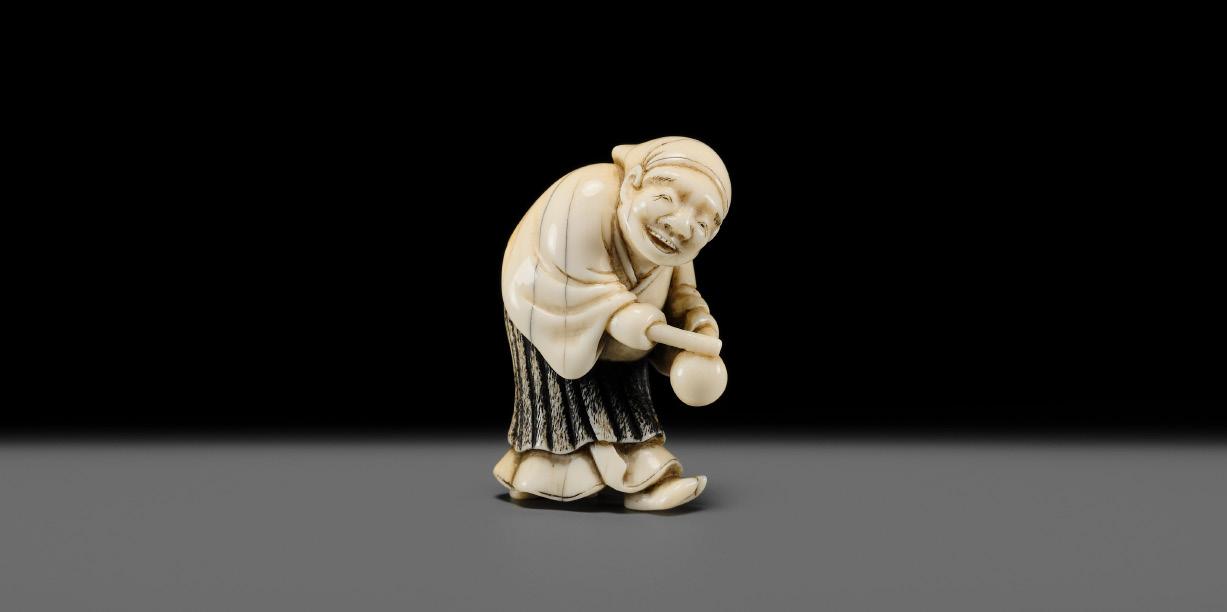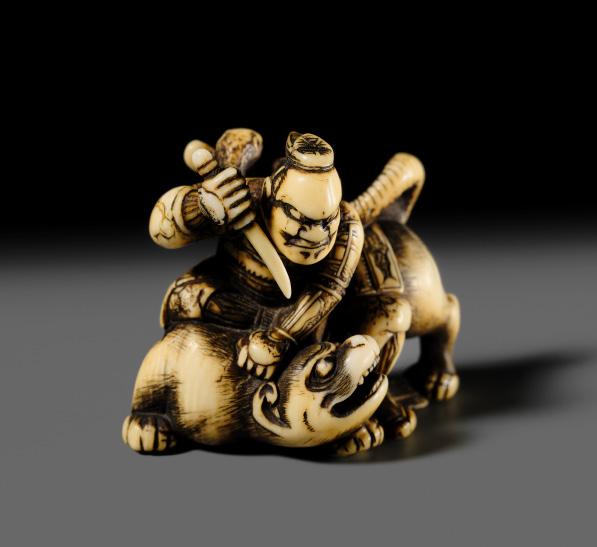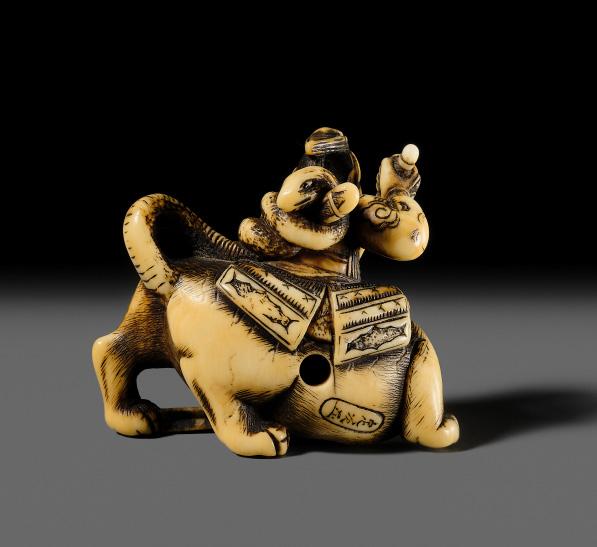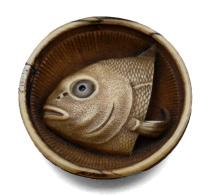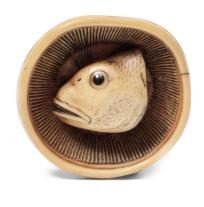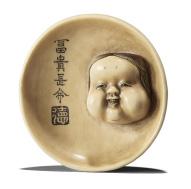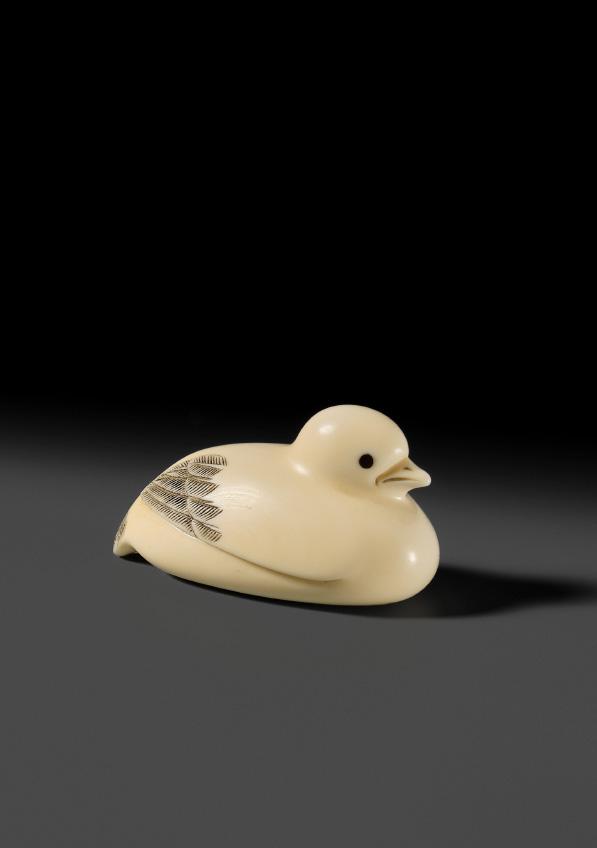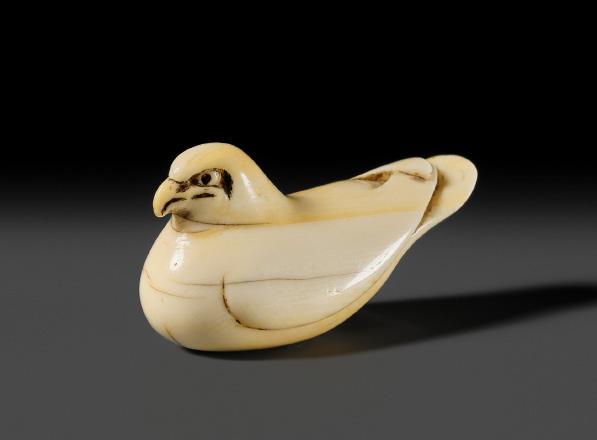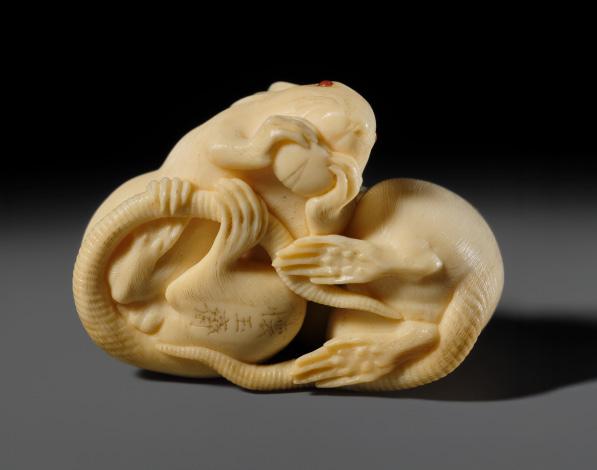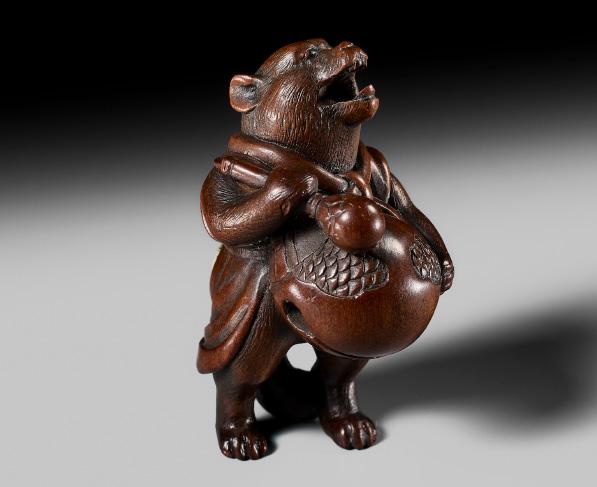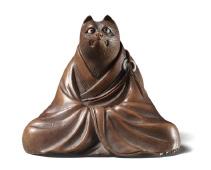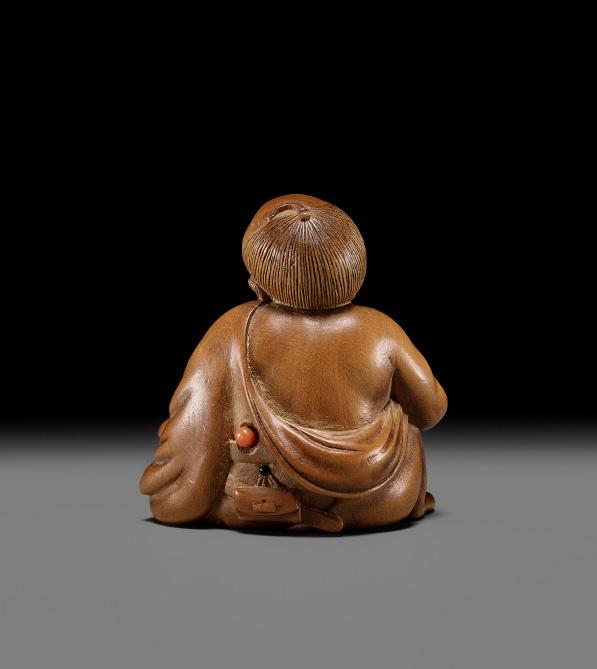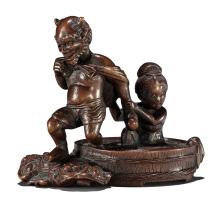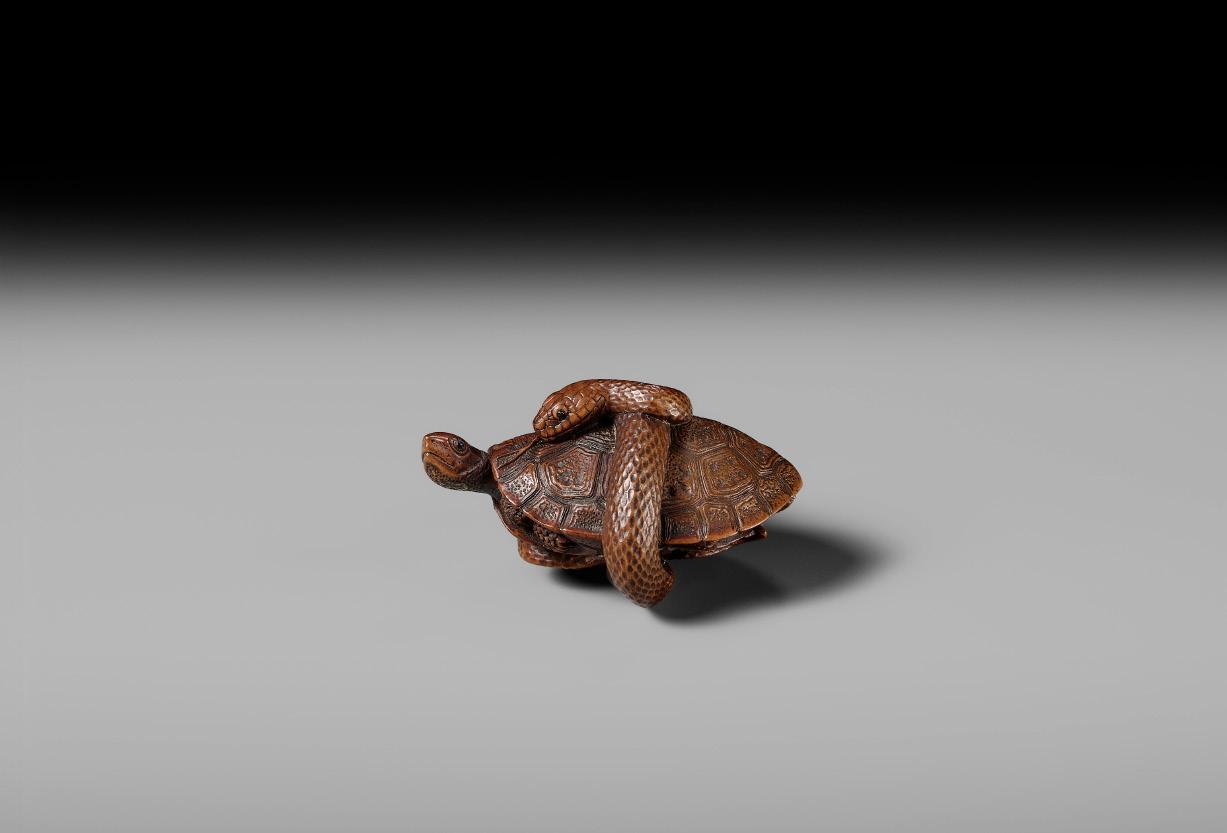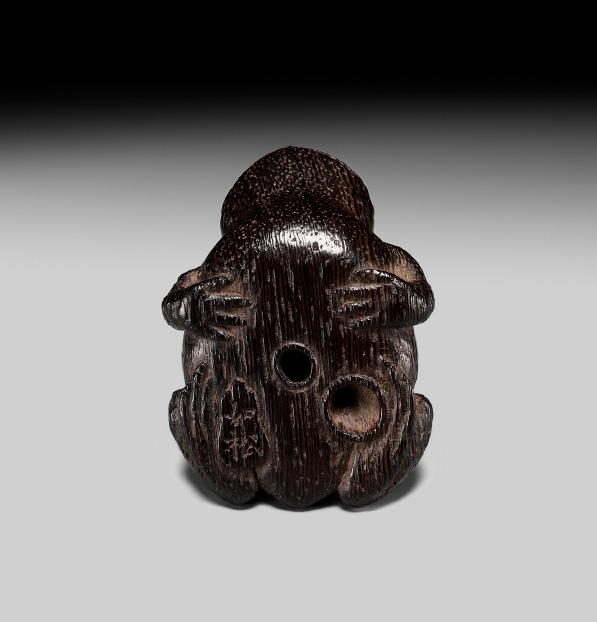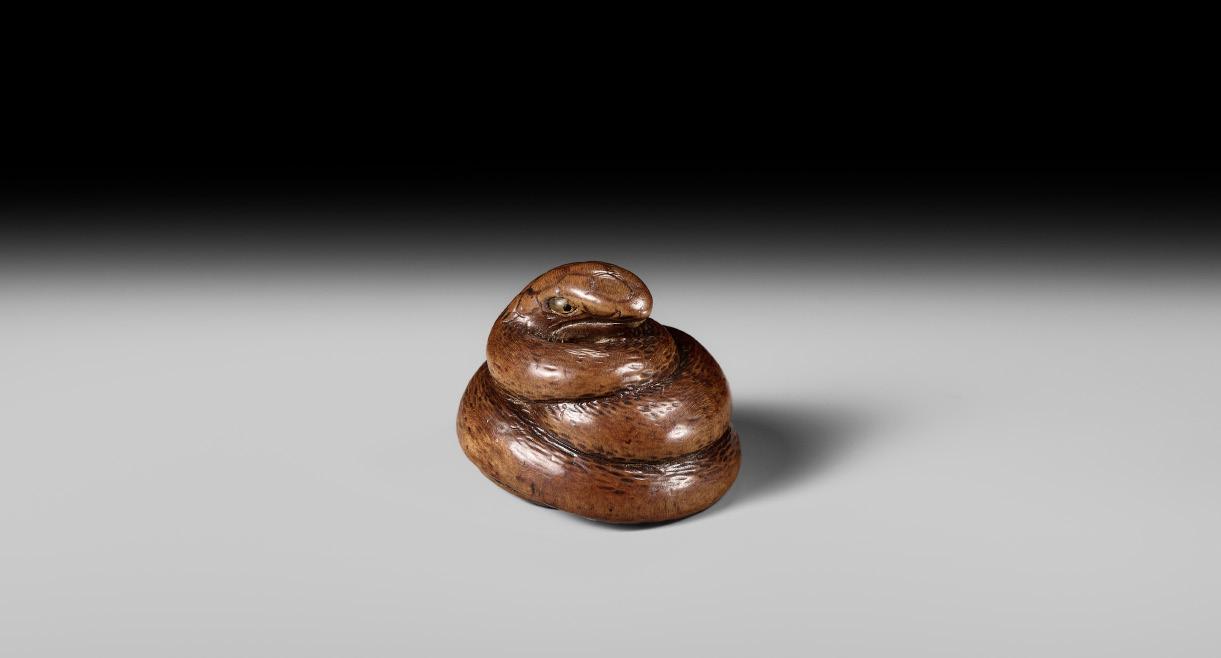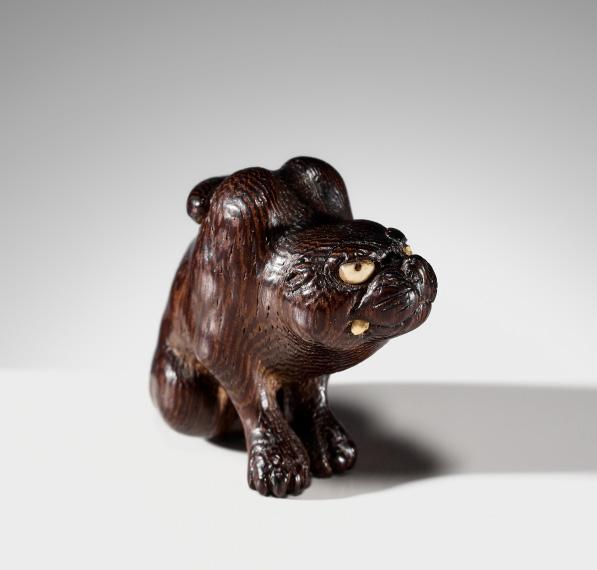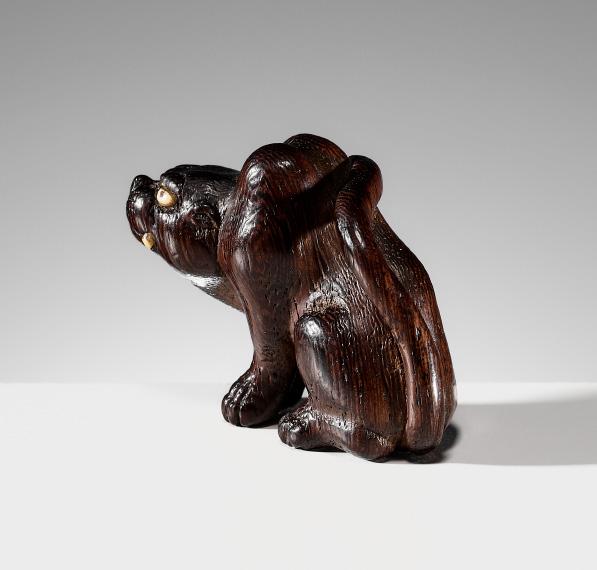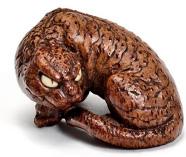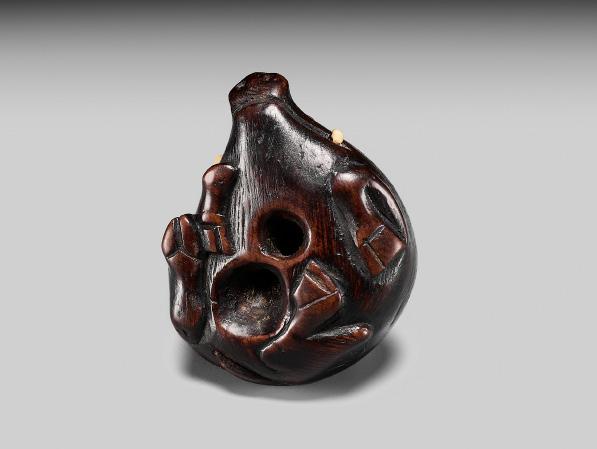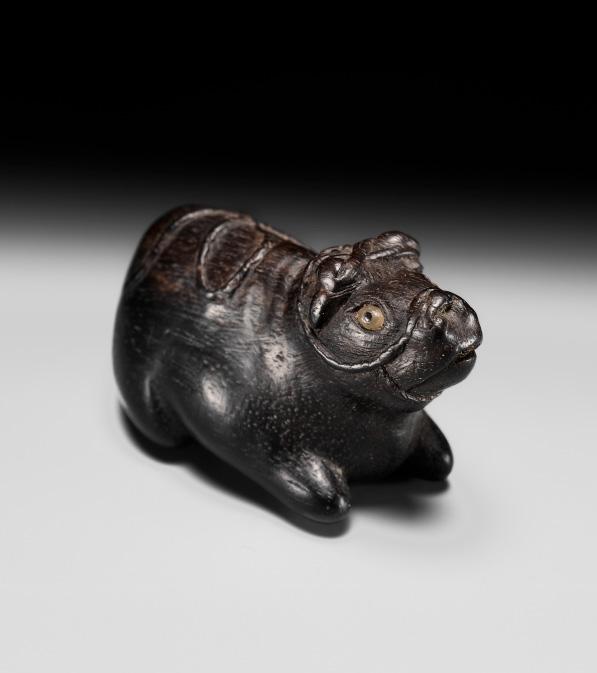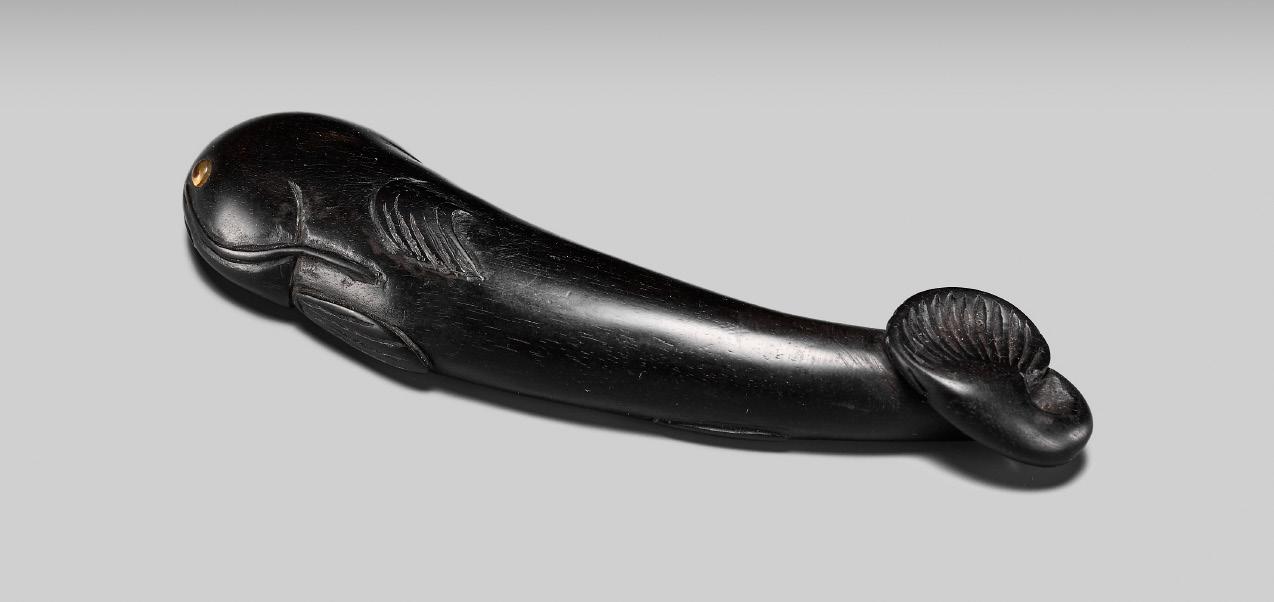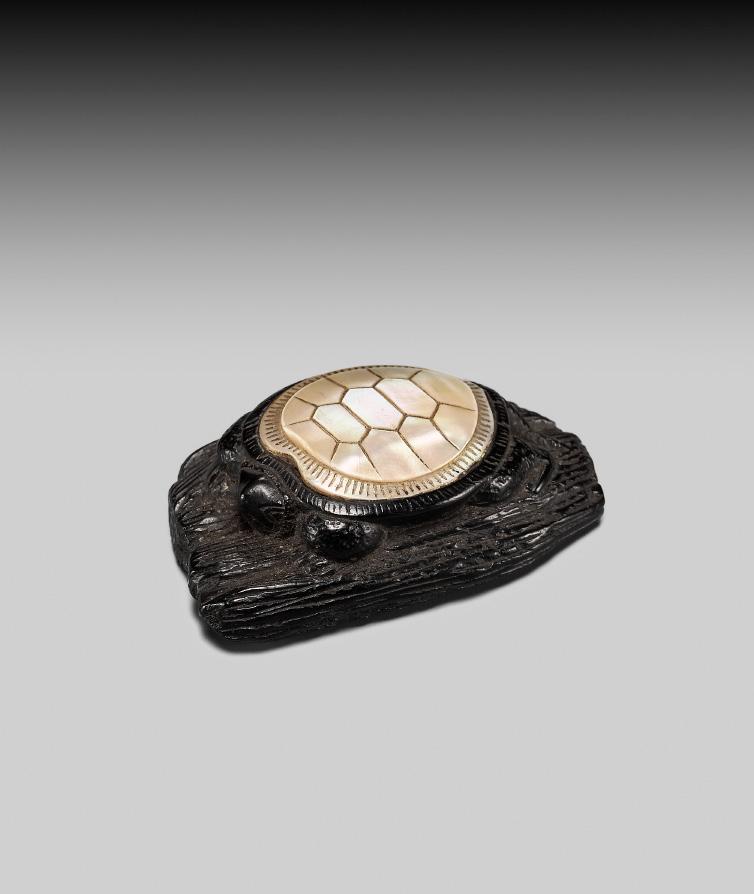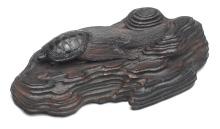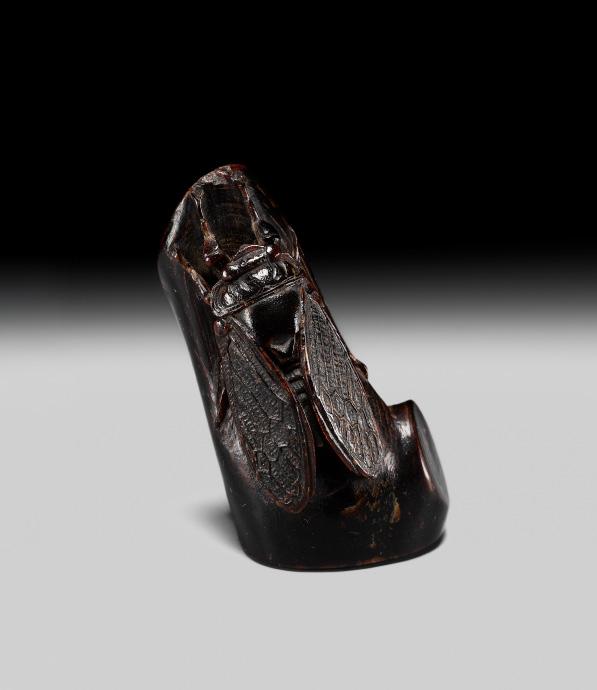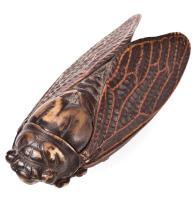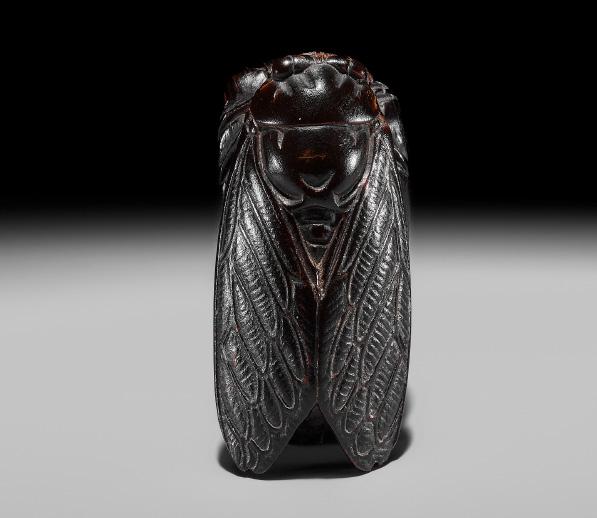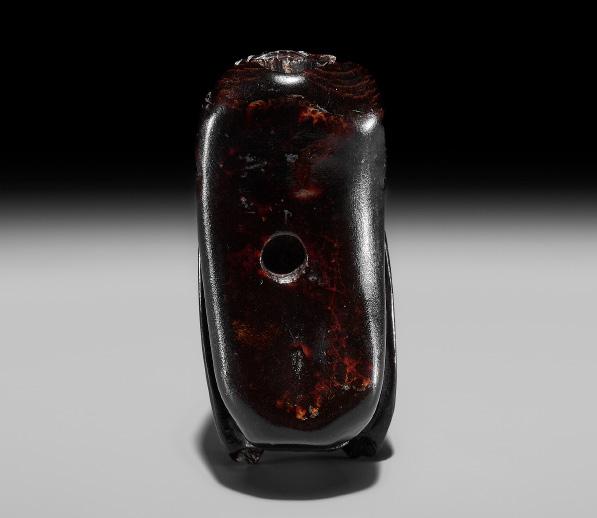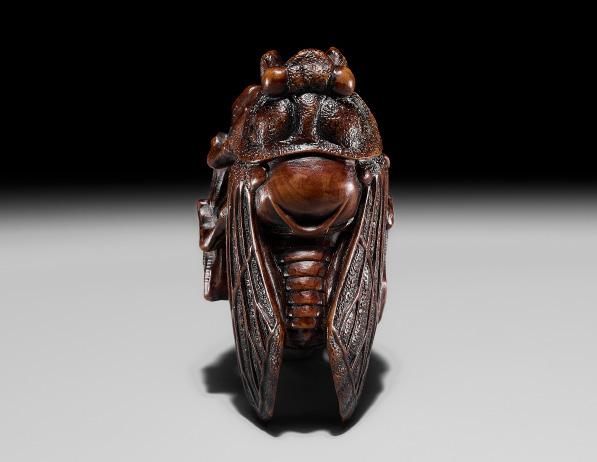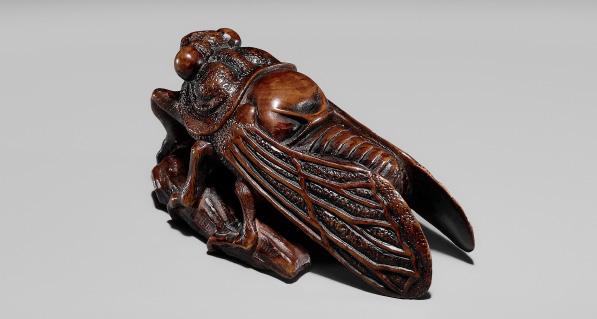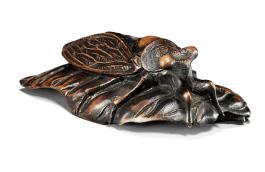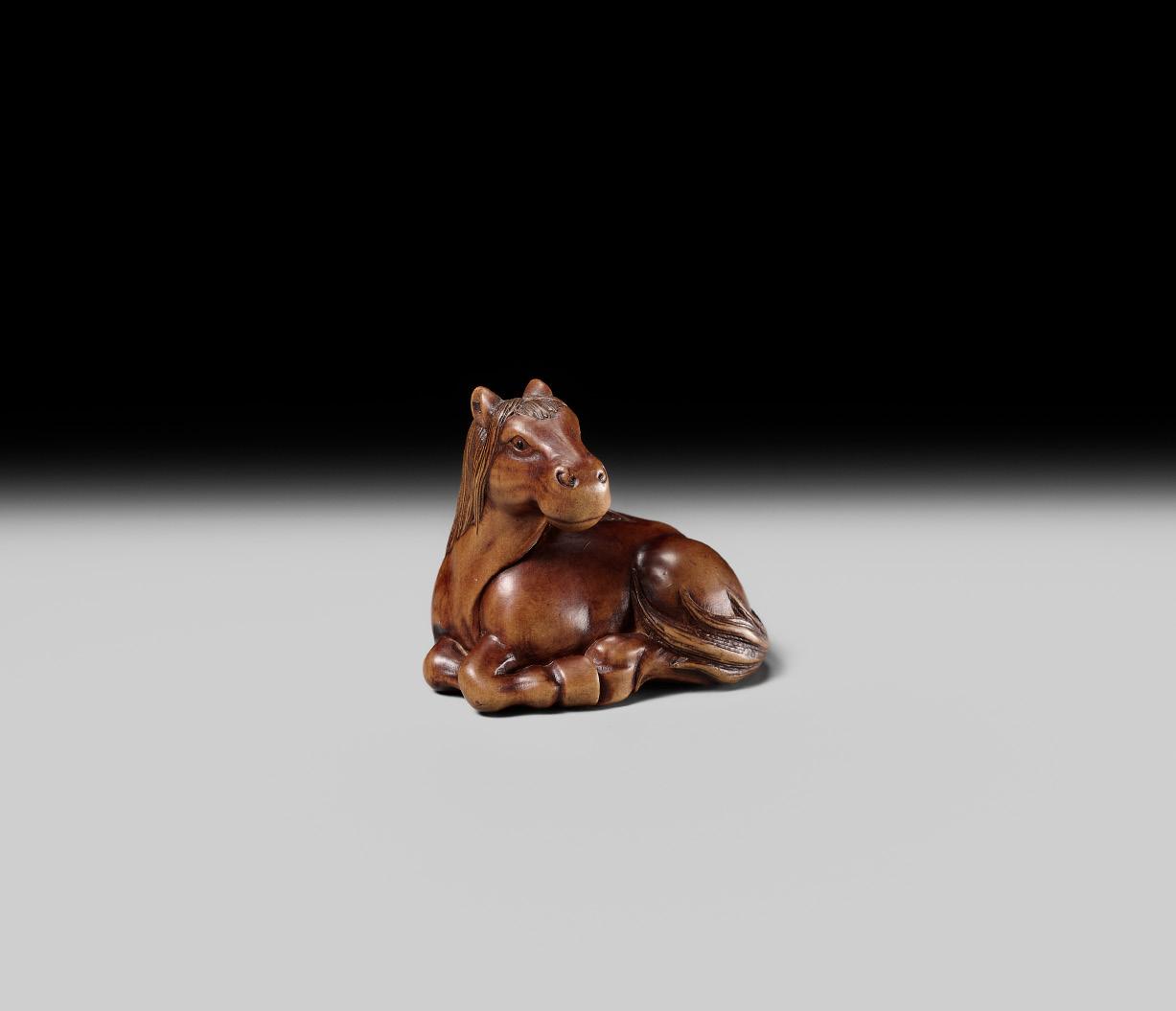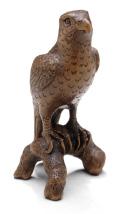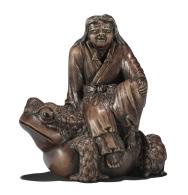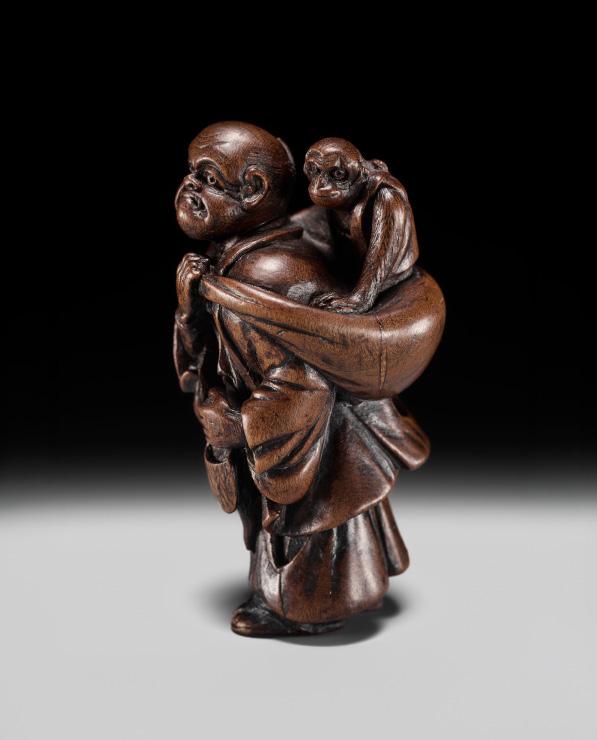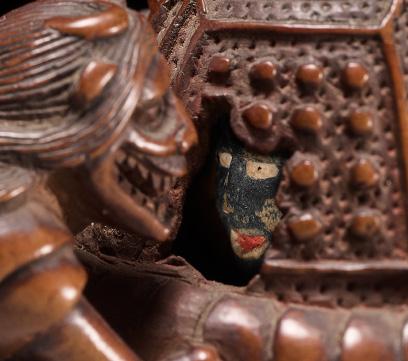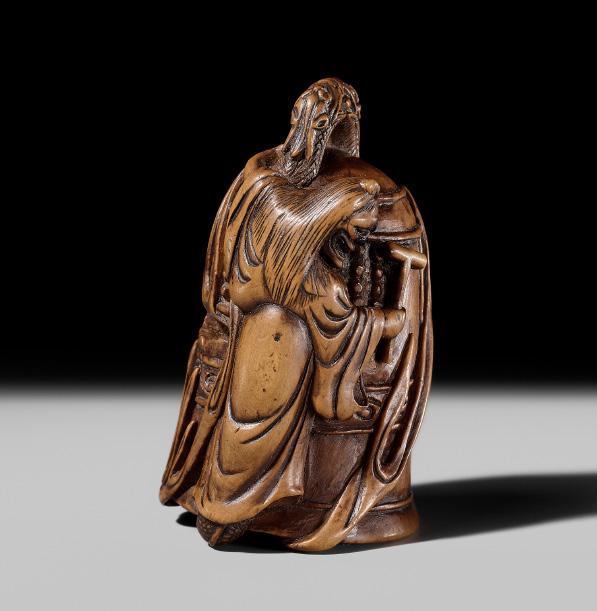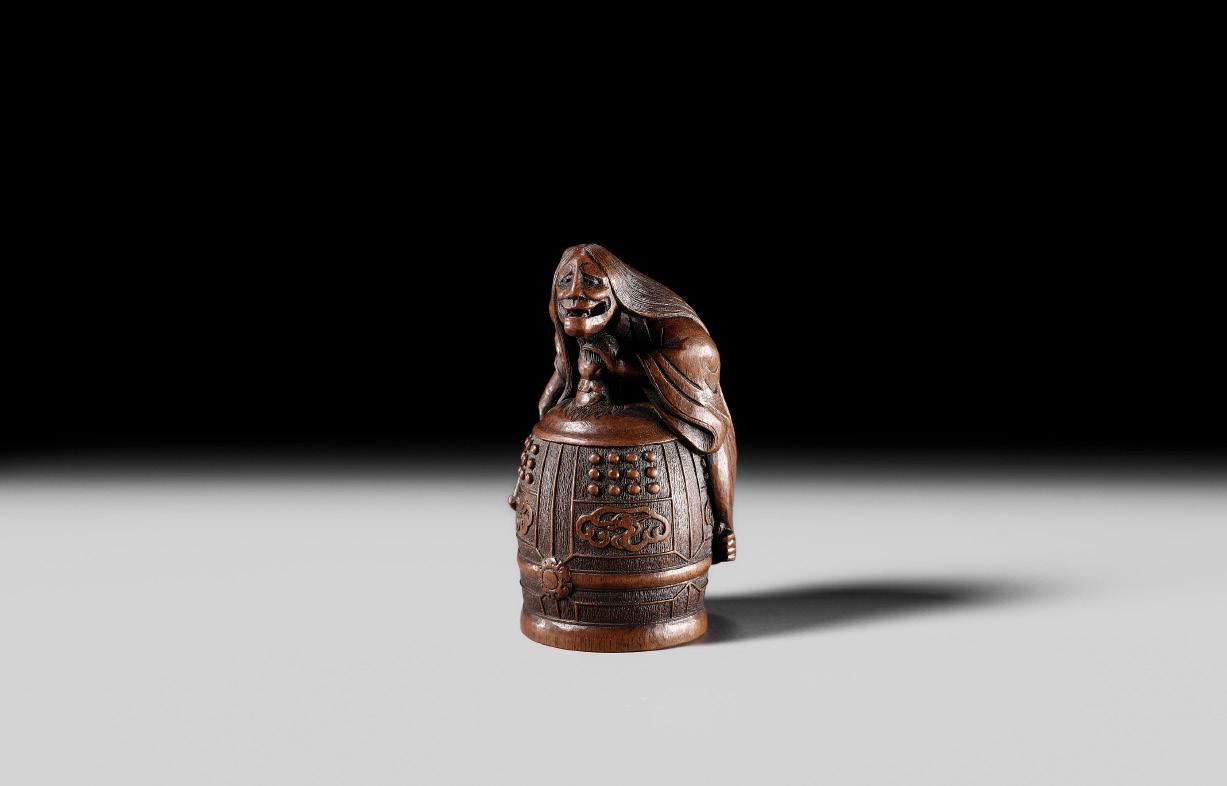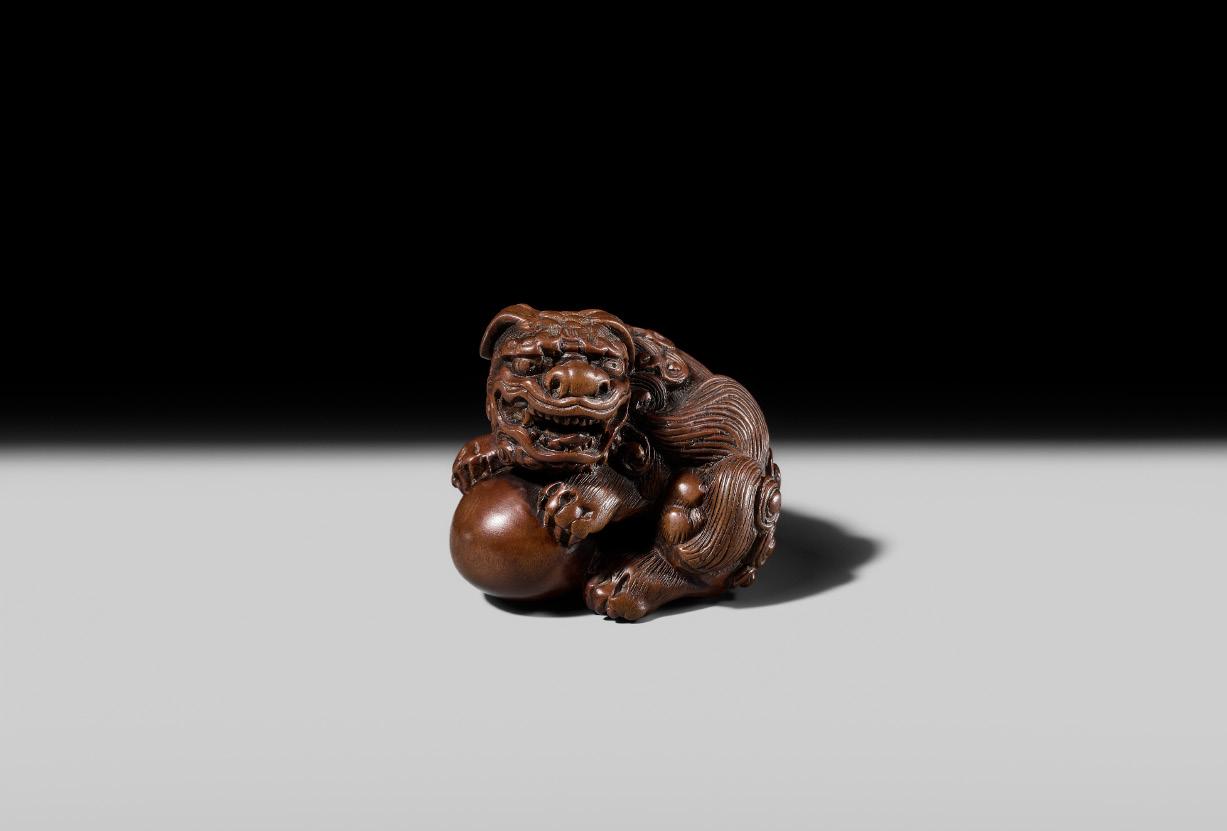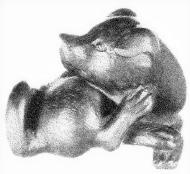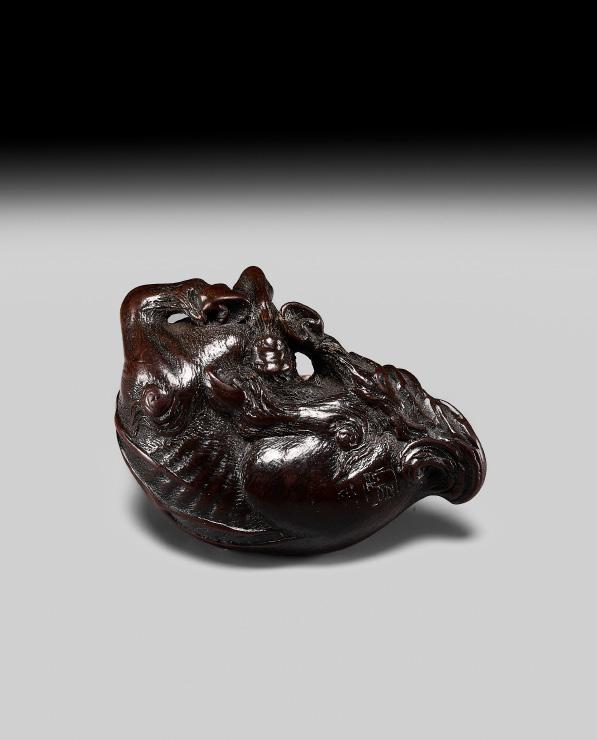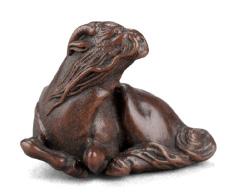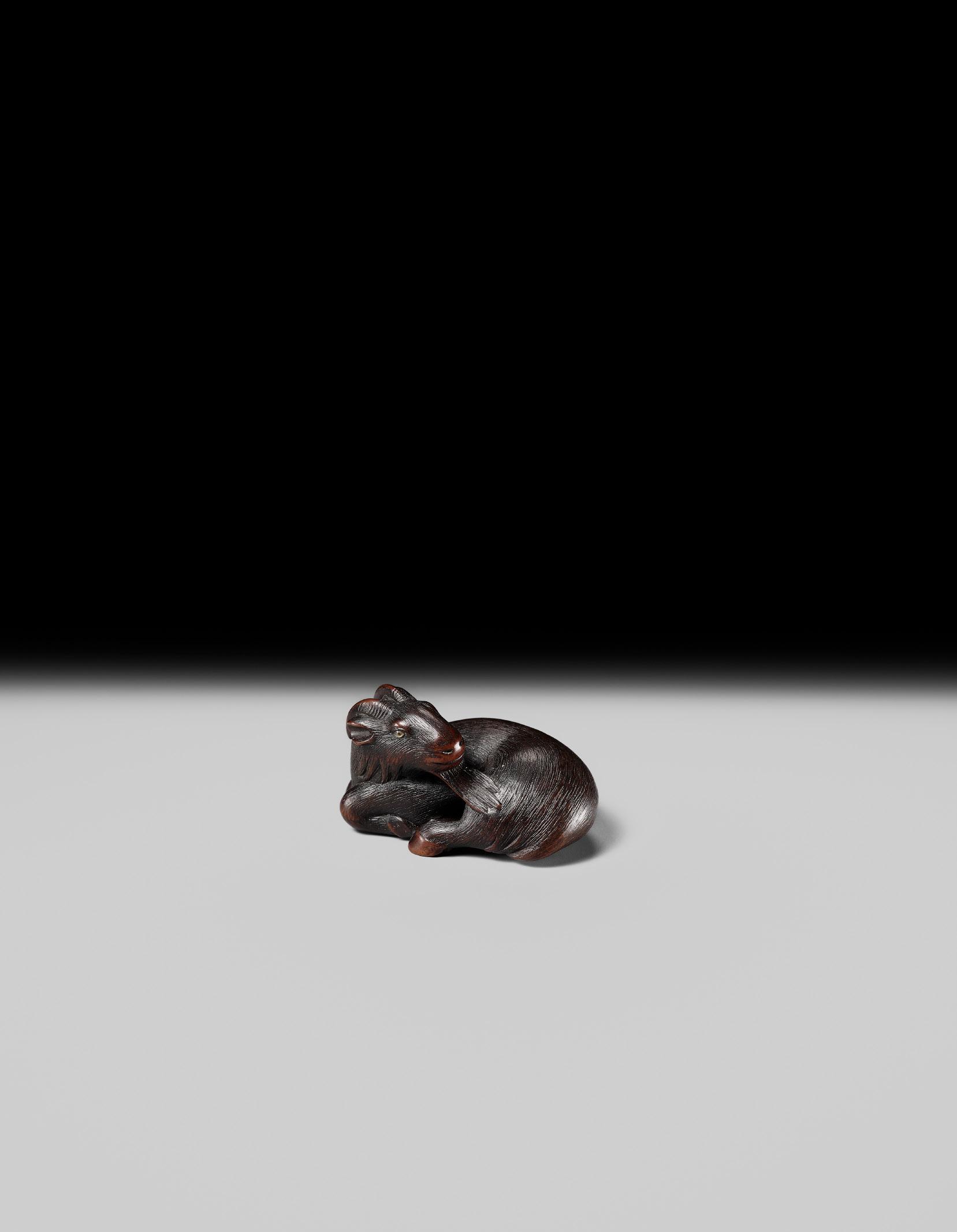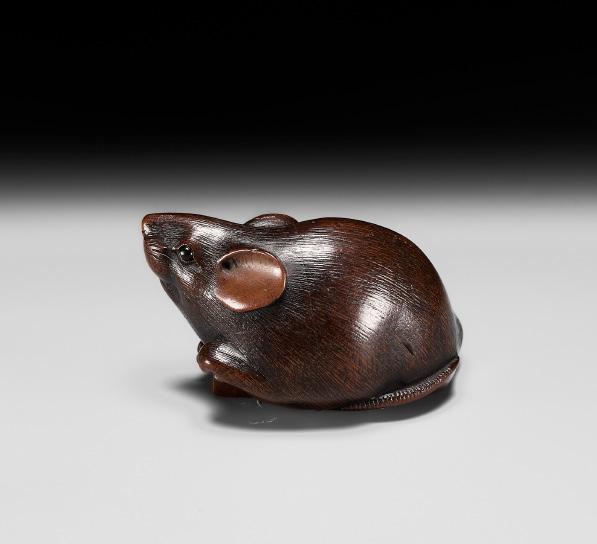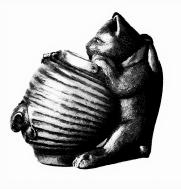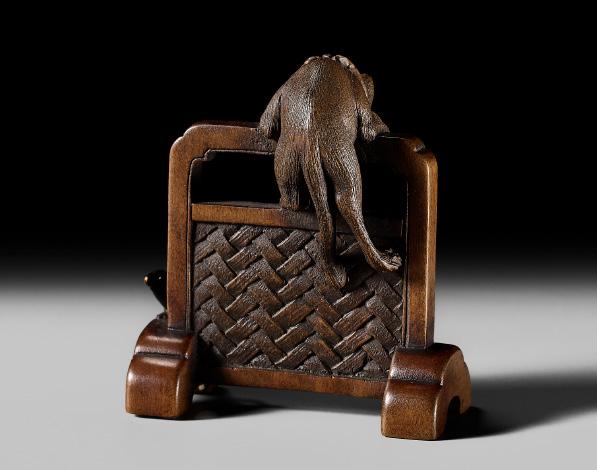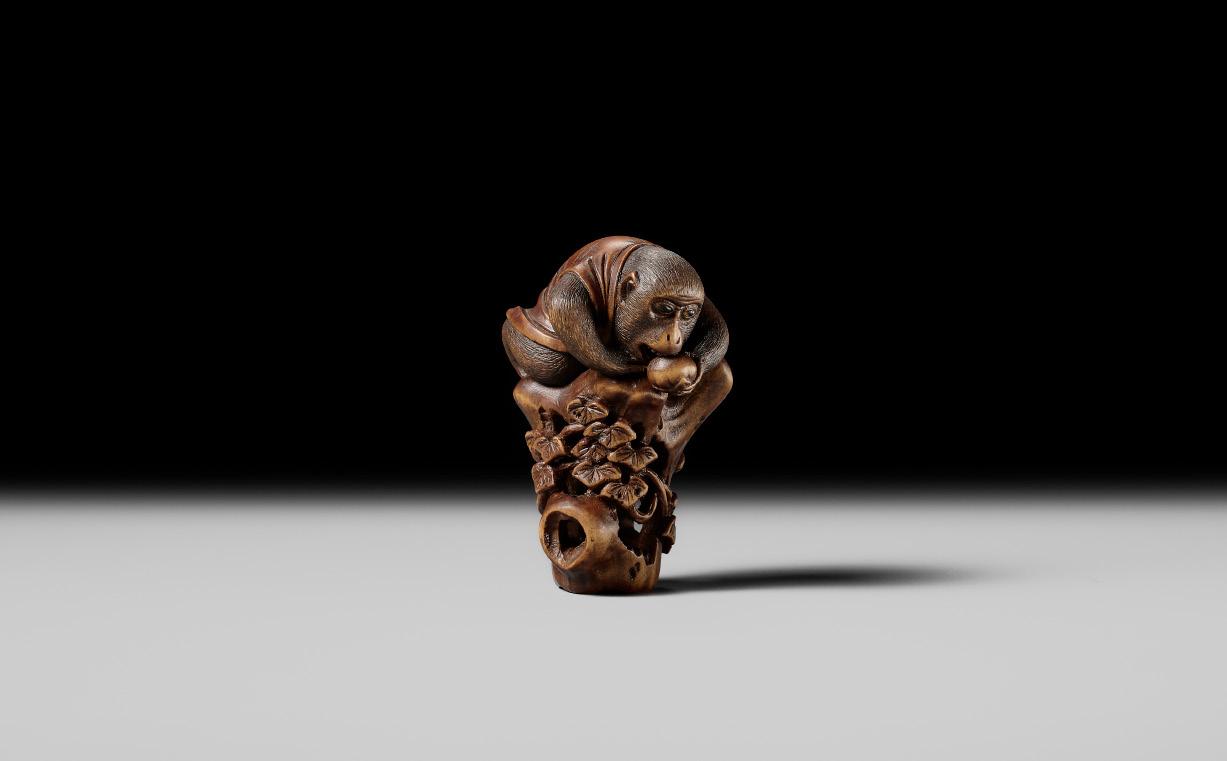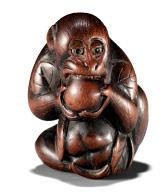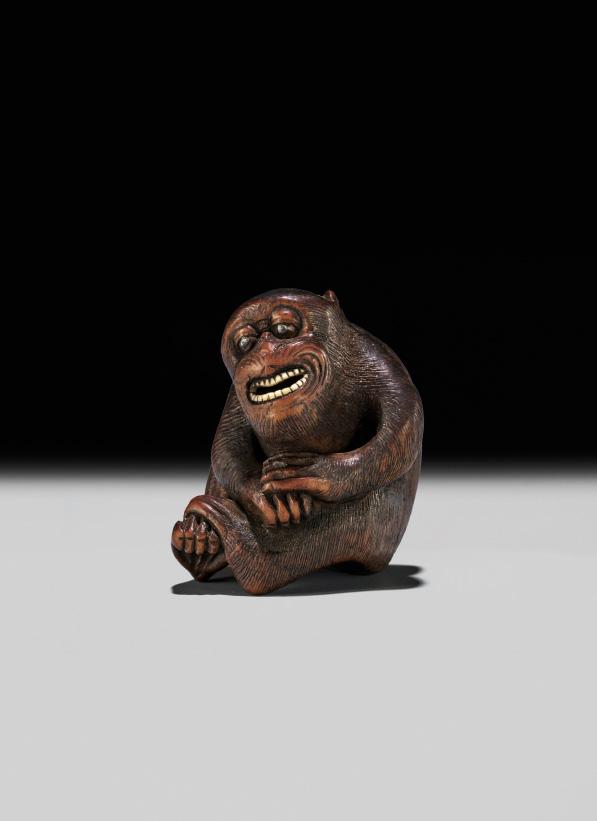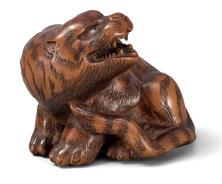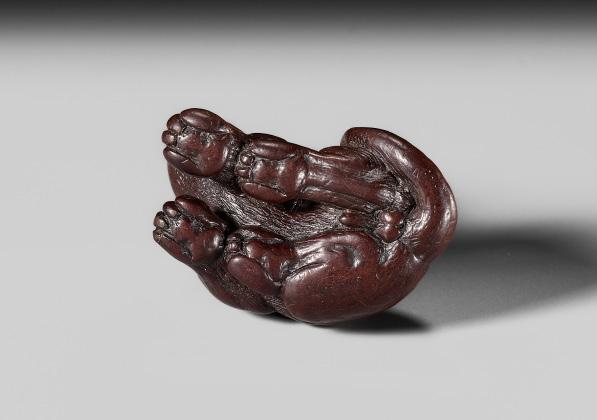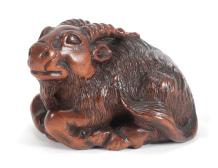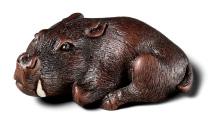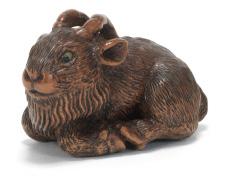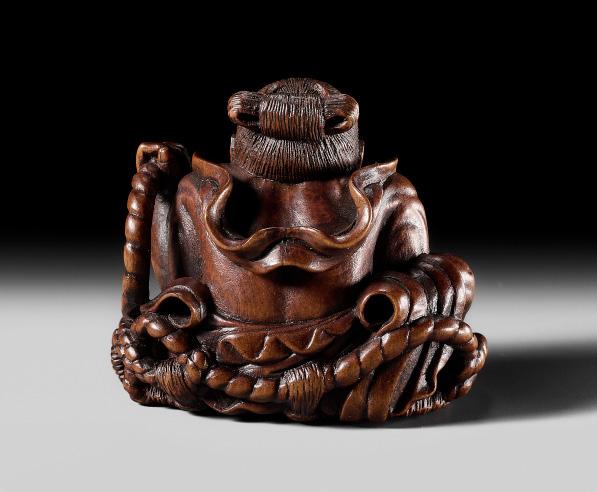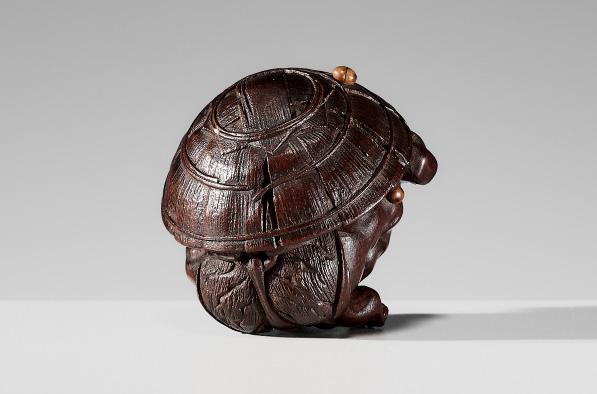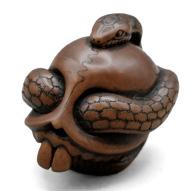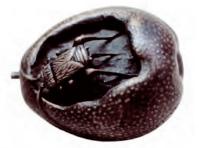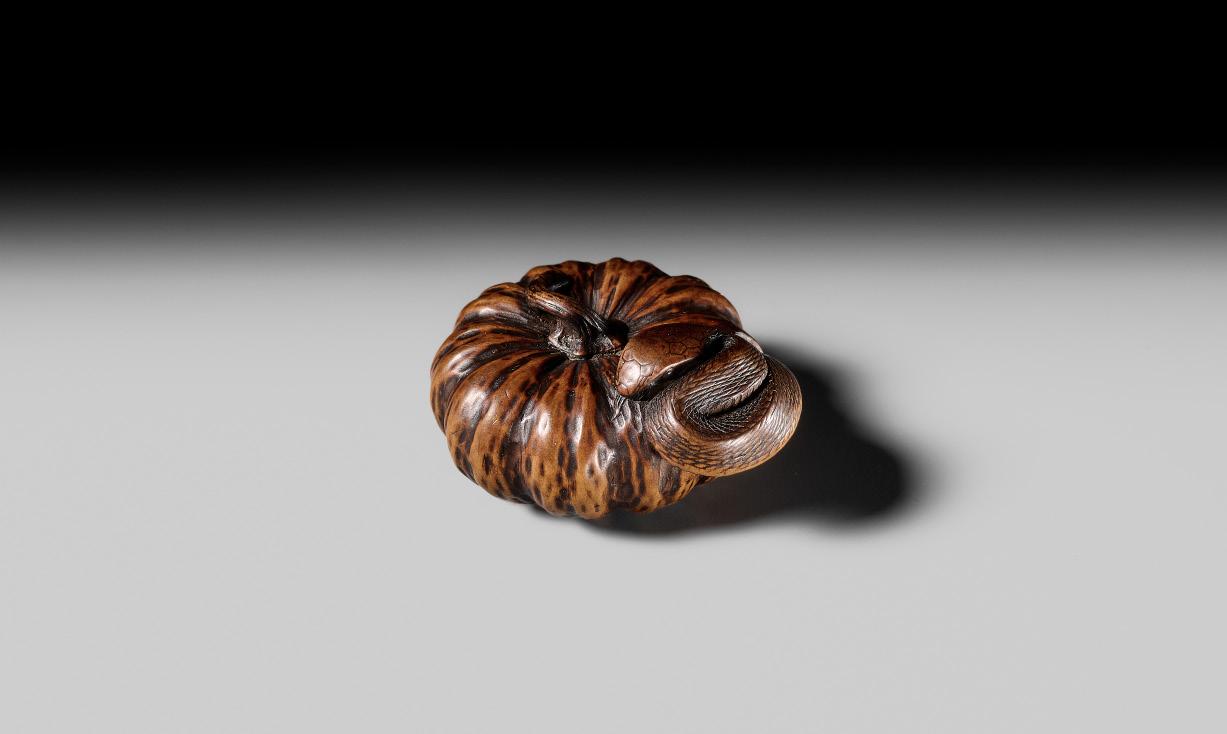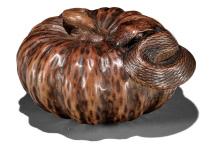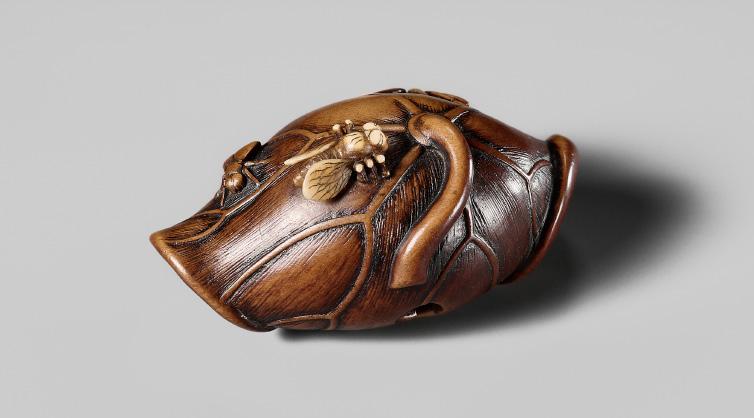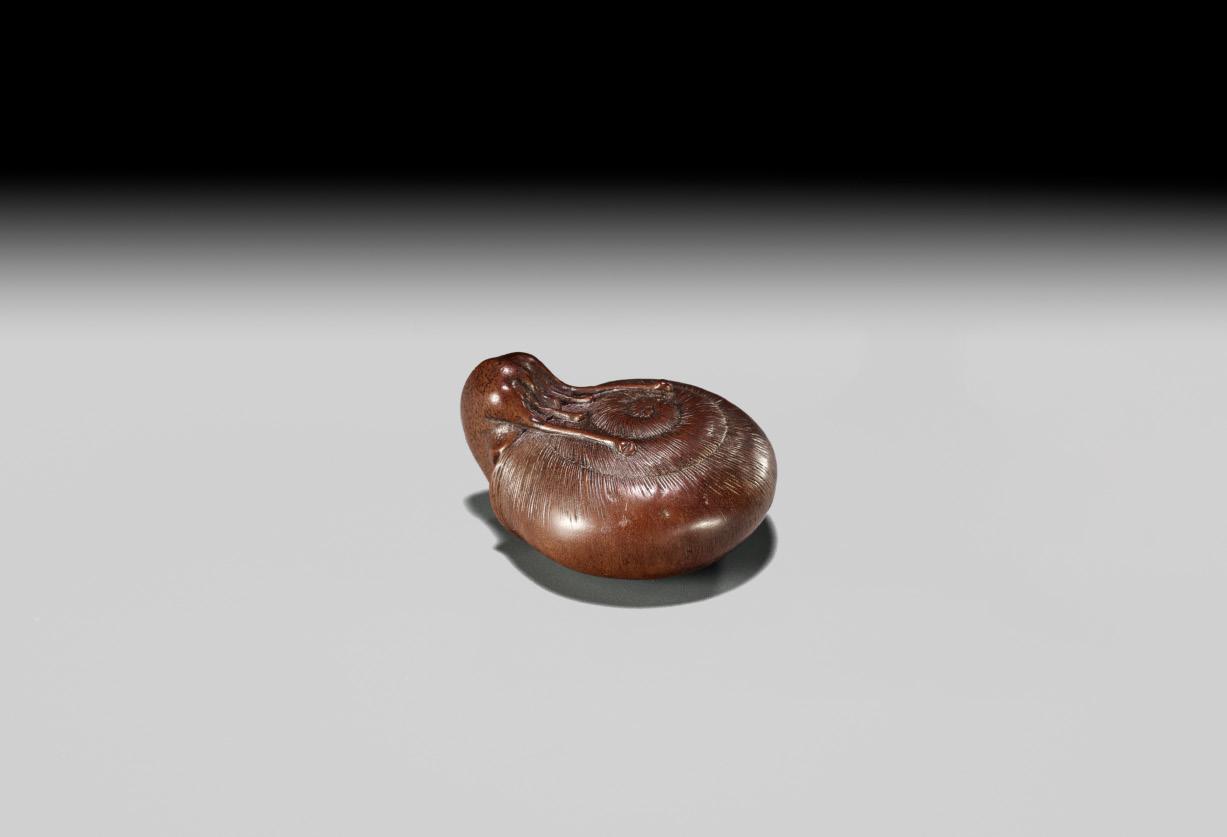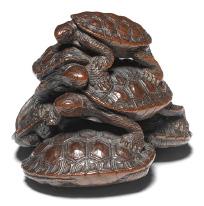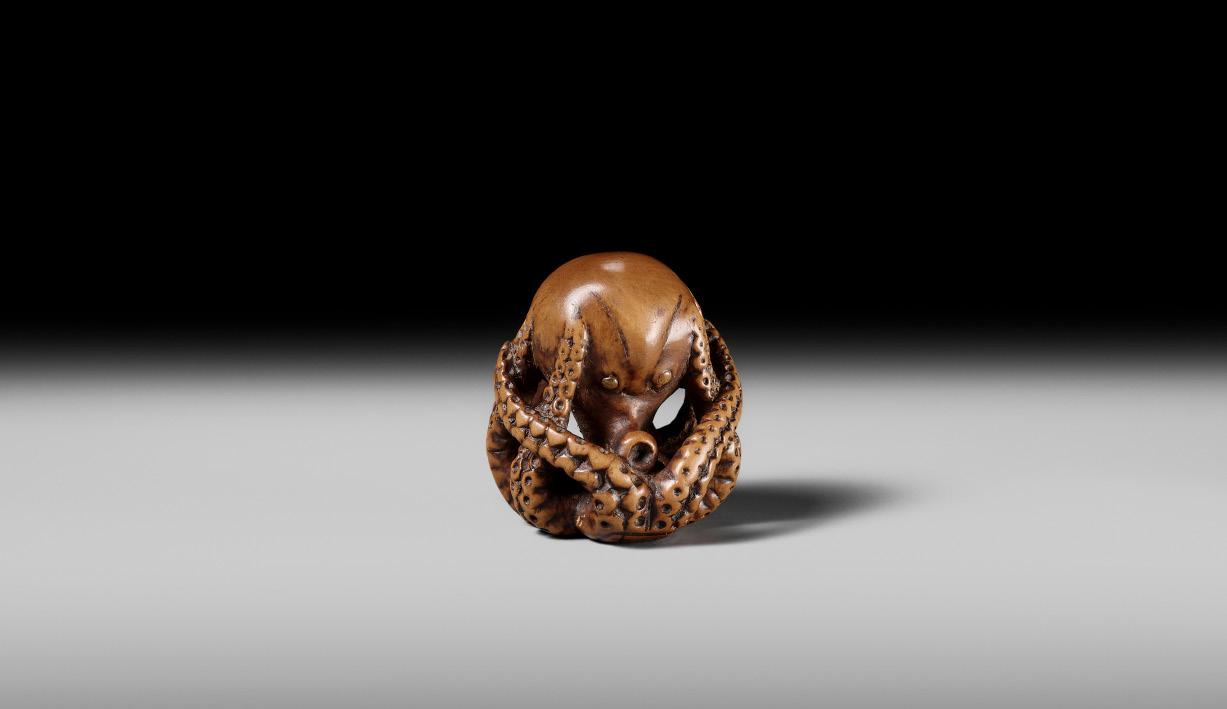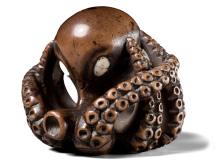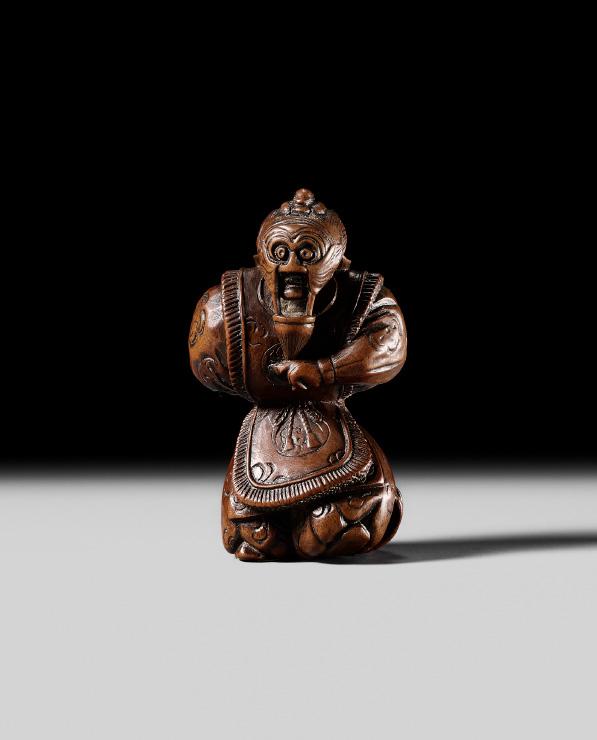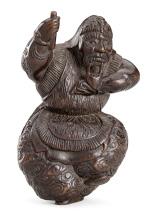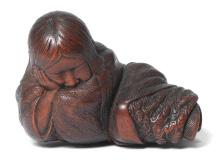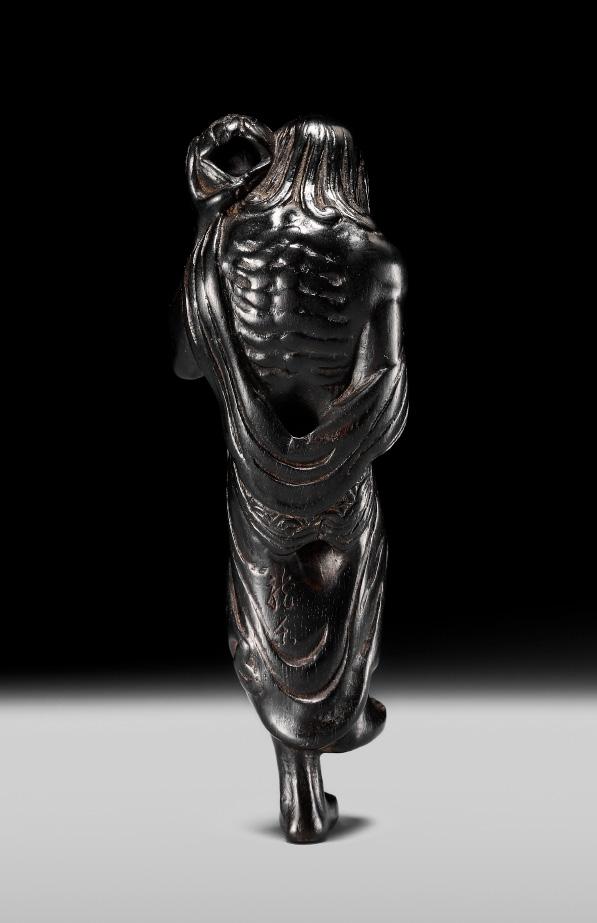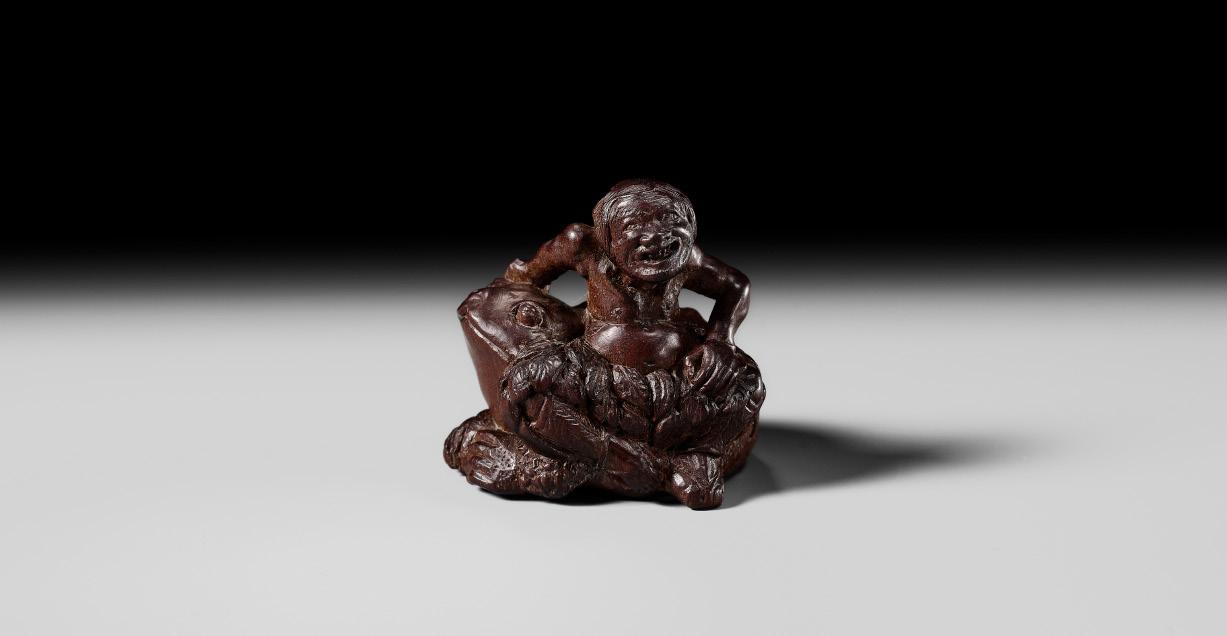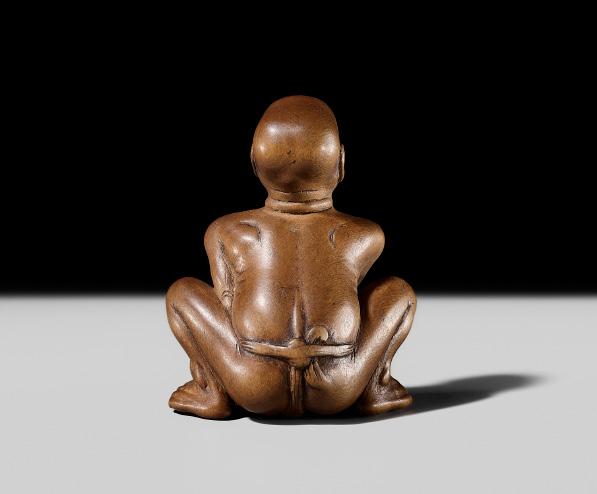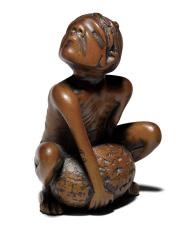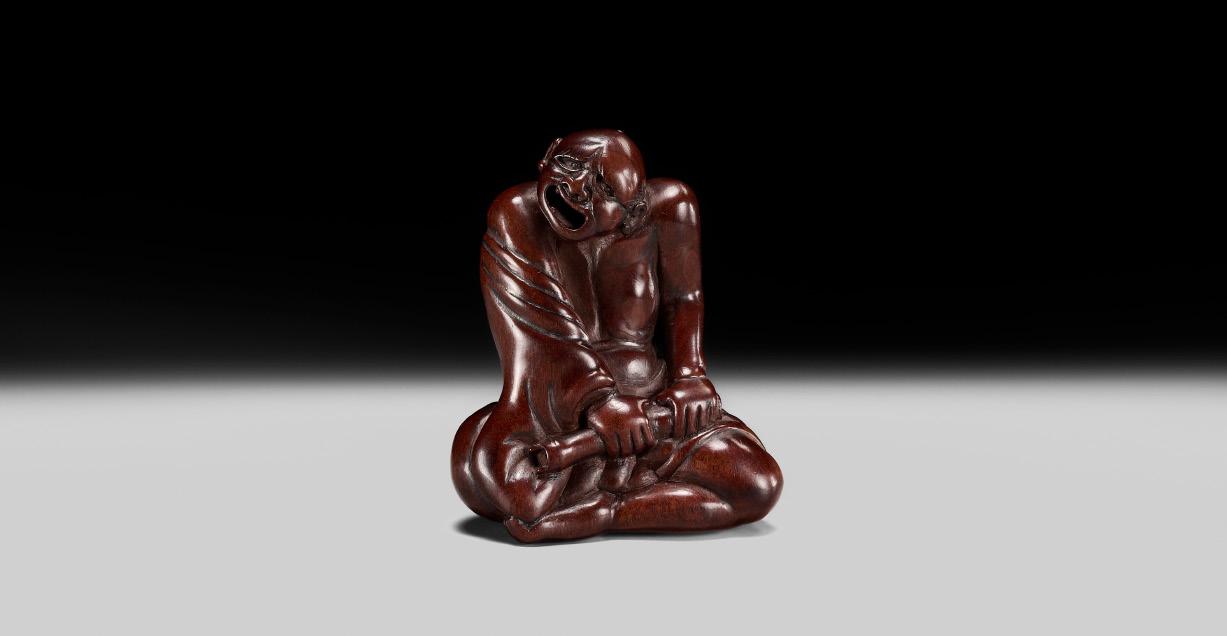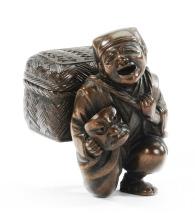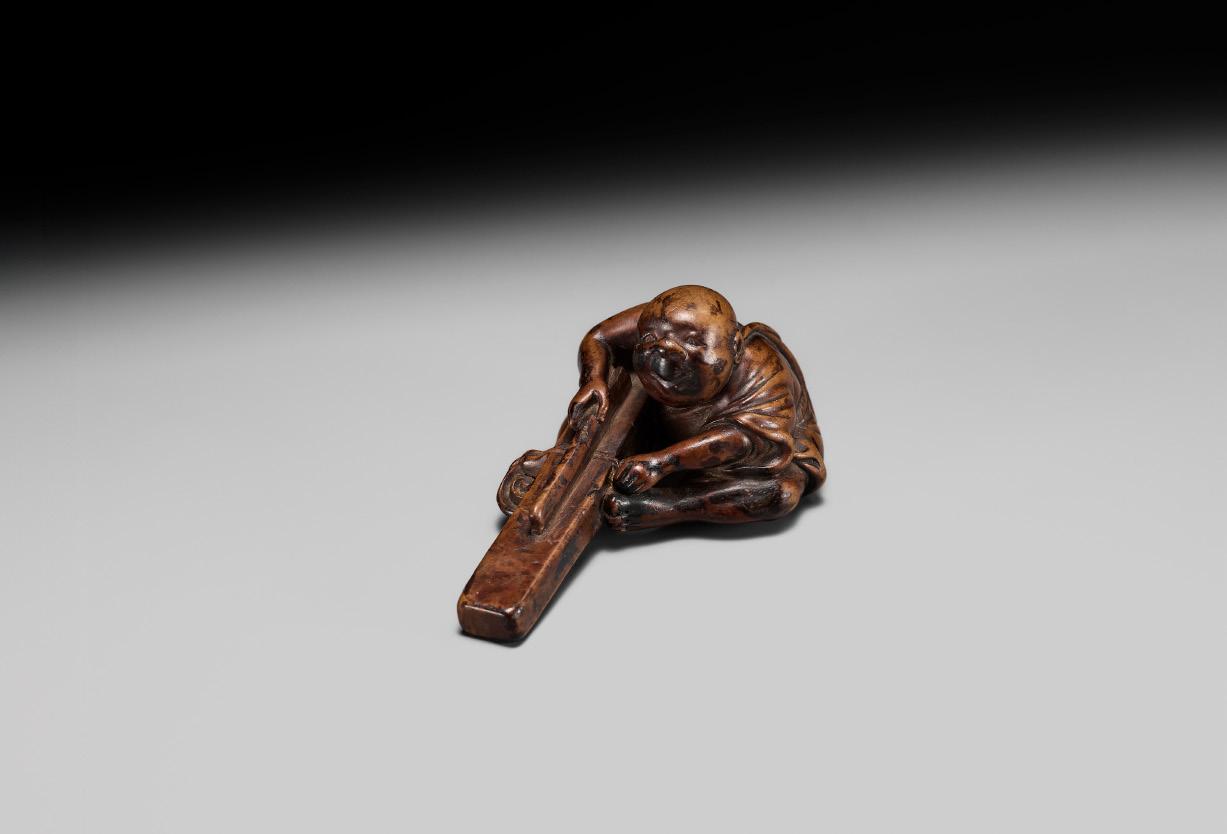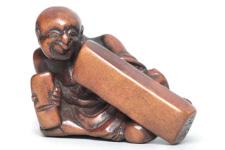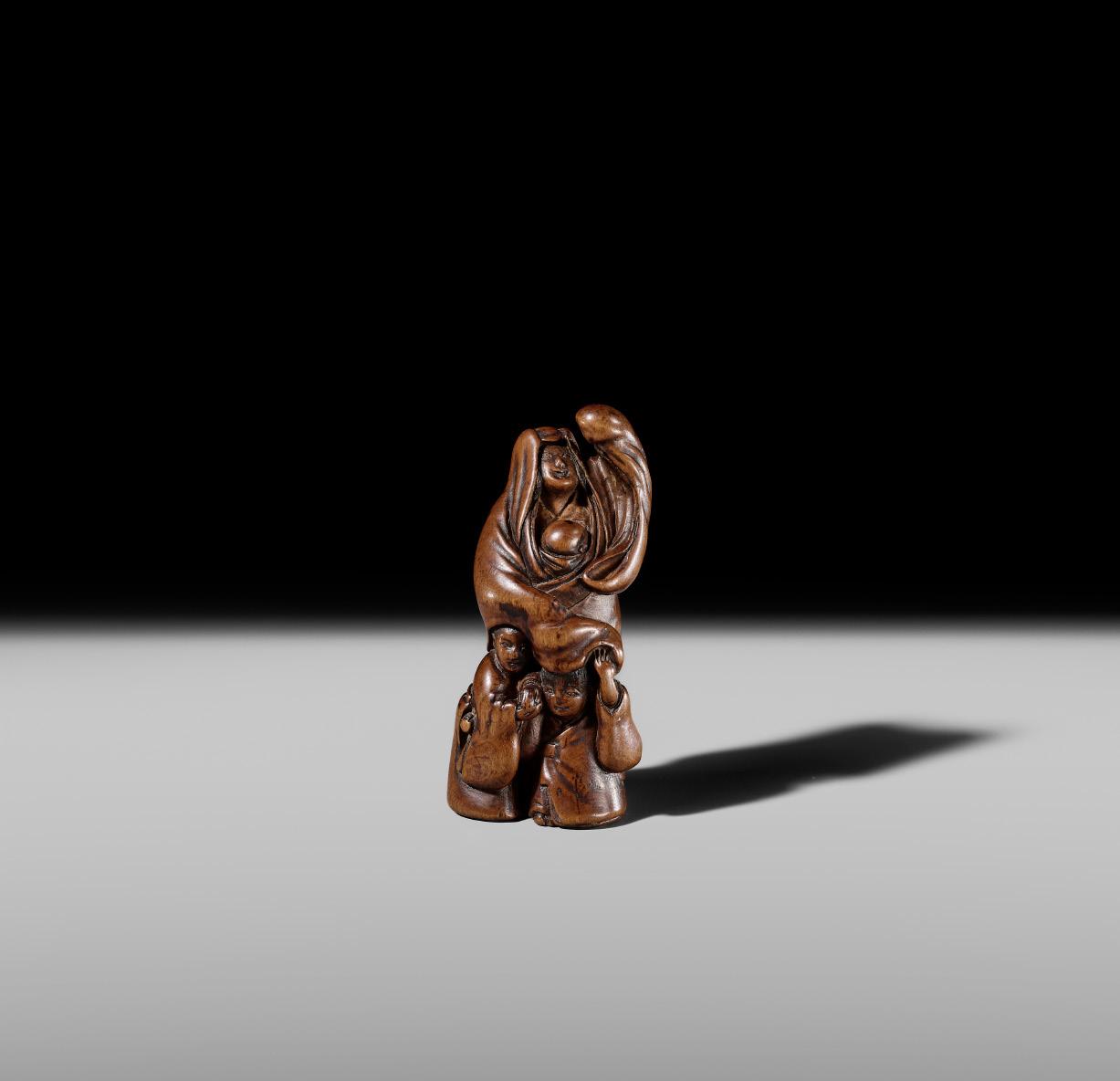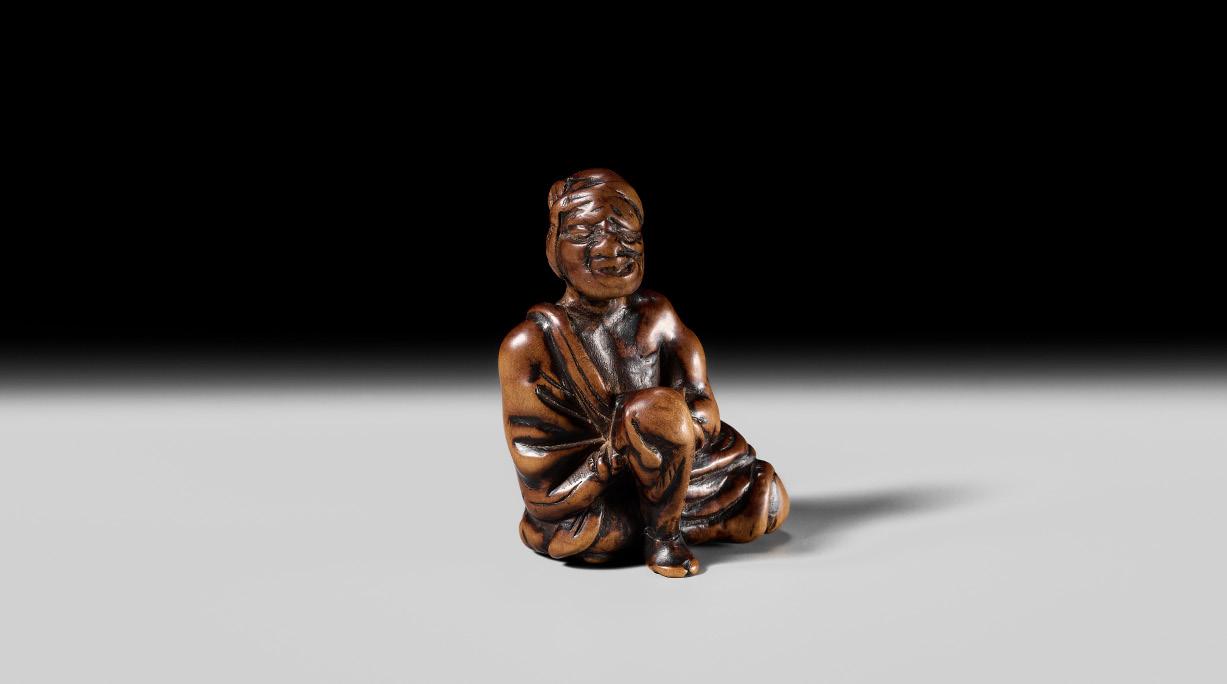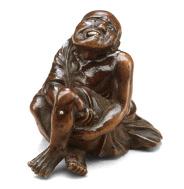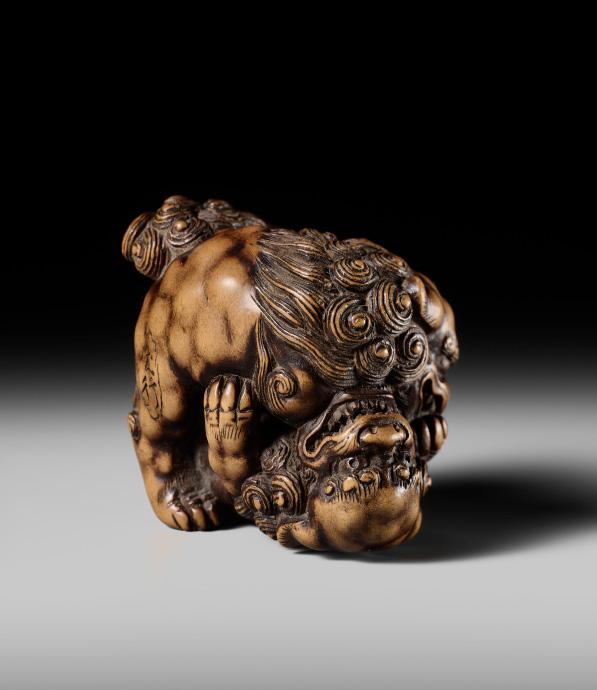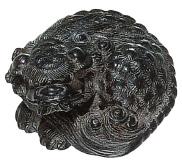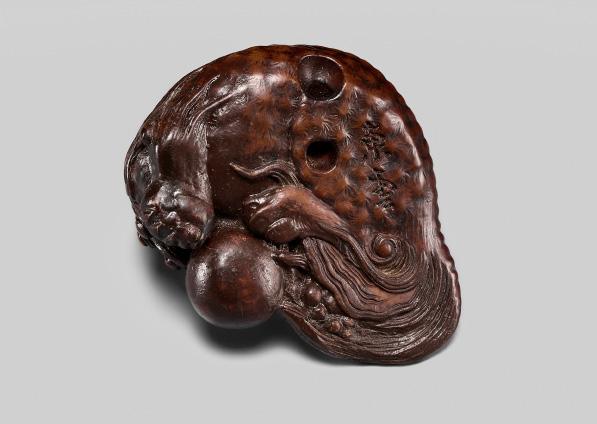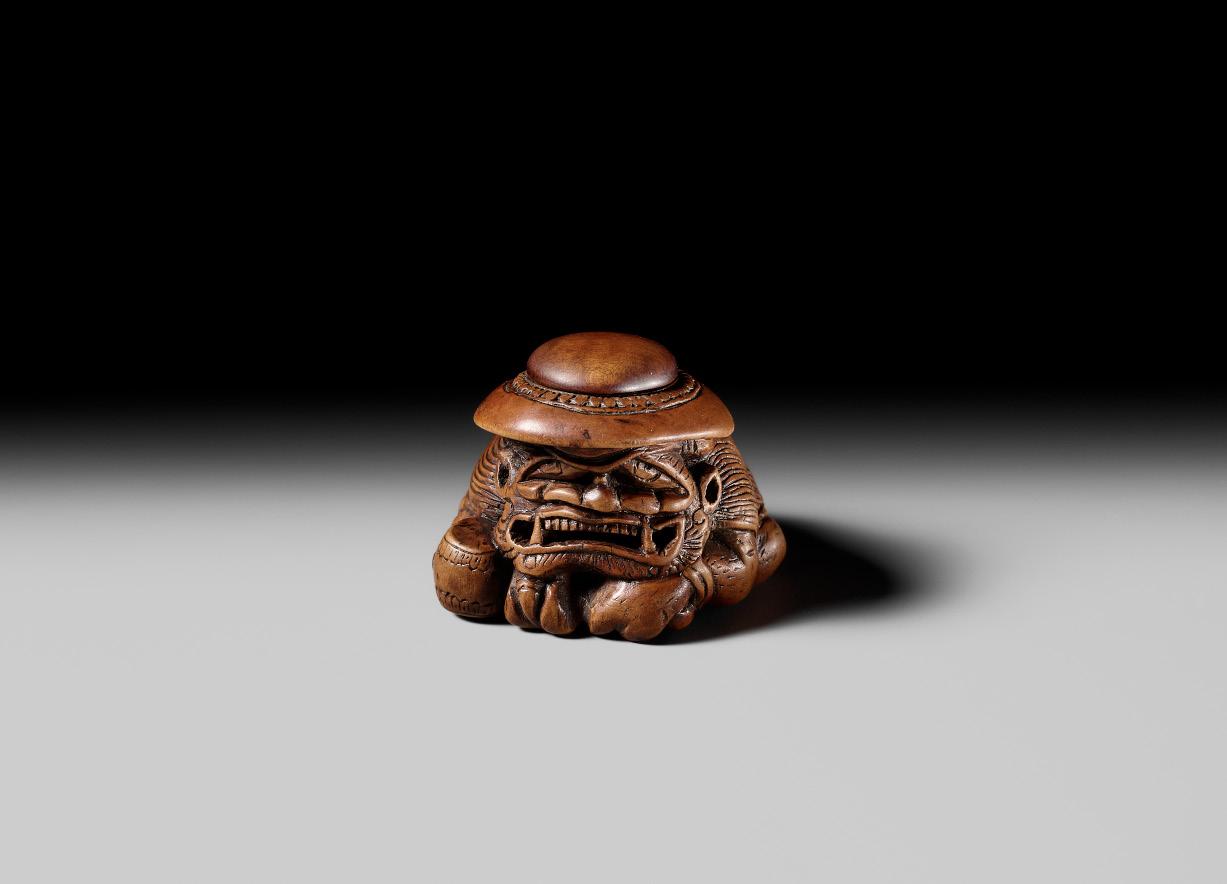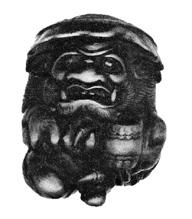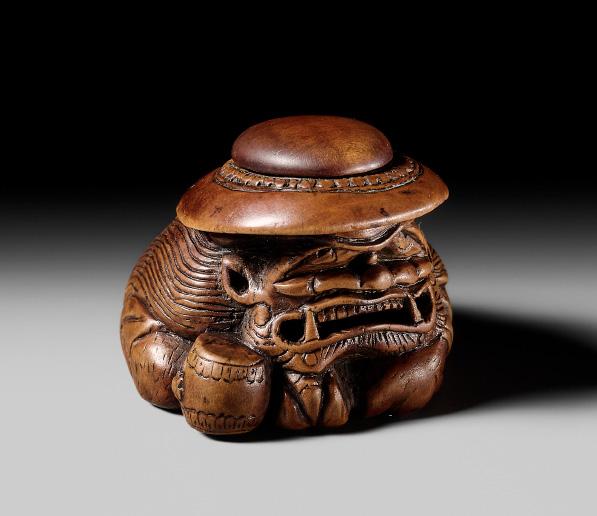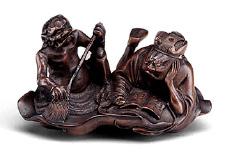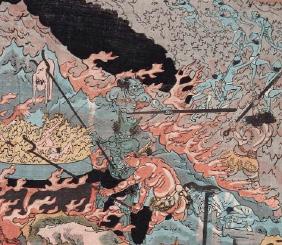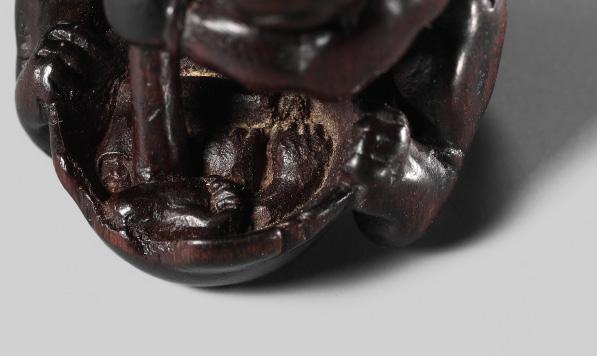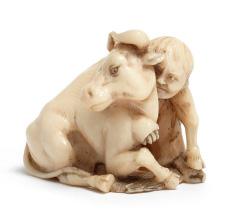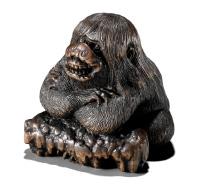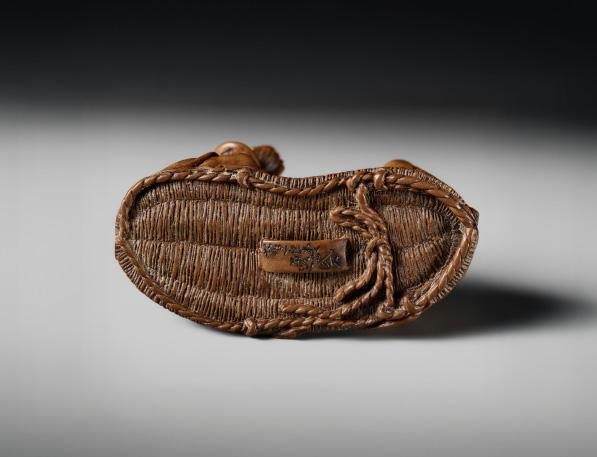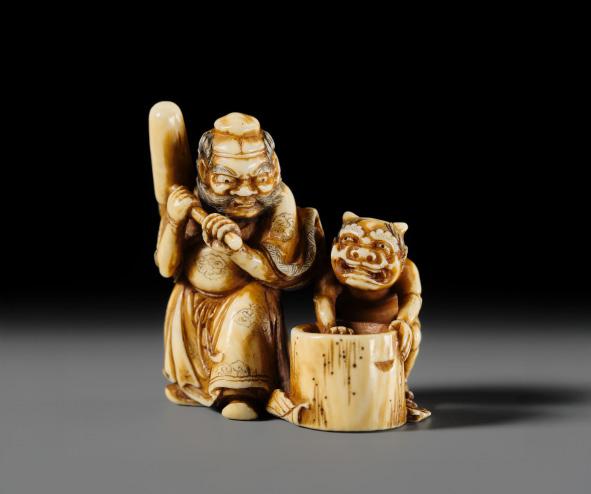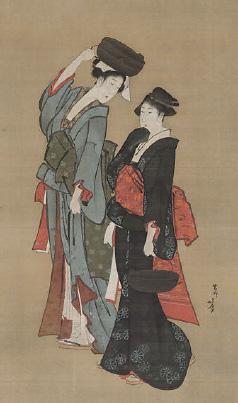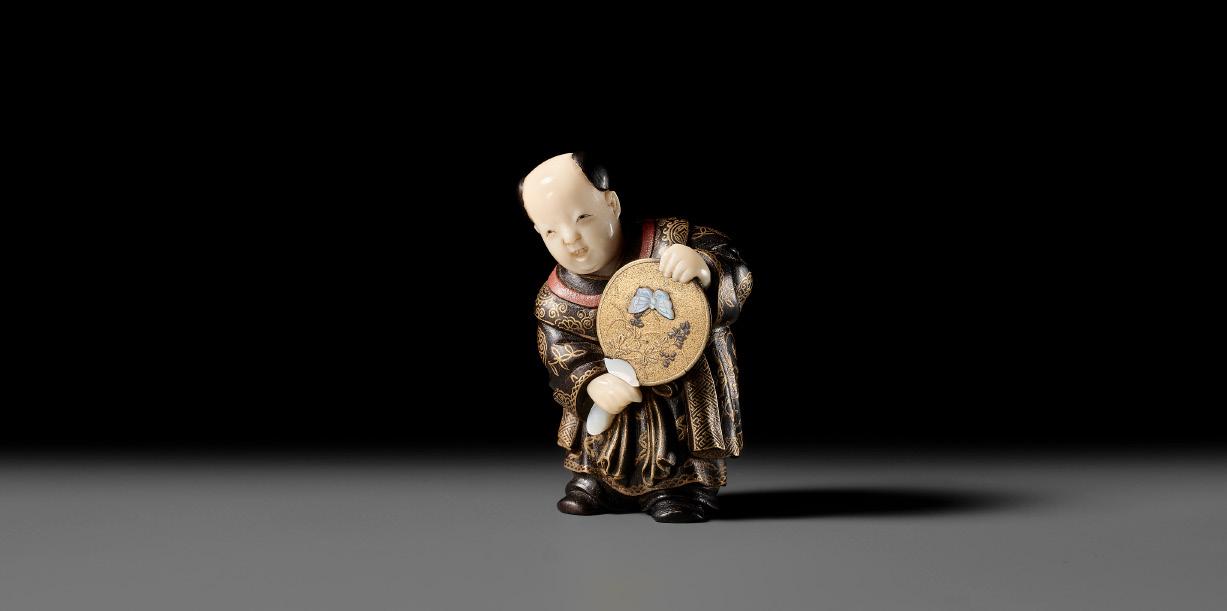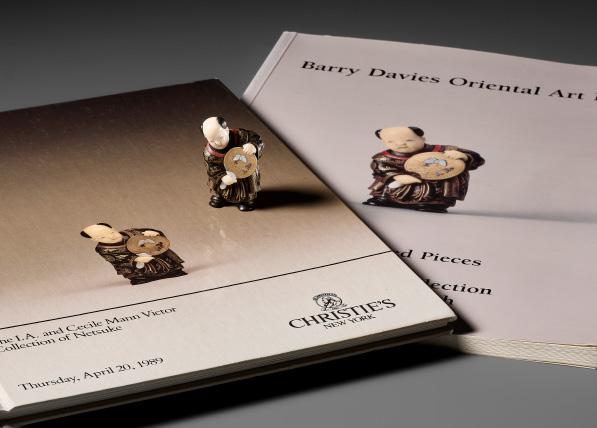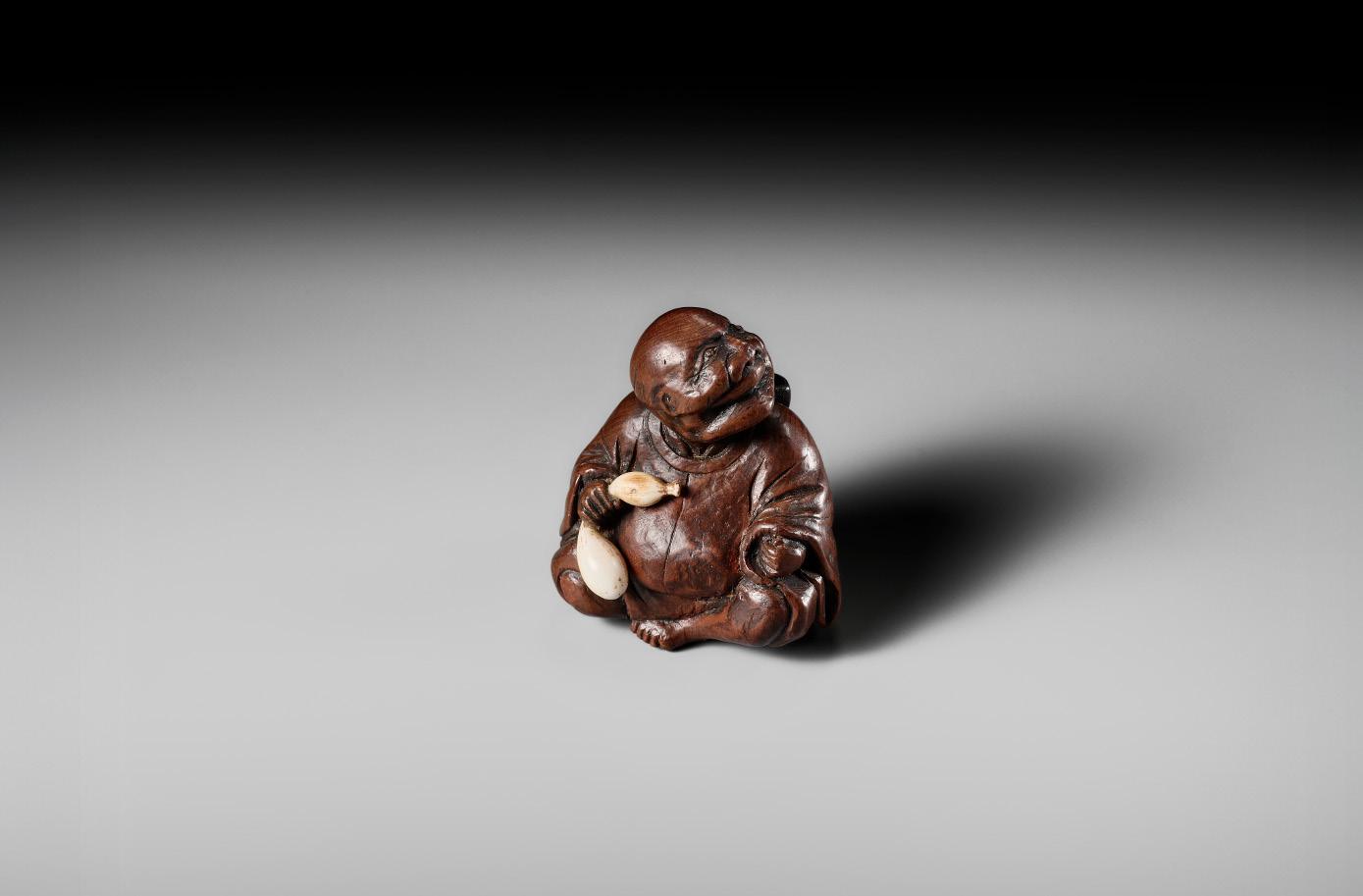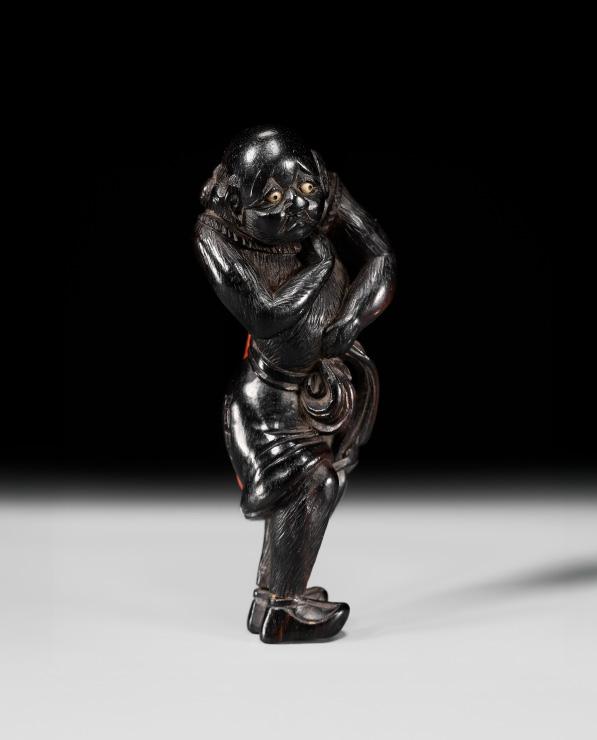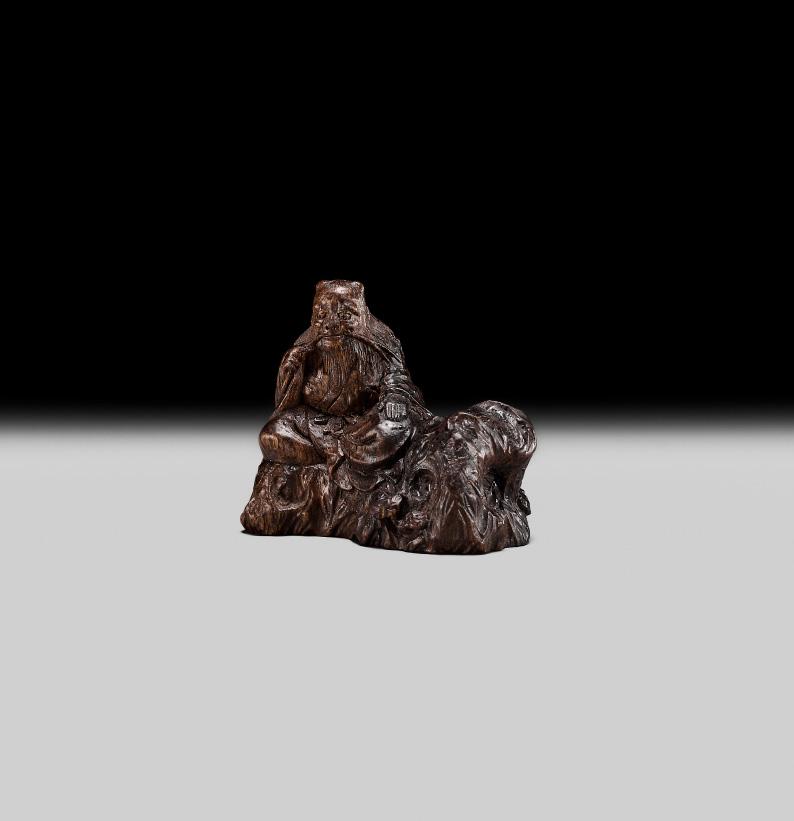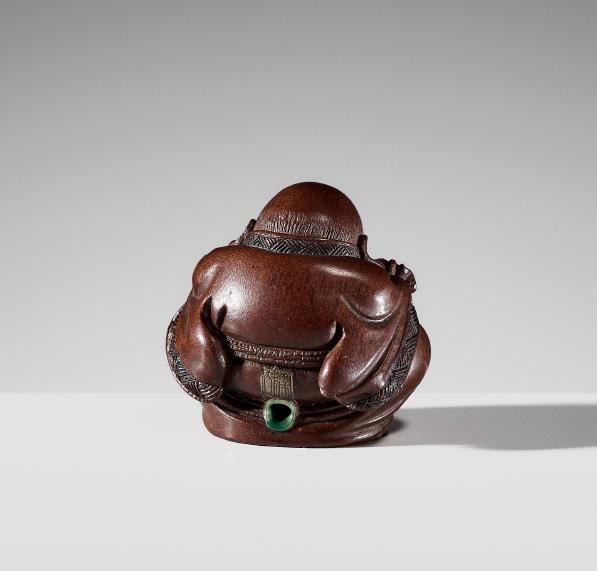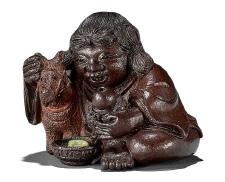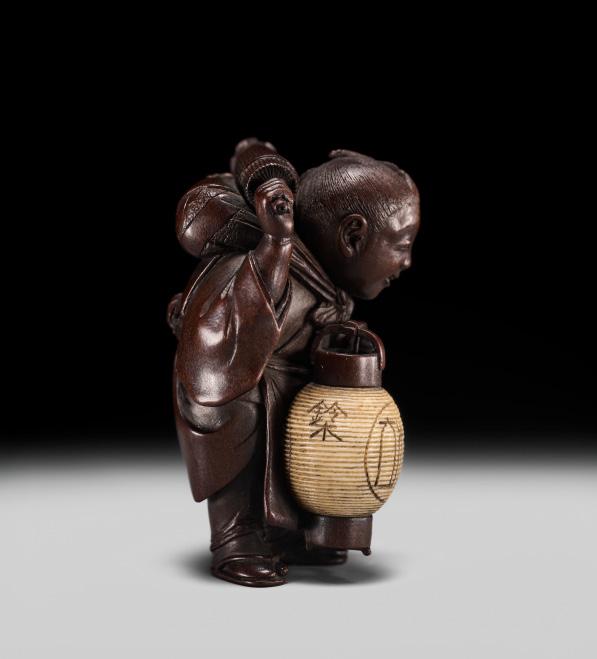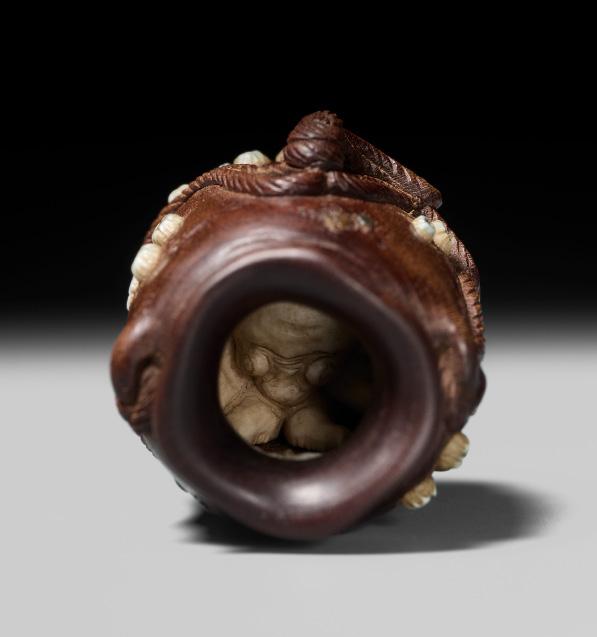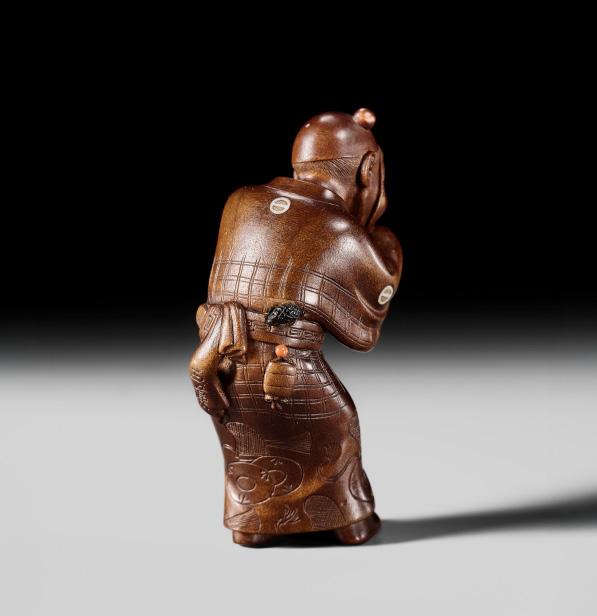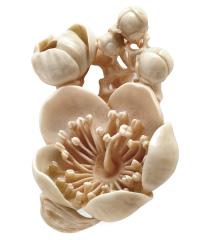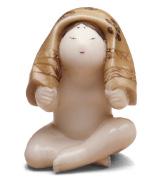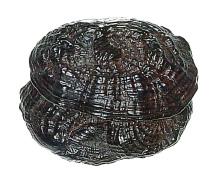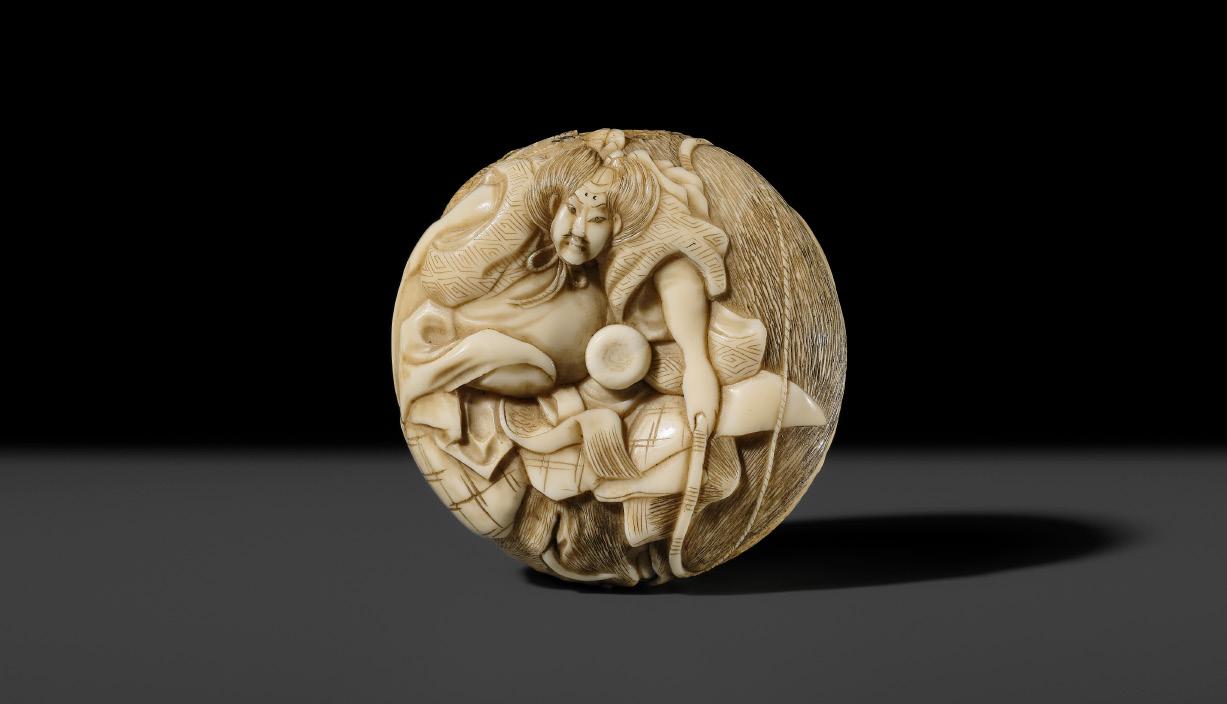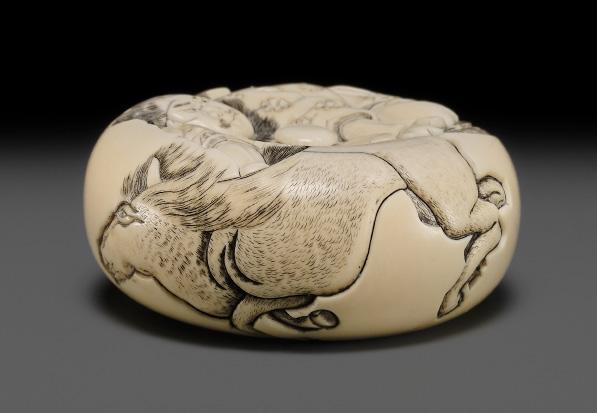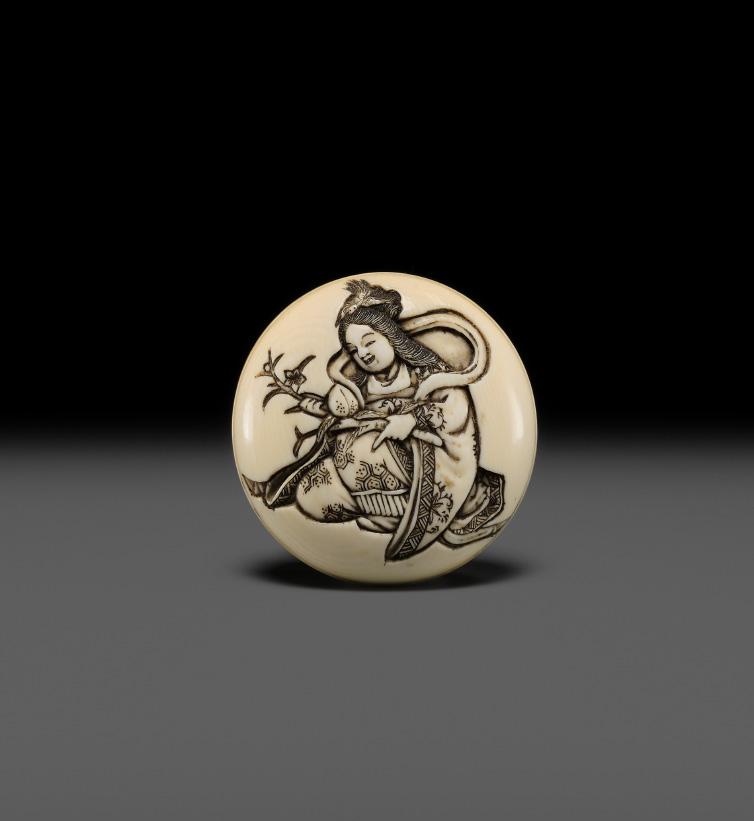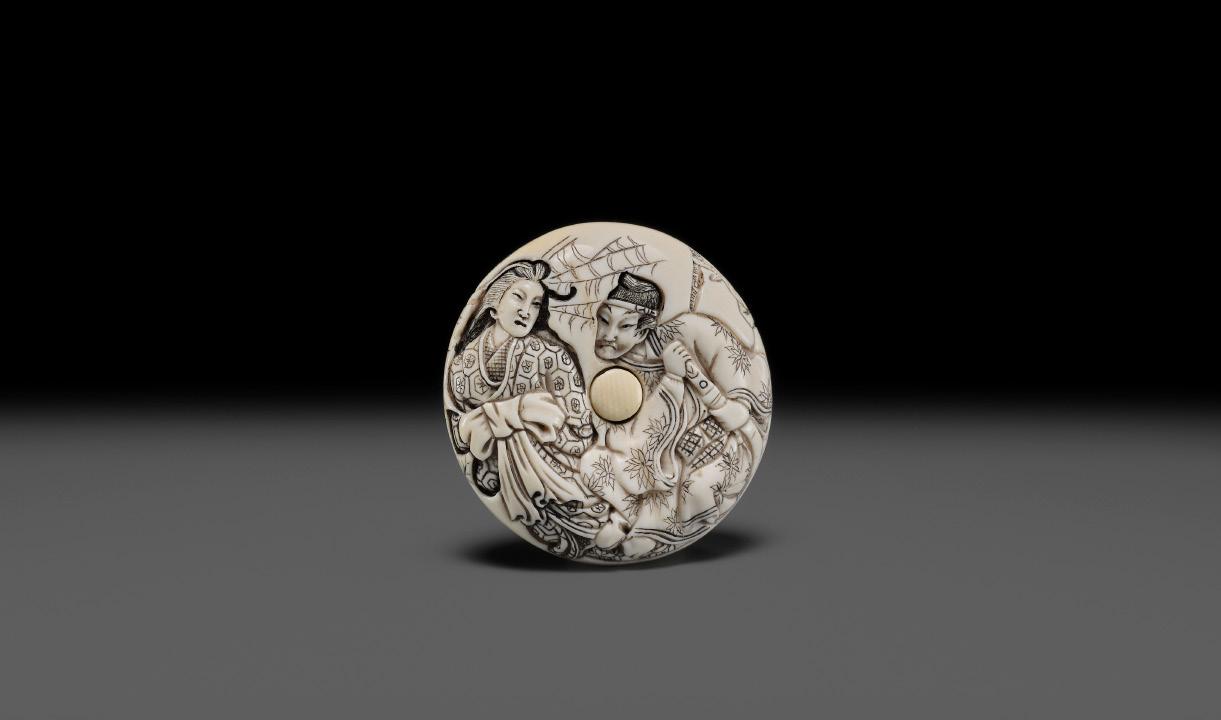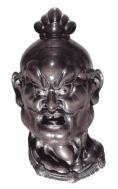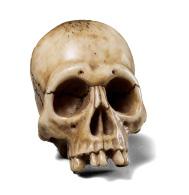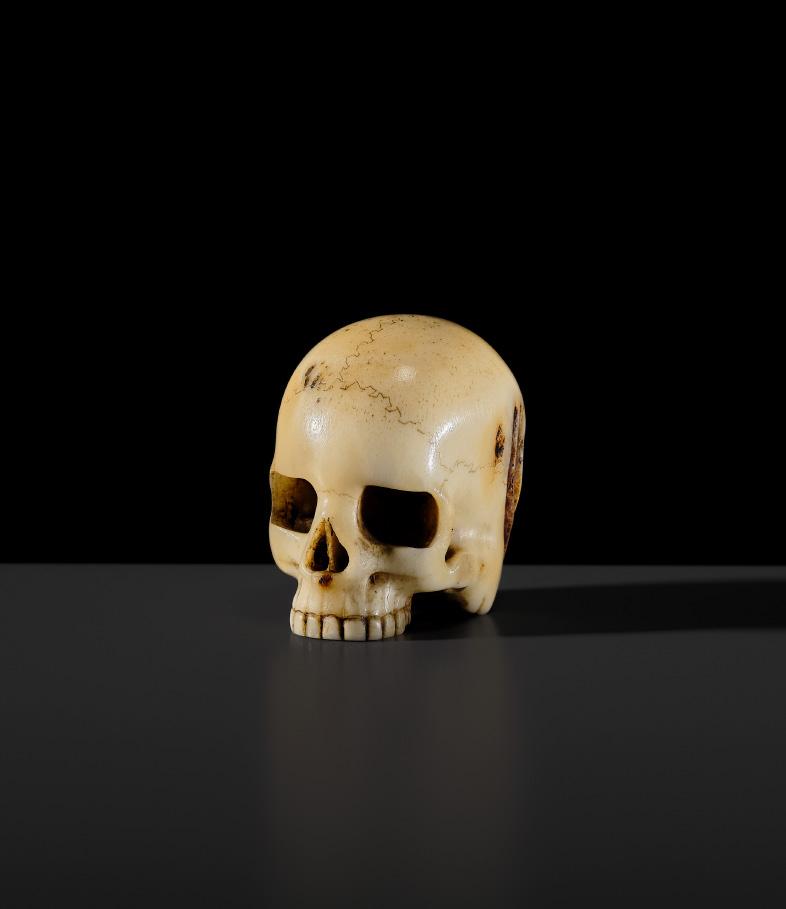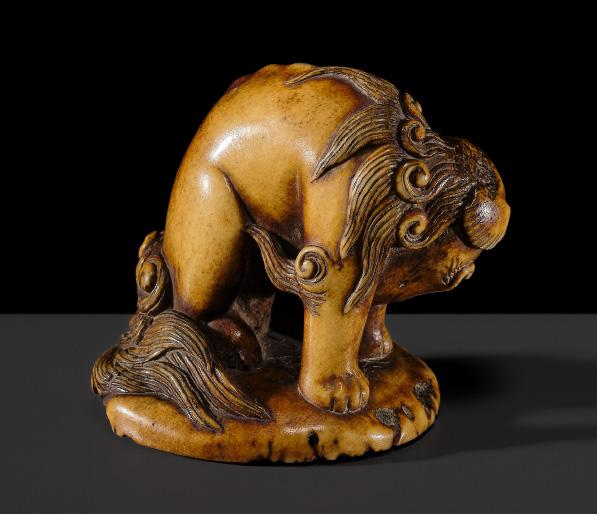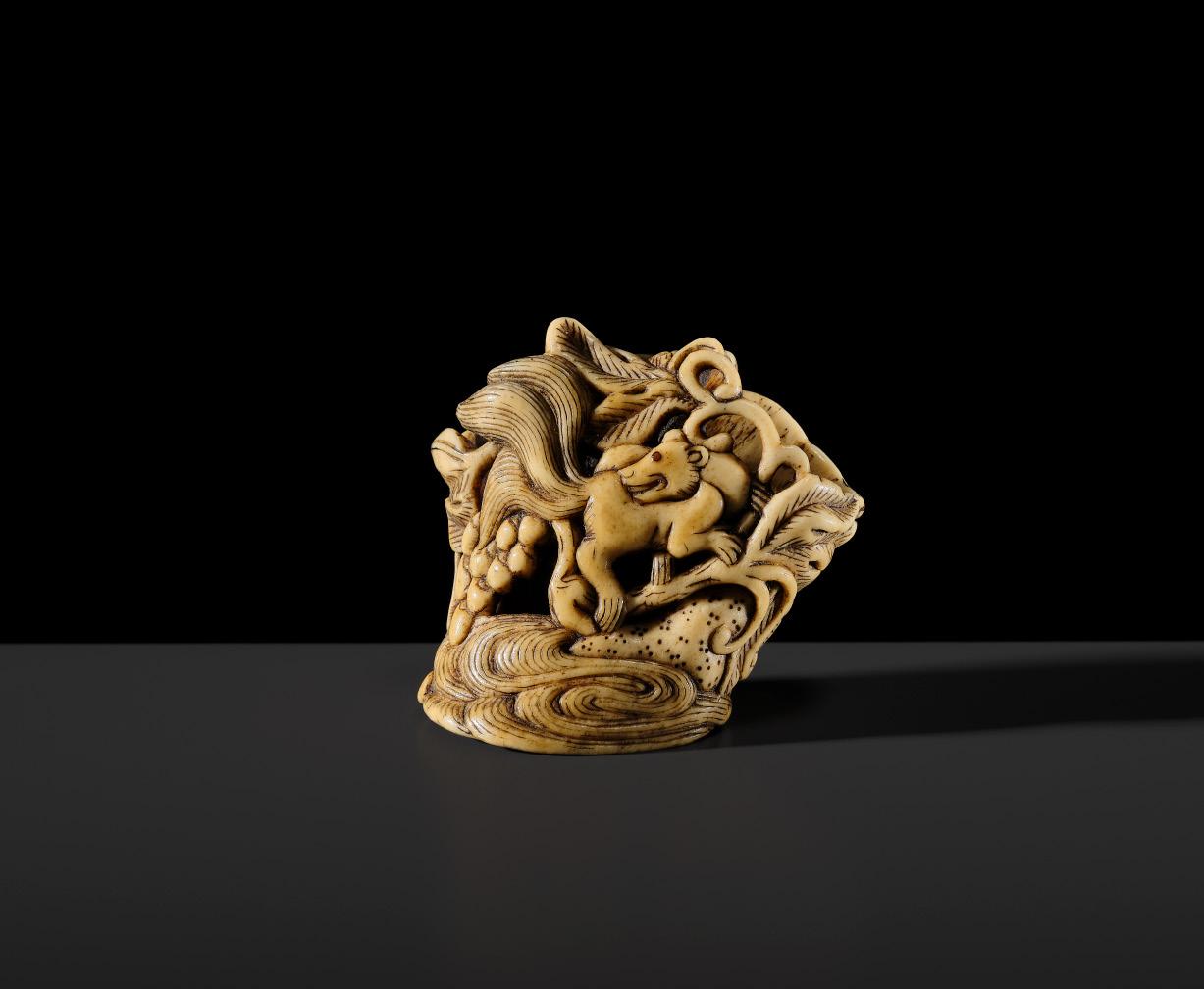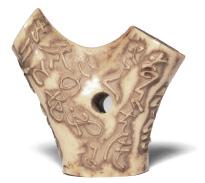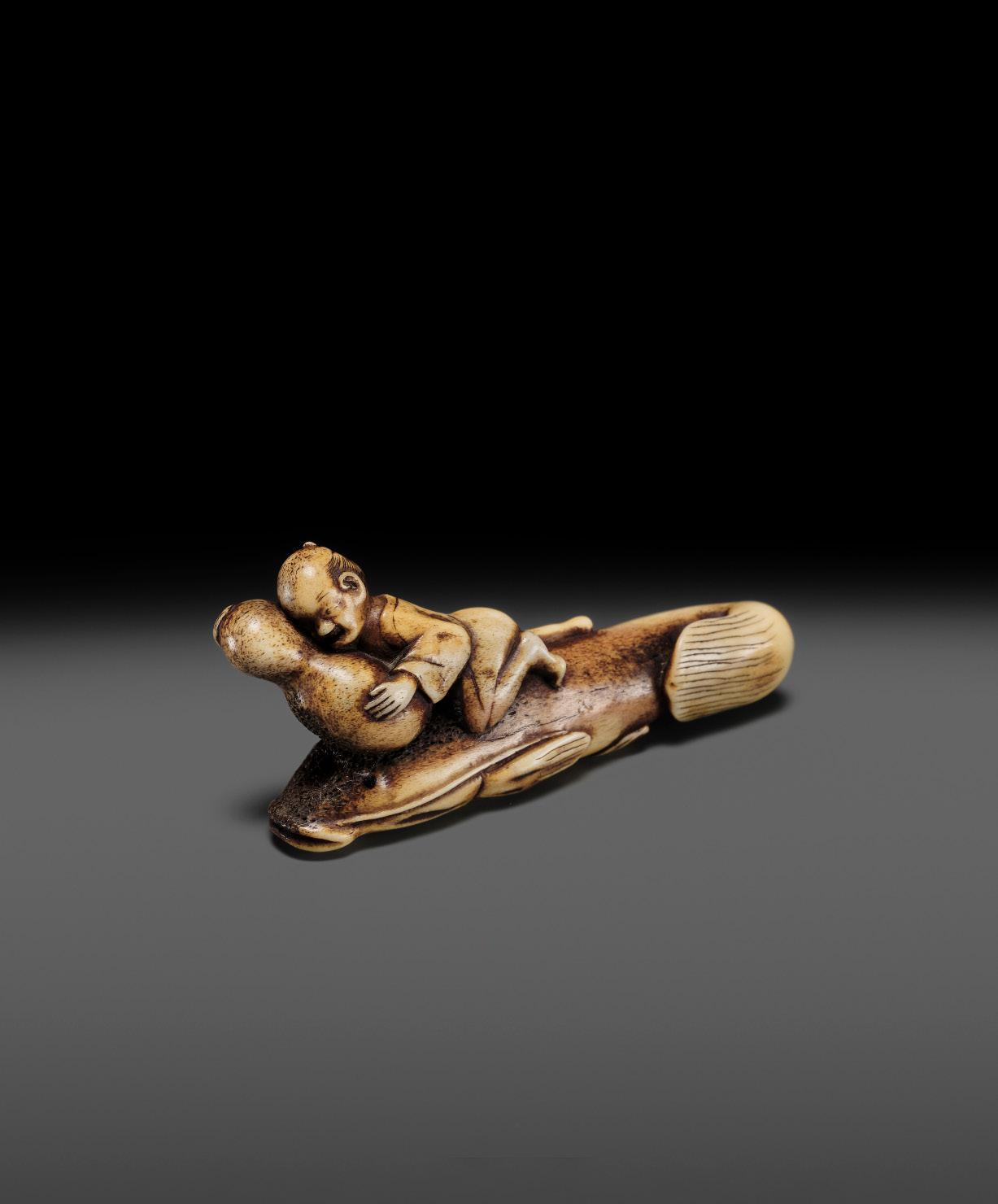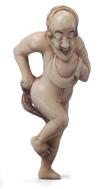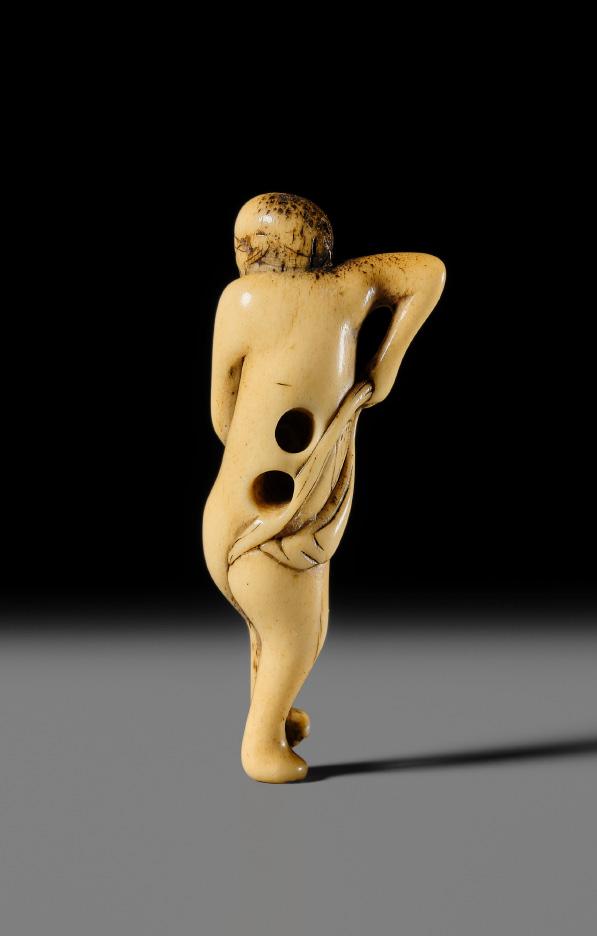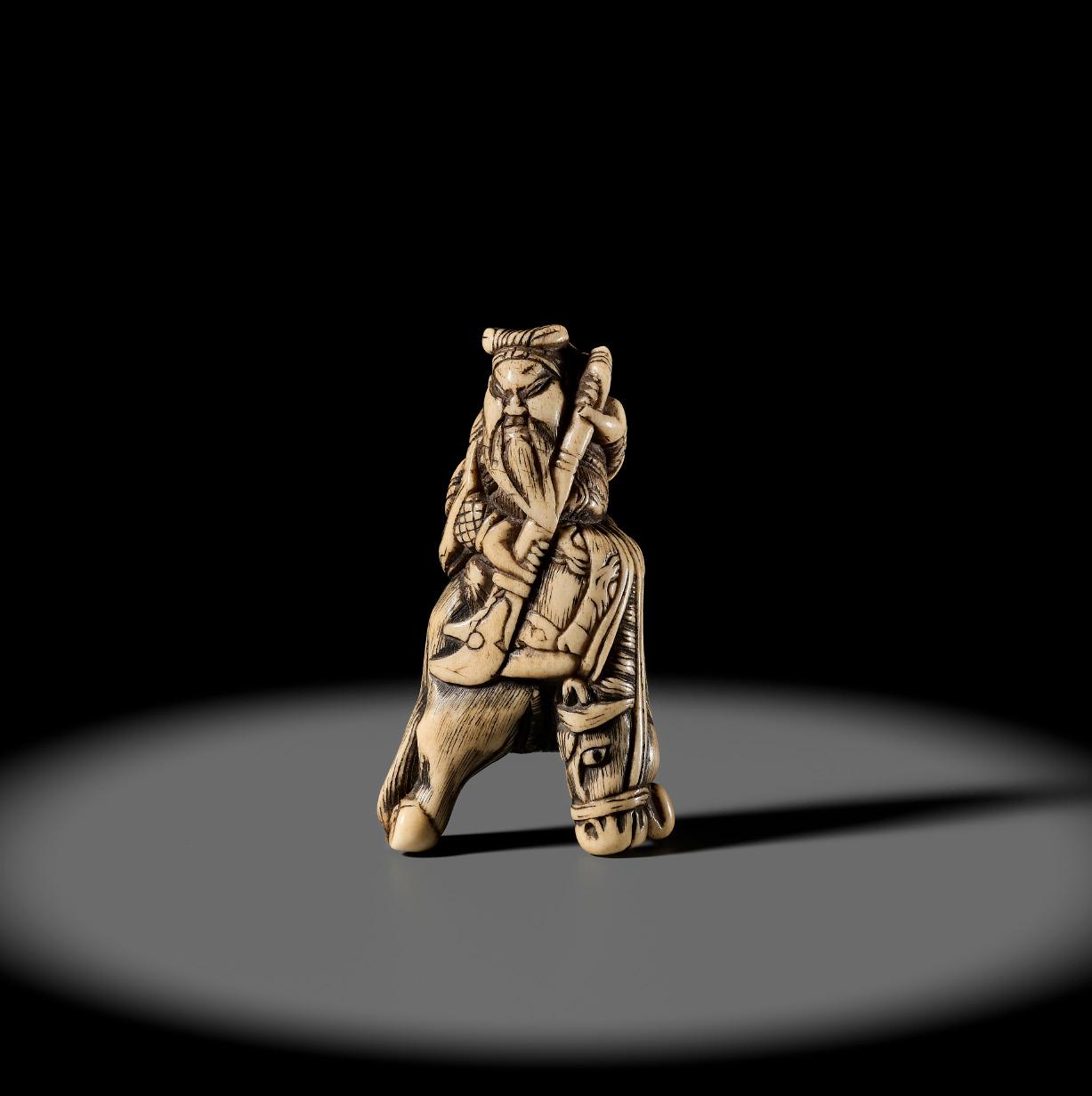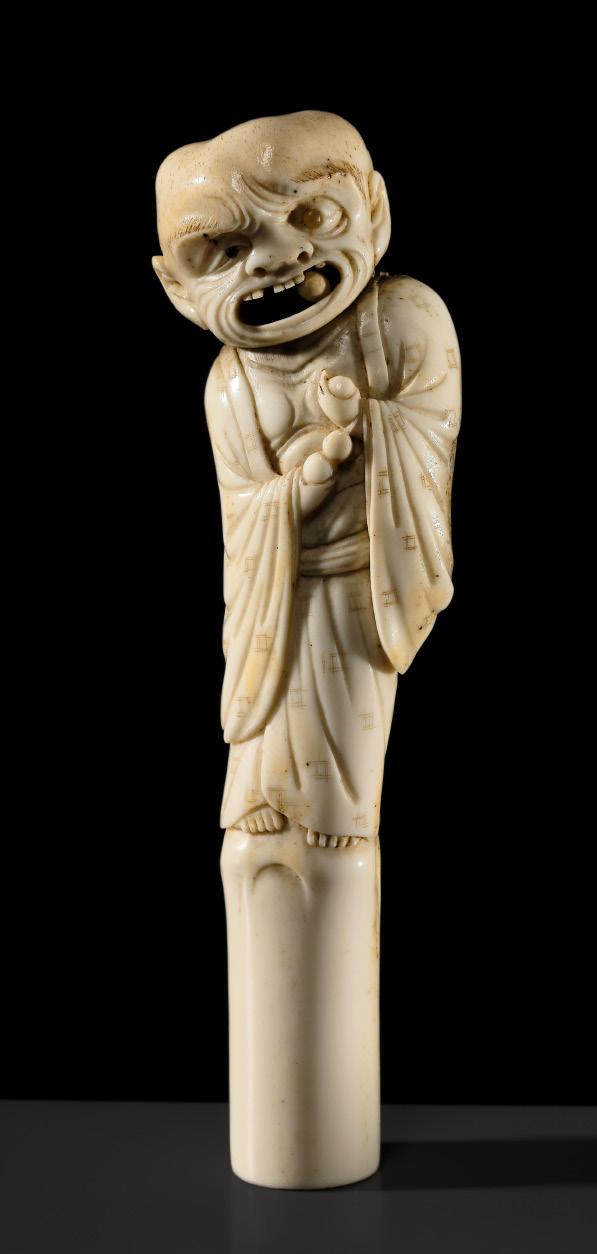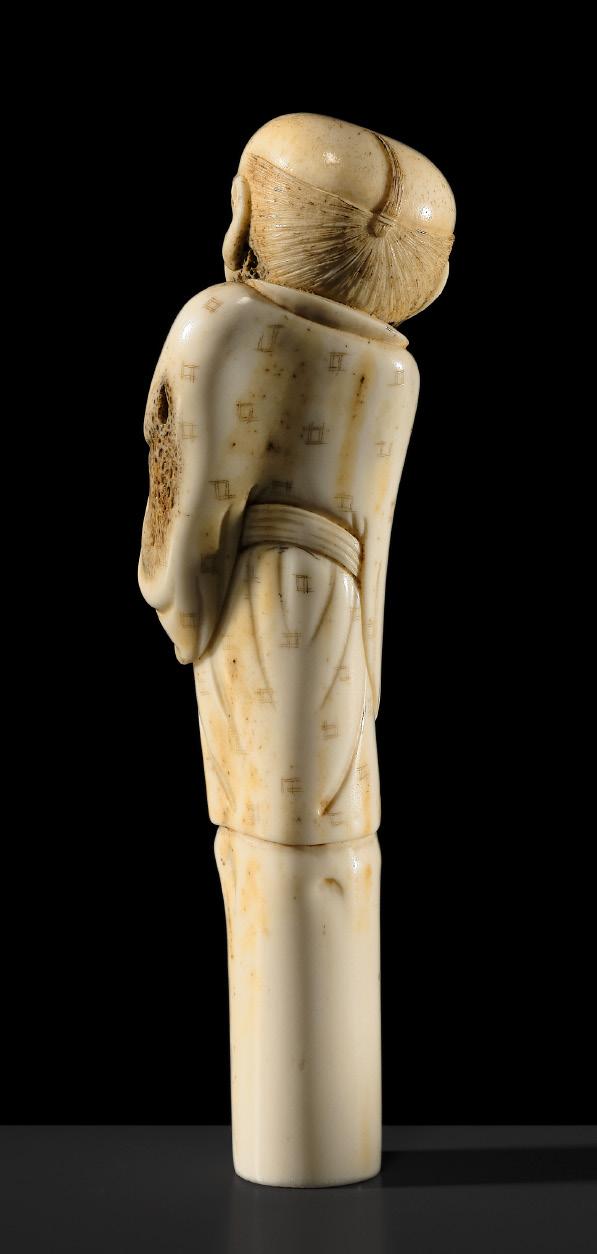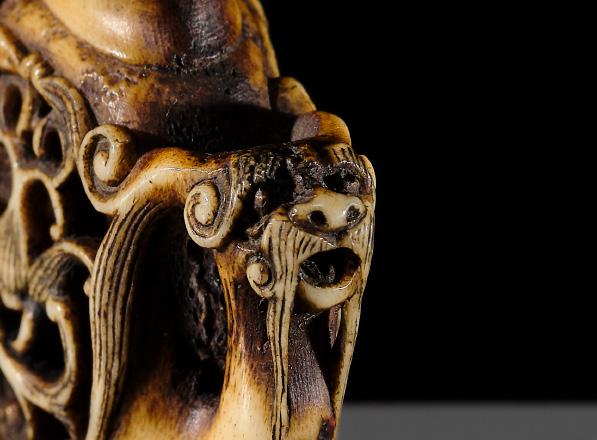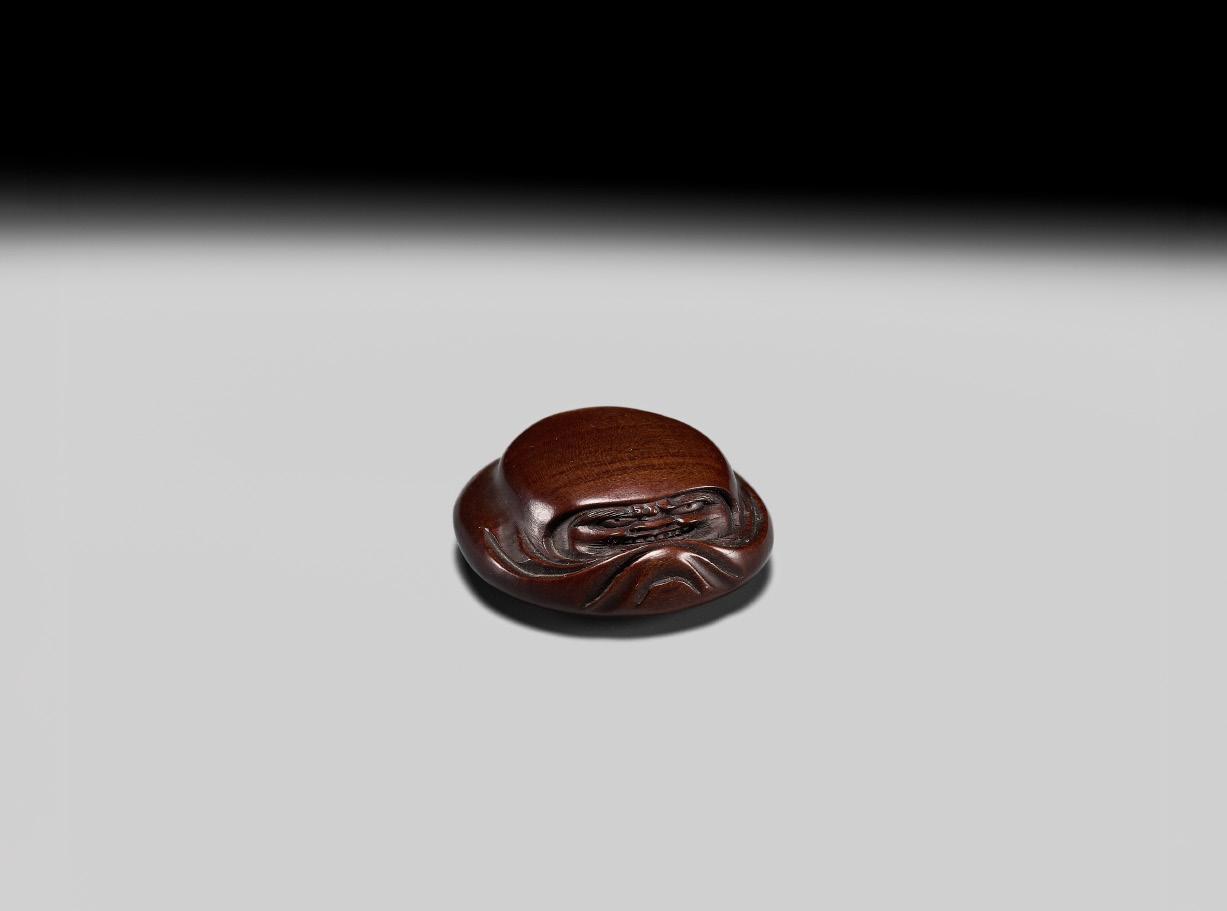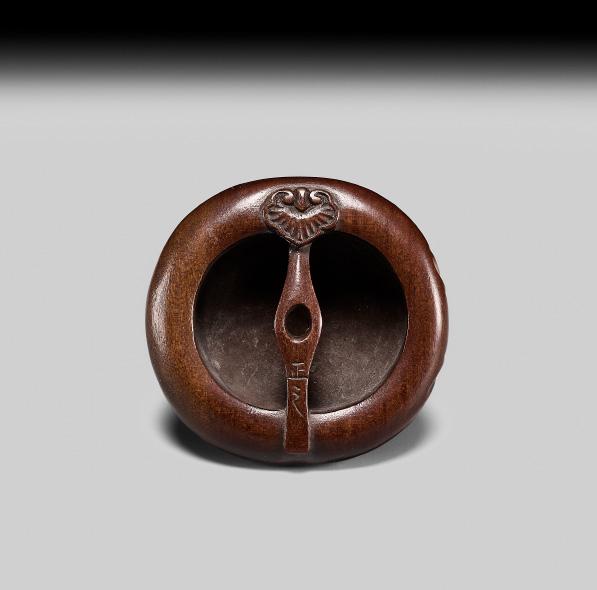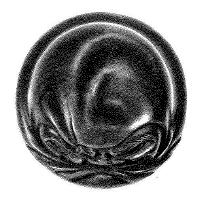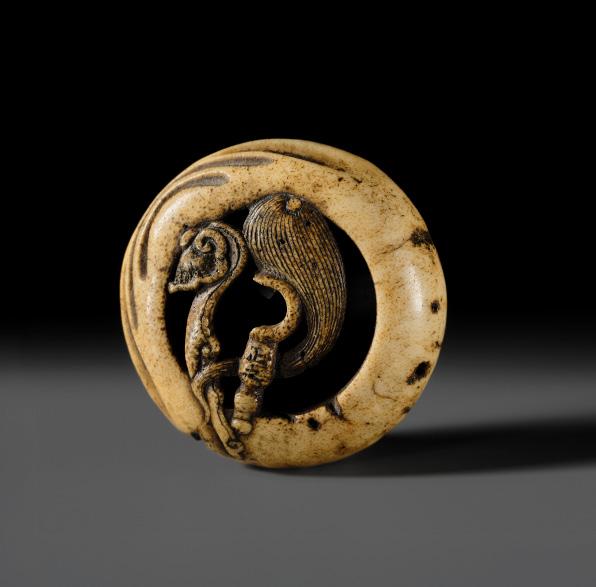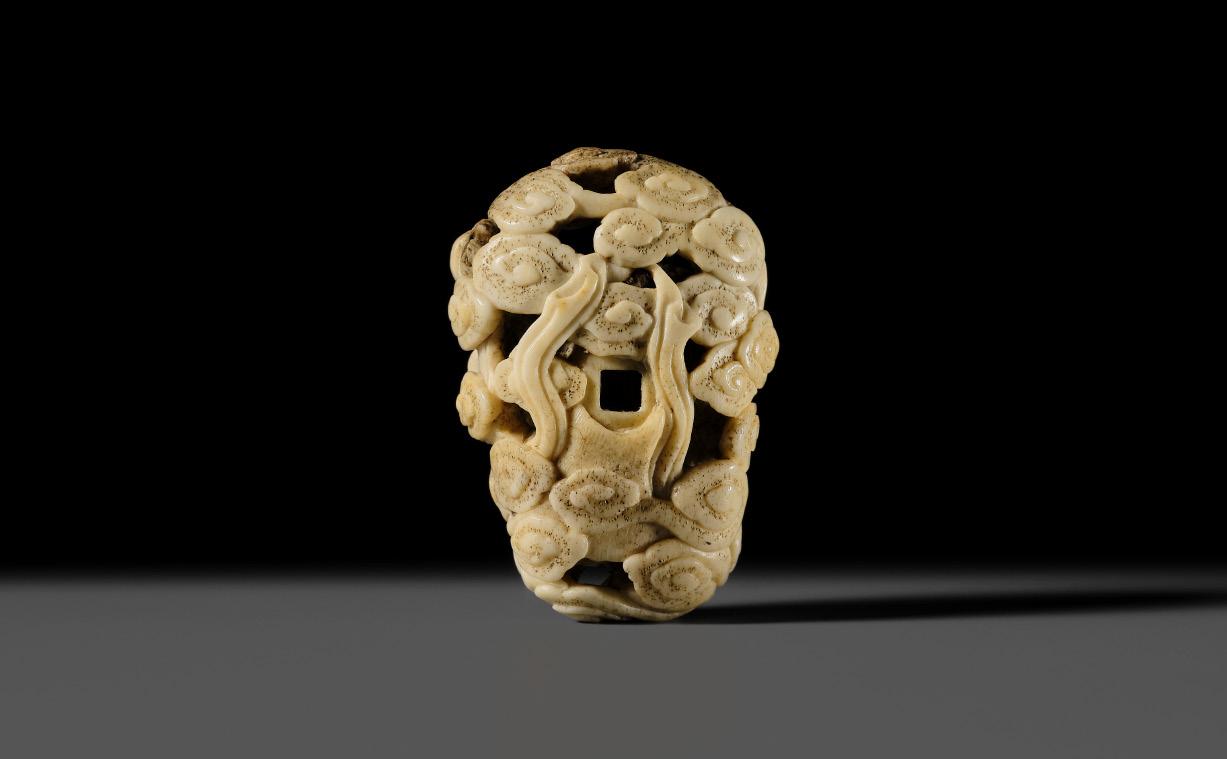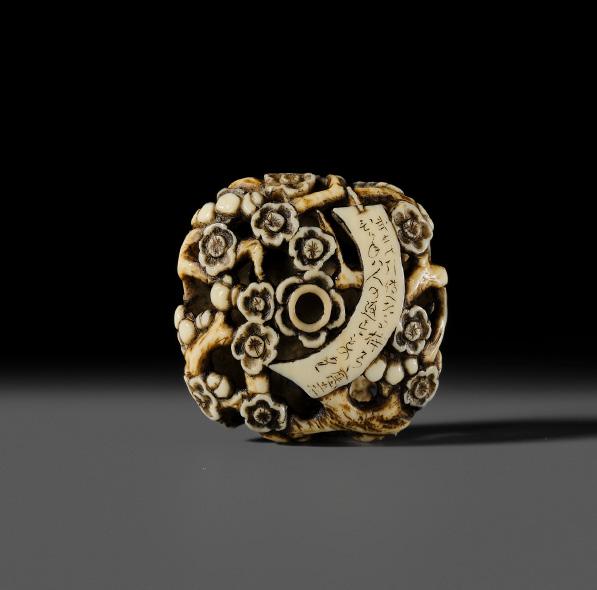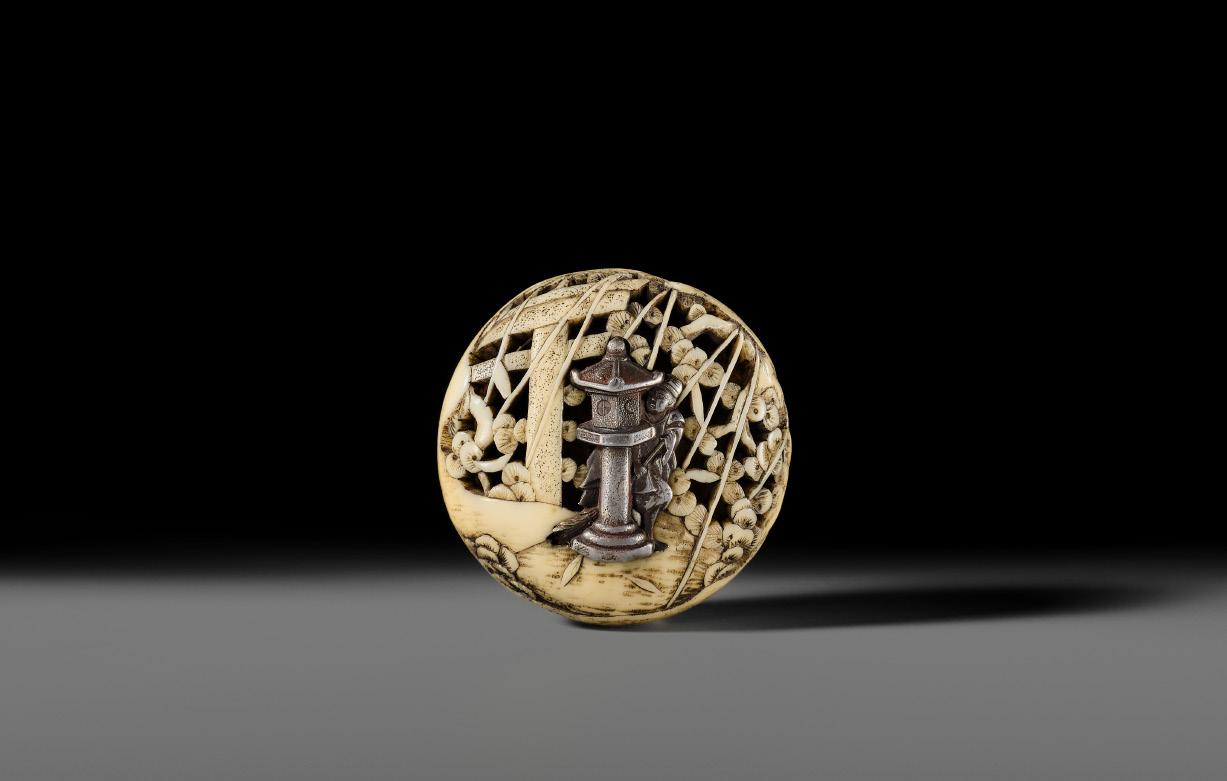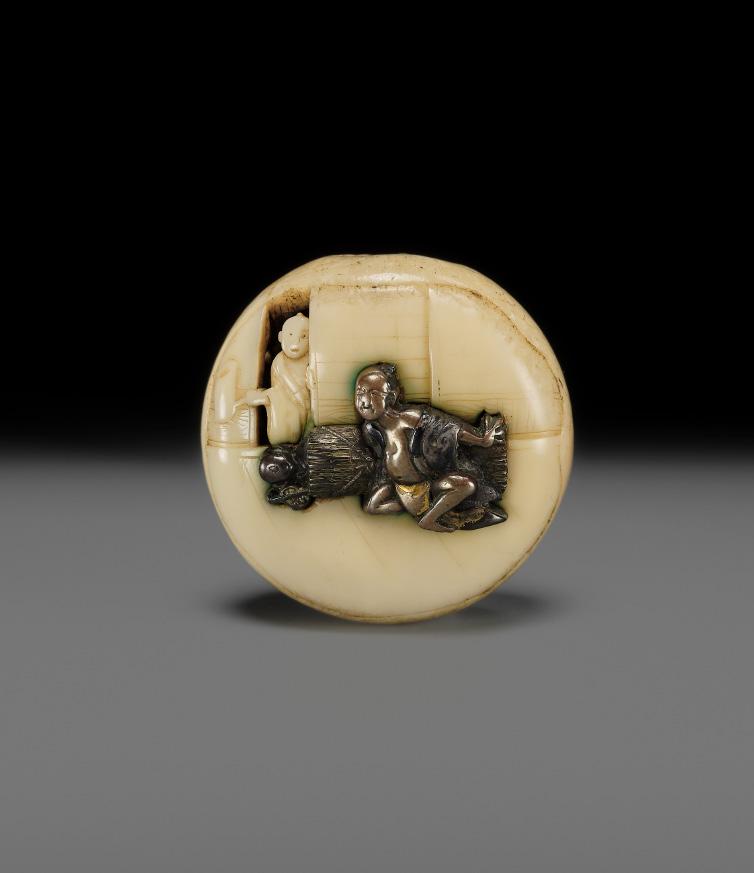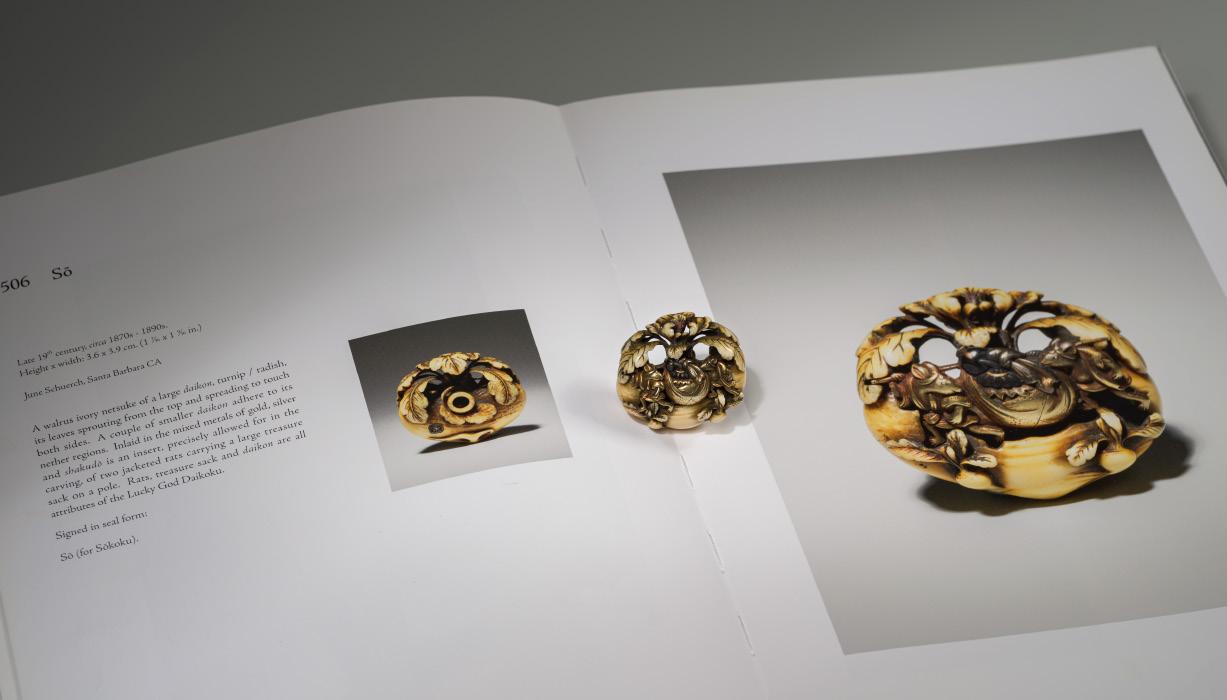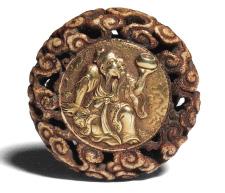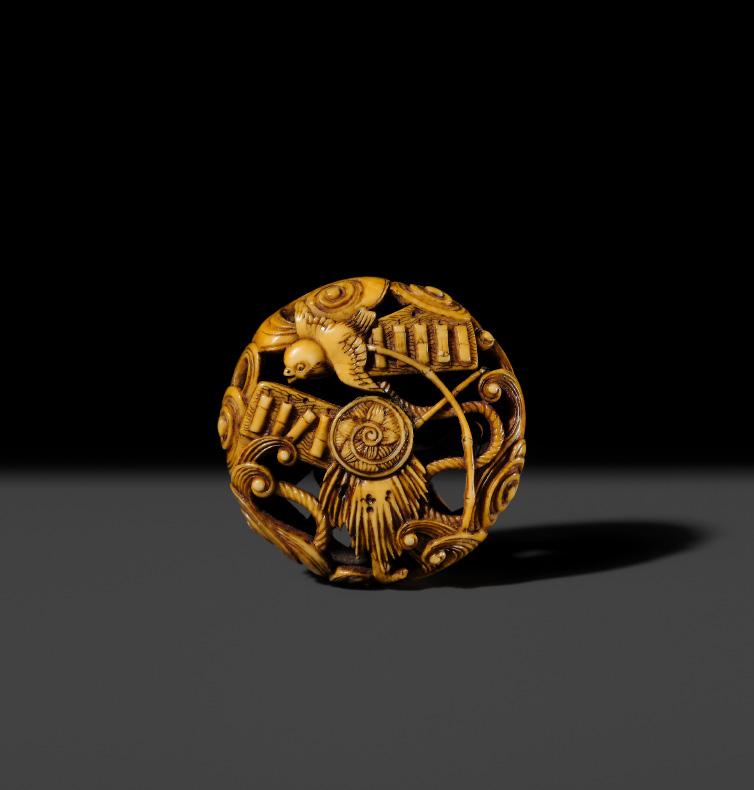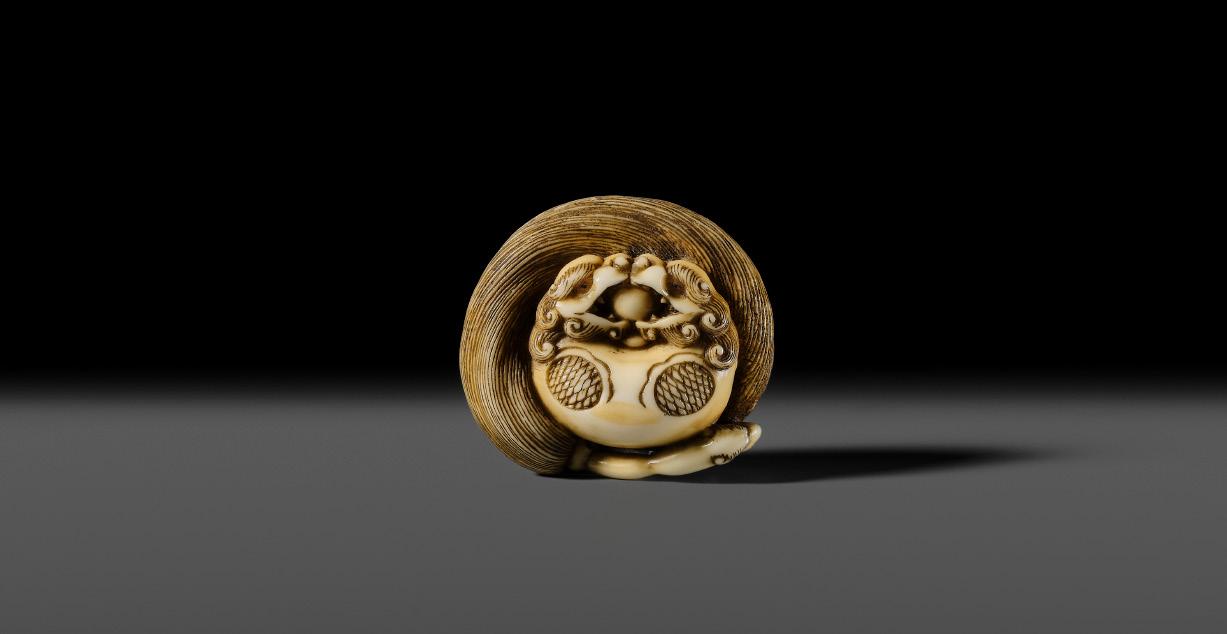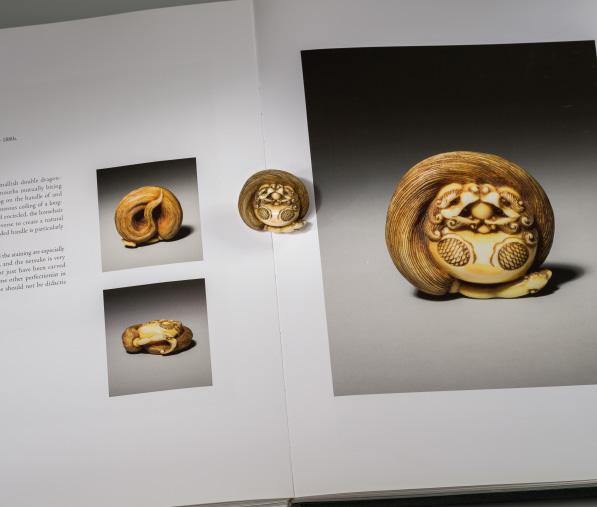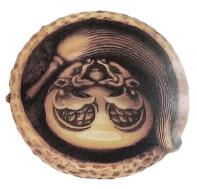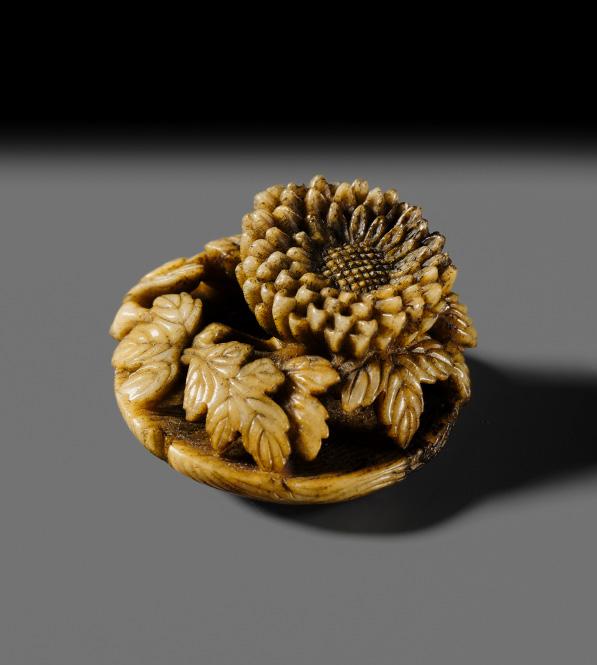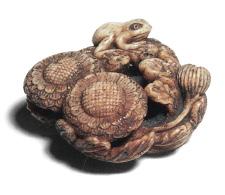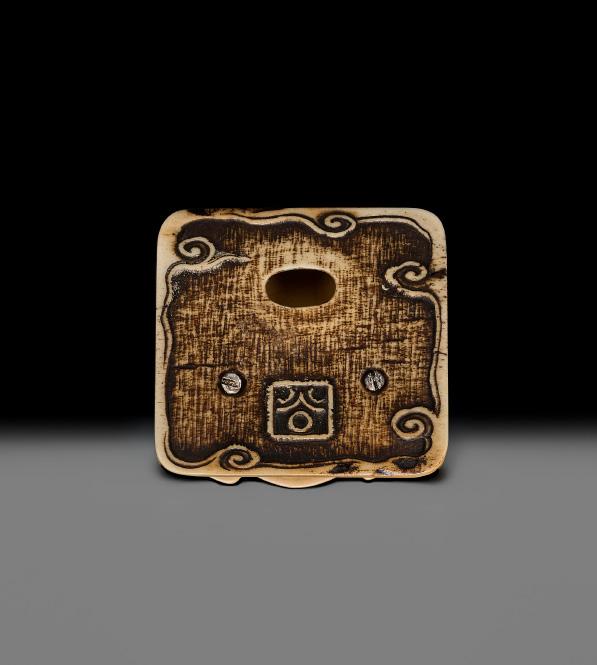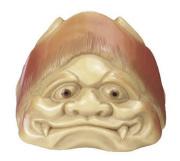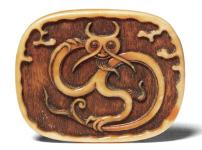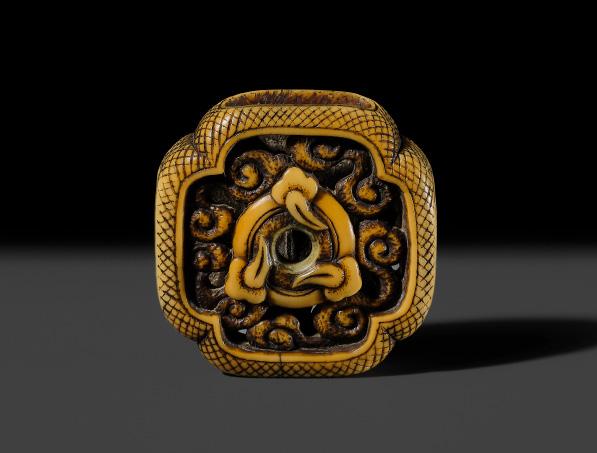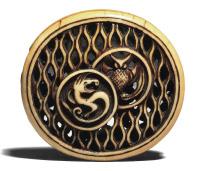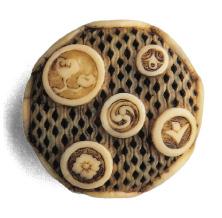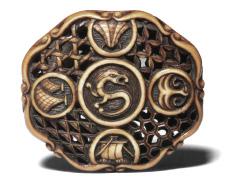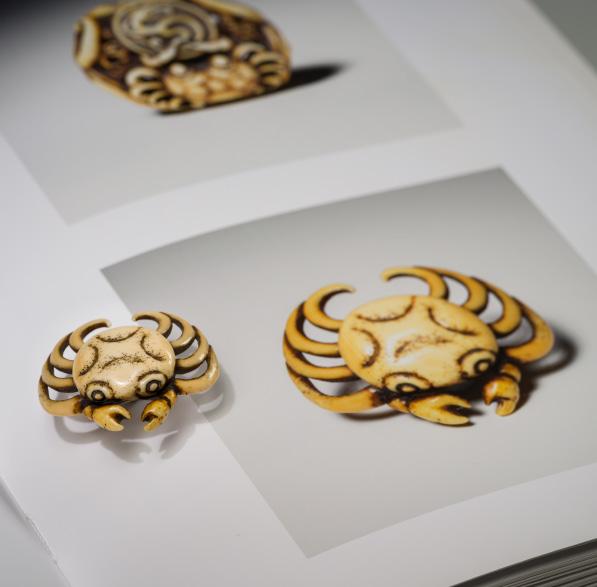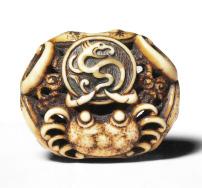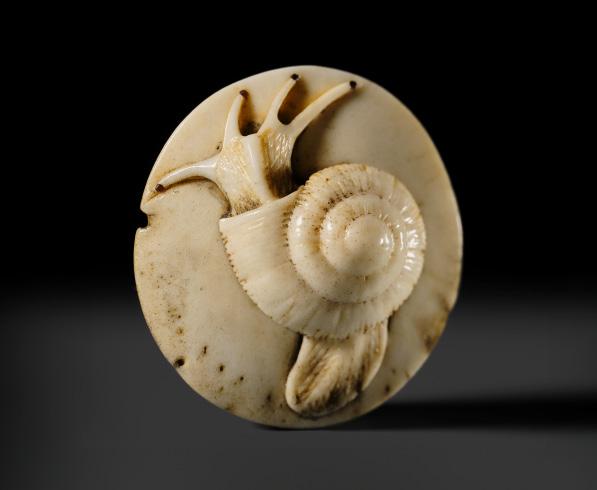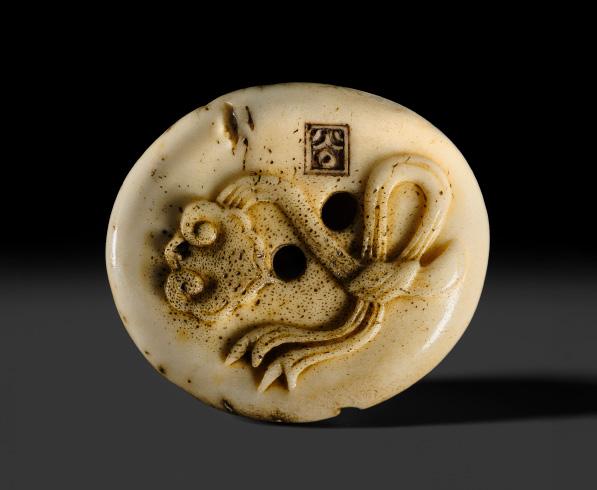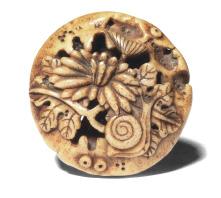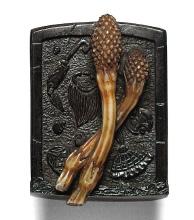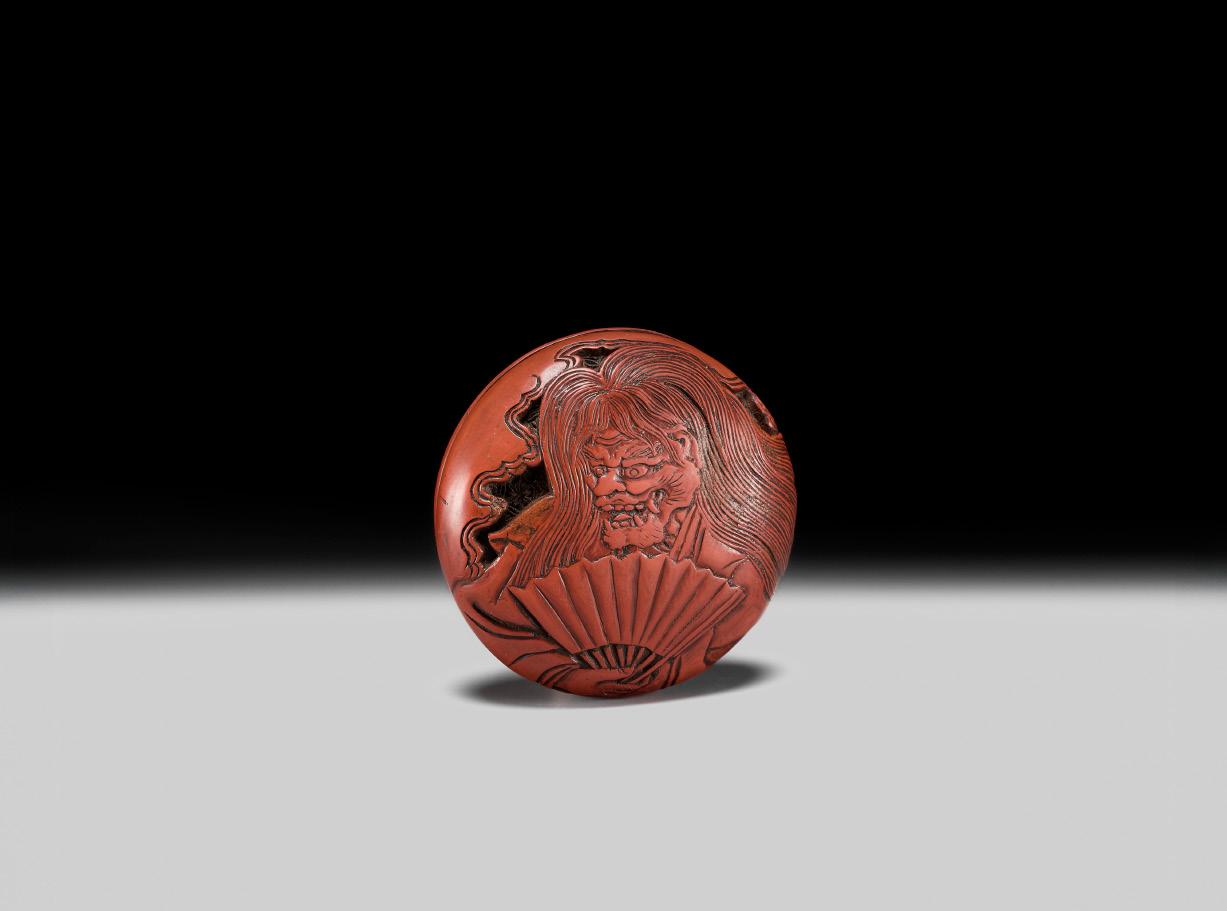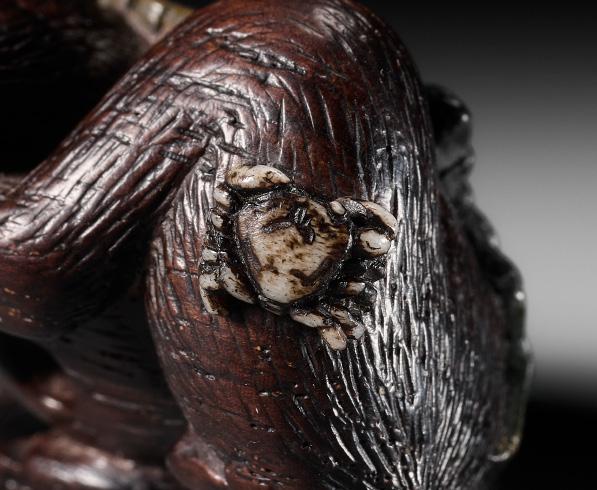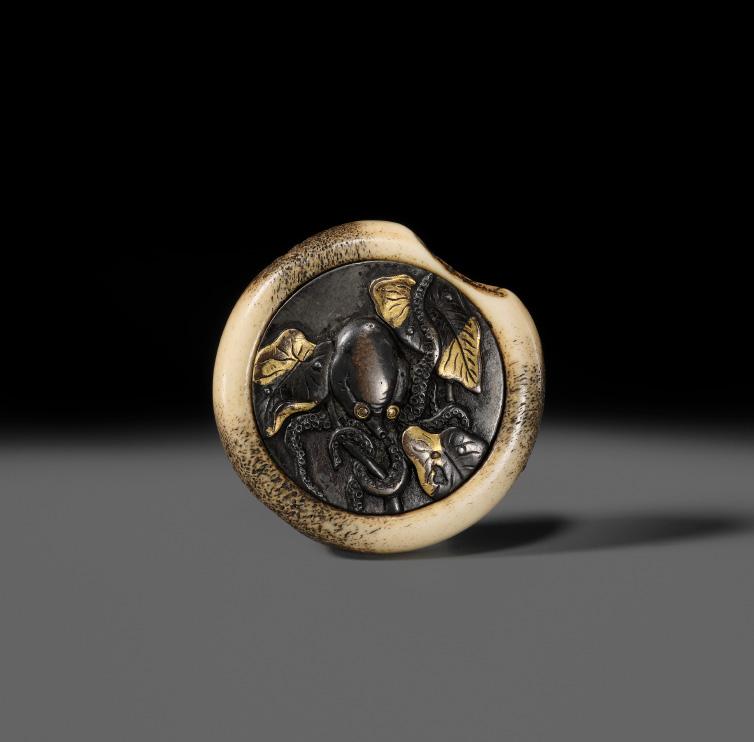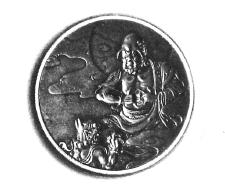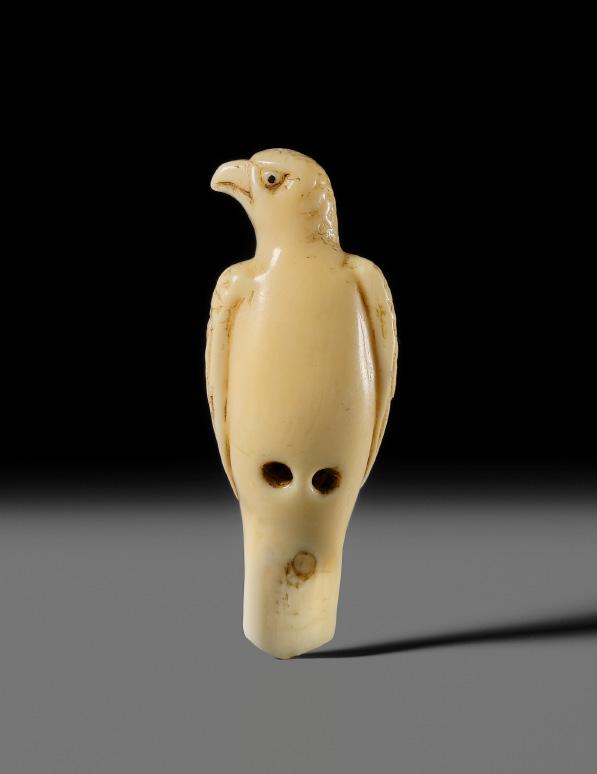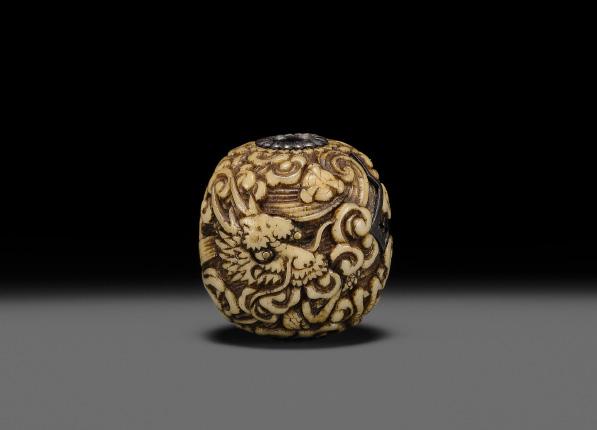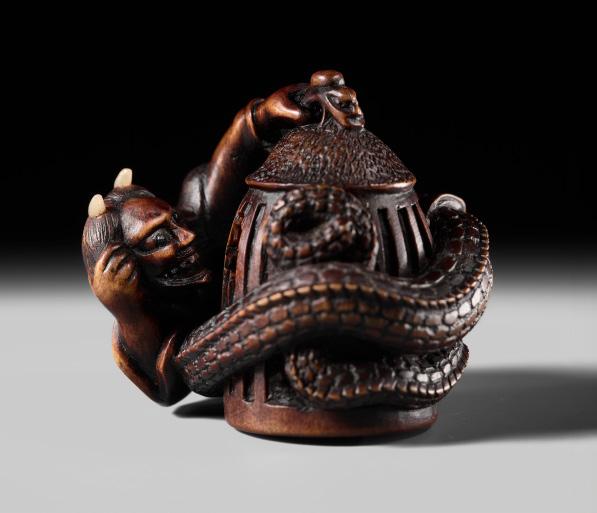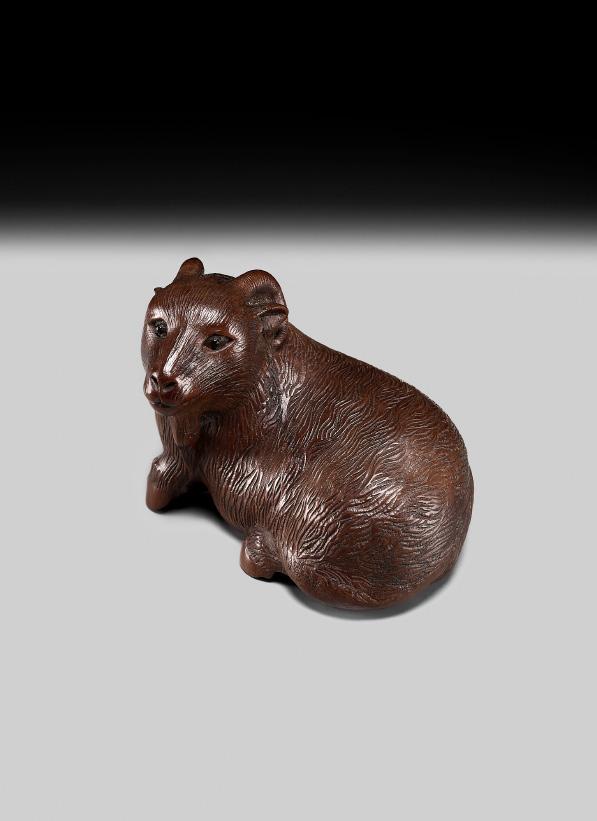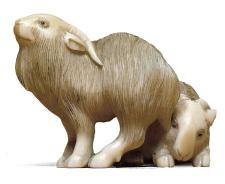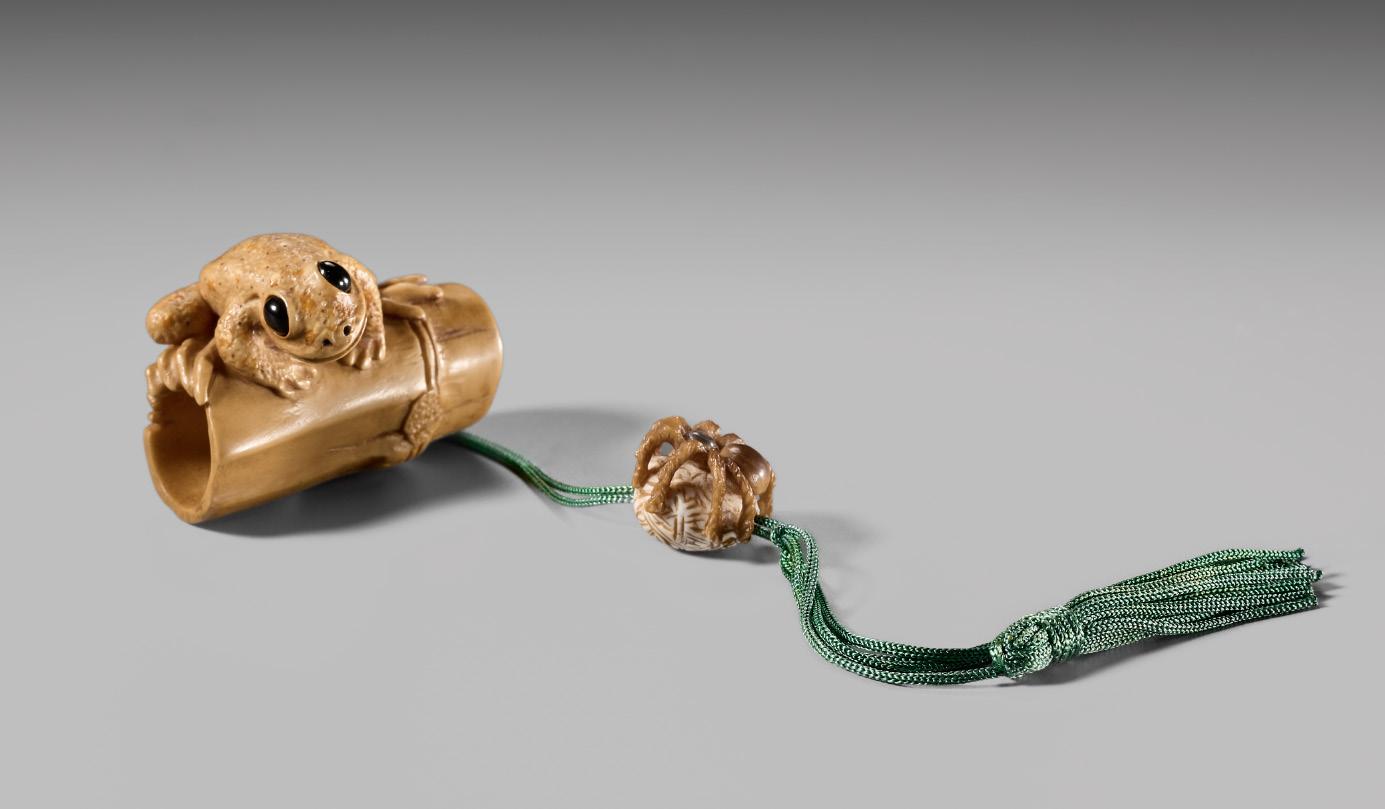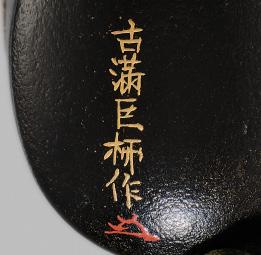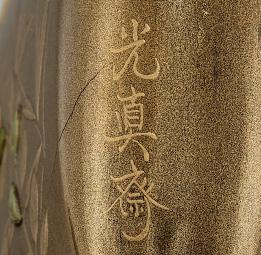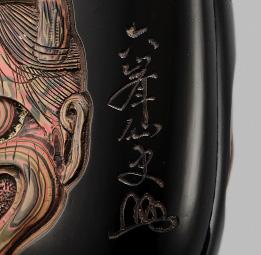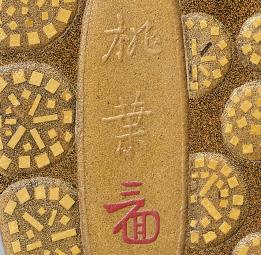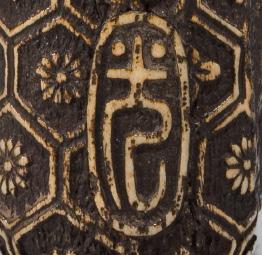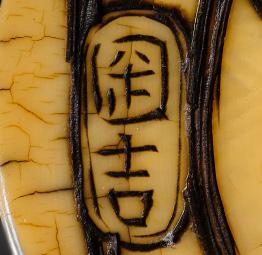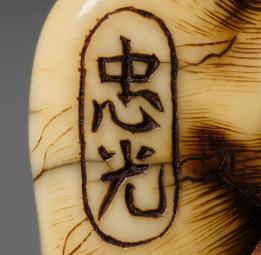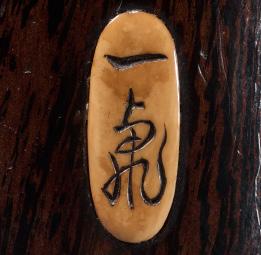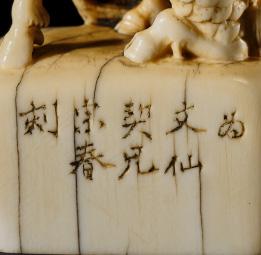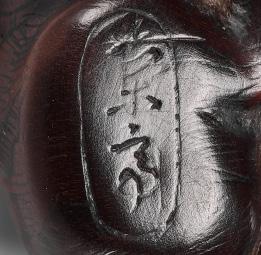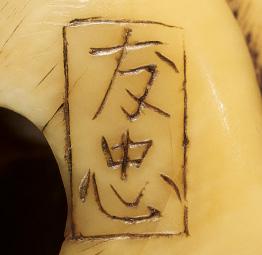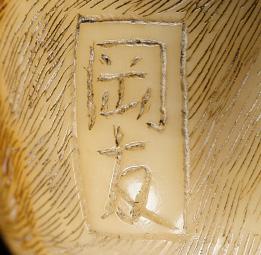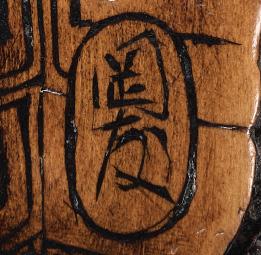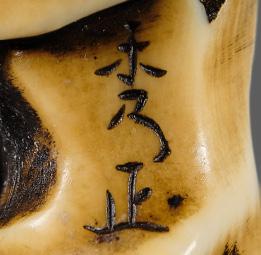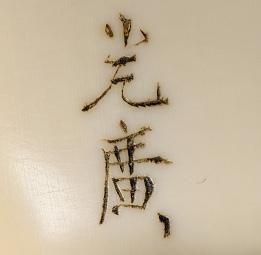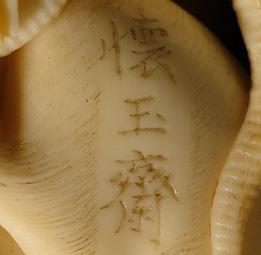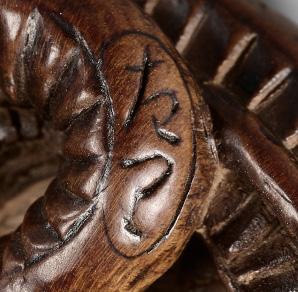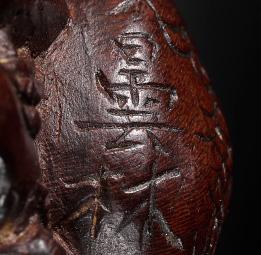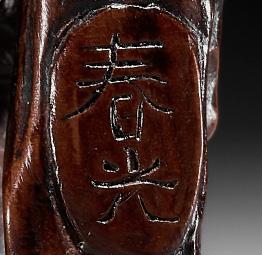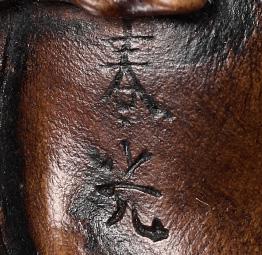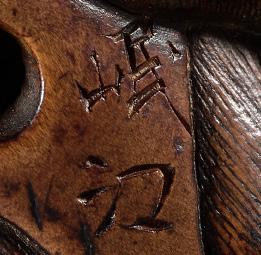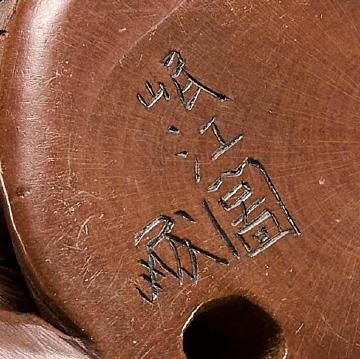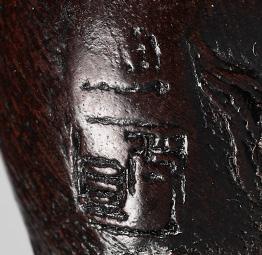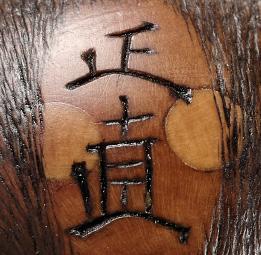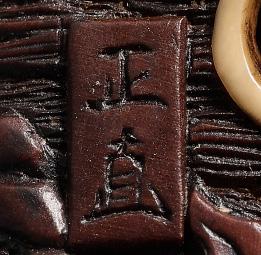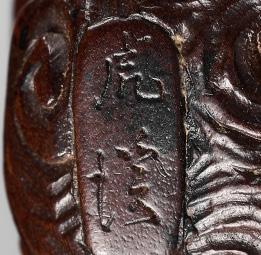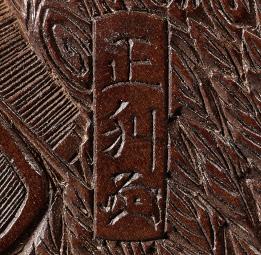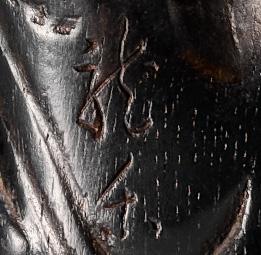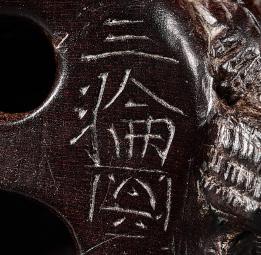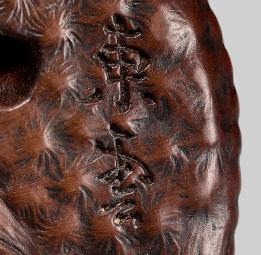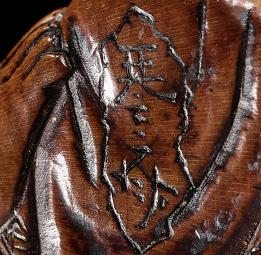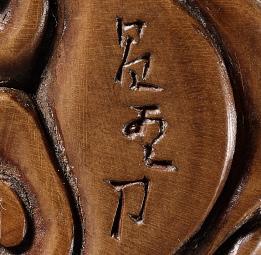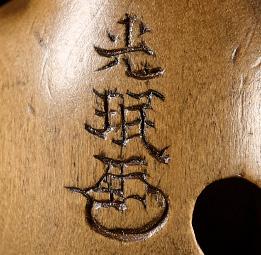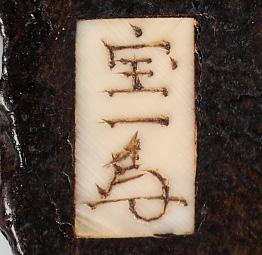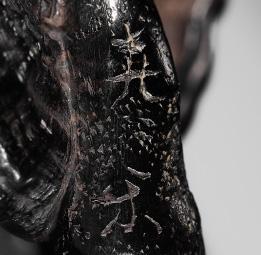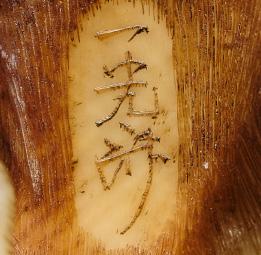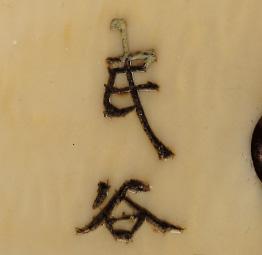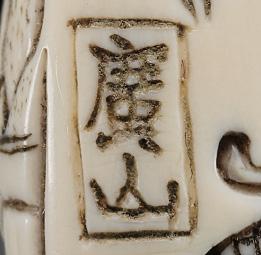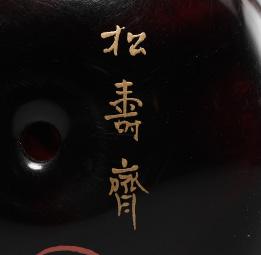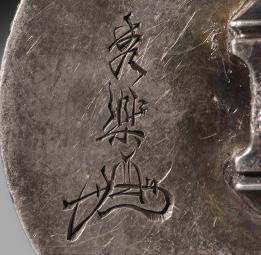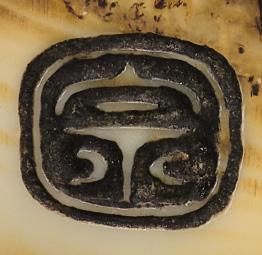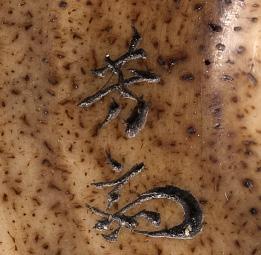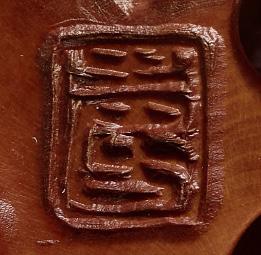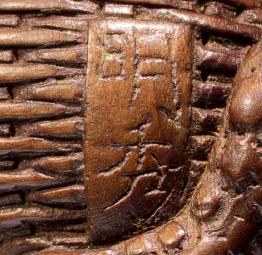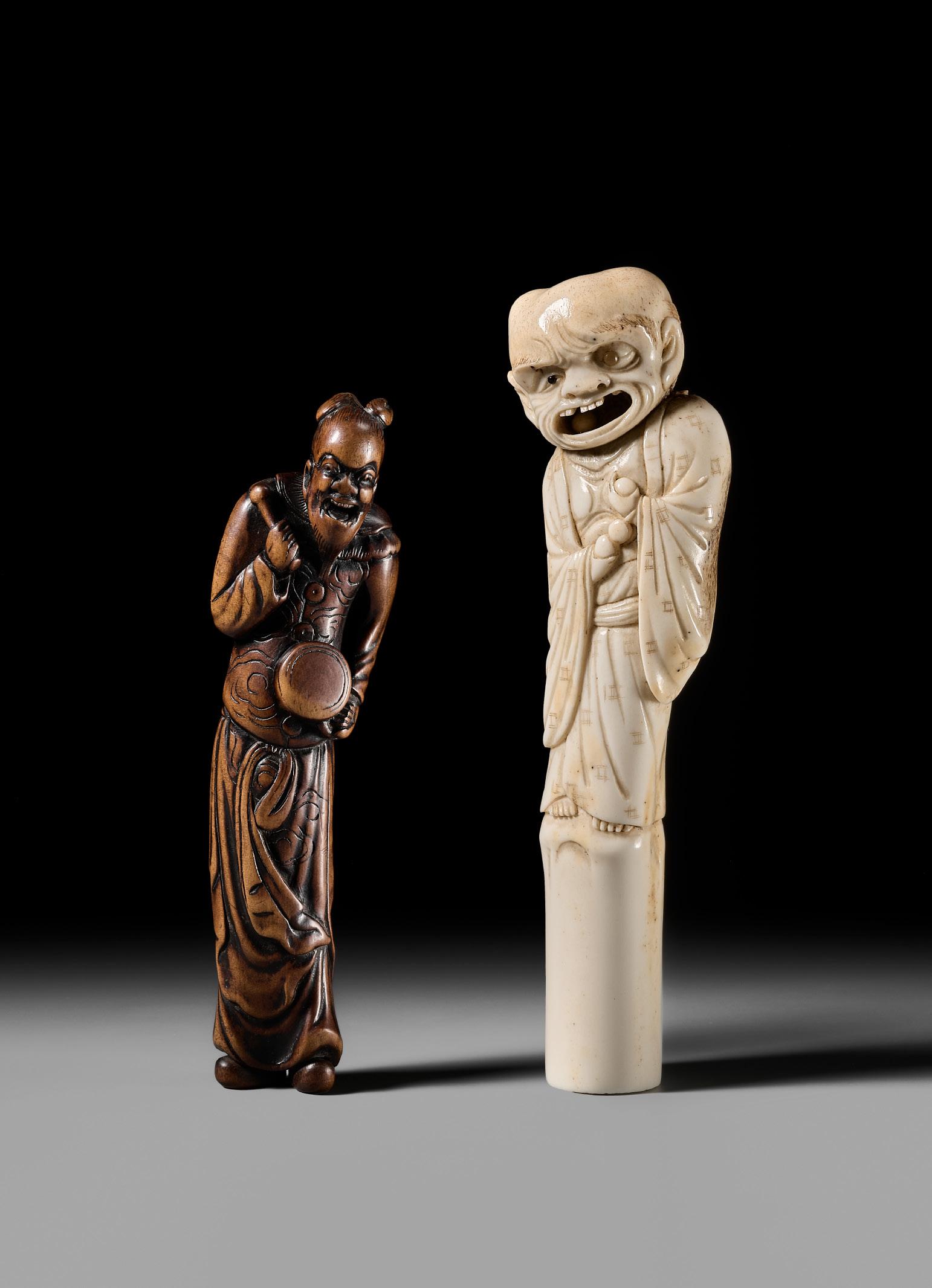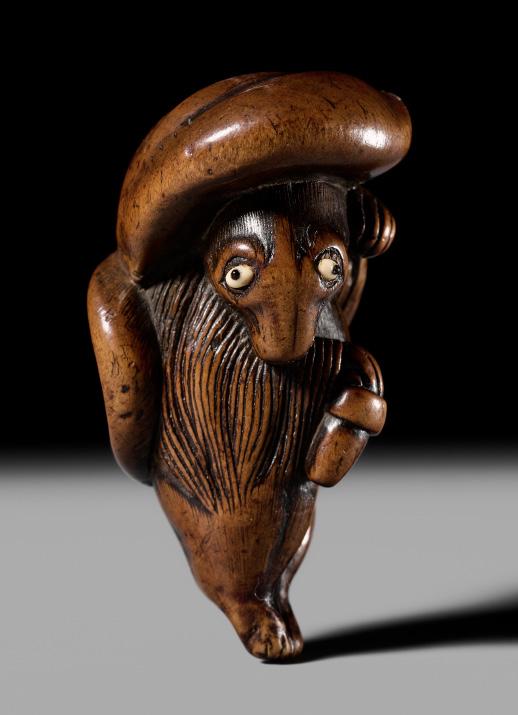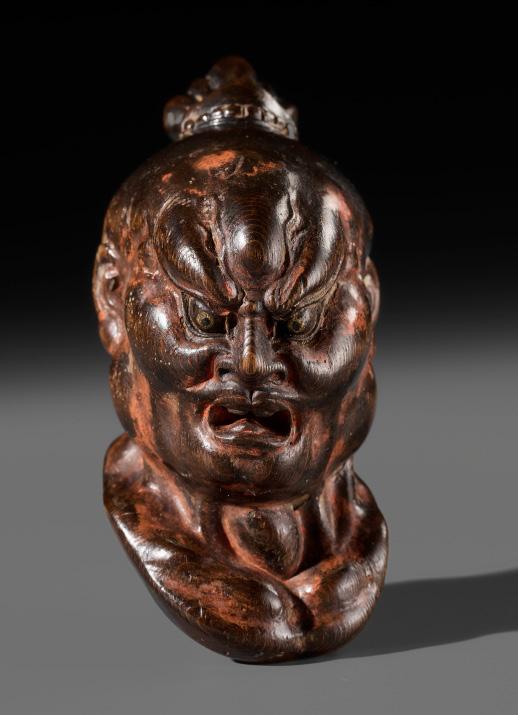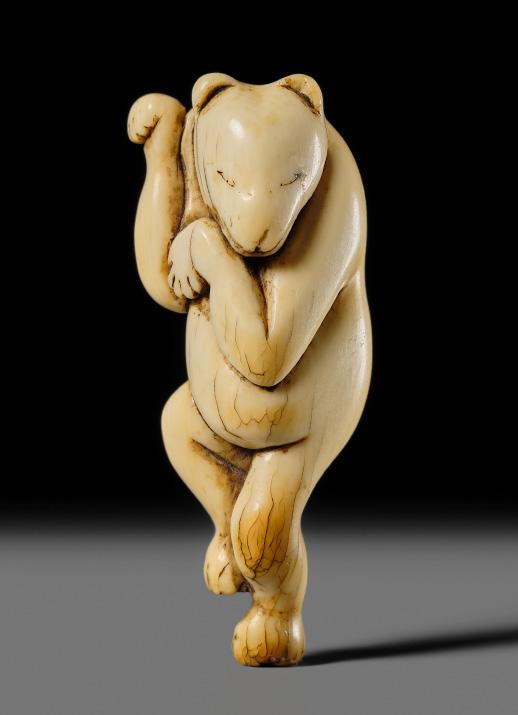TERMS OF AUCTION
§ 1) The auction shall be carried out in accordance with the provisions of the rules of procedure of GALERIE ZACKE©, SZA VERSTEIGERUNGEN UND VERTRIEBS GMBH, Zelinkagasse 6, 1010 WIEN (hereinafter referred to as the company) as well as in accordance with sections 244-246 of the GEWERBEORDNUNG [Industrial Code] of 1994. The auction shall be carried out on commission. The auctioneer shall be entitled to withdraw lots exceptionally, to conduct the auction deviating from the order of the catalog numbers and to offer lots jointly. In the event of any dispute concerning a double bid or if the auctioneer has missed a bid, the auctioneer shall be entitled to revoke acceptance of a bid and to continue auctioning the item. The figures stated in the catalog shall be the highest bid in Euro (€) expected by the respective expert. As a rule, the bid shall be increased by 10% of the last bid. (See table of the bidding increments).
§ 2) The acceptance of a bid shall be granted to the highest bidder unless a hidden reserve has been agreed upon with the consignor of the item in question. Such a hidden reserve (also called limit or just reserve) shall be the minimum price under which the item will not be sold during the auction. This reserve will be disclosed upon request and after the auction only and may exceed the estimate. The auctioneer will in this case bid on behalf of the seller against all other bidders until the reserve has been reached. If a reserve is not reached during the auction, the auctioneer will knock down the item to the highest bidder at the final bid, but the sale will be conditional of the acceptance of this final bid by the seller. In this case the highest bidder shall be bound to his/her last bid for a term of 8 days starting with the day of the knockdown. If the winning bidder does not receive a written cancellation notice within this term of 8 days, the knockdown becomes unconditional and the sale is final. Typically, only a minority of all items in an auction have a hidden reserve.
§ 3) Most items shall be subject to differential taxation. A uniform surcharge of 25% plus the value added tax applicable to the surcharge to the amount of 20% shall be added to the achieved highest bid (final and highest bid). Thus, the surcharge shall be 30% of the final and highest bid in total. Items with added VAT are marked † in the online catalog.
§ 4) In the event of sales abroad, the value added tax will be repaid if the item is sold to a country which is not a member country of the European Union (third country), the legal requirements are met, and the proof of exportation is provided. The value added tax shall not be shown separately on the invoice.
§ 5) The auction buyer must pay the purchase price immediately upon acceptance of the bid (final and highest bid plus 25% surcharge, plus the value added tax applicable to the surcharge to the amount of 20%, or the added VAT on top of the final price, when a lot is highlighted accordingly in the auction catalog). The company may grant an auction buyer a term of payment for the purchase price in whole or in part when this has been formally applied for in writing before the auction.
§ 6) In the event of a term of payment, or any payment delay, in whole or in part, the company shall be entitled to charge default interest (12% p.a.) as well as storage charges (2.4% pf the final and highest bid per month commenced) after 14 days upon acceptance of the bid. The item purchased at auction shall be handed over exclusively upon full payment of the purchase price including all costs and charges accrued since the acceptance of the bid.
§ 7) The buyer should take acquired items into possession, as far as possible, immediately or after the end of the auction. Items which have been fully paid for shall be handed over in our show rooms in GALERIE ZACKE, Zelinkagasse 6, 1010 VIENNA. If a deferred purchase price is not paid within the set period, the company shall be entitled to auction the item again in order to recoup its claim from the defaulting auction buyer. In this case, the defaulting auction buyer shall be liable to the company for the total loss of commission incurred by the company due to the re-auctioning as well as for any default interest and storage charges.
§ 8) The company shall be entitled to a lien on all items of the buyer irrespective of whether the buyer bought them within the scope of an auction or in free sale or the company secured ownership of these items otherwise. This lien shall serve to secure all current and future, qualified, limited and unmatured claims to which the company is entitled and which result from all legal transactions concluded with the buyer.
§ 9) The items received for auction will be exhibited and may be viewed prior to the auction. In doing so, the company shall give everyone the opportunity to check the nature and the condition of the exhibited items to the extent deemed possible within the scope of the exhibition. Every bidder shall be deemed to act on its own behalf unless it provides a written confirmation saying that it acts as a representative or agent of a well-known principal. The company may refuse bids; this shall particularly apply if a bidder who is unknown to the company or with whom the company has no business connections yet does not provide a security deposit before the auction. However, in principle there shall be no claim to accept a bid. If a bid has been refused, the previous bid shall remain effective.
§ 10) The company’s experts evaluate and describe the items received for auction and determine the starting prices unless otherwise stated in the catalog or expert opinion. The information concerning production technique or material, state of preservation, origin, design and age of an item is based on published or otherwise generally accessible (scientific) findings concluded by the company’s expert with the necessary care and accuracy. The company shall warrant to the buyer according to §34-38 of the AGB (Terms and Conditions) that properties are correct provided that any complaints referring to this are made within 45 days after the auction day. Subsequent complaints shall be excluded in principle. The company shall not be liable for any further information in the catalog and expert opinion as well. This shall also apply to illustrations in the catalog. The purpose of these illustrations is to guide the potential buyer during the preview. They shall not be authoritative for the condition or the characteristics of the pictured item. The published condition reports shall only mention defects and damage affecting the artistic or commercial value significantly. Complaints concerning the price shall be excluded upon acceptance of the bid. The company reserves the right to amend the catalog online prior to the auction. These amendments shall also be made public orally by the auctioneer during the auction. In this case, the company shall be liable for the amendment only. All items offered may be checked prior to the auction. These items are used. Any claims for damages exceeding the liability named above and resulting from other material defects or other defects of the item shall be excluded. When making the bid, the bidder confirms that he/she has inspected the item prior to the auction and has made sure that the item corresponds to the description.
§ 11) If a customer is not able to participate in an auction personally, the company shall accept purchase orders. These orders may be placed in writing via mail, e-mail, fax, www.zacke.at or a third party bidding platform. In the case of a purchase order placed by phone or orally, the company shall reserve the right to make the performance dependent on a confirmation from the principal communicated in writing. Furthermore, the company shall not be liable for the performance of purchase orders. Equal purchase orders or live bids will be considered in the order of their receipt. Bids which below the estimate shall be exhausted completely. Bids which do not correspond to the increments determined by the company (see bidding increment table) will be rounded up to the next higher increment. The table of these increments can be sent upon request. The written bid (purchase order) must include the item, the catalog number and the offered top bid limit which is quoted as the amount of the acceptance of the bid without buyer’s commission and without taxes.
Ambiguities shall be carried by the bidder. A purchase order which has already been placed may only be cancelled if the written withdrawal is received by the company at least 72 hours prior to the beginning of the auction.
§ 12) The company may refuse a purchase order without explanation or make its execution dependent on payment of a security deposit. In the event of an unsuccessful order, such a deposit will be reimbursed by the company within 5 working days. Processing of purchase orders is free of charge.
§ 13) Every seller shall in principle be entitled to withdraw the items offered for auction until the start of the auction. Therefore, it is impossible to assume liability or to give warranty for the actual offering.
§ 14) Paid items must be collected within 30 days after payment. Items which have not been collected may be re-offered without further communication at the starting price from the recent auction reduced by 50%. Items which have not been collected within 30 days after the auction or for which the company does not receive any proper shipping instructions stating the type of shipping and the address of dispatch (independent of a possibly placed purchase order) shall be stored at the owner’s risk.
Furthermore, the company shall be entitled to store items which have been purchased at auction and paid but not collected at the buyer’s risk and expense, including the costs for an insurance, with a forwarding agency. It shall be understood that the provision concerning the re-auctioning of unpaid and paid but not collected items must also apply to items not exhibited or stored on the premises of the company. The ownership shall be transferred to the buyer at the time of handing over the issuing note.
§ 15) In the case of mixed lots with a starting price of less than EUR 350.00, the company shall not warrant for the completeness or correctness of the individual items within a mixed lot.
§ 16) A registration for a bid by telephone for one or several items shall automatically represent a bid at the starting price of these items. If the company cannot reach a bidder by telephone, it will bid the starting price on behalf of this bidder when the respective lot is up for auction.
§ 17) Payments made to the company by mistake (through the payer’s fault) (e. g. due to miscalculation of the exchange rate by the payer) or payments made to the company for the same invoice several times shall be compensated in form of a credit note for goods for an indefinite period of time. The repayment of such payments in cash shall be excluded.
§ 18) Certain auction lots may exist several times (multiples). In such a case, the auctioneer may accept a second, third or even more bids from the underbidder(s). In this case, the text in the catalog and not the illustration shall be exclusively binding with regard to the warranty.
§ 19) The company reserves the right to assign to the buyer all rights and obligations resulting from the contractual relationship between the company and the seller by way of a respective declaration, as well as to assign to the seller all rights and obligations resulting from the contractual relationship between the company and the buyer by way of a respective declaration, in each case in terms of a complete assignment of contract with the result that the contractual relationship - following the submission of the aforementioned declarations by the company –shall exclusively be between the seller and the buyer, all of which is in accordance with the basic model of the commission agreement. Buyers and sellers shall already now give their explicit consent to this contract assignment.
§ 20) The place of performance of the contract brought about between the company on the one hand and the seller as well as the buyer on the other hand shall be the place of business of the company. The legal relationships and contracts existing between the company, the sellers and the buyers shall be subject to Austrian law. The company, the sellers and the buyers shall agree to settle all disputes resulting from, concerning and in connection with this contract before the territorially competent court of Vienna.
§ 21) The export of certain art objects from Austria shall require a permit from the Bundesdenkmalamt [Federal Monuments Office]. The company will orally provide information about art objects for which such export permit will probably not be granted at the beginning of the auction.
§ 22) Whenever making a bid, whether personally or via an agent, in writing, online, telephone, or in any other way, the bidder fully and unconditionally accepts the Terms of Auction, the ‘Important Information’ section in the auction catalog, the Terms and Conditions (AGB) of Galerie Zacke, §1-50, the Fee Tariff, and the Bidding Increments table, all as published on www.zacke.at on the day of the auction.
Dear Collectors,
We have opened our brand-new, 6,000-square-foot exhibition, showroom, and auction rooms at Zelinkagasse 6, 1010 Vienna!
JOIN US LIVE
7 November 2025 at 1 pm CET
Attend in person at our new auction room at Zelinkagasse 6 or participate online via Zacke Live – and enjoy premium buyer’s terms with no additional online bidding fees
Register now: www.zacke.at
Starting 3 November you’ll be able to explore the exceptional pieces featured in this auction at Zelinkagasse 6, 1010 Vienna.
HOW TO FIND OUR NEW AUCTION & SHOWROOM
Our new additional auction and preview space at Zelinkagasse 6 in Vienna’s 1st district is just a seven-minute walk from our 10,000-square-foot office, photography, video, and cataloging hub at Sterngasse 13.
Easily accessible by public transport or car (a parking garage is located nearby).
By Public Transport:
SCHOTTENRING station
(U2, U4, tram lines 1, 31, 71, D, and bus 3A)
ZELINKAGASSE 6
STERNGASSE 13
1 A RARE SEVEN-CASE LACQUER INRO WITH CHRYSANTHEMUMS, WITH EN-SUITE NETSUKE AND OJIME
Unsigned Japan, 17th-18th century, late Momoyama period (1573-1615) to early Edo period (1615-1868)
The tall seven-case inro of upright rectangular form and oval section, bearing a fine nashiji ground and richly decorated in gold, black, and red takamaki-e and hiramaki-e and inlaid with gold and mother-of-pearl kirigane to depict a continuous scene on both sides with flowering chrysanthemums blossoms (kiku) among leafy stems, all set behind a bamboo fence. The interior cases of red lacquer and with gold fundame rims.
With a beautifully matching guri lacquer ojime in the form of a double gourd (hyotan) and an antler and mixed metal kagamibuta netsuke carved in the Asakusa style as a bowl fitted with a shibuichi plate, inlaid with gold, silver, and suaka takazogan to depict a peony flower in full bloom.
HEIGHT 10 cm, LENGTH 5.2 cm
Condition: Very good condition considering age and use. Minuscule nibbling to the edges of the risers, minor typical wear to the nashiji ground, two short age cracks to the top and bottom case, minor losses to the top and bottom edges. Typical losses to the kirigane flakes. The ojime and netsuke in excellent condition.
Beloved by generations of poets and painters in China, the chrysanthemums that grew along the eastern fence of the garden of the poet Tao Yuanming (365–427) held a particular resonance for Japanese literati. His poem Returning Home, composed in 405 after his resignation from public office, articulates a preference for poverty over the compromises and constraints of official life, thereby establishing the enduring ideal of the home and garden as a personal retreat.
Estimate EUR 4,000 Starting price EUR 2,000
2
A FINE FOUR-CASE LACQUER INRO WITH CHRYSANTHEMUMS, WITH EN-SUITE NETSUKE AND OJIME
Unsigned Japan, 17th-18th century, late Momoyama period (1573-1615) to early Edo period (1615-1868)
Published: Atchley, Virginia / Davey, Neil (2006) The Virginia Atchley Collection of Japanese Miniature Arts, p. 190, no. IN1.
Of upright rectangular form and oval section, bearing a fine nashiji ground and richly decorated in gold takamaki-e and hiramaki-e with highlights of mother-of-pearl and kirigane to depict a rustic scene on both sides with flowering chrysanthemums (kiku) among leafy stems and reeds. The interior cases of nashiji with gold fundame rims.
With a beautifully matching ojime, decorated in gold takamaki-e with a flock of flying geese, and a fine gold lacquer two-part manju netsuke in the form of a chrysanthemum.
HEIGHT 7.8 cm, LENGTH 6.1 cm
Provenance: Ex-collection Virginia Atchley, California, USA. Condition: Very good condition with minor wear and typical traces of use. Expected minor losses to kirigane flakes.
Estimate EUR 4,000
Starting price EUR 2,000
KAGETOSHI: A RARE FOUR-CASE MALACHITE-INLAID CARVED DARK
WOOD INRO
By Kagetoshi, signed Kagetoshi 景利 Japan, early 19th century, Edo period (1644-1868)
Of oval form with faceted lenticular section, exquisitely carved in varying degrees of relief and finely inlaid with malachite. Both sides depict auspicious gatherings of scholars reading, conversing, and bearing emblems of good fortune beneath luxuriant trees, while cranes soar gracefully above. The signature KAGETOSHI is neatly inscribed within a rectangular reserve to the lower left. Kagetoshi, a celebrated artist better known for his netsuke, often employed sukashi-bori (openwork carving) with remarkable technical mastery.
HEIGHT 7.7 cm, LENGTH 5.7 cm
Condition: Very good condition, commensurate with age and use. Natural age-related imperfections, expected wear, minor nibbling, and a few minute edge losses.
Kagetoshi was primarily active as a netsuke carver during the early 19th century, working in ivory, boxwood, and ebony. His oeuvre is characterized by finely detailed, deeply undercut carvings depicting landscapes or compact figural groups. Although better known for netsuke, he is also recorded as a maker of inro in the same elaborately sculptural style. Edward A. Wrangham specifically notes a distinctive carved wood inro of hexagonal form, decorated with horsemen, banqueting figures, cranes, and malachite inlays for rocks, sold at Sotheby’s. The description aligns closely with the present piece, suggesting that Wrangham’s reference may well correspond to this very inro. See Edward A. Wrangham & Joe Earle (eds.), The Index of Inro Artists, 1995, p. 106.
AUCTION COMPARISON
Compare a related four-case carved ivory inro depicting figures in a mountainous landscape, by Kagetoshi, dated 19th century, 7.5 cm high, at Bonhams, Fine Japanese Works of Art, 19 March 2013, New York, lot 2201 (sold for USD 3,125 or approx. EUR 3,500 converted and adjusted for inflation at the time of writing).
Estimate EUR 2,500
Starting price EUR 1,200
4
AN UNUSUAL THREE-CASE CARVED WOOD INRO WITH AN INLAID CHINESE POEM
Unsigned Japan, 19th century, Edo period (1615-1868)
Of upright rectangular form and lenticular section, the black wood ground minutely incised, each side featuring a lobed reserve decorated with an asanoha ground, the top, bottom and sides showing a Manji-diapered décor. The design is beautifully inlaid in mother-of-pearl to both sides with a famous poem by Tao Yuanming (365–427):
On the front: 夏雲多奇峯 ‘Summer clouds form many strange peaks’
On the reverse: 冬嶺秀孤松 ‘Towering over those mountain ridges, a lofty pine tree standing (green) in winter’
With a globular porcelain ojime and a beautifully matching carved wood two-part manju netsuke depicting three cherry blossoms, inlaid with mother-ofpearl and stained horn showing the various stages of bloom, set against a finely incised brocade ground.
HEIGHT 7.3 cm, LENGTH 5.9 cm
Provenance: From a private collection in the Netherlands, acquired at Aalderink Oriental Art, Amsterdam.
Condition: Excellent condition with only minor wear and typical traces of use.
The lyrical inscriptions on the opposing faces of the present inro correspond to two verses from the renowned poem Four Seasons composed by Tao Yuanming (365–427), one of the distinguished literatis of his time in China. His works were studied by Japanese monks, scholars, and poets following the cultural exchanges between the Nara and Heian courts from the eighth and ninth centuries onward, where they came to be regarded as exemplars of intellectual refinement and cultivated self-expression. The poem is written in the classical lyrical style developed during the Six Dynasties period, characterized by its structure of four lines with five characters each (wu yan jue ju). The complete poem reads:
In spring, waters fill the four marshes to brim / Summer clouds form many strange peaks / The autumn moon casts its bright radiance / Towering over those mountain ridges, a lofty pine tree standing (green) in winter.
Estimate EUR 3,000
Starting price EUR 1,500
Portrait of Tao Yuanming by Chen Hongshou
5
A RARE THREE-CASE RYUKYUAN TSUIKIN LACQUER INRO WITH A FINE KURUMI NETSUKE OF DARUMA
Unsigned Japan, 18th century, Edo period (1615-1868)
Of unusual cylindrical form, the wood ground bearing an attractive grain and covered in a fine coat of translucent lacquer, decorated in tsuikin (applied multi-colored lacquer) to depict a continuous coastal landscape with a small hut standing beside verdant pine trees growing from rocky islets and a pagoda rising beyond a mountainous horizon, while a boatman rows across the calm water between the islands.
With a silver lacquer ojime and a kurumi (walnut) netsuke amusingly carved as a Daruma doll, the eyes inlaid with dark horn, and inscribed with a short poem on a rectangular reserve: ‘Good and Evil, you must abandon the dichotomy, like the withered Daruma!’. The netsuke signed HOSUI.
HEIGHT 9.8 cm, LENGTH 3.1 cm (the inro)
HEIGHT 3 cm (the netsuke)
Provenance: From a private collection in Austria, thence by descent. Lempertz Cologne, 8 December 2012, lot 763. Condition: Good condition with minor wear and expected traces of use. Few scattered tiny nicks throughout and two cracks with associated losses to the lacquer to the third case from the bottom.
AUCTION
COMPARISON
Compare a closely related Ryukyu lacquer four-case inro, dated to the 18th century, at Bonhams, The Edward Wrangham Collection of Japanese Art part II, 10 May 2011, London, lot 184 (sold for GBP 3,840 or approx. EUR 8,000 converted and adjusted for inflation at the time of writing).
Estimate EUR 2,000
Starting price EUR 1,000
6
TOYO: AN AMUSING AND UNUSUAL FOUR-CASE LACQUER INRO DEPICTING THIEVING MONKEYS
Lineage of Iizuka (Kanshosai) Toyo, signed Toyo 桃葉 saku Japan, late 18th to early 19th century, Edo period (1615-1868)
Of unusual hexagonal cylindrical form, the roiro ground finely sprinkled with e-nashiji, the surface decorated with a scene of a courtier fallen asleep beneath a tree, its foliage drifting to the ground. Above, drifting clouds heightened with kirigane flakes frame the composition, while below a band of mischievous monkeys seize the opportunity to pillage his wares. The design is rendered in delicate gold and silver takamaki-e with details in hiramaki-e. Signed to the underside TOYO saku [made by Toyo]. The interior cases of nashiji with gold fundame rims.
HEIGHT 8.3 cm, LENGTH 3.1 cm
Condition: Very good condition with minor expected wear and light traces of use. A tiny touchup to one edge of the third case.
Iizuka (Kanshosai) Toyo was a distinguished lacquerer and inro decorator during the second half of the 18th century in Edo. He had many followers and used a wide range of techniques. For more information on the artist see Wrangham, E. A. (1995) The Index of Inro Artists, pp. 312-313.
Estimate EUR 3,000 Starting price EUR 1,500
YOZEI: A FOUR-CASE TSUISHU-INLAID LACQUER INRO DEPICTING SHISHI AND PEONY
By Yozei, signed Yozei 楊成 tsukuru 造 Japan, 18th-19th century, Edo period (1615-1868)
Of upright rectangular form and oval section, bearing a lustrous roiro ground and finely decorated on one side in beautiful brightred tsuishu to depict a prowling shishi with luxuriant fur rendered in broad curls, while the reverse, delicately worked in chinkinbori, shows a flowering peony branch with foliage. Signed to the underside in scratched chinkinbori characters YOZEI zo [made by Yozei]. The interior cases of nashiji with gold fundame rims.
HEIGHT 6.4 cm, LENGTH 4.9 cm
Condition: Good condition with minor wear and expected traces of use. A few tiny dents to the top, a short thin crack to the top case, minor nibbling to edges and remnants of an old label to the underside.
Yozei, sometimes also written as Yosei, was the hereditary name given to a famous family of lacquerers, which dated back to the mid-fourteenth century and which specialized in tsuishu in the style of Chinese carved lacquers. Betty Jahss has noted that their tsuishu ‘far surpasses the Chinese work in richness and color, beauty, skill of carving, and variation of design’. The artist family is listed in Wrangham, The Index of Inro Artists, 1995, p. 331-332.
Chinkinbori is a technique whereby the surface is incised with a design and then filled with a colored powder or leaf that stands out against the background.
AUCTION COMPARISON
Compare a closely related lacquer single-case inro, by the same artist, also executed in tsuishu and chinkinbori, signed Yozei, dated 18th-19th century, 5.7 cm high, at Bonhams, The Edward Wrangham Collection of Japanese Art part II, 10 May 2011, London, lot 270 (sold for GBP 2,160 or approx. EUR 4,500 converted and adjusted for inflation at the time of writing).
Estimate EUR 4,000
Starting price EUR 2,000
8
A SINGLE-CASE LACQUER INRO WITH WRITHING DRAGONS
Unsigned Japan, late 18th to early 19th century, Edo period (1615-1868)
The wide-bodied single-case inro decorated with a finely executed brocade-diapered ground, richly embellished in gold and red takamaki-e. One side shows a three-clawed dragon coiling sinuously across the surface, while the reverse depicts another dragon grasping the sacred pearl (tama). Both are masterfully rendered with finely detailed scales, fierce visages, and prominent horns, embodying power and vitality. The upper and lateral surfaces are further ornamented with a delicate hanabishi pattern. The interior decorated with a matching brocade-diapered ground to the riser, fitted with gold fundame rims, and finished in roiro.
With a guri lacquer ojime.
HEIGHT 7.4 cm, LENGTH 6.1 cm
Provenance: Collection of Prof. Dr. Henk C. Hoogsteden, Rotterdam, Netherlands.
Condition: Very good condition with minor wear and typical traces of use. Minor crackling around the cord holes and expected minute nibbles to edges. Some general surface wear and cracks to the interior.
Estimate EUR 2,500
Starting price EUR 1,200
KANYOSAI: A RITSUO-STYLE TWO-CASE LACQUER INRO
By Kanyosai,
signed Kanyosai 観羊斎 Japan, early 19th century, Edo period (1615-1868)
Carved from light wood, the front centered with a circular goldlacquered panel depicting Daruma, his robe executed in rich red lacquer and his stern countenance inlaid in wood with finely lacquered details. The reverse is decorated with a beast-mask censer set upon a small desk beside a tall lantern, all rendered in lacquer to simulate various metals with remarkable realism. Signed KANYOSAI within a rectangular reserve inlaid with aogai. The interior cases left plain.
With a carved bone ojime in the form of a ribbed gourd.
HEIGHT 8.6 cm, LENGTH 7.1 cm
Provenance: From the collection of Mike Thaler, former president of the Oregon Netsuke Society Chapter.
Condition: Good condition with minor typical losses and wear to the wood ground. Daruma’s head with a repair to the inlay.
MUSEUM COMPARISON
Compare a related bamboo ground and lacquer inro by Kanyosai, 19th century, in the Victoria & Albert Museum, accession number CIRC.592-1916.
AUCTION COMPARISON
Compare a related Ritsuo-style fourcase lacquer inro of daruma, dated to the 19th century, 7.8 x 5.4 cm in size, at Zacke, Fine Netsuke & Sagemono, 4 November 2022, Vienna, lot 177 (sold for EUR 5,850).
Estimate EUR 4,000
Starting price EUR 2,000
10
KAKU: AN UNUSUAL AOGAI AND TSUISHU INLAID LACQUER FOUR-CASE INRO
By Kaku, signed Kaku 加来 saku 作 Japan, 18th century, Edo period (1615-1868)
Of upright rectangular form and oval section, the side decorated with a tsuishu nyoi scepter above bands of interlocking coins inlaid in aogai and with iro-e lacquer details, all on a wave patterned ground painted in gold. The reverse similarly decorated with a takamaki-e censer with a roughened surface imitating bronze. The top, bottom, and interior decorated in nashiji. Signed underneath KAKU saku [made by Kaku]. The artist appears to be unrecorded, but it is likely he was inspired by Ogawa Haritsu (1663-1747).
With a tsuishu ojime decorated in an archaistic design.
HEIGHT 7.2 cm, LENGTH 4.3 cm
Condition: Very good condition with minor wear and traces of use. Few tiny flakes to the lacquer, the cord holes and runners with minor touchups, and very minor losses to the aogai inlays.
Estimate EUR 4,000
Starting price EUR 2,000
OGAWA HARITSU: THE ‘F. M. JONAS’ COMPLETE SET OF TWELVE INRO WITH MATCHING OJIME AND NETSUKE REPRESENTING THE TWELVE MONTHS
By Ogawa Haritsu (Ritsuo, 1663-1747), sealed to each netsuke Kan 観 Japan, 18th century, Edo period (1615-1868)
Published: Jonas, F.M. (1928) Netsuke, pp. 101-108, nos. 164-175, illustrated on pl. XLI - XVLI.
The set comprising twelve inros of various shapes, each with an en-suite ojime, each netsuke sealed KAN (Ogawa Haritsu). Each inro set alludes to a specific month in the calendar year, showcasing a major festival or seasonal tradition, while each manju netsuke and its matching ojime shows the flower(s) blooming in that month. The decorations are executed predominantly in takamaki-e with lacquerenriched pottery inlays, exemplifying Haritsu’s pioneering mixed-media lacquer (makie-zogan) techniques.
HEIGHT 6.5 - 9.8 cm
Condition: Very good condition with minor surface wear, some slight bruising to the top likely from contact with an ojime, a few fine age cracks, minor flaking to the inlays and lacquer, and one netsuke with small repairs and touchups to the pottery inlay (the peony netsuke, June). Considering the age, it is extraordinarily rare to find such a complete set preserved in this condition; this has only been possible because the inro, ojime, and netsuke were carefully stored in the tomobako, which accompanies the present lot.
With a large wood tomobako comprising twelve smaller tomobako for each inro.
Ogawa Haritsu (formerly often referred to outside Japan by his alternative name of Ritsuo) was among the first Japanese lacquer artists to establish an independent reputation outside the hereditary craft dynasties of Kyoto, Edo, and Kanazawa. Following an early career as a haiku poet, he is thought to have first turned his attention to lacquer design in middle age and soon attracted a wide following thanks to his novel choice of subject matter and pioneering and imaginative use of unusual materials. At some point after 1710 he was hired by Tsugaru Nobuhisa (1669–1747), lord of a domain in northern Japan, for whom he worked until 1731.
Museum comparison: Zeshin was heavily influenced by Ogawa Haritsu, and it is likely that he drew inspiration from the present set for his own rendition of the twelve months. Compare a related inro set for the twelve months by Shibata Zeshin in the Victoria and Albert Museum, no. W.302-1922.
Estimate EUR 60,000
Starting price EUR 30,000
JANUARY –MANZAI (The New Year)
Fukujuso (Adonis, blooms late January)
FEBRUARY –HATSU-UMA (Inari Festival)
Ume (Plum)
The four-case inro with a dense nashiji ground, decorated in takamaki-e with fine pottery inlays, one side depicting two Manzai dancers, the reverse with a mother-of-pearl hobby horse flanked by a pine and with a shimenawa rope above. The netsuke featuring a fukujuso (adonis amurensis) in a flowerpot, which begins to bloom in late January. The ojime of hyotan shape.
The five-case inro with a gold fundame ground, decorated in takamaki-e with fine pottery inlays, one side depicting a mountainous landscape with three colored banners inscribed “The supreme deity Inari,” representing the Hatsu-Uma festival, with many torii gates in the background, the reverse with a fox-shaped toy, a figure of Hotei, and bells below misty clouds. The Hatsu-Uma festival is celebrated on the first horse day of the second month. The netsuke decorated with a branch of plum blossoms beneath the silver moon, plum being among the first flowers to bloom in late February. The ojime painted with further plum blossoms.
MARCH –
HINA MATSURI (Girl’s Festival)
Sakura (Cherry)
APRIL –
HANA MATSURI (Buddha’s Birthday)
Fuji (Wisteria)
The four-case inro with a brownish-golden ground, decorated in takamaki-e with fine pottery inlays, one side depicting two dolls with pottery faces, representing the Girl’s Festival, the reverse with a sake bottle inscribed “shirozake,” a sake cup, and cherry blossoms. The Girl’s Festival (Hina Matsuri) is celebrated on the 3rd of March. The netsuke decorated with a blossoming cherry branch and a hyotan, cherry blossoms blooming from late March into early April. The ojime painted with branches of further cherry.

The four-case inro with a brown lacquered ground and aogai inlays to the risers, decorated in takamaki-e with fine pottery inlays, one side depicting a Buddha figure in a shrine beside a large vessel with a ladle filled with ama-cha (sweet tea), the reverse with a mother and two children carrying a teapot and vessel of ama-cha. The Buddha’s Birthday (Hana Matsuri) is celebrated on the 8th of April. The netsuke decorated with wisteria, which bloom in Japan in mid- to late April. The ojime decorated with further wisteria.
MAY –
TANGO NO SEKKU
(Boy’s Festival)
Shobu (Irises)
JUNE –
AOI MATSURI (Kyoto Processions)
Botan (Peonies)
The four-case inro with mura nashiji ground, decorated in takamaki-e with fine pottery inlays, one side depicting a koinobori (carp-form windsock) tied to a bamboo pole swaying above rooftops, the reverse with a helmet, sword, and bouquet of iris leaves, all for the Boy’s Festival. The Boy’s Festival (Tango no Sekku) is celebrated on the 5th of May. The netsuke decorated with irises, which bloom in Japan in May. The ojime painted with further irises.

The two-case inro with a gold fundame ground, decorated in takamaki-e with fine pottery inlays, one side depicting a procession with a man in traditional attire on an ornamented float, the reverse with two musicians, one carrying a large drum, the other a watermelon, scenes referring to the summer festivals around Kyoto shrines. These shrine festivals are typically celebrated in June, with the Aoi Matsuri on the 15th being among the oldest. The netsuke decorated with a peony in a vase, peonies blooming in Japan in May to early June. The ojime further painted with sprays of peonies.
JULY –OBON (Festival of the Dead)
Kikyo (Bellflowers)
AUGUST –TSUKIMI (Moon-Viewing)
Hagi (Bush Clover)
The four-case inro with a dark-brown lacquered ground sprinkled with kinpun, decorated in takamaki-e with fine inlays of pottery and aogai, one side depicting five dancers, the reverse with a bon-chochin lantern suspending tassels and a textile decorated with manji, used for the Obon festival. The Obon festival is traditionally celebrated in mid-July. The netsuke decorated with kikyo (bellflowers) and other summer flowers, kikyo blooming in Japan from July through September. The ojime decorated with further kikyo and related blossoms.

The four-case inro with a silver ground, decorated with fine inlays of pottery, aogai, and pewter-enriched, coarse lacquer (for the moon), one side depicting three men on a red blanket drinking sake and admiring the full moon, the reverse with bundles of twigs and hagi (bush clover). The Moon-Viewing festival (Tsukimi) is celebrated in August, often on the 15th night of the 8th month. The netsuke decorated with hagi blossoms beside other related flowers, hagi blooming from August into September. The ojime painted with further hagi.
SEPTEMBER –
CHOYO NO SEKKU (Chrysanthemum Festival)
Kiku (Chrysanthemums)
OCTOBER –
EBISU-KO (Festival of Ebisu)
Nanten (Nandina)
The four-case inro with a gold fundame ground, decorated in takamaki-e with fine pottery inlays, one side depicting sprays of kiku growing under a bicolored roof beside a twig fence, the reverse with a gentleman and lady seated on a cushioned bench enjoying tea, referencing chrysanthemum parties. The Chrysanthemum Festival (Choyo no Sekku) is celebrated on the 9th of September. The netsuke decorated with blossoming kiku in a bamboo vase beside tea ceremony implements, chrysanthemums blooming in Japan from September into November. The ojime of hyotan shape painted with kiku sprays.

The four-case inro with a roiro ground, the risers lacquered in gold, decorated in takamaki-e with fine inlays of pottery, one side depicting businessmen celebrating and drinking tea during the Festival of Ebisu (Ebisu-ko), the reverse with a scroll painting of Ebisu holding a carp. The Festival of Ebisu is celebrated on the 20th of October. The netsuke decorated with bamboo and nandina berries, nandina bearing red berries from autumn into winter. The ojime painted with bamboo and nandina.
NOVEMBER –
MOMIJI-GARI
(Maple Viewing)
Momiji (Maple Leaves, turn red in November)
DECEMBER –
MOCHITSUKI (New Year Preparations)
Suisen (Narcissus)
The four-case inro with a roiro ground sprinkled with kinpun, decorated in takamaki-e with inlays of coral, stained bone, and glazed pottery, one side showing a lobster with coral ojime and netsuke, the reverse with Taira no Koremochi drawing his sword to slay a demon. The legend tells of Koremochi at a maple-viewing banquet, where a woman revealed herself as a demon before he slew her — a tale tied to momiji and autumn. The ojime painted with green and red maple leaves.
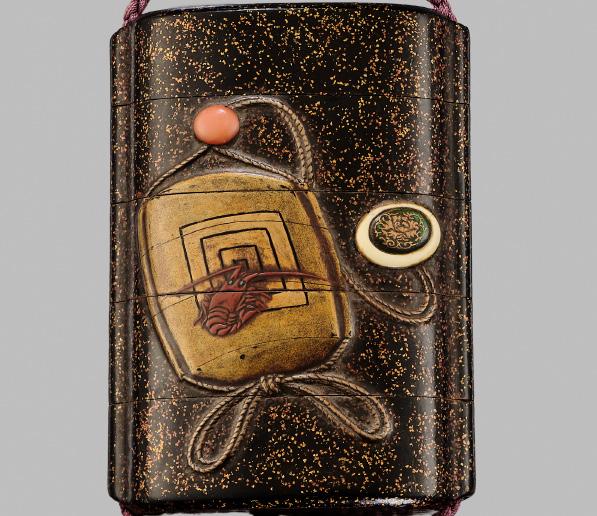
The four-case inro with a green-lacquered ground decorated in takamaki-e with fine inlays of pottery and mother-of-pearl, one side depicting a man and woman pounding mochi in a large wooden mortar, the reverse with a desiccated salmon and a lobster, all referring to the New Year. Mochi-pounding (Mochitsuki) is held in December in preparation for the New Year. The netsuke decorated with suisen (narcissus) issuing from rockwork, suisen blooming in Japan from December into early spring. The ojime further decorated with suisen.
ZESHIN: A LARGE FOUR-CASE LAQUER INRO WITH HORSES
Attributed to Shibata Zeshin (1807-1891), signed Zeshin 是真 Japan, mid to late 19th century, late Edo period (1615-1868) to Meiji period (1868-1912)
The identical design as on the present inro
The large inro of upright rectangular form and lenticular section, bearing a lustrous roiro ground and finely decorated in gold takamaki-e to depict stylized horses executed in the Rinpa tradition, one side showing a horse mid-stride turning its head back, while the reverse shows two standing horses facing each other, their bodies outlined in gold lacquer and the manes and tails lacquered in finely textured yamimaki (black on black lacquer). Signed in subori (scratched) characters to the underside ZESHIN. The interior sprinkled with sparse gold lacquer flakes and with gold fundame rims.
HEIGHT 10.2 cm, LENGTH 7.8 cm
Condition: Very good condition with minor wear and typical light traces of use. Few minute nibbles to edges, particularly along the risers and to the cord holes.
LITERATURE COMPARISON
Compare a closely related fourcase inro with an identical design, by Shiomi Masanari, illustrated in Gabor Wilhelm et al. (eds.), Sleeping Beauties. Sagemono and Netsuke, 2004, pp. 14-15, no. 11.
MUSEUM
COMPARISON
Compare a related single-case inro with horse design, by Shibata Zeshin, Japan, Edo to Meiji period, dated mid to late 19th century, 7.3 cm high, in the Museum of Fine Arts Boston, accession number 11.10061. Compare a related single-case inro with design of a horse and autumn grasses, by Shibata Zeshin, Japan, Edo to Meiji period, dated mid to late 19th century, 5.7 cm high, in the Metropolitan Museum of Art, object number 29.100.830.
Estimate EUR 4,000
Starting price EUR 2,000
13
A FINE ZESHIN-STYLE FOUR-CASE GOLD LACQUER INRO WITH A PINE TREE AND THE FULL MOON
Unsigned Japan, mid to late 19th century, late Edo period (1615-1868) to Meiji period (1868-1912)
The small inro of oval shape, bearing a fine gold kinji ground applied with gold takamaki-e and some kirigane to depict a large pine tree extending to both sides above a lake executed in the seigaiha technique, the silver moon reflecting in the turbulent water, the actual moon seen at the top of the inro. The interior cases of mottled red lacquer with gold fundame rims.
HEIGHT 7 cm, LENGTH 5 cm
Condition: Excellent condition with only very minor wear and light traces of use.
The inro is decorated with the seigaiha (“blue sea waves”) technique, revived by the great lacquerer Shibata Zeshin (18071891) after falling out of use for over two centuries. Seigaiha is achieved by drawing a comb through a thin layer of wet lacquer mixed with cereal starch or white lead to improve its viscosity; the process has to be perfectly executed in a short time before the lacquer dries and mistakes cannot be corrected.
AUCTION COMPARISON
Compare a related gold lacquer inro with seigaiha technique, unsigned, at Bonhams, Fine Japanese Art, 6 November 2007, London, lot 13 (sold for GBP 2,640 or approx. EUR 5,000 adjusted for inflation at the time of writing). Also compare a related inro set by Shibata Zeshin with the seigaiha technique at Bonhams, The Edward Wrangham Collection of Japanese Art Part I, 9 November 2010, London, lot 286 (sold for GBP 162,000 or approx. EUR 290,000 adjusted for inflation at the time of writing).
Estimate EUR 2,000
Starting price EUR 1,000
A SUPERB FOUR-CASE LACQUER INRO DEPICTING FLYING CROWS AT NIGHT
Unsigned Japan, mid-19th century, Edo period (1615-1868)
Of upright rectangular form and oval section, bearing a fine shibuichi-nuri (lacquer technique imitating shibuichi metal) ground and finely decorated in black takamaki-e and hiramaki-e to depict a flock of crows in flight, their wings vividly detailed and their eyes neatly accented with gold lacquer. The interior cases of black lacquer with gold fundame rims.
With a beautifully matching suaka (refined copper) ojime in the form of a flat disc inlaid with shibuichi takazogan and incised in kebori and katakiribori to depict an egret on one side and bamboo on the other. The netsuke in the form of a gull (miyakodori) with rounded eyes inlaid with dark horn, executed in the style of Ohara Mitsuhiro (1810-1875).
HEIGHT 6.4, LENGTH 5.4 cm
Provenance: From a private collection in Italy, acquired from Becker Antiques, Cannes, on 1 July 2003.
Condition: Very good condition with only very minor wear and typical traces of use. The netsuke in very good condition with wear and one age crack with a gold-lacquered fill.
The manner of the beautifully executed textured ground simulating shibuichi along with the finely detailed, black-lacquered crows are reminiscent of the work of Shibata Zeshin (1807-1891).
Crows flying at sunset, by Shibata Zeshin, dated c. 1888, in the Metropolitan Museum of Art, object number 2002.161.94
Estimate EUR 4,000
Starting price EUR 2,000
A SINGLE-CASE LACQUER INRO WITH CROWS AND THE MOON
Unsigned Japan, late 18th century, Edo period (1615-1868)
Of distorted moon-shape, the case bears a silver-lacquered ground, delicately decorated in gold and black takamaki-e. One side depicts two crows perched upon the gnarled branch of a pine tree, while the reverse shows another crow in flight above a luxuriant branch. The artist masterfully contrasts the crows’ velvety black plumage - seamlessly merging with the darkness of night - against the luminous golden bark, which shimmers as though reflecting moonlight. On the side with the flying crow, the reflection is echoed below in the form of a half-moon rendered in gold nashiji lacquer. The interior is finished in rich nashiji with gold fundame rims and fitted with a removable inner case.
With an oval turquoise-glass ojime.
HEIGHT 6.1 cm, LENGTH 7.6 cm
Crow and the Moon, by Kawanabe Kyosai, c. 1887
Provenance: Collection of the distinguished attorney Jay R. Butterman, New York, United States.
Condition: Very good condition with only minor wear, expected traces of use. Two minuscule nicks, one to a cord hole and another along the edge of one side.
Estimate EUR 2,000
Starting price EUR 1,000
A LARGE FOUR-CASE INLAID LACQUER INRO WITH DRAGONFLIES
Unsigned Japan, first half of the 19th century, Edo period (1615-1868)
Of rectangular form and lenticular section, bearing a lustrous roiro ground and finely inlaid with stained bone, tortoiseshell, and pewter-enriched lacquer to depict a dynamic group of three fluttering dragonflies. Their slender bodies and translucent wings neatly detailed with gold hiramaki-e veins, while their eyes are inlaid with mother-of-pearl. The interior cases of roiro with gold fundame rims.
LENGTH 8.7 cm, HEIGHT 8.2 cm
Provenance: Collection of William Cleverley Alexander, thence by descent.
Condition: Very good condition with only minor wear and expected traces of use including some light scratches to the ground and some light nibbling to edges.
MUSEUM COMPARISON
Compare a related inro with design of dragonflies, Japan, Edo to Meiji period, dated 18th-19th century, 7.2 cm high, in the Metropolitan Museum of Art, object number 36.100.189.
AUCTION COMPARISON
Compare a related Koamischool lacquered single-case inro with dragonflies, dated 19th century, 9.2 cm long, at Zacke, Fine Japanese Art, 14 June 2024, Vienna, lot 55 (sold for EUR 4,160).
Estimate EUR 2,500
Starting price EUR 1,200
17 A RARE FIVE-CASE LACQUER INRO DEPICTING A BLOSSOMING PRUNUS TREE
Unsigned Japan, 18th-19th century, Edo period (1644-1868)
Of upright rectangular form and oval section, bearing a lustrous roiro ground and richly decorated in gold, red, and white lacquerenriched pigments to depict a continuous scene with a plum (ume) tree in bloom, the branches finely outlined in gold. The interior cases lacquered in red.
HEIGHT 9.1 cm, LENGTH 5.6 cm

Provenance: Collection of William Cleverley Alexander, thence by descent. William Cleverly Alexander (1840–1916) was a successful London banker who rose to the position of senior partner in the firm Alexander’s Discount, established by his father George William Alexander (1802–1890), a Quaker and founding member of the British and Foreign Anti-Slavery Society in 1839. William Cleverly Alexander was an avid collector, a notable member of the Burlington Fine Arts Club, and one of the founders of the National Art Collections Fund. His collection included Japanese woodblock prints such as Thirty-Six Views of Mount Fuji by Hokusai, Japanese lacquerware, a significant group of works by James Abbott McNeill Whistler, and Chinese art ranging from Qing dynasty porcelains and jades to earlier wares from the Han, Tang, and Song dynasties. According to Roger Fry, founding member of the Contemporary Art Society, Alexander was ‘one of the most important figures in the world of art’, remarkable for his modesty and indifference to social status.
Condition: Very good condition with only minor wear and typical traces of use, some light discoloration to lacquer to edges.
Estimate EUR 2,000
Starting price EUR 1,000
William Cleverly Alexander (1840–1916)
SHIOMI MASANARI: A SUPERB FOUR-CASE GOLD LACQUER INRO WITH A HERDSBOY AND OX
By a member of the Masanari family, signed Shiomi Masanari 鹽見 政誠 Japan, 19th century, Edo period (1615-1868)
Of upright rectangular form and lenticular profile, bearing a superb gold kinji ground, brilliantly lacquered in gold and colored togidashi-e with a design of a herdsboy struggling and hauling on the halter of an ox which pulls away scurrying off to the other side of the inro. The interior cases of nashiji with gold fundame rims. Signed within the typical, red-lacquered reserve to the bottom right corner SHIOMI MASANARI.
With a fine iron and silver takazogan ojime signed KOMIN.
HEIGHT 8 cm, LENGTH 5.2 cm
Provenance: Collection Prof. Dr. Henk C. Hoogsteden, Rotterdam.
Condition: Very good condition with only very minor wear including some light discoloration to the kinji ground, very light surface scratches and minuscule nibbling to the edges of the risers.
The imagery plays on a Zen Buddhist parable which draws a parallel between the herdboy and ox and the attainment of enlightenment. It is most famously portrayed in the series of ten ox herding pictures (originally only eight) accompanied by a series of short poems by Kakuan Shien. The motif is often associated with the Shiomi Masanari family of lacquer artists founded at the end of the seventeenth century, whose name was passed down by successive generations of pupils and descendants.
Shiomi Masanari (1647-1722) was a talented painter of the Kano school, however he is better known for his lacquerwork and the important family of lacquerers that he founded. Whether or not he was a pupil of Yamamoto Shunsho (1610-1682) as is widely believed, the Shiomi family also specialized in togidashi-e (‘brought out by rubbing’) lacquer of extremely high quality, as is exhibited in the present piece.
AUCTION COMPARISON
For the identical design on a smaller inro, also signed Shiomi Masanari, 5.7 cm high, see Zacke, Fine Netsuke & Sagemono, 16 April 2021, Vienna, lot 241 (sold for EUR 7,320).
Estimate EUR 6,000
Starting price EUR 3,000
SHIOMI MASANARI: A FINE FOUR-CASE GOLD LACQUER INRO WITH A HERDSBOY AND OX
By a member of the Masanari family, signed Shiomi Masanari 鹽見 政誠 Japan, 19th century, Edo period (1615-1868)
Of upright rectangular form and lenticular profile, bearing a superb gold kinji ground, brilliantly lacquered in gold and colored togidashi-e with a design of a herdsboy struggling and hauling on the halter of an ox which pulls away scurrying off to the other side of the inro. Some details such as the robe of the boy and the hooves of the ox are embellished with kirigane flakes. The interior cases of nashiji with gold fundame rims. Signed within the typical, red-lacquered reserve to the bottom right corner SHIOMI MASANARI.
With a coral ojime.
HEIGHT 7.4 cm, LENGTH 5.6 cm
Provenance: From an important German private collection, the collection assembled since the 1960s.
Condition: Excellent condition with only very minor expected wear including rubbing to lacquer and very light surface scratches.
AUCTION COMPARISON
Compare a closely related three-case lacquer inro by the same artist, also signed Shiomi Masanari, dated to the 19th century, at Bonhams, Japanese Works of Art, 19 September 2008, New York, lot 5029 (sold for USD 10,800 or approx. EUR 14,000 adjusted for inflation at the time of writing). Note in particular the near-identical manner of the ox with red eyes and rope halter.
Estimate EUR 6,000
Starting price EUR 3,000
A MAGNIFICENT FOUR-CASE TOGIDASHI LACQUER INRO DEPICTING SPARROWS AMIDST FALLING SNOW
Unsigned Japan, 18th century, Edo period (1615-1868)
Of upright rectangular form and oval section, bearing a lustrous roiro ground and exquisitely decorated in gold and silver togidashi-e to depict a lively scene of sparrows fluttering beneath a gentle snowfall around lush bamboo branches, while others perch upon them in quiet observation, the branches delicately dusted with snow. The interior cases of nashiji with gold fundame rims.
HEIGHT 7.1 cm, LENGTH 5.9 cm
Provenance: Collection of William Cleverley Alexander, thence by descent. An old collector’s label affixed to the interior of the upper case, inscribed ‘Reynolds, 26/11/87, CE’.
Condition: Excellent condition with only very minor wear.
AUCTION COMPARISON
Compare a related four-case gold and black lacquer inro depicting flying sparrows among snow-covered bamboo, dated to the late 19th century, 10.2 cm high, at Bonhams, The Last Treasures from the Edward Wrangham Collection of Japanese Art, 19 July 2021, London, lot 154 (sold for GBP 1,912 or approx. EUR 3,000 converted and adjusted for inflation at the time of writing).
Estimate EUR 4,000
Starting price EUR 2,000
21
YOYUSAI: A FINE FOUR-CASE GOLD LACQUER INRO DEPICTING SPARROWS AND BAMBOO
By
Hara Yoyusai (1772-1845/6), signed Yoyusai 羊遊斎 saku 作 Japan, early to mid-19th century, Edo period (1615-1868)
Of upright rectangular form and oval section, bearing a lustrous kinji ground dusted with e-nashiji and richly decorated in gold takamaki-e and hiramaki-e to depict a continuous scene of sparrows fluttering among lush bamboo trees. Further sparrows perch on the elevated bamboo irrigation pipes, their posts delicately inlaid with gold kirigane, while others play and peck among the grass. Signed on the underside YOYUSAI saku [made by Yoyusai]. The interior cases of nashiji with gold fundame rims.
HEIGHT 8.7 cm, LENGTH 6.1 cm
Provenance: From the private collection of Alan and Simone Hartman, New York.
Condition: Excellent condition with only minor wear and expected traces of use.
Hara Yoyusai (1772-1845/6) lived in Edo and worked under the patronage of Lord Matsudaira, as documented by Edward A. Wrangham. He maintained an extensive workshop, producing a large number of lacquer objects bearing either his signature or his monogram (kao). For the same signature, as well as further information regarding the presence of his works in contemporary and subsequent collections, see Edward A. Wrangham and Joe Earl (eds.), The Index of Inro Artists, 1995, p. 340.
AUCTION COMPARISON
Compare a related three-case gold and black lacquer inro depicting a flock of sparrows raiding a field of ripened millet stalks, after Hara Yoyusai, dated mid-19th century, 6.5 cm high, at Bonhams, Fine Japanese Art, 16 May 2024, London, lot 18 (sold for GBP 7,040 or approx. EUR 8,000 converted and adjusted for inflation at the time of writing).
Estimate EUR 3,000
Starting price EUR 1,500
YAMADA JOKASAI: A FINE FOUR-CASE LACQUER INRO WITH A PUFFIN
By a member of the Yamada Jokasai lineage, signed Yamada Joka 山田 常加 Japan, 19th century, Edo period (1615-1868)
Of upright rectangular form and oval section, set on a lustrous roiro ground and richly decorated in gold, silver, and red takamaki-e to depict a continuous scene with a puffin perched on the branch of a cherry tree, finely inlaid with gold kirigane, amid flowers in full bloom, some embellished with mother-of-pearl, their stamens delicately detailed in gold, and interspersed with leafy branches. Signed to the underside YAMADA JOKA. The interior cases of nashiji with gold fundame rims.
HEIGHT 7.4 cm, LENGTH 5.2 cm
Condition: Very good condition with only minor wear and expected traces of use including some tiny losses to the lacquer near the risers and some general nibbling to edges as is to be expected. Very minor typical losses to the kirigane flakes.
The Yamada Jokasai lineage lasted until the end of the Edo period. The first Yamada Jokasai lived in Tokyo in the late 17th century and worked for the shogunate, originally at the Kajikawa school. He crafted inro and kobako alongside the famous Koami Choho, later breaking off to establish his own school in Tokyo.
Estimate EUR 4,000
Starting price EUR 2,000
23
A SMALL FOUR-CASE LACQUER INRO DEPICTING CHOKARO SENNIN
Unsigned Japan, 18th century, Edo period (1615-1868)
Of upright rectangular form and lenticular section, bearing a lustrous roiro ground and finely decorated with gold takamaki-e to depict a continuous scene of Chokaro Sennin on one side, shown seated in voluminous robes and leaning against his large double gourd, while on the other a stylized horse, outlined in thick gold takamaki-e, emerges in flight from the hyotan’s mouth. The interior cases of nashiji with gold fundame rims.
24
YOYUSAI: A SMALL FOUR-CASE LACQUER INRO WITH A GOURD AND PAULOWNIA LEAVES
Lineage of Hara Yoyusai (1772-1845/6), signed Yoyusai 羊遊齋 Japan, early 19th century, Edo period (1615-1868)
Of upright rectangular form and oval section, bearing a lustrous roiro ground and finely decorated with gold takamaki-e and red hiramaki-e, inlaid with iridescent mother-of-pearl to depict on one side a double gourd adorned with a stylized monogram, from which slender tendrils extend to terminate in large paulownia leaves, the details enriched with kirigane flakes. The interior cases of roiro with gold fundame rims. Signed to the underside YOYUSAI.
HEIGHT 6.7 cm, LENGTH 5.2 cm
Provenance: From a private collection in Rhineland, Germany, acquired before 1985.
Condition: Good condition with expected wear and typical traces of use. Few losses to the cord holes with associated repairs. Minute nibbling to edges as expected and small dents and nicks to the upper side likely from contact with an ojime. Typical losses to the kirigane flakes.
Estimate EUR 1,500
Starting price EUR 800
HEIGHT 6.2 cm, LENGTH 5.1 cm
Provenance: From a private collection in Rhineland, Germany, acquired before 1985.
Condition: Good condition with minor wear and expected traces of use. A small chip to one cord hole at the top and some minor losses along the risers to the ground and gold lacquer as visible in the images provided. Minor general surface wear including some light scratches to the ground.
Estimate EUR 1,500
Starting price EUR 800
25
TOGI: A FINE THREE-CASE LACQUERED KIRI (PAULOWNIA) WOOD INRO
By Togi, signed Togi 桃宜 with kakihan Japan, late 18th to early 19th century, Edo period (1615-1868)
Published: Atchley, Virginia / Davey, Neil (2006) The Virginia Atchley Collection of Japanese Miniature Arts, p. 217, no. IN34.
Of upright rectangular form and lenticular section, bearing a pawlownia wood ground and finely decorated in gold, silver, and black takamaki-e to depict on one side two descending geese, their plumage minutely detailed, approaching wind-blown reeds on the opposite side. Signed to the underside in gold within a rectangular lacquer reserve TOGI with the artist’s distinctive kakihan. The interior cases lacquered in brown with gold fundame rims.
With a fine antler netsuke in the form of a lotus leaf, curled at the edges, and fitted with a metal ring cord attachment, sealed Koku (after Ozaki Kokusai).
HEIGHT 6.5 cm, LENGTH 7.2 cm
Provenance: Ex-collection Virginia Atchley, California, USA. Condition: Excellent condition with minor expected wear to the wood ground and tiny losses to the lacquer near the edges of the risers.
Togi was a lacquer artist active in Japan toward the end of the eighteenth century. Considering his technical mastery, he was likely affiliated with the more famous Kanshosai Toyo. For the same signature with identical distinctive kakihan see Edward A. Wrangham and Joe Earl (eds.), The Index of Inro artists, 1995, p. 291.
MUSEUM COMPARISON
For another work by the artist see the British Museum, registration number 981,0203.12.a.
Estimate EUR 3,000 Starting price EUR 1,500
Whitefronted goose descending over reeds, by Ohara Koson, c. 1910
KOMA KORYU: A FINE FOUR-CASE LACQUER INRO WITH DOVES AT A SHINTO SHRINE
By Koma Koryu, signed Koma Koryu 古満 巨柳 saku 作 and kakihan Japan, 19th century, Edo period (1615-1868)
Published: Mizutani Hidejiro, Mizutani korekushon, inro no kenkyu, Kyoto, Shohakusha, 1988, no. 52.
Of tall cylindrical form, finely decorated in gold, silver, and iro-e takamaki-e, enriched with aogai and chiseled gold inlays, all set against a subtly textured black lacquer ground. One side depicts a dove perched on a bird-feeder suspended from the eaves of a Shinto shrine at New Year, the season suggested by the blossoming plum tree nearby. The reverse shows a pair of doves in flight, the upper bird exquisitely inlaid in incised and polished gold of exceptional quality. The interior cases are finished in nashiji with rims of gold fundame. Signed to the underside KOMA KORYU saku [made by Koma Koryu] with a kakihan.
With a silvered-metal ojime in form of a ribbed gourd.
HEIGHT 9.6 cm, LENGTH 4.3 cm
Provenance: Ex-collection Mizutani Hidejiro, Kyoto. Bonhams, Fine Japanese Works of Art, 16 September 2009, New York, lot 3028 (sold for USD 4,880 or approx. EUR 8,400 converted and adjusted for inflation at the time of writing). From the private collection of Alan and Simone Hartman, New York, acquired from the above. Mizutani Hidejiro is a Japanese collector and dealer specializing in inro and related sagemono. He assembled what is referred to as the ‘Mizutani Collection’, published in Mizutani Hidejiro, Mizutani korekushon, inro no kenkyu, Kyoto, Shohakusha, in 1988. Condition: Very good condition with minor wear, tiny losses to the aogai inlays, minuscule nibbling along the rims.
AUCTION COMPARISON
Compare a related five-case lacquer inro with mixed-metal inlays, depicting the twelve zodiac signs, signed Koma Koryu saku, at Christie’s, Japanese & Korean Art, 14 September 2011, New York, lot 513 (sold for USD 6,875 or approx. EUR 8,400 converted and adjusted for inflation at the time of writing).
Estimate EUR 3,000
Starting price EUR 1,500
A SUPERB FOUR-CASE LACQUER INRO DEPICTING A BOAR RESTING AMONGST AUTUMN LEAVES AND FLOWERS
Unsigned Japan, 19th century, Edo period (1615-1868)
Of oval form, bearing a lustrous kinji ground and lavishly decorated in gold and silver takamaki-e to depict a continuous scene with a boar peacefully asleep among autumn grasses and flowers. The fur of the animal is minutely detailed, as are the fine veins of the leaves and the individual strands of grass. The interior cases of nashiji with gold fundame rims.
With a carved guri lacquer ojime designs and a beautifully matching lacquer manju netsuke finely embellished in gold takamaki-e depicting paulownia leaves among scrolling tendrils with silver-inlaid dew drops, all set against a lustrous roiro ground.
HEIGHT 9.6, LENGTH 6.2 cm
Condition: Excellent condition with only very minor wear, typical traces of use, and expected minor nibbling to the edges. One inlaid dew drop of the manju is replaced.
Such autumn leaves, alongside a boar in a pose similar to this one, are shown in a version of the painterly theme of ‘Akikusa ni fusuru inoshishi’ (A Wild Boar Lying Amidst Autumn Plants) that was published in 1720 in an instructional picture book by Tachibana Morikuni.
LITERATURE COMPARISON
Compare a related large five-case lacquer inro with a boar asleep among grasses, unsigned but in the style of Shiomi Masanari, dated to the late 18th century, illustrated in Virginia Atchley and Neil Davey, The Virginia Atchley Collection of Japanese Miniature Arts, 2006, p. 205, no. IN19.
Estimate EUR 3,000 Starting price EUR 1,500
Wild boar sleeping beneath bushes during autumn by Tachibana Morikuni
28
KORYU: A FINE FOUR-CASE GOLD LACQUER INRO WITH A KIRIN AND HO-O
By Koryu, signed Koryu 光柳 Japan, 19th century, Edo period (1615-1868)
The four-case inro of oval form, bearing a lustrous kinji ground, centered to each side with a roundel worked in gold and iro-e takamaki-e and hiramaki-e, one side featuring a kirin in a mystical landscape detailed with kirigane rockwork, the reverse with a ho-o (phoenix) perched on a gnarly branch of paulownia, its tail feathers swaying in the wind. Signed below KORYU. The interior cases of nashiji with gold fundame rims.
With a fine agate ojime.
HEIGHT 8.5 cm, LENGTH 5.8 cm
Condition: Very good condition with minor wear, very little nibbling to edges and light rubbing to lacquer as is to be expected.
The artist is listed by E.A. Wrangham, The Index of Inro Artists, 1995, p.147, as being a member of the Kakosai Shozan group.
Estimate EUR 2,500
Starting price EUR 1,200
SUNRYUSAI KIYOCHIKA: A FOUR-CASE GOLD LACQUER INRO WITH A PEACOCK AND CHERRY TREE
By
Sunryusai Kiyochika, signed Sunryusai Kiyochika 寸柳斎 清親
Japan, early to mid-19th century, Edo period (1615-1868)
Of upright rectangular form and lenticular section, bearing a lustrous kinji ground and richly decorated in gold and silver takamaki-e and hiramaki-e to depict a continuous scene on both sides with a peacock preening its majestic plumage, inlaid with mother-of-pearl, atop rocky outcrops, standing before a cherry tree, symbolizing the arrival of spring, the branches set with gold foil. In the background, cascading waterfalls tumble among mountains, adorned with kirigane and e-nashiji. Signed to the underside SUNRYUSAI KIYOCHIKA. The interior surfaces with nashiji and goldfundame rims.
With a mixed-metal ojime depicting a three-clawed dragon talon chasing the sacred pearl (tama).
HEIGHT 7.8 cm, LENGTH 5.8 cm
Provenance: Bonhams London, 3 November 2022, lot 35, A British private collection, acquired from the above.
Condition: Good condition with minor wear and typical traces of use. Typical losses to kirigane flakes and to the gold foil inlays. A few minute dents to the top from contact with the ojime. One crack to one cord hole to the top and some tiny expected nibbling to edges. Minor red staining to the bottom case near the rock as visible in the images provided.
Estimate EUR 2,500
Starting price EUR 1,200
30
KAJIKAWA: A FINE FOUR-CASE GOLD LACQUER INRO WITH ROOSTER, DRUM, AND IVY (TSUTA NI NIWATORI TO TAIKO)
By a member of the Kajikawa family, signed Kajikawa 梶川 saku 作 with kakihan Japan, 19th century, Edo period (1615–1868)
Of upright rectangular form with lenticular profile, the ground in lustrous kinji shading to black with dense gold sprinkling toward the base. The decoration, executed in rich gold, silver, and red takamaki-e and hiramaki-e, depicts on one side a proud rooster, its plumage exquisitely detailed, perched upon a taiko drum. The drum body displays finely rendered mokume nashiji simulating wood grain, while the beating surface bears a stylized dragon in hiramaki-e. Ivy vines elegantly trail across the composition. The reverse shows a crouching hen attentively watching over her chicks. The underside signed KAJIKAWA saku [made by Kajikawa] with a red-lacquered kakihan. The interior cases of nashiji with gold fundame rims.
Accompanied by a gold lacquer ojime, decorated in takamaki-e with flowerheads.
HEIGHT 8.1 cm, LENGTH 5.5 cm
Provenance: Collection of Prof. Dr. Henk C. Hoogsteden, Rotterdam, Netherlands.
Condition: Excellent condition, with only minimal wear and expected light traces of use.
The Kajikawa name belongs to the most celebrated dynasty of Japanese lacquer artists and is the family name most frequently encountered on inro. Traditionally founded by Hikobei in Edo in the early seventeenth century, the atelier’s fame was further secured by his son and pupil Kyujiro, whom Soken Kisho described as “the finest inro maker of past or present.” The Kajikawa served the shogunate for generations, their signatures often limited to the family name, occasionally accompanied by a red pot seal. For a comprehensive study of the Kajikawa lineage, see Edward A. Wrangham and Joe Earle (eds.), The Index of Inro Artists, 1995, pp. 107–108.
The motif of the rooster perched on a taiko drum symbolizes peace under a benevolent ruler. The design derives from an ancient Chinese tradition, where drums were placed at city gates to warn of enemy approach. In times of peace they remained unused, mosscovered, and silent, allowing birds to roost undisturbed upon them.
AUCTION COMPARISON
Compare a related five-case lacquer inro depicting a rooster perched on a war drum with hens and chicks, by a member of the Kajikawa family, at Bonhams, Fine Japanese Works of Art, 22 March 2011, New York, lot 3061 (sold for USD 2,562 or approx. EUR 3,000 converted and adjusted for inflation at the time of writing).
Estimate EUR 2,500
Starting price EUR 1,200
A FINE FOUR-CASE GOLD LACQUER INRO DEPICTING FOLDING SCREENS
Unsigned Japan, 18th century, Edo period (1615-1868)
Of upright rectangular form and oval section, bearing a lustrous kinji ground and richly decorated in gold takamaki-e and hiramaki-e to depict on one side a large folding screen with cranes standing beneath a lush pine tree, the frame finely detailed with foliage motifs, embellished with delicate aogai inlays, while the reverse of the folding screen is lacquered in silver and detailed with the typical lozenge pattern found on these byobu. The opposite side shows a small table screen, brilliantly lacquered in togidashi-e, portraying blossoming irises (shobu), the screen placed before a scattered arrangement of books resting on the ground, one half-opened evoking the momentary absence of the literatus from his study. The interior cases of nashiji with gold fundame rims.
HEIGHT 7.4 cm, LENGTH 5.8 cm
Condition: Very good condition with expected wear and typical traces of use. One minute chip to one cord hole to the top and minimal nibbling to edges as is to be expected.
Estimate EUR 2,000
Starting price EUR 1,000
32
A FINE FOUR-CASE LACQUER INRO WITH A TORII GATE
Unsigned Japan, 18th-19th century, Edo period (1615-1868)
Of upright rectangular form and oval section, bearing a lustrous nashiji ground and finely decorated in gold takamaki-e and inlaid with gold kirigane to depict a continuous scene with an imposing coastal landscape with a lone torii standing near the shore, embraced by lush vegetation, while the sea stretches into the distance beneath a sky veiled with drifting clouds. The interior cases of nashiji with gold fundame rims.
With a cylindrical silver ojime neatly inlaid in silver takazogan to depict a crab.
HEIGHT 7.6 cm, LENGTH 5.3 cm
Provenance: Collection of Prof. Dr. Henk C. Hoogsteden, Rotterdam, Netherlands.
Condition: Excellent condition with only minor wear and expected traces of use.
A torii gate is a traditional Japanese structure that marks the entrance to a Shinto shrine, symbolizing the transition from the ordinary world into the sacred. Usually made of wood or stone and painted bright red, these gates embody purity, protection, and a connection to the divine.
Estimate EUR 2,000
Starting price EUR 1,000
The “Heiwa-no-Torii” (Peace Gate), which leads up to Hakone Shrine, similar to the scene depicted on the present inro
KOMA KANSAI: AN EXQUISITE MINIATURE TWO-CASE METAL-INLAID LACQUER INRO WITH GEESE AMONG REEDS
By a member of the Koma Kansai lineage, signed Kansai 寛哉 Japan, 19th century, Edo period (1615-1868)
The miniature inro of rounded shape, bearing a dense gold nashiji ground, lavishly decorated with gold takamaki-e and inlaid with gold and shakudo to depict a continuous scene with two geese standing in a meadow surrounded by reeds blown by the wind on one side, while on the opposite side a further goose soars gracefully. Signed to the underside KANSAI. The interior cases of nashiji with gold fundame rims.
HEIGHT 4.2 cm, LENGTH 3.7 cm
Condition: Excellent condition with only minor wear and minimal traces of use and some typical light nibbling to edges.
The Koma were among the most celebrated dynasties of Japanese lacquer artists, founded in Edo during the 17th century by Kyui, who is recorded as having produced inro for Shogun Tokugawa Iemitsu. For more than two centuries, successive generations of the family served as official lacquerers to the court and shogunate, their artistry setting the highest standards of the craft. Virtually all members of the lineage are thought to have created inro, alongside other lacquer objects. Among them, Koma Kansai stands out as one of the most distinguished masters, renowned for his versatility across techniques and media, and frequently collaborating with leading metalworkers to produce works of remarkable refinement—such as the present inro.
Estimate EUR 3,000
Starting price EUR 1,500
GYOKUZAN: A SUPERB METAL INLAID AND LACQUERED FIVE-CASE INRO WITH A KOTO PLAYER
By Tachibana Gyokuzan, signed Gyokuzan 玉山 saku 作 Japan, Edo (Tokyo), 19th century, Edo period (1615-1868)
Of upright rectangular form and oval section, inlaid in silver, shakudo, and gold takazogan to depict a nobleman seated atop a tiger’s pelt and playing the koto to a young boy, above a nashiji and e-nashiji ground, the reverse of kinji with sprays of kiku and butterflies. The interior of nashiji with gold fundame rims. Signed below GYOKUZAN saku [made by Gyokuzan].
With a shibuichi ojime decorated in gold and silver hirazogan with an inuribako, and a kagamibuta netsuke fitted with a shibuichi plate decorated with gold and suaka takazogan to depict Minamoto no Yoshitsune playing the flute on the Gojo bridge.
HEIGHT 8.5 cm, LENGTH 5.3 cm, DIAMETER 4.2 cm (the netsuke)
Condition: Very good condition with minor surface wear and few minuscule nibbles along the rims.
For the artist see Earle, Joe [ed.] (1995) The Index of Inro Artists, p. 63. The artist made netsuke, inro and ojime, often with fine metal inlays, and may have been affiliated with the Kajikawa workshop.
AUCTION COMPARISON
Compare a related metal-inlaid lacquer inro by the same artist, signed Jitokusai Gyokuzan, 19th century, at Bonhams, Fine Japanese Art, 15 May 2014, London, lot 65 (sold for GBP 5,250 or approx. EUR 9,600 converted and adjusted for inflation at the time of writing).
Estimate EUR 6,000
Starting price EUR 3,000
A SUPERB SHIBAYAMA INLAID GOLD LACQUER
SAYA (SHEATH) INRO WITH JUROJIN AND CRANE
Unsigned
Japan, Meiji period (1868-1912)
The large inro, comprising a saya (sheath) and a three-case insert, the outer sheath finished in a lustrous kinji ground and embellished with Shibayama-style inlays of stained bone, mother-of-pearl, coral, buffalo horn, and tortoiseshell. The design depicts Jurojin riding a crane in flight, his scroll amusingly unfurling in response to the dynamic movement and rushing wind. The reverse is decorated with an ornate hanakago (flower basket) brimming with auspicious blossoms, with a single bat shown in flight above. The insert is lacquered in fine togidashi-e as well as e-nashiji, with floral and ho-o (phoenix) medallions; the interior cases finished in silver lacquer with gold fundame rims.
With a coral ojime.
HEIGHT 7 cm, LENGTH 6.3 cm
Condition: Excellent overall condition, with only two minute losses to the inlays on the side depicting the hanakago. The interior inro is likewise remarkably well preserved, exhibiting only the most minor traces of wear.
AUCTION COMPARISON
Compare a closely related gold lacquer and Shibayama inlaid saya inro, dated to the Meiji period, 8.1 x 9.5 cm, at Bonhams, Fine Japanese Art, 12 May 2016, London, lot 286 (sold for GBP 9,375 or approx. EUR 16,500 adjusted for inflation at the time of writing).
Estimate EUR 10,000
Starting price EUR 5,000
36 AN IMPRESSIVE AND LARGE FOUR-CASE LACQUER INRO IN THE FORM OF A KINCHAKU DEPICTING THE SEVEN LUCKY GODS (SHICHIFUKUJIN)
Unsigned Japan, late 19th century, Meiji period (1868-1912)
Finely modeled in the form of a kinchaku (drawstring bag), lavishly decorated in gold takamaki-e to depict stylized panels shaped as the distinct attributes of the Seven Gods of Fortune (Shichifukujin). Each, set within a raised border on a kinji ground, containing distinctive scenes of the deities along with their respective treasures (takarabune). The panels interspersed with golden scrolling tendrils and inlaid details of mother-of-pearl and gold kirigane against a vivid vermilion ground. The bag secured with a cord tied in a knot, while the top is adorned with dense nashiji. The interior cases of nashiji with gold fundame rims.
With a finely carved globular ojime depicting a samurai and a pumpkin-shaped tsuishu (carved red lacquer) netsuke, the surface decorated with a neatly carved asanoha pattern and fitted with a silver mounting in the form of a chrysanthemum for cord attachment.
HEIGHT 9.4 cm, LENGTH 7 cm
Condition: Very good condition with only minor wear and expected traces of use including tiny losses to inlays and to some lacquered details, particularly along the edges. The netsuke with some losses to lacquer.
MUSEUM COMPARISON
Compare a related three-case gold lacquer inro in the shape of the deity Hotei’s treasure bag with patchwork textile designs, by Kitamuro Shunsho, Japan, Meiji period, dated early 20th century, 7.9 cm high, in the Asian Art Museum, San Francisco, object number B70Y1471.
AUCTION COMPARISON
Compare a related single-case Shibayama lacquer in the form of a tied kinchaku (drawstring bag) with medallions containing various takaramono, Japan, Meiji period, dated late 19th century, 15.5 cm high, at Bonhams, Fine Japanese Works of Art, 19 March 2013, New York, lot 2221 (sold for USD 35,000 or approx. EUR 41,000 converted and adjusted for inflation at the time of writing).
Estimate EUR 8,000
Starting price EUR 4,000
37
TOYO: A FINE INLAID LACQUER THREE-CASE INRO REFERENCING THE TAKETORI MONOGATARI
Lineage of Iizuka (Kanshosai) Toyo, signed Toyo 桃葉 with kakihan Japan, 19th century, Edo period (1615-1868)
Formed as a bundle of brushwood, the individual sections alternately lacquered in kinji and brown, adorned with numerous kirigane flakes, the gnarls highlighted with gold foil, and the cut ends neatly shown at the top and bottom. One side decorated with an axe backed by a blossoming sakura branch, the reverse with a hyotan bottle among maple leaves, the double gourd inlaid with beautifully iridescent mother-of-pearl. The interior in fine nashiji with gold fundame rims. Signed within an oval reserve TOYO with kakihan.
With a coral ojime and a very fine, beautifully matching hyotanshaped netsuke, lacquered with tassels and maple leaves, ringed around the center with a silver loop, and fitted with a simulated stopper.
HEIGHT 6.9 cm, LENGTH 5.7 cm (the inro) 6.8 cm (the netsuke)
Provenance: From a family heirloom collection in the United States, mostly formed in Japan during the late 1960s and in the USA during the 1970s, thence by descent to the present owner. Condition: Excellent condition with minor wear and expected light traces of use as well typical losses to the kirigane flakes.
This quite unusual and very attractive inro most likely illustrates the Taketori monogatari (The Tale of the Bamboo-cutter).
AUCTION COMPARISON
Compare a related shell-inlaid goldlacquer four-case inro, signed Toyo, 19th century, 8.5 cm tall, at Bonhams, Fine Japanese Art, 12 May 2016, London, lot 278 (sold for GBP 5,000 or approx. EUR 8,900 converted and adjusted for inflation at the time of writing).
Estimate EUR 4,000
Starting price EUR 2,000
38 A RARE TWO-CASE GOLD LACQUER
‘CHAIRE AND SHIFUKU’ INRO
Unsigned
Japan, 18th century, Edo period (1615-1868)
Shaped as a shifuku (drawstring bag) enclosing a chaire (tea caddy), the lid with a finial in the form of an inlaid coral branch, the ground simulating a typical dark brown glaze, the shifuku lacquered in nashiji with fine hiramaki-e karakusa and peonies, accented with gold droplets, and “suspended” from a minutely detailed cord with a tassel hanging to one side. The interior cases of nashiji with gold fundame rims.
With an agate ojime and a fine Iwami-school ebony wood netsuke naturalistically carved in the form of a tortoise with inlaid eyes.
HEIGHT 6.8 cm, LENGTH 4.6 cm (the inro)
LENGTH 4.2 cm (the netsuke)
Provenance: Collection of William Cleverley Alexander, thence by descent.
Condition: Good condition with minor wear and expected traces of use. A chip to the side between the middle and top case, and some general light rubbing to lacquer and nibbling to edges of the cases.
Estimate EUR 2,000
Starting price EUR 1,000
39 KAJIKAWA BUNRYUSAI: AN EXQUISITE AND RARE MINIATURE TWO-CASE LACQUER INRO WITH A HO-O (PHOENIX)
Lineage of Kajikawa Bunryusai, signed Bunryusai 文竜 斎 saku 作 Japan, 19th century, Edo period (1615-1868)
Of miniature upright rectangular form, bearing a dense gold nashiji ground, superbly decorated with gold, red, and silver takamaki-e and hiramaki-e. The design masterfully depicts two ho-o (phoenixes) on each side, their delicately rendered wings spread wide as they fly toward each other symbolizing auspiciousness. The plumage of the phoenixes is embellished with fine kirigane flakes. Both birds are set against a hanabishi design, extending seamlessly across both the top and bottom cases. Signed to the underside BUNRYUSAI saku [made by Bunryusai]. The interior cases of red lacquer with gold fundame rims.
With an agate ojime and a hako (box) netsuke signed with the kakihan of Kajikawa Bunryusai in red lacquer and decorated with paulownia leaves, completing the theme of Kiri no Ho-o.
HEIGHT 6 cm, LENGTH 3.9 cm (the inro)
LENTH 2.4 cm (the netsuke)
Condition: Very good condition with wear to one cord hole. Otherwise, only minor age-related traces of use.
With a wood tomobako (storage box) inscribed to the exterior lid ‘Ho-o Inro’ 鳳凰 印籠 [Inro with the Ho-o bird design].
Estimate EUR 2,000
Starting price EUR 1,000
40
KOSHINSAI: A FINE SHIBAYAMA INLAID FOUR-CASE GOLD LACQUER INRO
By Koshinsai, signed Koshinsai 光真斎 Japan, Tokyo, late 19th century, Meiji period (1868-1912)
Of oval shape, decorated with a classic kachoga (birds-andflowers) scene on a shimmering kinji ground. One side features a sparrow perched among trailing ivy vines with hagi bushes in the background; the reverse shows a ladybird crawling on reeds, flanked by white kikyo blossoms. The details are finely executed in the Shibayama style, inlaid with mother-of-pearl, coral, pale buffalo horn, and green semi-precious stones, and further enriched with gold and iro-e takamaki-e lacquer. The interior cases of nashiji with gold fundame rims. Signed below KOSHINSAI.
With a plain gold kinji lacquer ojime.
HEIGHT 8.7 cm, LENGTH 5.5 cm
Condition: Very good condition with minor wear, little rubbing, and a fine crack to the bottom section.
AUCTION COMPARISON
Compare a related four-case Shibayama lacquer inro, signed Kakosai and Kyogetsusai, late 19th century, at Bonhams, Fine Japanese Works of Art, 19 March 2013, New York, lot 2217 (sold for USD 7,500 or approx. EUR 8,900 converted and adjusted for inflation at the time of writing).
Estimate EUR 5,000 Starting price EUR 2,400
A FOUR-CASE SHIBAYAMA-STYLE
LACQUER INRO WITH BLOSSOMS AND BERRIES
Unsigned Japan, 19th century, Edo period (1615-1868)
Of upright rectangular form, bearing a shibuichi-nuri ground finely decorated in gold takamaki-e and hiramaki-e, and inlaid with gold, silver, coral, and mother-of-pearl in the Shibayama style to depict leafy vines growing up a fence, issuing clusters of berries and beautifully-inlaid blossoms on both sides. The interior cases of nashiji with gold fundame rims.
With a green marbled glass ojime.
HEIGHT 8.1 cm, LENGTH 5.9 cm
Condition: Repair to one cord hole and to one edge. Otherwise good condition with minor wear and typical traces of use. Few tiny dents to the top from contact with the ojime. Tiny expected nibbling to edges. The ojime repaired.
Estimate EUR 3,000 Starting price EUR 1,500
A FINE BUFFALO HORN-INLAID THREE-CASE INRO OF A DEER AT NIGHT IN KASUGA PARK, NARA
Unsigned Japan, 19th century, Edo period (1615-1868)
Of upright rectangular form with rounded corners, masterfully lacquered in togidashi with iro-e takamaki-e and hiramaki-e. One side depicts a deer, exquisitely inlaid in colored buffalo horn, gazing toward a stream in which the moon’s reflection shimmers in delicate silver lacquer, the moon lacquered to the top of the inro. The reverse shows a cedar tree, its bark richly rendered in textured takamaki-e, beside a toro (stone lantern) finished in ishime to simulate weathered stone. The interior cases are in nashiji, with rims of gold fundame.
HEIGHT 7.1 cm, LENGTH 5 cm
Condition: Excellent condition with minor wear consistent with age and use. Small nibbles along the rims and a few tiny losses to the lacquer of the tree, but overall exceptionally well-preserved.
Estimate EUR 4,000
Starting price EUR 2,000
A deer at Nara park next to a stone lantern, 2023
43
A SUPERB ‘CICADA AND BAMBOO’ FOUR-CASE LACQUER INRO SET WITH MATCHING NETSUKE AND OJIME
Unsigned Japan, 19th century, Edo period (1615-1868)
Of upright rectangular form and oval section, decorated in gold and silver takamaki-e and hiramaki-e, to depict a semi (cicada), beautifully inlaid in buffalo horn, clambering on bamboo leaves, all on a roiro ground with e-nashiji to the lower half. The interior cases of nashiji with gold fundame rims.
Accompanied by a beautifully matching suaka (refined copper) cicada-form ojime and wood netsuke carved as a cicada perched on a half walnut.
HEIGHT 7.4 cm, LENGTH 5.5 cm (the inro) LENGTH 4.2 cm (the netsuke)
Provenance: From the private collection of Alan and Simone Hartman, New York.
Condition: Excellent condition with only very minor wear and light traces of use.
AUCTION COMPARISON
Compare a related gold lacquer five-case inro with a cicada on a pine tree, signed Shunkosai Kunihiro saku, 7.9 cm tall, at Bonhams, The Edward Wrangham Collection of Japanese Art, 6 November 2013, London, lot 257 (sold for GBP 4,375 or approx. EUR 8,100 converted and adjusted for inflation at the time of writing).
Estimate EUR 4,000
Starting price EUR 2,000
A SUPERB AND LARGE EBONY WOOD THREE-CASE INRO DEPICTING TURTLES, WAFTING WAVES, AND A ROCK CRYSTAL BALL (YASAKI NO NAGATAMA)
Unsigned Japan, 19th century, Edo period (1615-1868)
Of remarkable size and presence, this inro is superbly carved from ebony wood, the surface deeply incised with wafting waves framed by swirling clouds, the crests highlighted with large silver dew drops. On either side, a turtle rests upon a rocky outcrop, each gazing toward the magnificent rock crystal ball secured in the central case upon red felt, which forms the dramatic centerpiece of the composition. The subject, occasionally encountered in Meijiperiod metalwork, alludes to Ryujin, the Dragon King of the Sea, and his sacred crystal ball (tide jewel), believed to govern the ebb and flow of the tides.
The ensemble is completed by a fine tsuishu lacquer ojime, inlaid with mother-of-pearl and incised with a butterfly, and an exceptionally well-matched ebony wood netsuke. The latter, formed in two sections as a sphere, is carved with further rolling waves and a dragon with gilt eyes, a fitting companion piece since the dragon amidst waves is another potent emblem of Ryujin.
HEIGHT 10 cm, LENGTH 6 cm, WIDTH 3.6 cm (the inro)
HEIGHT 3.5 cm (the netsuke)
Provenance: From the collection of Arend Louis Serné. Arend Louis Serné (1925-2021) was the fourth-generation owner of the firm A. Serné & Son, Costumiers, located on the Groenburgwal, Amsterdam, Netherlands, established in 1866. An avid piano player, he was also fond of modern literature, and a passionate collector of inro. He started his inro collection in the late 1970s. At that time, he entered the gallery Aalderink Oriental Art along the Spiegelgracht in Amsterdam and was immediately captivated by the beauty of inro. He began his collection with three simple specimens but hoped to own more. He remarked, “Oh that’s nothing, a decent collection must be about a hundred pieces!” And collect he did. Arend was not concerned with the signature or the rarity, but with the intrinsic poetic beauty embodied in this very Japanese art form.
Condition: Excellent condition with only very minor wear and light traces of use including occasional nicks to the wood ground.
Estimate EUR 6,000
Starting price EUR 3,000
A similar concept executed in bronze by Yoshiaka, Meiji period, sold at Zacke, Fine Japanese Art, 13 June 2025, Vienna, lot 14
Ryuijin with the sacred rock crystal ball to lower and raise the tides, Meiji period, Zacke, Fine Japanese Art, 2 December 2022, Vienna, lot 55
45
HORAKU: A RARE LACQUER, METAL AND EBONY WOOD TONKOTSU
By Horaku, signed Horaku 宝乐 Japan, Kyoto, early 19th century, Edo period (1615-1868)
The unusual tobacco box covered in mottled lacquer resembling fish skin mounted with a metal rim delicately engraved with scrolling foliage, the interior lacquered in lustrous roiro. The flush-fitting lid is of ebony wood, expertly carved in high relief to depict a landscape and pavilion and signed underneath HORAKU.
Suspended from the tonkotsu is an ojime in the form of a half-eaten chestnut, along with a scent bottle lacquer netsuke shaped as a hyotan (double gourd), with silver mounts, richly decorated in guri lacquer with typical swirling designs.
LENGTH 7.2 cm HEIGHT 8 cm (the tonkotsu)
HEIGHT 6 cm (the netsuke)
Condition: Very good condition with old wear to the lacquer and with minor age cracks, the metal mount slightly loose. The netsuke and ojime in good condition with minor expected wear.
AUCTION COMPARISON
Compare a related ebony wood netsuke of pavilions by the same artist, signed Horaku, at Bonhams, The Edward Wrangham Collection of Japanese Art, 10 November 2015, London, lot 39 (sold for GBP 5,250 or approx. EUR 9,500 converted and adjusted for inflation at the time of writing).
Estimate EUR 5,000
Starting price EUR 2,400
46
MUTSUMINE SENSHI: A FINE GURI LACQUER SAGEMONO SET
By Mutsumine Senshi (active early 20th century), signed Mutsumine Senshi 六峯 仙史 and kakihan Japan, Nara, late 19th to early 20th century
A sagemono set comprising a senyu-zutsu kiseruzutsu (pipe case), a guri lacquer ojime (cord fastener), and a tonkotsu (tobacco box). The tonkotsu is lacquered in lustrous roiro and decorated in sunken relief with guri lacquer designs depicting various theater masks. Signed to the side MUTSUMINE SENSHI, with the artist’s kakihan, and further inscribed to the underside with the boldly incised inscription Jii 自怡 (self-contentment).
The kiseruzutsu is executed in a matching style and finely decorated with an image of Daruma gazing upward. To the top is inscribed: MUTSUMINE SENSHI kinsha [respectfully copied by Mutsumine Senshi], together with the artist’s kakihan.
HEIGHT 7 cm, LENGTH 7 cm (the tonkotsu)
LENGTH 21.1 cm (the kiseruzutsu)
Condition: Excellent condition with minimal wear.
The artist was a disciple of Kano Tessai (1845-1925) and is thought to have taught Ichikawa Tetsuro (1901–1987).
AUCTION COMPARISON
Compare a related guri lacquer kiseruzutsu with Daruma, dated 1922, attributed to Kano Tessai (1845-1925), at Zacke, Asian Art Discoveries, 24 July 2024, Vienna, lot 292 (sold for EUR 1,560).
Estimate EUR 3,000 Starting price EUR 1,500
REIKAKU: A THREE-CASE WOOD INRO IN THE FORM OF THE DOJOJI TEMPLE BELL
By Reikaku, signed Reikaku 霊客 Japan, 19th century, Edo period (1615-1868)
Published: Virginia Atchley and Neil Davey, The Virginia Atchley Collection of Japanese Miniature Arts, Chicago, 2006, p. 265, no. IN88.
The inro shaped as the iconic Dojoji temple bell, carved in relief with two panels around the center depicting a pair of tennin (apsara; Buddhist angels), one holding a lotus bud, the other a sho, centered by blossoms below, the reverse with scrolling clouds and constellations of stars, all surmounted by two confronting dragons sharing a loose tama and forming the handle. The underside signed REIKAKU.
HEIGHT 10 cm, LENGTH 6.6 cm
Provenance: Ex-collection Virginia Atchley, California, USA.
Condition: Very good condition with minor surface wear and light traces of use.
Estimate EUR 4,000
Starting price EUR 2,000
48
A FINE THREE-CASE WOOD INRO DEPICTING SEA WAVES AND DRAGONS
Unsigned Japan, 19th century, Edo period (1615-1868)
The wood of a deep amber-brown tone, carved in varying degrees of high relief. Each side presents a panel framed by two slender dragons ascending along the cord runners, their heads meeting at the top, jaws agape, together grasping a loose ball between their mouths. Their flowing manes are finely incised, while flames emanate from their bodies in red takamaki-e. Within the panels, a turbulent sea rises beneath swirling clouds, the waves minutely carved and full of movement. The crests recall the stylized rhythms of Hokusai’s Under the Wave off Kanagawa (c. 1830–32), where the sea is similarly depicted as a powerful, almost animate force. The interior cases are of red lacquer with gold fundame rims.
With a carved kurumi (walnut) ojime.
HEIGHT 7.8 cm, LENGTH 6.6 cm
Provenance: Sotheby’s, Netsuke . Inro . Lacquer, 6 November 1980, New York, lot 167. Collection of the distinguished attorney Jay R. Butterman, New York, United States, acquired from the above. Condition: One superficial crack with minimal associated flaking to one side of the lower cases. Otherwise very good condition with only minor wear, expected natural imperfections, and typical traces of use.
Under the Wave off Kanagawa (Kanagawa oki nami ura), also known as The Great Wave, from the series Thirty-six Views of Mount Fuji (Fugaku sanjuarokkei), Katushika Hokusai, c. 1830-1832
AUCTION COMPARISON
Compare a related three-case wood inro depicting a dragon soaring in the sky, by Hidari Issan, 8.2 cm high, at Zacke, Fine Netsuke & Sagemono, 8 November 2024, Vienna, lot 31 (sold for EUR 10,400).
Estimate EUR 4,000 Starting price EUR 2,000
AN INSCRIBED WOOD BOKUTO (DOCTOR’S SWORD) OF A SHACHIHOKO (DRAGONFISH)
Unsigned Japan, 19th century
Boldly carved in the form of a stylized shachihoko (dragonfish), its fierce expression marked by round eyes, a scrolling nose and fin and a himotoshi through the elongated body. Inscribed to one side ‘Koshi no ma, sanjaku, Enpei ken’ [A three-foot Yanping sword at the waist] and to the other side, the further Chinese-style inscription writes ‘Fuhen soryu sogyo ni kasu’ [Immutable twin dragons transform into a single fish].
LENGTH 37.6 cm
Condition: Very good condition with minor wear and natural flaws. Few minor nicks and light scratches.
The inscription on the bokuto ‘Koshi no ma, sanjaku, Enpei ken’ [A three-foot Yanping sword at the waist] can also be pronounced “Yaojian sanchi Yanping-jian” in Chinese and is not only
a poetic phrase evoking an image of a warrior or scholar carrying a sword, symbolizing readiness, dignity, or martial spirit but refers to a legendary sword associated with Yanping, a district in modern-day Nanping, Fujian Province, China. The term is deeply tied to a famous story from the Jin dynasty, involving the scholar Lei Huan and the mystical swords Longquan and Tai’a.
Shachihoko, the dragon-headed, carp-bodied creature, believed to control water and protect against fire. Shachihoko are best known as architectural guardians, often placed atop castle roofs, and their depiction in carvings is unusual.
AUCTION
COMPARISON
Compare a closely related wood bokuto of a water dragon, 37.2 cm (length), at Zacke, Fine Japanese Art, 14 June 2024, Vienna, lot 62 (sold for EUR 2,600).
Estimate EUR 3,000
Starting price EUR 1,500
50
A WOOD BOKUTO (DOCTOR’S SWORD) OF A SHACHIHOKO (DRAGONFISH)
Unsigned Japan, 19th century, Edo period (1615-1868)
Boldly carved in the form of a shachihoko (dragonfish), its fierce expression marked by round eyes, a scrolling snout and winged tail fin. The elongated body decorated with finely incised fins as well as a metal-ringed himotoshi in the form of a tama pearl.
LENGTH 42.7 cm
Condition: Very good condition with minor wear and light traces of use.
Shachihoko, the dragon-headed, carp-bodied creature, believed to control water and protect against fire. Shachihoko are best known as architectural guardians, often placed atop castle roofs, and their depiction in carvings is unusual.
During the Edo period, with the end of the civil rivalry between the Shogun and his enemies, carrying arms became obsolete in Japan. The wearing of small dummy swords by the Samurai was imitated by doctors, artists, and other professionals as a symbol of social and professional status. During the 18th and 19th centuries the bokuto lost its sword-like appearance and size and took on a more abstract and decorative form, continuing into the Meiji period and beyond.
AUCTION
COMPARISON
Compare a related wood bokuto with a baku head, 45.1 cm (length), at Zacke, Fine Japanese Art, 16 June 2023, Vienna, lot 258 (sold for EUR 4,680).
Estimate EUR 3,000
Starting price EUR 1,500
AN UNUSUAL AND LARGE FISH-SHAPED KISERUZUTSU (PIPE CASE)
Unsigned Japan, 19th century
Of otoshi-zutsu type, finely carved as a large fish with its mouth opened to hold the pipe, the cord attachment formed by the opening of the gills and the eyes inlaid in mother-of-pearl with horn-inlaid pupils.
LENGTH 28.5 cm
Condition: Very good condition with minor wear.
Estimate EUR 2,000
Starting price EUR 1,000
52
GYOKUSEKI: A RARE WOOD SINGLE-CASE INRO OF A TOAD
By Gyokuseki, signed Gyokuseki 玉石 Japan, 19th century, Edo period (1615-1868)
Naturalistically carved as a large toad with a plump body and textured, warty skin, the legs folded closely beneath. The carving is highly tactile, the artist skillfully capturing the creature’s weight and lifelike presence. The cord runners are seamlessly integrated into the design. With a fine agate ojime.
HEIGHT 7 cm, LENGTH 6 cm
Provenance: Collection of William Cleverley Alexander, thence by descent. William Cleverly Alexander (1840–1916) was a successful London banker who rose to the position of senior partner in the firm Alexander’s Discount, established by his father George William Alexander (1802–1890), a Quaker and founding member of the British and Foreign Anti-Slavery Society in 1839. William Cleverly Alexander was an avid collector, a notable member of the Burlington Fine Arts Club, and one of the founders of the National Art Collections Fund. His collection included Japanese woodblock prints such as Thirty-Six Views of Mount Fuji by Hokusai, Japanese lacquerware, a significant group of works by James Abbott McNeill Whistler, and Chinese art ranging from Qing dynasty porcelains and jades to earlier wares from the Han, Tang, and Song dynasties. According to Roger Fry, founding member of the Contemporary Art Society, Alexander was ‘one of the most important figures in the world of art’, remarkable for his modesty and indifference to social status. Condition: Very good condition with minor wear and some light nibbling to the edges of the feet.

1916)
The present inro is similar in conception to the much more commonly seen inro depicting tortoises, which are like the present piece, naturalistically carved in katabori style. For a related example see Zacke, Fine Netsuke & Sagemono, 3 November 2023, Vienna, lot 58 (sold for EUR 5,200).
Estimate EUR 3,000 Starting price EUR 1,500
William Cleverly Alexander (1840–
AUCTION COMPARISON
IKKOSAI: A FINE
FOUR-CASE POLYCHROME IVORY INRO DEPICTING TAWARA TODA AT THE DRAGON KING’S PALACE
By a member of the Ikkosai lineage, signed Ikkosai 一光齋 Japan, Tokyo, late 19th century, Meiji period (1868-1912)
Of upright rectangular form and oval section, deeply carved in varying degrees of relief and richly painted with polychrome pigments. Each side with a panel framed by cresting waves and swirling clouds, one depicting Princess Otohime, daughter of the Dragon King Ryujin and mistress of the undersea palace Ryugu-jo, sumptuously attired and attended by an imposing court official, a devotee offering tribute with a dragon perched on his head, and a companion fanning her. Standing prominently beside Otohime is the warrior Tawara Toda, bow in hand, as he receives the Dragon King’s hospitality. The reverse depicts two retainers carrying the colossal temple bell of Miidera upon their shoulders, accompanied by another attendant holding aloft a large wind-blown banner. Signed to the underside IKKOSAI.
With a finely carved ivory globular ojime depicting a flock of cranes beneath pine trees and a kagamibuta netsuke lacquered and decorated in Shibayama style with blossoming chrysanthemums and leafy stems.
HEIGHT 7.8 cm, LENGTH 4.4 cm (the inro)
DIAMETER 4.1 cm (the netsuke)
Provenance: Ex-collection Teddy Hahn (1933-2012), Darmstadt, Germany.
Condition: Very good condition with minor wear, light traces of use and some losses to the polychrome pigments.
The Legend of Tawara Toda tells of the warrior Fujiwara no Hidesato, who aided the Dragon King Ryujin by slaying a monstrous centipede threatening Lake Biwa. In gratitude, Ryujin’s daughter, Princess Otohime, welcomed him to the Dragon Palace and presented him with wondrous treasures, including a great temple bell. In Kuniyoshi’s woodblock print of this episode, fantastical attendants - adorned with sea creatures such as octopi and fish upon their heads - are shown hauling the immense bell, while Tawara Toda, bow in hand, looks on.
Estimate EUR 3,000
Starting price EUR 1,500
Triptych by Utagawa Kuniyoshi, Palace of the Dragon King, Tawara Toda Hidesato is Awarded Three Gifts
A FINE IVORY KISERUZUTSU WITH THE SEVEN LUCKY GODS (SHICHIFUKUJIN)
Unsigned
Japan, Tokyo, late 19th century, Meiji period (1868-1912)
Of muso-zutsu type, intricately carved in relief with Ebisu seated beside a basket filled with fish, joyfully discussing with Daikoku, Benzaiten holding an instrument, Hotei balancing a child on his arm and holding a fan inscribed ‘Hotei’ while another child is watching the spectacle, Jurojin and Bishamonten seated in the back and drinking sake, and Fukurokuju riding a crane atop. The scene detailed with pines, scrolling clouds, and lined below by mountains. One of the pine branches undercut to form a himotoshi. The underside with two seal marks, each reading fuku 福 (good fortune).
LENGTH 21.1 cm
Condition: Good condition with minor wear, a small repaired crack to the rim in the back.
Estimate EUR 1,500 Starting price EUR 800
55 AN ANTLER KISERUZUTSU (PIPE CASE) WITH DRAGON AND TIGER
Unsigned Japan, Tokyo, Asakusa district, second half of the 19th century
Of otoshi-zutsu form, carved in relief with a continuous scene of a dragon emerging from scrolling clouds and a snarling tiger amid towering bamboo and rockwork. The himotoshi is formed by a bamboo stalk.
The kiseru with a gilt metal mouthpiece and bowl, decorated in gold and silver hirazogan to depict peonies and butterflies, signed MITSUMASA koku [carved by Mitsumasa] and sealed MITSUMASA.
LENGTH 21.1 cm (the kiseruzutsu), 18.8 cm (the pipe)
Condition: Very good condition with minor wear.
The tiger and dragon are Chinese cosmological symbols of the balancing forces in the world, yin (the feminine aspect) and yang (the masculine aspect). The tiger’s roar is also said to generate wind, and the dragon clouds. The screens may have originally been meant to express the fluctuating nature of the world as envisioned in the practice of military divination, or forecasting, based on the Yijing (Book of Changes).
Estimate EUR 1,500
Starting price EUR 800
56
KO: A FINE ANTLER AND UMIMATSU ‘BROCADE PATTERN’ KISERUZUTSU (PIPE CASE)
By Kokoku, signed with a single character Ko 光 Japan, Tokyo, Asakusa district, second half of the 19th century
Of slender muso-zutsu form, superbly engraved with a honeycomb pattern enclosing alternating kiku and hanabishi blossoms, the edge lined with a band of key-fret set with a looped himotoshi. The insert carved from a beautiful section of umimatsu displaying splendid marbling, the lower half carved from antler. Signed to the lower end KO in seal form within an oval reserve.
LENGTH 18.7 cm
Condition: Excellent condition. Minor age cracks to the antler insert.
Ko is listed in Sydney L. Moss Ltd. (2016) Kokusai the Genius: and Stag-antler Carving in Japan, vol. III, no. 503 and 504, where it is suggested that Ko is a carver of several ryusa-type netsuke, and is supposedly the same as Kokoku.
Estimate EUR 2,000
Starting price EUR 1,000
57
TOSHIYUKI: A FINE IVORY KISERUZUTSU (PIPE CASE) WITH A BODHISATTVA RIDING A TIGER
By Toshiyuki, signed Toshiyuki 利之 Japan, Tokyo, late 19th century, Meiji period (1868-1912)
Of muso-zutsu type, finely carved in low relief with sumi details, depicting a bodhisattva seated atop a tiger, holding a tall lotus flower and leaf in the right hand, gaze lowered, and the tiger with a fierce expression and meticulously incised fur. The top inlaid with a single gilt metal lotus leaf, the lower end incised with a sprig of reishi, and the cord attachment formed a twisted band to the top. Signed to the reverse TOSHIYUKI.
LENGTH 22.2 cm
Provenance: Kunsthandel Aalderink, Amsterdam, 2009. A Dutch private collection, acquired from the above. A copy of the invoice from Kunsthandel Aalderink, Amsterdam, dated 17 November 2009, accompanies this lot.
Condition: Excellent condition with minor wear and natural flaws to the material, such as age cracks.
Estimate EUR 1,500
Starting price EUR 800
58
KOKEI: A RARE AND LARGE WOOD KISERUZUTSU (PIPE CASE) DEPICTING DARUMA
By Kokei, signed Kokei 虎溪 Japan, Kuwana, Ise province, early 19th century, Edo period (1615-1868)
Of senryu-zutsu type, masterfully carved from dark hardwood and hollowed to resemble a natural section of bamboo. At the lower end appears a strikingly expressive Daruma, his features stern and contemplative, lips pressed in concentration, his form enveloped in a voluminous robe. The naturalistic detailing is enhanced by two small lateral shoots, one ingeniously serving as the himotoshi.
LENGTH 27.1 cm
Condition: Excellent condition with only very minor wear, light traces of use, minuscule age cracks.
Kokei, a pupil of the celebrated Tanaka Juntoku Minko (1735–1816), is renowned for his refined craftsmanship but is seldom recorded as having carved kiseruzutsu. This rarity, therefore, carries added significance: while Minko himself is known for occasional pipecases, Kokei’s examples are exceptionally scarce. The present piece not only embodies technical mastery but also the bold, spiritual character of Daruma - rendered here with an intensity that recalls the Zen patriarch’s legendary resolve.
Estimate EUR 3,000 Starting price EUR 1,500
IKEDA TAISHIN: A SUPERB WOVEN AND LACQUERED RATTAN KISERUZUTSU WITH A HYOTAN AND MAPLE LEAVES
By
Ikeda Taishin (1825-1903), signed Taishin 泰真 Japan, late 19th century, Meiji period (1868-1912)
Of muso-zutsu form, the woven ground lacquered in gold, silver, and shades of brown takamaki-e with a hyotan (double gourd) form sake vessel tied to a rope suspending tassels below a branch of maple, some of the leaves inlaid in mother-of-pearl and pewter in the distinct Rinpa style. Signed to the reverse TAISHIN in gold lacquer.
LENGTH 21.2 cm
Provenance: From the collection of Eva & Aubrey Sweet. Eva and Aubrey Sweet devoted over six decades to the formation of a distinguished private collection of Asian art, with particular strength in Chinese jade, Japanese lacquer, and netsuke. Their collecting began in the 1950s and was refined through sustained travel, scholarship, and long associations with leading dealers, curators, and artists internationally. Aubrey, a Melbourne physician who also studied acupuncture in Beijing, and Eva developed a discerning connoisseurship that balanced intuitive appreciation with systematic study, supported by an extensive reference library and active participation in scholarly circles. They acquired works of historic importance as well as contemporary pieces by artists such as Susan Wraight and Unryuan (Kitamura Tatsuo), demonstrating a commitment both to tradition and to the continuity of craft. The collection, housed in their Melbourne residence and affectionately referred to by the family as “the Museum,” stands as a testament to their lifelong dedication to the aesthetic and cultural values of Asian art.
Condition: Good condition with minor surface wear and losses to the lacquered ground as visible in the images provided.
Ikeda Taishin (1825-1903) was the leading pupil of Shibata Zeshin who worked in the Meiji period. He was born in Edo and became Zeshin’s first lacquer apprentice in 1835 at the age of eleven. He became an independent artist around 1870, approximately 35 years later. Together with Kawanobe Itcho (Genjiro; 1830-1910), Taishin was appointed an Artist to the Imperial Household (Teishitsu gigeiin) in 1896. His pupils included Umezawa Ryushin, a member of the Art committee of the Imperial Fine Arts Academy and the Imperial Household.
AUCTION COMPARISON
Compare a closely related lacquered wood kiseruzutsu with hyotan and maple leaves by Ikeda Taishin, at Bonhams, Fine Japanese Works of Art, 20 March 2012, New York, lot 2191 (sold for USD 4,750 or approx. EUR 5,700 converted and adjusted for inflation at the time of writing).
Estimate EUR 4,000
Starting price EUR 2,000
60
HOKUSEN: A FINE LEATHER TABAKO-IRE (POUCH) WITH AN IRON SNAIL KANAMONO AND LACQUERED BAMBOO KISERUZUTSU (PIPE CASE)
The kanamono by Kitagawa Motoyoshi (Hokusen) (1846-1922), signed Hokusen 北仙
Japan, late 19th-early 20th century, Meiji period (1868-1912)
Published:
1. William and Betty Parker (1983) The Japanese Personal Smoking Set, Arts of Asia, March/April 1983.
2. Virginia Atchley and Neil Davey (2006), The Virginia Atchley Collection of Japanese Miniature Arts, p. 319.
The tobacco pouch crafted from sage green lambskin leather, decorated with an iron kanamono (clasp) depicting a snail, the uraza on the inside of silver and engraved with bamboo and rocks. Signed to the snail and uraza HOKUSEN. The pouch suspends a mixed metal ojime.
The kiseruzutsu of muso-zutsu type, exquisitely decorated with red, gold and silver takamaki-e to depict three dragonflies in flight above water horsetails incised in fine kebori. With a buffalo metal rim and looped cord attachment.
LENGTH 13 cm (tabako-ire), HEIGHT 21.4 cm (kiseruzutsu)
Provenance: Virginia Atchley Collection.
Condition: Good condition with minor wear. Rubbing to the leather and the metal rim of the kiseruzutsu lose.
AUCTION COMPARISON
Compare a related fine bronze-inlaid vase by the same artist, signed Mito ju Hoksen koku with a kakihan, dated to the late 19th-early 20th century, at Bonhams, Fine Japanese Works of Art, 17 September 2013, New York, lot 3269 (sold for USD 7,500 or approx. EUR 9,000 converted and adjusted for inflation at the time of writing).
Estimate EUR 2,500
Starting price EUR 1,200
61
KIKUGAWA: A LEATHER TABAKO-IRE (POUCH) WITH A SUPERB DRAGON GOLD AND SILVER KANAMONO (POUCH CLASP)
The kanamono by a member of the Kikugawa family, signed Kikugawa 菊川
Japan, Tokyo, Meiji period (1868-1912)
Finely crafted from dark brown leather, the pouch is fitted with an exceptionally cast gold and silver kanamono (clasp) depicting a fierce dragon in high relief, each scale crisply worked. The head - with sharp horns and open jaws - conveys great vitality as the sinuous body coils across the clasp. The reverse of the kanamono is masterfully worked in relief and engraved with scrolling clouds and signed KIKUGAWA. Suspending the pouch is a finely worked mixedmetal ojime, in copper, gold, silver, and iro-e takazogan, decorated with crabs, signed KOMIN, together with a simple manju netsuke.
LENGTH 12.7 cm
Provenance: Collection Prof. Dr. Henk C. Hoogsteden, Rotterdam. With an old German auction description to the interior. Condition: The pouch with typical wear and losses. The kanamono in excellent condition with only very minor wear.
LITERATURE COMPARISON
Compare a closely related leather tabako-ire with a copper, shakudo and gold kanamono depicting Nitta No Shiro Tadatsune killing a boar, signed Kikugawa, illustrated in Lazarnick, George (1981) Netsuke & Inro Artists, and How to Read Their Signatures, vol. 1, p. 618.
AUCTION COMPARISON
Compare a closely related tabakoire set with a dragon kanamono, unsigned, at Zacke, Asian Art Discoveries, 18 November 2021, Vienna, lot 309 (sold for EUR 3,900).
Estimate EUR 4,000
Starting price EUR 2,000
MINKO: AN INLAID BAMBOO TONKOTSU (TOBACCO CONTAINER) DEPICTING THE THREE HEROES OF THE HAN DYNASTY
By Tanaka Juntoku Minko (1735-1816), signed Minko Juntoku 岷江 淳徳 and kakihan
Japan, Tsu, early 19th century, Edo period (1615-1868)
Boldly carved from spotted bamboo, of typical form with a flushfitting lid, the tonkotsu is richly inlaid with various woods including ebony and boxwood, green-stained antler, horn, and mother-ofpearl to depict on one side the portraits of Kan’u (Guan Yu) and Gentoku (Liu Bei), and on the other Chohi (Zhang Fei).
With an ekirei-shaped metal ojime inscribed ‘Heian Nyoi Mannen’ [Peace, Safety and Granting Wish for Ten Thousand Years].
HEIGHT 6.7 cm, LENGTH 8.5 cm
Condition: Very good condition with minor wear and natural flaws to the material. Tiny losses, and traces of insect activity.
Tanaka Juntoko Minko (1735-1816) was one of the few names mentioned in the Soken Kisho of 1781, the first publication mentioning netsuke. He was famous during his lifetime and is widely regarded as one of the greatest carvers of sagemono.
AUCTION COMPARISON
Compare a related inlaid tonkotsu by the same artist, signed Minko, at Zacke, Fine Japanese Art, 27 May 2022, Vienna, lot 156 (sold for EUR 5,056).
Estimate EUR 3,000
Starting price EUR 1,500
GYOKUMIN: A MECHANICAL
WOOD SAGEMONO SET
By Gyokumin, signed Gyokumin 玉民 Japan, late 19th century
Published: International Netsuke Society Journal (2022), Vol 42, No. 1, p. 40, fig. 42.
A superb and rare sagemono set, comprising a tonkotsu (tobacco box), a mixed-metal ojime (cord fastener), and a mechanical netsuke.
The tonkotsu is finely carved as the head of a Sambaso dancer, surmounted by a tall hat inlaid with a central stylized crane crest amid scrolling clouds. The reverse shows various dancer’s accoutrements in the form of a folding fan and suzu bells. Ingeniously constructed, the back of the head is fitted with a lever that animates the figure when pressed: the double-inlaid eyes shift in expression and the tongue extends. The interior bears the signature GYOKUMIN within an inlaid reserve.
Suspended from the tonkotsu is a gilt-metal ojime in the form of a sho (mouth organ), together with a finely carved netsuke of another Sambaso dancer’s head, incorporating the same playful mechanical function to alter the eyes and tongue.
HEIGHT 13 cm (the tonkotsu)
HEIGHT 6.1 cm (the netsuke)
Provenance: The tonkotsu ex-collection Bluette H. Kirchoff. Bonhams, The Bluette H. Kirchoff Collection of Netsuke and Sagemono, 16 September 2009, New York, lot 2167. Ex-collection Collection of Dr Reinhard Lohrberg (1943-2024), Hanover, acquired from the above.
Condition: Very good condition with only very minor wear.
LITERATURE COMPARISON
Compare a closely related mechanical tonkotsu of an owl by the same artist, the lever opening and shutting the eyes, signed Gyokumin, illustrated on the cover page in the International Netsuke Society Journal (1997), Vol. 17, No. 4 (cover).
Estimate EUR 6,000
Starting price EUR 3,000
A SUPERB WOOD ‘RATS AND FRUITS’ SAGEMONO SET, ATTRIBUTED TO KAIGYOKUDO MASATERU
Attributed to Kaigyokudo Masateru, unsigned Japan, Osaka, late 19th century, Meiji period (1868-1912)
Consisting of a tonkotsu (tobacco box), ojime (cord fastener), and manju netsuke. The tonkotsu is finely carved to skillfully imitate the texture of a rattan basket, its lid intricately adorned with two rats, their fur delicately incised and their eyes inlaid with dark horn and amber. Surrounding the rats are large leaves heavy with ripened fruit, one leaf trailing downward and inlaid with mother-of-pearl, accented by a vine of green-stained horn. The imagery continues seamlessly onto the ojime and two-part manju netsuke, each further embellished with large leaves issuing clusters of berries.
LENGTH 8.5 cm, HEIGHT 8.5 cm (the tonkotsu) DIAMETER 4 cm (the netsuke)
Condition: Very good condition with minor wear, light traces of use including some tiny nibbling to the rattan ground.
Kaigyokudo Masateru, son of Masachika and grandson of Kaigyokusai Masatsugu (1813–1892), was strongly influenced by his grandfather, whose work was executed primarily in ivory. Masateru, however, favored boxwood and developed a distinctive style of his own, his renderings of rats being particularly characteristic, making the attribution of the present lot highly convincing.
AUCTION COMPARISON
Compare a related wood tonkotsu with rats, by Kaigyokudo Masateru, at Bonhams, The Edward Wrangham Collection of Japanese Art, 5 November 2014, London, lot 119 (sold for GBP 7,250 or approx. EUR 13,500 converted and adjusted for inflation at the time of writing).
Estimate EUR 5,000
Starting price EUR 2,400
JAKUO: A SUPERB ‘CRABS’ SAGEMONO SET
By Jakuo, signed Jakushu 荻洲 and sealed Keiren 恵蓮 Japan, 19th century
Consisting of a kiri (paulownia wood) tonkotsu (tobacco box), a mixed-metal ojime (cord fastener), and a superb antler katabori netsuke, all depicting crabs (kani).
The tonkotsu is finely carved and inlaid with dark and light wood as well as antler, showing a crab amidst aquatic plants. Its flush-fitting lid is delicately adorned with a carved butterfly. The reverse is signed JAKUSHU and sealed KEIREN within two inlaid cartouches.
Suspended from the tonkotsu is a matching mixed-metal ojime decorated with two crabs, signed MASATOSHI within a rectangular reserve. Completing the ensemble is a large and superbly carved antler netsuke, naturalistically depicting a crab with all eight legs tucked beneath the body, the claws positioned before the chest, and the eyes inlaid with dark horn.
HEIGHT 7 cm, LENGTH 7.7 cm (the tonkotsu) LENGTH 6 cm (the netsuke)
Condition: Very good condition with expected wear and natural flaws to the material including age cracks and nibbling to the edges. All inlays are intact.
The artist Jakuo, whose name literally means ‘sparrow and old man,’ is listed on page 95 of Index of Inro Artists by E. A. Wrangham. He may also have worked under the name Tekishu.
LITERATURE COMPARISON
Compare a closely related inlaid wood tonkotsu with musicians by the same artist, signed Jakuo with a kakihan and sealed Ten, illustrated in Lazarnick, George (1981) Netsuke & Inro Artists, and How to Read Their Signatures, vol. 1, p. 531.
Estimate EUR 6,000
Starting price EUR 3,000
Unsigned Japan, late 19th century, Meiji period (1868-1912)
The paulownia wood tonkotsu of typical form with a flush-fitting lid, the surface left uncarved to retain its naturally beautiful grain and texture. The front is decorated with delicate inlays of aogai, antler, and stained horn, depicting a fox (kitsune) gazing upward toward iridescent leaves while prancing near two bundles of hay. The back shows another scene, similarly decorated, portraying two suzume (sparrows) in mid-flight, their wings outstretched as they approach a bird scarer mounted to a rope inlaid in metal wire.
With a fine agate ojime.
HEIGHT 8 cm, LENGTH 10.3 cm
Condition: Very good condition with expected wear and natural flaws to the material including age cracks and nibbling to the edges. All inlays are intact.
Estimate EUR 1,500
Starting price EUR 800
A FINE INLAID KIRI WOOD TONKOTSU (TOBACCO CONTAINER) DEPICTING A KITSUNE (FOX)
A LARGE INLAID KIRI WOOD TONKOTSU (TOBACCO CONTAINER) DEPICTING VEGETABLES
Unsigned Japan, late 19th century, Meiji period (1868-1912)
The paulownia wood tonkotsu of typical form with a flush-fitting lid, the surface left uncarved to retain its naturally beautiful grain and texture. The front is decorated with inlays of transparent horn, antler, stained bone and umimatsu, depicting a variety of vegetables, consisting of a large bamboo shoot at the center of the composition next to two nasubi (eggplants) and two togarashi (peppers), the back with two cucumbers.
With a guri lacquer ojime decorated with spirals and flowers.
HEIGHT 10.5 cm, LENGTH 9.5 cm
Condition: Very good condition with expected wear and natural flaws to the material including age cracks and nibbling to the edges. All inlays are intact.
LITERATURE COMPARISON
Compare a related zelkova wood tonkotsu with similar inlays, unsigned, illustrated in Museum für Ostasiatische Kunst (2017), Netsuke & Sagemono, Netsuke Convention Cologne 2017, no. 14, pp. 24-25.
Estimate EUR 1,500 Starting price EUR 800
Fine Netsuke
Lots 74 to 384
74
AN EARLY IVORY NETSUKE OF A RECLINING BUGAKU DANCER
Unsigned Japan, 18th century, Edo period (1615-1868)
Published: Minneapolis Institute of Art (1998) Netsuke: The Japanese Art of Miniature Carving, p. 39, no. 39.
Exhibited:
1. Minneapolis Institute of Art, Netsuke: The Japanese Art of Miniature Carving, 1998, no. 39.
2. Herbert F. Johnson Museum of Art, Cornell University (1999) Netsuke: The Japanese Art of Miniature Carving.
The dancer wearing a tori-kabuto and holding a demonic mask in one hand, as he rests on his side leaning on one arm, his loose robe falling from one shoulder. The robe is incised with cloud patterns and the hat with scrolling vines. Generously excavated, asymmetrical himotoshi through the underside. The ivory bearing a beautiful honey patina.
75 AN EARLY IVORY NETSUKE OF A RECLINING SAGE
Unsigned Japan, 18th century, Edo period (1615-1868)
The Chinese sage dressed in a voluminous robe and depicted in a reclining posture, leaning on one elbow, looking upwards and smiling. Large, generously excavated himotoshi to the back. Beautiful deep-yellow patina throughout, turning honey-colored in the back.
LENGTH 7.5 cm
Provenance: Ex-collection June Schuerch. Condition: Very good condition with expected wear and age cracks.
LITERATURE COMPARISON
Compare a closely related ivory netsuke of a Bugaku dancer, unsigned, illustrated in Sydney L. Moss Ltd. (2004) Outside the Box, pp. 24-25, no. 7. Compare a closely related ivory netsuke of a Bugaku dancer, illustrated in Davey, Neil K. (1974) Netsuke: A Comprehensive Study Based on the M.T. Hindson Collection, p. 360, no. 1085.
Estimate EUR 3,000
Starting price EUR 1,500
LENGTH 7.6 cm
Condition: Very good condition with minor typical wear and very few natural age cracks.
Estimate EUR 1,500 Starting price EUR 800
A LARGE AND UNUSUAL SOLID WALRUS TUSK NETSUKE OF GAMA SENNIN
Unsigned Japan, 17th century, Edo period (1615-1868)
Published: Sydney Moss Ltd. (2016) Kokusai The Genius: and Stagantler Carving in Japan, vol. I, pp. 142-143, no. 23.
Gama Sennin, seated on a flat-bottomed, angle-cornered block, perhaps representing stone, wears a manic grin, his sharp features with lizard-like eyes, flattened skull, and almost alien, noseless visage recalling, or perhaps mimicking, his toad familiar. A fourlegged toad clambers up to his left shoulder, while over his right he grasps a thick branch or liana. His robe falls loosely around his knees, leaving his shoulders, back, and rounded belly exposed. Two large himotoshi to the back. The walrus tusk has been polished to a remarkable sheen, with the body and head rendered in a darker, yellower hue against the paler robes and seat.
HEIGHT 6.8 cm
Provenance: Ex-collection June Schuerch, Santa Barbara, California.
Condition: Very good condition with age-related wear, natural flaws to the material, and typical age cracks.
Estimate EUR 1,500 Starting price EUR 800
78
AN EARLY IVORY NETSUKE OF YASAKU AND HAKUZOSU
Unsigned Japan, 18th century, Edo period (1615-1868)
Of early triangular (sankaku) type, depicting the hunter Yasaku towering above a kitsune in the guise of Hakuzosu, the fox dressed in priestly robes, kneeling and leaning against a bag, while the hunter raises a baton, the other hand clenched into a fist. The ivory bearing a deep, caramel-honey patina. One himotoshi to the back, the larger cord hole generously excavated under the robe.
HEIGHT 5.5 cm
77
A LARGE FLAT IVORY NETSUKE OF A MONKEY AS SAMBASO DANCER
Unsigned Japan, early 18th century, Edo period (1615-1868)
The figure of flattened form, carved from a very thin section of scrap material, depicting a monkey in the guise of a sambaso dancer, holding a fan in his left hand and a bell tree in his raised right hand, the head surmounted by an eboshi. The robe neatly incised with scrolling clouds and pierced with two asymmetrical himotoshi through the back. Very fine, amber patina.
HEIGHT 13.6 cm, THICKNESS 0.6 cm
Condition: Very good condition with minor wear and expected age cracks.
AUCTION COMPARISON
Compare a related flat ivory netsuke of a fox priest (hakuzosu), 7.6 cm tall, at Zacke, Fine Japanese Art, 27 May 2022, Vienna, lot 182 (sold for EUR 5,688).
Estimate EUR 1,500
Starting price EUR 800
Condition: Very good condition with old wear and expected natural age cracks.
AUCTION COMPARISON
Compare a closely related old ivory netsuke of Yasaku and Hakuzosu, dated to the 18th century, 6.1 cm (height), at Zacke, Fine Netsuke & Sagemono, 8 November 2024, Vienna, lot 60 (sold for EUR 3,120).
Estimate EUR 2,500
Starting price EUR 1,200
79
A RARE AND EARLY IVORY NETSUKE OF AN ELEPHANT AND BAKU
Unsigned Japan, early 18th century, Edo period (1615-1868)
An ivory netsuke set on a base surmounted by an elephant and a baku. The elephant with a typically long trunk and large ears has its head lowered and is touching the bushy tail of the other baying animal that resembles a tapir, though with tusks. It is known that the appearance of the Baku was heavily influenced by the tapir, which was treated in Chinese art as early as the Han dynasty. Extraordinary patina typical for an early and well-loved piece. Central himotoshi to the underside.
HEIGHT 3 cm
Provenance: The Gabor Wilhelm Collection, Paris. Zacke, Fine Netsuke, Sagemono & Okimono, 2 November 2019, lot 45. A British private collection, acquired from the above.
Condition: Very good age-related condition with expected age cracks and stunning patina.
The baku is known to consume nightmares and was therefore considered a talisman against bad sleep.
Estimate EUR 2,500
Starting price EUR 1,200
80 AN EARLY IVORY INGYO (SEAL) NETSUKE OF A DOG
Unsigned Japan, early 18th century, Edo period (1615-1868)
Boldly carved as a recumbent dog scratching its right ear atop a shaped base, the long tail swept up to his side and detailed with incision work. The underside carved as a seal with the character kaku 覚, meaning ‘enlighten’ or ‘remember’. The ivory bearing a superb, deep honey-brown patina.
LENGTH 3.8 cm
Provenance: Ex-collection Richard R. Silverman. Ex-collection June Schuerch, acquired from the above in 1987.
Condition: Good condition with old surface wear, few tiny chips to the lower edge, and fine age cracks.
Estimate EUR 1,500
Starting price EUR 800
A FINE IVORY NETSUKE OF MOSO, SCHOOL OF OGAWASARA ISSAI
Unsigned Japan, Osaka, late 18th century, Edo period (1615-1868)
Finely carved seated tying a pair of bamboo shoots and a pick with a rope, the bearded face with a jovial expression and large smile. He is dressed in a mino and wearing a large, tattered straw hat bending under the weight of the snow. Asymmetrical himotoshi through the back and underside. The ivory bearing a fine patina.
HEIGHT 4.1 cm
Condition: The right leg repaired. Otherwise good condition with minor expected wear, light traces of use, age cracks and natural imperfections.
This figure can be attributed to the school of Ogawasara Issai, the mino being rendered very much in the manner of the famous carvings of ronin traditionally attributed to this master.
Moso (chin. Meng Zong) is a legendary figure in Chinese filial piety lore (one of the Twenty-Four Paragons of Filial Piety). According to the tale, in winter when his mother was ill, she craved (or was prescribed) fresh bamboo shoots. Since bamboo shoots do not normally grow in cold, snow-covered earth, Meng Zong despaired but nevertheless went out in the snow, cried and begged in the bamboo forest out of filial love. Moved by his devotion, the frozen earth cracked, and tender bamboo shoots suddenly emerged. Meng Zong collected them, prepared them, and fed them to his mother, after eating them she recovered.
LITERATURE COMPARISON
Compare a closely related ivory netsuke of Moso, 3.4 cm tall, likely by the same hand, unsigned but attributed to the school of Ogasawara Issai by Neil Holton in Discovery 007 Part I, illustrated in Eskenazi, Japanese netsuke from the Carré collection, 1993, p. 63, no 38.
Estimate EUR 4,000
Starting price EUR 2,000
A GOOD IVORY NETSUKE OF EBISU WITH AN OCTOPUS, INSAI STUDIO
Unsigned Japan, Osaka, early to mid-18th century, Edo period (1615-1868)
Finely carved and stained, the details worked with sumi (ink), depicting the God of Fishermen crawling over a curved rock, encircled by crashing waves. He is dressed in a Shinto ceremonial robe with an eboshi and holds a bamboo fishing rod in his left hand. An octopus, attempting to ensnare the deity, coils one tentacle tightly around his left leg - raising the uneasy thought that he might share the perilous fate so often seen in netsuke of ama entangled with octopi. The underside reveals a large, asymmetrical himotoshi, with the larger aperture most generously excavated. The anonymous carver, active in the 18th century, was likely associated with the Insai studio of Osaka. The ivory has acquired a superb, warm yellowish patina over time.
LENGTH 5.4 cm
Provenance: Ex-collection H. G. Beasely (1881-1939). Ex-collection Jury Kolodotschko, by repute acquired from the above. Lempertz, Auction 1061, 9 December 2005, Cologne, lot 671. A noted German private collection, acquired from the above.
Condition: Very good condition with minor wear and few natural age cracks.
AUCTION COMPARISON
Compare a closely related ivory netsuke of Ebisu and an octopus, likely by the same hand, 5.1 cm wide, at Lempertz, Auktion 1044, 6 December 2014, Cologne, lot 729 (sold for EUR 3,720, or approx. EUR 4,800 adjusted to inflation at the time of writing).
Estimate EUR 5,000
Starting price EUR 2,400
83
A TALL IVORY NETSUKE OF A SENNIN, ATTRIBUTED TO MIURA YOSHINAGA
Attributed to Miura Yoshinaga, unsigned Japan, Kyoto, mid-18th century, Edo period (1615-1868)
Boldly carved, the hermit standing, dressed in an artemisia-leaf robe open at the chest and tied around the waist, the long sleeves flanking his arms, and the leaves neatly incised. His face with a disgruntled expression and bulging eyes as he opens his mouth in a discontented groan. Generously excavated, asymmetrical himotoshi to the back. Beautiful patina.
HEIGHT 13 cm
Condition: Very good condition with minor surface wear and expected age cracks.
Miura Yoshinaga was a distinguished, yet not so well-known, Japanese netsuke carver active during the late 18th and early 19th centuries, who is known for his mastery in capturing human expressions and attire.
LITERATURE COMPARISON
Compare a related tall ivory netsuke of a fisherman, signed Miura Yoshinaga, 18th century, 12.8 cm tall, illustrated in The International Netsuke Society Journal (INSJ), vol. 31, no. 1, p. 13, fig. 8a.
MUSEUM COMPARISON
Compare a related ivory netsuke of an attendant of Ryujin, by Miura Yoshinaga, note the similar eyes and expression, 9.6 cm tall, in the Los Angeles County Museum of Art, reference number M.87.263.8.
AUCTION COMPARISON
Compare a related ivory netsuke depicting Ryujin, also unsigned and bearing a similar expression, 9.3 cm high, at Bonhams, The James A. Rose Collection of Netsuke and Sagemono, 17 September 2013, New York, lot 2081, (sold for USD 50,000, or approx. EUR 58,500 converted and adjusted for inflation at the time of writing).
Estimate EUR 5,000
Starting price EUR 2,400
A TALL AND SUPERB WOOD NETSUKE OF A CHINESE DRUMMER
Unsigned Japan, 18th century, Edo period (1615-1868)
A superb and large wood netsuke of slightly curved form, finely carved to depict a Chinese figure raising one drumstick to beat the drum in his left hand, robed in typical clothes fashioned with scrolling clouds, a double-layered collar, and large buttons to the front. His face with an exaggerated expression, large open mouth framed by a long beard, and the hair tied into two upturned buns. Generously excavated, asymmetrical himotoshi to the back. The wood bearing a fine, naturally grown patina.
HEIGHT 13.1 cm
Provenance: Ex-collection Franz Lapisch. A noted German private collection, acquired from the above.
Condition: Very good condition with expected surface wear and light traces of use, the hair with an old repair.
LITERATURE COMPARISON
Tall figures of this caliber and size are extraordinarily rare and almost always carved in ivory. Compare a closely related large boxwood netsuke of a Dutchman with drum, unsigned but very likely by the same hand, illustrated in Hurtig, Bernard (1973) Masterpieces of Netsuke Art: One Thousand Favorites of Leading Collectors, p. 126, no. 504. Hurtig states that large pieces such as these were usually used when carrying heavy bags for an outing. Note the identical incision work to the drum, cloud-patterned robe and similar expression with arched brows, broad nose and opened mouth revealing an upper row of teeth.
Estimate EUR 15,000
Starting price EUR 8,000
85 A RARE AND AMUSING WOOD NETSUKE OF TWO TANUKI
Unsigned Japan, 18th century, Edo period (1615-1868)
Carved from well-toned boxwood, this humorous netsuke depicts two tanuki in an acrobatic composition. One balances upon the other’s shoulders, his greatly enlarged scrotum sagging over the face of his companion, whose snout pushes through the soft folds of skin. The lower tanuki raises one leg slightly, introducing a sense of movement, while the four hands of the creatures clasp together above. The upper figure rests his chin upon this knot of hands, his features rendered with skill and vitality. Very large and asymmetrical himotoshi through the back.
HEIGHT 9.8 cm
Provenance: Ex-collection Franz Lapisch. A noted German private collection, acquired from the above.
Condition: Old, smoothened chips to the feet, some general wear as is to be expected. Overall very good condition. Beautiful patina.
The tanuki (raccoon dog) is a celebrated trickster figure in Japanese folklore, renowned for its magical powers of transformation. Often mischievous, the tanuki is also famously portrayed with comically exaggerated scrotums, which in folklore could be put to practical or dangerous use - sometimes even suffocating hunters.
A woodblock print by Utagawa Kuniyoshi depicting various imaginative uses of the tanuki’s enlarged scrotum
In this netsuke, the motif is presented with remarkable wit: rather than a human victim, it is another tanuki who suffers the consequences of his companion’s endowment, creating a highly unusual and amusing twist.
Estimate EUR 6,000
Starting price EUR 3,000
A VERY RARE AND SUPERB WOOD NETSUKE OF THE WITCH OF ADACHIGAHARA
Unsigned Japan, 18th century, Edo period (1615-1868)
Finely carved, the witch with ghoulish features, mouth ajar below the wide nose and bulging eyes, the emaciated body covered in a loose robe, her left hand gently raising the hems to reveal the legs, as she hides a large knife behind her back. Asymmetrical himotoshi through the back. The surface with traces of red lacquer and the wood attractively worn.
HEIGHT 10.2 cm
Condition: The legs with old repairs. Otherwise good condition with minor expected wear, particularly to the red lacquer.
The legend of the witch of Adachigahara is connected to the moor of Adachi. The witch is said to be of high rank and attached to the court of a prince who suffered from an unknown disease. As the only remedy he required the blood of children or young girls born during a certain month. The witch caught these children and killed them with a knife to draw the blood. Eventually, she was caught and confessed her guilt. However, since the cure was successful, she was pardoned for her good deed and loyalty.
The witch of Adachigahara at Okute Station, by Utagawa Kuniyoshi, dated July 1852, in the Ashmolean Museum, Oxford, accession number EA1971.93
Estimate EUR 6,000 Starting price EUR 3,000
A SUPERB TALL WOOD NETSUKE OF RYUJIN’S ATTENDANT
Unsigned Japan, late 18th century, Edo period (1615-1868)
A tall and striking netsuke depicting Ryujin’s attendant, the dragon god’s loyal servant from Japanese mythology. The figure is carved standing upright, the square head tilted slightly upward, the features set in a disgruntled and almost otherworldly expression. He holds a coral pot firmly in both hands, an allusion to the treasures of the sea. The body is at once muscular and emaciated, the tension of form heightened by the loosely draped robe and short trousers. Natural himotoshi through the arms.
HEIGHT 10.3 cm
Condition: Excellent condition with only very minor expected surface wear.
LITERATURE COMPARISON
A closely related wood netsuke of Ryujin crossing his arms, with lacquered details, also exactly 10.3 cm high, is illustrated in Sagemonoya (2007), Netsuke at the Miami Kappa Convention, no. 2. The present netsuke may also be placed within the circle of Yoritake. For comparison, see a wood netsuke of a mountain god, unsigned but attributed to Yoritake, 18th century, illustrated in Neil K. Davey, Netsuke: A Comprehensive Study Based on the M.T. Hindson Collection (1974), p. 405, no. 1201. Further compare a wood netsuke of Tengu sanjin, with a similarly distinctive facial expression, signed Yoritake, late 18th century, 9 cm high, illustrated in Patrizia Jirka-Schmitz, Gürtelschmuck aus Japan. Die Sammlung Trumpf (2000), Stuttgart, p. 38, no. 1.
Estimate EUR 6,000
Starting price EUR 3,000
88 A POWERFUL SAISHIKI NETSUKE OF SOZUKA BABA AS GAMA SENNIN, STYLE OF YOSHIMURA SHUZAN
Signed Shuzan Japan, 18th century, Edo period (1615-1868)
Published:
1. The London Netsuke Committee (1980), Contrasting Styles, p.59, no.125.
2. Eskenazi Ltd. (1998), Japanese Netsuke, Ojime, and Inro from a Private European Collection, London, no. 36
3. Bandini, Rosemary (2001) Expressions of Style, Netsuke as Art, Scholten Japanese Art, New York, no. 41
The hinoki (cypress) wood boldly carved and painted in gesso with polychrome pigments, depicting the hag Sozuka Baba in the guise of the immortal Gama, tightly gripping her staff, her face pulled into a demonic grin with wide bulging eyes. Her straggly hair falls over her mugwort cape and she wears a simple robe over fur leggings. A toad crawls over her shoulder as she attempts, with little success, to disguise herself as Gama Sennin. The back with two asymmetrical himotoshi, the larger hole generously carved to accommodate the knot. Signed below the left foot in red within a square cartouche SHUZAN.
HEIGHT 10.1 cm
Provenance: Ex-collection Marcel Lorber (1900-1986). Sotheby’s, Netsuke and Other Japanese Works of Art from the Collection of the late Marcel Lorber, 12 June 1986, London, lot 99. Ex-collection Emile Veranneman, acquired from the above.
Condition: Very good condition with expected wear to pigments.
Sozuka Baba, the repulsive inhabitant of the underworld, was believed to devour the bodies of deceased children, and is typically depicted with a large head, staring eyes and straggling long hair.
MUSEUM COMPARISON
For a related netsuke of Sozuka Baba, by Soshin, late 19th-early 20th century, 10.5 cm (height), from the Raymond and Frances Bushell collection, see the Los Angeles Museum of Art, accession number AC1998.249.133.
Estimate EUR 8,000
Starting price EUR 4,000
Marcel Lorber
A LARGE AND POWERFUL SAISHIKI NETSUKE OF HANDAKA SONJA, STYLE OF YOSHIMURA SHUZAN
Unsigned Japan, late 18th century, Edo period (1615-1868)
Boldly carved from boxwood and finely painted, the figure depicts the immortal Handaka Sonja, one of the Sixteen Disciples of the Buddha. He grasps a large, gnarled staff, around the base of which a small dragon coils, turning its head upward toward its master. Very large and generously excavated, asymmetrical himotoshi through the back.
HEIGHT 11.5 cm
Provenance: From an important European private collection. Condition: Very good condition with some wear to pigments and few light scratches.
Yoshimura Shuzan (d. 1776) was a Kano school painter who received the honorary title hogen. He is celebrated for his painted netsuke, invariably carved from hinoki wood, never signed, and remarkable for their enduring pigments. These qualities make authentication of his works particularly challenging. While the present netsuke reflects Shuzan’s style, its execution in boxwood suggests it was more likely produced by one of his followers or an artist inspired by his work in the latter half of the 18th century.
MUSEUM COMPARISON
Compare a closely related hinoki wood netsuke (note the present netsuke is carved from boxwood) of Handaka Sonja, by Yoshimura Shuzan, dated to the late 18th century, 9.5 cm (height), in the Los Angeles Museum of Art, accession number M.87.263.90.
Estimate EUR 4,000
Starting price EUR 2,000
A
POWERFUL
SAISHIKI NETSUKE OF SHOKI, ATTRIBUTED YOSHIMURA SHUZAN
Attributed to Yoshimura Shuzan, unsigned Japan, 18th century, Edo period (1615-1868)
The hinoki (cypress) wood expressively carved and painted in gesso with polychrome pigments, depicting the demon queller Shoki in a dynamic pose, his fierce features marked by deeply furrowed brows, bulging eyes, and a flowing beard. He is wrapped in heavy robes, their folds incised with strong lines and subtly stained, in one hand he holds a sword, while the other grasps the drapery that swathes his form. The back with the sword sheath and two himotoshi.
HEIGHT 9.5 cm
Provenance: From the private collection of Maybelle Dore. Maybelle (Betty) Dore started collecting Japanese antiques in the postwar years, during the 1950s and 1960s, when interest in Japanese art was generally very low. For her business she ventured to Japan on her own to assemble netsuke and related works of art, including pipe cases and kogo (incense containers). Betty was also a founding member and the first Chairwoman of the International Netsuke Society, Northern California Chapter.
Condition: Very good condition with minor expected wear to pigments.
Yoshimura Shuzan (d. 1776) was a Kano school painter who received the honorary title hogen. He is celebrated for his painted netsuke, invariably carved from hinoki wood, never signed, and remarkable for their enduring pigments. The finely preserved pigments on the present netsuke are an indication that this was made by the great master himself rather than a later follower.
AUCTION COMPARISON
Compare a related Saishiki netsuke of Shoki and oni, in the style of Yoshimura Shuzan, dated to the 18th century, 10.2 cm (height), at Zacke, Fine Netsuke & Sagemono, 29 October 2021, lot 275 (sold for EUR 12,640).
Estimate EUR 3,000
Starting price EUR 1,500
A SAISHIKI NETSUKE OF KANZAN AND JITTOKU, ATTRIBUTED YOSHIMURA SHUZAN
Attributed to Yoshimura Shuzan, unsigned Japan, 18th century, Edo period (1615-1868)
The hinoki (cypress) wood well carved and painted in gesso with polychrome pigments, depicting the eccentric Zen figures Kanzan and Jittoku. The pair is shown standing close together, both with long hair cascading down their backs and wearing voluminous robes, traces of original polychrome still visible in the floral and patterned decorations. They both hold an unfurled scroll, while Kanzan holds a rattan basket brimming with ornately carved flowers, and Jittoku holds a large broom in the back. With two himotoshi, the larger hole generously excavated to accommodate the knot.
HEIGHT 10.4 cm
Provenance: From the private collection of Alan and Simone Hartman, New York, acquired from the above.
Condition: Very good condition with expected wear to pigments.
Yoshimura Shuzan (died 1776) was a Kano school painter honored with the title hogen, who made netsuke invariably carved from hinoki wood and painted, and never signed his netsuke, which makes it difficult to authenticate any of his works. Shuzan was an avid Kano school painter, and his paint did not wear off so easily as suggested by some of the later works painted in the Shuzan style.
Kanzan and Jittoku, legendary figures of Chinese Zen lore, were recluses associated with Mount Tiantai whose eccentric behavior and disregard for convention made them enduring symbols of enlightened folly. Kanzan is typically shown with a scroll of Buddhist sutras, while Jittoku carries a broom, both attributes referencing their lives as temple attendants. In Japan, they became especially popular subjects in painting and netsuke, embodying the ideals of Zen detachment and humor.
Estimate EUR 2,500
Starting price EUR 1,200
A CHSAISHIKI NETSUKE OF OKAME, STYLE OF YOSHIMURA SHUZAN
Style of Yoshimura Shuzan, unsigned Japan, Osaka, late 18th century, Edo period (1615-1868)
Finely carved from cypress wood to depict Okame (Otafuku), shown leaning slightly forward holding her large, rounded belly emphasized by the voluminous folds of her robe, which is tied with a broad sash at the waist. Her face is rendered with exaggerated, rounded cheeks and a wide, playful smile, capturing her characteristic charm and humor. Traces of black and red pigment remain to the hair and garments. The reverse with two large himotoshi.
HEIGHT 5.1 cm
Condition: Very good condition with some wear to pigments.
Yoshimura Shuzan (died 1776) was a Kano school painter honored with the title hogen, who made netsuke invariably carved from hinoki wood and painted, and never signed his netsuke, which makes it difficult to authenticate any of his works. Shuzan was an avid Kano school painter, and his paint did not wear off so easily as suggested by some of the later works painted in the Shuzan style.
AUCTION COMPARISON
Compare a closely related wood netsuke of Okame, in the style of Yoshimura Shuzan, dated to the late 18th century, 6.7 cm (height), at Bonhams, Netsuke from American Collections, 7-17 October 2024, New York, lot 122 (sold for USD 3,072 or approx. EUR 2,700 converted and adjusted for inflation at the time of writing).
Estimate EUR 2,500 Starting price EUR 1,200
YOSHIMASA: A SUPERB WOOD NETSUKE OF THE DEMON IBARAKI
By Yoshimasa, signed Yoshimasa 吉正 Japan, Kyoto, late 18th to early 19th century, Edo period (1615-1868)
This depiction refers to the story of Watanabe no Tsuna, who volunteered to stand guard at the Rashomon gate in Kyoto, a place terrorized by demons led by the fearsome Ibaraki-doji. During his nighttime vigil, Watanabe encountered the oni, drew his sword and severed its arm, which he secured in a purified box at his residence. After some time the demon returned in disguise, sometimes as Tsuna’s elderly nurse and in other tellings as his aunt. Persuaded to show the trophy, Tsuna let down his guard. The demon instantly seized the limb and vanished in a gust of wind, reclaiming the arm and escaping.
Painting by Shibata Zeshin, 1882, depicting the scene where Ibaraki steals the arm from Watanabe, in the Minneapolis Institute of Art, accession number 2015.79.170.2
The demon appears in the guise of an elderly woman, balanced on the left foot with the right leg drawn up, the robe billowing to suggest the swift motion of escape. Ibaraki clutches the severed arm tightly against its body while turning the head backward in a poised, leaping gesture. Two himotoshi pierce the back, set below the signature YOSHIMASA. The well-toned wood bearing a fine patina.
HEIGHT 7 cm
Provenance: From an important European private collection. Condition: Very good condition with minor wear, a few tiny nicks to the himotoshi.
Estimate EUR 8,000
Starting price EUR 4,000
A SUPERB WOOD NETSUKE OF A MAN APPLYING MOXA, SCHOOL OF MASANAO OF KYOTO
Circle of Masanao of Kyoto, unsigned Japan, Kyoto, late 18th century, Edo period (1615-1868)
Depicting a seated man, holding his leg with his left hand, a small pellet inlaid in pale horn on the knee, his aggravated expression indicating the use of moxibustion. The right hand grasping a root, dressed in loose robes, the sleeves detailed with angular cuts. Generously excavated, asymmetrical himotoshi to the back, the larger one of slightly oval form.
HEIGHT 4.5 cm
Condition: Very good condition with minor surface wear.
AUCTION COMPARISON
Compare a related ivory netsuke of Okame, also with an animated expression, early 19th century, 5.7 cm tall, at Bonhams, The Julius and Arlette Katchen Collection of Fine Netsuke, 8 November 2016, London, lot 21 (sold for GBP 43,750, or approx. EUR 77,500 converted and adjusted for inflation at the time of writing). Compare a related wood netsuke of Okame in the guise of a courtesan, 18th-19th century, 5.7 cm tall, at Bonhams, Netsuke from the Collection of Joseph and Elena Kurstin, 16 December 2022, New York, lot 8 (sold for USD 28,050 or approx. EUR 26,000 converted and adjusted for inflation at the time of writing).
Estimate EUR 8,000
Starting price EUR 4,000
95 A SUPERB WOOD NETSUKE OF A RONIN LYING IN WAIT
Unsigned Japan, late 18th to early 19th century, Edo period (1615-1868)
Finely carved in a crouching position, his body completely covered by a straw cloak (mino), and a wide hat (kasa), the face with an alert expression, as he grasps his long sword with both hands ready to draw. The details superbly incised and with two himotoshi underneath.
LENGTH 6.2 cm
Provenance: Harriet Jaffé Collection, by repute. Sotheby’s, Fine Japanese Works of Art, 12 November 1985, London, lot 576. From an important European private collection, acquired from the above. Condition: Very good condition with minor wear and a tiny nick to one himotoshi.
The revenge of the forty-seven ronin is an 18th-century historical event in Japan in which a band of ronin (leaderless samurai) avenged the death of their master. The incident has since become legendary. The story tells of a group of samurai who were left leaderless after their daimyo (feudal lord) Asano Naganori was compelled to perform seppuku (ritual suicide) for assaulting a court official named Kira Yoshinaka, whose title was Kozuke no suke. After waiting and planning for a year, the ronin avenged their master’s honor by killing Kira on the night of December 14th, in the year of 1702. They were then obliged to commit seppuku for the crime of murder. This true story was popularized in Japanese culture as emblematic of the loyalty, sacrifice, persistence, and honor that people should display in their daily lives.
MUSEUM COMPARISON
Compare a related narwhal tusk netsuke of a ronin lying in wait (machibuseru), attributed to Ogasawara Issai, second half of the 18th century, in the Los Angeles County Museum of Art, reference number M.91.250.28. Compare also a related wood netsuke of a ronin disguised as a peasant, early 19th century, in the Los Angeles County Museum of Art, reference number M.59.35.2.
AUCTION COMPARISON
Compare a closely related wood netsuke of a ronin, 4.8 cm long, at Tessier Sarrou, Arts D’Asie, 14 June 2021, Paris, lot 32 (sold for EUR 11,776).
Estimate EUR 20,000
Starting price EUR 10,000
KOREMOCHI
Unsigned Japan, late 18th to early 19th century, Edo period (1615–1868)
The finely carved ivory netsuke depicts a pivotal scene from the famous tale of Momiji-gari. A large hollow opens within the trunk of a gnarled maple tree, its cavity dramatically framing the emergence of a demoness. With swirling hair and a fierce, dynamic posture, she materializes from the shadows above, her features charged with supernatural menace.
Below, Taira no Koremochi, hero of the story, is shown seated in serene contrast. He leans languidly against the trunk, one hand propping his cheek in a posture of ease, his robes falling in soft folds around him. His sword remains sheathed at his side, underscoring the deceptive tranquility of the moment, while the subtle tilt of his head and the gentle curve of his lips suggest a blissful stupor induced by drink and drowsiness.
Very large himotoshi to the side and underside. This exceptional carving reveals stylistic affinities with both Tomokoto and Otoman. The facial treatment of the demoness recalls Tomokoto’s renderings of Kiyohime (see auction comparison), while the broad visage of Koremochi and the vigorous carving style echo characteristics associated with Otoman (see literature comparison).
The subject derives from the Noh play Momijigari, itself based on the Konjaku monogatari.
Condition: Good condition with minor wear, a few age cracks, and a fine, rich patina from long handling.
LITERATURE COMPARISON
Compare a related ivory netsuke of Watanabe no Tsuna and the demon of Rashomon, by Otoman, c. 1830, now in a private collection.
Taira no Koremochi and the Demon of Mt. Togakushi, from an untitled series of historical subjects, woodblock print by Yoshu Chikanobu
According to the legend, at the Emperor’s command Koremochi subdued a demon haunting Mount Togakushi. In Kabuki adaptations, Koremochi travels to view the autumn maples (momiji), where he encounters a beautiful woman who offers him sake. As he drifts into a dreamlike stupor, the mountain god warns him of danger, just in time to witness the woman revealing her true form as a fearsome demon. Koremochi, regaining his composure, ultimately defeats her with his sword.
AUCTION COMPARISON
Compare a related ivory netsuke of Kiyohime, by Tomokoto, late 18th century, at Zacke, Fine Netsuke, Sagemono & Okimono, 24 November 2018, Vienna, lot 69 (sold for EUR 4,044).
Estimate EUR 4,000
Starting price EUR 2,000
HEIGHT 5.3 cm
97 A SUPERB AND RARE IVORY NETSUKE OF AN INARI FOX WITH TWO TAMA (SACRED JEWELS)
Unsigned Japan, 18th century, Edo period (1615-1868)
Among foxes (kitsune), it is the white foxmessenger of Dakiniten, later identified with Inari, the deity of cereals and harvest - that holds particular importance.
Countless shrines dedicated to Inari were erected across Japan, often flanked by pairs of fox statues, many depicted holding a pearl or a key in their mouths. Worshipers visited these shrines to pray for wealth and prosperity, while each year in early February, during the Hatsu-uma Festival, Inari netsuke such as the present example may have been worn as symbolic amulets.
Superbly carved, the netsuke depicts an Inari fox (kitsune) seated in a graceful, twisted pose. Its slender, elongated body is animated with a curling tail that sweeps around above a sacred jewel (tama), while a second jewel is clasped securely between its forepaws.
The fox turns its head back in a gentle, almost playful smile, the expression enriched by sharply incised eyes, brows, and whiskers.
The smooth, polished ivory has acquired a superb, unctuous patina from centuries of handling. Generous himotoshi pierce the underside and belly, showing clear signs of use.
HEIGHT 6.7 cm, LENGTH 5 cm
Condition: Very good condition, with minor wear and light traces of use. Expected age cracks.
AUCTION COMPARISON
Compare a closely related ivory netsuke of a fox with tama, dated to the 18th century, 8.2 cm (height), at Sotheby’s. Fine Netsuke Inro and Lacquer from the Estate of Madelyn Hickmott, 8 Feburary 1989, New York, lot 215, illustrated on the cover of the catalog (sold for USD 68,200 or approx. EUR 153,000 converted and adjusted for inflation at the time of writing).
Estimate EUR 6,000
Starting price EUR 3,000
Stone Inari fox statue, Toyokawa Inari Temple, Akasaka, Tokyo
98
A SUPERB IVORY SEAL-TYPE (INGYO) NETSUKE OF A KIRIN
Unsigned Japan, 18th century, Edo period (1615-1868)
Powerfully carved as a kirin, shown seated on its haunches, rearing back with open jaws, its flowing mane and bushy tail swirling in bold curves that lend movement to the form. The face is particularly striking, the jaws wide open in a fierce roar that reveals sharp teeth and a curling tongue. Natural himotoshi and the seal face cut with confronting archaic dragons and incised with the characters 大吠 ‘Ookiku hoeru’ [Great Baying/Howling].
HEIGHT 7.1 cm
Condition: Good condition with minor old wear and some light nibbling to edges.
The kirin is derived from the Chinese mythical beast qilin, one of the four divine creatures, the others being the dragon, phoenix and turtle. The Japanese Kirin is something of wild mythical fantasy – its most characteristic feature is of course the horn, as it is also called the Japanese unicorn. It has four legs with hooves and the hindlegs are covered with very well-expressed fatty tissue, like that of a shishi. The rest of the body is covered in dense plumage, like that of a phoenix.
Estimate EUR 6,000
Starting price EUR 3,000
MUNEHARU: A FINE KYOTO SCHOOL IVORY SEAL-TYPE (INGYO) NETSUKE OF A YOUNG KIRIN
By Muneharu (Soshun), signed Muneharu 宗春 koku 刻 Japan, Kyoto, late 18th to early 19th century, Edo period (1615-1868)
The young kirin is seated upright on a rectangular, finely polished plinth. Its scaly body and flowing mane are crisply detailed, the bushy tail curls delicately to the side, and the head, with a budding horn at the crown, is turned back in a graceful pose. Natural himotoshi and signed to one side of the pedestal Bunsen keikyo no tameni, MUNEHARU koku [This is made for my dear friend Bunsen, carved by Muneharu]. The seal face is uncut.
HEIGHT 5.2 cm
Provenance: Lempertz, Japan II – Rüstung, Schwertschmuck, Netsuke, Inro, Sagemono, 7 December 2018, Cologne, lot 320. A noted German private collection, acquired from the above. Condition: Very good condition with expected wear and natural age cracks.
AUCTION COMPARISON
For another work by the artist see an ivory netsuke of a shishi, signed Muneharu, dated to the late 18th century, at Christie’s, Fine Japanese Prints, Screens and Works of Art, 26 November 1984, London, lot 748 (sold GBP 561 or approx. EUR 3,000 converted and adjusted for inflation at the time of writing). For another work by the artist see an ivory netsuke of a horse, signed Muneharu, dated to the 19th century, at Bonhams, The Julius and Arlette Katchen Collection of Fine Netsuke, 8 November 2016, London, lot 82 (sold GBP 7,500 or approx. EUR 13,500 converted and adjusted for inflation at the time of writing).
Estimate EUR 5,000
Starting price EUR 2,400
100 A POWERFUL AND LARGE IVORY NETSUKE OF A BAKU
Unsigned Japan, 18th century, Edo period (1615-1868)
Boldly carved, of early sankaku (triangular) type, depicting a large baku, shown seated with forepaws placed on an openwork ball, its head raised proudly, the creature is rendered with a powerful stance, its shaggy mane and tufts of fur deeply incised and stained. The trunk curves upwards elegantly. Large himotoshi through the back and underneath. The ivory has developed a warm, honeytoned patina.
HEIGHT 7.8 cm
Provenance: Ex-collection Neil Davey. Ex-collection June Schuerch, acquired on 9 January 1991 from the above. Condition: Very good condition with expected wear and age cracks.
LITERATURE COMPARISON
Compare a closely related ivory netsuke of a baku, dated to the 18th century, illustrated in Davey, Neil K. (1974) Netsuke: A Comprehensive Study Based on the M.T. Hindson Collection, p. 327, no. 998.
AUCTION COMPARISON
Compare a closely related Kyoto school ivory netsuke of a baku, dated to the 18th century, 6.9 cm (height), at Bonhams, The Harriet Szechenyi Sale of Japanese Art, 8 November 2011, London, lot 44 (sold for GBP 20,000 or approx. EUR 35,500 converted and adjusted for inflation at the time of writing).
Estimate EUR 3,000
Starting price EUR 1,500
101 A FINE IVORY NETSUKE OF A SEATED BAKU
Unsigned Japan, late 18th century, Edo period (1615-1868)
Finely carved as a baku, depicted in a crouched and resting posture. The creature’s trunk curls gently downward to meet its forepaws, while the back is adorned with voluminous spiraling curls and a flowing mane, executed with remarkable precision. The finely incised mane and tail provide a striking contrast to the smooth, polished surfaces of the body. Natural himotoshi.
HEIGHT 4 cm
Condition: Very good condition with minor wear and age cracks. The inked details heavily worn.
Baku are Japanese supernatural beings that are said to devour nightmares. According to legend, they were made from the spare pieces that were left after the gods had finished creating all other animals. Baku heads are commonly placed under the eaves of Japanese Buddhist temples and Shinto shrines to ward off bad spirits. They are protectors against evil, devour nightmares, but cannot be summoned without caution, because - as legend tells - when a baku is not satisfied after consuming the nightmares, he may devour one’s hopes and dreams too.
AUCTION COMPARISON
For a closely related model, of slightly smaller size (3.5 cm) and with betterpreserved inked details, dated to the 18th century, see Christie’s, Art d’Asie, 11 December 2024, 11 December 2024, Paris, lot 215 (sold for EUR 10,080).
Estimate EUR 5,000
Starting price EUR 2,400
A SUPERB IVORY NETSUKE OF A BAKU
Unsigned Japan, style of the 18th century but possibly of later date
Finely carved as a baku, shown seated with its head raised proudly, the creature is rendered with a powerful stance, its curling mane and flowing tail worked in deeply incised, swirling lines, each lock deeply undercut and stained in warm tones. The elongated trunk curves upwards elegantly and the eyes inlaid with dark horn. Large, asymmetrical himotoshi to the side and underside.
HEIGHT 7.2 cm
Condition: Very good condition with minor wear and age cracks. Baku are Japanese supernatural beings that are said to devour nightmares. According to legend, they were made from the spare pieces that were left after the gods had finished creating all other animals. Baku heads are commonly placed under the eaves of Japanese Buddhist temples and Shinto shrines to ward off bad spirits. They are protectors against evil, devour nightmares, but cannot be summoned without caution, because - as legend tells - when a baku is not satisfied after consuming the nightmares, it may devour one’s hopes and dreams too. The open-mouthed baku scares off demons and the closed-mouthed shelters and keeps in good spirits.
MUSEUM COMPARISON
Compare a closely related ivory netsuke of a baku, attributed to Gechu, dated to the 18th century, 9.5 cm (height), in the Los Angeles Country Museum of Art, accession number AC1998.249.63.
AUCTION COMPARISON
Compare a closely related ivory netsuke of a baku in the style of Mitsuharu, dated to the 19th century, 6.4 cm (height), at Bonhams, The Harriet Szechenyi Sale of Japanese Art, 8 November 2011, London, lot 42 (sold for GBP 12,500 or approx. EUR 25,000 converted and adjusted for inflation at the time of writing).
Estimate EUR 15,000
Starting price EUR 8,000
OKAKOTO:
A FINE
IVORY NETSUKE OF A SHISHI ON A BASE
By Yamaguchi Okakoto, signed Okakoto 岡言 Japan, Kyoto, late 18th to early 19th century, Edo period (1615-1868)
The small shishi (lion dog) crouches low upon an oval base, its expression both fierce and playful, the eyes glaring forward beneath a boldly carved mane of curling locks that contrast with the smoother planes of the body. The tail sweeps elegantly around the back. The underside with two asymmetrical himotoshi, framed by deeply incised blades of grass, and signed OKAKOTO within an oval reserve. The ivory displays an attractive patina ranging from warm yellow to rich honey tones.
LENGTH 3.5 cm
Condition: Good condition with minor wear and several age cracks.
Okakoto was an important member of the Kyoto school, a pupil of Yamaguchi Okatomo, and teacher to Okatori.
AUCTION COMPARISON
Compare a closely related recumbent shishi by the same artist, signed Okakoto, dated to the 18th century, 4.1 cm (length), at Sotheby’s, Fine Netsuke, Ojime and Inro, 28 January 1985, Honolulu, lot 36 (sold for GBP 1,210 or approx. EUR 6,500 converted and adjusted for inflation at the time of writing).
Estimate EUR 4,000
Starting price EUR 2,000
103
104 A LARGE IVORY NETSUKE OF A SHISHI AND ITS YOUNG
Unsigned Japan, 18th century, Edo period (1615-1868)
Boldly carved, the fierce shishi rests firmly on the ground, its young playfully clambering across its back, one small leg dangling loosely over the side. The adult shishi snarls ferociously, a loose ball clenched between its jaws, its eyes fixed ahead with a vigilant, protective glare. The luxuriant manes of both creatures are finely incised and delicately stained, while their bodies are covered with meticulously detailed whorls of hair. Two large himotoshi pierce the underside, the larger deeply excavated to accommodate the knot. The ivory displays a superb, warm yellowish patina, attesting to its age and handling.
LENGTH 5.5 cm
Provenance: From a private collection in Paris, France. Lempertz, Netsuke, Inro and Sagemono, 7 June 2019, Cologne, lot 448. A noted German private collection, acquired from the above. Condition: Very good condition with minor wear. A smoothened nick to the tip of the tail and expected natural age cracks.
AUCTION COMPARISON
Compare a closely related Kyoto school ivory netsuke of a shishi and young, unsigned, dated to the late 18th century, 5.6 cm (length), at Lempertz, Netsuke und Sagemono, 9 June 2017, Cologne, lot 511 (sold for EUR 4,464 or approx. EUR 5,500 adjusted for inflation at the time of writing).
Estimate EUR 3,000
Starting price EUR 1,500
A POWERFUL IVORY NETSUKE OF A RECLINING SHISHI, ATTRIBUTED TO MITSUHARU
Attributed to Mitsuharu, unsigned Japan, Kyoto, late 18th century, Edo period (1615–1868)
Superbly carved, the mythical lion is shown reclining in a crouched position, its expressive face animated by inlaid dark horn eyes, encircled in the typical manner of Mitsuharu. The luxuriant mane and tail are boldly rendered with deeply curling tufts and flowing strands, enhancing the sense of movement and vitality. The shishi’s open jaws enclose a loose ball. Two large, asymmetrical himotoshi to the underside. The finely worn ivory has developed a splendid, deep patina.
LENGTH 5.5 cm
Condition: Very good condition with minor wear, light traces of handling, and expected natural age cracks.
Mitsuharu is one of the fifty-seven carvers mentioned in the Soken Kisho (1781). A quintessential Kyoto animal carver in ivory, his netsuke are typically bold and compact, in the manner of Tomotada. Most of his works are readily recognizable, particularly through his hallmark treatment of the eyes with distinct carved rings around the inlay.
LITERATURE COMPARISON
Compare a closely related ivory netsuke of two reclining shishi, by Mitsuharu, dated to ca. 1770, 4.5 cm (length), illustrated in Sydney L. Moss (1989) Japanese Netsuke: Serious Art. Outstanding Works Selected from American Collections, no. 12.
AUCTION COMPARISON
Compare a closely related ivory netsuke of a shishi, by Mitsuharu, at Bonhams, The Harriet Szechenyi Sale of Japanese Art, London, 8 November 2011, lot 17 (sold for GBP 11,250 or approx. EUR 22,500 converted and adjusted for inflation at the time of writing).
Estimate EUR 6,000
Starting price EUR 3,000
106
A POWERFUL IVORY NETSUKE OF A RECUMBENT TIGER
Unsigned Japan, Kyoto, late 18th-early 19th century, Edo period (1615-1868)
The reclining tiger is rendered in a taut, coiled posture, its body twisted with the head raised and the long tail sweeping dramatically over its back. The face is strikingly expressive, with horn-inlaid eyes, bared fangs, and finely incised stripes that emphasize its fierce character. The carving displays a masterful contrast between the smooth, polished surfaces and the delicately striated details. Two large himotoshi pierce the underside. The ivory has developed an appealing, warm yellow patina.
LENGTH 5.5 cm
Condition: Very good condition with minor wear and expected natural age cracks.
AUCTION COMPARISON
Compare a related Kyoto school ivory netsuke of a tiger, by Okakoto, dated to the early 19th century, 4.2 cm (length), at Bonhams, The Harriet Szechenyi Sale of Japanese Art, 8 November 2011, London, lot 128 (sold for GBP 9,625 or approx. EUR 19,000 converted and adjusted for inflation at the time of writing). Note the similar posture and execution of the tiger’s pelt.
Estimate EUR 4,000
Starting price EUR 2,000
A LARGE AND IMPRESSIVE WOOD NETSUKE OF A TIGER
Unsigned Japan, Kyoto or Osaka, late 18th century, Edo period (1615-1868)
A bold and impressively bulky carving of a tiger, exuding dynamism and latent strength. The animal crouches watchfully, its massive paws tucked firmly beneath the body, while the head dips forward in tension as the long tail flicks irritably across the back and up to the hunched shoulders. The face is carved with a ferocious snarl, the energy of the pose suggesting both menace and alert vigilance. The coat markings, now softened with age, blend harmoniously with the rich patina developed through long handling. The eyes are inlaid, and a natural himotoshi is present.
SIZE 5.2 x 4.5 x 3.3 cm
Provenance: The Philip and Nancy Kotler Collection, Sarasota, Florida, United States. Philip and Nancy Kotler are distinguished collectors and philanthropists best known for their landmark contributions to the field of studio glass, including the creation of the Philip and Nancy Kotler Glass Collection at The Ringling and the opening of the KotlerCoville Glass Pavilion in 2018. Beyond glass, the Kotlers cultivated a discerning interest in Asian art—particularly sword fittings, netsuke, and related objects—extending their patronage to institutions such as the Racine Art Museum and the Museum of Arts and Design. Philip Kotler, celebrated as the S.C. Johnson Distinguished Professor of International Marketing at Northwestern University and widely regarded as the “father of modern marketing,” together with Nancy Kotler, built a collection that reflects both scholarly passion and artistic vision.

Nancy and Philip Kotler at the Philip and Nancy Kotler Glass Exhibit Opening at the Ringling Museum in 2018
Condition: One paw is restored. Otherwise good condition with minor wear and light traces of use, a few age cracks and losses to the inlaid eyes.
AUCTION COMPARISON
The present work is difficult to attribute to a specific hand, though it shares notable traits with the Kyoto and Osaka schools. Its bulk, spirited dynamism, and paw treatment recall works by masters such as Tomotada, Garaku, and Masanao of Kyoto, yet the overall conception remains highly individual. Perhaps the closest comparison is a rare and spirited wood netsuke of a tiger, unsigned, Kyoto, late 18th century, 4.4 cm high, with similarly powerful bulk and related paw carving, at Lempertz, Auktion 1249, 19 June 2024, Cologne, lot 440 (sold for EUR 22,680).
Estimate EUR 12,000
Starting price EUR 6,000
TADAMITSU: A SUPERB AND RARE
KYOTO SCHOOL IVORY NETSUKE OF A TIGER
By Tadamitsu, signed Tadamitsu 忠光
Japan, Kyoto, late 18th century, Edo period (1615-1868)
Published: Meinertzhagen, Frederick / Lazarnick, George (1986) MCI, Part B, p. 839.
Finely carved depicting a tiger seated in a compact pose, turning its head back over its shoulder with a powerful expression. The fur is incised in delicate striations, heightened with dark staining, which contrasts beautifully with the smooth planes of the ivory. The underside is equally well-finished, showing the paws and tail curled beneath the body. Natural himotoshi and signed within an oval reserve TADAMITSU. Beautiful, deep-yellow patina.
LENGTH 4 cm
Provenance:
- Ex-collection Paul Vautier, acquired in Japan in 1910.
- Friedhelm Haniel (1888–1938), Düsseldorf, Germany, acquired from the above in 1918.
- Sold at Van Ham Auktionen, Cologne, 18–19 November 1977.
- Offermann & Schmitz, acquired from the above.
- Thereafter in an old German private collection, acquired from the above.
Louis Vautier (1865–1930), son of the Düsseldorf painter Benjamin Vautier, moved to Japan in 1888 as a representative of the trading firm C. Illies & Co. There he developed a lifelong passion for Japanese art. Between 1890 and 1918, he assembled an important collection of Japanese works of art, much of which was later acquired by Georg Oeder. A portion of the collection was documented in the 1916 catalog Japanische Stichblätter und Schwertzieraten, co-authored with Otto Kümmel. Friedhelm Haniel (1888–1938) was a German landscape painter associated with the Düsseldorf School and a successful shipowner. A member of the prominent Haniel industrial family, he combined his professional career in shipping with a deep personal commitment to the arts, both as a painter and as a collector. Condition: Good condition with wear and expected natural age cracks. A tiny chip to one claw of the right forepaw.
Tadamitsu, a pupil of Tomotada of the Kyoto school, has only a handful of works recorded, unlike his master, who is renowned for his tiger carvings, examples by Tadamitsu are exceptionally rare and therefore particularly desirable.
LITERATURE COMPARISON
Compare a closely related netsuke of a tiger licking its right hind paw by the same artist, signed Chuko (Tadamitsu), illustrated in Barry Davies Oriental Art (1996), Netsuke Through Three Centuries, pp.60-61, no. 52.
AUCTION COMPARISON
Compare a related ivory netsuke of a tiger biting a bamboo shoot signed Tomotada, dated to the late 18th century, 3.2 cm (height), at Bonhams, Fine Japanese Works of Art, 19 March 2013, New York, lot 2139 (sold for USD 12,500 or approx. EUR 15,000 converted and adjusted for inflation at the time of writing).
Estimate EUR 8,000
Starting price EUR 4,000
109
RANTEI: A RARE WOOD NETSUKE OF A TIGER
By Hogen Rantei, signed Rantei 蘭亭 Japan, Kyoto, early 19th century, Edo period (1615-1868)
Wood netsuke by Rantei are considerably rare, as he was known to mostly work in ivory. The present netsuke is a fine example by the Kyoto netsuke-shi who was best known for his carvings of animals. Note particularly the crisply carved paws, fine hairwork with incised stripes, and above all the amusing expression as the tiger looks upwards somewhat fearfully. The eyes are inlaid in dark horn and the signature is located within a typical reserve on the underside RANTEI. Beautiful, deep patina.
LENGTH 4 cm
Provenance: The property of a gentleman. Christie’s 28 May 1980, London, lot 68. Zacke, Fine Netsuke & Sagemono, 27 March 2020, Vienna, lot 44. A noted German private collection, acquired from the above.
Condition: Good condition. One inlaid pupil is lost and replaced. The position of the tail is odd; however, no damage is visible.
AUCTION COMPARISON
For a closely related ivory netsuke of a tiger by the same artist, signed Rantei, see Christie’s, European Noble and Private Collections, 14 December 2011, New York, lot 544 (sold for USD 2,000 or approx. EUR 2,500 converted and adjusted for inflation at the time of writing).
Estimate EUR 4,000
Starting price EUR 2,000
TOMOTADA: A GOOD IVORY NETSUKE OF A TIGER
By a follower of Tomotada, signed Tomotada 友忠 Japan, Kyoto, late 18th century, Edo period (1615-1868)
Powerfully crafted as a seated tiger (tora) scratching his chin with its right hind paw. The tiger looks upwards with a satisfied expression, the pupils are inlaid in dark-reddish buffalo horn, and the thick eyebrows are very typical for the work of Tomotada. The tiger stripes and hairwork is largely worn, but where still present show fine incision work. The ivory of a fine yellowish color with spots of amber patina, particularly by the tail which curls around the tiger’s side. Very good himotoshi to the underside and signed within a rectangular reserve TOMOTADA.
LENGTH 4.1 cm
Provenance: European private collection.
Condition: The left foreleg is restored. Otherwise, good, worn condition with a stunning patina and few, fine age cracks.
Estimate EUR 4,000
Starting price EUR 2,000
JOEI: A SUPERB MARINE IVORY NETSUKE OF A RECLINING HORSE
By
Joei, signed Joei 乗栄 Japan, late 18th century, Edo period (1615-1868)
Finely carved in a recumbent position, its legs drawn in for compactness, the mane and tail finely incised and stained with sumi (ink), the head turned backwards to the left, with a subtle smile and inlaid eyes of dark horn. Generously excavated himotoshi underneath beside the signature JOEI. The marine ivory is polished to a high luster, showing this artist’s proficiency in this beautiful material.
LENGTH 4.1 cm
Condition: Very good condition with minor wear and one plug between the himotoshi. Few expected age cracks.
AUCTION COMPARISON
Compare a related marine ivory netsuke of a horse by Rantei, at Bonhams, The Julius and Arlette Katchen Collection of Fine Netsuke, 8 November 2016, London, lot 81 (sold for GBP 7,500, or approx. EUR 13,000 converted and adjusted for inflation at the time of writing).
Estimate EUR 4,000
Starting price EUR 2,000
112
A RARE KYOTO SCHOOL MARINE
TOOTH NETSUKE OF A DRAGON AND TIGER
Unsigned Japan, Kyoto, late 18th century, Edo period (1615-1868)
The tiger and dragon entwined around a tall, vertical rock formation, naturally formed by the orientation of the tooth. The tiger crouches at the base, its head turned upward with bared teeth, while the dragon coils sinuously around the rock with a scaly body and fierce expression. Generously excavated himotoshi through the back, the larger hole formed by an opening through a rock, and a third himotoshi underneath.
HEIGHT 6 cm
Provenance: Ex-collection June Schuerch, Santa Barbara, California, USA.
Condition: Very good condition with minor wear and typical age cracks.
Tiger and dragon are Chinese cosmological symbols of the balancing forces in the world, yin (the feminine aspect) and yang (the masculine aspect). The tiger’s roar is also said to generate wind, and the dragon clouds.
Estimate EUR 3,000
Starting price EUR 1,500
113
A VERY RARE CORAL INLAID IVORY NETSUKE OF A SEVERED DRAGON HEAD
Unsigned Japan, 18th century, Edo period (1615-1868)
Finely carved to depict a severed dragon head, its features powerfully rendered with bulging inlaid eyes, flaring nostrils, and a wide-open mouth exposing sharp fangs. The back of the head is hollowed to form the large himotoshi, with a further cord hole pierced through the underside. The carving also exposes the dragon’s dorsal bone, emphasizing the brutal severing of the head. Most striking is the dragon’s tongue, inlaid in red coral and ingeniously made movable, heightening the impression of the creature’s lifeless state. The ivory has developed an attractive patina of warm yellow and honey tones.
LENGTH 4 cm
Provenance: From an old German private collection, acquired before 1985. With two old labels to the underside ‘3200’ and to the larger himotoshi ‘762’.
Condition: Very good condition with expected wear, light traces of use and several natural age cracks.
LITERATURE COMPARISON
Almost no comparable works are recorded. For a related example by Kaigyokusai Masatsugu see Meinertzhagen, Frederick / Lazarnick, George (1986) MCI, Part A, p. 299.
Estimate EUR 5,000 Starting price EUR 2,400
Susanoo-no-Mikoto and dragon head
The present subject is exceptionally rare and likely alludes to the myth of Susanoo-noMikoto, the storm god of Japanese mythology, best known for his legendary battle with the eightheaded dragon Yamata-no-Orochi. According to the Kojiki and Nihon Shoki, Susanoo slew the fearsome serpent and discovered the sacred sword Kusanagi-no-Tsurugi within its tail, later enshrined as one of the Imperial Regalia.
A POWERFUL KYOTO SCHOOL IVORY NETSUKE OF A DRAGON AND TAMA PEARL
Unsigned Japan, Kyoto, late 18th century, Edo period (1615-1868)
The compact, gracefully rounded netsuke depicts a coiled dragon protectively encircling a large jewel (tama) amid swirling clouds. The dragon’s head is powerfully rendered with a fierce expression, its bulging eyes, flaring nostrils, and curling whiskers vividly conveying vitality. Its scaly body and flowing mane spiral dynamically through the composition, enhancing the sense of movement and energy. The large himotoshi are seamlessly integrated into the openwork cloud design. The ivory bearing a naturally grown honey patina to the back.
HEIGHT 5 cm
Provenance: Nagel, Auction No. 13A, November 1997, Stuttgart, lot 1288. A European private collection, acquired from the above. Bonhams, Netsuke from a European Private Collection, 8 May 2016, London, lot 16 (sold GBP 2,750 or approx. EUR 5,000 converted and adjusted for inflation at the time of writing). A noted German private collection, acquired from the above.
Condition: Very good condition with expected wear and natural age cracks.
AUCTION COMPARISON
Compare a closely related Kyoto school ivory netsuke of a coiled dragon, unsigned, dated to the late 18th century, 4.5 cm (height), at Bonhams, The Harriet Szechenyi Sale of Japanese Art, 8 November 2011, London, lot 105 (sold GBP 9,125 or approx. EUR 18,000 converted and adjusted for inflation at the time of writing).
Estimate EUR 4,000
Starting price EUR 2,000
RANTEI: A SUPERB IVORY NETSUKE OF A BOAR AND SNAKE
By Hogen Rantei, signed Rantei 蘭亭
Japan, Kyoto, early 19th century, Edo period (1615-1868)
A finely carved ivory netsuke depicting a recumbent boar with its jaws open, baring sharp teeth in a spirited, almost humorous expression. The bulky animal lifts one hoof slightly in the front, lending movement and sensitivity to the composition. Coiled securely across its back is a snake, its supple body sinuously entwined. The boar’s fur is meticulously incised and lightly stained to enhance the texture, while the snake’s scales are subtly delineated. Two himotoshi underneath and signed in a polished reserve RANTEI.
LENGTH 4.5 cm
Condition: Very good condition with minor wear and expected age cracks.
Hogen Rantei, who was awarded the honorary Buddhist title Hogen during his lifetime, is among the most highly regarded netsuke carvers of the Kyoto area. He was celebrated for his exquisitely detailed hairwork and masterful staining techniques, which imbue his ivory carvings with a remarkably tactile quality. His works, at their best, are often compared to those of the great Osaka master Kaigyokusai Masatsugu.
The pairing of boar (inoshishi) and snake (hebi) is highly symbolic. Opposites within the Japanese zodiac, they embody complementary forces akin to the Chinese concept of yin and yang. Such dualities were considered auspicious and netsuke of this type were often presented as wedding gifts, signifying the wish for harmony and longevity in marriage. While several netsuke by Hōgen Rantei depicting boars or snakes individually are recorded, the present combination appears to be previously unrecorded.
MUSEUM COMPARISON
Compare a closely related ivory netsuke of a boar by the same artist, signed Rantei, dated to the 18th-19th century, in the British Museum, registration number HG.418. Compare a closely related ivory netsuke of a boar by the same artist, signed Rantei, dated to the late 18th-early 19th century, in the Los Angeles County Museum of Art (LACMA), accession no. AC1998.249.102.
Estimate EUR 8,000
Starting price EUR 4,000
A CHARMING WOOD NETSUKE OF A HARE
Unsigned Japan, probably Osaka, early 19th century, Edo period (1615-1868)
Superbly carved in an ideally compact form, the netsuke depicts a seated rabbit with its forepaws gently placed together at the front. The finely incised fur is enhanced by subtle staining, while the eyes are inlaid with lustrous dark horn, the long ears rest along the back and are rendered with remarkable precision. Two himotoshi to the underside, the larger one generously excavated to accommodate the knot.
LENGTH 4 cm
Provenance: The Philip and Nancy Kotler Collection, Sarasota, Florida, United States.
Condition: Very good condition with minor wear and typical light traces of use.
MUSEUM COMPARISON
Compare a closely related wood netsuke of a rabbit, likely by the same hand, in the Metropolitan Museum of Art, object number 91.1.988.
AUCTION COMPARISON
Compare a closely related wood netsuke of a hare, likely by the same hand, dated to the early 19th century, at Bonhams, The Julius and Arlette Katchen Collection of Fine Netsuke, 6 November 2018, London, lot 55 (sold for GBP 2,250 or approx. EUR 3,700 converted and adjusted for inflation at the time of writing).
Estimate EUR 4,000
Starting price EUR 2,000
117
A FINE OSAKA SCHOOL IVORY NETSUKE OF A RECUMBENT DEER, SCHOOL OF RISUKE GARAKU
School of Risuke Garaku, unsigned Japan, Osaka, late 18th century, Edo period (1615-1868)
Delicately carved as a recumbent deer with open-worked antlers and large ears grooming itself, the body compactly formed with the head turned back over its flank in a graceful pose. The smooth planes of the body are contrasted with finely incised hairwork and dark staining to emphasize the contours, while the eyes are inlaid in lustrous dark horn. The underside is equally well-carved with the legs neatly tucked in and with two generously excavated himotoshi. The ivory has developed an attractively warm, honey-toned patina.
LENGTH 5 cm
Condition: One hoof repaired, otherwise very good condition with minor wear and typical natural age cracks.
Risuke Garaku of Osaka, one of the few artists mentioned in the Soken Kisho, was a bold and powerful carver active in the latter half of the 18th century. Numerous comparable netsuke of deer by Garaku are recorded, allowing the present example to be attributed to his school.
AUCTION COMPARISON
Compare a closely related ivory netsuke of a deer, by Risuke Garaku, signed Garaku, dated to the late 18th century, at Christie’s, Fine Japanese Ivory Carvings and Netsuke, 1 February 1977, London, lot 90 (sold for GBP 490 or approx. EUR 4,400 converted and adjusted for inflation at the time of writing).
Estimate EUR 3,000
Starting price EUR 1,500
A CHARMING AND UNUSUAL IVORY NETSUKE OF A HARE
Unsigned Japan, late 18th-early 19th century, Edo period (1615-1868)
This compact netsuke depicts a hare (usagi) standing upright on its hind paws, with its head raised proudly and the forepaws bent and placed in front of its chest. The eyes are inlaid in amber and its long ears elegantly fall over its back. The paws are carefully carved, and the facial features are finely incised. Himotoshi through the underside and side.
HEIGHT 5.5 cm
Condition: Very good condition with minor wear and a plugged nerve channel above the left eye.
AUCTION COMPARISON
Compare a related ivory netsuke of a recumbent hare, by Okatori, dated to the early 19th century, at Bonhams, The Julius and Arlette Katchen Collection of Fine Netsuke, 8 November 2016, London, lot 71 (sold for GBP 5,625 or approx. EUR 10,000 converted and adjusted for inflation at the time of writing).
Estimate EUR 5,000
Starting price EUR 2,400
120
RANICHI: A FINE IVORY NETSUKE OF A PIEBALD HARE WITH AMBER EYES
By Ranichi, signed Ranichi 蘭一 Japan, Kyoto, early 19th century, Edo period (1615-1868)
Naturalistically carved, the hare crouches with its forepaws drawn together and head lowered. The eyes are delicately inlaid with amber, while the smooth body is detailed with fur suggested by the natural marbling of the ivory and further worked with sumi (inked) to suggest the piebald fur coat of the charming little rabbit. Natural himotoshi through the legs and signed underneath RANICHI – a pupil of Hogen Rantei.
LENGTH 4 cm
Condition: Good condition with expected wear. A tiny chip to the left ear and fine age cracks.
AUCTION COMPARISON
Compare a closely related ivory netsuke of a spotted rabbit by the same artist, signed Ranichi, dated to the 19th century, at Sotheby’s, Netsuke, Inro, Lacquer, 19 April 1980, New York, lot 243 (sold for USD 650 or approx. EUR 2,200 converted and adjusted for inflation at the time of writing).
Estimate EUR 1,500
Starting price EUR 800
TADAMITSU: A FINE IVORY NETSUKE OF TWO HARES
By Tadamitsu, signed Tadamitsu 忠光 Japan, Kyoto, late 18th to early 19th century, Edo period (1615-1868)
Delicately carved, the netsuke depicts two rabbits closely nestled together, the larger seated upright with its right forepaw resting gently on the back of its smaller companion. The long ears are laid back along the shoulders, and the eyes are inlaid and painted bright red. Natural himotoshi and signed within an oval reserve TADAMITSU.
HEIGHT 4 cm
Condition: Restoration to both ears. Otherwise good condition with expected wear, some losses to the pigment of the eyes and natural age cracks.
LITERATURE COMPARISON
Compare a related ivory netsuke of a rabbit by the same artist, signed Tadamitsu, illustrated in Jonas, F. M. (1928) Netsuke, p. 95, no. 132. The work shows close affinities to the school of Rantei.
Estimate EUR 2,000
Starting price EUR 1,000
OKATOMO: A CHARMING IVORY NETSUKE OF TWO PUPPIES WITH AWABI
By Yamaguchi Okatomo, signed Okatomo 岡友 Japan, Kyoto, early 19th century, Edo period (1615-1868)
Well carved as two puppies seated side by side, both with stained and spotted fur, playing with an awabi shell, one with a cord attached to the shell in its mouth. The other puppy barking with the mouth wide open revealing teeth. The eyes are inlaid with dark horn and their fur is finely incised, the shell neatly stippled. Natural himotoshi. The underside with the signature OKATOMO within the typical rectangular reserve. Both the puppy and awabi are symbols of fertility.
LENGTH 3.6 cm
Condition: Very good condition with minor wear and typical natural age cracks.
LITERATURE COMPARISON
Compare a closely related ivory netsuke of two puppies with two awabi shells, by the same artist, signed Okatomo, illustrated in Galerie Gemini & Ichimonji Art (2004), p. 23, no. 63.
AUCTION COMPARISON
Compare a closely related ivory netsuke of two puppies and awabi shell by the same artist, signed Okatomo, dated to the early 19th century, at Zacke, Fine Netsuke & Sagemono, 29 October 2021, Vienna, lot 54 (sold for EUR 5,688).
Estimate EUR 8,000
Starting price EUR 4,000
OKATOMO: A GOOD WOOD NETSUKE OF A TORTOISE
By Yamaguchi Okatomo, signed Okatomo 岡友 Japan, Kyoto, late 18th to early 19th century, Edo period (1615–1868)
Naturalistically carved as a tortoise with its limbs almost entirely retracted within its carapace, its shell rendered with finely plated scutes, signed to the underside within an oval reserve OKATOMO below the generously excavated himotoshi.
LENGTH 4.9 cm
Condition: Very good condition with minor wear and a small, old chip to the underside.
LITERATURE COMPARISON
Compare a closely related ivory netsuke of a turtle, by Okatomo, c. 1800, at Zacke, 1987, lot 139. Compare a related wood netsuke of a turtle, signed Tomotada, late 18th century, at Sotheby’s, The Martin S. Newstead Collection of Netsuke, 24 October 1984, London, lot 135.
Estimate EUR 5,000
Starting price EUR 2,400
A SMALL AND FINE WOOD NETSUKE OF URASHIMA TARO
Unsigned Japan, early 19th century, Edo period (1615-1868)
Urashima Taro sits astride the back of a large turtle, his expression finely crafted as he laughs, his long beard flowing gracefully over his robe. The turtle as well is rendered with exquisite detail, its incised scales and domed shell finely worked. Two himotoshi underneath.
LENGTH 3.1 cm
Condition: Very good condition with minor wear.
According to legend Urashima Taro saved a little minogame (straw-raincoat turtle) from an ill fate, which subsequently turned out to be the daughter of the dragon king. The next day a giant turtle appeared and brought Urashima to the underwater palace of the Dragon God. Urashima stayed there for a few days and received a box and was told not to open it. When he returned, everyone he knew was gone and everything had changed, so in his bewilderment he opened the box and suddenly turned into an old man. He then heard a whisper from the sea telling him he was told not to open the box, in it was his old age…
AUCTION COMPARISON
Compare a related wood netsuke of Urashima Taro similarly posed, by Gotei, at Bonhams, The Robert S. Huthart Collection of Iwami Netsuke, 15 May 2019, London, lot 163 (sold for GBP 4,437 or approx. EUR 7,200 converted and adjusted for inflation at the time of writing).
Estimate EUR 2,500
Starting price EUR 1,200
124
A FINE KYOTO SCHOOL IVORY NETSUKE OF A MONKEY SCALING A TEMPLE BELL (BONSHO)
Japan, Kyoto, late 18th to early 19th century, Edo period (1615-1868)
125 A RARE WOOD NETSUKE OF A MONKEY AND RAT
Unsigned
Japan, Kyoto, late 18th century, Edo period (1615-1868)
Finely carved to depict a seated monkey twisting its body to reach up towards a rat that is perched on its shoulders in an attempt to pull it away, the face with an angry expression, mouth ajar, and eyes inlaid in horn. The fur is meticulously detailed with fine incision work, beautifully worn with a deep, dark patina. Natural himotoshi. The style and humor of the carving is reminiscent of Mitsuhide of Kyoto.
HEIGHT 4.2 cm
Condition: Good condition with wear, traces of use, and few nicks and scratches here and there.
The bell rising from a gently flaring rim (koma no tsume) to a domed crown (kasagata), surmounted by a twin dragon loop handle (ryuzu) suspending a rope which the primate uses to climb to the top, its face with a determined expression as it pulls it weight up. The bell is naturalistically carved, the upper register with bosses (chi), which improve the resonance of the bell, the lower register with horizontal bands (tatsuki) and a pair of striking panels on either side in the form of suns. The ivory with a naturally grown, smooth patina. Unsigned, however, the style is that of Yamaguchi Okatomo and his followers.
HEIGHT 3.7 cm
Condition: Very good condition with old wear and traces of use.
AUCTION COMPARISON
Compare a related ivory netsuke of a monkey with loquats, by Yamaguchi Okatori, early 19th century, at Zacke, Fine Netsuke & Sagemono, 22 April 2022, Vienna, lot 46 (sold for EUR 6,320).
Estimate EUR 1,500
Starting price EUR 800
LITERATURE COMPARISON
Compare a related wood figure of wood netsuke of a scratching monkey, by Mitsuhide, illustrated in Coullery, Marie-Therese / Newstead, Martin S. (1977) The Baur Collection, p. 332, no. C 1030.
Estimate EUR 2,000
Starting price EUR 1,000
MITSUHIDE: A SUPERB IVORY NETSUKE OF A MONKEY WITH ITS YOUNG
By
Mitsuhide, signed Mitsuhide 光秀 Japan, Kyoto, late 18th century, Edo period (1615-1868)
Superbly carved as a mother monkey tenderly restraining her young, the two closely entwined in an intimate and playful pose. The mother’s expression is expressively animated – quintessentially Mitsuhide - with bared teeth and keenly incised features, while the smaller monkey gazes upward, its arms outstretched. The fur throughout is rendered with fine, deeply incised lines, heightened with dark staining to create texture, while the areas of the face, ears, and hands are delicately polished. A single natural himotoshi through the leg and signed within a polished, oval reserve MITSUHIDE.
HEIGHT 3.5 cm
Condition: Excellent condition with only very minor wear and expected age cracks.
AUCTION COMPARISON
Compare a closely related ivory netsuke of a monkey and young by the same artist, signed Mitsuhide, dated to the late 18th-early 19th century, 3.5 cm (height), at Bonhams, Fine Japanese and Korean Art, 12 September 2012, New York, lot 3126 (sold for USD 5,250 or approx. EUR 6,500 converted and adjusted for inflation at the time of writing).
Estimate EUR 4,000
Starting price EUR 2,000
HIDEMASA: A RARE AND SUPERB IVORY NETSUKE OF A DANCING KITSUNE
By Hidemasa
A finely carved netsuke depicting a kitsune (fox) captured in a lively dancing pose, its forepaws raised expressively and tail arched upward. The fox’s mouth curls into an enigmatic smile, enhancing its mischievous character. Two large himotoshi pierce the back and signed within an oval reserve HIDEMASA.
The surface shows significant, time-softened wear, yet the netsuke retains the vitality, charm, and spirited character so typical of Hidemasa’s early work.
HEIGHT 6.1 cm
Provenance: From a distinguished Austrian private collection, bearing an old label to one himotoshi marked ‘829’. Condition: Very good condition, with age-consistent wear and minor, shallow chipping to one ear. Few expected natural age cracks. A rich, deep patina testifies to long handling and admiration.
MUSEUM COMPARISON
Dancing fox netsuke of this type, generally carved in the latter half of the 18th century, are rarely signed. The present work’s dynamic posture, warm staining, and robust character recall the celebrated example once in the Bushell collection. It raises the possibility that the unsigned netsuke in the Los Angeles County Museum of Art may also be attributable to the first Hidemasa. For comparison, see an ivory netsuke of a dancing kitsune, unsigned, 18th century, height 7 cm, in the Los Angeles County Museum of Art (LACMA), accession number AC1998.249.69.
Estimate EUR 5,000
Starting price EUR 2,400
I, signed Hidemasa 秀正 Japan, Osaka, 18th century, Edo period (1615-1868)
SHUOSAI HIDEMASA: A FINE WOOD NETSUKE OF OKAME
By Shuosai Hidemasa I, signed Shuosai 秀翁齋 Japan, Osaka, late 18th to early 19th century, Edo period (1615-1868)
Published: Ducros, Alain (1994) Paris Edo, no. 72.
Superbly carved as the Shinto goddess of mirth Okame, sat with a wide smile, holding a bell tree tightly in both hands, as if in the role of a courtesan entertaining her guests. Her expressive features are expertly modeled, with rounded cheeks, lively eyes, and a broad grin radiating warmth, the strands of her hair are delicately incised, gathered into a long trailing ponytail that falls down her back. Her voluminous robes are rendered in smooth folds with subtle staining, while her neatly incised floral undergarment peeks from beneath the hem. The himotoshi are integrated into the composition, allowing the viewer a supposed glimpse underneath her robe. Signed below SHUOSAI (Hidemasa).
HEIGHT 4.4 cm
Provenance: Eskenazi Ltd., Milan, 1972. An Important European private collection, acquired from the above, by repute. Condition: Very good condition with minor wear and some light traces of use including age cracks and some nibbling to the teeth.
LITERATURE COMPARISON
Compare a closely related ivory netsuke of Okame by the same artist, signed Hidemasa, illustrated in Sagemonoya, Shunga Netsuke, p. 21, no. 37. Compare a closely related wood netsuke of a stretching Otafuku, by the same artist, signed Hidemasa, from the Raymond Bushell collection, illustrated in Hurtig, Bernard (1973) Masterpieces of Netsuke Art: One Thousand Favorites of Leading Collectors, p. 218, no. 920.
Estimate EUR 4,000
Starting price EUR 2,000
129
MASAKAZU: A WOOD NETSUKE OF TWO SUMO WRESTLERS
By Masakazu, signed Masakazu 正一 Japan, mid- to late 19th century
Finely carved as two sumo wrestlers locked in combat, the one in the front executing the kawazu gaku technique (one leg entanglement drop), as he coils his leg around his opponent’s, effectively using his weight to topple him. Both with expressively carved faces showing intense, strained expressions. Natural himotoshi between the two wrestlers’ bodies and signed MASAKAZU.
HEIGHT 5.3 cm
Provenance: The Philip and Nancy Kotler Collection, Sarasota, Florida, United States.
Condition: Minor restorations to a few toes. Otherwise good condition with minor expected wear.
Nancy and Philip Kotler at the Philip and Nancy Kotler Glass Exhibit Opening at the Ringling Museum in 2018
The two wrestlers practice the kawazu throw, so named after the famous wrestler Kawazu no Saburo Sukeyasu. When the latter was pulled up by his opponent Matano Goro Kunihisa (Kagehisa) by the loincloth, Sukeyasu prevented the hip swing by bringing down his opponent with his leg. In the present netsuke, too, it appears as if the wrestler in the back will be victorious, but the leg entanglement drop is already in process and in a matter of mere seconds he will be lying on the ground, defeated.
AUCTION COMPARISON
Compare a closely related netsuke, by the same artist and signed Masakazu, dated late 19th century, at Bonhams, Fine Netsuke from a French Private Collection, 4 November 2020, London, lot 34 (sold for 4,812 GBP or approx. EUR 7,500 converted and adjusted for inflation at the time of writing).
Estimate EUR 4,000
Starting price EUR 2,000
A FINE WOOD NETSUKE OF A KEMARI PLAYER
Unsigned
Japan, late 18th to early 19th century, Edo period (1615-1868)
The courtier is shown standing and smiling, attired in elegant robes finely incised with decorative patterns, and wearing an eboshi. With a nonchalant air, he balances a kemari ball on his shoulder. The wood is finely stained and has acquired a rich, deep patina over time. Two himotoshi pierce the back. Unsigned, though the style is consistent with the early Osaka school and may be attributable to the circle of Tsuji.
HEIGHT 8 cm
Provenance: From the private collection of Alan and Simone Hartman, New York. Two old labels pasted to the back. Condition: Very good condition with minor wear.
Kemari, a popular athletic game during the Heian period (794-1185), is one of the earliest versions of football and it is a non-competitive game where the goal is to keep the ball in the air.
Asukai Masanori Teaching Tokugawa Yoshimune to Play Kemari, Woodblock print by Tsukioka Yoshitoshi
Estimate EUR 2,000
Starting price EUR 1,000
HIDEMASA: A POWERFUL WOOD NETSUKE OF SHOKI AND ONI
By Hidemasa, signed Hidemasa 秀正
Japan, Osaka, first half of the 19th century, Edo period (1615-1868)
Expressively carved, this humorous netsuke depicts Shoki, stooped beneath a wide straw hat and leaning on a gnarled staff, his deeply furrowed face is animated with character as is typical for this artist. Perched mischievously atop his hat lies a small oni (demon), grinning broadly, sprawled in a playful pose as if hitching a ride. Shoki, however, is not deceived; having sensed the little demon’s presence, he seizes its arm through the hat. Two generously excavated himotoshi to the back and signed HIDEMASA.
HEIGHT 5.5 cm
LITERATURE COMPARISON
Compare a related wood netsuke of shoki, attributed to Hidemasa, signed Hide, dated to the early 19th century, 5.2 cm (height), at Zacke, Japanische Netsuke, Okimono und Inro - Ausstellung 2005, no. 32.
Estimate EUR 4,000
Starting price EUR 2,000
Provenance: From the private collection of Alan and Simone Hartman, New York. Alan Hartman (1930-2023) was an influential American art dealer, who took over his parents’ antique business in Manhattan and established the legendary Rare Art Gallery on Madison Avenue, with further locations in Dallas and Palm Beach. His wife Simone (née Horowitz) already served as assistant manager of the New York gallery before the couple were married in 1975, and together they built a renowned collection for over half a century and became noted art patrons, enriching the collections of important museums including the Museum of Fine Arts, Boston (which opened the Alan and Simone Hartman Galleries in 2013) as well as the Metropolitan Museum of Art and Brooklyn Museum in New York. Notably, they assembled an impressive collection of Japanese art, focusing on fine netsuke, inro, and lacquer.
Condition: Very good condition with minor wear and light traces of use including a few tiny nicks here and there.
Alan & Simone Hartman
132
HIDEMASA: A WOOD NETSUKE OF A CHORYO (ZHANG LIANG)
By Hidemasa, signed Hidemasa 秀正
Japan, Osaka, first half of the 19th century, Edo period (1615-1868)
Finely carved from dark wood to depict Choryo in a dynamic pose, one leg raised as he strides forward with spirited energy. In one hand he grasps a shoe, while in the other he carries a knife-hilted sword, his long beard flows sharply across his chest, and his garments are decorated with incised scrolling motifs. Two himotoshi to the back and signed HIDEMASA.
HEIGHT 5.1 cm
Provenance: The Philip and Nancy Kotler Collection, Sarasota, Florida, United States.
Condition: A small repair to one foot. Otherwise good condition with minor expected wear.
Zhang Liang (known as Choryo in Japanese) was a Chinese military strategist and politician who lived in the early Western Han dynasty. According to legend, Choryo met the old man Kosekiko (Huang Shigong) on a bridge. The old man began to teach the art of war to Choryo and one day Kosekiko wanted to test Choryo and threw a shoe into the river where a powerful water dragon lived. The dragon seized the shoe and Choryo defeated it and gave the shoe back to Kosekiko. The present netsuke shows Choryo with the shoe in the hand. Choryo used the teachings of Kosekiko as a military adviser to Liu Bang, the founder of the Han dynasty.
Estimate EUR 1,500
Starting price EUR 800
133
HIDEMASA: A FINE IVORY NETSUKE OF A COURTIER
By Hidemasa, signed Hidemasa 秀正 Japan, Osaka, first half of the 19th century, Edo period (1615-1868)
Charmingly carved, the figure depicts a courtier mid-performance, one leg slightly raised and hands grasping a pair of stippled cymbals. His face is animated with a comic vivacity, mouth agape in a broad grin and eyes narrowed in lively delight. He wears a tall eboshi hat, while the voluminous folds of his robes cascade naturally, their movement accentuated by delicate sumi staining. Tucked into the back of his obi is a traditional Shinto gohei staff applied with shide. Himotoshi to the reverse and signed to one leg HIDEMASA.
HEIGHT 4.5 cm
Condition: A tiny chip to the hat and some old losses to the gohei staff. Otherwise good condition with minor wear.
Estimate EUR 1,500
Starting price EUR 800
MAZAKAZU: AN IVORY NETSUKE OF A HACHI-TATAKI PERFORMER
By Masakazu, signed Masakazu 正一 Japan, Osaka, first half of the 19th century, Edo period (1615-1868)
Amusingly carved to depict a hachi-tataki performer shown leaning forward with a broad smile, his face animated with joy, holding the mallet in one hand and a dried gourd in the other. The folds of his robe are softly flowing, and his pleated skirt is stained with sumi (ink) to create a striking contrast against the creamy ivory. Two asymmetrical himotoshi to the back. Signed within an oval reserve underneath MASAKAZU – not to be confused with the artist working in Nagoya, this was a pupil of Hidemasa of Osaka.
HEIGHT 4.7 cm
Condition: Very good condition with minor wear and age cracks.
Hachi-tataki were religious street performers. During the Edo period, they performed Nenbutsu dances at Kuya Do Temple in Kyoto and paid their last respects to the dead in cemeteries. They also sold chasen (tea whisks) to earn a living.
Two hachi-tataki peddlers from the 17th century illustration by Jinrin Kunmo Zui (1690)
Estimate EUR 2,000
Starting price EUR 1,000
135 A FINE OSAKA SCHOOL IVORY NETSUKE OF HOTEI WITH TWO BOYS, ATTRIBUTED TO HIDEMASA
Attributed to Hidemasa, unsigned Japan, Osaka, first half of the 19th century, Edo period (1615-1868)
Finely carved and stained depicting the lucky god Hotei standing with his trademark jovial smile and rotund belly exposed, a young child clambers playfully over his shoulder, and another appears from his belly playing with a pair of cymbals. His robe is finely engraved with scrolling karakusa tendrils, the delicate lines heightened with dark ink (sumi). Two asymmetrical himotoshi to the back.
HEIGHT 6 cm
Condition: Very good condition with minor wear and age cracks.
LITERATURE COMPARISON
Compare a closely related netsuke by the same artist, signed Hidemasa, dated to c. 1820, illustrated in Meinertzhagen, Frederick / Lazarnick, George (1986) MCI, Part A, p. 139.
Estimate EUR 1,500
Starting price EUR 800
KAZUSHIGE: A FINE IVORY NETSUKE OF CHINNAN SENNIN
By Kazushige, signed Kazushige 一重 Japan, mid to late 19th century
Standing, clad in a cloak of mugwort leaves and raising an alms bowl from which a dragon emerges, coiling amid scrolling clouds and winding protectively around its master’s shoulders. The dragon’s scales and the leafwork of the cloak are rendered with meticulous incision. The gown is torn with large apertures, and a hossu (Buddhist flywhisk) is tucked into the belt, together forming the natural himotoshi. Signed within a raised oval reserve KAZUSHIGE.
HEIGHT 6.8 cm
Condition: Repairs to the dragon’s head and immortals’ feet. Otherwise excellent condition and presenting beautifully.
AUCTION COMPARISON
Compare a closely related ivory netsuke of Chinnan Sennin, by the same artist, signed Kazushige, 8.3 cm tall, at Bonhams New York, 13 September 2011, Fine Japanese Works of Art, New York, lot 2000 (sold for 1,750 USD or approx. EUR 2,200 converted and adjusted for inflation at the time of writing).
Estimate EUR 2,500
Starting price EUR 1,200
SADATSUGU: A SUPERB IVORY NETSUKE OF INO
HAYATA SLAYING THE NUE
By Ichijitsusai Sadatsugu, signed Sadatsugu 定次 and kakihan Japan, Osaka, first half of the 19th century, Edo period (1615-1868)
This exquisite netsuke depicts the legendary Heian-period warrior Ino Hayata, clad in full armor and pinning down the mythological chimera known as the nue. The nue, a fearsome creature with the head of a monkey, the limbs of a tiger, the body of a tanuki, and the tail of a snake, struggles against Hayata’s grip. Already pierced by arrows, one of which is visible beneath its writhing form, the creature attempts to lift its body in a final, desperate bid for escape. Its sinuous snake tail coils tightly around the warrior’s sheathed sword, preventing him from drawing it. However, undeterred, Hayata has already drawn a small dagger with which he will deliver the final blow.
The craftsmanship of this netsuke is remarkable. The intricate details of the nue’s body, especially the snake’s inlaid eyes, are finely rendered, and the armor of Hayata is adorned with exquisitely incised hairwork and sumi (ink) detailing.
Large, asymmetrical himotoshi to the back and underside and signed within an oval reserve SADATSUGU and kakihan.
LENGTH 4.4 cm
Provenance: Lempertz, 11 June 1993, Cologne, lot 1274. A European private collection, acquired from the above.
Condition: Repairs to the dagger and arrow, as well as to the nue’s snout. Otherwise good condition with minor expected wear and light traces of use.
Ichijitsusai Sadatsugu, active in Osaka in the early 19th century, comes from the line of carvers who learned from Garaku, such as Sadayoshi.
The scene depicted draws inspiration from the Tale of the Heike (Heike monogatari), specifically from book 4, section 15, titled “The Nightbird.” The narrative recounts the legendary battle between Ino Hayata and the nue. The nue had been terrorizing Emperor Konoe, filling his nights with nightmarish visions. When Minamoto Yorimasa, assisted by Hayata, heard strange noises, he shot an arrow into the mysterious black cloud hovering above the Emperor’s palace, striking the nue. Hayata then followed up by slaying the creature, bringing an end to the Emperor’s torment.
Estimate EUR 8,000
Starting price EUR 4,000
138
DORAKU: A RARE EARLY OSAKA SCHOOL WOOD NETSUKE OF A MONKEY AND TIGER
By Doraku, signed Doraku 道乐 Japan, Osaka, mid-19th century, Edo period (1615-1868)
An amusing and finely carved netsuke depicting a monkey (saru) riding with playful ease on the back of a powerful tiger (tora). With mischievous confidence, the monkey grips the tiger’s tail as though it were reins, while the tiger, far from hostile, gazes upward with a calm and almost respectful expression. The monkey’s fur is carefully incised, full of life and texture, while the tiger’s pelt bears raised flame-like patterns over the dense fur. The wood has developed a deep, warm patina. The underside with two himotoshi through the belly and signed DORAKU.
LENGTH 3.8 cm
Provenance: Zacke, Japanische Netsuke – Ausstellung 1990, Vienna, lot 93. From an important European private collection, acquired from the above. Condition: Excellent condition.
The artist Doraku, a pupil of Anrakusai in Osaka, belongs to the talented group of Osaka carvers which included masters such as Garaku, Ohara Mitsuhiro, and Shukosai Anraku While he worked predominantly in ivory, wooden netsuke by him are rare, and this subject of a monkey and tiger appears to be unrecorded for any of the masters mentioned above. His works show lively naturalism, careful attention to detail, and the use of staining techniques such as sumi and ishime to create depth, contrast, and texture.
The pairing of the monkey and tiger is significant within the Japanese zodiac, where the two animals stand as opposites, embodying contrasting yet complementary forces—wit and agility against strength and courage—echoing the concept of yin and yang. Netsuke with such motifs were often auspicious gifts, symbolizing balance, harmony, and even marital union.
AUCTION COMPARISON
Compare a related ivory netsuke of a tiger, by Doraku’s carver colleague Garaku, at Bonhams, The Julius & Arlette Katchen Collection of Fine Netsuke Part II, 10 May 2017, London, lot 58 (sold for GBP 6,250, or approx. EUR 9,700 converted and adjusted for inflation at the time of writing).
Estimate EUR 8,000
Starting price EUR 4,000
139
ANRAKU: AN INGENIOUS IVORY NETSUKE OF A TIGER TAKING SHELTER WITHIN A BAMBOO SECTION
By Shukosai Anraku(sai), signed Anraku 安樂
Japan, Osaka, 19th century, Edo period (1615-1868)
Superbly carved and stained to depict a tiger taking shelter under a thick section of bamboo. The ferocious feline crouching to fit under the undulating form of the node, its bony paws firmly planted, the head sharply turned to the back, detailed with large eyes, crisply carved ears, and a long tail swung to the front. The characteristic tiger stripes are rendered alternating between finely etched and smoothly polished areas and the bamboo is similarly polished with a naturalistically carved, raised node encircling the section with a shoot sprouting from the side. Natural himotoshi and signed to the side ANRAKU.
LENGTH 5.6 cm
Provenance: The private estate of Gerty von Gottberg (1934-2024), Düsseldorf, Germany, acquired from the Lesley Kehoe Galleries. Condition: Very good condition with minor expected surface wear.
This motif is called take ni tora, “tiger in bamboo”. There are many different interpretations; the tiger has a strong nature, is flexible and resilient like the bamboo, but it is also said that the strong tiger is looking for shelter underneath the bamboo, as any earthly power is inferior to the forces of nature. Moreover, the tiger and bamboo represent the power of faith in Buddhism.
Anraku was a student of Doraku and showed a strong affinity to the Osaka School master Ohara Mitsuhiro (1810-1875). Anraku’s work is characterized by skilled craftsmanship and individual character. Primarily working in ivory, Anraku, like others of the Osaka School, made free use of engraving, the deeply blackened lines of which made effective contrast with the ivory ground.
MUSEUM COMPARISON
Compare a related ivory netsuke of a tiger in a bamboo segment, 1850-1860, formerly in the Trumpf collection and now in the Linden Museum Stuttgart, inventory number OA 19062.
Estimate EUR 6,000
Starting price EUR 3,000
140
HIDEMASA: A FINE OSAKA SCHOOL IVORY NETSUKE OF A SNAIL ON BAMBOO
By Hidemasa, signed Masa 正
Japan, Osaka, early 19th century, Edo period (1615-1868)
Naturalistically carved as a snail slowly creeping along a section of bamboo, the work displays a striking contrast between the precisely rendered, spiraling shell and the smooth, polished surface of the bamboo stalk. The snail’s slightly arched body is delicately incised with fine texturing, while the tips of its antennae are inlaid in dark horn. A single himotoshi pierces the bamboo stalk, the underside signed within the typical wavy reserve of Hidemasa with the single-character signature MASA. The beautifully stained ivory has developed a superb, unctuous patina. This early work, full of character and charm, can be attributed to the first or second Hidemasa, active in Osaka around the turn of the 18th century.
LENGTH 4.8 cm
Provenance: From an old Viennese private collection, acquired at Galerie Zacke, Vienna, c. 1980s-1990s.
Condition: Very good condition with expected age cracks and light traces of use.
MUSEUM COMPARISON
Compare a closely related ivory netsuke of a snail on a straw mat, unsigned but attributable to the same artist, in the British Museum, registration number HG.497.
Estimate EUR 3,000
Starting price EUR 1,500
HIDEMASA: AN EXQUISITE NETSUKE OF A PEONY, DUAL FUNCTIONING AS AN OJIME
By
Hidemasa, signed Hidemasa 秀正
Japan, Osaka, mid-19th century, Edo period (1615-1868)
Finely carved as a blossoming peony flower, depicting layered petals, each curling naturally at the edges, neatly incised and stained with sumi (ink). The underside reveals the stem and leaves, carved in crisp detail with delicate and precise incisions. Signed underneath within a polished reserve HIDEMASA.
While the curling stem provides the natural cord attachment to be used as a netsuke, two large holes are pierced through the bottom and top, allowing this miniature carving to function as an ojime as well.
LENGTH 2.7 cm
Condition: Excellent condition.
The peony (botan) was among the most favored floral motifs of the Osaka school, admired for its refinement, elegance, and sharply executed incision work, often enhanced with the clever use of sumi staining. The present netsuke by Hidemasa exemplifies this tradition, though it appears to be the only known work of its kind by this artist. By contrast, other leading Osaka masters - such as Ohara Mitsuhiro, Ueda Kohosai, and Dosho - carved the peony motif more frequently.
MUSEUM COMPARISON
Compare two related Osaka school ivory netsuke of a peony, by Ohara Mitsuhiro, in the British Museum, registration number F.320.
AUCTION COMPARISON
Compare a related Osaka school ivory netsuke of a peony, by Ueda Kohosai, dated to 19th century, 4.5 cm (height), at Sotheby’s, Japanese Works of Art, Prints and Paintings, 18 June 1992, London, lot 64 (estimated for GBP 2,500 or approx. EUR 8,500 converted and adjusted for inflation at the time of writing).
Estimate EUR 4,000
Starting price EUR 2,000
OHARA MITSUHIRO: A SUPERB IVORY NETSUKE OF A SEA BREAM HEAD IN A SURIBACHI (MORTAR), DATED 1855
By Ohara Mitsuhiro
(1810-1875), signed Mitsuhiro 光廣 with seal
Ohara 大原 shi 氏 Japan, Osaka, dated 1855, Edo period (1615-1868)
Superbly carved, this netsuke depicts the head of a sea bream (tai) neatly set within a mortar. The fish’s scales and gills are finely incised, while its eyes are inlaid with mother-of-pearl and tortoiseshell. The mortar is adorned with radiating lines and bears a simulated bruise along the rim, evoking the wear of long use. The carving masterfully contrasts the smooth, polished surface of the fish’s head with the ridged interior of the vessel. Two himotoshi underneath as well as inscribed and signed Ansei ni moshun, MITSUHIRO with a seal Ohara shi [Mid spring in the second year of the Ansei Period, Mitsuhiro, surname Ohara].
DIAMETER 4 cm
Condition: Excellent condition.
This subject was favored by Mitsuhiro due to its tactile nature. The design is recorded in Mitsuhiro / Mikoshiba, Misao (transl.) (2001) Takarabukuro: A Netsuke Artist Notebook, p. 62, no. 193, where Mitsuhiro notes: “The sea beam is best carved in a somewhat smaller size. Eyes are inlaid with shell and black tortoise shells.”
LITERATURE COMPARISON
Compare a closely related wood netsuke of a head of a sea bream in a mortar by the same artist, signed Mitsuhiro with kakihan, 4.3 cm (length), illustrated in Mitsuhiro / Mikoshiba, Misao (transl.) (2001) Takarabukuro: A Netsuke Artist Notebook, pp. 88-89, no. 93.
MUSEUM COMPARISON
Compare a closely related ivory netsuke of a fish head in a bowl by the same artist, signed Mitsuhiro with kakihan, 3.3 cm (length), in the British Museum, registration number HG.530.
AUCTION COMPARISON
Compare a closely related ivory netsuke of a fish head by the same artist, signed Mitsuhiro with a kakihan, 3.8 cm (length), at Bonhams, The Julius and Arlette Katchen Collection of Fine Netsuke, 10 May 2017, London, lot 169 (sold for GBP 10,625 or approx. EUR 18,000 converted and adjusted for inflation at the time of writing).
Estimate EUR 20,000
Starting price EUR 10,000
143
MITSUHIRO: AN IVORY NETSUKE OF AN OKAME MASK INSIDE AN EARTHENWARE BOWL, DATED 1840
By Ohara Mitsuhiro (1810-1875), signed Mitsuhiro 光廣 with kakihan
Japan, Osaka, mid-autumn of 1840, Edo period (1615-1868)
Published: Meinertzhagen, Frederick / Lazarnick, George (1986) MCI, Part A, p. 538 (unillustrated).
The mask of characteristic form carved in relief with full cheeks dwarfing the eyes, nose, and mouth in size, beside the incised and inked marks Fuku 福 (felicity) and Kotobuki/Ju 寿 (longevity). The underside with two himotoshi and the minutely incised dated inscription Kanoe-ne chushu 庚子仲秋 大原 (corresponding to mid-Autumn of 1840) and the signature MITSUHIRO with the artist’s typical kakihan.
DIAMETER 3.9 cm
Provenance: Sold at Glendining & co, London, 16 June 1948.
Condition: Excellent condition.
MUSEUM COMPARISON
Compare a closely related ivory netsuke depicting the same subject by the same artist, in the British Museum, registration number HG.544.
AUCTION COMPARISON
Compare a closely related ivory netsuke of an Okame mask depicting the same subject by the same artist, at Zacke, Fine Netsuke & Sagemono, 16 April 2021, Vienna, lot 76 (sold for EUR 3,660).
Estimate EUR 4,000
Starting price EUR 2,000
144
DOSHO: A FINE OSAKA SCHOOL IVORY NETSUKE OF OKAME AS ONNA DARUMA
By Dosho (1828-1884), signed Dosho 道笑 Japan, Osaka, c. 1850, Edo period (1615-1868)
Published: Meinertzhagen, Frederick / Lazarnick, George (1986) MCI, Part A, p. 53.
Of attractively compact and rounded form, reminiscent of a Daruma doll, the netsuke depicts Okame (Otafuku) with her plump, cheerful face mischievously concealed by the finely incised sleeve of her left hand. Her half-closed eyes convey a gentle smile, while her hair is neatly incised and enhanced with sumi staining, providing contrast to the smooth, polished surface of the superbly stained ivory. Two himotoshi and signed underneath in a poem-slip-shaped reserve DOSHO.
HEIGHT 3.1 cm
Provenance: Collection of Harry Geoffrey Beasley (1881-1939) and thence by descent. Sotheby’s, Fine Netsuke & Ojime from the H. G. Beasley Collection, 14 March 1984, London, lot 7 (sold for GBP 1,200 or approx. EUR 6,500 converted and adjusted for inflation at the time of writing).
June Schuerch Collection, Santa Barbara, California, acquired from the above. Condition: Very good condition with minor wear and few expected age cracks.
The present netsuke may also be interpreted as an Onna Daruma (female Daruma), a playful parody within netsuke iconography. The treatment of the face and the compact form closely resemble Dosho’s known renderings of Daruma, suggesting intentional ambiguity between the two subjects. This humorous blurring reflects a popular Edo-period anecdote: when Daruma, the austere founder of Zen, was lured into a brothel, the courtesans mocked him by dressing him as a woman, thereby creating the image of a “female Daruma.”
AUCTION COMPARISON
Compare a closely related ivory netsuke of daruma, by Kagei Dosho, dated to the 19th century, 4 cm (height), at Bonhams, The Julius and Arlette Katchen Collection of Fine Netsuke, 8 November 2016, London, lot 14 (sold for GBP 6,500 or approx. EUR 11,500 converted and adjusted for inflation at the time of writing).
Estimate EUR 4,000
Starting price EUR 2,000
Harry Geoffrey Beasley (1881-1939)
145
MITSUHIRO: A FINE OSAKA SCHOOL IVORY NETSUKE OF A PUPPY AND DRAGONFLY
By
Ohara Mitsuhiro (1810-1875), signed Mitsuhiro 光廣 saku Japan, Osaka, mid-19th century, Edo period (1615-1868)
Superbly carved, depicting a charmingly plump puppy seated with its head lowered, gazing down with a delightfully drowsy, indifferent expression. Perched upon its back is a dragonfly - an uninvited guest intruding on the puppy’s space - yet the lethargic dog remains far too sluggish to respond. The puppy’s fur is subtly suggested with a marbled light staining and smoothly polished surface, the small eyes neatly inlaid in black horn. Two typically small himotoshi underneath and signed MITSUHIRO saku [carved by Mitsuhiro].
HEIGHT 3.5 cm
Condition: Excellent condition.
Ohara Mitsuhiro appears to have carved this subject of a puppy and dragonfly in two distinct variants: one with finely incised hairwork, and another, such as the present example, executed in a smoothly polished manner. Each highlights a different facet of the master’s artistry — the former demonstrating his exceptional skill in engraving and sumi-staining, the latter, as here, emphasizing his refined use of staining and polishing with only sparing sumi-stained details.
MUSEUM COMPARISON
Compare a closely related ivory netsuke of a puppy by the same artist, signed Mitsuhiro, in the Walters Art Museum, accession number 71.911.
AUCTION COMPARISON
Compare a closely related ivory netsuke depicting the same subject by the same artist, signed Mitsuhiro, at Christie’s, Japanese and Korean Art, 21 September 2006, New York, lot 313 (sold for USD 14,400 or approx. EUR 19,700 converted and adjusted for inflation at the time of writing). Compare a closely related ivory netsuke depicting the same subject by the same artist, carved with engraved hairwork, signed Mitsuhiro, at Bonhams, The Julius and Arlette Katchen Collection of Fine Netsuke, 10 May 2017, London, lot 130 (sold for GBP 13,750 or approx. EUR 23,500 converted and adjusted for inflation at the time of writing).
Estimate EUR 8,000
Starting price EUR 4,000
146
MASAYOSHI: A FINE OSAKA SCHOOL IVORY NETSUKE OF A CUCUMBER AND DRAGONFLY
By Muichisai Masayoshi, signed Muichisai Masayoshi 無壱斎 正義 and sealed Toshiba 東芝
Japan, Osaka, mid-19th century, Edo period (1615-1868)
Naturalistically carved in the form of a cucumber, its elongated form with a slightly undulating surface and subtle natural dimpling. Resting on its back is a finely detailed dragonfly, its slender wings and body crisply incised to provide a delicate contrast against the polished surface of the cucumber. Two himotoshi underneath, the larger one generously excavated to accommodate the knot. Signed Muichisai MASAYOSHI and sealed Toshiba.
LENGTH 5.7 cm
Condition: Excellent condition.
Muichisai Masayoshi, a skilled carver of the Osaka school, shared close artistic affinities with Ohara Mitsuhiro, one of the school’s most celebrated masters. The relationship between the two can be demonstrated through their use of near-identical motifs, most notably the charming subject of a puppy with a dragonfly (see lot 145), which exists in versions by both artists.
MUSEUM COMPARISON
Compare a related ivory netsuke of a snail on bamboo by the same artist, signed Masayoshi, 5.4 cm (length), in the British Museum, registration number HG.515.
Estimate EUR 4,000
Starting price EUR 2,000
147
MITSUHIRO: A FINE OSAKA SCHOOL IVORY NETSUKE OF A DUCK
By Ohara Mitsuhiro (1810-1875), signed Mitsuhiro 光廣 Japan, Osaka, mid-19th century, Edo period (1615-1868)
Delicately carved, this charming netsuke depicts a small duck resting with wings folded neatly against its plump body. The carving emphasizes the bird’s rounded, compact form, its beak slightly open and eyes horn inlaid, the wings are detailed with fine incised feathering, contrasting with the otherwise polished surface. The underside with two himotoshi and signed MITSUHIRO.
LENGTH 4.5 cm
Provenance: From an old German private collection, acquired in 1985.
Condition: Excellent condition.
AUCTION COMPARISON
Compare a closely related ivory netsuke of a wild duck by the same artist, signed Ohara Mitsuhiro, 4.8 cm (length), at Christie’s, The Raymond and Frances Bushell Collection of Netsuke, 27 October 1987, London, lot 253 (sold for GBP 6,500 or approx. EUR 30,000 converted and adjusted for inflation at the time of writing).
Estimate EUR 3,000
Starting price EUR 1,500
148
A FINE OSAKA SCHOOL IVORY NETSUKE OF A GULL, ATTRIBUTED TO MITSUHIRO
Attributed to Ohara Mitsuhiro (1810-1875), unsigned Japan, Osaka, mid-19th century, Edo period (1615-1868)
Delicately carved as a gull, its compact form rendered in smooth, flowing lines that emphasize the bird’s rounded body and folded wings. The head facing to its front, the sharp beak and incised eyes to give a lively expression. The wings are subtly defined with fine linear engravings, while the tail curves elegantly, completing the streamlined silhouette. Two himotoshi underneath, the larger one generously excavated to accommodate the knot.
LENGTH 4.5 cm
Provenance: Ex-André Lichtenberger Collection. Ader Picard Tajan, 19 February 1979, Paris, lot 157. Piasa, 1998, Paris. European private collection, acquired from the above. Bonhams, Netsuke from a European private collection, 8 May 2016, London, lot 43 (sold for GBP 1,500 or approx. EUR 2,700 converted and adjusted for inflation at the time of writing). A French private collection, acquired from the above.
Condition: Good condition with expected wear. A few natural age cracks and a minuscule chip to the tip of one wing.
AUCTION COMPARISON
Compare a closely related ivory netsuke of an aquatic bird by the same artist, signed Ohara Mitsuhiro, dated to the 19th century, 5 cm (height), at Sotheby’s, Netsuke and Ojime, 15 November 1989, lot 13 (sold for GBP 3,080 or approx. EUR 12,500 converted and adjusted for inflation at the time of writing).
Estimate EUR 3,000
Starting price EUR 1,500
149
MITSUHIRO: A VERY FINE IVORY NETSUKE OF A PHEASANT ON A ROCK
By
Ohara Mitsuhiro (1810-1875), signed Mitsuhiro 光廣
Japan, Osaka, mid-19th century, Edo period (1615-1868)
Superbly carved as a pheasant poised alertly upon a rugged rock formation, the plumage rendered with crisp incision work, each feather meticulously delineated and contrasted by areas of smooth polish along the bird’s body. The rock base is finished in a finely worked ishime (stone-like) texture, its stippled surface enhanced with rich, variegated staining that accentuates the natural recesses.
A single large himotoshi underneath next to the neatly incised signature MITSUHIRO.
LENGTH 3.3 cm
Condition: An old repair to both legs. Otherwise excellent condition.
LITERATURE COMPARISON
Compare a closely related ivory netsuke of a heron on a rock by the same artist, signed Mitsuhiro, illustrated in Hurtig, Bernard (1973) Masterpieces of Netsuke Art: One Thousand Favorites of Leading Collectors, p. 74, no. 239.
Estimate EUR 4,000
Starting price EUR 2,000
150
KAIGYOKUSAI:
A MASTERFUL IVORY NETSUKE OF TWO RATS
By Kaigyokusai Masatsugu
(1813-1892), signed
Japan, Osaka, mid to late 19th century
Published:
Kaigyokusai 懐玉齋
1. Jahss, Melvin H. and Betty Jahss (1971) Inro and Other Miniature Forms of Japanese Lacquer Art, p. 267, no. 180. 2. Katchen, Arlette (2010) Netsuke 7, Vol.1, p. 141, no. K269.
The two rats nestled together, exquisitely carved with masterful attention to naturalistic detail, one of the rats recumbent, its head lowered as it chews on a nut, the other clambering up at the side, its forepaws resting on its companion’s back, forming a remarkably sensitive and compact composition. The fine incision work of the fur and tail is masterful, each stroke placed with immaculate precision, the surface lightly stained, giving it a lifelike texture, beautifully tactile in the hand.
The underside is likewise a sight to behold, arguably rivalling the rest of the composition, as is so often the case with Kaigyokusai’s netsuke, showing the paws and curling tails, one rat holding its tail from both ends, while the other stretches its paws to show off all their carving finesse. The eyes are inlaid in red amber. Natural himotoshi and signed within a polished reserve KAIGYOKUSAI.
LENGTH 4 cm
Provenance: Ex-collection Julius & Arlette Katchen Paris. Bonhams, The Julius and Arlette Katchen Collection of Fine Netsuke, 8 November 2016, London, lot 50 (sold for GBP 25,000 or approx. EUR 44,000 converted and adjusted for inflation at the time of writing). A private collection, acquired from the above. Julius Katchen (1926–1969) was a renowned American concert pianist, celebrated especially for his interpretations of Brahms, and his wife Arlette Katchen (1931–2015) shared
his passion for Japanese art. Together, they built an important collection of netsuke, reflecting their refined eye for detail and artistry. Their collection became highly regarded for both its quality and breadth, showcasing masterworks across schools, materials, and subjects. After Julius’s early passing, Arlette continued to care for and preserve the collection.
Condition: Excellent condition.
This work exemplifies the mastery of Kaigyokusai, one of the most celebrated netsuke carvers, whose artistry transformed small carvings into remarkably lifelike creations. Kaigyokusai and his school produced numerous netsuke depicting zodiac animals, reflecting their enduring popularity during his lifetime.
While rats by Kaigyokusai are relatively common – typically shown individually, reclining or nibbling on a bean, or else rendered as part of a larger cluster – this paired composition appears to be unique, demonstrating Kaigyokusai’s ability to bring to life the delicate interaction between the two animals.
LITERATURE COMPARISON
Compare a closely related ivory netsuke of three rats by the same artist, signed Kaigyoku, illustrated in Meinertzhagen, Frederick / Lazarnick, George (1986) MCI, Part A, p. 293.
AUCTION COMPARISON
Compare a closely related ivory netsuke of a single rat by the same artist, signed Kaigyoku and sealed Masatsugu, at Sotheby’s, Fine Japanese Netsuke and Inro, 16 March 1983, London, lot 8 (sold for GBP 9,000 or approx. EUR 51,500 converted and adjusted for inflation at the time of writing).
Estimate EUR 60,000
Starting price EUR 30,000
Julius Katchen in 1956
IKKU: A MASTERFUL IVORY NETSUKE OF AN EAGLE
By
Isamu Kasuya, signed Ikku 一空 Japan, Tokyo, 20th century
Published:
1. Netsuke Kenkyukai Study Journal (1988), vol 8, no. 4, p. 48.
2. Netsuke Kenkyukai Study Journal (1990), vol 10, no. 4, p. 26, fig. 18.
A remarkably dramatic and masterfully carved representation of an eagle dynamically caught in a whirlwind of its own creation, its wings powerfully unfurled, the feathers crisply and meticulously detailed with delicate linework capturing their natural layering. The bird’s powerful head is turned slightly downward, its sharp beak poised in alertness, and its eyes inlaid for a piercing, lifelike gaze. The wings sweep in a protective arc around the body, the talons, tightly grasping, emphasize the eagle’s predatory nature. Natural himotoshi and signed underneath within an oval reserve IKKU.
While the netsuke can perfectly stand on its own, there is a small fitted custom-made stand for presentation included.
HEIGHT 5.1 cm
Provenance: With Michael Spindel Ltd. Collection Gabor Orszagh, Budapest, acquired from the above. A European private collection, acquired from the above. Condition: Excellent condition.
Ikku is widely regarded as one of the greatest netsuke carvers of the 20th century. His output is fairly limited, and he preferred to never repeat subjects. He studied under the master carver Yasafusa Saito and was influenced heavily by Kaigyokusai Masatsugu of Osaka (mid-19th century).
AUCTION COMPARISON
Compare a closely related ivory netsuke of a crane by the same artist, signed Ikku, dated to the 20th century, 5.5 cm (height), at Lempertz, Japan II – Rüstung, Schwertschmuck, Netsuke, Inro, Sagemono, 7. December 2018, Cologne, lot 500 (sold for EUR 7,500 or approx. EUR 9,500 adjusted for inflation at the time of writing).
Estimate EUR 10,000
Starting price EUR 5,000
MINKOKU: A FINE AND AMUSING WOOD NETSUKE OF TANUKI DISGUISED AS A PRIEST
By Minkoku, signed Minkoku 民谷
Japan, Edo/Tokyo, mid to late 19th century
Amusingly carved, depicting a mischieviously drumming tanuki standing upright with its mouth wide open, supposedly chanting sutras, revealing the teeth and tongue. The creature wears a robe tied at the back, the fur finely incised and the garment falling in naturalistic folds. Slung across its chest is a large mokugyo (temple bell). The back with two green-stained horn-ringed himotoshi and signed within a mother-of-pearl-inlaid reserve MINKOKU.
HEIGHT 4.9 cm
Provenance: The Philip and Nancy Kotler Collection, Sarasota, Florida, United States. Condition: Very good condition with only very minor wear.
The tanuki possesses magical powers and can change forms, sometimes into Buddhist monks; they are jovial, but also dangerous, as they have been known to suffocate hunters with their enormous scrotums. The act of drumming on the belly, according to legend, was used by tanuki to beguile travelers and hunters and to lead them astray. However, it has also been said that tanuki would get together just for fun, drumming on their bellies under the moonlight, perhaps even with some sake involved. Here, rather amusingly, the tanuki uses his drumming talents to perfect his disguise.
Estimate EUR 4,000
Starting price EUR 2,000
Nancy and Philip Kotler at the Philip and Nancy Kotler Glass Exhibit Opening at the Ringling Museum in 2018
153
IKKO: A FINE AND AMUSING WOOD NETSUKE OF TANUKI DISGUISED AS A PRIEST
By Ikko, signed Ikko 一光 Japan, second half of the 19th century
The mythical creature seated in meditation with its hands folded in front, almost completely enveloped in its loosely fitted robe secured by a ring to the shoulder, the amusingly carved expression detailed with glaring eyes double inlaid in pale translucent and dark horn. The hairwork of the tanuki is minutely incised and the robe with brilliantly worked folds is painted red. Asymmetrical himotoshi through the back and signed underneath IKKO.
HEIGHT 4.9 cm
Provenance: The Philip and Nancy Kotler Collection, Sarasota, Florida, United States.
Condition: Very good condition with minor wear.
MUSEUM COMPARISON
Compare a closely related wood netsuke of a standing tanuki disguised as a priest, apparently unsigned but likely by the same artist, in the Asian Art Museum of San Francisco, accession number B70Y352.
AUCTION COMPARISON
Compare a related wood netsuke of a tanuki priest, signed Anraku, at Zacke, Fine Netsuke & Sagemono, 3 May 2024, Vienna, lot 59 (sold for EUR 4,680).
Estimate EUR 4,000
Starting price EUR 2,000
154
AN AMUSING INLAID WOOD NETSUKE OF DARUMA
READING A BOOK, SHUNGA MITATE, STYLE OF KOKEISAI SANSHO (1871-1926)
Style of Kokeisai Sansho (1871-1926), unsigned Japan, late 19th-early 20th century, Meiji period (1868-1912)
Daruma (Bodhidharma) is seated cross-legged, absorbed in reading from an inlaid book, his deeply furrowed brows and wide inlaid eyes conveying intensity and focus, while his voluminous robes cascade in smooth folds around his figure, enhanced with subtle staining and some red pigments. The book is inscribed with a delicately written poem. Two asymmetrical himotoshi underneath, the larger hole generously excavated to accommodate the knot. The style and humor of the carving is very much that of Kokeisai Sansho (18711926), or an earlier carver such as Anraku or Dosho.
Inscription: The book is inscribed with a poem originally composed by the poet Konoe Nobutada (1565-1614) and can be translated as:
Ah, peak of Ishiyama— Could even the moonlit bay at Akashi or Suma match your view of the shining sea at Niwo?
HEIGHT 4 cm
Provenance: The Philip and Nancy Kotler Collection, Sarasota, Florida, United States.
Condition: Very good condition with some light wear and rubbing to the red pigments.
The subject matter of the poem on the book of this netsuke may be understood as a mitate (parody or playful allusion), evoking the legend of Murasaki Shikibu (Lady Murasaki), who is said to have composed The Tale of Genji at Ishiyama-dera Temple on Lake Biwa. The verse recalls the moonlit bays of Akashi and Suma - sites tied to Genji’s exile - and the celebrated “Autumn Moon at Ishiyama” of the Eight Views of Omi. Yet the presence of Daruma, absorbed in such courtly poetry, adds another playful mitate: just as Lady Murasaki herself was a lady-in-waiting at court, here the famously austere patriarch is humorously recast as a lover of courtesans and refined pleasures, imbuing this netsuke with a hidden and amusing erotic (shunga) meaning.
LITERATURE COMPARISON
Compare a closely related inlaid wood netsuke of Daruma, by Sansho, illustrated in Eskenazi (1973)
Japanese netsuke formerly in the collection of Dr Robert L. Greene, pp. 66-67, no. 43. For the same subject see a wood netsuke by Egawa Sokoku illustrated in Bandini, Rosemary (2019), The Larry Caplan Collection of Japanese Netsuke, no. 65.
Estimate EUR 4,000
Starting price EUR 2,000
155
A HUMOROUS KUROGAKI WOOD NETSUKE OF FUKUSUKE
Unsigned
Japan, late 19th-early 20th century, Meiji period (1868-1912)
Amusingly carved to depict Fukusuke seated holding a pair of drumsticks, one raised to his head and the other resting on a drum before him, his large head and exaggerated features imbued with grotesque humor, further enhanced by the striking double-inlaid eyes of pale and dark horn. The voluminous robes are smoothly carved, the folds simplified to emphasize the compact form, and the figure rests on a flattened base. Two large himotoshi to the back.
HEIGHT 5.5 cm
Condition: Excellent condition.
Fukusuke is a popular Japanese figure of good fortune, typically depicted as a cheerful man with an oversized head and seated in formal attire. Originally associated with theater and tea merchants in the Edo period, he came to be regarded as a talisman of prosperity, luck, and successful trade. Small figures of Fukusuke were often displayed in shops to attract customers and ensure good business.
AUCTION COMPARISON
Compare a related wood netsuke of Fukusuke, unsigned, at Zacke, Fine Netsuke & Sagemono, 16 April 2021, Vienna, lot 174 (sold for EUR 4,392).
Estimate EUR 4,000
Starting price EUR 2,000
156
A SUPERB INLAID WOOD NETSUKE OF A MAN WITH AN OKAME MASK, SCHOOL OF KOKEISAI SANSHO
School of Kokeisai Sansho (1871-1936), signed with a kakihan Japan, Osaka, late 19th to early 20th century, Meiji period (1868-1912)
Superbly carved from pale wood, lightly stained and superbly polished, depicting a jovial man, likely a mask carver or actor, seated with a broad grin as he playfully imitates the features of the Okame mask resting in his lap. His expression mirrors the plumpcheeked, cheerful character of Okame, capturing a lively sense of humor. The back shows finely incised hair, while the robe is detailed with an inlaid coral bead netsuke and fitted with a pipe case and kiseruzutsu attached at the side. Large himotoshi underneath and signed with a kakihan.
HEIGHT 4 cm
Provenance: François Storno Collection. Christie’s, Japanese Art and Design and The François Storno Collection of Netsuke, 16 May 2007, London, lot 202. From the private collection of Alan and Simone Hartman, New York, acquired from the above. Alan Hartman (1930-2023) was an influential American art dealer, who took over his parents’ antique business in Manhattan and established the legendary Rare Art Gallery on Madison Avenue, with further locations in Dallas and Palm Beach. His wife Simone (née Horowitz) already served as assistant manager of the New York gallery before the couple were married in 1975, and together they built a renowned collection for over half a century and became noted art patrons, enriching the collections of important museums including the Museum of Fine Arts, Boston (which opened the Alan and Simone Hartman Galleries in 2013) as well as the Metropolitan Museum of Art and Brooklyn Museum in New York. Notably, they assembled an impressive collection of Japanese art, focusing on fine netsuke, inro, and lacquer.
Condition: Very good condition with minor wear. The coral inlay replaced.
The present lot can be attributed to Kokeisai Sansho (1871–1936), or at the very least his school, though the kakihan (artist’s cursive monogram) remains unidentified. Sansho was a brilliant Osaka carver, celebrated for his exceptional skill and artistry, whose life and work have been examined in detail by Boris Filatov, Kokeisai Sansho: Mystery of the Genius (International Netsuke Society Journal, Spring 2012, vol. 32, no. 1, pp. 12–25). It is known that Sansho employed at least two distinct types of kakihan (figs. 2 & 3), and it is likely that others remain unrecorded. Analysis of the present kakihan (fig. 1) reveals stylistic parallels with these examples, particularly in the freely cut, fluid line characteristic of his hand. Together with the distinctive style of carving and the pale wood used, these features strongly indicate that this netsuke is the work of Kokeisai Sansho.
(the kakihan on the present netsuke)
2 (confirmed kakihan of Kokeisai Sansho)
AUCTION COMPARISON
Compare a related wood netsuke of Fukusuke with an Okame mask, by Kokeisai Sansho, dated to the early 20th century, 5 cm (height), at Zacke, Fine Netsuke & Sagemono, 3 May 2024, Vienna, lot 67 (sold for EUR 15,600).
Estimate EUR 6,000
Starting price EUR 3,000
Fig. 3 (confirmed kakihan of Kokeisai Sansho)
Fig.1
Fig.
SUKETADA: A WOOD NETSUKE OF RAIJIN BATHING WITH A WOMAN
By Eguro Suketada (1852-1915), signed Suketada 亮忠 Japan, Takayama, Hida province, late 19th century
An amusingly carved wood netsuke of the Thunder God Raijin stepping out of a tub and onto a finely carved cloud trying to return to the heavens, holding a drumstick in one hand and a satchel filled with drums tied around his shoulders, trying to resist the advances of a bathing woman trying to drag him down to her, while the Thunder God makes a gesture with his finger in his mouth akin to a fishhook, perhaps knowing that he will not be able to resist much longer. The details are superbly carved, typical for the artist, and the eyes are inlaid in dark horn. Natural himotoshi and signed within an oval reserve underneath SUKETADA.
LENGTH 4.3 cm
Condition: Excellent condition.
Eguro Suketada (1852-1915) was a pupil of Matsuda Sukenaga (1800-1871) from Takayama in Hida (Gifu Prefecture).
LITERATURE COMPARISON
Compare a near-identical netsuke, by the same artist, signed Suketada, illustrated in Lazarnick, George (1981) Netsuke & Inro Artists, and How to Read Their Signatures, vol. 2, p. 1049.
AUCTION COMPARISON
Compare a closely related wood netsuke, by the same artist, signed Suketada, dated to the second half of the 19th century, 4.3 cm (length), at Zacke, Fine Netsuke & Sagemono, 4 November 2022, Vienna, lot 56 (sold for EUR 2,860).
Estimate EUR 3,000
Starting price EUR 1,500
158
SUKEKAZU: A FINE WOOD NETSUKE OF A MAN SMOKING A PIPE AND SHARPENING A KAMA
By Eguro Ryosei (Sukekazu), signed Sukekazu 亮一 Japan, Takayama, Hida province, late 19th century
Published: Meinertzhagen, Frederick / Lazarnick, George (1986) MCI, Part B, p. 821.
Superbly carved as a seated man smoking a pipe (kiseru) and sharpening a sickle (kama). He holds the blade firmly in his right hand, while the stone is steadied in his lap, his expression focused yet relaxed, the pipe held jauntily in his mouth, the eyes inlaid in dark horn. His robe is neatly arranged in soft folds, and to his side hangs a pouch inscribed hi yoshin (beware of the fire). The back with two horn-ringed himotoshi and signed underneath SUKEKAZU.
HEIGHT 4.5 cm
Provenance: The private collection of Alan and Simone Hartman, New York. Alan Hartman (1930-2023) was an influential American art dealer, who took over his parents’ antique business in Manhattan and established the legendary Rare Art Gallery on Madison Avenue, with further locations in Dallas and Palm Beach. His wife Simone (née Horowitz) already served as assistant manager of the New York gallery before the couple were married in 1975, and together they built a renowned collection for over half a century and became noted art patrons, enriching the collections of important museums including the Museum of Fine Arts, Boston (which opened the Alan and Simone Hartman Galleries in 2013) as well as the Metropolitan Museum of Art and Brooklyn Museum in New York. Notably, they assembled an impressive collection of Japanese art, focusing on fine netsuke, inro, and lacquer.
Condition: Excellent condition.
Sukekazu, whose real name was Eguro Ryosei, was the fourthgeneration master of the celebrated Hida school of netsuke carvers, originally founded by Matsuda Sukenaga (1800-1872). The Hida school is known for its meticulous craftsmanship, and naturalistic detail.
Estimate EUR 3,000 Starting price EUR 1,500
Alan & Simone Hartman
159
SHOKO: A FINE WOOD NETSUKE OF URASHIMA TARO GIVING SAKE TO A MINOGAME
By
Shoko Suganoya, signed Shoko 尚古 Japan, Takayama, Hida province, late 19th century
Finely carved from wood with darkened and accentuated areas, depicting Urashima Taro holding a large double-gourd filled with sake and offering it, in a sakazuki cup, to a little minogame (strawraincoat turtle) crawling over his shoulder. Urashima is nursing it back to health with sake, the drink of the immortals. Very finely carved details such as the carapace, Urashima’s hair, his sandals and the straw apron – surely an allusion to the minogame. Both have minutely inlaid eyes of dark horn. Two himotoshi underneath and signed SHOKO - a pupil from the lineage of Matsuda Sukenaga.
HEIGHT 4.3 cm
Condition: Excellent condition.
According to legend, Urashima Taro saved a little minogame (straw-raincoat turtle) from an ill fate, which subsequently turned out to be the daughter of the Dragon King. The next day a giant turtle appeared and brought Urashima to the underwater palace of the Dragon God. Urashima stayed there for a few days and received a box and was told not to open it. When he returned, everyone he knew was gone and everything had changed, so in his bewilderment he opened the box and suddenly turned into an old man. He then heard a whisper from the sea telling him he was told not to open the box, in it was his old age…
AUCTION COMPARISON
Compare a closely related wood netsuke of Urashima Taro with a turtle and sake bowl by the same artist, signed Shoko, dated to the 19th century, 4.2 cm (height), at Zacke, Fine Netsuke & Sagemono, 22 April 2022, Vienna, lot 178 (sold for EUR 4,550).
Estimate EUR 4,000
Starting price EUR 2,000
160
SHOKO: A SUPERB WOOD NETSUKE OF A SNAKE COILED AROUND A TORTOISE
By Shoko Sugonoya, signed Shoko 尚古 Japan, Takayama, Hida province, late 19th century
Superbly carved, the snake tightly coiled around the tortoise, the scales of the snake and carapace are carved with intricate detail and a heightened sense of naturalism. The underside is equally exquisitely carved, showing the feet and tail of the turtle. Both eyes are inlaid in dark horn. The two reptiles were thought to have been from the same species due to their similar head shape. Therefore, rather than being engaged in a battle, these two creatures are depicted in a loving embrace. Signed to the underside SHOKO. Natural himotoshi between the snake’s and tortoise’s bodies.
LENGTH 4.7 cm
Provenance: The Philip and Nancy Kotler Collection, Sarasota, Florida, United States. Condition: Excellent condition.
LITERATURE COMPARISON
Compare a closely related wood netsuke of a snake coiled around a tortoise, by the same artist, also signed Shoko, illustrated in Ducros, Alain (1987) Netsuke & Sagemono 2, p. 60, no. 60.
AUCTION COMPARISON
Compare a related wood netsuke of a snake, by the same artist, also signed Shoko, at Christie’s, Art of Japan, 5 December 2017, London, lot 18 (sold for GBP 4,375 or approx. EUR 7,500 converted and adjusted for inflation at the time of writing).
Estimate EUR 4,000
Starting price EUR 2,000
JOSHO: A RARE TAGAYASAN WOOD NETSUKE OF A TOAD
By Josho, signed Josho 如松 Japan, early 19th century, Edo period (1868-1912)
Expertly carved from richly grained tagayasan wood, this netsuke depicts a crouching toad, its body rendered with naturalistic bulk and weight. The carver has made clever use of the wood’s coarse texture to suggest the warty surface of the toad’s skin. The eyes are double inlaid, adding a vivid and lifelike presence. The underside with two asymmetrical, ringed himotoshi, beside a gourd-shaped reserve signed JOSHO.
LENGTH 4.8 cm
Condition: Very good condition with minor expected wear.
Estimate EUR 3,000
Starting price EUR 1,500
161
162
SARI: A FINE WOOD NETSUKE OF A SNAKE
By Sari, signed Sari 左里 Japan, Iwashiro province, c. 1800-1820, Edo period (1615-1868)
A pleasingly compact and ideally rounded snake, coiling around itself, its body naturalistically represented, varying in thickness, covered in incised scales and grooves to the underside. The slender head resting at the top of the composition, waiting patiently for the perfect moment to strike. The eyes double-inlaid with pale translucent and dark horn. Natural himotoshi and signed to the underside SARI.
LENGTH 3.4 cm
Provenance: Ex-collection Raymond Bushell. Christie’s, The Raymond and Frances Bushell Collection of Netsuke Part II, 18. October 1988, London, lot 43. From a noted New York collection, acquired from the above.
Condition: Very good condition with minor wear.
Literature comparison:
Compare a closely related snake wood netsuke, by the same artist, also signed Sari, illustrated in Meinertzhagen, Frederick / Lazarnick, George (1986) MCI, Part B, p. 703.
AUCTION COMPARISON
Compare a closely related wood netsuke of a snake, by the same artist, also signed Sari, 3.8 cm high, at Bonhams, The Last Treasures from the Edward Wrangham Collection of Japanese Art, 19 July 2021, London, lot 198 (sold for GBP 3,570 or approx. EUR 5,500 converted and adjusted for inflation at the time of writing).
Estimate EUR 4,000
Starting price EUR 2,000
A SUPERB TAGAYASAN WOOD NETSUKE OF A TIGER, ATTRIBUTED TO SHOSAI
Attributed to Shosai, unsigned Japan, early 19th century, Edo period (1615-1868)
Expertly carved from dense tagayasan wood, the artist has masterfully exploited the natural grain of the material to evoke the rich texture of the tiger’s fur. The crouching feline is powerfully conceived, its arched body poised in readiness, while the tail sweeps upward in a lively, dynamic curve. The face is strikingly expressive, further animated by inlaid eyes and sharp fangs that enhance its fierce presence. The underside is finely detailed with well-defined claws. Natural himotoshi underneath the tail.
LENGTH 4.5 cm
Condition: Very good condition with minor wear.
MUSEUM COMPARISON
Compare a closely related tagayasan wood netsuke of a tiger, by Shosai, dated to the early 19th century, formerly in the Trumpf collection, in the collection of the Linden Museum, Stuttgart, accession no. 2000-549.
AUCTION
COMPARISON
The use of material in the present netsuke is particularly sophisticated, recalling bamboo netsuke of tigers that similarly exploit the spotted and textured qualities of the medium. Compare, for instance, a rare bamboo netsuke of a reclining tiger at Zacke, Fine Netsuke & Sagemono, 29 October 2021, Vienna, lot 271 (sold for EUR 37,920). See also a bamboo netsuke of a tiger by Sekiran, at Tessier & Sarrou, 14 June 2021, Paris, lot 29 (sold for EUR 17,920).
Estimate EUR 5,000
Starting price EUR 2,400
A CHARMING DARK WOOD NETSUKE OF A RECUMBENT BOAR
Unsigned Japan, early 19th century, Edo period (1615-1868)
Charmingly carved, of compact design, depicting a recumbent long-snouted boar with meticulously stippled and incised fur. The eyes are double-inlaid in pale and dark horn and the tusks as the corners of the mouth are inlaid in stained bone. The underside shows the neatly carved feet which are folded underneath the body, and the generously excavated, asymmetrical himotoshi.
LENGTH 3.8 cm
Condition: Very good condition with minor surface wear.
As the twelfth animal of the zodiac, the boar was a frequent subject for netsuke carvers. Symbolizing unswerving courage, the boar’s fearless nature made it an emblem of bravery. Its rounded form also came to suggest wealth and well-being, while those born under its sign were believed to be honest, loyal, forthright, and courageous. The animal’s ferocious charge was legendary, and warriors who managed to halt an enraged boar won renown and celebration.
Estimate EUR 3,000
Starting price EUR 1,500
MASATOSHI: A FINE NAGOYA SCHOOL
EBONY WOOD NETSUKE OF A RECUMBENT OX
By Masatoshi, signed Masatoshi 正利
Japan, Nagoya, mid-19th century, Edo period (1615-1868)
The reclining ox with feet tucked beneath the body, the long tail swept to the side, a bridle with nose ring and rope tied to his nose and horns, and the eyes double-inlaid in pale translucent and dark horn. Natural himotoshi through one leg and signed MASATOSHI in an oval reserve.
LENGTH 5.2 cm
Condition: Very good condition with minor surface wear and typical light traces of use.
LITERATURE COMPARISON
Compare a closely related ebony wood netsuke of a recumbent ox, formerly with Max Rutherston Ltd., inventory number MR3668.
Estimate EUR 3,000
Starting price EUR 1,500
166
DONRIN: A FINE DARK WOOD WOOD NETSUKE OF TWO QUAILS
By Donrin, signed Donrin 曇林
Japan, late 18th to early 19th century, Edo period (1615-1868)
Naturalistically carved as a parent with its young nestling, the plump body covered in neatly rendered plumage, the parent stretching its wing for the young to sit on while raising its head. Himotoshi to the underside and signed DONRIN to the side.
LENGTH 3.1 cm
Condition: Very good condition with minor surface wear.
The artist appears to be exceptionally rare, as Fuld’s Netsuke and Ojime Index records only two examples bearing this signature. One, depicting a monkey, is mentioned but left unillustrated in Joly’s catalog of the Trower collection. The other, showing two sages playing go, is illustrated in Joly’s catalog of the Behrens collection and may indicate that the carver was a follower of Miwa. However, stylistic comparison with works from the Tatekawa school also seems plausible (see auction comparison).
AUCTION COMPARISON
Compare a related wood netsuke of quails and millet, signed Tatekawa Tomitane, 3.8 cm long, mid-late 19th century, at Bonhams, The Robert S. Huthart Collection of Iwami Netsuke, 6 November 2019, London, lot 105 (sold for GBP 4,437 or approx. EUR 7,200 converted and adjusted for inflation at the time of writing).
Estimate EUR 2,500
Starting price EUR 1,200
167
A LARGE EBONY WOOD NETSUKE OF A NAMAZU
Unsigned Japan, late 18th to early 19th century, Edo period (1615-1868)
Carved in the form of a large namazu (catfish), the body gracefully curved and smoothly contoured, with finely incised gills and fins, and finished with a subtle polish to a soft sheen. The rounded head is set with striking double-inlaid eyes of pale translucent and dark horn. Two himotoshi are neatly pierced to the underside.
Legend has it that certain types of catfish (namazu) are responsible for the earthquakes that plague the islands of Japan. When aroused, these creatures would contort their bodies in such a way that gigantic tremors shook the area for miles and miles. The Shinto deity Kadori Myojin usually attempts to prevent such catastrophe with the help of his magic gourd.
AUCTION COMPARISON
Compare a related ebony wood netsuke of a catfish, 7.7 cm long, at Lempertz, The Papp Collection of Netsuke, 16 June 2018, Cologne, lot 1160 (sold for EUR 1,984).
Estimate EUR 2,000
Starting price EUR 1,000
168 A FINE IWAMI SCHOOL UMOREGI (BOGWOOD)
NETSUKE OF A SPIDER ON DRIFTWOOD
Unsigned
Japan, Iwami Province, early 19th century, Edo period (1615-1868)
Naturalistically carved to depict a section of rugged driftwood, crawling across the top is a meticulously detailed spider. The underside is smoothly polished. One large himotoshi pierced through the center.
LENGTH 4.3 cm
Condition: Excellent condition.
AUCTION COMPARISON
Compare a related Iwami school umoregi (bogwood) netsuke of a centipede and ants on a roof tile, by Shoman, dated to the early 19th century, 5.1 cm (length), at Bonhams, The Robert S. Huthart Collection of Iwami Netsuke, 15 May 2019, London, lot 141 (sold for GBP 3,562 or approx. EUR 6,000 converted and adjusted for inflation at the time of writing).
Estimate EUR 2,000
Starting price EUR 1,000
169 A FINE IWAMI SCHOOL INLAID KUROGAKI
NETSUKE OF A TURTLE ON DRIFTWOOD
Unsigned
Japan, Iwami Province, early 19th century, Edo period (1615-1868)
The turtle resting on a textured base resembling driftwood, its shell exquisitely inlaid with iridescent mother-of-pearl, finely incised to resemble the turtle’s carapace and contrasting against the dark persimmon wood. Two large and asymmetrical himotoshi underneath.
LENGTH 5.5 cm
Condition: Excellent condition.
AUCTION COMPARISON
Compare a related Iwami school kurogaki netsuke of a minogame on driftwood, by Seiyodo Tomiharu, 8.2 cm (length), at Bonhams, The Robert S. Huthart Collection of Iwami Netsuke, 15 May 2019, London, lot 11 (sold for GBP 7,312 or approx. EUR 12,000 converted and adjusted for inflation at the time of writing).
Estimate EUR 2,000
Starting price EUR 1,000
170
KANMAN: A FINE UMIMATSU (SEA PINE) NETSUKE OF A CICADA ON A BRANCH
By Tsuramitsu (Kanman, 1793-1859), signed Iwami-no-kuni Kanman
石見国貫満 to 刀 and with a kakihan Japan, Iwami Province, early 19th century, Edo period (1615-1868)
Published:
1. Joly, Henri L. (1912) The W. L. Behrens Collection, Part 1, Netsuke, no. 1670 (unillustrated).
2. Hull Grundy, Anne (1961), Netsuke Carvers of The Iwami School, reprinted from Ars Orientalis, no. 90-91.
3. Meinertzhagen, Frederick / Lazarnick, George (1986) MCI, Part A, p. 309.
4. Earle, Joe (2000) The Robert S. Huthart Collection of Iwami Netsuke, Vol. II, pp. 250-251, no. 219.
Naturalistically carved as a cicada perched on a branch, the insect shown in exquisite detail, the veined wings executed with delicate precision, and its legs and head realistically worked, contrasting the smooth, rounded surfaces of the branch. Two large himotoshi underneath and signed to one side Iwami-no-kuni KANMAN to [carved by Kanman of Iwami Province] with the artist’s kakihan.
LENGTH 4.5 cm
Provenance: Ex-collection W. L. Behrens (1861-1913). Ex-collection Anne Hull Grundy, acquired from the above. The Robert S. Huthart Collection, acquired from the above. Bonhams, The Robert S. Huthart Collection of Iwami Netsuke, 6 November 2019, London, lot 78 (sold for GBP 2,805 or approx. EUR 4,500 converted and adjusted for inflation at the time of writing). An Austrian private collection, acquired from the above. Condition: Very good condition with minor expected wear, some tiny nibbling to the legs of the cicada.
Umimatsu (lit. ‘sea pine’), commonly known as black coral, is a soft deep-water coral. Many patterns of growth are unique to black coral, growing in whips, trees, fans, or coils, and their size ranges from 10 to 300 cm. While it is commonly used in various forms of jewelry in Japanese art, it is also believed to have apotropaic power and is for this reason used in numerous medical treatments as well.
LITERATURE COMPARISON
Compare a closely related umimatsu netsuke of a cicada on a log by the same artist, signed Iwami-no-kuni Kanman to, dated to the first half of the 19th century, 4.2 cm (length), illustrated in Earle, Joe (2000) The Robert S. Huthart Collection of Iwami Netsuke pp. 250-251, no. 218.
Estimate EUR 5,000
Starting price EUR 2,400
Portrait of Walter Lionel Behrens (1861-1913)
Anne Hull Grundy (1926–1984)
MASAYOSHI: A RARE BUFFALO HORN NETSUKE OF A CICADA
By Sekkosai Masayoshi, signed Sekkosai Masayoshi 雪光斎 政美 Japan, 19th century, Edo period (1615-1868)
Naturalistically carved to depict a cicada, the wings neatly incised with an intricate lattice of veins, the thorax and abdomen rendered with subtle ridges, while the head is polished and finished with carefully carved inlaid eyes that glisten when exposed to light. A single himotoshi underneath and signed to the wings SEKKOSAI MASAYOSHI.
LENGTH 5.1 cm
Condition: Very good condition with expected wear. A few tiny nibbles to the edges and a tiny chip to the tip of the left wing.
AUCTION COMPARISON
Compare a closely related buffalo horn netsuke of a cicada, signed Unkosai Masayoshi, likely related to the present carver, sold at Bonhams, Fine Japanese Work of Art, 13 September 2011, New York, lot 2013 (sold for USD 2,000 or approx. EUR 2,500 converted and adjusted for inflation at the time of writing).
Estimate EUR 3,000
Starting price EUR 1,500
A LARGE IWAMI SCHOOL
UMIMATSU (SEA PINE) NETSUKE OF A CICADA
Unsigned Japan, late 18th to early 19th century, Edo period (1615-1868)
Expertly carved from umimatsu as a cicada resting on a foliate branch, its wings neatly folded along the body, the venation crisply incised and contrasting against the smooth, polished surface of the dark material. The head is carefully detailed with pronounced eyes, while the body segments are realistically modeled. The underside is plain and smoothly polished, revealing the beautiful red marbling of this sublime material. Large himotoshi through the front and underside of the branch.
LENGTH 5.6 cm
Condition: Very good condition with typical material-inherent flaws and light crackling. Some light chipping to the wing tips.
Umimatsu (lit. sea pine) is a species of black coral with dense texture, concentric growth rings, and amber or reddish colored inclusions in the otherwise brown-black material. True coral is a hard calcareous substance secreted by marine polyps for habitation; umimatsu, on the other hand, is a colony of keratinous
antipatharian marine organisms. As a material, it was considered risky for carvers as it was prone to crack, crumble, or chip.
LITERATURE COMPARISON
Compare a closely related umimatsu netsuke of a cicada, unsigned, illustrated in O’Brien, Mary Louise (1980) Netsuke: A Guide for Collectors, no 48.
AUCTION COMPARISON
Compare a closely related umimatsu netsuke of a cicada, at Bonhams, The Julius and Arlette Katchen Collection of Fine Netsuke, 8 November 2011, London, lot 199 (sold for GBP 3,500 or approx. EUR 7,000 converted and adjusted for inflation at the time of writing).
Estimate EUR 5,000
Starting price EUR 2,400
HARUMITSU: A SUPERB WOOD NETSUKE OF A CICADA ON A BRANCH
By Harumitsu (Shunko), signed Harumitsu 春光 Japan, Yamada, Ise Province, second half of the 19th century
A vividly detailed, naturalistic, and superbly carved wood netsuke of a cicada perched on top of a U-shaped branch. The venation of the insect’s wings and those of the branch are carved in relief. The use of dark staining, stippling, and polished areas, give the carving a remarkable three-dimensional appearance. Natural himotoshi through the legs and branch and signed to the underside within an oval raised reserve HARUMITSU.
LENGTH 5.7 cm
Condition: Very good condition with minor wear.
Not much is known about the maker Harumitsu other than that he worked in the style of Masanao of Ise. His carvings of zodiac animals reflect this style. His netsuke of cicada, however, are much more refined and share many stylistic elements with the works of Naito Toyomasa (1773-1856), who must have influenced this carver.
MUSEUM COMPARISON
Compare a closely related netsuke of a cicada, by Harumitsu, in the Victoria & Albert Museum London, accession number A.9931910.
AUCTION COMPARISON
Compare a closely related wood netsuke of a cicada by the same artist, signed Harumitsu, 6.5 cm long, at Zacke, Fine Netsuke & Sagemono, 22 April 2022, Vienna, lot 135, (sold for EUR 6,952 or approx. EUR 8,000 adjusted for inflation at the time of writing).
Estimate EUR 8,000
Starting price EUR 4,000
174
HARUMITSU: A FINE WOOD NETSUKE OF A CICADA ON A STRAW HAT
By Harumitsu (Shunko), signed Harumitsu 春光 Japan, Yamada, Ise Province, second half of the 19th century
Naturalistically carved as a cicada resting upon a rounded straw hat. The delicate veining of the insect’s wings and the finely rendered woven texture of the hat are executed in high relief, with contrasting dark stain, stippling, and smoothly polished surfaces enhancing the sense of realism. The himotoshi are ingeniously formed by the two cord halters to the underside next to the signature within a shaped reserve HARUMITSU.
LENGTH 4 cm
Condition: Very good condition with minor wear.
Not much is known about the maker Harumitsu other than that he worked in the style of Masanao of Ise. His carvings of zodiac animals reflect this style. His netsuke of cicada, however, are much more refined and share many stylistic elements with the works of Naito Toyomasa (1773-1856), who must have influenced this carver.
AUCTION COMPARISON
Compare a closely related wood netsuke of a cicada on a straw hat by the same artist, signed Harumitsu, at Christie’s, Fine Netsuke and Inro from a Private American Collection Part 2, 25 October 1984, London, lot 12 (sold for GBP 756 or approx. EUR 4,000 converted and adjusted for inflation at the time of writing).
Estimate EUR 4,000
Starting price EUR 2,000
175
MASANAO: A FINE WOOD NETSUKE OF A HORSE
By a member of the Masanao family, signed Masanao 正直 Japan, Yamada, Ise Province, mid-19th century, Edo period (1615-1868)
Masterfully carved with naturalistic detail, the recumbent horse (uma) rests with its legs tucked beneath its body, the head turned to the left and the ears are distinctively pricked up. The mane is finely incised, falling in strands to either side of the neck, while the well-detailed tail sweeps to one side. Two himotoshi underneath and signed in a rectangular recessed reserve MASANAO.
LENGTH 3.9 cm
Provenance: The Philip and Nancy Kotler Collection, Sarasota, Florida, United States.
Condition: Very good condition with minor wear. A microscopic chip to one ear.
AUCTION COMPARISON
Compare a closely related wood netsuke of a horse, by a member of the Masanao family, at Christie’s, Art of Japan, 5 December 2019, London, lot 17 (sold for GBP 2,375 or approx. EUR 3,800 converted and adjusted for inflation at the time of writing).
Estimate EUR 3,000
Starting price EUR 1,500
176
HARUMITSU: A FINE WOOD NETSUKE OF AN EAGLE PERCHED ON A ROCK
By Harumitsu (Shunko), signed Harumitsu 春光 Japan, Yamada, Ise Province, second half of the 19th century
Superbly carved as an eagle perched firmly upon a rugged rock, the bird’s body is poised with naturalistic strength, its crisply defined talons gripping the textured rock beneath, while its wings are folded neatly along its flanks. The head is turned slightly to the side, the sharp beak and piercing inlaid eyes lending a sense of alert watchfulness. Natural himotoshi and signed underneath within a polished oval reserve HARUMITSU.
HEIGHT 4.5 cm
Provenance: From an important European private collection. Condition: Excellent condition.
MUSEUM COMPARISON
Compare a near-identical netsuke of an eagle by the same artist, signed Harumitsu, dated to the second half of the 19th century, 5.8 cm (height), from the Raymond and Frances Bushell Collection, in the Los Angeles Country Museum of Art, accession number M.91.250.178.
AUCTION COMPARISON
Compare a closely related wood okimono of an eagle by the same artist, signed Harumitsu, dated to the 19th century, 7.6 cm (height), at Sotheby’s Japanese Prints, Paintings and Works of Art, 18 June 1997, London, lot 211 (estimated at GBP 2,000 or approx. EUR 6,000 converted and adjusted for inflation at the time of writing).
Estimate EUR 4,000
Starting price EUR 2,000
HARUMITSU: A SUPERB WOOD NETSUKE OF GAMA SENNIN WITH A LARGE TOAD
By Harumitsu (Shunko), signed Harumitsu 春光 Japan, Yamada, Ise Province, second half of the 19th century
Finely carved standing, leaning over his gnarled staff, his left arm supporting a large toad which is perched on his back, wearing a loose-fitting artemisia robe tied at the waist and opening at the chest, revealing the emaciated rib cage. The face framed by a long beard below pensive eyes, the sennin’s muscles are well rendered, and the hair is neatly incised. The toad’s skin is finely stippled and overall executed in the typical Yamada style, its eyes inlaid in dark wood. Natural himotoshi, signed HARUMITSU to the back of the robe.
HEIGHT 7.2 cm
Condition: Very good condition with minor wear and few light scratches to the underside.
AUCTION COMPARISON
Compare a related wood netsuke of a frog and snake by the same artist, also signed Harumitsu, at Zacke, Fine Netsuke & Sagemono, 8 November 2024, Vienna, lot 121 (sold for EUR 6,500). Compare a related wood netsuke of Gama Sennin and frog god Seiajin by Masanao, first half of 19th century, at Zacke, Fine Netsuke & Sagemono,16 April 2021, Vienna, lot 93 (sold for EUR 6,100).
Estimate EUR 6,000
Starting price EUR 3,000
178
HASEGAWA IKKO: A WOOD NETSUKE OF A SARUMAWASHI (MONKEY TRAINER)
By Hasegawa Ikko, signed Ikko 一乕 Japan, Tsu, c. 1820, Edo period (1615-1868)
The monkey trainer carved standing, wearing a robe with finely incised folds, his large bag tied around his neck, holding a small purse in his left hand, with a monkey seated on the bag, and dressed in a short vest. The sarumawashi’s face with an exaggerated frown and large eyes. Generously excavated himotoshi through the back beside the signature IKKO.
HEIGHT 6.3 cm
Condition: The edges of the feet restored. Otherwise good condition with minor wear and light traces of use.
Hasegawa Ikko was unquestionably among the greatest, most original in his designs and technique, most versatile, Japanese artists of his time. His style in general followed the traditions of the early masters Korin and Ritsuo but was also influenced by his fellow craftsman Minko, the style of the present netsuke confirming this relationship. Although his exquisitely inlaid pipecases and bokuto are widely recognized as masterpieces, his netsuke, in this author’s view, have not received the acclaim they deserve. This may be due to the inconsistent quality of works bearing the Ikko signature, but if one were to consider only a selection of his finest pieces, they would undoubtedly rival the design, craftsmanship, and execution of his most acclaimed pipecases.
LITERATURE COMPARISON
Compare a related wood netsuke of a sarumawashi, by Minko, 18th century, at Christie’s, Fine Japanese Ivory Carvings and Netsuke, 22 February 1977, lot 87.
Estimate EUR 4,000
Starting price EUR 2,000
MINKO: AN AMUSING WOOD NETSUKE OF A TANUKI DISGUISED AS A SAKE VENDOR
By
Tanaka Juntoku Minko (1735-1816), signed Minko 岷江 Japan, Tsu, late 18th century, Edo period (1615-1868)
The mythical raccoon dog (tanuki) depicted with its scrotum enlarged to form a hat, the head turned to the left with eyes double-inlaid in bone and dark wood, creating a highly comical expression. One hand grasps a sake bottle while the other is raised to the ear in a beckoning gesture, as if enticing the viewer to approach. The hairwork is finely incised in sharp contrast to the superbly polished, grooved surfaces of the tanuki’s unusual “headgear.” Two himotoshi pierce the back, above the boldly incised signature MINKO.
HEIGHT 5.2 cm
Condition: Very good condition with minor wear and expected age cracks. Fine, naturally grown patina.
This netsuke depicts a tanuki, or Japanese badger, with its exaggerated scrotum. It is known for being a trickster but generally harmless and beloved. The size of the scrotum of the tanuki is described in Japanese ‘as large as eight tatami mattresses’ and the Japanese used this as a tremendous opportunity for amusement. See a related woodblock print depicting tanuki in daily pursuits with their enlarged scrotums, by Kawanabe Kyosai, 1864.
LITERATURE COMPARISON
Compare a closely related wood netsuke of a tanuki in a similar pose, signed Gyokuseki, illustrated by Meinertzhagen, Frederick / Lazarnick, George (1986) MCI, Part A, p. 103.
Estimate EUR 8,000
Starting price EUR 4,000
180 TANAKA JUNTOKU MINKO: A SUPERB WOOD NETSUKE OF KIYOHIME
By Tanaka Juntoku Minko (1735-1816), signed Minko 岷江 with kakihan and seal zu 図 Japan, Tsu, late 18th century, Edo period (1615-1868)
Superbly carved from richly grained boxwood, this netsuke depicts the dramatic legend of Kiyohime, who, consumed by unrequited love and rage, transformed into a serpentine monster in pursuit of the priest Anchin. The composition shows her coiled, dragon-like body encircling the great temple bell of Dojo-ji, within which Anchin has sought refuge. According to the legend, her fury erupted in flames so fierce that they melted the bell and incinerated Anchin within.
LENGTH 5 cm
Provenance: Ex collection Otto Taussig, Malmö, Sweden. Sotheby’s, A Collection of Fine Netsuke, 9 May 1979, London, lot 74. Ex-collection Tagg, acquired from the above. From the private collection of Alan and Simone Hartman, New York, acquired from the above. Alan Hartman (1930-2023) was an influential American art dealer, who took over his parents’ antique business in Manhattan and established the legendary Rare Art Gallery on Madison Avenue, with further locations in Dallas and Palm Beach. His wife Simone (née Horowitz) already served as assistant manager of the New York gallery before the couple were married in 1975, and together they built a renowned collection for over half a century and became noted art patrons, enriching the collections of important museums including the Museum of Fine Arts, Boston (which opened the Alan and Simone Hartman Galleries in 2013) as well as the Metropolitan Museum of Art and Brooklyn Museum in New York. Notably, they assembled an impressive collection of Japanese art, focusing on fine netsuke, inro, and lacquer.
Condition: A small chip to the removable peg handle (only visible when removed). Otherwise excellent condition with minor typical wear.
Tanaka Juntoku Minko (1735–1816) was among the few artists named in the Sōken Kisho of 1781, the earliest published reference to netsuke. Originally a maker of Buddhist shrines, he later established a school of netsuke carving in Tsu. Celebrated in his own time, Minko is now regarded as one of the greatest carvers of the art form. His earlier works, such as the present piece - distinguished by the rare use of the zu seal, usually reserved for larger figures - display exceptional sculptural power and narrative intensity. In contrast, much of his later oeuvre focused on zodiac animals, which were likely his main source of income.
AUCTION COMPARISON
Compare a closely related wood netsuke of Kiyohime, by Minko, at Bonhams, Fine Japanese and Korean Art, 12 September 2012, New York, lot 3199 (sold for USD 4,750 or approx. EUR 5,700 converted and adjusted for inflation at the time of writing).
Estimate EUR 6,000
Starting price EUR 3,000
Minko’s carving is a tour de force of expressive detail: Kiyohime’s fierce visage is finely rendered, with sharply incised horns, teeth, and claws, her flowing hair contrasting with the intricately textured scales of her body. Ingeniously, the handle of the bell is removable and, when rotated, reveals three faces of Anchin visible through the opening of the bell - his features serene (white), anguished and burning (red), and finally charred to ash (black). A single himotoshi is placed underneath, with a second cord hole below Kiyohime. The underside is signed MINKO with the seal zu (“drawn”) and his distinctive kakihan.
AN EARLY AND POWERFUL WOOD NETSUKE OF KIYOHIME
Unsigned Japan, 18th century, Edo period (1615-1868)
Boldly carved, this netsuke portrays the vengeful serpentine monster Kiyohime depicted in an unusually ghastly manner. Her long hair tumbles over her shoulders as she clings to the great temple bell, her embrace heavy with remorse and foreboding. Her expression, contorted with fervent passion, captures the moment she raises a mallet to strike. The bell itself is rendered with commanding detail: a domed top surmounted by a double dragon-headed suspension loop, its surface bordered with incised scrolls, bands, and raised bosses, while tongues of flame issue from its sides. One large himotoshi pierced to the side, the second cord hole formed naturally through a large flaming crack to the bell.
HEIGHT 6 cm
Condition: Very good condition with minor old wear and few age cracks.
In this tragic story, Kyohime fell in love with a Buddhist monk named Anchin but was rejected. In despair she pursues the monk and transforms herself into a Hannya-like demon with a snake body and horned head. The pursued Anchin hides under a temple bell. When she discovers him there, she wraps her snake body around the bell and the glow of her passion melts the metal and burns the poor monk hiding in the bell.
Estimate EUR 3,000 Starting price EUR 1,500
IKKAN: A SUPERB WOOD NETSUKE OF KIYOHIME
By Ikkan, signed Ikkan 一貫 Japan, Nagoya, first half of the 19th century, Edo period (1615-1868)
Superbly carved as Kiyohime, her long hair cascading down her back, leaning over the great bronze temple bell of Dojo-ji, her gaunt, distorted face, with its wide grin and deep-set eyes. Kiyohime’s arms drape forward over the bell as she peers downward, her figure merging with the form of the bell in a compact, vertical composition. The surface of the bell is intricately detailed with fine panels of dragons and rows of raised bosses. A single himotoshi to the side and signed underneath in an oval reserve IKKAN.
HEIGHT 5.1 cm
Provenance: Sydney L. Moss Ltd Gallery, London, 12 February 1978. Tessier-Sarrou, 10 October 2018, Paris, lot 44. A French private collection, acquired from the above.
Condition: Very good condition with minor wear and a few tiny nicks to the surface underneath.
LITERATURE COMPARISON
Compare a closely related ivory netsuke of Kiyohime by the same artist, signed Ikkan, dated to the 19th century, 4.1 cm (height), illustrated in Sagemonoya (2004) Ninety-Nine Netsuke & One Inro, p. 26, no. 34.
Estimate EUR 6,000
Starting price EUR 3,000
183
A FINE WOOD NETSUKE OF A SHISHI WITH BALL, CIRCLE OF TAMETAKA
Unsigned Japan, Nagoya, 18th century, Edo period (1615-1868)
Boldly carved from dark reddish wood, depicting a shishi with its head turned to the left, protectively restraining a large, smooth ball beneath its forepaws. The Buddhist lion’s guardian presence is emphasized by its fierce expression, the scowling face with a hinged jaw opening to reveal a tongue and sharp teeth. The eyes bear incised pupils set beneath deeply furrowed brows, while the broad nose is carved with hollowed nostrils. The flowing mane falls in heavy curls over the back of the head, and a finely worked chin beard echoes the same rhythmic carving. Natural himotoshi. Unsigned, however confidently attributed to the circle of Tametaka.
LENGTH 4.4 cm
LITERATURE COMPARISON
Compare a closely related wood netsuke of a shishi, by Tametaka, illustrated in Ducros, Alain (1987) Netsuke & Sagemono 2, pp. 80-81, no. 107.
AUCTION COMPARISON
Compare a related wood netsuke of a shishi, by Tametaka, at Bonhams, Fine Japanese Art, 5 November 2012, London, lot 185 (sold for GBP 2,500 or approx. EUR 9,500 converted and adjusted for inflation at the time of writing).
Estimate EUR 4,000
Nancy and Philip Kotler at the Philip and Nancy Kotler Glass Exhibit
Opening at the Ringling Museum in 2018
Provenance: The Philip and Nancy Kotler Collection, Sarasota, Florida, United States. Philip and Nancy Kotler are distinguished collectors and philanthropists best known for their landmark contributions to the field of studio glass, including the creation of the Philip and Nancy Kotler Glass Collection at The Ringling and the opening of the KotlerCoville Glass Pavilion in 2018. Beyond glass, the Kotlers cultivated a discerning interest in Asian art—particularly sword fittings, netsuke, and related objects—extending their patronage to institutions such as the Racine Art Museum and the Museum of Arts and Design. Philip Kotler, celebrated as the S.C. Johnson Distinguished Professor of International Marketing at Northwestern University and widely regarded as the “father of modern marketing,” together with Nancy Kotler, built a collection that reflects both scholarly passion and artistic vision.
Condition: Good condition with minor wear and typical traces of use. An old chip to one ear.
Starting price EUR 2,000
TAMETAKA: A SUPERB WOOD NETSUKE OF A RECUMBENT DOG
By Tametaka, signed Tametaka 為隆 Japan, Nagoya, 18th century, Edo period (1615-1868)
Boldly carved from dark reddish wood, the netsuke depicts a dog resting with its legs tucked to one side, the head turned back over its right shoulder, and the tail curled to one side. The carving is executed in the typical manner of this famous carver, the fur rendered with bold and harmonious strokes, the head detailed with short floppy ears, narrowed eyes, and a rounded snout. Two large himotoshi to the underside, the larger hole generously excavated to accommodate the knot. Signed underneath TAMETAKA within a polished reserve.
LENGTH 4.5 cm
Condition: Good condition with minor wear and light traces of use. Cracks with associated fills to the dog’s back and underside.
Tametaka is the earliest recorded netsuke artist from Nagoya and is listed in the Soken Kisho of 1781. The present piece is a highly representative example of Tametaka’s work, striking a delicate balance between refinement and functionality, all while retaining the artist’s idiosyncratic, rustic style.
LITERATURE COMPARISON
Compare a related netsuke of a dog, signed Tametaka, illustrated in Contrasting Styles, A Loan Exhibition of Netsuke & Kiseruzutsu from Private English Collections, 25-30 May 1980, p. 28, no. 55.
AUCTION COMPARISON
Compare a related wood netsuke of a dog, by the same artist, signed Tametaka, dated to the 18th century, 8.5 cm high, at Bonhams, The Julius & Arlette Katchen Collection of Netsuke Part II, 10 May 2017, London, lot 117 (sold for GBP 9,375 or approx. EUR 16,000 converted and adjusted for inflation at the time of writing).
Estimate EUR 8,000 Starting price EUR 4,000
185
A LARGE WOOD INGYO (SEAL) NETSUKE OF A COCKEREL ON A WAR DRUM,
STYLE OF TAMETAKA
Unsigned Japan, Nagoya, late 18th century, Edo period (1615-1868)
The rooster seated on a war drum with the sides of the drum incised with intricate roundels, one depicting a coiled dragon and the other a Buddhist lion (shishi). The studs of the drum are carefully inlaid with dark horn. The stand beneath the drum is decorated with stylized panels and rests on an arched base with four feet. The rooster is carefully detailed, with its plumage crisply incised and tail feathers sweeping upwards in a naturalistic curve. The seal face cut with a single character 寿 Kotobuki (Ju) [Happy Long Life].
HEIGHT 7.8 cm
Condition: A few of the inlaid studs to the drum are replaced. Otherwise excellent condition with minor expected wear and light traces of use.
Such war drums (zhangu) were traditionally used in ancient China to warn the approach of enemy forces, their booming sound intended to rally troops and instill fear. However, in peace times they were not used, and birds roosted upon the moss-gathered drums.
LITERATURE COMPARISON
Compare a related wood netsuke of cock on a drum, by Tametaka, illustrated in Davey, Neil K. (1974) Netsuke: A Comprehensive Study Based on the M.T. Hindson Collection, p. 186, no. 555.
Estimate EUR 5,000
Starting price EUR 2,400
186 A RARE WOOD NETSUKE OF A PICA AND YOUNG
Unsigned Japan, early 19th century, Edo period (1615-1868)
Published: Davey, Neil K. (1974) Netsuke: A comprehensive study based on the M.T. Hindson Collection, p. 376, no. 1129.
Finely carved depicting a reclining parent with its head turned toward the young, which is trying to clamber up the back of its parent. The eyes inlaid in pale and dark horn and the hairwork neatly rendered. Generously excavated himotoshi through the underside.
LENGTH 4.4 cm
Provenance: M. M. Hepworth Collection. Ex-collection Mark T. Hindson (1883-1958), acquired from the above.
Condition: Very good condition with minor expected wear. One plugged knot to the wood at the back of the adult.
Often mistaken for hares, this type of netsuke depicts two picas. They have the size of guinea-pigs with short rounded ears and depressed skulls and can be found in deserted mountainous regions in northern Japan such as Hokkaido.
AUCTION COMPARISON
Compare a related wood netsuke of two leverets (but probably also picas), 19th century, 4 cm long, at Zacke, Fine Netsuke & Sagemono, 22 April 2022, lot 153 (sold for EUR 4,298). Compare a related wood netsuke of two hares with similarly inlaid eyes, by Ikkan, at Bonhams, The Harriet Szechenyi Sale of Japanese Art, 8 November 2011, London, lot 138 (sold for GBP 11,875 or approx. EUR 23,500 converted and adjusted for inflation at the time of writing). Note that the catalog amendment states that the animals depicted are picas and not hares.
Estimate EUR 4,000
Starting price EUR 2,000
IKKAN: A SUPERB WOOD NETSUKE OF AN EAGLE AND NAMAZU
By Ikkan, signed Ikkan 一貫 Japan, Nagoya, c. 1860
The connections between Nagoya and Gifu artists have recently been investigated by Kentaro Akatsu, who points out that these two centers, only thirty kilometers apart, should really be considered as one netsuke-producing area. Akatsu’s genealogical chart shows Tomokazu as a founding father of the Nagoya group of artists which included Ikkan, Ittan and Ichimin, who all produced similar netsuke.
Compare a closely related wood netsuke of an eagle attacking a namazu, by Kano Tomokazu, inventory of Giuseppe Piva Japanese Art
A superb and dramatic carving, full of movement, depicting an eagle attacking a giant catfish (namazu). The raptor’s beak pulls at the fish’s skin while its powerful wings wrap around the sides, and the talons tightly grasp both head and tail. The plumage is masterfully incised, striking the perfect balance of boldness and finesse, powerfully overlapping in high relief with impressively controlled consistency, striking in both visual and tactile sense. The eagle’s eyes are inlaid in pale and dark horn and the namazu’s large eyes are inlaid in lustrous black horn. Natural himotoshi and signed IKKAN.
HEIGHT 5 cm
Condition: Excellent condition.
LITERATURE COMPARISON
Compare a closely related wood netsuke of an eagle and namazu, by Nobuharu, illustrated in Sydney L. Moss Ltd: (1989) Japanese Netsuke: Serious Art. Outstanding Works Selected from American Collections, no. 39.
Estimate EUR 6,000
Starting price EUR 3,000
188
ITTAN: A SUPERB NAGOYA SCHOOL WOOD NETSUKE OF A RECUMBENT KIRIN
By Ittan, signed Ittan 一旦 with seal Ittan 弌旦 Japan, Nagoya, first half of the 19th century, Edo period (1615-1868)
Published:
1. The International Netsuke Society Journal (INSJ, Spring 2005), vol. 25, no. 1, inside front cover (illustrated in an advert from Barry Davies Oriental Art Ltd.)
2. Galerie Gemini & Ichimonji Art (15 May 2004), p.41, no. 126.
Superbly carved with intricate details, depicting a recumbent twohorned kirin with long flowing whiskers, a well-carved mane, ridged spine, and finely incised, bushy tail which sweeps around its side. The legs are tucked close to the body, the two forelegs arched as the kirin lifts itself ever so slightly, the head turned backwards curiously. Natural himotoshi and signed ITTAN with a square seal ITTAN.
LENGTH 4.6 cm
Provenance: Barry Davies Oriental Art, London. Galerie Gemini & Ichimonji Art, Fine Netsuke and Inro, 15-29 May 2004, no. 126. Lempertz, Auktion 1044, 6 December 2014, Cologne, lot 830. Condition: One horn repaired. The signature slightly worn. Otherwise excellent condition.
This type of coveted kirin carving was likely invented by Ikkan of Nagoya and the model was treated with slight variations, generally increasing in intricacy, by several members of the Nagoya school lineage such as Ittan, Ichimin, Ichiyu, Masatoshi and Masayuki.
AUCTION COMPARISON
Compare a closely related wood netsuke of a recumbent kirin, by Ikkan, at Bonhams, Tradition Travel
Transition Japanese Art Across the Centuries, 4 November 2021, London, lot 6 (sold for 19,000 GBP or approx. EUR 27,500 converted and adjusted for inflation at the time of writing). Also compare to a closely related wood netsuke of a recumbent kirin, by Ichimin, signed Ichimin with seal Ichimin, sold at Quinn’s Auction Galleries, The Helen & Jack Mang Collection of Netsuke, 7 December 2007, Falls Church, Virginia, lot 218 (sold for hammer price USD 13,800 or approx. EUR 18,500 converted and adjusted for inflation at the time of writing).
Estimate EUR 15,000
Starting price EUR 8,000
YUKIKAZU: A SUPERB WOOD NETSUKE OF A RECUMBENT GOAT
By Yukikazu, signed Yukikazu 之一
Japan, Gifu/Nagoya, mid-19th century, Edo period (1615-1868)
Naturalistically carved and finely stained, the netsuke depicts a recumbent goat with its head slightly raised and turned back, the legs tucked closely beneath the body for compactness. The eyes are delicately double-inlaid in pale translucent horn with dark pupils, giving a lifelike expression, the fur and beard are meticulously incised. Natural himotoshi and signed to the underside within an oval reserve YUKIKAZU – a rarely encountered pupil of Kano Tomokazu who like his master, excelled in naturalistic carving and used the same manner of signature reserve.
LENGTH 4.5 cm
Provenance: Lempertz, The Papp Collection of Netsuke II, 7 December 2018, Cologne, lot 353. A noted German private collection, acquired from the above. An old label ‘892’ to the underside.
Condition: Excellent condition.
LITERATURE COMPARISON
For another work by the artist showcasing a closely related carving style to Tomokazu, depicting a recumbent horse (see also the auction comparison), signed Yukikazu, dated to the mid-19th century, see Lazarnick, George (1981) Netsuke & Inro Artists, and How to Read Their Signatures (LNIA), Vol. 2, p. 1253. Compare also a related wood netsuke of a recumbent goat, by Kano Tomokazu, illustrated in Sydney L. Moss Ltd. (1993) Zodiac Beasts and Distant Cousins, no. 37.
AUCTION COMPARISON
Compare a related wood netsuke of a recumbent horse, by Kano Tomokazu, Gifu, 19th century, 5.1 cm wide, at Bonhams, The Bluette H. Kirchhoff Collection of Netsuke and Sagemono, 16 September 2009, New York, lot 2011 (sold for USD 12,000, or approx. EUR 15,500 converted and adjusted for inflation at the time of writing).
Estimate EUR 5,000
Starting price EUR 2,400
190
ICHIMIN: A MASTERFUL WOOD NETSUKE OF A RAT GROOMING ITSELF
By Ichimin, signed Ichimin 一岷 to 刀 Japan, Nagoya, c. 1820, Edo period (1615-1868)
Published:
1. International Netsuke Collectors Society Journal (1974) Vol. 2, no. 2, p. 11, fig. 47 (illustrated in the auction report on the Sotheby’s Vever sale).
2. International Netsuke Collectors Society Journal (1974) Vol. 2, no. 3, illustrated on an advert by Eskenazi Ltd. to the back cover.
Superbly carved with refined movement to depict a rat seated on its haunches, one foot under the coiling tail clasped tightly by two paws, the last paw raised above the ear, as it extends its snout under its pit. The bony fingers of the paws are carved with great detail, giving an eerie appearance. Cleverly modeled, when worn on an obi, the present netsuke presents its back to the viewer as it turns its head, charmingly peering at the onlooker. The fur is finely incised, and the bulging eyes are inlaid in lustrous, dark horn. Natural himotoshi between the body and tail and signed to the underside within a polished reserve ICHIMIN.
HEIGHT 3.1 cm
Provenance: Ex-collection Henri Vever (1854-1942). Sotheby’s, Fine Netsuke from the Henri Vever Collection, 27 March 1974, London, lot 47 (sold for GBP 2,000 or approx. EUR 22,000 converted and adjusted for inflation at the time of writing). Eskenazi Ltd., London, acquired from the above. Christie’s, 27 June 1985, New York, lot 291. An important European private collection, acquired from the above. Henri Vever was one of the most preeminent European jewelers of the early 20th century. By the 1880s, Vever became one of the earliest Europeans to formally collect Japanese ukiyo-e woodblock prints, purchasing extensively from dealers such as
Hayashi Tadamasa. He was a founding member of Les Amis de l’Art Japonais, a group of Japanese art enthusiasts that met regularly to discuss Japanese prints and other works over dinner, with notable guests including Claude Monet. Vever’s collection was offered in four parts by Sotheby’s in 1974. Condition: Excellent condition.
LITERATURE COMPARISON
Compare a closely related wood netsuke of a rat depicted in a similar position, by the same artist, signed Ichimin, circa 1820, 3 cm (height), illustrated in Sydney L. Moss Ltd. (1989) Japanese Netsuke: Serious Art. Outstanding Works Selected from American Collections, no. 36.
AUCTION
COMPARISON
Compare a closely related wood netsuke of a rat with its head turned back, by Ikkan, mid-19th century, 3.4 cm, at Bonhams, Fine Netsuke from a French Private Collection, 4 November 2020, London, lot 44 (sold for GBP 11,312 or approx. EUR 18,000 converted and adjusted for inflation at the time of writing). Compare a closely related wood netsuke of a rat with its head turned back, by Masakazu, dated to the first half of the 19th century, 3.4 cm, at Zacke, Fine Netsuke & Sagemono, 8 November 2024, Vienna, lot 149 (sold for EUR 11,700).
Estimate EUR 8,000
Starting price EUR 4,000
191
IKKAN: A FINE WOOD NETSUKE OF A RAT WITH A SHOGI TILE
By Ikkan, signed Ikkan 一貫 Japan, Nagoya, mid-19th century, Edo period (1615-1868)
The finely stained and carved cherry (sakura) wood netsuke depicting a male rodent seated on its haunches with one front paw grasping the edge of a shogi chess tile and the other raised, one hind paw gripping its tail, the other only visible on the underside, with natural himotoshi between the tail and body, the eyes inlaid with dark horn. On the underside the shogi tile is boldly incised with the kanji for horse (keima 桂馬, the equivalent of a knight in Western chess). The belly of the rat signed within an oval reserve IKKAN.
LENGTH 4.4 cm
Condition: Some tiny repairs to the hind paw underneath. Otherwise excellent condition.
With its reference to a horse, the shogi piece neatly makes the netsuke into a joint representation of two zodiac animals. The rat and the horse represent opposite signs in the Asian zodiac and as such are considered incompatible. However, if the ‘younger’ of the two signs (the horse) submits to the ‘older’ (the rat), then the pairing can be successful.
Literature comparison: Compare a closely related wood netsuke depicting the same subject by Ikkan, illustrated by Harris, Victor (1987) The Hull Grundy Collection in the British Museum, p. 47, no. 149, and another in Atchley, Virginia / Davey, Neil (2006) The Virginia Atchley Collection of Japanese Miniature Arts, p. 29, no. N6.
AUCTION COMPARISON
Compare a closely related wood netsuke of a rat by the same artist, signed Ikkan, at Zacke, Fine Netsuke & Sagemono, 28 April 2023, Vienna, lot 86 (sold for EUR 7,150).
Estimate EUR 6,000
Starting price EUR 3,000
192
MASANAO: A FINE WOOD NETSUKE OF TWO RATS
By a member of the Masanao family, signed Masanao 正直 Japan, Yamada, Ise province, mid-19th century, Edo period (1615-1868)
The tumbling rodents intimately intertwined, one curling to the ground as it tries to reach over its companion’s body, each vying to reach the top of the scuffle. The eyes inlaid in dark horn and the fur is masterfully incised against the deeply polished wood, giving the netsuke a marvelously tactile feel in the hand. The underside shows both thick tails curling around and the finely carved paws. Natural himotoshi. The underside signed within a polished reserve MASANAO.
LENGTH 4.2 cm
Condition: Very good condition with minor wear. A minuscule chip to the tip of one tail.
The present netsuke of two intertwined rats exhibits marked stylistic correspondences with both the Nagoya and Gifu schools, traditions long recognized for their reciprocal exchange of subjects and techniques. As Kentaro Akatsu has emphasized, the geographical proximity of Nagoya and Gifuscarcely thirty kilometers apart - effectively fostered a single artistic milieu, within which Tomokazu emerged as a crucial intermediary linking the oeuvres of Ikkan, Ittan, and Ichimin. When this carving is
considered in conjunction with other works of the Masanao lineage, it becomes apparent that the family, at times, operated within the aesthetic and technical orbit of the Nagoya–Gifu nexus. Within this broader context, Masanao’s œuvre epitomizes the meticulous articulation and refined surface treatment that rendered the Nagoya–Gifu tradition one of the most esteemed and influential in the history of netsuke carving.
MUSEUM COMPARISON
Compare a related wood netsuke of two rats, by Ittan, formerly in the Trumpf collection and now in the Linden Museum Stuttgart, inventory number OA 19100.
AUCTION COMPARISON
Compare a closely related wood netsuke of two rats, by Ittan, at Zacke, Fine Netsuke & Sagemono, 9 May 2025, Vienna, lot 193 (sold for EUR 5,850).
Estimate EUR 6,000
Starting price EUR 3,000
ITSUMIN: A SUPERB WOOD NETSUKE OF A CAT CHASING A RAT
By Hokyudo
Itsumin, signed Itsumin 逸民 to 刀 Japan, Nagoya or Edo (Tokyo), mid-19th century, Edo period (1615-1868)
Finely carved, the netsuke depicts a plump, mischievous house cat in a tasseled collar clambering atop a ribbed paper lantern (chōchin), peering with sharp predatory focus yet suffused with the clumsy humor characteristic of the artist. The cat’s body drapes heavily over the vessel, one paw clutching the rim while the other reaches inside after a rat, which gnaws its way through the lantern to make its escape. The cat’s eyes are double-inlaid with pale translucent and dark horn, while the rat’s eyes are inlaid in dark horn alone. Natural himotoshi and signed underneath ITSUMIN to [carved by Itsumin].
HEIGHT 4.4 cm
Condition: Very good condition with minor expected wear. One inlaid eye of the cat is likely replaced.
Hokyudo Itsumin was a highly talented carver of netsuke and okimono who likely started his career in Nagoya, possibly as a pupil of Ittan, and later moved to Edo (Tokyo).
LITERATURE COMPARISON
Compare a closely related netsuke of a cat and rat, by the same artist, signed Itsumin, illustrated in Eskenazi (1978) Eighteenth to twentieth century netsuke, p. 30, no. 34.
Estimate EUR 8,000
Starting price EUR 4,000
194
MASATAMI: A FINE WOOD NETSUKE OF A CAT CHASING A RAT
By Masatami, signed Masatami 正民 to 刀 Japa, Nagoya, mid to late 19th century
The delicately modeled cat clambering over a tsuitate (low standing screen) in pursuit of a rat, the feline’s body stretches over the wooden frame, its forepaws gripping the top rail and its tail dangling down the reverse, while below the rat scurries along the foot of the screen, glancing back at its pursuer. The screen itself is intricately rendered with a woven lattice panel. Natural himotoshi and signed underneath MASATAMI.
HEIGHT 4.9 cm
Provenance: Sotheby’s, 29 November 1966, lot 76. The Hull Grundy Collection, acquired from the above. Sotheby’s, Fine Japanese Netsuke, Inro, Lacquer Wares, Lacquer Wares and Ceramics, 1 June 1981, London, lot 159. A private collection in Berlin, Germany, acquired from the above. With an old label of an inventory number ‘229’. Anne Hull Grundy (1926–1984), later Anne Hull Grundy Boucheron, was a British art collector and philanthropist renowned for her discerning eye and scholarly dedication. Though best known for her collection of European decorative arts and jewelry, she also assembled an important group of Japanese works of art, including netsuke. Much of her collection was generously donated to public institutions, most notably the British Museum, ensuring its accessibility to scholars and the public. Condition: Excellent condition with minor wear and some remnants of red pigment.
Estimate EUR 3,000
Starting price EUR 1,500
Anne Hull Grundy (1926–1984)
195
TOMOKAZU: A FINE WOOD NETSUKE OF A MONKEY ON A TREE STUMP EATING A PERSIMMON
School of Kano Tomokazu, signed Tomokazu 友一 Japan, Nagoya/Gifu, c. 1850, Edo period (1615-1868)
Published: Sydney L. Moss Ltd. (2010) They are all fire and every one doth shine. The Elly Nordskog Collection of Japanese Inro, Pipecases and Netsuke, London, pp. 424-425, no. 154.
Finely carved as a monkey (saru) clambering up a tree stump while holding and biting into a persimmon (kaki). The simian wears a patterned haori jacket, its fur intricately rendered, and its face humorously animated with arched brows and a raised upper lip revealing its teeth, the eyes are double inlaid with pale translucent and dark horn. The tree stump is worked with finely carved creeper clad vines encircling the composition. Signed TOMOKAZU to the back of the stump. Natural himotoshi.
HEIGHT 4.5 cm
Provenance: Ex-collection Elinor “Elly” Nordskog (1919-2013). Condition: Very good condition with minor wear and light traces of use.
AUCTION COMPARISON
Compare a related wood netsuke of a monkey eating fruit, by Kano Tomokazu, at Bonhams, Fine Netsuke from the Adrienne Barbanson Collection, 13 May 2013, London, lot 19 (sold for GBP 6,000 or approx. EUR 11,500 converted and adjusted for inflation at the time of writing). Compare a related wood netsuke by Tomokazu with a similarly executed creeper-clad branch at Zacke, Fine Netsuke & Sagemono, 8 May 2025, Vienna, lot 181 (sold for EUR 3,900).
Estimate EUR 5,000
Starting price EUR 2,400
196
A FINE WOOD NETSUKE OF A MONKEY EATING A PERSIMMON, SCHOOL OF KANO TOMOKAZU
School of Kano Tomokazu, unsigned Japan, Gifu, first half of the 19th century, Edo period (1615-1868)
A beautifully compact and ideally rounded composition, finely and naturalistically depicting a seated monkey (saru) biting into a ripened persimmon, revealing its teeth and grabbing his feet. The wood is attractively stained and polished, the fur is neatly engraved, and the eyes are double inlaid in pale and dark horn. Natural himotoshi.
LENGTH 3.8 cm
Provenance: An old Viennese private collection, acquired at Galerie Zacke c. 1980s-1990s.
Condition: Very good condition with minor wear. Tiny nicks.
AUCTION COMPARISON
Compare a related wood netsuke of a seated monkey eating persimmons, workshop of Tomokazu, signed Tomokazu, at Zacke, Fine Netsuke & Sagemono, 3 November 2023, Vienna, lot 208 (sold for EUR 2,600). Compare a related wood netsuke of a monkey eating fruit, by Kano Tomokazu, at Bonhams, Fine Netsuke from the Adrienne Barbanson Collection, 13 May 2013, London, lot 19 (sold for GBP 6,000 or approx. EUR 11,500 converted and adjusted for inflation at the time of writing).
Estimate EUR 2,500
Starting price EUR 1,200
197
A HUMOROUS WOOD NETSUKE OF A SMILING MONKEY, SCHOOL OF KANO TOMOKAZU
School of Kano Tomokazu, unsigned Japan, Gifu, mid-19th century, Edo period (1615-1868)
Finely carved as a seated monkey with angular limbs, finely incised fur, and quizzical expression, the mouth agape in a smile with full rows of inlaid teeth, the pupils inlaid in metal. The back with two asymmetrical and generously excavated himotoshi.
HEIGHT 3.6 cm
Provenance: European collection. Zacke, Fine Netsuke & Sagemono, 22 April 2022, Vienna, lot 118 (sold for EUR 4,298). A Dutch private collection, acquired from the above. Condition: Very good condition with minor wear.
The present lot, which appears to have been executed in the middle part of the 19th century, is highly reminiscent of the work of Kano Tomokazu and his followers.
Estimate EUR 3,000 Starting price EUR 1,500
198
MASANAO: A LARGE WOOD NETSUKE OF TWO MONKEYS
By a member of the Masanao family, signed Masanao 正直 Japan, Yamada, Ise province, mid to late 19th century
Exquisitely carved as a monkey biting into a persimmon (kaki) held in both hands, while its young clambers up its back and additional fruits lie at their feet. The fur is finely incised, with hands, feet, and facial features rendered with remarkable naturalism. The teeth are picked out in bone, and the inlaid eyes at the corners enliven the expressions with a touch of humor. Natural himotoshi. Signed MASANAO within a polished oval reserve.
LENGTH 4 cm, HEIGHT 4.7 cm
Provenance: The Philip and Nancy Kotler Collection, Sarasota, Florida, United States.
Condition: Very good condition with minor wear. A small crack to the persimmon branch.
AUCTION COMPARISON
Compare a closely related wood netsuke a monkey group, by Masanao of Ise, of similar size (4.4 cm high), at Bonhams, Fine Japanese Work of Art, 19 March 2014, New York, lot 3117 (sold for USD 3,125 or approx. EUR 3,600 adjusted for inflation at the time of writing).
Estimate EUR 2,500
Starting price EUR 1,200
199
MASANOBU: A WOOD NETSUKE OF A PUPPY
By Masanobu, signed Masanobu 正信 Japan, Yamada, Ise province, mid-19th century, Edo period (1615-1868)
Finely carved as a chubby puppy sitting on its four paws, the head turned inquisitively to the left. The fur is neatly incised, and the wood is attractively stained dark and polished. The small squinting eyes are inlaid with dark pupils. Natural himotoshi and signed within a polished, oval reserve MASANOBU – a pupil of the Masanao lineage in Ise.
LENGTH 3 cm
Provenance: The Philip and Nancy Kotler Collection, Sarasota, Florida, United States.
Condition: Excellent condition.
MUSEUM COMPARISON
Compare a closely related wood netsuke of a puppy, by Masanao, in the Victoria & Albert Museum, accession number A.952-1910.
Estimate EUR 1,500
Starting price EUR 800
200 MASANAO: A WOOD NETSUKE OF A TIGER
By a member of the Masanao family, signed Masanao 正直 Japan, Yamada, Ise province, mid-19th century, Edo period (1615-1868)
The tiger (tora) is shown as a muscular being with pronounced and bulky shoulders, its head turned to the right as it readies its mouth for a hearty snarl. The thick tail curls in front of the chubby paws and the ears are in an alert position. Particular attention has been given to the fur coat of the tiger, the stripes being rendered by alternating patches of finely incised lines and polished areas. The eyes are double inlaid in pale translucent and dark horn. The underside shows the signature MASANAO 正直 in a polished reserve. Natural himotoshi.
LENGTH 3.6 cm
Provenance: From the private collection of Alan and Simone Hartman, New York.
Condition: A small section of the tail re-attached. Otherwise excellent condition with minor wear and typical light traces of use.
AUCTION COMPARISON
Compare a closely related wood netsuke, also by a member of the Masanao family, signed Masanao, at Lempertz, Netsuke from the Albert Brockhaus Collection, 27 June 2020, Cologne, lot 528 (sold for EUR 10,000).
Estimate EUR 3,000
Starting price EUR 1,500
201
KOKEI: A WOOD NETSUKE OF A TIGER
By Kokei, signed Kokei 虎溪 Japan, Kuwana, Ise Province, early 19th century, Edo period (1615-1868)
Finely carved, the wood bearing a deep unctuous patina, depicting a crouching tiger sporting a naturalistically rendered fur coat, the amusingly chubby paws pushed afore dynamically, and the thick tail powerfully curling up its backside. Natural himotoshi through the left leg and body. Signed underneath KOKEI.
LENGTH 3.7 cm
Provenance: From the collection of Dipl. Ing. Ralf Zeller, Germany. Condition: Good condition with minor surface wear and a small repair to two talons of the right paw.
Kokei is assumed to have been a pupil of Minko, however is said to have become independent subsequently. Perhaps he moved to Ise, as his work shows both similarities with the Masanao family of Ise and the school of Minko in Tsu.
AUCTION COMPARISON
A closely related wood netsuke of a tiger, 4.1 cm long, was sold by Zacke, Fine Netsuke & Sagemono, 27 March 2020, Vienna, lot 73 (sold for EUR 5,256).
Estimate EUR 3,000 Starting price EUR 1,500
KOKEI: A FINE WOOD NETSUKE OF A RECUMBENT GOAT
By Kokei, signed Kokei 虎溪 Japan, Kuwana, Ise province, early 19th century, Edo period (1615-1868)
Typically carved, the goat (hitsuji) is shown in a reclining posture, the large feet with the hallmark chubby hooves are neatly tucked underneath the body for compactness and the ears and wellcarved horns are resting against the shoulders and back. The eyes are inlaid in pale translucent buffalo horn with carved dark pupils. Natural himotoshi and signed within a polished reserve underneath KOKEI.
LENGTH 5.1 cm
Provenance: The Philip and Nancy Kotler Collection, Sarasota, Florida, United States.
Condition: Good condition with minor wear and traces of use. A few scattered nicks and two small cracks.
AUCTION
COMPARISON
Compare a closely related wood netsuke of a recumbent goat, by the same artist
Kokei, at Bonhams, The Harriet Szechenyi Sale of Japanese Art, 8 November 2011, London, lot 143 (sold for GBP 5,625 or approx. EUR 11,000 converted and adjusted for inflation at the time of writing). Compare a closely related wood netsuke of a recumbent goat, by the same artist Kokei, at Bonhams, The Julius and Arlette Katchen Collection of Fine Netsuke, 10 May 2017, London, lot 94 (sold for GBP 2,750 or approx. EUR 4,700 converted and adjusted for inflation at the time of writing).
Estimate EUR 3,000
Starting price EUR 1,500
203 MASANAO: A GOOD WOOD NETSUKE OF A RECUMBENT BOAR
By Masanao, signed Masanao 正直 Japan, Yamada, Ise province, early 19th century, Edo period (1615-1868)
Finely carved, the creature raising its head and bellowing with its mouth agape, the small tusks at the corner of the mouth showing, the hairwork superbly incised, and the crisply carved feet folded underneath for compactness. The eyes are inlaid with tiny pupils at the corners. Natural himotoshi and signed within a polished reserve on the haunch MASANAO.
LENGTH 5 cm
Condition: Very good condition with minor wear and expected traces of use.
AUCTION
COMPARISON
Compare a closely related wood netsuke of a boar by the artist, signed Masanao, dated to the 19th century, 4.6 cm (length), at Bonhams, The Julius and Arlette Katchen Collection of Fine Netsuke Part III, 6 November 2018, London, lot 101 (sold for GBP 4,375 or approx. EUR 7,500 converted and adjusted for inflation at the time of writing).
Compare a closely related wood netsuke of a boar by the artist, signed Masanao, dated to the 19th century, 43.8 cm (length), at Zacke, Fine Netsuke & Sagemono, 22 April 2022, Vienna, lot 136 (sold for EUR 4,298).
Estimate EUR 4,000
Starting price EUR 2,000
204
ICHIUN: A FINE WOOD NETSUKE OF A RECUMBENT BOAR
By Ichiun (Ikkan), signed Ichiun 一雲 Japan, Nagoya, c. 1860
Naturalistically carved, the boar resting flat on its belly, its limbs partially tucked underneath, one leg slightly raised against the body. The heavy animal with its ears laid back, its long snout curving upwards, sniffing the air, flanked by tusks, the eyes finely carved. The hairwork is finely incised and beautifully worn. Two generously excavated, asymmetrical himotoshi and signed underneath ICHIUN.
LENGTH 4.6 cm
Provenance: From the collection of Mike Thaler, former president of the Oregon Netsuke Society Chapter.
Condition: A filled crack to the left side of the face, with some associated areas of varnish. Otherwise good condition with minor wear and light traces of use.
Jairus K. Hammond discusses Ichiun and Ikkan in length in WHODUNIT? Ikkan or Ichiun, International Netsuke Society Journal (INSJ), vol. 10, no. 3, p. 14-23. In the article it is noted that the Ichiun 一雲 is the sosho variant of the kaisho signature Ikkan 一貫. Due to the fact that both signatures were used in combination with the same kakihan and often with the prefix Chofu (Nagoya), Hammond postulated that these two signatures are engraved by the same carver.
AUCTION COMPARISON
Compare a closely related wood netsuke of a boar by the same artist, also signed Ichiun, at Zacke, Fine Netsuke & Sagemono, 8 November 2024, Vienna, lot 145 (sold for EUR 8,450).
Estimate EUR 4,000
Starting price EUR 2,000
205
MASANAO: A FINE WOOD NETSUKE OF A COILED RAT
By a member of the Masanao family, signed Masanao 正直 Japan, Yamada, Ise province, mid-19th century, Edo period (1615-1868)
An ideally rounded and finely carved wood netsuke depicting a rat tightly coiled into a ball, with one forepaw holding its sinuous tail, the hind paws touching its snout and left ear. The fur is neatly incised and the tail is well detailed. The large eyes are inlaid. Natural himotoshi and signed underneath MASANAO flanked by two plaque nots.
HEIGHT 3.4 cm
Provenance: The Philip and Nancy Kotler Collection, Sarasota, Florida, United States.
Condition: Very good condition with minor wear. A small crack near the left ear and two plugged natural knots to the wood near the signature.
MUSEUM COMPARISON
Compare a closely related wood netsuke of a coiled rat, by a member of the Masanao family, signed Masanao, in the Metropolitan Museum of Art, object number 1985.399.4.
AUCTION COMPARISON
Compare a closely related wood netsuke of a coiled rat, by a member of the Masanao family, signed Masanao, 3.6 cm high, at Zacke, Fine Netsuke & Sagemono, 25 September 2020, Vienna, lot 115 (sold for EUR 8,216 or approx. EUR 10,500 adjusted for inflation at the time of writing).
Estimate EUR 4,000
Starting price EUR 2,000
206 MINKO: A FINE WOOD NETSUKE OF A RECUMBENT GOAT
By Tanaka Juntoku Minko
(1735-1816), signed Minko 岷江 with kakihan
Japan, Tsu, late 18th century, Edo period (1615-1868)
A remarkably powerful sculpture detailed with boldly incised strokes, yet still retaining sophisticated detail. The goat is shown in a reclining posture, the large feet with the hallmark chubby hooves are neatly tucked underneath the body for compactness and the equally large ears and horns are resting against the shoulders and back. The wood bearing a rich, deep patina and the eyes are double inlaid in gilt brass with dark horn pupils. Natural himotoshi and signed within a polished reserve underneath MINKO and kakihan.
LENGTH 4.6 cm
Condition: Very good condition with minor wear and a tiny nick to the right ear.
AUCTION COMPARISON
A closely related wood netsuke of a goat by Minko was sold at Bonhams, Netsuke from a European Private Collection, 8 May 2016, London, lot 29 (sold for 6,875 GBP or approx. EUR 11,000 converted and adjusted for inflation at the time of writing).
Estimate EUR 3,000
Starting price EUR 1,500
207
A FINE YAMADA SCHOOL WOOD NETSUKE, PARODY OF SHOKI AND ONI
Unsigned Japan, Yamada, Ise province, mid-19th century, Edo period (1615-1868)
Amusingly carved, the oni sprawls across a finely woven straw basket, his powerful physique and strained expression rendered with great skill, the pupils of his eyes delicately inlaid. He presses his weight firmly onto the hat, convinced he has trapped his eternal foe. Yet from within comes Shoki’s apparent retaliation—the tip of a sword piercing upward through the surface. Below, however, Shoki himself is nowhere to be seen; only his boots and blade emerge, suggesting that the demon queller lies in wait, ready to seize the little devil from behind at any moment. The cord attachment is cleverly and naturally integrated, formed by the opening between the boot and the padded cushion of the hat.
Provenance: Ex-collection François Storno. Christie’s, Japanese Art and Design and The François Storno Collection of Netsuke, 16 May 2007, lot 330. Collection Prof. Dr. Henk C. Hoogsteden, Rotterdam, acquired from the above. Condition: Excellent condition.
AUCTION COMPARISON
Compare a related wood netsuke of an oni succeeding in trapping Shoki, by Masanao, at Zacke, Fine Netsuke, Sagemono & Okimono, 28 April 2023, Vienna, lot 65 (sold for EUR EUR 9,100).
Estimate EUR 2,500
Starting price EUR 1,200
LENGTH 3.9 cm
208 MASANAO: A FINE WOOD NETSUKE OF A NIO WITH SANDAL
By a member of the Masanao family, signed Masanao 正直 Japan, Yamada, Ise province, early 19th century, Edo period (1615-1868)
Well carved as Nio seated on a large straw sandal (waraji), repairing a torn strap, the face with a joyous and determined expression, his wide eyes inlaid in pale horn above a large smile, and the muscular body framed by a flowing sash. The underside with bone-ringed, asymmetrical himotoshi and the signature MASANAO within a rectangular reserve.
LENGTH 4.6 cm
Condition: Losses to the rope in the front and an associated repair to one thumb. Otherwise excellent condition and presenting beautifully.
Nio are athletic guardians, whose sculptures are seen by the entrance gates of Buddhist temples. It was thought that offering a sandal to their sculptures would heal the exhausted feet from the long pilgrimages to the temples.
The subject is rare for the Masanao family, the only other recorded example being signed Isshinsai (see literature comparison), which is a signature used by the first Masanao.
LITERATURE COMPARISON
Compare a closely related wood netsuke of Nio repairing a large sandal, by the same artist, signed Isshinsai (Masanao), dated to the late 18th to early 19th century, illustrated in Meinertzhagen, Frederick / Lazarnick, George (1986) MCI, Part A, p. 447.
Estimate EUR 2,000
Starting price EUR 1,000
209
A POWERFUL WOOD NETSUKE OF RAIJIN WITH DRUM
Unsigned Japan, early 19th century, Edo period (1615-1868)
A powerful wood netsuke of the Thunder God Raijin with his legs crossed, wearing a large drum strapped to his back and holding a geta in each hand. The oni-like deity is portrayed with a boldly carved muscular body and well-defined anatomy. In contrast, his facial features are humoristic and animated. Raijin has inlaid horns, and the eyes and studs of the drum inlaid with dark horn. Good himotoshi through the underside. Unsigned, however the style is very munch reminiscent of the works of Masasada (Masakazu, see auction comparison).
HEIGHT 4.7 cm
Condition: A minor repair to the jaw and some of the inlaid drum studs renewed. Otherwise fine condition with minor expected wear.
AUCTION COMPARISON
Compare a closely related wood netsuke of Raijin by Masasada (Masakazu), sold at Zacke, Fine Netsuke & Sagemono, 25 September 2020, Vienna, lot 93 (sold for EUR 5,688).
Estimate EUR 3,000
Starting price EUR 1,500
210 KOKEI: A FINE WOOD NETSUKE OF RAIJIN PEERING THROUGH CLOUDS
By Kokei, signed Kokei 虎溪 Japan, Kuwana, Ise province, early 19th century, Edo period (1615-1868)
A powerful wood netsuke of the Thunder God Raijin squatting, leaning forward to peer through a hole in the swirling clouds supporting him. The oni-like deity carved with muscular arms and legs, his drum is suspended from his neck and resting on his back, and his head is finely detailed with horns and wavy hair. His face, visible through the hole in the clouds, is set with a furious expression marked by fierce eyes and furrowed brows. The himotoshi ingeniously formed by a swirl of the cloud and signed within an oval reserve KOKEI.
HEIGHT 3 cm, LENGTH 3 cm
Provenance: From the private collection of Alan and Simone Hartman, New York. Zacke, Fine Netsuke & Sagemono, 8 November 2924, Vienna, lot 154. A private collection, acquired from the above. Condition: Very good condition with minor wear.
AUCTION COMPARISON
Compare a closely related wood netsuke of Raiden by Kokei, dated to the early 19th century, at Bonhams, The Edward Wrangham Collection of Japanese Art, 9 November 2010, New Bond Street, lot 110 (sold for GBP 4,200).
Estimate EUR 2,500 Starting price EUR 1,200
A FINE NAGOYA SCHOOL WOOD NETSUKE OF A COWERING ONI DURING SETSUBUN
Unsigned Japan, Nagoya, mid-19th century, Edo period (1615-1868)
The Setsubun festival, celebrated annually on the day before the beginning of spring (typically between February 2 and 4), marks a ritual symbolic renewal, during which roasted beans are scattered in the oni-yarai or mamemaki rite to drive out demons and diseasebringing spirits and welcome good fortune: Participants, often someone born under that year’s zodiac sign, shake or hurl beans while shouting ‘Oni wa soto! Fuku wa uchi!’ [‘Demons out! Fortune in!’], reinforcing the act of purification and protection. An oni during setsubun festival

A compact and superbly carved netsuke depicting an oni cowering underneath a kasa (straw hat) trying to shield himself from a barrage of roasted beans being thrown at him during the oni-yarai ceremony on Setsubun day. His attempt is somewhat futile as one of the beans has hit his head, another one carved on top of the hat and a third at his leg. The worn kasa is executed with intricate detail and the body of the oni underneath shows extremely fine carving with powerfully accentuated muscles and a neatly incised tiger skin loincloth. Natural himotoshi through the limbs.
HEIGHT 3.5 cm
Condition: Excellent condition with only minor wear.
AUCTION COMPARISON
Compare a related wood netsuke of a cowering oni during Setsubun, by Ittan, at Zacke, Fine Netsuke & Sagemono, 9 May 2025, Vienna, lot 189 (sold for EUR 7,800).
Estimate EUR 5,000
Starting price EUR 2,400
212
KAZUYUKI:
A FINE WOOD NETSUKE OF A COWERING ONI DURING SETSUBUN
By Kazuyuki (Ikko), signed Kazuyuki 一行
Japan, Nagoya, first half of the 19th century, Edo period (1615-1868)
The oni cowering underneath a kasa (straw hat) trying to shield himself from a barrage of roasted beans being thrown at him during the oni-yarai ceremony on Setsubun day. The kasa is executed with intricate detail and the body of the oni underneath shows extremely fine carving with powerfully accentuated muscles. Natural himotoshi through the limbs and signed KAZUYUKI within a polished reserve underneath.
LENGTH 3.5 cm
Provenance: From the private collection of Alan and Simone Hartman, New York.
Condition: Excellent condition with minor wear.
AUCTION COMPARISON
Compare a closely related wood netsuke of a cowering oni during Setsubun, by Masakazu, dated to the first half of the 19th century, 3.4 cm (length), at Zacke, Fine Netsuke & Sagemono, 28 April 2023, Vienna, lot 64 (sold for EUR 3,900).
Estimate EUR 3,000
Starting price EUR 1,500
213
A WOOD NETSUKE OF TWO COWERING ONI DURING SETSUBUN
Unsigned Japan, mid-19th century, Edo period (1615-1868)
Finely carved, this humorous netsuke depicts two oni cowering beneath a large, domed straw hat, their grimacing faces peeking out from under the brim. The surface of the hat is crisply detailed with concentric rings and plaited texture, while scattered across it are small beans, rendered in contrasting ebony and pale boxwood, alluding to the Setsubun festival. Natural himotoshi.
LENGTH 3.9 cm
Provenance: A family heirloom collection, acquired in Japan in the late 1960s and in the USA during the 1970s, thence by descent. Condition: Restoration and repairs to the feet. Otherwise good condition with minor expected wear.
The depiction is particularly rare and unusual, as such compositions typically show only a single oni hiding under a hat, here doubled for added humor.
Estimate EUR 2,000
Starting price EUR 1,000
214
HIDETOSHI: A RARE WOOD NETSUKE OF A HINADORI (CHICK) AND SNAKE
By Hidetoshi, signed Hidetoshi 英年 Japan, mid-19th century, Edo period (1615-1868)
Published: Zacke, Japanische Netsuke – 7. Ausstellung 1988, Vienna, no. 100.
The chick, also called hinadori, would grow into a rather large bird - were it not for fate in the form of a lurking snake (hebi) that may carry it off. Hidetoshi appears to have been a rare artist, yet this netsuke demonstrates that he must have been an exceptionally skilled craftsman. Every detail is precise, well proportioned, and full of life - most strikingly in the snake, which coils dramatically around the eggshell. Its small head hides treacherously behind a leaf that has been carved with worm holes.
Particularly noteworthy are the inlaid eyes of the hebi; they give the impression that the snake already savors in anticipation the delight of its impending meal. The chick within the shell does not move, feigning death, its tiny heart trembling. The netsuke carver devoted great care to it as well, giving it finely detailed plumage and the smallest of eyes.
The fine wood, probably sakura (cherry), is stained a deep reddish tone. The signature HIDETOSHI is carved on the eggshell above the bird, the himotoshi beneath it.
HEIGHT 3.8 cm
Provenance: Zacke, Japanische Netsuke – 7. Ausstellung 1988, Vienna, no. 100. A German private collection, acquired from the above.
Condition: A repaired break to the head. Otherwise fine condition with minor expected wear and light traces of use.
Estimate EUR 4,000
Starting price EUR 2,000
215
MASANAO: A FINE WOOD NETSUKE OF A SNAKE AND SKULL
By a member of the Masanao family, signed Masanao 正直
Japan, Yamada, Ise province, mid-19th century, Edo period (1615-1868)
A finely carved wood netsuke depicting a snake (hebi) coiled around and threading through the eye sockets of a skull. This morbid subject is here rendered as a compact and exquisitely detailed composition. The snake’s head is covered with a finely worked network of scales, while the underside displays a grooved, stippled pattern. Signed MASANAO underneath the skull, between the curling tail of the snake. The himotoshi are seamlessly integrated into the design, excavated underneath the snake’s body.
LENGTH 3.5 cm
Condition: Very good condition with minor wear. A few fine cracks, hardly distinguishable from the simulated cracks carved by the artist.
The motif of a snake entwined with a skull was a favored subject among several artists of the Masanao family, including pupils of the school such as Masakatsu (see museum and auction comparisons).
MUSEUM COMPARISON
Compare a related wood netsuke of a snake and skull, by Masakatsu, dated to the 18th19th century, in the British Museum, registration number HG.625.
AUCTION COMPARISON
Compare a related wood netsuke by Masakatsu at Christie’s, Art of Japan, 8 December 2016, London, lot 20 (sold for 6,875 GBP or approx. EUR 12,000 converted and adjusted for inflation at the time of writing).
Estimate EUR 4,000
Starting price EUR 2,000
216
IKKYU: A FINE WOOD NETSUKE OF A WASP ON A PUMPKIN
By Ikkyu, signed Ikkyu 一丘 Japan, Nagoya, second half of 19th century
Naturalistically carved in the form of a ripened, plump pumpkin, its surface realistically rendered with vertical striations and subtle natural irregularities, a small stem crowns the top, while to one side a deep hollow reveals a finely carved wasp emerging from within, eating the flesh, its wings neatly incised. Two himotoshi, the larger one generously excavated to accommodate the knot. Signed within a polished oval reserve IKKYU.
HEIGHT 3.5 cm
Provenance: Sotheby’s, 21 January 1987, Miami, lot 106. Important European private collection, acquired from the above. Condition: Very good condition with minor wear.
Ikkyu received great acclaim for his netsuke of octopi and kappa, and the present netsuke is unusual for the artist, carved more in the style of his contemporaries Gekko, Kogetsu and Sangetsu.
LITERATURE COMPARISON
Compare a closely related netsuke of a rotten pear with a wasp, by the same artist, also signed Ikkyu, illustrated in The International Netsuke Society Journal (INSJ), vol. 15, no 2., p. 46.
AUCTION COMPARISON
Compare a related wood netsuke of a rotten pear and wasp, by Gekko, at Zacke, Fine Netsuke & Sagemono, 22 April 2022, Vienna, lot 129 (sold for EUR 8,848).
Estimate EUR 4,000
Starting price EUR 2,000
217
TADAKUNI: A FINE NAGOYA SCHOOL WOOD NETSUKE OF SNAKE WINDING THROUGH A PUMPKIN
By Tadakuni, signed Tadakuni 忠國
Japan, Nagoya, mid-19th century, Edo period (1615-1868)
A finely detailed snake weaves its way in and out of rotting holes of a pumpkin, its tongue flickering as it rests its head on the top. The textures of the snake’s scaly skin and the pumpkin’s grooved surface are achieved with clever staining and carving. The pupils of the snake’s eyes are inlaid in dark horn. Two small himotoshi underneath. Signed within a rectangular reserve TADAKUNI in almost completely erased ukibori characters.
LENGTH 4.6 cm
Condition: The stem repaired. Otherwise good condition with minor expected wear.
AUCTION COMPARISON
Compare a near-identical wood netsuke by the same artist of a snake emerging from a pumpkin, signed Tadakuni, at Zacke, Fine Netsuke & Sagemono, 28 April 2023, Vienna, lot 102 (sold for EUR 6,500). Compare a near-identical wood netsuke by the same artist of a snake emerging from a pumpkin, signed Tadakuni, at Zacke, Fine Netsuke & Sagemono, 3 May 2024, Vienna, lot 102 (sold for EUR 4,160).
Estimate EUR 3,000 Starting price EUR 1,500
218
A FINE WOOD NETSUKE OF A SNAIL ON A LOTUS LEAF
Unsigned Japan, late 18th to early 19th century, Edo period (1615-1868)
Finely carved as a snail crawling across a furled lotus leaf borne on a short and elegantly curved stem, its optical tentacles touching the veined leaf, with striking contrast between the densely incised linework and highly polished opening of the leaf as well as the shell and subtly incised skin. Two very large himotoshi underneath, the large hole generously excavated to accommodate the knot.
LENGTH 5.5 cm
Condition: Very good condition with minor wear and typical traces of use. A small chip to the larger himotoshi.
Estimate EUR 2,500
Starting price EUR 1,200
AUCTION COMPARISON
Compare a closely related netsuke of a snail on a lotus leaf, 5.2 cm long, at Zacke, Fine Netsuke & Sagemono, 22 April 2022, Vienna, lot 99 (sold for EUR 4,803 or approx. EUR 5,500 adjusted for inflation at the time of writing).
219
A FINE WOOD AND IVORY NETSUKE OF A LOTUS LEAF AND INSECTS
Unsigned Japan, Nagoya and Osaka, late 18th to early 19th century, Edo period (1615-1868)
The charming netsuke is skillfully carved as a large, folded lotus leaf, its stem and edges rendered in high relief. The delicate veining and finely incised surface give the leaf a striking three-dimensional quality, further animated by a spider and several flies crawling across it, the most prominent fly being inlaid in sublimely stained ivory. Large himotoshi through the underside, the furled structure of the leaf allowing the knot to rest there.
LENGTH 5.1 cm
Provenance: Ex-collection Guy de Lasteyrie, acquired by his grandmother and thence by descent. Collection Prof. Dr. Henk C. Hoogsteden, Rotterdam, acquired from the above. Condition: Very good condition with minor wear and light expected traces of use.
The ivory-inlaid fly, executed in the refined Osaka-school style, was likely added later by a talented carver such as Ohara Mitsuhiro (1810-1875).
Mitsuhiro favored such subjects for their tactile qualities, recording comparable designs in his Takarabukuro: A Netsuke Artist Notebook (2001, p. 129, no. 156), where he described leaf-and-fruit motifs with naturalistic textures and deliberate aging effects.
Estimate EUR 3,000
Starting price EUR 1,500
Compare the manner of the fly on a netsuke of a persimmon by Ohara Mitsuhiro to the inlaid fly on the present netsuke
220 SHIGEMASA: A SUPERB WOOD NETSUKE OF A SNAIL ON A BUCKET
By Shigemasa, signed Shigemasa 重正 Japan, Nagoya, mid-19th century, Edo period (1615-1868)
A masterpiece of delicate and naturalistic carving. The snail slithers across an upturned bucket, its body arched (forming the himotoshi) over the edge of the bucket, the feelers extended. The finely polished shell is stained in two different colors. The mollusk’s body and inside of the shell is worked with minute stippling to achieve the surface as naturalistically as possible - to great effect! The bucket, as well, is carved true to life, showing the various hues of the wood and grain. Signed on top of the bucket SHIGEMASA.
HEIGHT 5 cm
Condition: Very good condition with minor wear and some light surface scratches.
The artist excelled at the carving of snails and was superior in the staining of his work.
MUSEUM COMPARISON
Compare a closely related wood netsuke of a snail on a wood barrel, signed Shigemasa, in the British Museum, accession number 1948,1019.5.
AUCTION COMPARISON
Compare a closely related wood netsuke of a snail on a bucket, by the same artist, signed Shigemasa with kakihan, at Zacke, Fine Netsuke & Sagemono, 29 October 2021, Vienna, lot 120 (sold for EUR 8,216).
Estimate EUR 6,000
Starting price EUR 3,000
221
A FINE NAGOYA SCHOOL WOOD NETSUKE OF A SNAIL EMERGING FROM ITS SHELL
Unsigned Japan, Nagoya, c. 1830, Edo period (1615-1868)
Well carved, the snail emerging from within its shell, its body bent back over the top for compactness and with extended feelers, the natural himotoshi formed by part of the body beneath, the shell finely incised with ukibori, and the snail neatly stippled.
LENGTH 3.8 cm
Condition: Good condition with some wear, traces of use.
Provenance: Ex-collection Teddy Hahn, Darmstadt, acquired in 1998 from Barry Davies in Paris. Zacke, Fine Netsuke & Sagemono, 22 April 2022, Vienna, lot 95. A noted German private collection, acquired from the above.
The position of the body is somewhat unusual in the present netsuke, the lumpy body rising to form a head and all four tentacles placed straight onto the shell in an idiosyncratic, almost eccentric manner. Teddy Hahn interpreted this composition as humoristic and remarked that it is therefore unsurprising he bought it in Paris.
Estimate EUR 3,000
Starting price EUR 1,500
222
TADATOSHI: A FINE SMALL WOOD NETSUKE OF FOUR TURTLES
By Tadatoshi, signed Tadatoshi 忠利 Japan, Nagoya, c. 1840, Edo period (1615-1868)
A very fine Nagoya school wood netsuke, both compact and dynamic, depicting four turtles, three of them retreated into their carapaces, while the fourth clambers on top. The carving shows exceptionally fine detail, typical for the school. The sakura (cherry) wood is attractively stained and polished. Signed underneath in sosho (running script) TADATOSHI. Natural himotoshi.
LENGTH 3.2 cm
Condition: Excellent condition.
LITERATURE COMPARISON
Compare a group of seven turtles by Tadatoshi, Nagoya, dated ca. 1840, 3.8 cm wide, offered by Rosemary Bandini Ltd.
AUCTION COMPARISON
Compare a related wood netsuke of a turtle pyramid by Tadatoshi, dated to the 19th century, at Zacke, Fine Netsuke & Sagemono, 25 September 2020, Vienna, lot 104 (sold for EUR 4,550, or approx. EUR 5,900 adjusted for inflation at the time of writing).
Estimate EUR 4,000
Starting price EUR 2,000
223
MASATOMO: A FINE WOOD NETSUKE OF AN OCTOPUS
By Masatomo, signed Masatomo 正友 Japan, late 18th to early 19th century, Edo period (1615-1868)
Resting with its tentacles curled around its large head, the octopus forms an appealingly compact composition. The round glaring eyes are finely inlaid in pale translucent horn while the mouth is carved pushing forwards suggestively. Each tentacle is neatly detailed with intricately rendered suckers, centered below by the cephalopod’s rostrum beak hole. Natural himotoshi and signed within a polished rectangular reserve MASATOMO.
HEIGHT 3.5 cm
Provenance: The Philip and Nancy Kotler Collection, Sarasota, Florida, United States. Philip and Nancy Kotler are distinguished collectors and philanthropists best known for their landmark contributions to the field of studio glass, including the creation of the Philip and Nancy Kotler Glass Collection at The Ringling and the opening of the KotlerCoville Glass Pavilion in 2018. Beyond glass, the Kotlers cultivated a discerning interest in Asian art—particularly sword fittings, netsuke, and related objects—extending their patronage to institutions such as the Racine Art Museum and the Museum of Arts and Design. Philip Kotler, celebrated as the S.C. Johnson Distinguished Professor of International Marketing at Northwestern University and widely regarded as the “father of modern marketing,” together with Nancy Kotler, built a collection that reflects both scholarly passion and artistic vision.

Nancy and Philip Kotler at the Philip and Nancy Kotler Glass Exhibit Opening at the Ringling Museum in 2018
Literature comparison: Compare a closely related wood netsuke of an octopus, signed with the signature of Masanao of Kyoto, illustrated in Barry Davies Oriental Art (1995) 100 Selected Pieces from the Netsuke Collection of Scott Meredith, no. 51.
AUCTION COMPARISON
Compare a closely related wood netsuke of an octopus, by Masatomo, at Zacke, Fine Netsuke & Sagemono, 8 November 2024, Vienna, lot 170 (sold for EUR 4,160).
Condition: Very good condition with minor wear. The edges of the tentacles with some light surface wear, smoothened over time. Tiny nicks between the tentacles.
Estimate EUR 4,000
Starting price EUR 2,000
224
ITTOKUSAI: A WOOD NETSUKE OF A BLIND FISHERMAN TAMING THE NAMAZU
By Ittokusai, signed Ittokusai 一徳齋 Japan, Nagoya, c. 1860
An unusual and spirited carving, depicting a blind fisherman clad only in a fundoshi, his enlarged testicle slipping out, his face with an amusingly distorted expression, one eye closed and the other bulging, as he tries to tame the namazu with his tiny gourd – an amusingly futile attempt. The gigantic catfish appears to be smiling, the expressions of the two providing a humorous contrast. The namazu’s eyes are inlaid in polished black wood. Two himotoshi, the larger one generously excavated to accommodate the knot. Signed underneath ITTOKUSAI.
LENGTH 4.7 cm
Provenance: The Philip and Nancy Kotler Collection, Sarasota, Florida, United States.
Condition: Very good condition with minor wear and expected traces of use, and a small flaw to the wood to the side of the namazu.
Legend has it that certain types of catfish (namazu) are responsible for the earthquakes that plague the islands of Japan. When aroused, these creatures would contort their bodies in such a way that gigantic tremors shook the area for miles and miles. The Shinto deity Kadori Myojin usually attempts to prevent such catastrophe with the help of his magic gourd.
Relatively little is known about Ittokusai other than that he likely came from Nagoya, was affiliated with Ikkyu, and carved very fine sashi-style netsuke, often depicting gourds and wasps. His signature has been frequently misidentified in the past as Ichiyosai or Ichiminsai.
Literature comparison: Compare a closely related wood netsuke of a kappa and namazu, by Ittokusai, in Sydney L. Moss Ltd. (1996) Meetings with Remarkable Netsuke, London, no. 80.
AUCTION COMPARISON
Compare a closely related netsuke of a kappa and namazu, by Ittokusai, at Zacke, Fine Netsuke & Sagemono, 8 November 2024, Vienna, lot 173 (sold for EUR 6,500). Compare a closely related netsuke of a blind fisherman, by Mugai, at Zacke, Asian Art Discoveries, 8 September 2023, Vienna, lot 661 (sold for EUR 5,200).
Estimate EUR 3,000 Starting price EUR 1,500
225
A FINE WOOD NETSUKE OF A DRUNKEN SHOJO
Unsigned Japan, late 18th century, Edo period (1615-1868)
Finely carved as a shojo, the mythical sake-loving spirit, shown in a wide stance and holding a huge sake saucer (sakazuki) in one hand. Her face bears a joyous, drunken expression, her long hair finely incised in delicate strands cascading down her back. Two very large and asymmetrical himotoshi to the back.
HEIGHT 4.5 cm
Condition: Very good condition with minor expected wear.
Estimate EUR 2,000
Starting price EUR 1,000
226
A FINE WOOD NETSUKE OF A BUGAKU DANCER
PERFORMING THE RANRYO DANCE
Unsigned Japan, first half of the 19th century, Edo period (1615-1868)
The Bugaku dancer in the role of King Lanling (Ranryo-o), depicted in a dynamic stance, wearing the characteristic fierce mask with bulging eyes, a long beard, and an elaborate headdress. His finely detailed robes, decorated with neatly incised patterns, cascade around his legs as he assumes a commanding posture, with one hand held before the chest and the other drawn behind holding a drumstick. Two himotoshi, one to the back and the other ‘naturally’ through an opening of the robe.
LENGTH 4.5 cm
Provenance: Ex-collection W. L. Behrens (18611913). Ex-collection Albert Brockhaus (1855-1921), acquired from the above. Klefisch, 1 October 1982, Cologne. An important European Private Collection, acquired from the above. With a collection label ‘87’ underneath.
Condition: Very good condition with minor wear.
AUCTION COMPARISON
Compare a related wood netsuke of a bugaku dancer performing the ranryo dance, by Tadatoshi, dated to the first half of the 19th century, at Zacke, Four-Day Auction: Asian Art Discoveries, Vienna, lot 332 (sold for EUR 4,940).
Estimate EUR 2,500
Starting price EUR 1,200
Portrait of Albert Brockhaus
Portrait of Walter Lionel Behrens (18611913)
227 A HUMOROUS WOOD NETSUKE OF FUKUROKUJU DISGUISED AS A TORTOISE
Unsigned Japan, Edo (Tokyo), mid-19th century, Edo period (1615-1868)
Lying on his stomach, Fukurokuju imitates a tortoise by draping a cloth with an asanoha pattern over his back, the far end tied in a knot to suggest the turtle’s tail. The lucky deity bears his characteristic elongated forehead, which is carved with the incised eyes and mouth of the reptile, while his usual facial features are finely rendered beneath. Two himotoshi to the underside.
LENGTH 5.1 cm
Provenance: From the collection of Mike Thaler, former president of the Oregon Netsuke Society Chapter.
Condition: Very good condition with minor wear and typical light traces of use.
LITERATURE COMPARISON
Compare a closely related wood netsuke depicting the same subject, signed Kigyoku, illustrated in Joly, Henri L. (1912) The W. L. Behrens Collection, Part 1, Netsuke, no. 347, illustrated on pl. VII.
AUCTION COMPARISON
Compare a closely related wood netsuke depicting the same subject, unsigned, dated to the 19th century, 3.8 cm long, at Bonhams, Fine Japanese and Korean Art, 15 March 2017, New York, lot 6177 (sold for USD 1,750 or approx. EUR 2,000 converted and adjusted for inflation at the time of writing).
Estimate EUR 2,500
Starting price EUR 1,200
228
ISSAI: A FINE NAGOYA SCHOOL WOOD NETSUKE OF OKAME BRUSHING HER HAIR
By Issai, signed Issai 一齋 Japan, Nagoya, first half of the 19th century, Edo period (1615-1868)
Finely carved as Okame, seated in a relaxed pose, holding a fan as she rests one arm on her raised knee, the other hand raised to brush her hair in a delicate motion. The robe draped around her is decorated with incised floral patterns. Her smiling, rounded face radiates warmth and humor, embodying the traditional association of Okame with good fortune, happiness, and mirth. Two asymmetrical himotoshi to the back and signed to the underside ISSAI.
HEIGHT 3.5 cm
Provenance: From a European private collection. An inventory number ‘356’ lacquered to the underside.
Condition: Very good condition with minor expected wear.
Estimate EUR 4,000
Starting price EUR 2,000
229
MASAKAZU: A FINE NAGOYA SCHOOL WOOD NETSUKE OF A NINGYO (MERMAID) AND CHILD
By Sawaki Masakazu (1839-1891), signed Masakazu 正一 Japan, Nagoya, second half of the 19th century
Finely carved seated with her tail folded as a cushion for her breastfeeding child, her long hair flowing over the shoulders and down her back. Two himotoshi underneath and signed MASAKAZU within the curled tail.
HEIGHT 3.7 cm
Condition: Very good condition with minor surface wear and beautiful patina.
LITERATURE COMPARISON
Compare a related wood netsuke of a ningyo with child, signed Masakazu, second half of the 19th century, 4 cm tall, illustrated in Patrizia Jirka-Schmitz (2000) Netsuke: Trumpf Collection, vol. 2, Linden Museum, 2000, p. 43, no. 8.
Estimate EUR 6,000
Starting price EUR 3,000
230
MASATOSHI: A FINE NAGOYA SCHOOL WOOD
NETSUKE OF KIKUJIDO (THE CHRYSANTHEMUM BOY)
By Masatoshi, signed Masatoshi 正利 and kakihan
Japan, Nagoya, first half of the 19th century, Edo period (1615-1868)
Published: Joly, Henri (1975) Catalogue of the H. Seymour Trower Collection of Japanese Art, no. 210 B (unillustrated).
An excellent wood netsuke carved as Kikujido seated and leaning against a naturalistically rendered rock, his right leg drawn up as he holds two chrysanthemums with finely textured petals. He wears a long, exquisitely detailed robe of leafy design, his characteristic long hair falling over the back and a face carved with a lifelike expression. The large himotoshi are cleverly integrated into the design through the rock and signed to the underside within a rectangular reserve MASATOSHI.
LENGTH 4.1 cm
Provenance: Ex-collection H. Seymour Trower. Subsequently in the Philip and Nancy Kotler Collection, Sarasota, Florida, United States. Condition: Excellent condition with minor wear.
Kikujido, the ‘Chrysanthemum Boy,’ is a legendary figure from Chinese origins who was adopted into Japanese culture and became a subject for netsuke carvers. Banished to the mountains, he is said to have written Buddhist sutras on chrysanthemum leaves, whose dew granted him immortality, linking him with longevity and purity.
AUCTION COMPARISON
Compare a closely related wood netsuke of Kikujido, by the same artist and signed Masatoshi, at Sotheby’s, Fine Netsuke Inro and Lacquer from the Estate of Madelyn Hickmott, 8 February 1989, New York, lot 38 (sold for USD 1,210 or approx. EUR 2,700 converted and adjusted for inflation at the time of writing).
Estimate EUR 2,500
Starting price EUR 1,200
MASAMITSU: A FINE NAGOYA SCHOOL WOOD NETSUKE OF A SLEEPING SHOJO
By Masamitsu, signed Masamitsu 正光 Japan, Nagoya, mid-19th century, Edo period (1615-1868)
An excellent wood netsuke depicting a shojo in a deep slumber after drinking a hefty amount of sake. Her head is resting on her upturned hand and her knees are bent towards her body. Her long hair is delicately carved, flowing down her back and all the way to the underside. Her densely patterned brocade dress is equally wellcarved. The wood is finely stained and has developed an appealing patina. The underside and back with good, asymmetrical himotoshi and signed to an opening of the robe underneath MASAMITSU.
LENGTH 3.5 cm
Condition: Very good condition with minor surface wear and few tiny nicks to the right elbow.
Literature comparison:
Compare a related wood netsuke of Rosei, by the same artist, signed Masamitsu, 19th century, at Sotheby’s, Fine Netsuke Inro and Lacquer from the Estate of Madelyn Hickmott, 8 February 1989, New York, lot 87.
AUCTION COMPARISON
Compare a related wood netsuke of a shojo, signed Tadatoshi, 19th century, at Bonhams, Fine Japanese Art, 10 November 2016, London, lot 294 (sold for GBP 4,375 or approx. EUR 7,000 converted and adjusted for inflation at the time of writing).
Estimate EUR 2,000
Starting price EUR 1,000
232
RYURAKU: A TALL AND IMPRESSIVE EBONY WOOD NETSUKE OF AN IMMORTAL
By Ryuraku, signed Ryuraku 龍乐 Japan, Edo (Tokyo), late 18th century, Edo period (1615-1868)
Powerfully executed, this tall netsuke in ebony wood portrays an emaciated immortal, superbly carved in a striking pose. The figure balances on one leg while grasping his tattered, long sleeve, which cascades in deep folds. His ribs and gaunt facial features are prominently emphasized, conveying asceticism, while long strands of hair flow over his shoulders. One arm is raised and holds a peach, the fruit of immortality, within which a loose ball is ingeniously carved. Large himotoshi through the back, and signed RYURAKU - a rare pupil of Ryukei I.
HEIGHT 9.2 cm
Provenance: Ex-collection Raymond and Frances Bushell. Sotheby’s, Netsuke from the Collection of Raymond and Frances Bushell, 18 November 1999, London, lot 6. Ex-collection of Mark and Elizabeth Harding, South Africa, acquired from the above.
Condition: The left leg repaired. Otherwise excellent condition with minor expected wear and light traces of use.
MUSEUM COMPARISON
Compare a related wood netsuke of a Melanesian drummer, similarly carved, by the present artist’s master Ryukei I, 9.5 cm tall, in the Los Angeles County Museum of Art, accession number AC1998.249.142 and M.91.250.306.
Estimate EUR 4,000
Starting price EUR 2,000
233
A FINE EBONY WOOD NETSUKE OF KANZAN AND JITTOKU, STYLE OF KAGETOSHI
Unsigned Japan, probably Kyoto, early 19th century, Edo period (1615-1868)
Intricately carved as Kanzan and Jittoku, standing in contemplative discussion, Jittoku holding a broom half-enclosed by his robe. Both figures are clad in flowing garments with finely incised detailing, their faces superbly rendered with smiling expressions, and their long hair neatly engraved. Two himotoshi are pierced through to the back. The use of ebony wood and very fine carving style indicates that this may have been carved by Kagetoshi or one of his contemporaries such as Horaku.
HEIGHT 4.5 cm
Provenance: From the private collection of Alan and Simone Hartman, New York. Alan Hartman (1930-2023) was an influential American art dealer, who took over his parents’ antique business in Manhattan and established the legendary Rare Art Gallery on Madison Avenue, with further locations in Dallas and Palm Beach. His wife Simone (née Horowitz) already served as assistant manager of the New York gallery before the couple were married in 1975, and together they built a renowned collection for over half a century and became noted art patrons, enriching the collections of important museums including the Museum of Fine Arts, Boston (which opened the Alan and Simone Hartman Galleries in 2013) as well as the Metropolitan Museum of Art and Brooklyn Museum in New York. Notably, they assembled an impressive collection of Japanese art, focusing on fine netsuke, inro, and lacquer. Condition: Very good condition with minor wear.

Kanzan and Jittoku, legendary figures of Chinese Zen lore, were recluses associated with Mount Tiantai whose eccentric behavior and disregard for convention made them enduring symbols of enlightened folly. Kanzan is typically shown with a scroll of Buddhist sutras, while Jittoku carries a broom, both attributes referencing their lives as temple attendants. In Japan, they became especially popular subjects in painting and netsuke, embodying the ideals of Zen detachment and humor.
Estimate EUR 2,000 Starting price EUR 1,000
MIWA: A GOOD WOOD NETSUKE OF GAMA SENNIN WITH A HUGE THREE-LEGGED TOAD
By Miwa, signed Miwa 三輪 with ‘seal’ kakihan
Japan, Edo (Tokyo), late 18th century, Edo period (1615-1868)
A remarkably powerful netsuke carved from plum or isu wood, of an attractive color, depicting a seated Gama Sennin wearing a thick mugwort leaf skirt spreading about him and leaning against the gigantic three-legged toad behind him. The flattened base with large asymmetrical himotoshi, and the signature MIWA with ‘seal’ kakikan.
LENGTH 4.4 cm
Provenance: From the collection of Mike Thaler, former president of the Oregon Netsuke Society Chapter.
Condition: Very good condition with minor wear.
The ‘seal’ kakihan on the present netsuke corresponds to kakihan number ‘B’ in the list of kakihan by Miwa, presented by F. Meinertzhagen in MCI, Part A, p. 560. This netsuke can be attributed to Miwa Katsusuke (see auction comparison), based on the quality and style of the carving, however, this artist usually signed his name in full and without a kakihan. This netsuke along with the presence of the same kakihan found on other early powerful Miwa carvings may be interpreted as proof that Miwa Katsusuke was one of the earlier Miwa carvers, as thought by F. Meinertzhagen.
AUCTION COMPARISON
Compare a closely related wood netsuke Gama Sennin with a huge toad, signed Miwa Katsusuke, dated to the late 18th century, at Zacke, Fine Netsuke & Sagemono, 28 April 2023, Vienna, lot 164 (sold for EUR 11,052).
Estimate EUR 4,000
Starting price EUR 2,000
235
AN UNUSUAL WOOD NETSUKE OF A NAKED MAN TYING HIS FUNDOSHI
Unsigned Japan, 18th century, Edo period (1615-1868)
Finely carved from dark-stained wood as a tall, thin man in the process of adjusting or tying his fundoshi (loincloth). His elongated body is rendered with pronounced ribs and exaggerated features, his open mouth showing a comical, almost grimacing expression as he struggles with the cloth. Both hands grip the fabric at his waist, pulling it taut around his gaunt figure. The himotoshi formed as a silver kiku ring to the back. Inscribed to the loincloth Ten’nei 天寧 (heavenly peace).
HEIGHT 9.8 cm
Condition: Very good condition with minor wear.
LITERATURE COMPARISON
Compare a related wood netsuke of a man tying his fundoshi, by Awataguchi, dated to the 18th century, 10.8 cm (high), at Sotheby’s, Japanese Works of Art, Prints, Paintings and Screens, 18-19 June 1996, London, lot 203.
Estimate EUR 2,500
Starting price EUR 1,200
236
MIWA: A FINE INLAID WOOD NETSUKE OF A BOY WITH A HOZUKI (WINTER
CHERRY)
By Miwa, signed Miwa三輪 with ‘seal’ kakihan Japan, Edo (Tokyo), late 18th to early 19th century, Edo period (1615-1868)
The seated boy making the humorous akkambe gesture, playfully pulling down one eyelid while sticking out his tongue. Behind his back, he conceals a large hozuki (Chinese lantern plant), inlaid with antler and stained in a vivid green, indicating an unripened fruit and creating a striking contrast against the warm wood. The folds of the boy’s robe are finely carved and flow naturally around his form, while his youthful, plump features are rendered with charm, the eyes inlaid behind thin sheets of mica. The underside with two large and asymmetrical himotoshi and signed MIWA with kakihan.
LENGTH 3.9 cm
Provenance: From the private collection of Alan and Simone Hartman, New York, acquired from the above.
Condition: Excellent condition with minor wear.
The akkambe gesture is performed by pulling down one lower eyelid and sticking out the tongue, just as in the present netsuke. The meaning is essentially “teasing” or “taunting”, equivalent to saying “nah-nah!” or “you can’t get me!” in Western cultures.
Estimate EUR 1,500
Starting price EUR 800
SHUGETSU: A SUPERB WOOD NETSUKE OF A FOREIGNER LOOKING THROUGH A TELESCOPE
By Hara/Higuchi Shugetsu, signed Shugetsu 舟月 Japan, Edo (Tokyo), late 18th to early 19th century, Edo period (1615-1868)
A spirited and finely carved rendition of a foreigner, his back slightly arched and face amusingly distorted as he concentrates on looking through a bone-inlaid telescope, which he holds before his left eye, the right side of his face crinkling as a result. The man appears to be an islander with his curling hair intricately detailed. He is dressed only in a loincloth and is wearing long boots, an attribute all the egg testers and foreign telescope wielders seem to share. Two himotoshi and signed to the back SHUGETSU.
HEIGHT 7.2 cm
Provenance: The Philip and Nancy Kotler Collection, Sarasota, Florida, United States. Philip and Nancy Kotler are distinguished collectors and philanthropists best known for their landmark contributions to the field of studio glass, including the creation of the Philip and Nancy Kotler Glass Collection at The Ringling and the opening of the KotlerCoville Glass Pavilion in 2018. Beyond glass, the Kotlers cultivated a discerning interest in Asian art—particularly sword fittings, netsuke, and related objects—extending their patronage to institutions such as the Racine Art Museum and the Museum of Arts and Design. Philip Kotler, celebrated as the S.C. Johnson Distinguished Professor of International Marketing at Northwestern University and widely regarded as the “father of modern marketing,” together with Nancy Kotler, built a collection that reflects both scholarly passion and artistic vision.
Nancy and Philip Kotler at the Philip and Nancy Kotler Glass Exhibit
Opening at the Ringling Museum in 2018
Condition: Excellent condition with minor wear.
This type was frequently carved by members of the early Edo school such as Gessho, Shugetsu and Gessen.
AUCTION COMPARISON
Compare a closely related wood netsuke of a foreigner, by the same artist and signed Shugetsu, at Bonhams, Netsuke from a European Private collection, 8 May 2016, London, lot 108 (sold for GBP 3,500 or approx. EUR 6,500 converted and adjusted for inflation at the time of writing).
Estimate EUR 4,000
Starting price EUR 2,000
238
A FINE WOOD NETSUKE OF A STONE LIFTER, ATTRIBUTED TO JOBUN
Attributed to Jobun, unsigned Japan, Edo (Tokyo), late 18th century, Edo period (1615-1868)
The stone lifter dressed only in a loincloth, squatting and visibly straining from trying to lift the large boulder before him. As a result of his efforts one of his testicles are slipping out from the loincloth underneath – rather amusingly the boulder itself looks like a large swollen scrotum. Note the highly expressive and humorous facial features, typical of Jobun. Two large, asymmetrical himotoshi underneath, next to the signature tablet (now lost).
HEIGHT 4.2 cm
Provenance: The Philip and Nancy Kotler Collection, Sarasota, Florida, United States.
Condition: Very good condition with minor wear. The signature tablet has been lost and replaced with a plaque incised with a twocharacter signature.
MUSEUM COMPARISON
Compare a closely related wood netsuke of a blind masseur lifting a strength stone having a closely related expression by the same artist, signed Jobun, dated to the late 18th-early 19th century, 4.1 cm (height), from the Raymond and Frances Bushell Collection, in the Los Angeles County Museum of Art (LACMA), accession number M.91.250.168.
AUCTION COMPARISON
Compare a closely related netsuke of a blind beggar by the same artist, signed Jobun, dated to the late 18th century, 6 cm (height), at Bonhams, Fine Japanese Art, 6 November 2007, London, lot 64 (sold for GBP 7,200, or approx. EUR 16,000 converted and adjusted for inflation at the time of writing).
Estimate EUR 4,000
Starting price EUR 2,000
MIWA: AN UNUSUAL WOOD NETSUKE OF A GRIMACING TOOTHLESS MAN
By Miwa, signed Miwa 三輪 Japan, Edo (Tokyo), late 18th to early 19th century, Edo period (1615-1868)
Published: Barry Davies Oriental Art (1994) The Netsuke Collection of W.G Bosshard Part 1, no. 93.
Depicting a seated man dressed in loosely fitted robes, holding a pronged tool in his lap, his face contorted in an exaggerated grimace with large open mouth revealing only two teeth and drooping eyes. Himotoshi through the back and signed MIWA to the underside.
HEIGHT 5.3 cm
Provenance: Ex-collection Willi Bosshard, Switzerland. With Max Rutherston Ltd., London. A German private collection, acquired from the above.
Condition: Very good condition with minor surface wear and light typical traces of use. Beautiful patina.
As noted by Max Rutherston, the object held by the man is quite unusual and may resemble a tool used to extract his teeth.
AUCTION COMPARISON
Compare a related wood netsuke of a mask vendor, signed Miwa, at Sotheby’s, 18 December 2012, Paris, lot 318 (sold for EUR 13,750 or approx. EUR 17,000 adjusted for inflation at the time of writing). Note the similarly contorted face with drooping eyes and open mouth.
Estimate EUR 5,000
Starting price EUR 2,400
240 AN UNUSUAL EDO SCHOOL WOOD NETSUKE OF A CARPENTER
Unsigned Japan, Edo (Tokyo), late 18th to early 19th century, Edo period (1615-1868)
Finely carved to depict a carpenter seated with a long wooden beam between his feet and pressing a string onto the surface with the help of a yardstick, the string, rather unusually, issuing cloud-like whorls below. His head raised with a joyous expression and bright smile. The surface partly lacquered and polished giving the netsuke a rustic feel. Generously excavated, asymmetrical himotoshi through the underside.
LENGTH 5.7 cm
Provenance: A private collection in Southern Europe. German private collection, acquired from the above.
Condition: Very good condition with minor wear and light traces of use including wear to lacquer and some nibbling to edges and to the himotoshi.
LITERATURE COMPARISON
Compare a closely related wood netsuke of a carpenter, by Miwa, 5.4 cm long, at Christie’s, 16 May 2007, London, lot 261.
Estimate EUR 5,000
Starting price EUR 2,400
GYOKUSEN TOMOCHIKA: A WOOD NETSUKE OF LADY TOKIWA GOZEN PROTECTING HER CHILDREN
By Gyokusen Tomochika, signed Gyokusensai 玉泉斉 Japan, late 18th century, Edo period (1615-1868)
Tokiwa Gozen, the mother of the great general Minamoto no Yoshitsune, shown protecting her children during their flight through the snow after the fall of the Minamoto clan. Tokiwa is portrayed standing, her voluminous robe pulled up and over her head, flowing dramatically around her body. She cradles an infant to her chest while two other children cling closely to her robes, their small figures carved with charming expressions of innocence. Two himotoshi to the back and signed GYOKUSENSAI.
HEIGHT 5.8 cm
Condition: Very good condition with minor wear and typical light traces of use.
Gyokusen Tomochika was a pupil of Tomotada, but moved later from Kyoto to Edo (unlike Chikuyosai Tomochika who moved from Edo to Kyoto). Meinertzhagen notes (MCI, p. 893): “Giokusen Tomochika was an artist of exceptional ability whose work has not received the attention from collectors it deserves.”
LITERATURE COMPARISON
Compare a closely related wood netsuke of Tokiwa Gozen, by the same artist, signed Gyokusen Tomochika, at Sotheby’s, A very fine Selection of Netsuke from the Collection of Professor and Mrs. J. Hull-Grundy, 6 May 1975, London, p. 8, lot 14.
Estimate EUR 4,000
Starting price EUR 2,000
242 AN EARLY AND AMUSING EDO SCHOOL WOOD NETSUKE OF A MAN LIFTING HIS LOINCLOTH
Unsigned Japan, Edo (Tokyo), c. 1800, Edo period (1615-1868)
The man, likely a contortionist performer, kneeling with a short loincloth tied around the waist which he lifts up with the right hand to straighten the fabric and relieve the pressure from his groin, his face with an amusingly intense expression. The wood of a very appealing color and bearing a superb patina. Good, asymmetrical himotoshi to the side and underside. The carving is in distinct Edo school style and can be attributed to the circle of hands around Hara Shugetsu and Gessho.
HEIGHT 4.2 cm
Provenance:
- Ex-collection Paul Vautier, acquired in Japan in 1910.
- Friedhelm Haniel (1888–1938), Düsseldorf, Germany, acquired from the above in 1918.
- Sold at Van Ham Auktionen, Cologne, 18–19 November 1977, lot 147.
- Offermann & Schmitz, acquired from the above.
- Thereafter in an old German private collection, acquired from the above.
Louis Vautier (1865–1930), son of the Düsseldorf painter Benjamin Vautier, moved to Japan in 1888 as a representative of the trading firm C. Illies & Co. There he developed a lifelong passion for Japanese art. Between 1890 and 1918, he assembled an important collection of Japanese works of art, much of which was later acquired by Georg Oeder. A portion of the collection was documented in the 1916 catalog Japanische Stichblätter und Schwertzieraten, co-authored with Otto Kümmel.
Friedhelm Haniel (1888–1938) was a German landscape painter associated with the Düsseldorf School and a successful shipowner. A member of the prominent Haniel industrial family, he combined his professional career in shipping with a deep personal commitment to the arts, both as a painter and as a collector.
Condition: Very good condition with minor wear, a small natural imperfection to the back.
AUCTION COMPARISON
Compare a related Edo school wood netsuke of a contortionist, c. 1800, 3.7 cm tall, at Zacke, Fine Netsuke & Sagemono, 16 April 2021, lot 176 (sold for EUR 2,440).
Estimate EUR 2,500
Starting price EUR 1,200
243
AN EARLY EDO SCHOOL WOOD NETSUKE OF A MAN APPLYING MOXA
Unsigned Japan, Edo (Tokyo), late 18th to early 19th century, Edo period (1615-1868)
Finely carved as a man wincing as he applies a burning moxa root to his leg, the muscular body partly covered by a loose robe tied around the waist, and with some fabric wrapped around his head. Very large and generously excavated himotoshi to the back. The piece displays a wonderful old patina and can be attributed to an early member of the Edo school such as Jugyoku I or Shugetsu I.
HEIGHT 4.8 cm
Provenance: Ex-collection François Storno. Christie’s, 16 May 2007, London, lot 262. From the private collection of Alan and Simone Hartman, New York, acquired from the above.
Condition: Very good condition with minor expected wear. Beautiful, deep patina.
Moxibustion is a traditional Chinese medicine therapy used to heat particular points of the body by using burning dried mugwort.
MUSEUM COMPARISON
Compare a related, yet later, wood netsuke of a moxibustion patient in agony, in the Los Angeles County Museum of Art (LACMA), by Shugetsu III, mid-19th century, reference number M.91.250.161.
Estimate EUR 3,000 Starting price EUR 1,500
Alan & Simone Hartman
244
A LARGE AND EARLY WOOD NETSUKE OF BENKEI SLEEPING ON A HORAGAI
Unsigned Japan, 18th century, Edo period (1615-1868)
Boldly carved, the oversized conch (horagai) naturalistically rendered with wide and narrow sections, bearing the weight of the exhausted yamabushi warrior Benkei who rests his tired head on the shell. Benkei is clothed in loose robes, with a small tokin cap on his head, and his face with a comical expression. The horagai deeply hollowed and with a large central himotoshi.
HEIGHT 8 cm, WIDTH 4.5 cm
Condition: Very good condition with minor surface wear and light traces of use, and with remnants of red lacquer. The somewhat worn wood bearing a fine, naturally grown patina.
Horagai are large conch shells, usually from Charonia tritonis, that have been used as trumpets in Japan for many centuries. The instrument has served a number of purposes throughout Japanese history and special schools still teach students to play the traditional music associated with the conch. Unlike most shell trumpets from other parts of the world which produce only one pitch, the Japanese horagai can produce three or five different notes. The different pitches are achieved using a bronze or wooden mouthpiece attached to the apex of the shell’s spire. At freezing temperatures (often encountered in the mountainous regions of Japan) the lips may freeze to the metal surface, so wooden or bamboo mouthpieces are used.
The yamabushi were renegade mountain priests of the Shingon Tantric Buddhist sect, who used the conch to communicate their movements in the mountain wilderness.
AUCTION COMPARISON
Compare a closely related wood netsuke of Benkei on a horagai, dated to the early 19th century, 8.8 cm long, at Lempertz, Asian Art, 9 December 2022, Cologne, lot 462 (sold for EUR 3,276).
Estimate EUR 3,000 Starting price EUR 1,500
245
TOMOYUKI: A LARGE AND POWERFUL WOOD NETSUKE OF TWO SHISHI
By Tomoyuki, signed Tomoyuki 友之 Japan, Edo (Tokyo), first half of the 19th century, Edo period (1615-1868)
A superbly carved, dramatic composition of two shishi playfully wrestling, one pinning the other on its back while biting the raised right forepaw of its companion. Both display fierce expressions, one with its mouth agape to reveal sharp teeth, their eyes with incised pupils set beneath furrowed brows. The flowing manes and bushy tails are finely detailed, cascading in heavy curls. Natural himotoshi and signed within the typical wavy reserve to one haunch TOMOYUKI.
HEIGHT 4.3 cm, LENGTH 5.2 cm
Provenance: Ex-collection Raymond Bushell. Sotheby’s, Netsuke from the Collection of Raymond and Frances Bushell, 18 November 1999, London, lot 312 (sold for GBP 3,220 or approx. EUR 9,000 converted and adjusted for inflation at the time of writing). Bonham’s, Fine Japanese Art, 16 May 2013, London, lot 54 (sold for GBP 2,125 or approx. EUR 4,000 converted and adjusted for inflation at the time of writing). Collection Prof. Dr. Henk C. Hoogsteden, Rotterdam, acquired from the above.
Condition: Very good condition with minor wear and light typical traces of use. Beautiful, deep patina.
Tomoyuki was a student of Chikuyosai Tomochika I, founder of the Tomochika school of carvers.
LITERATURE COMPARISON
Compare a closely related netsuke of two shishi, by Tomochika, illustrated in Davey, Neil K. (1974) Netsuke: A Comprehensive Study Based on the M.T. Hindson Collection, p. 141, no. 423.
Estimate EUR 4,000
Starting price EUR 2,000
246
TOUN: A FINE WOOD NETSUKE OF A SHISHI WITH A BALL
By Hogen Toun (died 1910), signed Toun 東雲 Japan, Tokyo, late 19th century
The large and muscular shishi playfully clutching a smooth ball, shown in a lively, coiled posture. Its body twisting powerfully as it grips the ball between its forepaws, the shaggy mane and tail are rendered in flowing tufts, contrasting with the finely stippled texture of the body. The eyes are neatly inlaid and encircled in gold. Two himotoshi underneath, the larger hole generously excavated to accommodate the knot. Signed TOUN.
LENGTH 5 cm
Condition: Very good condition with minor expected wear.
Toun was a pupil of Takahashi Houn and died in 1910, at the age of 64. For the artist see in Lazarnick, George (1981) Netsuke & Inro Artists, and How to Read Their Signatures, vol. 2, p. 1183.
LITERATURE COMPARISON
Compare a closely related wood netsuke of a shishi, by the same artist, signed Toun, 4.2 cm (length), at Sotheby’s, Netsuke from the Collection of Raymond and Frances Bushell, 18 November 1999, London, lot 306 (only the underside is illustrated). See also the very similar wood netsuke of a shishi by Nanyo in the same sale, lot 305.
MUSEUM COMPARISON
Compare a closely related ebony wood netsuke of a shishi, by Nanyo, who was likely related to Hogen Toun, in the Metropolitan Museum of Art, New York, Object number 1985.399.15.
Estimate EUR 2,500
Starting price EUR 1,200
247
A LARGE AND EARLY EDO SCHOOL WOOD NETSUKE OF AN ONI
Circle of Gessen
Japan, Edo (Tokyo), late 18th century, Edo period (1615-1868)
Boldly carved as a large and muscular oni haven stolen the wishgranting mallet (uchide no kozuchi), associated with Daikoku, and wearing a mino (straw raincoat) large hat, the crown of which is insert with removable section which houses the cord attachment, a further large himotoshi carved underneath.
LENGTH 4.5 cm
Condition: Good condition with minor typical wear, age cracks and light traces of use as are to be expected. The removable himotoshi plug to the hat has been replaced, the original was likely signed by the artist.
LITERATURE COMPARISON
Compare a closely related wood netsuke of the same subject, by Gessen (the netsuke signed on the removable hat plug), illustrated in Davey, Neil K. (1974) Netsuke: A Comprehensive Study Based on the M.T. Hindson Collection, p. 105, no. 297.
Estimate EUR 4,000
Starting price EUR 2,000
The design is recorded in the Soken Kisho of 1781
A POWERFUL WOOD NETSUKE OF AN ONI
Unsigned Japan, Edo (Tokyo), late 18th-early 19th century, Edo period (1615-1868)
Finely carved to depict a crouching oni, its fierce expression accentuated by deeply incised features, bulging eyes, a large nose and broad grin. The muscular body is rendered with bold curves, the spine prominently detailed along the back. The figure clasps its hands tightly before it, forming a himotoshi through which a cord can be threaded, the oni essentially hanging by a thread.
LENGTH 4 cm
Condition: Excellent condition with minor wear.
AUCTION COMPARISON
Compare a closely related wood netsuke of an oni, by Miwa, dated to the late 18th century, 4.5 cm (height), at Bonhams, The Julius and Arlette Katchen Collection of Fine Netsuke, 6 November 2018, London, lot 19 (sold for GBP 2,125, or approx. EUR 3,500 converted and adjusted for inflation at the time of writing).
Estimate EUR 3,000
Starting price EUR 1,500
250
A RARE WOOD NETSUKE OF AN ONI GRINDING BODY PARTS
Unsigned Japan, first half of the 19th century, Edo period (1615-1868)
The oni seated, clad in a tiger-skin loincloth, holding a mortar with his hand while grinding human hands and feet. The face with a strenuous expression, the mouth agape, the details all over finely incised. Natural himotoshi.
HEIGHT 3.1 cm
Condition: Very good condition with minor wear and some dark discoloration to the wood.
249 A WOOD NETSUKE OF EMMA-O AND AN ONI ON A LOTUS LEAF
Unsigned Japan, Edo (Tokyo), mid-19th century, Edo period (1615-1868)
Humorously carved as Emma-o, the King of Hell in Buddhist mythology, seated beside an oni perched atop a large lotus leaf. The mischievous oni holds a broom as though strumming a samisen, grinning impishly as he gazes outward, while Emma-o, wearing a tall official’s cap incised with the character for “King,” rests his chin wearily in one hand, listening with a stern but resigned expression. The underside is detailed with naturalistic veining, the himotoshi cleverly formed by the curling stem.
LENGTH 4.6 cm
Condition: Good condition with wear. Two chips to the lotus leaf and nibbling to the edges.
MUSEUM COMPARISON
Compare a closely related wood netsuke depicting the same subject, also unsigned, dated to the mid-19th century, 3.2 cm (height), in the Toledo Museum, accession number 1927.117.
Estimate EUR 2,000
Starting price EUR 1,000
In Japanese Buddhist hell imagery, one of the most gruesome and vivid punishments depicted is that of oni (demons/hell wardens) boiling or grinding the flesh or limbs of sinners in mortars, kettles, or iron cauldrons. These scenes, popular in jigoku-e (“hell pictures”) and hell scrolls, serve as visual warnings of karmic retribution, concretizing the moral consequences of sin through terrifying physical transformations and suffering.
AUCTION COMPARISON
A detail from the right-hand panel of Scenes of Heaven and Hell by Kuniyoshi from the 1830s, in the Museum of Fine Arts, Boston
Compare a related wood netsuke of oni grinding body parts, by Ittan, dated to the first half of the 19th century, 3.8 cm (height), at Zacke, Fine Japanese Art, 2 December 2022, Vienna, lot 217 (sold for EUR 2,340).
Estimate EUR 1,500
Starting price EUR 800
251 AN UNUSUAL WOOD NETSUKE OF AN ONI AS A SAKE PEDDLER
Unsigned Japan, Edo (Tokyo), first half of the 19th century, Edo period (1615-1868)
The mischievous devil depicted in a ghoulish manner, clad in tattered robes, portrayed as a sake peddler, humorously rendered with exaggerated facial features and a broad grin, the figure carries a small sake cask in one hand, his massive, wide-brimmed straw hat dominates the composition, intricately incised with radiating lines on top and concentric circles on the back. Large himotoshi through the hat and back of the figure.
HEIGHT 5.8 cm
Provenance: The Philip and Nancy Kotler Collection, Sarasota, Florida, United States.
Condition: A section of the right foot is reattached. Otherwise fine condition with minor wear and a good patina.
This netsuke depicts the rare and humorous motif of an oni seeking self-improvement, reminiscent of the Oni no Nenbutsu theme, where demons attempt to practice Buddhist devotion. Here, the oni takes on the role of a humble sake peddler, suggesting his desire to reform through honest work.
LITERATURE COMPARISON
Compare a related wood netsuke of oni with a hat and sake cup, by Tametaka, dated to the 18th century, 6.8 cm (height), at Christie’s, The Raymond and Frances Bushell Collection of Netsuke, Part II, 18 October 1988, London, lot 16.
Estimate EUR 2,500
Starting price EUR 1,200
HO RAKUMIN: A FINE WOOD NETSUKE OF ARIWARA NO NARIHIRA
By Ho Rakumin (1804-1877), signed Ho Rakumin 鴇 樂民 and kakihan
Japan, Edo (Tokyo), mid-19th century, Edo period (1615-1868)
Carved in the round to depict the poet Ariwara no Narhihira riding a horse accompanied by three attendants on foot. The group stopping to admire Mount Fuji. One attendant holding the horse’s bridle, the second carrying his master’s sword, and the third bears a tall umbrella. The flat underside with a central himotoshi ringed in stained bone and bearing the signature HO RAKUMIN with a kakihan.
HEIGHT 3.9 cm
The netsuke depicts Ariwara Narihira (825-880), the famously handsome ninth-century poet who, it is said, was banished from court for having an affair with an imperial consort. While traveling to his exile in the deep north, Narihira passed beneath Mount Fuji, cloaked in newly fallen snow. Noting the strangeness of snow so close to summer, Narihira composed the following poem:
Fuji is a mountain that has no sense of time. What season does it take this for That it should be dappled with newly fallen snow
A woodblock print depicting Actor Ichimura Takenojō IV as Ariwara Narihira, by Torii Kiyonobu II, 1735
Provenance: From the collection of Mike Thaler, former president of the Oregon Netsuke Society Chapter. An old inventory number ‘61.93’ lacquered to the base.
Condition: Minor repairs to the hand of Ariwara no Narihira, the horse’s bridle and one attendant. Otherwise good condition with minor expected wear and presenting beautifully.
LITERATURE COMPARISON
Compare a near-identical wood netsuke of Ariwara no Narihira, signed Kotekisai Ho Rakumin with kakihan, c. 1830-1850, illustrated in Meinertzhagen, Frederick / Lazarnick, George (1986) MCI, Part A, p. 161.
Estimate EUR 2,000
Starting price EUR 1,000
253
A FINE WOOD KARAKURI (TRICK) NETSUKE OF TWO CHINESE SAGES PLAYING GO INSIDE A MIKAN
Unsigned Japan, Edo (Tokyo), early 19th century, Edo period (1615-1868)
Carved in the form of a hinged mikan (tangerine), the piece opens to reveal two finely detailed figures seated across from one another at a small go board. The board itself is inlaid with dark horn and bone pieces, while the players - one with long, flowing hair and the other with a neatly tied topknot - lean forward in absorbed concentration. Their postures and finely carved expressions convey the intensity of thought, as one figure reaches toward a side container holding additional game pieces. The exterior of the fruit is smoothly polished, its surface subtly stippled to suggest texture, with the top incised to depict leaves. A single inlaid ring himotoshi is set underneath.
HEIGHT 3 cm, LENGTH 5.5 cm (when opened)
Provenance: From the private collection of Alan and Simone Hartman, New York, acquired from the above.
Condition: Good condition with minor expected wear. A few of the inlaid game pieces are lost.
Estimate EUR 1,500
Starting price EUR 800
254 AN EXQUISITE MINIATURE BAMBOO NETSUKE OF RYUJIN
Unsigned Japan,19th century, Edo period (1615-1868)
Meticulously carved from spotted bamboo to depict the Dragon King of the Sea, dressed in a tasseled robe, holding a tama, a sinuous dragon carved on his back, its head resting on top, gripping the edges of his robe, forming an elaborate headdress. Natural himotoshi.
SIZE 4.4 x 2 x 1.7 cm
Provenance: From the private collection of Alan and Simone Hartman, New York.
Condition: Very good condition with minor expected wear.
AUCTION COMPARISON
Compare a related miniature bamboo netsuke of Monju Bosatsu, signed Tosai, late 19th century, 2.6 cm tall, at Zacke, Fine Netsuke & Sagemono, 28 April 2023, Vienna, lot 213 (sold for EUR 1,950).
Estimate EUR 1,500
Starting price EUR 800
KINSAI: A WOOD NETSUKE OF YOJO STABBING THE KING’S CLOAK
By Kinsai, signed Kinsai 琴斎 Japan, Edo (Tokyo), first half of the 19th century, Edo period (1615-1868)
Depicting the legendary Chinese hero Yojo (Yoshitsune in Japanese tradition) in a moment of fierce determination, captured as he stabs the King’s cloak. Seated cross-legged, Yojo grips the weapon firmly, his expression deeply furrowed and intense, the brows sharply incised to convey resolve. His long hair falls loosely over his shoulders. Two himotoshi to the back and signed to the underside within a wavy reserve KINSAI – an early pupil of the Tomochika school.
HEIGHT 3.7 cm
Condition: Good condition with minor wear. Remnants of pigments and a small chip to the cloak.
The story of Cho Bujutsu and Yojo is described in Henri L. Joly, Legend in Japanese Art, p. 569. Yojo (in Chinese Yu Jang) wanted to avenge the death of his master by the hands of Cho Bujutsu. Several futile attempts ended up with Yojo begging for Cho’s royal mantle, which he then stabbed into shreds with his sword as a token of his revenge. Afterwards Yojo killed himself as he could no longer live under the same heaven as his rival.
LITERATURE COMPARISON
Compare a closely related ivory netsuke, by Tomochika, illustrated in Davey, Neil K. (1974) Netsuke: A Comprehensive Study Based on the M.T. Hindson Collection, p. 141, no. 421.
Estimate EUR 2,000
Starting price EUR 1,000
CHOKUSAI: A FINE STAINED IVORY NETSUKE OF KIDOMARU
By Miyagi Chokusai
(b.1877), signed Chokusai 直齋 Japan, Tokyo, early 20th century, Meiji period (1868-1912)
Kidomaru was the brother of the well-known court noble, Fujiwara no Yasumasa, and was known to have mad fits. As a child he was sent to a temple for discipline and study, but he left the temple to become a highway robber and a henchman of the Shuten-doji in the outskirts of Kyoto. Kidomaru began disguising himself in animal skins while carrying out his illicit exploits. When he was captured by Raiko (Minamoto no Yorimitsu), he swore revenge and escaped. Later, the robber hid within a hide of a bull lying in a field to get close to Raiko and kill him. However, one of the attendants thought there was something strange about the bull and shot an arrow at it, revealing Kidomaru who ran towards them, but was cut down before he could accomplish his revenge.

The hero kneels beneath the hide of an ox to evade capture, grasping the animal’s face with his left hand while brandishing a sword in his right. His countenance is marked by a grave expression, while the ox itself is rendered with remarkably sensitive features, its fur finely incised and delicately stained. Natural himotoshi and signed CHOKUSAI underneath within a shaped reserve.
HEIGHT 4.1 cm
Condition: Very good condition with minor wear and few, fine age cracks.
Davey writes on Miyagi Chokusai, “a fine artist whose work is rarely encountered. It is invariably of ivory, stained and with intricate details”.
AUCTION COMPARISON
“Kido” from the Konjaku Hyakki Shui by Toriyama
Sekien
Compare a related ivory netsuke depicting the same subject, by Minkoku, at Bonhams, Fine Japanese Art, 6 November 2014, London, lot 45 (sold for GBP 3,750 or approx. EUR 6,000 converted and adjusted for inflation at the time of writing).
Estimate EUR 2,500
Starting price EUR 1,200
A SUPERB AND LARGE MARINE TOOTH NETSUKE OF KOSHI (CONFUCIUS)
Unsigned Japan, 19th century, Edo period (1615-1868)
Boldly carved from a large and solid marine tooth, depicting Confucius standing with a dignified presence, his long beard flowing over his chest and his robe tied at the waist with carefully engraved, sumi-stained details of floral and geometric patterns. The folds of the garment are deeply cut, flowing naturally down the tall form of the figure. Two himotoshi to the back. The marine tooth bearing a fine yellowish stain.
HEIGHT 8 cm
Condition: Very good condition with minor wear and a plugged nerve channel underneath.
This superb carving can be attributed to Atokama or was at least inspired by this artist (see museum comparison).
Confucius (551–479 BC), known in Japan as Koshi, was the most influential philosopher of ancient China, whose teachings on morality, social order, and respect for tradition profoundly shaped East Asian thought. In netsuke art, depictions of Confucius are exceedingly rare, and he is almost never shown alone. Instead, he more commonly appears alongside Roshi (Laozi) and Shaka (the Buddha) as one of the “Three Sake Tasters,” a motif symbolizing the idea that although religious and philosophical traditions may differ in expression, they ultimately share a common origin.
MUSEUM COMPARISON
Compare a related ivory netsuke of Kan’u, by Atokama, dated to the late 18th century, 7.8 cm (height), in the British Museum, registration number 1912,1012.16.
Estimate EUR 5,000
Starting price EUR 2,400
258
HOSHUNSAI MASAYUKI:
A WOOD NETSUKE OF A RAKAN APPLYING MOXA
By Hoshunsai
Masayuki, signed Masayuki 正之and kakihan
Japan, Edo (Tokyo), mid-19th century, Edo period (1615-1868)
A seated rakan is depicted with one knee raised, grimacing in pain as he applies moxa to his left leg. His features are powerfully expressive, the Buddha’s disciple shown with an open mouth and an emaciated body rendered in superb detail. The flowing robe drapes naturally across his form, its crisply incised folds heightening the sense of movement and realism. Two himotoshi are placed beneath, with the signature inscribed within a gourd-shaped reserve MASAYUKI with the artist’s typical kakihan.
HEIGHT 4 cm
Condition: Good condition with minor wear and tiny nicks to the right leg.
Moxibustion is a traditional Chinese medicine therapy used to heat particular points of the body by using burning dried mugwort.
Estimate EUR 4,000
Starting price EUR 2,000
259
HOSHUNSAI MASAYUKI: A FINE WOOD NETSUKE OF A MAN DISGUISED AS A BAKEMONO FRIGHTENING AN ONI
By Hoshunsai Masayuki, signed with the artist’s kakihan Japan, Edo (Tokyo), mid-19th century, Edo period (1615-1868)
Amusingly carved and finely stained, the figure depicts a man pulling his robe over his head and sticking out his tongue in the manner of a bakemono, startling an oni. Shown with a fierce grimace, bulging eyes, sharp teeth, and a wild expression, the oni kneels with its hands raised protectively above its head. A small bridge underneath forms the cord attachment and houses the signature in the form of the kakihan of Masayuki.
HEIGHT 3.5 cm
Condition: A tiny restoration to one toe of the man. Otherwise excellent condition.
LITERATURE COMPARISON
Compare a closely related wood netsuke of a young monk beating a kappa-like monster, by the same artist, signed Masayuki, illustrated in Meinertzhagen, Frederick / Lazarnick, George (1986) MCI, Part A, p. 494.
Estimate EUR 5,000 Starting price EUR 2,400
260
HARA SHUMIN: A FINE WOOD NETSUKE OF A HATCHING TENGU (TENGU NO TOMAGO)
By Hara Shumin, signed Shumin 舟珉 and kakihan Japan, Edo (Tokyo), mid-19th century, Edo period (1615-1868)
The karasu (crow-beaked) tengu emerging from a cracked eggshell, one clawed hand grasping the edge, the left wing spreading over the shell. The mythical man-bird has an amusingly crafted expression with furrowed brows, deep wrinkles on its forehead and ringed eyes. The creature wears a tokin-cap on its head. The underside shows another clawed hand emerging from an opening, as well as a maple leaf and further foliage. Two himotoshi, one ringed and the larger one generously excavated to accommodate the knot. Signed SHUMIN.
LENGTH 3.8 cm
Provenance: The Philip and Nancy Kotler Collection, Sarasota, Florida, United States.
Condition: Very good condition with minor wear and light traces of use including tiny nicks to the himotoshi.
AUCTION COMPARISON
Compare a closely related wood netsuke, by the same artist, signed Shumin and kakihan, 4.2 cm wide, at Bonhams, Fine Japanese Art, 17 May 2018, London, lot 7 (sold for GBP 6,250 or approx. EUR 10,500 converted and adjusted for inflation at the time of writing).
Estimate EUR 3,000
Starting price EUR 1,500
261
A RARE STAINED WOOD NETSUKE OF KUZONOHA CARRYING A BABY ON HER BACK
Unsigned Japan, late 19th century, Meiji period (1868-1912)
Finely carved to depict Kuzunoha, the legendary fox spirit (kitsune), in her guise as a woman. She stands gracefully, clad in a long flowing robe, her child carried on her back and secured with a large leaf (konoha), ingeniously doubling as a cradle harness. The fox’s fur and the robe are delicately incised, while the eyes are double inlaid in pale and dark horn. Natural himotoshi.
HEIGHT 5.1 cm
Provenance: From a German private collection, acquired in October 1977.
Condition: Good condition with minor wear; one inlaid eye replaced.
This netsuke represents one of Japan’s most beloved legends: that of Kuzunoha (sometimes written Kuzonoha), the fox spirit who, disguised as a beautiful woman, married Abe no Yasuna after he rescued her from hunters. When her true identity was revealed, Kuzunoha prepared to leave her family, composing a poignant farewell poem by holding a brush in her mouth while embracing her child.
The present carving is a highly unusual variation of this theme, showing Kuzunoha carrying her baby in a leaf-cradle on her back rather than seated with the infant in her arms. The use of the leaf (konoha) may well be intentional wordplay, as Kuzunoha (葛の 葉, “arrowroot leaf”) resonates with konoha (木の葉, “tree leaf”) - a layered pun in which the leaf that secures her child simultaneously alludes to her own name.
MUSEUM COMPARISON
For the same subject, executed in the much more commonly seen variation, see a wood netsuke of Kuzonoha, by Masakazu, in the Metropolitan Museum of Art, New York, object number 10.211.2046.
Estimate EUR 3,000
Starting price EUR 1,500
GYOKUZAN: A VERY FINE TOKYO SCHOOL WOOD NETSUKE OF TANUKI HARA NO TSUZUMI
By Asahi Gyokuzan, signed Gyokuzan 玉山 Japan, Tokyo, Meiji period (1868-1912)
Superbly carved to depict the belly drumming raccoon dog with neatly incised fur, the face with eyes inlaid in mother-of-pearl and dark pupils above a pointed snout, surmounted by two pricked ears, and further detailed with a bushy tail. The underside with himotoshi beside the signature GYOKUZAN carved on an inlaid, green-stained antler plaque.
HEIGHT 3.3 cm
Condition: Very good condition with minor wear and two fine age cracks to the back.
Born in Asakusa, Asahi Gyokuzan together with Ishikawa Komei (1852-1913) were designated Teishitsu gigeiin (Imperial Court Artist) and were two of the most famous and influential carvers in Japan during the Meiji Period (1868-1912). Gyokuzan first trained as a Buddhist priest in the late Edo Period, but as a young man he took to a more secular life as a carver. He soon became renowned for his unsettlingly realistic compositions of skulls and skeletons. He eventually achieved a higher distinction than that of his master, Takamura Koun (1852-1934), and his carvings earned him great admiration at the St Louis Exposition of 1904.
The tanuki possesses magical powers and can change forms, sometimes into Buddhist monks; they are jovial, but also dangerous, as they have been known to suffocate hunters with their enormous scrotums. The act of drumming on the belly, according to legend, was used by tanuki to beguile travelers and hunters and to lead them astray. However, it has also been said that tanuki would get together just for fun, drumming on their bellies under the moonlight, perhaps even with some sake involved.
Estimate EUR 3,000
Starting price EUR 1,500
263 A FINE AND UNUSUAL WOOD NETSUKE OF A MONKEY
Unsigned Japan, late 19th century, Meiji period (1868-1912)
Shown biting into an exotic fruit, its skin finely incised with a hatched pattern, while seated on an oval base decorated around the sides with a band of small recesses centered by a gem-like inlay. The tail sweeps gracefully along the body. The surface is exquisitely finished, the fur rendered in neat rows of stippling, with a curly mane framing the head. The expressive face shows bulging eyes double-inlaid in bone with dark pupils, and neatly carved teeth. A single large himotoshi underneath.
HEIGHT 5.2 cm
Condition: Good condition with minor wear and light traces of use, including tiny nicks and age cracks, as well as some general wear to the underside.
The form recalls Indonesian keris handles, with its gentle curvature and finely stippled surface. For comparison, see an Indonesian horn figure of a monkey, 19th century, Zeeuws Veilinghuis, 5 June 2012, Middelburg, lot 6537.
AUCTION COMPARISON
The carving is clearly inspired by Indonesian figures or keris handles, which attracted the interest of Asakusa artists such as Hoshunsai Masayuki. For a related example, see the wood netsuke of a strange Kappa, by Hoshunsai Masayuki, signed with the artist’s kakihan, late 19th century, Zacke, Fine Netsuke & Sagemono, 28 April 2023, Vienna, lot 236 (sold for EUR 31,200).
Estimate EUR 8,000 Starting price EUR 4,000
ITSUMIN: A FINE WOOD NETSUKE OF TWO NIO WRESTLING ON A SANDAL
By Hokyudo Itsumin, signed Hokyudo Itsumin 逢丘堂 逸民 to 刀 Japan, Edo (Tokyo), c. 1860
Published: Ducros, Alain (1987) Netsuke & Sagemono 2, pp. 60-61, no. 70.
Minutely carved to depict the two Nio guardians, Agyo and Ungyo, humorously portrayed in an arm-wrestling contest while seated upon a finely detailed sandal (waraji). The muscular figures are executed with striking vigor and expression, their bulging eyes double-inlaid in pale and dark horn - one guardian identifiable as Ungyo, with his mouth firmly closed, the other as Agyo, with his mouth agape. Their tightly drawn hair, neatly knotted at the back, and the deeply incised folds of their robes are rendered with remarkable precision. Natural himotoshi and signed to the back HOKYUDO ITSUMIN to [carved by Hokyudo Itsumin].
LENGTH 4.6 cm
Provenance: Sotheby’s, Fine Japanese Works of Art, 13 March 1987, London, lot 44 (sold for GBP 1,045 or EUR 4,900 converted and adjusted for inflation at the time of writing). The Philip and Nancy Kotler Collection, Florida, United States, acquired from the above.
Condition: Excellent condition with minor wear.
Hokyudo Itsumin was a highly talented carver of netsuke and okimono who likely started his career in Nagoya, possibly as a pupil of Ittan, and later moved to Edo (Tokyo).
Nio are athletic guardians, whose sculptures are seen by the entrance gates of Buddhist temples. It was thought that offering a sandal to their sculptures would heal the exhausted feet from the long pilgrimages to the temples.
AUCTION COMPARISON
Compare a related ivory netsuke of two nio guardians, by the same artist, signed Hokyudo Itsumin to, at Zacke, Fine Netsuke & Sagemono, 9 May 2025, Vienna, lot 195 (sold for EUR 5,200).
Estimate EUR 2,500
Starting price EUR 1,200
265
SHOUN: A FINE WOOD NETSUKE OF A LUNAR HARE POUNDING MOCHI
By Negishi Shoun, signed Shoun 昌雲 to 刀 Japan, Tokyo, c. 1900, Meiji period (1868-1912)
Delicately carved as the lunar hare standing upright, robed, and vigorously pounding into a mortar, the figure poised upon swirling clouds. The hare’s features are rendered with endearing naturalism, its elongated ears swept back, and the eyes inlaid with dark horn. The lightly stained wood is superbly polished. Natural himotoshi and signed underneath SHOUN to [carved by Shoun].
HEIGHT 6 cm
Condition: Excellent condition.
This popular motif originates in China, where the rabbit is depicted as the companion of the Moon goddess Chang’e, eternally pounding the elixir of life. In Japan, the theme was adapted, and the lunar hare is more commonly shown preparing mochi (rice cakes), as seen in the present netsuke.
Negishi Shoun (active c. 1900) trained under the renowned sculptor and educator Takamura Koun (1852–1934), professor at the Tokyo School of Fine Art. Shoun exhibited his cast-metal sculpture ‘Old Woman and Boy’ at the 1900 Paris Exposition, gaining international recognition. A wooden version of the same subject, dated 1902 (Meiji 35), was later shown at the Kiyomizu Sannenzaka Museum, Kyoto, in 2022, underscoring his versatility and enduring legacy in Meiji-period sculpture.
Estimate EUR 4,000
Starting price EUR 2,000
HOJITSU: A VERY FINE WOOD NETSUKE OF A WATERFOWL
By Meikeisai Hojitsu, signed Hojitsu 法實 Japan, Edo/Tokyo, late 19th century
An ideally compact and rounded netsuke of an aquatic bird, seated serenely with plumage finely incised and enriched by alternating textures across the wings, neck, chest, and belly. The head is raised in alert poise, the beak delicately shaped, and the small eyes inlaid in dark horn, giving the bird a lifelike presence. Two himotoshi between the feet and signed within a typical rectangular, mother-ofpearl-inlaid tablet HOJITSU.
LENGTH 4.7 cm
Condition: Excellent condition.
LITERATURE COMPARISON
Compare a closely related wood netsuke of a crane, by the same artist, signed Hojitsu, illustrated in Lazarnick, George (1981) Netsuke & Inro Artists, and How to Read Their Signatures (LNIA), Vol. 1, p. 478. Compare a closely related wood netsuke of a crane, by the same artist, signed Hojitsu, illustrated in Hurtig, Bernard (1973) Masterpieces of Netsuke Art: One Thousand Favorites of Leading Collectors, p. 163, no. 658.
Estimate EUR 8,000
Starting price EUR 4,000
HOJITSU: A SUPERB AND AMUSING IVORY NETSUKE OF SHOKI AND ONI POUNDING MOCHI
By Meikeisai Hojitsu,
signed Hojitsu 法實 Japan, Edo (Tokyo), c. 1850-1870
Ingeniously conceived as the epitome of the eternal contest between Shoki and the oni, the scene shows them engaged in the pounding of mochi, a process requiring perfect timing as one pounds and the other folds with lightning speed - any hesitation would result in crushed hands, which Shoki appears to be banking on. The netsuke is finely carved and lightly stained, depicting the fierce demon-queller gripping a pestle, poised to strike, while a mischievous oni kneels to fold the mochi in a large wooden vessel, detailed with wormholes and foliage. Natural himotoshi through the oni’s legs and signed HOJITSU underneath.
HEIGHT 3.9 cm
Condition: Excellent condition with minor wear.
LITERATURE COMPARISON
Fuld’s Netsuke and Ojime Index records only one other netsuke of this rare subject. Compare a closely related wood netsuke, by Tomochika, at Sotheby’s, Japanese Works of Art including the Collection of the Late Chales A. Greenfield, Part III, 24 March 1999, New York, lot 40. Compare a related wood figure of Shoki and oni, by the same artist, also signed Hojitsu, illustrated in Davey, Neil K. (1974) Netsuke: A Comprehensive Study Based on the M.T. Hindson Collection, p. 148, no. 441.
Estimate EUR 8,000
Starting price EUR 4,000
HOJITSU: A SUPERB WOOD NETSUKE OF DAIKOKU WITH A MINOGAME
By Meikeisai Hojitsu, signed Hojitsu 法實 Japan, Edo (Tokyo), c. 1850-1870
The Lucky God of Wealth seated with a joyful expression on a rice bale holding a hoju (sacred wish-granting jewel) and resting next to his large treasure bag. At his feet, a mythical minogame clambers onto his wish-granting mallet, reinforcing the auspicious symbolism of prosperity and longevity. His robe is decorated with extremely fine and beautifully incised patterns of leafy vines and floral motifs, while the warm wood is attractively stained and smoothly polished. Two himotoshi to the underside and signed HOJITSU.
HEIGHT 3.7 cm
Provenance: Ex-collection Charles F. Stein (1900–1979), Baltimore, acquired from the above, and thence by descent. Condition: The head of the minogame is restored. Otherwise excellent condition with minor expected wear.
LITERATURE COMPARISON
Compare a closely related, or possibly identical, wood netsuke of Daikoku, by the same artist, signed Hojitsu, dated 1850-70, illustrated in Meinertzhagen, Frederick / Lazarnick, George (1986) MCI, Part A, p. 174.
AUCTION COMPARISON
Compare a related wood netsuke of Daikoku, by the same artist, signed Hojitsu, at Bonhams, Myth, Mirth and Magic, 14 June 2023, Paris, lot 6 (sold for EUR 5,120).
Estimate EUR 8,000 Starting price EUR 4,000
KOMIN: A SUPERB INLAID WOOD NETSUKE OF
NABE KABURI
By Komin, signed Komin 光珉 with kakihan Japan, Edo (Tokyo), c. 1860
Carved from lightly stained, pale boxwood with inlays of polished and stained bone as well as ebony. Depicted is a young woman carrying three stacked pots on her head, her slender form wrapped in long, flowing robes with delicately incised patterns at the hems. She holds her sleeve across her face, concealing her expression in a gesture of modesty. Two asymmetrical himotoshi to the back and signed KOMIN with the artist’s typical kakihan.
HEIGHT 5.5 cm
Condition: Excellent condition.
Komin was a brilliant carver in all materials, often blending them elegantly into his compositions like his contemporaries Suzuki Tokoku and Meikeisai Hojitsu, who also carved this subject (see auction comparison). Like Hojitsu, he was active until the early years of the Meiji period.
LITERATURE COMPARISON
Compare a near-identical inlaid wood netsuke depicting the same subject and by the same artist, also signed Komin with an identical kakihan, illustrated in Sydney L. Moss Ltd. (1996) Meetings with Remarkable Netsuke, London, no. 92.
This strange representation, called nabe kaburi or hachi katsugi (bowl-carrying), illustrates a custom in Tsukuma, Omi Province (now Shiga Prefecture). There, unfaithful wives were only allowed to participate in the local temple festival on the 1st day of the 4th month if they carried as many iron pots on their heads as the number of their lovers or affairs.
Painting after Katsushika Hokusai, illustrating women carrying pots for the Tsukuma Festival, in the Metropolitan Museum of Art (The MET), New York, Object no. 2021.398.40
AUCTION COMPARISON
Compare a closely related netsuke of nabe kaburi, by Hojitsu, at Zacke, Fine Netsuke & Sagemono, 9 May 2025, Vienna, lot 255 (sold EUR 8,580).
Estimate EUR 4,000
Starting price EUR 2,000
HOJITSU: A SUPERB IVORY-INLAID AND LACQUERED WOOD NETSUKE OF A KARAKO
By
Published: Barry Davies Oriental Art (1995) 100 Selected Pieces from the Netsuke Collection of Scott Meredith, no. 81 (and illustrated on the cover).
Exhibited: Netsuke Kenkyukai Convention, The New York Palace Hotel, New York City, 8.-15.9.1995.
Depicted standing leaning forwards, the Chinese boy is shown laughing joyfully while holding an intricately worked fan, the handle inlaid in mother-of-pearl and the fan face lacquered in gold with minute gold and silver takamaki-e details, as well as a single butterfly inlaid in mother-of-pearl. The hands and face of the karako are worked in beautifully polished and stained ivory, the characteristic hair tufts are inlays of ebony. The boy’s robes are probably the most impressive work, the collar being executed in stunning tsuishu (carved red lacquer) and the rest of the garment is lacquered in marvelous gold takamaki-e showing karakusa and various foliage designs. Two florally rimmed himotoshi to the back above the minutely incised signature HOJITSU.
HEIGHT 4.6 cm
Provenance: Ex-collection I. A. and Cecile Mann Victor. Sold at Christie’s, 20 April 1989, New York, lot 126 (and illustrated on the cover of the catalog). Ex-collection Scott Meredith (1923-1993), acquired from the above. With Hildegard Flachsmann, Kronberg. From a North Rhine-Westphalian estate. Lempertz, Asiatische Kunst, 21 June 2023, Cologne, lot 474. An Austrian private collection, acquired from the above.
Condition: The handle of the fan repaired. Otherwise excellent condition.
LITERATURE COMPARISON
Compare a closely related inlaid wood netsuke of the same design, the garment inlaid with coral and motherof-pearl, signed Hojitsu, illustrated in Meinertzhagen, Frederick / Lazarnick, George (1986) MCI, Part A, p. 175.
Estimate EUR 8,000
Starting price EUR 4,000
Meikeisai Hojitsu, signed Hojitsu 法實 Japan, Edo (Tokyo), c. 1860
TSUNETAKA: A FINE INLAID WOOD NETSUKE OF THE IMMORTAL CHOKARO
By Tsunetaka, signed Tsunetaka 常高
Japan, early to mid-19th century, Edo period (1615-1868)
Chokaro, rather unusually depicted as a pot-bellied and wisened old man, seated in a compact posture, wearing voluminous robes that fall in natural folds, turns his head upwards, likely looking towards his horse. His expressive face is characterized by arched brows, a broad nose, and a wide grin. In his right hand he grasps his most recognizable attribute, the double gourd (hyotan), finely carved in stained and polished bone, while the reverse shows his cap inlaid and lacquered with rough-textured black urushi. Two large himotoshi to the back and underside and signed within a raised oval reserve TSUNETAKA.
HEIGHT 4.5 cm
Provenance: The Philip and Nancy Kotler Collection, Sarasota, Florida, United States.
Condition: Very good condition with minor wear. Tiny cracks and nicks.
Chokaro (also known as Zhang Guolao in Chinese tradition) is one of the revered Eight Immortals (Daoist transcendents), figures who embody longevity, wisdom, and the power to transcend mortality. According to Chinese legend, Zhang Guolao lived during the Tang dynasty and was famed for his eccentric behavior and miraculous powers. He is most often depicted as an aged man riding a white mule, which could be folded up like a piece of paper and stored in his gourd (hyotan) when not in use. With a splash of water from the gourd, the mule would instantly reappear at full size. In Japan, where Daoist and Buddhist imagery often merged, Chokaro was adopted into the iconography of netsuke and inro.
Estimate EUR 3,000
Starting price EUR 1,500
272
A FINE TOKYO SCHOOL LACQUERED AND INLAID WOOD NETSUKE OF AN OKINA DANCER
Unsigned Japan, Edo (Tokyo), c. 1860
Finely carved as an actor from the Noh play Okina, shown holding a fan and captured in a graceful dancing posture. The figure wears an eboshi and a meticulously inlaid Okina mask, its features rendered with great sensitivity. His robe is adorned with finely worked hanabishi patterns in gold and silver lacquer. The precise carving and elegant choice of inlays make for a spectacular netsuke. Two himotoshi to the back. Unsigned, however similar examples are recorded by Ryukosai Jugyoku and Meikeisai Hojitsu.
HEIGHT 4.2 cm
Provenance:
- Ex-collection Paul Vautier, acquired in Japan in 1910.
- Friedhelm Haniel (1888–1938), Düsseldorf, Germany, acquired from the above in 1918.
- Sold at Van Ham Auktionen, Cologne, 18–19 November 1977, lot 142.
- Offermann & Schmitz, acquired from the above.
- Thereafter in an old German private collection, acquired from the above.
Condition: Very good condition with minor wear. Light rubbing.
AUCTION COMPARISON
Compare a closely related inlaid wood netsuke of an okina dancer, by Ryukosai Jugyoku, dated to the mid-19th century, 4.5 cm (height), at Zacke, Fine Netsuke & Sagemono, 25 September 2020, Vienna, lot 162 (sold for EUR 1,896).
Estimate EUR 2,000
Starting price EUR 1,000
273
MITSUNOBU: A FINE IVORY-INLAID WOOD NETSUKE OF HOTEI
By Mitsunobu, signed Mitsunobu 光信 Japan, late 19th century, Meiji period (1868-1912)
Hotei, one of the Seven Lucky Gods, is seated in a relaxed pose with his ample belly and joyful expression carved from beautifully polished and stained ivory. He holds a small fan in one hand while his voluminous robe, executed in dark-stained wood, flows around him. The treasure bag is exquisitely decorated with fine multicolored inlays of variously stained horn and amber, set into geometric incision work. Two asymmetrical himotoshi to the underside and signed MITSUNOBU.
LENGTH 3.6 cm
Provenance: Ex-collection Raymond Bushell. Sotheby’s, Netsuke from the Collection of Raymond and Frances Bushell, 18 November 1999, London, lot 12. A noted Dutch private collection, acquired from the above.
Condition: Excellent condition.
As mentioned in Sotheby’s auction catalog from the 1999 ‘Netsuke from the Collection of Raymond and Frances Bushell’ auction, the present lot is executed in the style of Suzuki Tokoku, working at the end of the 19th and the beginning of the 20th century.
AUCTION COMPARISON
Compare a related wood and ivory netsuke of Daikoku, by Suzuki Tokoku, at Bonhams, 14 May 2015, London, lot 24 (sold for GBP 6,875 or approx. EUR 12,500 converted and adjusted for inflation at the time of writing).
Estimate EUR 2,000
Starting price EUR 1,000
A SUPERB AND RARE SHAKUDO AND CORAL NETSUKE OF THREE SOUTH SEA ISLANDERS
Unsigned Japan, Edo/Tokyo, mid- to late 19th century
Finely carved from a choice piece of coral with three islanders modeled in shakudo, decorated with gold hirazogan to the eyes and details of the loin cloths, one islander dressed in a shibuichi loin cloth, all shown tying a silver wire rope around the outsized coral to carry it on land. Natural himotoshi.
LENGTH 5.4 cm
WEIGHT 35.5 g
Condition: Very good condition with minor wear, minuscule losses to the wire, the coral with plugs and faint natural age cracks.
LITERATURE COMPARISON
Compare a related group of three South Sea islanders on a coral, signed Shosei, dated to the 19th century, illustrated in The International Netsuke Society Journal (INSJ), vol. 10, no. 3, p. 40, no. 91.
AUCTION COMPARISON
Compare a related ebony, coral, and ivory netsuke of two South Sea islanders, by Jugyoku Ryukosai II, dated to circa 1880, at Bonhams, Fine Japanese Art including two masterpieces by Kitaoji Rosanjin (1883-1959), 7 November 2013, London, lot 81 (sold for GBP 6,000, or approx. EUR 11,000 converted and adjusted for inflation at the time of writing). Note the similar use of wire and size (5.7 cm).
Estimate EUR 8,000
Starting price EUR 4,000
275
MIGETSU: AN EBONY WOOD AND NEGORO LACQUER NETSUKE OF A SOUTH SEA CORAL DIVER
By Migetsu, signed Migetsu 眉月 Japan, Edo (Tokyo), 19th century, Edo period (1615-1868)
Finely carved, the islander straining and buckling under the weight of the heavy branch of coral on his back, executed in negoro lacquer style, and dressed in a loincloth tied around the waist. The body detailed with incised hair, and the round face with large eyes inlaid in bone, framed by curled hair. Natural himotoshi through the coral and the sash of the loin cloth, signed to the back MIGETSU –likely a pupil of Shugetsu II.
HEIGHT 6.3 cm
Provenance: An eclectic collection of netsuke, assembled between 1964 and 1967, under guidance of W. W. Winkworth. Bonhams, Fine Japanese Art, 6 November 2007, London, lot 75. From the private collection of Alan and Simone Hartman, New York, acquired from the above. Alan Hartman (1930-2023) was an influential American art dealer, who took over his parents’ antique business in Manhattan and established the legendary Rare Art Gallery on Madison Avenue, with further locations in Dallas and Palm Beach. His wife Simone (née Horowitz) already served as assistant manager of the New York gallery before the couple were married in 1975, and together they built a renowned collection for over half a century and became noted art patrons, enriching the collections of important museums including the Museum of Fine Arts, Boston (which opened the Alan and Simone Hartman Galleries in 2013) as well as the Metropolitan Museum of Art and Brooklyn Museum in New York. Notably, they assembled an impressive collection of Japanese art, focusing on fine netsuke, inro, and lacquer.

Condition: Very good condition with minor expected wear. The separately carved feet are re-attached.
Estimate EUR 2,000
Starting price EUR 1,000
Alan & Simone Hartman
276
AN EBONY WOOD AND CORAL NETSUKE OF A SOUTH SEA ISLANDER
Unsigned Japan, Edo (Tokyo), mid-19th century, Edo period (1615-1868)
The coral diver seated, holding a pot containing a branch of coral, his face with a large smile baring teeth, the eyes inlaid in metal, and the head framed by curls. He is dressed in a loincloth, the body with a slight bend exposing the spine. Generously excavated himotoshi through the back.
HEIGHT 3.6 cm
Provenance: From the private collection of Alan and Simone Hartman, New York, acquired from the above.
Condition: Very good condition. The coral branch with expected natural flaws.
AUCTION COMPARISON
Compare a related shitan wood netsuke depicting the same subject, by Hojitsu, dated to the mid-19th century, at Van Ham, Asiatische Kunst, 6 June 2015, Cologne, lot 279 (sold for EUR 2,322, or approx. EUR 3,000 adjusted for inflation at the time of writing).
Estimate EUR 1,500
Starting price EUR 800
277
HOICHI: A RARE WOOD NETSUKE OF SHINNO
By Hoichi, signed Hoichi 宝一 and kakihan Japan, Tokyo, mid to late 19th century
The Medicine God seated on a rock, the left hand stoically resting on his knee, dressed in a loose robe with an artemisia leaf cloak draped across his shoulders, the face with a gentle smile as he samples an herb, the head with two protuberances, denoting the numinous in the manner of Michaelangelo’s Moses. The rocks’ surface and part of the gown spotted with black lacquer. Generously excavated himotoshi to the back and underside and signed HOICHI and kakihan within a rectangular inlaid bone plaque.
LENGTH 3.2 cm
Condition: Very good condition with minor surface wear.
Estimate EUR 2,000
Starting price EUR 1,000
278
SUZUKI TOKOKU: A SUPERB INLAID WOOD NETSUKE OF HOTEI
By Suzuki Tokoku (1846-1913), sealed Bairyu 楳立 Japan, Tokyo, late 19th century, Meiji period (1868-1912)
Masterfully carved as Hotei embracing his large treasure bag, exquisitely detailed with tama (sacred pearls), executed in a remarkable variety of materials and colors such as bronze, coral, ebony, pewter, and jadeite. The hems of Hotei’s robe are delicately incised, demonstrating the masterful attention to detail on a very small scale which this artist was famous for. To the underside, a cleverly constructed removable insert reveals a hidden storage space, with one himotoshi integrated there, the other is ringed in green-stained bone below the signature BAIRYU within the typical inlaid gold plaque.
LENGTH 3.2 cm
Condition: Excellent condition.
Suzuki Tokoku (1846–1913) is regarded as one of the finest netsuke carvers, renowned for his masterful use of inlay His restrained application of color achieves an elegant balance - never overwhelming the viewer, but always precisely judged. Tokoku’s early works, often manju or ryusa types, are executed in the Asakusa style and frequently incorporate fine metal inlays. It is plausible that his art name, Tokoku 東谷, derives from that of Kokusai 谷齋. Although apparently self-taught, Tokoku must at some point have worked in association with Kokusai.
LITERATURE COMPARISON
Compare a related inlaid wood netsuke of Hotei, by the same artist, signed Tokoku with seal Bairyu, illustrated in Barry Davies Oriental Art (1995) 100 Selected Pieces from the Netsuke Collection of Scott Meredith, no. 83.
AUCTION COMPARISON
Compare a related wood inlaid netsuke of Prince Shotoku, by Suzuki Tokoku, of similar size and with similar inlays, at Zacke, Fine Netsuke & Sagemono, 25 September 2020, lot 169 (sold for EUR 7,331 or approx. EUR 11,500 adjusted for inflation at the time of writing).
Estimate EUR 15,000
Starting price EUR 8,000
SUZUKI TOKOKU: A SUPERB INLAID WOOD NETSUKE OF A BOY WITH A LANTERN AND PARASOL
By Suzuki Tokoku (1846-1913), signed Tokoku 東谷 with seal Bairyu 楳立
Japan, Tokyo, late 19th century, Meiji period (1868-1912)
Exquisitely carved as a cheerful boy carrying a carved antler lantern (yumihari chochin), leaning forward slightly under the weight of his large parasol strapped across his back, his robe falling in natural folds, and his face is animated with a broad smile, conveying youthful energy. The back is equally well detailed, with the parasol, sash, and garments crisply carved. Two himotoshi to the reverse. Quite ingeniously signed TOKOKU to the side of the lantern and with a circular seal to the front BAIRYU.
HEIGHT 4.9 cm
were often
with various crests,
Provenance: A private collection in North Rhine-Westphalia, Germany. Lempertz, Auktion 1249 – Asiatische Kunst, 18 June 2024, Cologne, lot 419. A German private collection, acquired from the above.
Condition: Excellent condition.
LITERATURE COMPARISON
Compare a closely related wood netsuke of a boy with a lantern and parasol by the same artist, also sealed Bairyu to the lantern, illustrated in Lazarnick, George (1981) Netsuke & Inro Artists, and How to Read Their Signatures, Vol. 2, p. 1105.
Estimate EUR 15,000
Starting price EUR 8,000
Chochin lanterns
adorned
in the present netsuke Suzuki Tokoku applied his typical seal ‘Bairyu’ 楳立as this decorative crest
YOSHIHIDE: A SUPERB AND RARE INLAID WOOD ‘TAKO-TSUBO’ NETSUKE
By Yoshihide (Hoshu), sealed Yoshihide 芳秀 Japan, Tokyo, early 20th century, Meiji period (1868-1912)
Charmingly carved as an octopus (tako) inside a pot trap (tsubo), encircled with thickly knotted ropes and encrusted with delicate bone-inlaid shell barnacles. The smooth surface of the wood contrasts with the intricate detailing of the cords and shellwork. Peering into the mouth of the vessel reveals a minutely carved octopus cleverly concealed within. Natural himotoshi through the rope and sealed in a red lacquer reserve HOSHU.
HEIGHT 3.4 cm
Condition: Very good condition with minor wear.
Yoshihide carved at first exclusively in wood and later added elaborate inlays to his compositions such as on the present piece. The artist is thought to have been affiliated with his contemporary Suzuki Tokoku, however Neil Davey also notes a mask carved by Yoshihide that bears the kakihan of Kodama Yasuaki (Homei).
Yoshihide favored intricate compositions such as the present piece, in which delicately inlaid carvings are revealed within an enclosed or hidden space - leaving the viewer to marvel at how such a feat was accomplished Comparable works are often found in multiples, depicting subjects such as a karako within a shishimai mask or a cooper inside a barrel. The present subject, however, appears to be previously unrecorded, making this netsuke the only known example of its kind.
AUCTION COMPARISON
Compare a related wood and ivory netsuke of a Taketori Monogatari, by the same artist, sealed Yoshihide, at Bonhams, The Bluette H. Kirchhoff Collection of Netsuke and Sagemono, 16 September 2009, New York, lot 2098 (sold for USD 10,370 or approx. EUR 13,000 converted and adjusted for inflation at the time of writing).
Estimate EUR 15,000
Starting price EUR 8,000
281
GYOKUSO: A SUPERB SO-SCHOOL INLAID WOOD NETSUKE OF DARUMA
By Ouchi Gyokuso (1879-1944), signed Gyokuso 玉藻 to 刀 Japan, Tokyo, first half of the 20th century
Published: Netsuke Kenkyukai Study Journal (1986) vol. 6, no 3, illustrated in the Sotheby’s Auction Report on p. 28.
Superbly carved as Daruma, the patriarch of Zen Buddhism, seated cross-legged with a dramatic expression, mouth wide open in a vigorous shout. In his hand he holds an inlaid hossu (Buddhist flywhisk), its strands flowing naturally. His robe falls in sweeping folds, the surface smoothly polished yet animated by fine details such as the prayer beads inlaid with coral and bronze. Adding further richness, his large hoop earrings are delicately rendered in gilt bronze. Two ringed himotoshi underneath and signed GYOKUSO.
HEIGHT 4 cm
Provenance: Sotheby’s, Japanese Works of Art, Prints and Paintings, 12 June 1986, London, lot 245 (sold for GBP 4,400 or approx. EUR 21,500 converted and adjusted for inflation at the time of writing).
Nancy and Philip Kotler at the Philip and Nancy Kotler Glass Exhibit Opening at the Ringling Museum in 2018
The Philip and Nancy Kotler Collection, Sarasota, Florida, United States, acquired from the above. Philip and Nancy Kotler are distinguished collectors and philanthropists best known for their landmark contributions to the field of studio glass, including the creation of the Philip and Nancy Kotler Glass Collection at The Ringling and the opening of the Kotler-Coville Glass Pavilion in 2018. Beyond glass, the Kotlers cultivated a discerning interest in Asian art— particularly sword fittings, netsuke, and related objects—extending their patronage to institutions such as the Racine Art Museum and the Museum of Arts and Design. Philip Kotler, celebrated as the S.C. Johnson Distinguished Professor of International Marketing at Northwestern University and widely regarded as the “father of modern marketing,” together with Nancy Kotler, built a collection that reflects both scholarly passion and artistic vision.
Condition: Very good condition with minor wear and light traces of use. Two cracks to one himotoshi.
Ouchi Gyokuso (1879-1944) was the father of Ouchi Sosui (1911-1966) and together with Morita Soko (1879-1942) the most important pupil of Miyazaki Joso (1835-1910), the founder of the important So school in Tokyo.
AUCTION COMPARISON
Compare a near-identical wood netsuke of Daruma, by the same artist Gyokuso, at Quinn’s Auction Galleries, Japanese Netsuke, 4 May 2019, Falls Church, lot 184 (sold for USD 5,080 or approx. EUR 5,500 converted and adjusted for inflation at the time of writing).
Estimate EUR 6,000
Starting price EUR 3,000
GYOKUSO: A SUPERB SO SCHOOL INLAID WOOD NETSUKE OF A NOH ACTOR WEARING AN OKAME MASK
By
Ouchi Gyokuso (1879-1944), signed Gyokuso 玉藻 Japan, Tokyo, first half of the 20th century
Exquisitely carved, the figure depicts a Noh actor wearing a smiling Okame mask, captured in a dynamic pose - slightly bent forward, one hand delicately lifting the hem of his robe. A playful touch enlivens the scene: a single bean rests atop his head, an allusion to the Setsubun festival ritual of scattering beans to banish evil spirits.
The long robe is masterfully incised with remarkable precision, adorned with auspicious motifs that highlight the texture of the garment and contrast strikingly with the smooth planes of the face and hands. From the actor’s belt hangs a finely detailed sagemono set, comprising an inro, a small coral-inlaid ojime, and an ebony netsuke carved in the form of a pine cone. The garment is further embellished with bone-inlaid roundels.
The cord attachment is ingeniously integrated, formed by an opening beneath a fold of the obi, which also bears the neatly incised signature GYOKUSO.
HEIGHT 5.3 cm
Provenance: James Graham & Sons, 1950. Ex-collection Cornelius V.S. Roosevelt, acquired from the above. Sotheby’s, The Cornelius V.S. Roosevelt Collection of Netsuke, 2 June 1992, lot 254. The private collection of Alan and Simone Hartman, New York, acquired from the above. Cornelius Van Schaack Roosevelt III (1915–1991), grandson of President Theodore Roosevelt, was an American intelligence officer and business executive, educated at Harvard and MIT, and later served in the CIA. A keen collector, he amassed an important collection of Japanese netsuke. Alan Hartman (19302023) was an influential American art dealer, who took over his parents’ antique business in Manhattan and established the legendary Rare Art Gallery on Madison Avenue, with further locations in Dallas and Palm Beach. His wife Simone (née Horowitz) already served as assistant manager of the New York gallery before the couple were married in 1975, and together they built a renowned collection for over half a century and became noted art patrons, enriching the collections of important museums including the Museum of Fine Arts, Boston (which opened the Alan and Simone Hartman Galleries in 2013) as well as the Metropolitan Museum of Art and Brooklyn Museum in New York. Notably, they assembled an impressive collection of Japanese art, focusing on fine netsuke, inro, and lacquer. Condition: Excellent condition.


Ouchi Gyokuso (1879-1944) was the father of Ouchi Sosui (1911-1966) and together with Morita Soko (1879-1942) the most important pupil of Miyazaki Joso (1835-1910), the founder of the important So school in Tokyo.
AUCTION COMPARISON
Compare a related wood netsuke of a candy vendor by the same artist, signed Gyokuso, at Bonhams, The Bluette H. Kirchhoff Collection of Netsuke and Sagemono, 16 September 2009, New York, lot 2044, (sold for USD 12,200, or approx. EUR 15,500 converted and adjusted for inflation at the time of writing).
Estimate EUR 8,000
Starting price EUR 4,000
Alan & Simone Hartman
Cornelius Van Schaack Roosevelt III (1915-1991)
283
SOKO: A SUPERB SO-SCHOOL IVORY NETSUKE OF A CARP IN WAVES
By
Morita Soko (1879-1942), signed Soko 藻己 Japan, Tokyo, c. 1910
Published:
1. The International Netsuke Society Journal (INSJ), vol. 1, no 4., pp. 16-17, no. 13.
2. Lazarnick, George (1981) Netsuke & Inro Artists, and How to Read Their Signatures, Vol. 2, p. 1026.
3. Sydney L. Moss Ltd. (2010) They are all fire and every one doth shine. The Elly Nordskog Collection of Japanese Inro, Pipecases and Netsuke, London, pp. 414-415, no. 146.jhh
Exhibited: Nelson Gallery, Atkins Museum, Kansas City, Exhibition of Netsuke, no. 175 (on loan).
Masterfully carved as a carp leaping amidst swirling waves, its body arched dynamically, suspended above the water, as it leaps triumphantly. The crisply detailed scales, elegantly spread fins, and expressive face full of vitality are harmoniously set against curling waves. A long-standing symbol of strength, perseverance, and success, the carp was a favored subject in netsuke carving for its auspicious associations. Two himotoshi to the underside and signed SOKO within a polished reserve formed by a swirling wave.
LENGTH 3.5 cm
Provenance: Ex-collection Elinor “Elly” Nordskog (1919-2013).
Condition: Excellent condition.
Morita Soko (1879-1942) was, together with Ouchi Gyokuso (1879-1944), the most important pupil of Miyazaki Joso (18351910), the founder of the important So school in Tokyo. Almost all known netsuke by Soko are carved in wood, most often boxwood, or feature mosaic inlays in wood, making this ivory model a rare example within his oeuvre.
LITERATURE COMPARISON
Compare a near-identical ivory netsuke of a carp in waves, by the same artist Soko, from the Kiyokazu Ueda Collection, illustrated in Hurtig, Bernard (1973) Masterpieces of Netsuke Art: One Thousand Favorites of Leading Collectors, p. 226, no. 968.
AUCTION COMPARISON
Compare a related ivory netsuke of cherry blossoms, by the same artist Morita Soko, at Bonhams, The Bluette H. Kirchhoff Collection of Netsuke and Sagemono, 16 September 2009, New York, lot 2063 (sold for USD 33,550 or approx. EUR 43,000 converted and adjusted for inflation at the time of writing).
Estimate EUR 6,000
Starting price EUR 3,000
SOSUI: A SUPERB SO-SCHOOL IVORY AND WOOD NETSUKE OF OKAME WITH A BATH
TOWEL
By Ouchi Sosui (1911-1966), signed Sosui 藻水 Japan, Tokyo, first half of 20th century
Charmingly carved to depict Okame, seated cross-legged with a joyful smile, lifting the edges of a large, draped bath towel above her head. The figure is executed in lustrous, highly polished ivory, the surface giving her skin a soft, radiant glow that accentuates her sensual features. The hood, carved separately in contrasting wood, is finely ornamented with incised floral and scrolling motifs, as well as inlays of blue and green glass. Two himotoshi to either side of Okame’s long inlaid hair and signed to one buttock SOSUI.
HEIGHT 3.7 cm
Provenance: Ex-collection Bluette H. Kirchoff. Bonhams, The Bluette H. Kirchoff Collection of Netsuke and Sagemono, 16 September 2009, New York, lot 2076 (sold for USD 4,880, or approx. EUR 6,300 converted and adjusted for inflation at the time of writing).
Condition: Excellent condition.
The present piece is likely inspired by a toy netsuke depicting a bathing child applied with gofun, illustrated in Raymond Bushell, Collector’s Netsuke, 1971, p. 109, no. 113. Sosui, however, has added an amusing and fitting twist: rather than a child, he portrays Okame, the Shinto goddess of mirth, rendered here with humor and charm.
Ouchi Sosui (1911-1966) was the eldest son of Ouchi Gyokuso (1879-1944). His real name was Jiro, and he was the only pupil of Morita Soko’s who completed his apprenticeship, becoming independent in 1932. Sosui was inspired by ancient Chinese and Japanese art. He began creating netsuke in the form of bronze vessels, terracotta guardian statues (Chinese and Haniwa), and animal figurines. Similar artists, like Nakamura Tokisada and Nishino Shotaro (Shoko), also carved netsuke in the forms of antiquities from China and Japan. Okame’s playful expression, delicate detailing, and expert handling of mixed materials reflect Sosui’s refined artistry within the Sō school tradition.
MUSEUM COMPARISON
Compare a closely related ivory netsuke, by the same artist, also signed Sosui, in the Los Angeles County Museum of Art, accession number M.91.250.213.
AUCTION COMPARISON
Compare a closely related ivory and wood netsuke of Okame, by the same artist, also signed Sosui, at Christie’s, The I.A. and Cecile Mann Victor Collection of Netsuke, 20 April 1989, New York, lot 168 (sold for USD 4,500 or approx. EUR 10,000 converted and adjusted for inflation at the time of writing).
Estimate EUR 6,000
Starting price EUR 3,000
285
KIRAKU: A LARGE EBONY WOOD NETSUKE OF TWO REISHI FUNGI
By Kiraku, signed Kiraku 喜乐 Japan, late 18th to early 19th century, Edo period (1615-1868)
Boldly carved in the form of two reishi fungi, one larger and one smaller, borne on gracefully curving stems. The surface is meticulously finished to evoke the fungi’s naturally rugged texture. Natural himotoshi and signed KIRAKU to the side of the larger stem.
LENGTH 5.7 cm
Provenance: By repute in the collection of Kazuo Itoh, Tokyo, May 1989. Important European collection, acquired from the above. Condition: Very condition with minor wear and few light traces of use including surface scratches.
LITERATURE COMPARISON
Compare a closely related ebony wood netsuke of three reishi fungi, by the same artist, signed Kiraku, at Sotheby’s, Netsuke from the Collection of Raymond and Frances Bushell, 18 November 1999, London, lot 337.
Estimate EUR 2,500
Starting price EUR 1,200
286
NAOMASA: A FINE WOOD NETSUKE OF A SORAMAME (BROAD BEANS)
By Naomasa, signed Naomasa 直正 Japan, Meiji period (1868-1912)
Naturalistically carved in the form of soramame (broad beans) with three plump pods joined together in a cluster. The surface is carefully worked with subtle undulating contours, evoking the natural texture and organic form of the beans. Natural himotoshi and signed underneath NAOMASA.
LENGTH 5.1 cm
Provenance: Bonhams, Fine Japenese Art, 5 November 2009, London, lot 169. The Saoud bin Mohammed Ali Al-Thani Foundation, acquired from the above. Condition: Excellent condition with minor wear.
AUCTION COMPARISON
Compare a closely related So school wood netsuke of three beans and a peanut, by Morita Soko, dated to the 20th century, 3.8 cm (length), at Bonhams, The Julius and Arlette Katchen Collection of Fine Netsuke, 8 November 2016, London, lot 177 (sold for GBP 5,250 or approx. EUR 9,500 converted and adjusted for inflation at the time of writing).
Estimate EUR 1,500
Starting price EUR 800
287 A FINE WOOD NETSUKE OF COINS ON A STRING
Unsigned Japan, Meiji period (1868-1912)
Delicately carved as a string of coins (koban), meticulously rendered in dark wood with simulated wear and realistically stacked, one coin ingeniously made movable. The coins are bound together by a cord carved from contrasting pale wood, its twisted form finely detailed. Himotoshi pass through the coins.
LENGTH 4 cm
Provenance: The Saoud bin Mohammed Ali Al-Thani Foundation. Condition: Excellent condition with minor wear.
AUCTION COMPARISON
Compare a related wood netsuke of coins on a string, by Morita Soko, 3.2 cm (length), at Christie’s, The Raymond and Frances Bushell Collection of Netsuke, Part IV, 23 April 1991, New York, lot 25 (sold for USD 5,280 or approx. EUR 10,500 converted and adjusted for inflation at the time of writing).
Estimate EUR 2,000
Starting price EUR 1,000
288
IKKOSAI: A FINE IVORY NETSUKE OF THREE MONKEYS
By ‘Saru’ Ikkosai, signed Ikkosai 一光齋 Japan, Tokyo, late 19th century, Meiji period (1868-1912)
Finely carved as three monkeys entwined in a circular manju-style formation, their bodies interlocked to form a compact composition. One with its hand raised to its mouth and biting into a fruit, another glancing outward with a playful grin, and the third clinging closely to its companions. Their fur is finely incised and beautifully stained, as is typical of this artist. Natural himotoshi and signed underneath in a polished oval reserve IKKOSAI.
LENGTH 3.6 cm
Condition: Excellent condition.
For a detailed discussion of the artist see INSJ Vol. 39, no. 3, Fall 2019, pp. 29-34. As noted in the article, the artist dubbed ‘Saru’ Ikkosai appeared to have a shared sphere of influence with the master carvers Kaigyokusai Masatsugu (1813-1892) of Osaka and Meikeisai Hojitsu of Tokyo.
AUCTION COMPARISON
Compare to a closely related group of three monkeys, albeit in a different pose, by the same artist, signed Ikkosai, at Bonhams, The Julius and Arlette Katchen Collection of Fine Netsuke Part I, 8 November 2016, London, lot 101 (sold for GBP 4,000 or approx. EUR 7,000 converted and adjusted for inflation at the time of writing).
Estimate EUR 5,000
Starting price EUR 2,400
289
A RARE INLAID IVORY RYUSA MANJU-STYLE
NETSUKE OF TAMATORI-HIME AND DRAGON
Unsigned
Japan, Edo (Tokyo), mid-19th century, Edo period (1615-1868)
Finely carved in sukashibori (openwork) with the tamatori-hime holding a precious coral-inlaid jewel (Menkai fuhai no tama) in one hand and a coral-inlaid pearl and a knife in the other, as a fierce dragon approaches her, all amid scrolling and crashing waves. Two himotoshi to either side of one of the dragon’s legs underneath. The ivory with an attractive, yellow-toned patina. Unsigned, however attributed to the school of Ikkosai in Edo (see literature comparison).
LENGTH 4.6 cm
Condition: Very good condition with minor wear, some light nibbling to edges and expected age cracks.
LITERATURE COMPARISON
Compare a related ivory netsuke of ama and an octopus, by Ikkosai, dated to the 19th century, 3.6 cm (length), illustrated in Sagemonoya, Shunga Netsuke, no. 80.
Estimate EUR 3,000
Starting price EUR 1,500
290
KOGYOKUSAI: AN AMUSING MANJU IVORY NETSUKE OF A SUSHI MASTER AND GIANT SEA BREAM
By Kogyokusai, signed Kogyokusai 光玉齋 Japan, Edo (Tokyo), mid-19th century, Edo period (1615-1868)
The manju netsuke of square cushion shape, the front finely carved in shishiaibori (sunken relief) with a sushi master tumbling from a table, his knife slipping out of his hand – the reason for this is revealed on the curved backside, a gigantic sea bream (tai) is shown leaping, the scales finely inked and the visible eye inlaid in dark horn. Two central himotoshi and neatly incised signature KOGYOKUSAI. Beautiful honey patina, particularly to the back.
HEIGHT 4.2 cm
Condition: Very good condition with some natural age cracks.
Provenance: The Gabor Wilhelm Collection, Paris. Zacke, Fine Netsuke & Sagemono, 29 October 2021, Vienna, lot 182. A private collection, acquired from the above.
The artist belongs to the Hakuunsai group of manju makers. He used the same ‘crane’ kakihan as Moritoshi Kosai.
Estimate EUR 1,500
Starting price EUR 800
GYOKKOSAI: A VERY LARGE WALRUS MANJU NETSUKE OF NITTA SHIRO TADATSUNE SLAYING THE GIANT BOAR
By Gyokkosai, signed Gyokkosai 玉光齋
Japan, Tokyo, late 19th century, Meiji period (1868-1912)
Of circular form, finely carved in relief with the legendary warrior Nitta Shiro Tadatsune in the act of slaying the monstrous boar. Tadatsune’s face is rendered with striking expression, framed by flowing hair, while his garments are richly adorned with geometric and plaid motifs. The boar’s bristling fur is meticulously incised and further enhanced by the natural marbling of the walrus tusk. The dramatic composition shows Tadatsune astride the beast, arrow
drawn, poised to deliver the decisive blow. The reverse is smoothly polished and signed GYOKKOSAI. The cord attachment through the central peg.
DIAMETER 5.8 cm
Provenance: Kunsthandel Aalderink B.V, Amsterdam. A Dutch private collection, acquired from the above. A copy of the invoice (sold for EUR 5,750 or approx. EUR 8,500 adjusted for inflation at the time of writing), dated 14 May 2009, accompanies this lot. Condition: Very good condition with minor wear and natural imperfections.
Estimate EUR 3,000 Starting price EUR 1,500
Woodblock print of Nitta Shiro Tadatsune slaying the Giant Boar, by Utagawa Kuniyoshi, dated to the early 1840s, in the Honolulu Museum of Art, object number 24689
The tale of Nitta Shiro Tadatsune (d. 1203) slaying the giant boar is among the most celebrated episodes of medieval Japanese warrior lore. A famed samurai of the late Heian to early Kamakura period, Tadatsune was renowned for his valor and martial prowess. According to legend, while journeying through the mountains of Kai Province he and his retinue confronted a supernatural boar that had long terrorized the region. As the beast charged, Tadatsune stood firm, striking it down with a single arrow (or, in some accounts, with his sword). This feat immortalized him as a paragon of samurai bravery.
292
A LARGE IVORY MANJU NETSUKE
GENERAL KOU AND HORSE
Unsigned Japan, Tokyo, second half of the 19th century
Of circular form, deeply carved in shishiaibori (sunken relief) and painted in sumi (ink) to depict the Chinese general Kou (Xiang Yu) subduing and taming a wild horse, which later becomes his loyal companion named Sui (Zhui). The horse’s skin stippled with fine hair darkening in the recesses and enhancing the dimensionality of the carving. The cord attachment through the central peg.
DIAMETER 5.5 cm
Condition: Very good condition with minor surface wear and few age cracks.
Estimate EUR 1,500
Starting price EUR 800
Woodblock print depicting the military tales of Han and Chu, with General Xiang Yu (Kou), by Utagawa Kunisada, ca. 1830, in the National Museum of Asian Art, accession number S2004.3.137
293
A RARE IVORY MANJU NETSUKE OF TWO WRESTLING FROGS
Unsigned Japan, Edo (Tokyo), mid-19th century, Edo period (1615-1868)
Of circular form, finely carved in shishiaibori (sunken relief) and painted in sumi (ink) to depict two frogs wrestling to one side, and a lotus leaf and bud floating amid water to the reverse. The cord attachment through the central peg.
DIAMETER 4 cm
Condition: Very good condition with minor surface wear and few age cracks.
Estimate EUR 1,500
Starting price EUR 800
294
KIKUGAWA: A LARGE IVORY MANJU NETSUKE DEPICTING A WOMAN BEATING LAUNDRY
By a member of the Kikugawa family, signed Kikugawa 菊川 and kakihan
Japan, Tokyo, second half of the 19th century
Of circular form, finely carved in shishiaibori (sunken relief) and painted in sumi (ink) to depict a woman beating her laundry with a mallet. She is dressed in an elaborate kimono decorated with chrysanthemum blossoms and is accompanied by her young child that plays with two laundry rolls. The reverse is featuring a goose flying above a moon shrouded in stippled clouds and signed KIKUGAWA and red inked kakihan. on one side two attendants of Minamoto no Yorimitsu playing go and smoking, while Mitsume Kozo, the three-eyed yokai appears behind them.
DIAMETER 5.5 cm
Condition: Very good condition with minor surface wear.
LITERATURE COMPARISON
Compare a related ivory manju netsuke of a mother combing her child’s hair, by Kikugawa Ryukokusai, 19th century, at Sotheby’s, Fine Netsuke, Inro , and Lacquer, 6 October 1982, New York, lot 63.
Estimate EUR 1,500
Starting price EUR 800
295
MINKOKU: AN IVORY MANJU NETSUKE OF SEIOBO
By Shuyusai Minkoku (Minkoku II), signed Minkoku 民谷 Japan, Edo (Tokyo), mid-19th century, Edo period (1615-1868)
The two-part manju netsuke of circular form, finely carved in shishiaibori (sunken relief) and with sumi (ink) details to depict Seiobo kneeling and dressed in an elaborate kimono decorated with brocade patterns. She is holding a blossoming branch of peaches in her hands, the hair decorated with a bird-form ornament and a sash framing her shoulders. The reverse with a fan below the signature MINKOKU. Central himotoshi to the back, the eyelet cord attachment within.
DIAMETER 3.8 cm
Condition: Very good condition with minor surface wear.
Estimate EUR 1,500
Starting price EUR 800
296
KOZAN: AN IVORY MANJU NETSUKE WITH SCENES FROM MINAMOTO NO YORIMITSU AND THE EARTH SPIDER
By Kozan, signed Kozan 廣山 Japan, Tokyo, late 19th century, Meiji period (1868-1912)
Of circular form, finely carved in shishiaibori (sunken relief) and painted in sumi (ink) to depict the earth spider Tsuchigumo in the guise of a beautiful lady backed by a spider web and flanked to the right by a samurai retainer drawing a sword, ready to strike the demon. The back shows two attendants of Minamoto no Yorimitsu playing go and smoking, while Mitsume Kozo, the three-eyed yokai appears behind them. Signed KOZAN in a rectangular reserve. The cord attachment through the central peg.
Known as Raiko, Minamoto no Yorimitsu (948–1021) was a nobleman who worked with his associate Watanabe no Tsuna to rid Kyoto of its many demons. One night, a feverish Raiko believed he was being attacked by monsters and called for protection, but his attendants fell asleep, and Raiko was attacked by a giant earth spider. His weak cries and a trail of blood attracted Watanabe who used an uprooted tree trunk to kill the enormous spider. Once the spider was vanquished, Raiko made a full recovery.
The scene depicted on the front of this netsuke, triptych by Kunichika, 1866; the left most image (not seen on the present netsuke) shows Raiko revealing the true nature of the spider with a mirror, rays of light radiating from it
DIAMETER 4.3 cm
Condition: Very good condition with minor surface wear.
Estimate EUR 4,000
Starting price EUR 2,000
297 A LARGE AND SUPERB LACQUERED AND CARVED HINOKI WOOD NETSUKE OF A NIO HEAD, ATTRIBUTED TO NAITO KOSEKI
Attributed to Naito Koseki (1871-1948), unsigned Japan, Kyoto, c. 1900-1930
Masterfully carved in the form of a head of a Nio, or Guardian King, the face with a wrathful expression, bulging eyes highlighted in gilt, and mouth ajar, the bulges and veins of the face expertly carved, and covered in red and black lacquer to accentuate the threedimensionality. Large himotoshi through the neck and underside.
HEIGHT 8.5 cm, WIDTH 4.9 cm
Provenance: From an important European private collection. An old collector’s number ‘256’ to the lower back.
Condition: Very good condition with minor wear, few small nicks here and there, the lacquered details attractively worn.
Koseki was a resident of Kyoto and a celebrated sculptor who studied under Tanaka Mondo (1857-1917). He was not a regular carver, however, he created netsuke at the request of Oscar Charles Raphael (1874-1941), Walter L. Behrens (1861-1913), and other Western collectors, two of which are now housed in the British Museum. His great skill acquired from the study of ancient sculpture fascinated collectors, and his works made for export helped introduce Japanese carving abroad. His most celebrated work is an Amida Buddha created to celebrate the refurbishment of the Amida Hall at Enryakuji in Kyoto.
MUSEUM COMPARISON
Compare a closely related hinoki wood netsuke of a Nio head, signed Koseki to, 9.5 cm tall, in the British Museum, museum number 1945,1017.530.
Estimate EUR 15,000
Starting price EUR 8,000
A Guadrian King, Ungyo, at Todaiji Temple in Nara
298
YOSHITAKA: A WOOD NETSUKE OF A SKULL
By Nobufusa Yoshitaka, signed Nobufusa Yoshitaka ノフゝサ 吉高 and kakihan
Japan, first half of the 19th century, Edo period (1615-1868)
Carved with remarkable expression despite its unusually small size, the skull displays exaggerated features of dramatic effect. The entire row of upper teeth is fully exposed and disproportionately large, set beneath cavernous eye sockets framed by bulging ridges. The crown of the skull is deeply furrowed, as though softened and drawn into folds of intense contemplation. The lower jaw is absent, a bold omission that heightens the stark presence of the piece. A narrow bridge spans between the cheekbones across the cranial cavity, bearing the artist’s signature YOSHITAKA, while the kakihan and the artist’s given name Nobufusa are placed at the rear edge of the skull.
LENGTH 3.3 cm
Provenance: Ex-collection Marcel Lorber (1900-1986). Zacke, Japanische Netsuke - Ausstellung 1990, no. 18. A Viennese private collection, acquired from the above.
Condition: Very good condition with minor expected wear and light traces of use.
Estimate EUR 2,500
Starting price EUR 1,200
Marcel Lorber
299 A FINE ANTLER NETSUKE OF A SKULL
Unsigned Japan, late 19th century, Meiji period (1868-1912)
Naturalistically carved, the skull is finely polished and subtly stained to evoke an aged appearance. Of rounded form, with deep hollowed eye sockets, a pronounced nasal cavity, and carefully rendered teeth, the crown is further incised with delicate cranial sutures. A single himotoshi is placed underneath.
HEIGHT 4 cm
Condition: Very good condition with minor wear, natural flaws and age cracks.
AUCTION COMPARISON
Compare a related antler netsuke of a human skull, by Sekimune, dated to the late 19th century, 3 cm (height), at Zacke, Fine Netsuke & Sagemono, 8 November 2024, Vienna, lot 256 (sold for EUR 2,860).
Estimate EUR 2,000 Starting price EUR 1,000
300 A FINE IVORY OJIME OF A SKULL
Unsigned Japan, 19th century, Edo period (1615-1868)
Realistically modeled with cavernous eye sockets and parietal lines, the skull pierced to the top and bottom to function as an ojime.
HEIGHT 1.5 cm
Provenance: From a Viennese private collection, acquired at Galerie Zacke c. 1980s-1990s. Condition: Excellent condition.
Estimate EUR 1,000 Starting price EUR 500
301 AN IMPRESSIVE AND LARGE ANTLER SEAL NETSUKE OF A SHISHI
Unsigned Japan, 18th century, Edo period (1615-1868)
Boldly carved, the shishi stands firmly on a thick oval seal base, its powerful body arched and the leonine head turned slightly downward with jaws parted to reveal sharp fangs. The flowing mane and curling tail are worked in deep, swirling relief, contrasting with the smoother planes of the body, while the muscular legs are rendered with bold simplicity to emphasize strength. Natural himotoshi. The seal face crisply carved in sunken relief with the seal character Ko 購 [purchase].
HEIGHT 6.5 cm, LENGTH 7.3 cm
Condition: Very good condition with minor wear and typical natural flaws to the material.
Literature comparison: Compare a related antler seal netsuke of a puppy, dated to the early 19th century, illustrated in Sydney Moss Ltd. (2016) Kokusai The Genius: and Stag-antler Carving in Japan, vol. I, p. 194-195, no. 52.
AUCTION
COMPARISON
Compare a related large antler seal netsuke of an elephant, unsigned, dated to the 18th century, at Zacke, Fine Netsuke & Sagemono, 9 May 2025, Vienna, lot 313 (sold for EUR 4,576). Compare a related large antler seal netsuke of a baying kirin, unsigned, dated to the 18th century, at Zacke, Fine Netsuke & Sagemono, 9 May 2025, Vienna, lot 314 (sold for EUR 5,720).
Estimate EUR 6,000
Starting price EUR 3,000
A RARE ANTLER NETSUKE DEPICTING SQUIRRELS AND GRAPES
Unsigned Japan, 18th century, Edo period (1615-1868)
Carved from the hollow tine of a large section of antler, this finely executed openwork netsuke depicts two squirrels playfully climbing amidst scrolling leafy vines and heavy grape clusters. One squirrel clambers energetically over the twisting branches, its lively expression full of character, while the other scurries below on the reverse, their compact forms cleverly integrated into the natural contours of the material. The eyes are inlaid in reddish horn. Natural himotoshi. The antler with an attractively warm, yellowtoned patina.
HEIGHT 5.8 cm
Condition: Very good condition with age-related wear, and typical natural flaws to the material.
The motif of squirrel and grapes is a highly auspicious subject signifying an abundance in fortune and offspring and was introduced in China during the Northern Song Dynasty (960-1126). The subject is only infrequently depicted in netsuke art and was likely made during a time when most netsuke were inspired by Chinese carvings and subjects during the first half of the 18th century.
LITERATURE COMPARISON
Compare a related antler tine fork netsuke with a Naniwa-zu song, dated to the early-mid 19th century, 4.5 cm (height), illustrated in Sydney Moss Ltd. (2016) Kokusai The Genius: and Stag-antler Carving in Japan, vol. I, pp. 216-217, no. 62.
Estimate EUR 3,000 Starting price EUR 1,500
303
A FINE SASHI ANTLER NETSUKE OF AN EEL
Unsigned Japan, 19th century, Edo period (1615-1868)
Naturalistically carved from a curving section of antler, the natural orientation of the material very much dictating the shape of the carving, depicting a slender eel with its mouth open and body gently arched. The carver has made clever use of the natural texture of the antler, incorporating the darker speckling along the head and streaks along the flanks to evoke the mottled surface of the scales. The smoothly polished surfaces of the body contrast with these naturally textured areas. The large black eyes are inlaid and the himotoshi are formed by an opening of the fins to the side.
LENGTH 12.4 cm
Condition: Very good condition with age-related wear, and typical natural flaws to the material.
LITERATURE COMPARISON
Comapre a related sashi antler netsuke of a fish, dated to the mid-late 19th century, ca. 1850s-1890s, 16.3 cm (length), illustrated in Moss, Sydney L. (2016) Kokusai The Genius: and Stag-antler Carving in Japan, vol. III, p. 346-347, no. 543.
Estimate EUR 2,000
Starting price EUR 1,000
304 A RARE AND UNUSUAL SHUNGA ANTLER NETSUKE OF A PHALLUS AND CLAM
Unsigned Japan, 19th century, Edo period (1615-1868)
Carved naturalistically from a section of antler near the corona with some deer tuft hair still attached, depicting a phallus joined to a clam, connected with a rod that has a himotoshi at the end for cord attachment. The natural texture and fine grain of the antler, together with the remnants of hair from the corona section, give the work an unusual and rustic character. The clam’s protruding tongue, a striking detail, heightens the erotic nature of the carving. One himotoshi and the hollow end are beautifully plugged.
LENGTH 6.2 cm
Condition: Very good condition with minor wear, some losses to the deer hair and typical ‘natural flaws’ to the material.
Estimate EUR 1,500
Starting price EUR 800
305 A RARE ANTLER NETSUKE OF A COILED SNAKE
Unsigned Japan, probably Kyoto, late 18th century, Edo period (1615-1868)
Naturalistically carved from a choice section of antler, depicting a snake coiled tightly upon itself forming a remarkably powerful and compact composition, the scales boldy incised. The snake’s head is poised downwards, likely eyeing its prey, its glaring eyes double inlaid in pale translucent and dark horn, and the mouth revealing teeth. Natural himotoshi.
LENGTH 4.6 cm
Provenance: From a noted German private collection. Condition: Very good condition with age-related wear, natural flaws to the material, and tiny nibbling.
Estimate EUR 2,000
Starting price EUR 1,000
A FINE ANTLER NETSUKE OF KADORI MYOJIN TAMING THE NAMAZU
Unsigned Japan, 18th century, Edo period (1615-1868)
Superbly carved from a large branch section of antler, depicting Kadori Myojin placing a gigantic hyotan (double gourd) on a namazu, which wriggles its tail in response. The eyes of the legendary catfish are inlaid dark. The antler is beautifully stained highlighting the naturally porous surface. Large and asymmetrical himotoshi underneath.
LENGTH 9.5 cm
Legend has it that certain types of catfish (namazu) are responsible for the earthquakes that plague the islands of Japan. When aroused, these creatures would contort their bodies in such a way that gigantic tremors shook the area for miles and miles. The Shinto deity Kadori Myojin usually attempts to prevent such catastrophe with the help of his magic gourd.
Provenance: Zacke, Netsuke von Meistern - Ausstellung 1989, Vienna, no. 64. Mossgreen Auctions, the Estate of Raymond Mitchell, 27 February 2007, lot 313. An Australian private collection, acquired from the above.
Condition: Very good condition with age-related wear, and typical natural flaws to the material.
Estimate EUR 3,000
Starting price EUR 1,500
307
A RARE ANTLER NETSUKE OF AN IMMORTAL RIDING A SHACHIHOKO (DRAGONFISH)
Unsigned Japan, 18th century, Edo period (1615-1868)
Boldly carved from a sizable tine-form section of antler issuing a large branch segment, depicting an immortal riding astride a giant shachihoko (dragonfish). The natural shape of the material is cleverly incorporated into the composition, emphasizing the elongated body of this unusually portrayed mythical being carved with a single horn, large ears and three eye-like apertures to the forehead. The man clasps the horn shachihoko with both arms as it lurches forward, its mouth agape with sharp teeth and the scales crisply incised along the flanks, while the boy’s robe is rendered with equal finesse. A plug to one end and the himotoshi formed by
an excavated narrow bridge to the underside. The antler with an attractively warm, honey-toned patina.
LENGTH 11.3 cm
Condition: Very good condition with age-related wear, and typical natural flaws to the material.
The motif of a figure riding a shachihoko, a dragon-headed and carp-bodied creature believed to command water and protect against fire, is exceptionally rare, since shachihoko are most commonly known as architectural guardians placed atop castle roofs and their representation in miniature carving, particularly in association with a Chinese immortal, is highly unusual.
Estimate EUR 4,000
Starting price EUR 2,000
TSUNEMASA: A RARE ANTLER NETSUKE OF A NAKED MAN TYING HIS FUNDOSHI
By
Tsunemasa, signed Tsunemasa 常政 Japan, Kyoto, early to mid-18th century, Edo period (1615-1868)
A fine and spirited netsuke carved from a non-hollow branch section of antler, depicting a naked man tying his fundoshi (loincloth), presumably after bathing. His body is rendered in a slender, elongated form, one hand pulling the cloth tightly around his waist while the other rests on his hip in a natural pose, reflecting the natural curvature and orientation of the material. His face is animated with a broad, delighted smile, the features expressively carved. With two himotoshi to the back and signed to the waist encircled by the opening of the loincloth TSUNEMASA. Beautiful, deep patina.
HEIGHT 7.5 cm
Condition: Very good condition with age-related wear, and natural flaws to the material.
Fuld’s Netsuke and Ojime Index record only a few netsuke by Tsunemasa, however the artist only very rarely signed his work. For a discussion of Tsunemasa see The International Netsuke Society Journal (2015) volume 35/2, The Enigmatic Tsunemasa, pp. 22-29.
LITERATURE COMPARISON
Compare a related ivory netsuke of a naked man, by Garaku, illustrated in Joe Earle (2001) Netsuke, Fantasy and Reality in Japanese Miniature Sculpture, Boston, MFA Publications, p. 201, no. 164.
MUSEUM COMPARISON
Compare a related bone netsuke of a woman holding a puppy by the same artist, signed Tsunemasa, in the British Museum, registration no. HG.140.
Estimate EUR 3,000
Starting price EUR 1,500
309
Unsigned Japan, 18th century, Edo period (1615-1868)
Carved from a hollow branch of stag antler, the Nanbanjin (Portuguese, literally “Southern Barbarian”) rendered with an elongated body that follows the natural curvature of the material. He wears long, flowing robes, their surfaces incised with bold, curving lines, and a wide-brimmed hat, plugged to the top, that frames his head. His face is modeled with a grotesque expression, the hair and beard finely incised. Two himotoshi to the back.
HEIGHT 9.8 cm
Condition: Very good condition with minor wear, natural flaws and age cracks.
Estimate EUR 2,000
Starting price EUR 1,000
A FINE ANTLER NETSUKE OF A NANBANJIN (SOUTHERN BARBARIAN)
A TALL ANTLER NETSUKE OF A CHINESE IMMORTAL
Unsigned Japan, 18th century, Edo period (1615-1868)
A powerful, tall netsuke carved from a long, curved section of antler depicting a Chinese figure, shown standing with a commanding yet typically humorous expression. His long robes, belted at the waist, fall in deeply incised folds with geometric and wave-like patterns, one hand is raised preventing his loose robe from slipping and the second hand holds a large fan behind his back. The immortal’s facial features are animated, with a broad grin, furrowed brows, and finely detailed hair below a curiously lobed hat. The reverse with two large and asymmetrical himotoshi. The antler attractively stained and bearing a fine patina.
HEIGHT 10.5 cm
Condition: Good condition with age-related wear, and natural flaws to the material. A small chip to the edge of one himotoshi. The left foot slightly loose.
This type of figure is often identified as Gomo (Chinese: Wu Meng), one of the Twenty-Four Paragons of Filial Piety, who as an eight-year-old child lay naked in his bed so that he might be bitten by mosquitoes and thus spare his parents from their attention.
LITERATURE COMPARISON
Compare a wood netsuke depicting the same Chinese figure, dated to the late 17th-early 18th century, illustrated in Eskenazi (1973) Japanese netsuke formerly in the collection of Dr Robert L. Greene, pp. 40-41, no. 5.
Estimate EUR 4,000
Starting price EUR 2,000
311 A FINE ANTLER NETSUKE OF SHOKI TRAPPING AN ONI
Unsigned
Japan, Kyoto, late 18th to early 19th century, Edo period (1615-1868)
Amusingly carved from a remarkably solid, thick section of antler, depicting Shoki the Demon Queller sitting firmly as he subdues a terrified oni beneath a large straw hat. Two large, asymmetrical himotoshi to the underside. The antler finely stained and bearing a fine patina.
LENGTH 4.6 cm
Condition: Very good condition with age-related wear, natural flaws to the material and minuscule age cracks.
Estimate EUR 2,000
Starting price EUR 1,000
AN ANTLER NETSUKE OF KAN’U ON HORSEBACK
Unsigned Japan, 18th century, Edo period (1615-1868)
Carved from a branch section of antler as Kan’u (Guan Yu), the great Chinese general of the Romance of the Three Kingdoms, seated squarely upon his horse. He is shown in full armor, his long beard flowing across his chest, grasping his great halberd (seikan-kyu) in one hand. The horse, tightly compressed into the triangular composition, is boldly carved, its visible eye inlaid. Two large himotoshi to the back.
HEIGHT 7.6 cm
Condition: Very good condition with agerelated wear, and typical natural flaws to the material.
Estimate EUR 3,000 Starting price EUR 1,500
313
A FINE ANTLER NETSUKE OF KAN’U
Unsigned Japan, 18th century, Edo period (1615-1868)
Carved from a long, hollow section of antler, depicting Kan’u (Guan Yu) standing upright, his long beard cascading over his chest and his face set in a stern yet dignified expression. In one hand he grasps his great halberd, while the other rests upon his chest. His voluminous robes are finely incised with scrolling patterns and secured at the waist with a large bow. The hollow section to the top of the head with a plug, the other end functioning as one himotoshi, the second cord hole pierced to the back. The antler has acquired an attractively warm, yellow-toned patina.
HEIGHT 8.8 cm
Condition: Very good condition with age-related wear, and typical natural flaws to the material.
AUCTION COMPARISON
Compare a closely related antler netsuke of Kan’u, 8.5 cm high, at Zacke, Fine Netsuke & Sagemono, 25 September 2020, Vienna, lot 209 (sold for EUR 2,600). Compare a closely related antler netsuke of Kan’u, 10 cm high, at Zacke, Fine Netsuke & Sagemono, 9 May 2025, Vienna, lot 322 (sold for EUR 4,680).
Estimate EUR 2,000
Starting price EUR 1,000
A SUPERB ANTLER CANE HANDLE OR SASHI NETSUKE A BLIND MAN
Unsigned Japan, Tokyo, Asakusa District, Meiji period (1868-1912)
Finely and expressively carved from a very large section of antler, the figure depicts a blind man with an unnaturally enlarged head, evoking the grotesque visages of bakemono or oni, with an uncanny presence reminiscent of a Frankenstein-like creation. The exaggerated, skeletal features are strikingly rendered, the wide-open mouth evokes harrowing laughter and contains a small movable ball visible through the gaps in the finely carved teeth. The furrowed brow and sunken eyes heighten the macabre expression - one eye inlaid in dark material, the other, the “dead” eye, in pale translucent horn.
The figure wears a traditional Edo-period hairstyle and kimono, its long sleeves falling in naturalistic folds. Both hands are raised to the chest, grasping three small balls. Although the form most plausibly functioned as a cane handle, a cord could be strung around the waist, enabling it to be worn as a sashi netsuke. Whatever its intended use, this is a sculptural tour de force by a highly accomplished carver, demonstrating both imagination and technical mastery in the medium of antler.
HEIGHT 15.4 cm
Condition: Excellent condition.
LITERATURE COMPARISON
Compare a related antler candle handle of a large headed monster, dated to the late 19th-early 20th century, 15.2 cm (height), illustrated in Sydney Moss Ltd. (2016) Kokusai The Genius: and Stag-antler Carving in Japan, vol. III, p. 434-435, no. 599.
Estimate EUR 6,000
Starting price EUR 3,000
315
HOSHUNSAI MASAYUKI: A SUPERB ANTLER NETSUKE OF A ZOOMORPHIC EWER
By Hoshunsai Masayuki, signed Masayuki 正之 Japan, Tokyo, Asakusa district, late 19th century
A Buddhist ritual wine vessel featuring a highly unusual and strikingly whimsical spout in the form of a fantastical dragon’s head, its expression bizarre yet captivating. The creature’s horns terminate in elegant bifurcated scrolls - a motif mirrored in the tail, which forms the twin handles of the vessel. Resting on four short, sturdy legs, the piece exhibits exceptional craftsmanship with openwork panels on both sides. These delicately pierced designs, though seemingly fragile, remain impressively intact - demonstrating the remarkable durability of the material, paradoxically spongiform in appearance.
One side displays a lush composition of Chinese-style tendrils and vines centered around a blooming lotus, while the reverse features a central himotoshi held in place by three tendrils. The vessel is crowned with an ornate lid, topped by a looped finial designed for suspension, essentially doubling as a pendant. Signed MASAYUKI beneath the large, dramatically flaring tail handle.
HEIGHT 3.9 cm
Condition: Excellent condition with minor typical ‘flaws’ to the material.
LITERATURE COMPARISON
Though variants of this model exist, they are all unique in their appearance, differing in size, the expression of the ‘dragon head’ and the openwork central structure. The present netsuke is one of only few of these models to have a beard. Compare four related netsuke by Masayuki, two of which lack his signature, in Sydney Moss Ltd., ‘Kokusai the Genius’, vol. III, p. 102-105, nos. 394-397 (fig. 1)
AUCTION COMPARISON
Compare a closely related netsuke by Hoshunsai Masayuki, at Zacke, Fine Netsuke & Sagemono, 27 March 2020, Vienna, lot 188 (sold for 6,521 or approx. EUR 8,370 adjusted for inflation at the time of writing).
Estimate EUR 8,000
Starting price EUR 4,000
1
fig.
316
HOSHUNSAI MASAYUKI: A FINE ANTLER SASHI NETSUKE OF A DRAGON
ENCIRCLING A REISHI SCEPTER
By Hoshunsai
Masayuki, signed Masayuki 正之 Japan, Tokyo, Asakusa district, late 19th century
Carved near the coronet of the antler, this elongated sashi netsuke takes the form of a reishi fungus or nyoi scepter, wrapping sinuously around the shaft is a slender water dragon, its body curling sinuously and forming cloud scroll. The surface integrates the natural qualities of the material, contrasting smooth polish with mottled textures, and makes clever use of the corona’s flared cap to evoke the broad head of the reishi fungus. Natural himotoshi and signed within a raised square reserve MASAYUKI.
HEIGHT 12 cm
Condition: An old green-stained repair to the dragon’s body and the plug to the natural hollow of the stem lost. Otherwise excellent condition.
Estimate EUR 3,000 Starting price EUR 1,500
HOSHUNSAI MASAYUKI: A SUPERB WOOD NETSUKE OF A FLATTENED DARUMA DOLL
By Hoshunsai
Masayuki, signed Masayuki 正之 Japan, Tokyo, Asakusa district, mid- to late 19th century
Finely carved as an amusingly flattened Daruma doll, his stern face emerging from the folds of his robe, grinning and looking up, the netsuke hollowed underneath so that its form resembles an alms bowl. The underside is delicately decorated with a nyoi scepter connecting the sides of the bowl and housing a single himotoshi and the signature MASAYUKI.
LENGTH 3.7 cm
Condition: Excellent condition.
There has been some debate as to whether the Masayuki who carved wood netsuke is the same artist responsible for the antler netsuke of the Asakusa school. The present piece, in conjunction with the antler netsuke offered in this sale (lot 318), strongly supports the view that both bodies of work are by the same hand.
AUCTION COMPARISON
Compare a closely related wood netsuke of Daruma by the same artist, signed with the kakihan of Masayuki, at Sotheby’s, A very fine Selection of Netsuke from the Collection of Professor and Mrs. J. Hull-Grundy, 6 May 1975, London, lot 61 (sold for GBP 750 or approx. EUR 10,500 converted and adjusted for inflation at the time of writing).
Estimate EUR 4,000
Starting price EUR 2,000
318
HOSHUNSAI MASAYUKI AND SHURAKU: A SUPERB ANTLER AND SHIBUICHI KAGAMIBUTA NETSUKE
The metal plate by Ozawa Shuraku and the antler bowl by Hoshunsai Masayuki, signed Shuraku 秀楽 with kakihan and Masayuki 正之 Japan, Tokyo, Asakusa district, late 19th century
Of circular form, the shibuichi plate formed as an auspicious pearl (tama), finely decorated with the figure of Jurojin, the God of Longevity, worked in delicate katakiribori with details highlighted in gold hirazogan. Jurojin is shown with his characteristically elongated head and flowing beard, holding a large staff with a gold scroll and fan attached. Signed SHURAKU and kakihan.
The remarkably elaborate bowl is carved as a flattened Daruma doll (similar to lot 317), the grimacing face of the Bodhidharma carved to the side, and the underside hollowed and shaped as an alms bowl carved in openwork with a nyoi scepter and a hossu (Buddhist flywhisk), auspicious attributes that relate to Daruma. Signed to the handle of the hossu MASAYUKI.
Condition: The himotoshi chipped. Otherwise excellent condition with minor wear.
Ozawa Shuraku (d. 1894), a pupil of Tenmin, was an important metalworker known for his production of sword fittings, kagamibuta discs, and kanamono (pouch fittings). On occasion, he collaborated with antler carvers of the Asakusa school, including Kokusai and, as in the present netsuke, Masayuki.
Estimate EUR 4,000
Starting price EUR 2,000
DIAMETER 4 cm
AN IMPRESSIVE ANTLER NETSUKE OF RAIJIN, ATTRIBUTED TO HAKUSAI
Attributed to Hoshino Hakusai, unsigned Japan, Tokyo, Asakusa District, second half of the 19th century, Edo period (1615-1868)
Published: Rosemary Bandini, Expressions of Style: Netsuke as Art, New York, 2001, no. 64.
Finely carved in openwork, depicting the God of Thunder encircled by swirling clouds and multiple drums, each hand grasping a thunderbolt as he gazes fiercely down upon the earth, his eyes inlaid with dark horn. The reverse is equally well detailed, with further billowing clouds, the deity’s flowing loincloth caught in the wind, and two large himotoshi.
HEIGHT 6.3 cm
Condition: Excellent condition with typical ‘natural flaws’ to the material, The signature tablet possibly lost.
The Thunder God is a popular figure in Japanese mythology It was believed to be his intervention by causing a huge storm in 1281 that repelled an attempted invasion from Korea. Depicted as a horned demon, his body is often painted red to symbolize his strength.
LITERATURE COMPARISON
Compare a related antler netsuke of Raijin, by Hoshino Hakusai, illustrated in Sydney L. Moss Ltd. (2016) Kokusai The Genius and Stag-antler Carving in Japan, vol. III, no. 418.
AUCTION COMPARISON
Compare a related antler ryusa manju netsuke of Raijin, unsigned but in the style of Hoshino Hakusai, at Zacke, Fine Netsuke & Sagemono, 9 May 2025, lot 328 (sold for EUR 4,680).
Estimate EUR 5,000
Starting price EUR 2,400
AN UNUSUAL MARINE IVORY RYUSA MANJU NETSUKE WITH A WINGED HORSE KAWARA (ROOF TILE)
Unsigned Japan, Tokyo, Asakusa District, mid-late 19th century
Charmingly carved in openwork, the piece depicts a roof tile surmounted by a spirited horse amid swirling cloud scrolls, evoking a winged steed bounding dynamically through the heavens. The equine head and body are crisply articulated, with stylized wings flowing along its flanks and merging into the cloud motifs. The reverse is neatly worked with an incised and pierced design of a radiating star, six apertures arranged around a central himotoshi.
DIAMETER 4 cm
Condition: Very good condition with minor wear and expected natural age cracks.
The motif of a horse with wings is highly unusual in Japanese netsuke and immediately recalls the image of Pegasus, suggesting possible cross-cultural inspiration. While winged horses are not part of traditional Japanese mythology, hybrid and fantastical creatures gained popularity in the second half of the 19th century, particularly in the Asakusa district of Edo/Tokyo.
Estimate EUR 2,000
Starting price EUR 1,000
321 A DELICATE WALRUS TUSK RYUSA MANJU NETSUKE OF A KABUTO (HELMET) UNDER A PRUNUS TREE
Unsigned Japan, Tokyo, Asakusa District, mid-late 19th century
Published: Sydney L. Moss Ltd. (2016) Kokusai The Genius: and Stag-antler Carving in Japan, vol. III,.pp. 374-375, no. 558.
Of rounded square shape, delicately carved in openwork to depict a samurai helmet (kabuto) under a prunus tree in full blossom, while its aesthetically sensitive owner goes blossom-viewing in early springtime. To the reverse is a windblown poem slip (tanzaku) dangling from one of the branches and engraved with a poem. With a central himotoshi.
Inscription: The poem-slip engraved with Kagesue’s well-known poem, which translates as follows:
I can no more turn back than can an arrow in flight shot When a warrior extends the bow of birch-wood handed Down from his father. Kagesue.
HEIGHT 3.2 cm
Condition: Excellent condition.
The kabuto is identifiable as the helmet of Kajiwara Genta Kagesue (1161-1200), a hero of the Tale of Heike.
The poem-slip is set against a background design that strongly proposes the plum blossoms and quiver mon (Ebira no ume mon), which is the rationale for supposing that the prunus blossom depicted is plum rather than cherry. The engraving of the poem, a little haphazard in a couple of specifics under magnification, ends with a moniker which is not that of its author, the hero Kagesue, but is replaced with the name Takasue. Were there a netsuke carver named Takasue, this would be a cunning plan and an attractive way of signing oneself. However, we find no such carver’s name recorded. The name must be an unusually comprehensive misunderstanding, an obscure in-joke or yet another considerable rarity.
LITERATURE
COMPARISON
Compare a related metal-inlaid antler netsuke of Kagesue’s kabuto and plum blossoms, dated to the early-mid 19th century, 4.1 cm (length), Moss, Sydney L. (2016) Kokusai The Genius: and Stag-antler Carving in Japan, vol. III, pp. 248-249, no. 483.
Estimate EUR 2,500
Starting price EUR 1,200
A FINE SILVER-INLAID WALRUS TUSK
RYUSA MANJU NETSUKE OF A TEMPLE SCENE
Japan, Tokyo, Asakusa district, late 19th century
Of circular form, finely carved in openwork to depict a tranquil temple garden scene under a shower of rain, the composition shows a silver-inlaid plaque of a figure sweeping beside a tall stone lantern (toro), with a torii gate rising to the side surrounded by delicate sprays of blossoms. The reverse shows further blossoms behind a bamboo fence (takegaki) and bamboo leaves. Himotoshi through the center and a circular seal signature the form of a target.
DIAMETER 4.5 cm
Provenance: Kunsthandel Aalderink B.V, Amsterdam. A noted Dutch private collection, acquired from the above. A copy of the invoice from Kunsthandel Aalderink, dated to 6 December 2009 and stating a purchase price of EUR 8,500 (or approx. EUR 13,000 adjusted for inflation at the time of writing), accompanies this lot. Founded in 1929 in Amsterdam by Jacques Aalderink, Kunsthandel Aalderink B.V. (also known as Aalderink Oriental Art) is a long-established dealer specializing in non-European arts, including a deep focus on Japanese objects. Today, the gallery, under the stewardship of Wim E. Bouwman, offers an extensive selection of Japanese art, from Buddhist sculpture, netsuke, and inro to tsuba and historic tea ceramics. Condition: Excellent condition.
Kunsthandel
Aalderink B.V. (also known as Aalderink Oriental Art)
The signature on this netsuke, rendered as a target-like motif, is consistently encountered on ryusa netsuke with metal inlays, most often carved from walrus tusk. Despite its recurrent use, no artist has yet been securely identified with this mark, leaving its authorship unresolved.
Estimate EUR 2,000
Starting price EUR 1,000
323
A FINE GOLD-INLAID WALRUS TUSK
RYUSA MANJU NETSUKE OF KOSEKIKO
Attributed to Tokoku, unsigned
Japan, Tokyo, Asakusa district, late 19th century
Delicately carved in openwork to depict Kosekiko (Huang Shigong), shown riding on horseback on a bridge over a body of water, swirling waves shown below, above him are towering pines and scrolling clouds. The figure of Kosekiko and his mount are finely inlaid in gold. The reverse, carved with a trailing pine branch and clouds encircling two himotoshi. The style of the carving and inlay are that of Suzuki Tokoku and Sokoku.
DIAMETER 4.2 cm
Provenance: From a German private collection. An old inventory number 29–16–415 inked to the top.
Condition: Excellent condition.
The netsuke references the legend of Choryo and Kosekiko, and while the former and the dragon are absent, the present piece would be a brilliant match for an inro or sagemono depicting a dragon.
Estimate EUR 1,500
Starting price EUR 800
324
A RARE METAL-INLAID WALRUS TUSK
RYUSA MANJU NETSUKE DEPICTING THE CAPTURE OF A BAKEMONO
Japan, Tokyo, Asakusa district, late 19th century
Of circular form, the front finely worked with a humorous scene inlaid in mixed metals. A one-eyed creature wielding a staff, likely Hitotsume-kozo, is shown tightly bound within a rolled tatami mat, while a man in the foreground energetically presents the captive to another figure emerging from a sliding door, the latter raising a large water ladle as if poised to strike. The reverse is delicately carved in openwork with a pine tree beside an outdoor veranda. Himotoshi through the center and a circular seal signature the form of a target.
DIAMETER 4.5 cm
Condition: Very good condition with minor wear and natural flaws to the material.
A Hitotsume-kozo is a childlike, one-eyed yokai of Japanese folklore known for its mischievous nature, while the rarer Mitsume-kozo is depicted with three eyes and considered a variant of the same tradition.
The signature on this netsuke, rendered as a target-like motif, is consistently encountered on ryusa netsuke with metal inlays, most often carved from walrus tusk. Despite its recurrent use, no artist has yet been securely identified with this mark, leaving its authorship unresolved.
Estimate EUR 1,500
Starting price EUR 800
SO: A VERY FINE GOLD-INLAID WALRUS TUSK RYUSA MANJU NETSUKE OF A
DAIKON AND TWO RATS
By Sokoku, signed So 宗 Japan, Tokyo, Asakusa district, late 19th century, ca. 1870s-1890s, Meiji period (1868-1912)
Published: Moss, Sydney L. (2016) Kokusai The Genius: and Stagantler Carving in Japan, vol. III, pp. 280-281, no. 506.
Masterfully carved in the form of a daikon (radish), its leaves sprouting from the top and spreading to touch both sides. A couple of smaller daikon adhere to its nether regions. The netsuke is inlaid with a superb mixed metal plaque of gold, silver and shakudo depicting two rats carrying a large treasure sack on a pole. A central himotoshi to the back and signed SO (for Sokoku).
LENGTH 3.9 cm
Provenance: Ex-collection June Schuerch, Santa Barbara, California. Condition: Excellent condition.
The artist So (for Sokoku) was affiliated with the more famous Suzuki Tokoku (1846-1913), who during his early career carved similar ryusa netsuke, sometimes also using gold inlays (see literature comparison).
The motifs of rats, treasure sack, and daikon are all attributes of the Lucky God Daikoku. Together they symbolize wealth, prosperity, and fertility, making them particularly auspicious subjects in netsuke carving.
LITERATURE COMPARISON
Compare a related antler kagamibuta netsuke with a gold plaque, by Tokoku, dated to the late 19th century, 3.9 cm (length), illustrated in Moss, Sydney L. (2016) Kokusai The Genius: and Stag-antler Carving in Japan, vol. III, pp. 184-185, no. 447.
Estimate EUR 8,000
Starting price EUR 4,000
326
A FINE IVORY MANJU NETSUKE WITH A SHACHIHOKO (DRAGONFISH)
Style of Ishikawa Rensai, unsigned Japan, Tokyo, Asakusa district, late 19th century, Meiji period (1868-1912)
327
A FINE IVORY RYUSA MANJU NETSUKE OF A SPARROW FLYING OVER BIRD SCARERS
Unsigned Japan, Tokyo, Asakusa district, late 19th century
Of circular form, the two-part manju netsuke skillfully carved in relief with a shachihoko (dragonfish) within a four-lobed medallion, the background richly stippled with swirling clouds. A florally rimmed himotoshi to the back. The staining, reserve and depiction are typical for Ishikawa Rensai.
DIAMETER 4.7 cm
Condition: Good condition with expected wear. Slight warping and two small chips to the rim with associated touchups.
Shachihoko, the dragon-headed, carp-bodied creature, believed to control water and protect against fire, is a particularly rare one in netsuke art. Shachihoko are best known as architectural guardians, often placed atop castle roofs.
AUCTION COMPARISON
Compare a related ivory manju netsuke with a similar lobed reserve, by Rensai, also unsigned, at Zacke, Fine Netsuke & Sagemono, 25 September 2020, Vienna, lot 215 (sold for EUR 1,896).
Estimate EUR 2,000 Starting price EUR 1,000
Published: Sydney L. Moss Ltd. (2010) They are all fire and every one doth shine. The Elly Nordskog Collection of Japanese Inro, Pipecases and Netsuke, London, p. 380-381, no. 127.
Very finely carved in openwork, the ivory beautifully stained, depicting a sparrow (suzume) flying over a scarecrow and a pair of bird clappers, the design further interspersed with twisting straw ropes, slender bamboo canes and swirling clouds, the verso decorated with a large sickle forming the cord attachment and with further bird clappers. The crisp carving style and fine staining are reminiscent of Ishikawa Rensai, whom this work can be attributed to.
DIAMETER 3.8 cm
Provenance: Ex-collection Elinor “Elly” Nordskog (1919-2013).
Condition: Excellent condition.
Estimate EUR 2,000
Starting price EUR 1,000
328 A FINE MARINE IVORY NETSUKE OF A RECUMBENT ELEPHANT, ATTRIBUTED TO RENSAI
Attributed to Ishikawa Rensai, unsigned Japan, Tokyo, Asakusa district, late 19th century
A compact and finely carved netsuke, carved from a beautifully stained section of marine tusk, bearing a lustrous shine. The elephant is shown reclining, its head gently turned back, with large flaring ears and a slender trunk curling against its rump, terminating near the elegantly sweeping tail. The artist’s meticulous attention to detail - evident in the crisply carved claws and refined overall finishunderscores the frequent comparisons drawn between Rensai and the Osaka-born artist Ohara Mitsuhiro. Two himotoshi through the base underneath.
LENGTH 3.7 cm
Provenance: Ex-collection June Schuerch, Santa Barbara, California.
Condition: Excellent condition with expected age cracks.
This netsuke depicts more than just a naturalistic elephant. The creature may represent a mythological or religious figure, such as a baku—a supernatural being said to devour nightmares—or a symbolic elephant frequently found in early Buddhist iconography. Its wrinkled skin, tusks, and almost smiling demeanor evoke the famous imaginary elephants (sozono-zo) carved at the Nikko Tosho-gu shrine. Such beings were often associated with Fugen Bosatsu, appearing in sculpture and architectural ornamentation across temples as either spiritual familiars or protective entities.
Imaginary elephants (sozo-no-zo) from the Nikko Tosho-gu
LITERATURE COMPARISON
Compare a closely related ivory netsuke of an elephant, albeit more stylized, by Rensai (sealed Ren), illustrated in Sydney Moss Ltd., ‘Kokusai the Genius’, vol. III, p. 2627, no. 339.
Estimate EUR 4,000
Starting price EUR 2,000
329 A SUPERB WALRUS TUSK NETSUKE OF A MOKUGYO AND HOSSU, ATTRIBUTED TO RENSAI
Attributed to Ishikawa Rensai, unsigned Japan, Tokyo, Asakusa district, c. 1860s-1880s
Published: Sydney L. Moss Ltd. (2016) Kokusai The Genius and Stag-antler Carving in Japan, vol. III, no. 560.
Of appealingly compact form,superbly carved and stained as a mokugo, a Buddhist ritual instrument, with incised scales and two confront dragon hands sharing a tama in their mouths, encircled by a sweeping hossu (Buddhist flywhisk), its handle carved as a longsnouted baku. The himotoshi formed ‘naturally’ by the generous coiling of the hossu in the back.
LENGTH 3.9 cm
Provenance: Ex-collection June Schuerch, Santa Barbara, California.
Condition: Excellent condition.
The details, compact design and the staining are especially reminiscent of Rensai’s work, and the netsuke is very possible by him; but it might just have been carved by Hakusai or Tokoku or some other perfectionist in a Rensaiesque moment.
AUCTION COMPARISON
Compare a closely related ivory manju netsuke of a flywhisk and mokugyo, by Rensai, dated to the mid-19th century, 3.4 cm (diameter), at Christie’s, The Raymond and Frances Bushell Collection of Netsuke, Part IV, 23 April 1991, New York, lot 163 (sold for USD 2,860 or approx. EUR 6,000 converted and adjusted for inflation at the time of writing).
Estimate EUR 6,000
Starting price EUR 3,000
330 A FINE ANTLER RYUSA MANJU NETSUKE OF A CHRYSANTHEMUM IN A BASKET
Unsigned Japan, Tokyo, Asakusa district, second half of 19th century
Delicately carved, this netsuke depicts a large, finely detailed chrysanthemum bloom (kiku) rising above a cluster of serrated leaves, all set within a shallow basket. Each petal of the chrysanthemum is crisply defined, radiating outward from the densely textured center, while the leaves are incised with naturalistic veining. The underside with a central mother-of-pearl ringed himotoshi. The style of carving is that of Ishikawa Rensai.
LENGTH 4.7 cm
Condition: Good condition with minor wear and typical natural flaws to the material. A crack to the underside with an old repair in the form of a silver staple.
LITERATURE COMPARISON
Compare a related antler netsuke with leafy kiku, in Sydney Moss Ltd. (2016) Kokusai The Genius: and Stag-antler Carving in Japan, Part III, pp. 3435, no. 344.
AUCTION COMPARISON
Compare a related antler ryusa netsuke with a kiku blossom, by Rensai, Zacke, Fine Netsuke & Sagemono, 25 September 2020, Vienna, lot 219 (sold for EUR 3,792).
Estimate EUR 3,000
Starting price EUR 1,500
331 KOKUSAI AND JUGYOKU: A RARE HONEN (HORNBILL) AND ANTLER MASK KANAMONO (POUCH CLASP) DEPICTING SHOKI
By Ozaki Kokusai (1835-1892) and Ryukosai Jugyoku, sealed Koku 谷 and signed Jugyoku 壽玉 Japan, Tokyo, late 19th century, Meiji period (1868-1912)
The two-part kanamono, expertly carved from antler and hornbill, the front depicts a Shoki mask with a fierce expression, the material retaining the characteristic deep-red color of the outer sheath layer of the hornbill, used for Shoki’s beard, creating a unique contrast to the inner layer of translucent honey-yellow to pale cream tone. The demon queller’s eyes are inlaid in dark buffalo horn. The reverse of the mask signed JUGYOKU. The back of the kanamono of square form, framed by five ornate cloud scrolls and sealed within the typical square sunken relief cartouche KOKU.
HEIGHT 3.5 cm
Condition: Good condition with minor wear and natural flaws to the material. Two chips to the edge and reverse of the mask.
LITERATURE COMPARISON
Compare a related antler and hornbill netsuke of two Noh masks by the same artist, signed Jugyoku, dated to the mid-late 19th century, 4.4 cm (length), illustrated in Sydney L. Moss Ltd. (2016) Kokusai The Genius and Stag-antler Carving in Japan, vo. III, pp. 388-389, no. 367.
AUCTION COMPARISON
Compare to a closely related oni mask by Jugyoku at Sotheby’s, The Katchen Collection of Netsuke, 8 November 2005, London, lot 65 (sold for GBP 5,040 or approx. EUR 12,500 converted and adjusted for inflation at the time of writing).
Estimate EUR 4,000
Starting price EUR 2,000
332
A LEATHER TABAKO-IRE (POUCH) WITH A KANAMONO (CLASP) DEPICTING A SHISHI AND SUZU BELL, STYLE OF OZAKI KOKUSAI
Attributed to Ozaki Kokusai (1835-1892), unsigned Japan, Shiba, Tokyo, c. 1860s-1880s, Meiji period (1868-1912)
The tobacco pouch crafted from leather with a fine foliage design, the fittings carved from antler and applied with a superb antler kanamono (clasp). The kanamono in high relief depicting a shishi standing atop a base behind a suzu bell, the clasp carved in the style of Ozaki Kokusai (1835-1892), the underside of the base engraved with a seal face resembling a very stylized Kokusai seal.
LENGTH 11.5 cm, HEIGHT 8 cm (the pouch), LENGTH 2.3 cm (the kanamono)
Condition: Typical light creasing and minor expected wear and losses to the leather pouch. The antler kanamono is in excellent condition.
Estimate EUR 2,000
Starting price EUR 1,000
A VERY FINE WALRUS TUSK ‘OBIDOME’ NETSUKE OF A RAIN DRAGON
In homage to Ozaki Kokusai (1835-1892), unsigned Japan, Shiba, Tokyo, c. 1860s-1880s, Meiji period (1868-1912)
Published: Moss, Sydney L. (2016) Kokusai The Genius: and Stag-antler Carving in Japan, vol. III, pp. 382-383, no. 563.
Of rounded cuboid form, skillfully carved within an irregular reserve on a vertically hatched ground, depicting a large relief rain dragon of Chinese inspiration clutching its coiled body. The reserve is further decorated on a pitted ground with a nyoi scepter tied with its own cord, set beneath two shippo-mon jewels bound with ribbons. A single himotoshi at the reverse center, with two additional apertures to the side, thus also functioning as an obidome.
LENGTH 3.1 cm
Condition: Very good condition with minor wear. Tiny nibbling to the edges of the apertures and to one horn of the dragon.
Dr. Bruce Bartholomew, of San Francisco, informs us that the material is taken from the tusk of a female walrus, a conclusion highly satisfactorily explained and demonstrated, based on the narrowness of the section’s secondary dentine element.
A new fashion emerged at the beginning of the Meiji period: women began wearing a thin cord, wound several times around the middle of the obi. This practice continues today. For largely decorative purposes, the obidome - an ornament attached to this cord - was developed. Schoolgirl versions of the obidome, distinctly feminine in character, soon evolved into simple sash ornaments, most often featuring floral designs.
In the early Meiji period, however, masters such as Kokusai and Rensai created obidome with a more functional role. Usually carved from ivory, these pieces were designed to be fixed to the cord at the center of the obi, guiding it while also preventing the attached sagemono from swinging freely. The so-called Asakusa obidome are typically square in ryusa form, hollowed within and pierced on all four sides.
LITERATURE COMPARISON
Compare a closely related ivory manju netsuke of a rain dragon, signed Koku, illustrated in Meinertzhagen, Frederick / Lazarnick, George (1986) MCI, Part A, p. 372. Compare two closely related walrus tusk netsuke of rain dragons, signed in homage to Kokusai, illustrated in Moss, Sydney L. (2016) Kokusai The Genius: and Stag-antler Carving in Japan, vol. III, pp. 380-381, nos. 561-562.
Estimate EUR 6,000
Starting price EUR 3,000
334
A
FINE
IVORY ‘OBIDOME’ NETSUKE OF A RAIN DRAGON AND MON, ATTRIBUTED TO KOKUSAI
Attributed to Ozaki Kokusai (1835-1892), unsigned Japan, Shiba, Tokyo, c. 1880, Meiji period (1868-1912)
Published:
1. Sydney L. Moss Ltd. (1989) Japanese Netsuke: Serious Art. Outstanding Works Selected from American Collections, no. 52.
2. Sydney L. Moss Ltd. (2016) Kokusai The Genius and Stag-antler Carving in Japan, vol. II, pp. 82-83, no. 108.
The obidome netsuke is finely carved to depict a water dragon surrounded by stippled clouds, flanked by two mon crest medallions; the kiri mon and the maru-ni-futatsu hoshi amikamon, a crest showing two fishing nets drying within a circle, likely reflecting rural values. The reverse is carved with a three-clawed dragon’s foot grasping a sacred jewel (tama).
LENGTH 3.5 cm
Provenance: Ruth Schneidman Collection, New York. Ex-collection Raymond Bushell and Frances Bushell, acquired from the above.
Ex-collection June Schuerch, acquired from the above.
Condition: Very good condition with minor wear. An age crack to the back and minuscule nibbling to the himotoshi.
Kokusai obidome are particularly rare, and their true function has only recently been recognized. The present example, framed within a mokko-shaped border, carries a design well known from Kokusai’s ryusa: a hydra-dragon accompanied by two kamon floating above clouds.
LITERATURE COMPARISON
Compare a related ivory ryusa manju netsuke with a related water dragon and mon, attributed to Kokusai, dated to the mid-late 19th century, 3.6 cm (length), illustrated in Sydney L. Moss Ltd. (2016) Kokusai The Genius and Stag-antler Carving in Japan, vol. II, pp. 84-85, no. 109. Compare a related stag antler ryusa manju netsuke with a related water dragon, signed Kokusai, illustrated in Ducros, Alain (1987) Netsuke & Sagemono 2, pp. 62-63, no. 79.
Estimate EUR 4,000
Starting price EUR 2,000
335
KOKU: A FINE MARINE TUSK RYUSA MANJU NETSUKE WITH FIVE MEDAILLIONS
By Ozaki Kokusai (1835-1892) or his workshop, signed Koku 谷 Japan, Shiba, Tokyo, c. 1860s-1880s
Published:
1. Davey, Neil K. (1974) Netsuke: A Comprehensive Study Based on the M.T. Hindson Collection, p. 176, no. 520.
2. Sydney L. Moss Ltd. (2016) Kokusai The Genius: and Stag-antler Carving in Japan, vol. II, pp. 144-145, no. 151.
The near-circular netsuke is superbly carved in relief above a continuous openwork ground resembling a fence-like structure, set with five medallions of varying sizes, each filled with a hatched or stippled design. The hollow body is bordered by two continuous interwoven ropes, creating eight flat angles around the edge. At the center is a triple tomo-e motif, encircled by a four-petaled flowerhead, a flying bat, a stylized twist-bodied goose, and a maru ni musubi karigane crest, the composition signed with a seal character KOKU. The underside is boldly carved with a nine-leaf flowerhead and pierced with two himotoshi, the larger hole in form of an inome (boar’s eye).
HEIGHT 4.1 cm
Provenance: Ex-collection Hayashi Tadamasa (18531906), Paris, collection no. 60. Ex-collection H.A. Gunther, acquired from the above. Ex-collection M. T. Hindson (1883-1968), acquired from the above.
Ex-collection June Schuerch, Santa Barbara, California, acquired from the above.
Condition: Good condition with minor wear. A few age cracks, particularly to the sides.
LITERATURE COMPARISON
Compare a closely related antler ryusa manju netsuke also with five medallions, by Kokusai, dated to the mid-late 19th century, 4 cm (diameter), illustrated in Eskenazi (1998) Japanese Netsuke, Ojime and Inro from a Private European Collection, pp. 164-165, no. 204.
Estimate EUR 4,000
Starting price EUR 2,000
Mark T. Hindson
Hayashi Tadamasa (1853-1906)
336
A FINE ANTLER AND SHIBUICHI KAGAMIBUTA WITH THREE KAMON CRESTS, ATTRIBUTED TO KOKUSAI
Attributed to Ozaki Kokusai (1835-1892), unsigned Japan, Shiba, Tokyo, c. 1860s-1880s
Of circular disc form, with a recessed, pierced band encircling the center. The top is inset with a metal disc, decorated with three medallions on a stippled ground: at the lower left, three fishing nets (maru-ni-futatsu hoshi ami); at the top, a clam shell; and to the right, two stylized geese in flight, all set against a finely executed nanako (ring-punched) ground. The reverse with a central himotoshi.
DIAMETER 5.6 cm
Condition: Very good condition with minor wear, natural flaws and age cracks. The looped cord attachment to the back of the disc on the inside is lost.
LITERATURE COMPARISON
Compare a related ivory openwork ryusa netsuke with similar kamon, also attributed to Kokusai, illustrated in Moss, Sydney L. (2016) Kokusai The Genius: and Stag-antler Carving in Japan, vol. II, pp. 146-147, no. 152.
Estimate EUR 2,500
Starting price EUR 1,200
337
KOKUSAI: A VERY FINE IVORY MANJU NETSUKE WITH A SHISHI
In homage to Ozaki Kokusai (1835-1892), sealed Kokusai 谷齋 Japan, Shiba, Tokyo, c. 1860s-1880s
Published: Sydney Moss Ltd. (2016) Kokusai The Genius: and Stag-antler Carving in Japan, vol. III, pp. 386-387, no. 566.
Of flattened circular form, finely carved with three irregular reserves, each on a densely hatched ground. One depicts the ban symbol (svastika, emblem of ten-thousand years and long life), another bears the characters 大使 (Taishi – an epithet for Kannon and the Bodhisattvas), and the third shows a fantastical beast, combining features of a baku (devourer of nightmares), dragon, and shishi. Two raised, irregular medallions flank the mythical creature, each with the seal signature KOKU and SAI. The reverse with a flowerheadrimmed himotoshi, the cord passing through a central peg.
DIAMETER 4.4 cm
Provenance: Ex-collection Bob Chasin. Condition: Excellent condition.
The phrase Taishi may reference the Makashikan, in the context of ‘Cessation’ or ‘Nothingness.’ The Makashikan (also known as Tai shikan or Dai shikan) is a Mahayana Tendai or Zen meditative practice, translated as The Great Samatha Meditation.
The glossy finish and stylization of this work show close affinities with the Rensai and Shosai direction of Koku-influenced netsuke.
Estimate EUR 3,000
Starting price EUR 1,500
A RARE WALRUS TUSK NETSUKE OF AN OCTOPUS WITH A TEA POT
Unsigned Japan, Tokyo, Asakusa district, late 19th century
A very unusual subject – depicted is an octopus with all eight resplendent tentacles animated in motion, fashionably wearing an upside-down teapot as a hat. One tentacle curls gracefully around the spout, while two others position the handle beneath its chin, mimicking the gesture of fastening a chinstrap. A fourth tentacle clasps its head in apparent astonishment - perhaps at its own bold fashion statement. The composition is remarkably compact, humorous, and skillfully carved, with the natural milky marbling of the material used to great visual effect and highlighted with minute stippling. The eyes inlaid with gilt metal and with two small himotoshi to the back.
HEIGHT 4.3 cm
Provenance: Ex-collection June Schuerch, Santa Barbara, California.
Condition: Excellent condition.
Estimate EUR 6,000
Starting price EUR 3,000
339 A SUPERB WALRUS TUSK NETSUKE OF AN OLD SHOE WITH A WATER DRAGON, ATTRIBUTED TO KOKUSAI
Attributed to Ozaki Kokusai (1835-1892), unsigned Japan, Shiba, Tokyo, c. 1860s-1870s
Carved as an old and worn-out shoe, a water dragon emerging coiling dynamically across the side and top. The dragon’s elongated body and sinuous limbs are finely carved in openwork, its head turned upward roaring, framed by flowing whiskers. The surface of the shoe is decorated with incised textile-like patterns and stylized cloud motifs. Natural himotoshi.
LENGTH 4.6 cm
Condition: Excellent condition.
The subject alludes to the legend of Choryo and Kosekiko and the retrieval of a shoe from a river, despite its dragon occupant.
LITERATURE COMPARISON
Compare an antler netsuke of identical design, by Ozaki Kokusai, sealed Koku, illustrated in Harris, Victor (1987) The Hull Grundy Collection in the British Museum, p. 55, no. 205. Also compare a marine ivory netsuke of identical design, attributed to Ozaki Kokusai, unsigned, illustrated in Sydney Moss Ltd. (2016) Kokusai The Genius: and Stag-antler Carving in Japan, vol. III, pp. 38-39, no. 83.
Estimate EUR 6,000
Starting price EUR 3,000
340 A SUPERB WALRUS TUSK NETSUKE OF A STYLIZED CRAB, ATTRIBUTED TO KOKUSAI
Attributed to Ozaki Kokusai (1835-1892), not literally signed Japan, Shiba, Tokyo, c. 1860s-1880s
Published: Sydney L. Moss Ltd. (2016) Kokusai The Genius and Stag-antler Carving in Japan, vol. II, pp. 88-89, no. 112.
Superbly carved as a stylized crab, the compact body modeled with the legs swept dramatically upward behind it, resembling a formalized windswept coiffure. The design is both simple and striking, reducing the form to essential lines and curves, strongly recalling the stylized character of Kokusai’s ‘Koku’ seal. The underside with two large himotoshi.
LENGTH 4.3 cm
Provenance: Excollection Joseph and Elena Kurstin. Condition: The two pincers are restored. Otherwise excellent condition.
Elena and Joseph Kurstin
LITERATURE COMPARISON
Compare a related walrus tusk ryusa manju netsuke of a crab, attributed to Kokusai, dated to the mid-late 19th century, 3.6 cm (diameter), illustrated in Sydney L. Moss Ltd. (2016) Kokusai The Genius and Stag-antler Carving in Japan, vol. II, pp. 88-89, no. 111. Compare a related stag antler netsuke of a crab, by Bunzan, dated to the mid-late 19th century, 3.9 cm (length), illustrated in Sydney L. Moss Ltd. (2016) Kokusai The Genius and Stag-antler Carving in Japan, vol. III, pp. 368-369, no. 554.
Estimate EUR 6,000
Starting price EUR 3,000
341
KOKU:
A
FINE ANTLER NETSUKE OF A SNAIL ON A MUSHROOM
In homage to Ozaki Kokusai (1853-1892), sealed Koku 谷 Japan, Shiba, Tokyo, c. 1860s-1880s
Finely carved as a snail crawling across a large base carved near the base of the antler, the shell spiraling upward with naturalistic ridges and the body stretching outward with extended feelers, their tips inlaid in horn. The reverse is beautifully worked with a nyoi sceptre elegantly tied with a ribbon. With two himotoshi and sealed KOKU –however much more likely by a talented follower such as Hoshunsai Masayuki who preferred carving in this type of pale antler.
LENGTH 4.9 cm
Condition: Excellent condition with typical ‘natural flaws’ to the material.
Literature comparison: Compare three related antler and elkhorn netsuke of snails, dated to the late 19th century, 4.3 cm, 4.1 cm and 7.6 cm (length), illustrated in Sydney L. Moss Ltd. (2016) Kokusai The Genius: and Stag-antler Carving in Japan, vol. II, pp. 44-47, nos. 86-88.
Estimate EUR 2,500
Starting price EUR 1,200
342
A FINE ANTLER RYUSA MANJU NETSUKE OF FLOWERS AND A SNAIL ON A MUSHROOM
Unsigned Japan, Tokyo, Asakusa District, c. 1860s-1880s
343
A FINE ANTLER RYUSA MANJU NETSUKE OF A CRANE IN CLOUDS
Unsigned Japan, Tokyo, Asakusa District, second half of the 19th century
Delicately carved in openwork and decorated with a crane in flight, its wings spread wide against a dense background of scrolling clouds. The netsuke is heightened with dark staining to emphasize the contrast between the polished antler and the intricate openwork, while the carver cleverly integrated the natural texture of the material. The reverse is decorated with a large, four-lobed kamon-style flower head and a central himotoshi.
DIAMETER 4.6 cm
Condition: Excellent condition with typical ‘natural flaws’ to the material.
AUCTION COMPARISON
Compare a related walrus tusk ryusa manju netsuke of cranes, dated to the second half of the 19th century, at Zacke, Fine Netsuke & Sagemono, 9 May 2025, Vienna, lot 334 (sold for EUR 3,120).
Estimate EUR 1,500 Starting price EUR 800
Of circular form, partially pierce-carved with a stem of flowering chrysanthemum and a snail slithering across the ground and onto the plant, presumably responsible for the eaten appearance of the flower’s leaves. The underside reveals the surface of a mushroom with neatly incised radial gills. Two asymmetrical himotoshi underneath.
DIAMETER 4 cm
Condition: Excellent condition with typical ‘natural flaws’ to the material.
Given that the snails are typically associated with summer, and kiku with autumn, perhaps this can be interpreted as a sort of ‘last supper’ for the snail.
LITERATURE COMPARISON
Compare a closely related antler ryusa manju netsuke with chrysanthemum and a snail, note the identical underside, dated to the mid-late 19th century, c. 1860s-1880s, illustrated in Sydney L. Moss Ltd. (2016) Kokusai
The Genius: and Stag-antler Carving in Japan, vol. III, pp. 422-423, no. 591.
Estimate EUR 2,000
Starting price EUR 1,000
344
HOSAI: A FINE ANTLER AND WOOD KAGAMIBUTA NETSUKE OF RAKAN HATTARA SONJA AND HIS TIGER
By
Hosai, signed Hosai 法斎 Japan, Tokyo, Asakusa District, late 19th century
print
The dark wood bowl fitted with an antler plate, carved in bold relief with a rakan seated closely beside a tiger. The rakan is depicted with a serene expression, his draped robes finely incised, while the tiger presses forward with its head turned, its features rendered with vigor. The reverse with a central himotoshi through the wooden bowl, the cord attachment to the back of the plate which is signed HOSAI.
DIAMETER 4.5 cm
Condition: Excellent condition with typical ‘natural flaws’ to the material.
LITERATURE COMPARISON
Compare a related ivory kagamibuta netsuke of a tiger, by Miwa and Hosai, illustrated in Davey, Neil K. (1974) Netsuke: A Comprehensive Study Based on the M.T. Hindson Collection, p. 99, no. 278.
Estimate EUR 4,000
Starting price EUR 2,000
A
of Rakan Hattara Sonja with his white tiger
SHIBATA ZESHIN: A SUPERB LACQUER AND ANTLER NETSUKE OF AN INK CAKE
By Shibata Zeshin (1807-1891), signed Zeshin 是眞 Japan, c. 1850-1880
Published:
1. Joly, Henri L. (1912) The W. L. Behrens Collection, Part 1, Netsuke, no. 1878 (unillustrated).
2. Davey, Neil K. (1974) Netsuke: A Comprehensive Study Based on the M.T. Hindson Collection, p. 279, no. 848.
Finely carved as an ink cake, the front in relief with various takaramono, including a sedge hat (gasa), a straw rain coat (mino), and some of the Seven Treasures (shippo), surmounted by two stems of horsetail stems (tsukushi) carved from antler, and the reverse with three words ‘yusetsu (friendship)’, ‘jori (reason)’, and ‘furan (undisturbed/peace)’. The netsuke brilliantly lacquered in imitation of an ink cake and detailed with simulated wear and old cracks. Two himotoshi through the underside and signed to the narrow side ZESHIN.
LENGTH 3.1 cm
Provenance: Ex-collection W. Guest, no. 1161. Excollection W. L. Behrens (1861-1913), no. 1878, acquired from the above. Ex-collection Mark T. Hindson (1883-1958), acquired from the above.
Portrait of Walter Lionel Behrens (18611913)
T. Hindson
Walter L. Behrens (1861–1913) was a German-born banker and philanthropist who became one of the most prominent European collectors of Japanese art at the turn of the 20th century. Based in London, he assembled a vast and distinguished collection that included lacquer, ceramics, and especially netsuke, which he pursued with scholarly rigor and connoisseurship. His collection was widely admired by contemporaries and frequently consulted by leading scholars of Japanese art. After his death, much of it entered major public institutions, ensuring Behrens’ enduring influence in the field.
Condition: Excellent condition.
Shibata Zeshin (1807-1891) was a Japanese painter, lacquer artist, and printmaker of the late Edo period to early Meiji era. He has been called ‘Japan’s greatest lacquerer.’ His work, unlike the oils that were used by so many of his contemporaries, never needs re-touching and never fades. He was a master of emulating oil or ink painting with lacquer and combined groundbreaking techniques with traditional subjects. His studio was situated on the bank of a river, providing him with ample opportunity to observe nature, and the creatures that inhabit the natural world. Like many painters of the 19th century, he was eclectic in his sources and would have been exposed to traditional styles. However, Zeshin’s skill level was such that he could fluidly mix techniques, ideas, and stylistic options, thus painting part of a composition in one manner and including elements of another to add variety and dynamics unheard of at the time.
The symbols allude to the Seven Treasures of the writing desk (bunbo shippo): the brush (fude), ink (sumi), paper (kami), inkstone (suzuri), water dropper (suiteki), paperweight (bunchin) and paper knife (kogatana). The netsuke itself represents an ink cake. The term tsukushi is written with two Chinese characters for earth and brush, thus symbolizing a brush.
LITERATURE COMPARISON
Compare a closely related lacquer and marine ivory netsuke of an ink cake with horsetail stems, unsigned and attributed to Zeshin, illustrated in Patrizia Jirka-Schmitz (2000) Netsuke: Trumpf Collection, vol. 2, Linden Museum, 2000, p. 265, no. 108.
AUCTION COMPARISON
Compare a related lacquer inro and netsuke in the form of an ink cake, by Shibata Zeshin, at Bonhams, The Harriet Szechenyi Sale of Japanese Art, 8 November 2011, London, lot 358 (sold for GBP 18,750 or approx. EUR 32,000 converted and adjusted for inflation at the time of writing).
Estimate EUR 8,000
Starting price EUR 4,000
Mark
A SUPERB INLAID AND LACQUERED WOOD NETSUKE OF A DRIED SALMON (HIMONO), ATTRIBUTED TO OGAWA HARITSU
Attributed to Ogawa Haritsu (1663-1747), unsigned Japan, 18th century, Edo period (1615-1868)
This remarkable masterpiece depicts a dried salmon, a traditional New Year’s delicacy. The fish’s body is rendered with striking realism, its scales simulated through inlaid and lacquered lizard skin, while the exposed flesh is expressed with a luminous panel of mother-of-pearl, beneath which delicately painted bones shimmer faintly. The eyes are formed from a pale sheet of horn, subtly painted beneath to enhance their depth. The mouth is shown opened, with the teeth inlaid in bone, while a rope, from which the himono hangs, extends across the top and is lacquered in gold. Further details such as the fins are also highlighted in gold lacquer.
The reverse contrasts this naturalistic depiction with a bold decorative scheme: a rich red lacquer ground, intricately carved in relief with a large, sinuous, stylized dragon. Two himotoshi are placed beneath - one generously excavated, the other smaller and ringed in mother-of-pearl.
LENGTH 11.2 cm
Condition: Losses to the scales as visible in the images provided, however knowing the artist, some of the wear may also be simulated. Overall good condition and presenting well.
Note: For the identical subject and a very interesting comparison see the inro representing December by Ogawa Haritsu, illustrated in this catalog, lot 11.
the early 18th century, 11 cm (length), in the British Museum, registration number F.1078.
AUCTION COMPARISON
Compare a closely related yet larger lacquered wood netsuke of a dried salmon, dated to the 18th century, 15.8 cm (length), at Bonhams, Netsuke from the Collection of Joseph and Elena Kurstin, 16 December 2022, lot 46 (sold for USD 25,500 or approx. EUR 23,500 converted and adjusted for inflation at the time of writing).
Estimate EUR 10,000
Starting price EUR 5,000
347 A RARE NEGORO LACQUER NETSUKE OF A KAPPA WITH A CUCUMBER
Unsigned Japan, 18th century, Edo period (1615-1868)
Finely carved seated with one knee raised, a cucumber before his feet, the face with an amusing expression and lips pursed, covered in negoro-style lacquer polished to reveal the underlying blacklacquered layers and wooden core. Natural himotoshi.
HEIGHT 3.8 cm
Condition: Very good condition with minor wear.
Negoro ware is characterized by relatively simple shapes and by a red lacquer surface rubbed to reveal an underlying layer of black. The name derives from that of a temple, Negoro-ji in present-day Wakayama Prefecture, where this technique was discovered by accident in the thirteenth century.
AUCTION COMPARISON
Compare a related negoro lacquer netsuke of a bat at Zacke, Fine Netsuke & Sagemono, 27 March 2020, Vienna, lot 233 (sold for EUR 5,056). Compare a related negoro lacquer netsuke of the inari fox, at Zacke, Fine Netsuke & Sagemono, 3 November 2023, Vienna, lot 326 (sold for EUR 3,120).
Estimate EUR 3,000
Starting price EUR 1,500
348
OZAN: A LARGE LACQUER NETSUKE OF A CLAM
By Ozan, signed Ozan 桜山 Japan, late 18th to early 19th century, Edo period (1615-1868)
The large wood netsuke shaped as a clam and attractively lacquered in nashiji sprinkled with larger flakes and superbly decorated with gold, red and silver togidashi-e. The front and reverse both depict aquatic plants and animals including a koi, crab and further clams. The back with two ringed asymmetrical himotoshi and signed OZAN.
LENGTH 6.5 cm
Condition: Very good condition with minor expected wear.
Estimate EUR 2,000 Starting price EUR 1,000
349
SHOJUSAI: A FINE LACQUERED TORTOISESHELL MANJU NETSUKE WITH A KOI (CARP)
By Okuda Shojusai, signed Shojusai 松壽斎 with kakihan
Japan, late 19th century, Meiji period (1868-1912)
The two-part manju netsuke carved from tortoiseshell, decorated in gold and silver takamaki-e and hiramaki-e with a large koi (carp) leaping above seaweed. The back is signed SHOJUSAI with kakihan. The interior of gold fundame. Central himotoshi to the back, the circular pierced peg cord attachment within.
DIAMETER 3.8 cm
Condition: Very good condition with minor wear.
Okuda Shojusai was active in Osaka during the late 19th century and possibly into the Taisho period. He is known for producing elegant boxes and inro, decorated with a refined command of a wide range of sophisticated lacquer techniques.
Estimate EUR 1,500 Starting price EUR 800
350
A FINE LACQUERED WOOD NETSUKE OF TWO SHISHIMAI PERFORMERS
Unsigned Japan, 19th century, Edo period (1615-1868)
Charmingly carved, the netsuke depicts two performers in a shishimai (lion dance) costume, beautifully lacquered in iro-e takamaki and hiramaki-e. The large lion mask is finely rendered with a fierce expression, bulging eyes, and a wide-open mouth baring teeth, through which one performer, minutely carved, can be seen. The flowing robe, decorated with tomo-e crests, reveals a second young performer peeking playfully from beneath the fabric. Large himotoshi to the back and underside.
HEIGHT 4 cm
Provenance: The Philip and Nancy Kotler Collection, Sarasota, Florida, United States.
Condition: Good condition with minor wear. A fine nick to the robe and rubbing to the lacquer.
The Shishimai festival was imported from China during the Tang dynasty and is celebrated during the New Year to bring good luck and ward off evil spirits.
Estimate EUR 2,000
Starting price EUR 1,000
JUGYOKU: A RARE TSUISHU (CARVED RED LACQUER) MANJU NETSUKE OF A NOH ACTOR
By Ryukosai Jugyoku II, signed Jugyoku 壽玉
Japan, Edo (Tokyo), mid-19th century, Edo period (1615-1868)
The two-part tsuishu lacquer manju netsuke is finely carved in relief to the front with a Noh actor performing in the role of Hannya, the vengeful female demon. Her fierce expression is heightened by deeply incised hair flowing dramatically to either side and a boldly fanned stage prop clasped in her hands. The reverse is decorated with two crisply rendered peony blossoms in relief, and signed JUGYOKU within a rectangular reserve. The interior is finished in glossy roiro. A central himotoshi is pierced to the reverse, with a circular cord attachment neatly integrated within.
DIAMETER 4.5 cm
Condition: Very good condition with minor expected wear.
Ryukosai Jugyoku was a highly accomplished and versatile netsuke carver, celebrated for his mastery across a wide range of materials. While he often incorporated tsuishu lacquer into his designs, netsuke executed entirely in this medium are to be considered rare.
LITERATURE COMPARISON
Compare a closely related tsuishu manju netsuke of a Noh mask of Okina by the same artist, signed Jugyoku to, at Sotheby’s, Japanese Netsuke, Inro and Works of Art, 23 April 1981, London, lot 196.
Estimate EUR 2,000
Starting price EUR 1,000
352
YUTOKUSAI: A FINE LACQUER MANJU NETSUKE DEPICTING A PINE TREE AND MOON
By Gyokkei Yutokusai, signed Yutokusai 有徳斎 Japan, 19th century, Edo period (1615-1868)
The two-part manju netsuke with a lustrous roiro ground, finely decorated in gold takamaki-e with a majestic pine rising from a rugged shoreline beneath the night sky, the silver moon reflected behind it. The rocky formations are further adorned with delicate kirigane flakes. The design continues seamlessly onto the reverse, where it is signed YUTOKUSAI. The interior lacquered black. Central himotoshi to the back with a circular pierced peg cord attachment within.
DIAMETER 3.5 cm
Condition: Very good condition with minor wear.
Gyokkei Yutokusai was a skilled lacquer artist and inro decorator active from the late Edo period into the Meiji era. Renowned for his mastery of a wide range of techniques, he produced exquisite works including inro, boxes, and manju netsuke.
Literature comparison:
Compare a related lacquer manju netsuke of a dragon by the same artist, signed Yutokusai, illustrated in Meinertzhagen, Frederick / Lazarnick, George (1986) MCI, Part B, p. 1005.
Estimate EUR 1,500
Starting price EUR 800
353 A FINE LACQUER MANJU NETSUKE OF AN ABUMI AND VALERIAN
Unsigned Japan, 19th century, Edo period (1615-1868)
The two-part manju netsuke bearing a roiro ground, with tapered sides, brilliantly lacquered in sabiji-nuri (simulating iron) to depict an abumi (stirrup), the interior of the stirrup detailed with nashiji, and with a delicate spray of valerian lacquered in gold behind the abumi. Central himotoshi to the back, the circular pierced peg cord attachment within.
DIAMETER 3.9 cm
Provenance: Max Rutherston Ltd., London. Prof. Dr. Henk C. Hoogsteden, Rotterdam, acquired from the above.
Condition: Very good condition with minor expected wear.
Abumi are traditional Japanese stirrups, essential components of samurai equestrian equipment, developed to provide stability and control in battle. Typically made of wood or metal and often elaborately decorated, they were designed with a broad footrest to support mounted archers and heavily armored warriors.
Valerian was widely used in Japan during the Edo period as a medicinal herb to treat nervous disorders and hysteria, valued particularly for its sedative and calming properties.
Estimate EUR 1,500
Starting price EUR 800
354
AN UNUSUAL LACQUER HAKO (BOX) NETSUKE
DEPICTING POEM SLIPS
Unsigned Japan, 19th century, Edo period (1615-1868)
Of cylindrical form, bearing a dense nashiji ground, richly decorated in togidashi-e with a profusion of poem slips, each illustrated with seasonal and auspicious motifs including a crane, maple leaves, a phoenix, peonies, chrysanthemums, and the moon hare. These designs flow seamlessly around the netsuke, the interior with a roiro ground and fundame rims. The design is ringed with roped silver and with a second kiku-form silver fitting to the top, each suspending a ring for the cord attachment.
HEIGHT 6 cm
Provenance: Ex-collection E. A. Wrangham, collection no. 1707. Bonhams, The Wrangham Collection of Japanese Art Part I, 9 November 2010, London, lot 149 (sold for GBP 1,200 or approx. EUR 2,500 converted and adjusted for inflation at the time of writing). Collection Prof. Dr. Henk C. Hoogsteden, Rotterdam, acquired from the above. Edward A. ‘Ted’ Wrangham (1928-2009) formed one of the most important collections of Japanese Art in modern times. His reference book ‘The Index of Inro Artists’ (1995) is considered one of the most important English-language studies on Japanese lacquer ever published. Condition: Very good condition with minor expected wear.
Estimate EUR 2,500
Starting price EUR 1,200
Edward ‘Ted’ Wrangham with Her Majesty Queen Elizabeth II, 1980
355 A LACQUERED AND INLAID WOOD NETSUKE OF SARU KANI GASSEN
Unsigned Japan, late 18th to early 19th century, Edo period (1615-1868)
Depicting a monkey hiding under leaves and using one to swat away a small crab that climbs up its behind, threatening to pinch the simian. The leaves are lacquered in green and gold with few small gold flakes, and the crab is inlaid in antler. The carver has cleverly utilized the distinctive grain of the wood to accentuate the hairwork. The monkey’s eyes are inlaid in dark horn. Central himotoshi to the underside with the largest green leaf on top formed as the removable plug for the cord attachment.
LENGTH 4.6 cm
Condition: Very good condition with minor surface wear. The crab is a replacement carved by the talented contemporary artist Adam Bland.
The Quarrel of the Monkey and the Crab (Saru Kani Gassen) is a Japanese folktale in which a crafty monkey deceives and kills a crab, only to be avenged by the crab’s offspring. The story highlights the central theme of retributive justice.
Estimate EUR 3,000
Starting price EUR 1,500
356
TENMIN: A RARE AND SUPERB SOLID GOLD AND IVORY KAGAMIBUTA, DATED 1868
By Asama Tenmin (b. 1799), signed Tenmin 天民 with kakihan Japan, Tokyo, dated 1868
The disc meticulously incised in katakiribori and kebori to depict Daruma crossing the Yangzi River on a reed, depicted amid turbulent waves, his robe and cowl moving gently in the wind, and signed to the right gyonen nanaju TENMIN o [at the age of 70, an old man] with kakihan.
WEIGHT 14.2 g (the gold disc) DIAMETER 3.8 cm
Condition: Very good condition with minor expected wear and a few tiny dents to the edges of the disc.
Gold testing indicates a minimum purity of 18K.
Asama Tenmin is listed in Robert E. Haynes, The Index of Japanese Sword Fittings and Associated Artists, p. 1900 (H09540.0). He was born in Kyoto and later worked in Edo. In his early years he made sword fittings, but later made kagamibuta, metal inro, and other kanamono.
Bodhidharma Crossing the Yangzi River on a Reed, by Kano Genshun, 17th century
LITERATURE COMPARISON
Compare a closely related gold and wood kagamibuta depicting the same subject, signed Tenmin with kakihan, dated 1869, illustrated in Coullery, Marie-Therese / Newstead, Martin S. (1977) The Baur Collection, pp. 86-87, no. C 116.
Estimate EUR 5,000
Starting price EUR 2,400
357
AN IVORY AND SHIBUICHI KAGAMIBUTA OF GOBAKA
Unsigned Japan, late 19th century
The shibuichi plate fitted in an ivory bowl, the disc finely worked in relief and finely incised, with gold takazogan and hirazogan details, featuring Gobaka revealing his heart, which is shaped like a Buddha’s head. He is seated beside a censer, backed by misty clouds, and surmounted by Gobaka’s halo. Central himotoshi to the back, the looped cord attachment to the back of the plate.
DIAMETER 4 cm
Condition: Good condition with minor wear and the disc with soldering marks to the loop at the back.
Gobaka was a crown prince that did not want to become king of his state but rather wanted to follow Buddha and find enlightenment. His younger brother, who desired the throne, however, did not believe his older brother’s intention. Thus, Gobaka pulled open his gown to reveal Buddha’s head peering out from the chest, showing the sincerity of his intentions.
LITERATURE COMPARISON
Compare a closely related ivory kagamibuta with Gobaka revealing his heart to an oni, by Shuraku, illustrated in Lazarnick, George (1981) Netsuke & Inro Artists, and How to Read Their Signatures (LNIA), Vol. 2, p. 1010.
Estimate EUR 1,500
Starting price EUR 800
358
A RARE ANTLER AND SHIBUICHI KAGAMIBUTA DEPICTING AN OCTOPUS
Unsigned Japan, late 19th century
The shibuichi plate fitted into a beautiful antler bowl, the disc worked in takazogan with highlights of gold, depicting an octopus, its tentacles entangled in the stems of lotus leaves, and detailed with suckers. Central himotoshi to the back, the looped cord attachment to the back of the plate.
DIAMETER 4.2 cm
Condition: Very good condition with minor surface wear.
LITERATURE COMPARISON
Compare a near-identical kagamibuta netsuke with octopus and lotus leaves, 19th century, 4.4 cm diameter, in the Metropolitan Museum of Art, object number 91.1.938.
Estimate EUR 1,500
Starting price EUR 800
359
ITO MASATOSHI: A FINE ANTLER AND SHIBUICHI KAGAMIBUTA
By Ito Masatoshi (born 1845), signed Ito Masatoshi 伊藤 正寿 tsukuru 造
Japan, late 19th to early 20th century, Meiji period (1868-1812)
The deep antler bowl superbly carved, the shibuichi disc finely worked in gold, silver, and shakudo takazogan, featuring a wood pail cover incised with the character ‘Ju’ 寿 (longevity) and surrounded by the shochikubai (three friends of winter), bamboo, pine, and plum blossoms. The plate detailed with a simulated old repair using a double dovetail staple. Central himotoshi to the back, the looped cord attachment to the back of the plate which is incised with the signature ITO MASATOSHI tsukuru [made by Ito Masatoshi].
DIAMETER 4 cm
Condition: Very good condition with minor wear.
LITERATURE COMPARISON
Compare a related ivory and shibuichi kagamibuta, also with the ‘Ju’ character, signed Minkoku, illustrated in Dieuwke Eijer (1994) Kagamibuta, Mirrors of Japanese Life and Legend, Leiden and Geneva, p. 23, no. 13.
Estimate EUR 1,500 Starting price EUR 800
360
OZAWA SHURAKU: A FINE IVORY AND SUAKA KAGAMIBUTA DEPICTING ANTS CRAWLING THROUGH TREE BARK
By Ozawa Shuraku (1830-1894), signed Shuraku 秀楽 with kakihan Japan, Tokyo, late 19th century, Meiji period (1868-1912)
The suaka (refined copper) plate fitted in an ivory bowl, the disc naturalistically worked in takazogan with gold and shakudo highlights, featuring weathered bark of a tree with two ants crawling above the surface. The reverse of silver and signed SHURAKU with kakihan. Central himotoshi to the back, the looped cord attachment to the back of the plate.
DIAMETER 4.3 cm
Condition: Excellent condition.
Ozawa Shuraku (1830-1894) was a noted maker of sword fittings, kagamibuta plates and metal clasps for tobacco pouches.
LITERATURE COMPARISON
Compare a near-identical wood and copper kagamibuta, by the same artist, also signed Shuraku with kakihan, 4.2 cm diameter, illustrated in Dieuwke Eijer (1994) Kagamibuta, Mirrors of Japanese Life and Legend, Leiden and Geneva, p. 30, no. 27.
Estimate EUR 2,000
Starting price EUR 1,000
361
A SUPERB KURUMI (WALNUT) NETSUKE OF A ROCKY LANDSCAPE
Unsigned Japan, mid-19th century, Edo period (1615-1868)
Superbly carved with remarkable intricacy, the piece depicts a profusion of birds, including numerous doves, a bird of paradise, a pair of magpies, and a pheasant. Some are captured in graceful flight, while others perch elegantly within the trees. The avian figures are set within a dramatic landscape of blooming prunus, sturdy pines, a cascading waterfall, and jagged rocky outcrops. The scene is so extraordinarily detailed that each renewed viewing reveals fresh discoveries – a hidden bird nestled among branches, or one soaring unexpectedly along the side of the walnut netsuke. Two large himotoshi, one to the reverse, encircled by a delicate petal band, and another beneath, framed by a twisted rope motif.
HEIGHT 4 cm
Provenance: Ex-collection Heidi Haupt-Battaglia (1921-2019), Switzerland, purchased from Galerie Gemini (Herbert Hohenadl) on 13 August 1986.
Condition: Very good condition with expected wear and materialinherent cracks.
AUCTION COMPARISON
Compare a related kurumi netsuke of mount fuji, by Isseki, dated to the 19th century, 4 cm (length), at Zacke, Fine Netsuke & Sagemono, 16 April 2021, Vienna, lot 302 (sold for EUR 2,318).
Estimate EUR 3,000
Starting price EUR 1,500
362
MINRYOSAI:
A VERY RARE KURUMI MASK NETSUKE
By Minryosai, signed Minryosai 眠了斎
Japan, 19th century, Edo period (1615-1868)
Published:
1. Bushell, Raymond (1985) Netsuke Masks, p. 131, no. 306.
2. Bushell, Raymond (1975) Netsuke Familiar & Unfamiliar, p. 145, no. 303.
Carved from a kurumi (walnut) and depicting what Raymond Bushell describes as an “idiot head”. The fitting description is owed to the grotesque nature of the carving – the mouth is opened wide revealing the cleverly utilized natural structure of the walnut, and the eyes are large buttons of dark horn. Much of the natural orientation of the kurumi dictates the carving, as the bearded chin is formed by the pointed end and the ears as well are formed by the natural structure of the walnut. At the back of the boyish head of hair are finely carved leaves draping downwards, giving the impression that the ‘idiot head’ is rather a sage or a spirit. Signed on the reverse within a recessed reserve below the himotoshi MINRYOSAI.
HEIGHT 3.5 cm
Provenance: Ex-collection Raymond Bushell, then European collection P. Jacquesson. Zacke, Fine Netsuke & Sagemono, 4 November 2022, Vienna, lot 89. A US private collection, acquired from the above.
Condition: Excellent condition.
Estimate EUR 2,000
Starting price EUR 1,000
A RARE MARINE TOOTH NETSUKE OF A HAWK
Unsigned Japan, early 19th century, Edo period (1615-1868)
Of compact form, the hawk shown in profile, reminiscent of a maedate (crest) on a kabuto (helmet), in a perched position, looking to the right, the plumage neatly carved and incised, the eyes stained, the breast left plain, and with two himotoshi to the smoothly polished underside.
LENGTH 6.4 cm
Provenance: From a private collection, Rhineland, Germany, acquired before 1985.
Condition: Very good condition with minor wear and with two plugged nerve channels.
LITERATURE COMPARISON
Compare a closely related ivory netsuke of a hawk, unsigned though almost certainly from the same hand, illustrated in Davey, Neil K. (1974) Netsuke: A Comprehensive Study Based on the M.T. Hindson Collection, p. 320, no. 979.
Estimate EUR 4,000
Starting price EUR 2,000
364 A RARE MARINE TUSK NETSUKE OF A FLYING SPARROW
Unsigned Japan, early 19th century, Edo period (1615-1868)
Naturalistically carved in motion, depicting a sparrow with partly spreading wings, the tail feathers turned to the left, and eyes double inlaid in pale and dark horn. The plumage and beak neatly incised and with two asymmetrical himotoshi.
LENGTH 5.9 cm
Condition: Very good condition with minor wear, a tiny chip to the very edge of one of the tail feathers. Few expected age cracks. Fine honey-colored patina.
Estimate EUR 2,500
Starting price EUR 1,200
365 A FINE GOLD OJIME WITH AUTUMN FOLIAGE
Unsigned Japan, 19th century
Of oval form, delicately cast in gold, the surface richly decorated in openwork with autumnal flora, including kiku (chrysanthemums) and bell flowers (kikyo). The foliage is arranged in flowing, naturalistic sprays, and on one side, a finely rendered grasshopper is shown among the leaves.
HEIGHT 1.5 cm
Condition: Excellent condition.
Estimate EUR 800
Starting price EUR 400
366
JEFF SPANGLER: A CONTEMPORARY NEPHRITE JADE OJIME OF A FROG ON BAMBOO
By Jeff Spangler (born 1948), signed JS California, c. 1993
Published: Michael Spindel Ltd. (1993), Contemporary Netsuke: Selected Ojime & Related Arts, New York, no. 210.
Naturalistically carved from green-toned nephrite jade, this small ojime bead depicts a frog crouched attentively atop a section of bamboo. The frog’s form is smoothly modeled, with subtle detailing to the limbs and head, its eyes inlaid with enamel. Signed underneath JS.
LENGTH 3.6 cm
Provenance: Michael Spindel, Ltd. The Jacobsen collection of Important Asian Art, acquired from the above. Condition: Excellent condition.
Born in Centrallia, Illionois, in 1948, Jeff Spangler is a self-taught carver working in wood, bone, ivories, shell and stone, and particularly jades. He became inspired to create netsuke and ojime at the encouragement of his friend, David Carlin and after seeing the Avery Brundage netsuke collection in Asan Francisco. Additional inspiration came from his love of Chinese jade toggles and girdle pendants. He currently resides in Mendocino County, California, where he created the present ojime in 1993. Jeff Spangler
Estimate EUR 2,000
Starting price EUR 1,000
367
KO: A SUPERB SILVER-INLAID ANTLER OJIME OF A TIGER AND DRAGON
By Ko(koku), signed Ko 光
Japan, Tokyo, Asakusa District, mid-late 19th century
Published: Sydney L. Moss Ltd. (2016) Kokusai The Genius: and Stag-antler Carving in Japan, vol. III, pp. 276-277, no. 503.
The ojime of globular form, carved overall in relief with cloud scrolls, a dragon and a tiger confronting each other separated by a fine zigzag inlay of silver representing the storm energy unleashed by their meeting. The eyes are inlaid in gold and the kiku-framed himotoshi are lined in silver. Signed in seal form within a rectangular cartouche KO (for Kokoku).
HEIGHT 2 cm
Provenance: Ex-collection June Schuerch, Santa Barbara, California.
Condition: Excellent condition.
Estimate EUR 4,000
Starting price EUR 2,000
368
A LARGE WALRUS TUSK OJIME OF SHOKI AND A PINE
Unsigned Japan, 19th century
Of spherical form, finely carved and engraved, the ojime depicts the figure of Shoki, the Demon Queller, his fierce expression captured with deeply incised brows, a pronounced nose, and typically flowing beard. A small bead suspended from the tassel of his sword is inlaid in metal. Behind him is a pine tree, its trunk ingeniously incorporating the milky texture of the walrus tusk.
HEIGHT 2.5 cm
Condition: Very good condition, minor losses to the inlaid metal bead.
Estimate EUR 1,500
Starting price EUR 800
MASANAO SHINZAN: A FINE CONTEMPORARY WOOD NETSUKE OF KIYOHIME
By
Masanao Shinzan (1904-1982), signed Shinzan 辰山 Japan, Ise, c. 1970
Superbly carved, this netsuke portrays the vengeful serpentine spirit Kiyohime entwined around the great bell of Dojo-ji, her sinuous body defined by meticulously detailed scales. She wears a finely incised robe with flowing sleeves, her long hair crowned by two inlaid horns. One hand rises to touch her hair while the other clutches the top of the bell, as she peers with a frightful glare into its opening—within which the monk Anchin, carved from bone, sits in despair, resigned to his fate. Two inlaid ring himotoshi to the back and signed underneath SHINZAN.
HEIGHT 4.9 cm
Condition: Excellent condition.
Masanao Shinzan (1904-1982) was a member of the Masanao family of Yamada, a family of carvers that went back four generations. He carved solely from tsuge (boxwood). After several financial setbacks, Shinzan was compelled to carve for the commercial market. However, at 69 a dealer in Hakone began sponsoring the artist to produce higher quality pieces.
The Masanao lineage has been carried on by Shinzan’s daughter Masami, who is the last surviving member of the family and an active carver to this day.
In this tragic story, Kyohime fell in love with a Buddhist monk named Anchin but was rejected. In despair she pursues the monk and transforms herself into a Hannya-like demon with a snake body and horned head. The pursued Anchin hides under a temple bell. When she discovers him there, she wraps her snake body around the bell and the glow of her passion melts the metal and burns the poor monk hiding in the bell.
Estimate EUR 4,000
Starting price EUR 2,000
370
MASANAO SHINZAN:
A FINE WOOD NETSUKE OF A RECUMBENT GOAT
By Masanao Shinzan (1904-1982), signed Shinzan 辰山 Japan, Ise, c. 1970
Finely carved, the recumbent animal with its head turned inquisitively to the side, the eyes neatly inlaid and the fur coat rendered with exceptionally fine incised detail. Two asymmetrical horn-ringed himotoshi underneath and signed within a polished reserve SHINZAN.
LENGTH 4.7 cm
Provenance: Ex-collection Doris Grell. Van Ham, Asiatische Kunst, 4 December 2018, Cologne, lot 2235. A British private collection, acquired from the above. Condition: Excellent condition.
LITERATURE COMPARISON
Compare a closely related wood netsuke of a goat by the same artist, signed Shinzan Masanao, illustrated in Hurtig, Bernard (1976) Contemporary Netsuke, in The Journal of International Collectors Society 4/1, p. 27.
Estimate EUR 3,000
Starting price EUR 1,500
371
KO BAAS: A WOOD NETSUKE OF A TIGER, AFTER TANAKA MINKO
By Ko Baas, signed KB Netherlands, c. 2000
Boldly carved after a design by Tanaka Juntoku Minko (1735–1816) depicting a powerful rendering of a tiger (tora) turning its head backwards, the mouth wide open in a resonant roar, teeth and tongue detailed. The eyes are inlaid in brass with dark horn pupils, lending the animal a lifelike and penetrating gaze. The muscular body is animated by a thick tail curling upwards against the back, while the richly patterned coat is expressed through contrasting textures - raised, smoothly polished ridges against finely incised parallel lines. The underside displays the characteristic broad, rounded paws with pronounced claws. Signed underneath KB.
LENGTH 5.1 cm
Provenance: Collection Prof. Dr. Henk C. Hoogsteden, Rotterdam, acquired from the artist. Condition: Excellent condition.
AUCTION COMPARISON
For another work by the artist depicting a kirin see Lempertz, Contemporary Netsuke and Sagemono, 16 June 2018, Cologne, lot 902 (sold for EUR 2,232). Compare a closely related wood netsuke that inspired the present carving, by Minko, at Zacke, Fine Netsuke & Sagemono, 3 November 2025, Vienna, lot 173 (sold for EUR 5,850).
Estimate EUR 2,500
Starting price EUR 1,200
372 HIDEYUKI: A CONTEMPORARY WOOD NETSUKE OF AN ONI TRIUMPHING OVER SHOKI
By
Hideo Sakurai (Kosei Hideyuki, born 1941), signed Hideyuki 秀之 Japan, Tokyo, c. 1970s
Boldly carved as a muscular oni standing with a fierce expression, holding in his hand the severed head of Shoki, his right hand clutched into a threatening fist. The oni’s features are powerfully carved, with curling hair, and dark horns on his forehead. The head of Shoki is detailed with furrowed brows and bulging bone-inlaid eyes. Two himotoshi to the back and signed within a gold-inlaid square plaque HIDEYUKI.
HEIGHT 6.7 cm
Condition: Excellent condition.
Sakurai Hideyuki, born as Sakurai Hideo (1941), learned carving from his father Sakurai Hirokichi who worked under the art name Kosei. Miriam Kinsey (1977), arguably THE authority on contemporary netsuke during the 20th century, notes: “[…] his netsuke are executed with his own original ideas and with delicate, detailed, and meticulous workmanship.”
LITERATURE COMPARISON
Sakurai Hideo (Hideyuki)
Compare a closely related netsuke of an oni triumphing over Shoki, by the same artist, signed Hideyuki, illustrated in Barry Davies Oriental Art (1996), Netsuke Through Three Centuries, pp.152-153, no. 180. Compare a closely related netsuke of an oni triumphing over Shoki, by the same artist, signed Hideyuki, illustrated in The International Netsuke Society Journal (INSJ), vol. 7, no 4., p. 48, no. 9.
Estimate EUR 4,000
Starting price EUR 2,000
373
SEIHO: A FINE CONTEMPORARY WOOD NETSUKE OF A ROOSTER, TOAD AND HANNYA MASK
By
Katsuo Azuma (Seiho, 1936-2003), signed Seiho 声方
Japan, Ibaraki prefecture, c. 1996
Finely carved from stained boxwood, the composition depicts a powerful rooster standing proudly atop a Hannya mask, while a toad clambers upward from below. The rooster is rendered with superb detail, its plumage meticulously incised, and one claw pressing down firmly upon the mask. The toad’s warty skin and bulging eyes are captured with striking realism, offering a vivid contrast to the grim ferocity of the Hannya’s contorted visage. Large, asymmetrical himotoshi underneath and signed in a rectangular reserve SEIHO.
HEIGHT 5.5 cm
Provenance: With Michael Spindel Ltd. Published in an advert in the International Netsuke Society Journal, vol. 16, no. 4 (Winter 1996), on the inside front cover. A noted New York collection, acquired from the above.
Condition: Excellent condition.
Seiho, born as Katsuo Azuma in 1936 in Ibaraki prefecture, studied carving under the famous Hose Maguro until he turned 22. Seiho is well known for his legendary and mythological figures, animals, and religious subjects. He was a member of the International Netsuke Carvers Association and has received several awards from the Ueno Royal Museum and the Japan Art Association.
Estimate EUR 4,000
Starting price EUR 2,000
1936-2003)
Katsuo Azuma (Seiho,
374
AKIHIDE: AN AMUSING CONTEMPORARY WOOD NETSUKE OF TWO KAPPA
By Akira Kawahara
(Akihide, born 1934), signed Akihide 明秀 Japan, Tokyo, c. 1980
Amusingly carved as an adult kappa with its child, both depicted with the distinctive features of these mythical creatures. The adult’s carapace and the crowns of both heads - where the vital fluids are said to be held - are neatly inlaid with highly polished, stained tortoiseshell. Their eyes are double-inlaid with amber and dark horn, lending them a lively expression. The smaller kappa clings tightly to its companion as it sits within a finely textured basket. Two himotoshi underneath and signed to the basket AKIHIDE.
HEIGHT 4 cm
Condition: Excellent condition.
Akihide (actual name Akira Kawahara) was born 1934 in Tokyo. He learned carving as a teenager from his uncle who was an okimono carver. He is versatile in any material and has received high acclaim for his inlay work using highly-polished tortoiseshell.
MUSEUM COMPARISON
Compare a closely related wood netsuke of a kappa with child, by the same artist, signed Akihide, in the Art Gallery of Greater Victoria, accession no. 2007.016.038.
AUCTION COMPARISON
Compare a closely related contemporary inlaid wood netsuke of kappa, by the same artist, signed Akihide, at Zacke, Fine Netsuke & Sagemono, 4 November 2022, Vienna, lot 157 (sold for EUR 3,120).
Estimate EUR 4,000
Starting price EUR 2,000
Akira Kawahara (Akihide, born 1934)
375 GENSAI: AN AMUSING CONTEMPORARY ANTLER NETSUKE OF A MONKEY AND BEE, WITH EN SUITE OJIME
By Akiyama Gensai, sealed Gen 言 Japan, c. 2000
Carved from a long section of antler, this imaginative netsuke depicts a mischievous long-armed Tenaga monkey, its body twisting and yelping out in pain as it turns its head to stare at a large bee, which apparently has already stung the monkey’s arm. Natural himotoshi and sealed GEN.
Attached to the cord is a finely carved antler ojime in the form of beehive with two charmingly carved larvae peering out.
LENGTH 10.6 cm
Condition: Excellent condition.
With a wood tomobako inscribed on the top of the lid ‘Saru to hachi, kazuno, katabori netsuke. Ojime, hachi no su, kazuno katabori’ [A stag-antler netsuke, sculpted (katabori) in the form of a monkey and a bee. A stag-antler ojime, sculpted (katabori) in the form of a beehive] and on the back of the lid ‘Edo netsuke, Asakusa ha, Ichiryufu Gensai (Gonsai)’ [Ichiryufu Gensai (Gonsai), the Asakusa School, Edo Netsuke (netsuke made in Edo/ Tokyo] with the seal GENSAI.
Akiyama Gensai (also known as Gonsai) privately admired and studied the works of Ozaki Kokusai (1835–1892) and devoted over forty years to the research and creation of netsuke, working primarily in stag antler. His carvings reflect both a deep respect for Kokusai’s style and an individual sensitivity to the material. Akiyama is a close friend of Shimatani Yoichi, president of the Japan Netsuke Study Society (Nihon Netsuke Kenkyukai), and in 2009 he was connected to the exhibition dedicated to the works of Ozaki Kokusai from the Shimatani collection at the Hanakagesho Gallery, Tokyo.
LITERATURE COMPARISON
Compare a related antler sashi netsuke of a monkey, by Kokusai, illustrated in Sydney Moss Ltd. (2016) Kokusai The Genius: and Stag-antler Carving in Japan, vol. II, pp. 240-241, no. 210.
Estimate EUR 3,000
Starting price EUR 1,500
MASATOSHI: A SUPERB IVORY NETSUKE OF TWO GOATS, AFTER MATSUSHITA OTOMAN
By Nakamura Tokisada
(Masatoshi) (1915-2001), signed Masatoshi 雅俊 Japan, Tokyo, 20th century
Exquisitely carved as two goats nestled closely together, their bodies rendered with flowing, finely incised hairwork, the eyes of both animals are inlaid in tortoise with dark pupils, ingeniously executed in the ‘eyes that follow’ technique, creating the illusion that their gaze shifts with the viewer’s movement. One goat stands watchful with horns curving back, while the other crouches beneath, forming a compact composition. The himotoshi underneath and signed to the side MASATOSHI.
LENGTH 6 cm
Provenance: Ex-collection Ted Adameck. From an Austrian private collection, acquired from the above. Condition: Excellent condition with minor wear.
Masatoshi pioneered a unique technique for creating eyes that appear to follow the viewer, regardless of how the netsuke is moved or from which angle it is observed. The eyes seem to shift up and down, left and right, as if alive. This effect is known as happonirami, literally “staring in eight directions.” To achieve this, Masatoshi selected a transparent material— light yellow tortoiseshell being, in his experience, the most effective. The pupil was inlaid into the base of the tortoiseshell, while the surface of the eye was shaped to be slightly spherical rather than flat, magnifying the pupil and enhancing the illusion.
LITERATURE COMPARISON
Compare a related ivory netsuke of two goats which served as the inspiration of the present netsuke, by Otoman (Otomitsu), Ex-collection Guggenheim, dated to the mid-19th century, 4.5 cm (length), illustrated in Barry Davies Oriental Art (1990) Netsuke Classics, no. 58.
Estimate EUR 8,000
Starting price EUR 4,000
Masatoshi at work sawing a tusk in his studio
377
MASATOSHI: A DELICATE WOOD NETSUKE OF A BAT AND YOUNG
By Nakamura Tokisada (Masatoshi) (1915-2001), signed Tokisada 時定 Japan, Tokyo, 20th century
Delicately carved as a bat with outstretched wings cradling its young intimately, the animals carefully detailed with finely incised fur and naturalistic folds to the wings, the membranes detailed with subtle linework. Natural himotoshi and signed TOKISADA.
LENGTH 5.3 cm
Condition: Excellent condition.
Masatoshi writes on the subject of a mother bat with young: “I tried to convey the same feeling of love and trust between the mother bat and baby that is experienced by a human mother and child.”
LITERATURE COMPARISON
Compare two closely related wood netsuke, one of a bat with young, the other of dual bats in a similar form, by the same artist, each signed Masatoshi, illustrated in Bushell, Raymond (1992) The Art of Netsuke Carving by Masatoshi as told to Raymond Bushell, no. 204 and 206.
AUCTION COMPARISON
Compare a closely related wood netsuke of a bat and young by the same artist, signed Masatoshi, dated to the 20th century, 4 cm (length), at Christie’s, The Raymond and Frances Bushell Collection of Netsuke, 27 October 1987, London, lot 80 (sold for GBP 5,280 or approx. EUR 24,500 converted and adjusted for inflation at the time of writing).
Estimate EUR 4,000
Starting price EUR 2,000
MEIKAN SHOJI: A FINE IVORY NETSUKE OF A CRAB ON A CLAM
By Meikan Shoji, signed Meikan
明軒
Finely stained and carved, depicting a large crab resting on a hamaguri clam, the details rendered with striking realism. The crab’s legs and claws are splayed naturally across the clam, its shell delicately incised and subtly stained to enhance the mottled patterns of the carapace and limbs. The rod-like eyes are doubleinlaid with pale translucent and dark horn. Two ringed himotoshi to the underside and signed within rectangular reserve MEIKAN.
LENGTH 4.5 cm
Provenance: Collection Prof. Dr. Henk C. Hoogsteden, Rotterdam. Condition: Excellent condition.
Estimate EUR 4,000
Starting price EUR 2,000
KANGYOKU: A SUPERB MAMMOTH TUSK NETSUKE OF A BOAR AND RABBIT
By Noriyoshi Tachihara (Kangyoku), signed Risshisai Kangyoku 立志 斎 寛玉
Japan, Tokyo, late 20th
century
Superbly carved to depict a boar bursting through the hollow of a large tree trunk, its legs raised in mid-leap, while a rabbit clings to the side, tumbling from the force, half-reclining on a finely stippled, cloud-like support beneath the log. The inclusion of the cloud suggests that the carver intended the scene to carry a fantastical or dreamlike quality. The boar’s face is rendered with striking humor yet still retaining naturalism, showing a well-defined snout, finely incised and sumi-stained bristling fur, and expressive double-inlaid eyes. The rabbit’s eyes are delicately inlaid with bright red amber. Two large, asymmetrical himotoshi are placed underneath next to the signature in two separate reserves, one of them polishedRISSHISAI KANGYOKU.
LENGTH 6 cm
Provenance: Christie’s, 29 June 1981, New York, lot 309. Collection Gabor Orszagh, Budapest, acquired from the above. A European private collection, acquired from the above.
Condition: Excellent condition with minor wear.
Noriyoshi Tachihara (art name Kangyoku) was born in Tokyo in 1944. He learned carving from his father, Fasukichi Tachihara, who was a member of the school of the famous netsuke-shi Hojitsu. His favored subjects are animals and mythological creatures and he usually carved in mammoth ivory but can also carve various woods very successfully.
LITERATURE COMPARISON
Compare a closely related ivory netsuke of a boar in a hollow log by the same artist, illustrated in Hurtig, Bernard (1973) Masterpieces of Netsuke Art: One Thousand Favorites of Leading Collectors, p. 142, no. 576.
Estimate EUR 6,000
Starting price EUR 3,000
GREGG STRADIOTTO: A CONTEMPORARY FOSSILIZED WALRUS TUSK NETSUKE OF A RAT
By Gregg Stradiotto, signed Stradiotto USA, late 20th century
Delicately carved, this charming netsuke portrays a large rat nestled within the curl of a leaf. The rodent is modeled with oversized, rounded ears and inlaid dark eyes that bring it to life. The leaf, with crisply incised veins, wraps protectively around the animal, offering shelter, while the rat’s bony paws rest one over the other on the stem in a gesture of quiet contentment. Natural himotoshi. Signed underneath STRADIOTTO. The material itself is striking, displaying attractive striations and a soft, brown-grey marbling throughout.
HEIGHT 4.3 cm
Condition: A chip to the leaf in the front. Otherwise excellent condition.
Gregg Stradiotto, raised in Colorado, developed a passion for drawing early on, shaping his lifelong dedication to studying nature and culture. In 1970, he joined the Anasazi Origins Project in New Mexico as a field archaeologist and illustrator, exploring the transition from hunter-gatherer to Pueblo sedentary cultures. His interest in traditional stone toolmaking evolved into carving and sculpture. After relocating to Washington State in 1980, he focused on carving wildlife and Bering Sea Eskimo subjects for a decade. In 1989, he shifted to carving netsuke full time, blending Eastern and Western mythological symbolism in his figurative work, particularly evident in his archetypal figures. His works are, amongst others, in the collection of HIH Prince Takamado (1954-2002).
AUCTION COMPARISON
Compare a related contemporary netsuke of a monkey, by Gregg Stradiotto, at Zacke, Fine Netsuke & Sagemono, 3 May 2024, Vienna, lot 227 (sold for EUR 2,340).
Estimate EUR 2,000
Starting price EUR 1,000
381
STRECKFUSS: A CONTEMPORARY MAMMOTH TUSK NETSUKE OF A HORSE
By Matthias Streckfuss, unsigned Berlin, c. 2000
Expertly carved as a horse standing with its head lowered between its front legs in an elegant, grazing pose. The finely incised mane sweeps down the neck in delicate striations, contrasting with the polished surface of the body, which retains an attractive area of warm staining, as well as beautiful natural inclusions to the material. The eyes are inlaid with dark horn. Two himotoshi to the back on either side of the finely sweeping tail.
HEIGHT 6.5 cm
Provenance: A noted German private collection, acquired directly from the artist.
Condition: A small vertical crack to one leg, otherwise excellent condition.
The present piece was carved by Matthias Streckfuss in the style of the Kyoto school. A Berlin-based restorer and netsuke collector, Streckfuss is among the very few classically trained ivory carvers in Germany, combining a deep scholarly understanding of netsuke materials with the practical mastery of a craftsman, allowing him to approach both restoration and creation.
LITERATURE COMPARISON
Compare a related Kyoto school ivory netsuke of a horse, likely the inspiration for the present netsuke, unsigned, dated to the late 18th century, 9 cm (height), illustrated in Barry Davies, Netsuke Classics, no. 28.
Estimate EUR 1,500
Starting price EUR 800
382
ALEXANDER DERKACHENKO: A CONTEMPORARY MAMMOTH TUSK NETSUKE OF ONNA SAN NO MIYA AND CAT
By Alexander Derkachenko, signed
with the artist’s mark Ukraine, 21st century
Onna San no Miya, the graceful court lady of the Tale of Genji, depicted in elegant standing pose, she holds a hand mirror, her face rendered with serene refinement. Her voluminous kimono is finely detailed with incised floral patterns and folds that cascade naturally, while her hair is carefully arranged with ornamental pins. At her feet crouches a small cat playing with a ball of yarn. Two himotoshi through the back of her robe and signed on a gold plaque underneath with the artist’s mark.
HEIGHT 6.3 cm
Condition: Excellent condition.
Estimate EUR 1,500
Starting price EUR 800
383
ALEXANDER DERKACHENKO: A CONTEMPORARY WOOD NETSUKE OF OKAME
By Alexander Derkachenko, signed with the artist’s mark Ukraine, 21st century
Carved as Okame (Otafuku), the Shinto goddess of mirth, depicted in lively motion, leaning slightly forward with a playful expression, grasping her robe at the front. Her plump face is framed by a hood, while her body is enveloped in voluminous robes tied at the waist, with a sagemono set suspended from her obi at the back. Two himotoshi to the back and signed within a wavy reserve with the artist’s mark.
HEIGHT 5 cm
Condition: Excellent condition.
Estimate EUR 1,500
Starting price EUR 800
384
ALEXANDER DERKACHENKO: A CONTEMPORARY STAINED MAMMOTH TUSK NETSUKE OF A FROG ON BAMBOO, WITH EN SUITE OJIME
By Alexander Derkachenko, signed with the artist’s mark Ukraine, 21st century
Naturalistically carved and stained, the netsuke depicts a frog perched atop a section of bamboo, its large eyes inlaid and finely textured skin rendered with remarkable detail. Within the hollow of the bamboo, a delicate web has been inlaid, capturing a tiny mother-of-pearl fly. The accompanying ojime is carved as a spider upon a large bundled web. Himotoshi through the bamboo node and signed with the artist’s mark.
LENGTH 4.5 cm
Condition: Excellent condition.
Alexander Derkachenko is a contemporary Ukrainian netsuke carver, recognized for his imaginative interpretations of traditional Japanese subjects and his technical mastery of materials such as mammoth ivory, wood, and stag antler. Active from the late 20th century into the present, he has been part of the international community of modern netsuke artists and is president of the Ukrainian Netsuke Society.
Estimate EUR 1,500
Starting price EUR 800
Alexander Derkachenko
IMPRINT
Publisher
Galerie Zacke founded 1968 ©
SZA Versteigerungen & Vertriebs GmbH
1010 Wien
Zelinkagasse 6, Austria, Europe
Tel (0043-1) 532 04 52
Email: office@zacke.at
Editors
Lukas Zacke
Marion Schor
Expert
Lukas Zacke
Catalogers
Ananya Casius
Anne-Aymone Gabriel
Tatjana Borodin
Daniel Gonzalez-Gracia
Assistance
Mieko Gray
Hiroshi Matsumura
Anna-Maria Pollmann
Photography
Georg Bodenstein
David Lindengrün
Loreen Sasse
Design
Hermann Kienesberger
Printing
Print Alliance
HAV Produktions GmbH
Website www.zacke.at
© GALERIE ZACKE
Reproduction forbidden
Gregg Stradiotto 382 Alexander Derkachenko
383 Alexander Derkachenko
384 Alexander Derkachenko




